This table shows the full list of our continuously-expanding “Today in “Hidden” History” entries, organized by month, day, and year (i.e., entries that occurred on January 1 will appear in succession, from earliest to latest year, following by entries that occurred on January 2, etc.). We invite readers to submit suggestions for entries by clicking our Contact Us link.
| Date | Type | Event |
|---|---|---|
| January 31, 1942 |  The Pittsburgh Courier, then the largest Black newspaper in the United States and a champion for civil rights, publishes a letter from twenty-six-year-old James Thompson a defense worker. As a Black man, Thompson was prohibited from working on the factory floor of the aircraft manufacturing company where he was employed. Thompson’s letter challenged the lofty rhetoric of American war aims and contrasted them to the actual treatment of African Americans. Thomson called for a “double VV for victory” sign, with the first V standing for victory over enemies outside of the country, and the second V for victory over those in the United States who limited the freedoms of African Americans. The Courier adopted the “Double V” insignia and slogan as a campaign for civil rights. Many historians see the “Double V” campaign as the opening salvo in the Civil Rights Movement and continued protests for racial justice. Learn more. The Pittsburgh Courier, then the largest Black newspaper in the United States and a champion for civil rights, publishes a letter from twenty-six-year-old James Thompson a defense worker. As a Black man, Thompson was prohibited from working on the factory floor of the aircraft manufacturing company where he was employed. Thompson’s letter challenged the lofty rhetoric of American war aims and contrasted them to the actual treatment of African Americans. Thomson called for a “double VV for victory” sign, with the first V standing for victory over enemies outside of the country, and the second V for victory over those in the United States who limited the freedoms of African Americans. The Courier adopted the “Double V” insignia and slogan as a campaign for civil rights. Many historians see the “Double V” campaign as the opening salvo in the Civil Rights Movement and continued protests for racial justice. Learn more. | |
| January 31, 1963 | 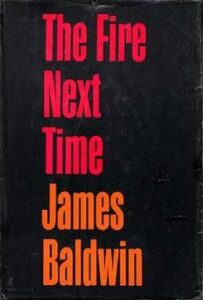 James Baldwin publishes The Fire Next Time, a non-fiction book containing two essays: (1) the explosive "Down at the Cross: Letter from a Region of My Mind", that had appeared in The New Yorker in November 1962; and (2) "My Dundgeon Shook: Letter to My Nephew on the One Hundredth Anniversary of the Emancipation". The book addresses racial tensions in America, the role of religion as both an oppressive force and an instrument for inspiring rage, and the necessity of embracing change and evolving past our limited ways of thinking about race. Learn more. James Baldwin publishes The Fire Next Time, a non-fiction book containing two essays: (1) the explosive "Down at the Cross: Letter from a Region of My Mind", that had appeared in The New Yorker in November 1962; and (2) "My Dundgeon Shook: Letter to My Nephew on the One Hundredth Anniversary of the Emancipation". The book addresses racial tensions in America, the role of religion as both an oppressive force and an instrument for inspiring rage, and the necessity of embracing change and evolving past our limited ways of thinking about race. Learn more. | |
| January 31, 1964 | 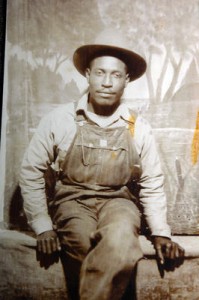 Louis Allen is shot twice in the face with a shotgun outside his home in Liberty, Mississippi, dying instantly. A few years before, Allen witnessed a white state legislator murder an NAACP member in cold blood. Mr. Allen was initially intimidated into stating that it was self defense, but later told the FBI it was murder. Because the FBI refused to provide protection to Mr. Allen, he declined to testify. Nonetheless, Mr. Allen was targeted, falsely jailed, and abused by a local sheriff, who was the son of a high-ranking KKK member and a suspected Klan member. The sheriff, who was the main suspect in Mr. Allen's murder, told Allen’s widow, “If Louis had just shut his mouth, he wouldn’t be layin’ there on the ground.” No one has ever been charged or convicted for the murder. Learn more. Louis Allen is shot twice in the face with a shotgun outside his home in Liberty, Mississippi, dying instantly. A few years before, Allen witnessed a white state legislator murder an NAACP member in cold blood. Mr. Allen was initially intimidated into stating that it was self defense, but later told the FBI it was murder. Because the FBI refused to provide protection to Mr. Allen, he declined to testify. Nonetheless, Mr. Allen was targeted, falsely jailed, and abused by a local sheriff, who was the son of a high-ranking KKK member and a suspected Klan member. The sheriff, who was the main suspect in Mr. Allen's murder, told Allen’s widow, “If Louis had just shut his mouth, he wouldn’t be layin’ there on the ground.” No one has ever been charged or convicted for the murder. Learn more. | |
| February 1, 1887 | 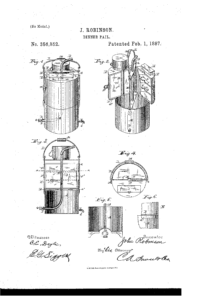 John Robinson of Coal Valley, in Fayette County West Virginia, secures US patent # 356852A for his invention of a heatable dinner pail. Learn more. John Robinson of Coal Valley, in Fayette County West Virginia, secures US patent # 356852A for his invention of a heatable dinner pail. Learn more. | |
| February 1, 1901 | 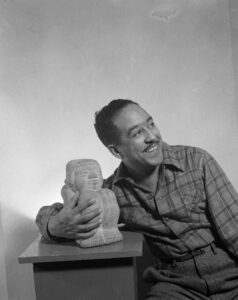 Acclaimed American poet, social activist, novelist, playwright, and columnist Langston Hughes (full name James Mercer Langston Hughes) is born in Joplin, Missouri. One of the earliest innovators of the literary art form called jazz poetry, Hughes is best known as a leader of the Harlem Renaissance. He famously wrote about the period that "the Negro was in vogue", which was later paraphrased as "when Harlem was in vogue." Growing up in a series of Midwestern towns, Hughes became a prolific writer at an early age. He graduated from high school in Cleveland, Ohio, and soon began studies at Columbia University in New York City, where he made his career. Although he dropped out, he gained notice from New York publishers, first in The Crisis magazine, and then from book publishers and became known in the creative community in Harlem. He eventually graduated from Lincoln University. In addition to poetry, Hughes wrote plays, and short stories. He also published several non-fiction works. From 1942 to 1962, as the civil rights movement was gaining traction, he wrote an in-depth weekly column in a leading black newspaper, The Chicago Defender. Learn more. Acclaimed American poet, social activist, novelist, playwright, and columnist Langston Hughes (full name James Mercer Langston Hughes) is born in Joplin, Missouri. One of the earliest innovators of the literary art form called jazz poetry, Hughes is best known as a leader of the Harlem Renaissance. He famously wrote about the period that "the Negro was in vogue", which was later paraphrased as "when Harlem was in vogue." Growing up in a series of Midwestern towns, Hughes became a prolific writer at an early age. He graduated from high school in Cleveland, Ohio, and soon began studies at Columbia University in New York City, where he made his career. Although he dropped out, he gained notice from New York publishers, first in The Crisis magazine, and then from book publishers and became known in the creative community in Harlem. He eventually graduated from Lincoln University. In addition to poetry, Hughes wrote plays, and short stories. He also published several non-fiction works. From 1942 to 1962, as the civil rights movement was gaining traction, he wrote an in-depth weekly column in a leading black newspaper, The Chicago Defender. Learn more. | |
| February 1, 1960 | 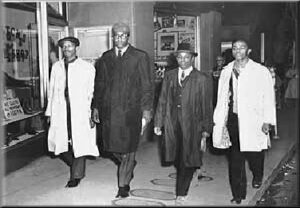 At 4:30 pm, the Greensboro Sit-Ins, a series of nonviolent protests occurring primarily in the Woolworth Store (now the International Civil Rights Center and Museum) in Greensboro, North Carolina, begin when the "Greensboro Four" -- Ezell Blair Jr., David Richmond, Franklin McCain and Joseph McNeil -- are refused service at the store's lunch counter when they each request a cup of coffee. The protests will continue into July of 1960, and lead the F.W. Woolworth Company department store chain to remove its policy of racial segregation in the south. While not the first sit-in of the civil rights movement, the Greensboro sit-ins were an instrumental action, and also the best-known sit-ins of the civil rights movement. They are considered a catalyst to the subsequent sit-in movement, in which 70,000 people participated. This sit-in was a contributing factor in the formation of the Student Nonviolent Coordinating Committee (SNCC). Learn more. At 4:30 pm, the Greensboro Sit-Ins, a series of nonviolent protests occurring primarily in the Woolworth Store (now the International Civil Rights Center and Museum) in Greensboro, North Carolina, begin when the "Greensboro Four" -- Ezell Blair Jr., David Richmond, Franklin McCain and Joseph McNeil -- are refused service at the store's lunch counter when they each request a cup of coffee. The protests will continue into July of 1960, and lead the F.W. Woolworth Company department store chain to remove its policy of racial segregation in the south. While not the first sit-in of the civil rights movement, the Greensboro sit-ins were an instrumental action, and also the best-known sit-ins of the civil rights movement. They are considered a catalyst to the subsequent sit-in movement, in which 70,000 people participated. This sit-in was a contributing factor in the formation of the Student Nonviolent Coordinating Committee (SNCC). Learn more. | |
| February 1, 1965 | 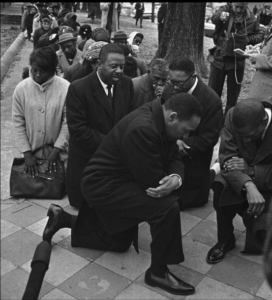 Rev., Dr. Martin Luther King Jr. leads more than 250 activists to the Dallas County Courthouse in Selma, Alabama to register to vote. All of them were arrested during the peaceful demonstration and charged with parading without a permit. In a letter written from the local jail that same night, and later published in the New York Times, Dr. King decried the racist conditions in Selma and observed that "there are more Negroes in jail with me than there are on the voting rolls." Dallas County Sheriff Jim Clark, others in local law enforcement, and county registration employees regularly used violence, discrimination, and intimidation to prevent Black residents of Selma from registering to vote. Though African Americans constituted approximately 50% of Selma's population in the 1960s, only 1-2% were registered voters. The arrests of Dr. King and the other civil rights activists resulted in protests in which African Americans were injured and killed. Despite these attacks, Dr. King and other civil rights leaders continued their work and organized another voting rights march from Selma to Montgomery the following month. Learn more. Rev., Dr. Martin Luther King Jr. leads more than 250 activists to the Dallas County Courthouse in Selma, Alabama to register to vote. All of them were arrested during the peaceful demonstration and charged with parading without a permit. In a letter written from the local jail that same night, and later published in the New York Times, Dr. King decried the racist conditions in Selma and observed that "there are more Negroes in jail with me than there are on the voting rolls." Dallas County Sheriff Jim Clark, others in local law enforcement, and county registration employees regularly used violence, discrimination, and intimidation to prevent Black residents of Selma from registering to vote. Though African Americans constituted approximately 50% of Selma's population in the 1960s, only 1-2% were registered voters. The arrests of Dr. King and the other civil rights activists resulted in protests in which African Americans were injured and killed. Despite these attacks, Dr. King and other civil rights leaders continued their work and organized another voting rights march from Selma to Montgomery the following month. Learn more. | |
| February 2, 1897 | 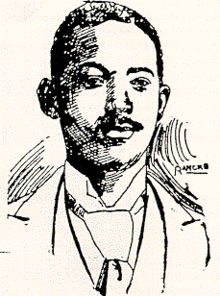 African American businessman and inventor Alfred L. Craile secures U.S. patent # 576,395 for his invention of the ice cream scoop ("Ice Cream Mold and Disher"). Born in 1866 in Virginia, just after the American Civil War, as a young adult Craile later settled in Pittsburgh, Pennsylvania where he initially worked as a porter in a drug store and hotel. Noticing that servers at the hotel had trouble with ice cream sticking to serving spoons, Craile developed the ice cream scoop with a built-in scraper to allow for one-handed operation. His design remains in use to this day. He later become a general manager for the Afro-American Financial, Accumulating, Merchandise and Business association. Learn more. African American businessman and inventor Alfred L. Craile secures U.S. patent # 576,395 for his invention of the ice cream scoop ("Ice Cream Mold and Disher"). Born in 1866 in Virginia, just after the American Civil War, as a young adult Craile later settled in Pittsburgh, Pennsylvania where he initially worked as a porter in a drug store and hotel. Noticing that servers at the hotel had trouble with ice cream sticking to serving spoons, Craile developed the ice cream scoop with a built-in scraper to allow for one-handed operation. His design remains in use to this day. He later become a general manager for the Afro-American Financial, Accumulating, Merchandise and Business association. Learn more. | |
| February 2, 1909 | 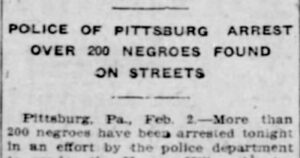 Police in Pittsburgh, Pennsylvania raid the city’s Herron Hill neighborhood and arrest over 200 Black men for being unemployed. Officers charged Black men with vagrancy if they could not prove their employment status, resulting in mass arrests. The next day, city officials sent the arrested men to the workhouse and consigned them to forced labor. Beginning soon after Emancipation, vagrancy laws were among the discriminatory policies used to criminalize and re-enslave Black people. Though the Thirteenth Amendment to the U.S. Constitution was ratified in 1865 and claimed to abolish enslavement in the country, a large loophole allowed this abuse to continue: the amendment’s language prohibited slavery and involuntary servitude, “except as a punishment for crime.” The mass arrests in Pittsburgh are just one example of the way Black people were re-enslaved for decades after the “end” of slavery in America. Learn more. Police in Pittsburgh, Pennsylvania raid the city’s Herron Hill neighborhood and arrest over 200 Black men for being unemployed. Officers charged Black men with vagrancy if they could not prove their employment status, resulting in mass arrests. The next day, city officials sent the arrested men to the workhouse and consigned them to forced labor. Beginning soon after Emancipation, vagrancy laws were among the discriminatory policies used to criminalize and re-enslave Black people. Though the Thirteenth Amendment to the U.S. Constitution was ratified in 1865 and claimed to abolish enslavement in the country, a large loophole allowed this abuse to continue: the amendment’s language prohibited slavery and involuntary servitude, “except as a punishment for crime.” The mass arrests in Pittsburgh are just one example of the way Black people were re-enslaved for decades after the “end” of slavery in America. Learn more. | |
| February 2, 1914 | 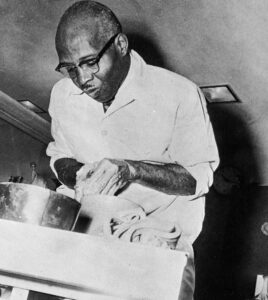 African American sculptor William Ellisworth Artis is born in Washington, North Carolina. Ellisworth's favorite medium was clay, which gave him a broad range of expression. He moved to New York as a teen in 1927, and was a pupil of Augusta Savage and exhibited with the Harmon Foundation. He was featured in the 1930s film A Study of Negro Artists, along with Savage and other artists associated with the Harlem Renaissance, including Richmond Barthé, James Latimer Allen, Palmer Hayden, Aaron Douglas, Lois Mailou Jones, and Georgette Seabrooke. Artis taught at the Harlem YMCA, and later served on the faculties of Nebraska State Teachers College, as Professor of Ceramics at Chadron State College and as Professor of Art at Mankato State College. Learn more. African American sculptor William Ellisworth Artis is born in Washington, North Carolina. Ellisworth's favorite medium was clay, which gave him a broad range of expression. He moved to New York as a teen in 1927, and was a pupil of Augusta Savage and exhibited with the Harmon Foundation. He was featured in the 1930s film A Study of Negro Artists, along with Savage and other artists associated with the Harlem Renaissance, including Richmond Barthé, James Latimer Allen, Palmer Hayden, Aaron Douglas, Lois Mailou Jones, and Georgette Seabrooke. Artis taught at the Harlem YMCA, and later served on the faculties of Nebraska State Teachers College, as Professor of Ceramics at Chadron State College and as Professor of Art at Mankato State College. Learn more. | |
| February 2, 1935 | 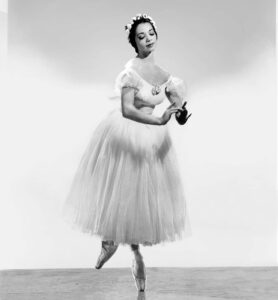 Professional ballerina Anne Raven Wilkinson is born in New York City to Anne James Wilkinson and Dr. Frost Bernie Wilkinson, a dentist. Her family, which also included younger brother Frost Bernie Wilkinson, Jr., lived in a middle-class neighborhood in Harlem. In August 1955 at the age of 20, Raven Wilkinson became the first African American woman to receive a contract to dance full time with a major ballet company, the Ballet Russe de Monte Carlo of New York City. She was promoted to soloist during her second season with the troupe, and remained with the company for six years. Performing with the company also meant, as Wilkerson soon discovered, touring throughout the U.S., including the still racially-segregated South. Wilkinson had pale skin, and in order to perform with the Company in the South, she was asked not to publicize her race. Additionally Wilkinson often had to wear white makeup onstage to conceal her racial identity. In 1957, the owner of a hotel in Atlanta asked Wilkinson if she was black. When she refused to lie, she was barred from staying at the hotel with the rest of the company. During the same tour, two members of the Ku Klux Klan bolted on stage, interrupting a performance in Montgomery, Alabama, asking “Where’s the nigra?” When none of the Company members responded to them, the men left. Nonetheless, as word of Wilkinson’s racial identity became generally known, she was not allowed to participate in performances in southern cities partly to ensure her own safety. In 1961, Wilkinson left the Ballet Russe Company and was never hired by another American ballet company again. In 1966, Wilkinson got a soloist contract with the Dutch National Ballet, where she stayed for seven years. Learn more. Professional ballerina Anne Raven Wilkinson is born in New York City to Anne James Wilkinson and Dr. Frost Bernie Wilkinson, a dentist. Her family, which also included younger brother Frost Bernie Wilkinson, Jr., lived in a middle-class neighborhood in Harlem. In August 1955 at the age of 20, Raven Wilkinson became the first African American woman to receive a contract to dance full time with a major ballet company, the Ballet Russe de Monte Carlo of New York City. She was promoted to soloist during her second season with the troupe, and remained with the company for six years. Performing with the company also meant, as Wilkerson soon discovered, touring throughout the U.S., including the still racially-segregated South. Wilkinson had pale skin, and in order to perform with the Company in the South, she was asked not to publicize her race. Additionally Wilkinson often had to wear white makeup onstage to conceal her racial identity. In 1957, the owner of a hotel in Atlanta asked Wilkinson if she was black. When she refused to lie, she was barred from staying at the hotel with the rest of the company. During the same tour, two members of the Ku Klux Klan bolted on stage, interrupting a performance in Montgomery, Alabama, asking “Where’s the nigra?” When none of the Company members responded to them, the men left. Nonetheless, as word of Wilkinson’s racial identity became generally known, she was not allowed to participate in performances in southern cities partly to ensure her own safety. In 1961, Wilkinson left the Ballet Russe Company and was never hired by another American ballet company again. In 1966, Wilkinson got a soloist contract with the Dutch National Ballet, where she stayed for seven years. Learn more. | |
| February 3, 1943 | 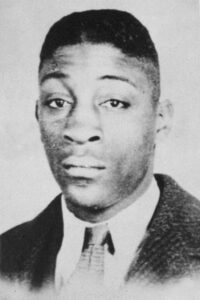 At 12:55 am, the United States troop transport the USAT Dorchester is hit by a torpedo by German U-boat U-233. The troop carrier lists badly and begins to sink rapidly as scores of troops were pitched into the seas. Sailing immediately behind the Dorchester, twelve men from the US Coast Guard cutter Comanche volunteer to rescue men from the frigid waters, including Steward’s Mate First Class Charles Walter David, Jr, one of the lowest-ranking men on the ship. They dive into the waters, putting ropes around men’s waists because most were suffering from hypothermia, and could not grab a rescue line. David rescues ninety-three of the two hundred and twenty-seven survivors, including ranking officer Lt. Robert Anderson. David died of pneumonia on March 29, 1943, fifty-four days after the ordeal, at the age of twenty-six. He was posthumously awarded the Navy and Marine Corps Medal for Heroism in 1943. This award was followed by the American Defense Service Medal, the American Campaign Medal, the European-African-Middle Eastern Campaign Medal, and the WWII Victory Medal. He was honored with a certificate for his heroism by President Lyndon B. Johnson in 1963. The Immortal Chaplains Foundation awarded David with their prestigious Prize for Humanity in 1999, and in 2010, the USCGC Charles David Jr. was named as the seventh new Sentinel Class Cutter in his honor. At 12:55 am, the United States troop transport the USAT Dorchester is hit by a torpedo by German U-boat U-233. The troop carrier lists badly and begins to sink rapidly as scores of troops were pitched into the seas. Sailing immediately behind the Dorchester, twelve men from the US Coast Guard cutter Comanche volunteer to rescue men from the frigid waters, including Steward’s Mate First Class Charles Walter David, Jr, one of the lowest-ranking men on the ship. They dive into the waters, putting ropes around men’s waists because most were suffering from hypothermia, and could not grab a rescue line. David rescues ninety-three of the two hundred and twenty-seven survivors, including ranking officer Lt. Robert Anderson. David died of pneumonia on March 29, 1943, fifty-four days after the ordeal, at the age of twenty-six. He was posthumously awarded the Navy and Marine Corps Medal for Heroism in 1943. This award was followed by the American Defense Service Medal, the American Campaign Medal, the European-African-Middle Eastern Campaign Medal, and the WWII Victory Medal. He was honored with a certificate for his heroism by President Lyndon B. Johnson in 1963. The Immortal Chaplains Foundation awarded David with their prestigious Prize for Humanity in 1999, and in 2010, the USCGC Charles David Jr. was named as the seventh new Sentinel Class Cutter in his honor. | |
| February 3, 1948 | 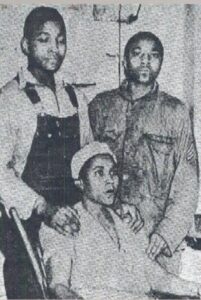 Rosa Lee Ingram, a Black woman, and two of her children, Wallace, 17, and Sammie Lee, 14, were convicted by an all-white jury in a one-day trial in Ellaville, Georgia and sentenced to death by electric chair for killing an armed white man in self-defense as he violently assaulted them, even though the local Sheriff admitted the sons acted in defense of their mother. The judge subsequently reduced their sentences to life in prison. Ms. Ingram and her sons were sent to the state penitentiary and were each forced to serve more than a decade in prison for daring to defend themselves against a violent, armed assault by a white man. The Ingrams were not released on parole until 1959. Learn more. Rosa Lee Ingram, a Black woman, and two of her children, Wallace, 17, and Sammie Lee, 14, were convicted by an all-white jury in a one-day trial in Ellaville, Georgia and sentenced to death by electric chair for killing an armed white man in self-defense as he violently assaulted them, even though the local Sheriff admitted the sons acted in defense of their mother. The judge subsequently reduced their sentences to life in prison. Ms. Ingram and her sons were sent to the state penitentiary and were each forced to serve more than a decade in prison for daring to defend themselves against a violent, armed assault by a white man. The Ingrams were not released on parole until 1959. Learn more. | |
| February 3, 1956 | 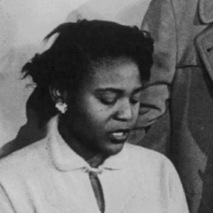 Autherine Lucy briefly integrates the University of Alabama. Lucy’s enrollment follows a two-year legal battle she and the NAACP waged to force the University of Alabama to admit Black students. On February 6, Lucy’s 4th day of attendance, a mob of hundreds descend on the university to halt Autherine Lucy’s enrollment. The mob, armed with rocks, eggs, and bricks, scream racist epithets at Lucy and threaten her life, and Lucy is hit in the back with an egg as she was ushered, under police escort, into an auditorium (where she was forced to remain for hours for her own safety). The University of Alabama Board of Trustees suspend Lucy that evening, and later expell her “for her protection and for the protection of other students and staff members.” Her attorneys challenge of the expulsion is unsuccessful. In April 1988, Lucy’s expulsion was overturned, and in spring 1992, she earned a master’s degree in elementary education from the University of Alabama. Learn more. Autherine Lucy briefly integrates the University of Alabama. Lucy’s enrollment follows a two-year legal battle she and the NAACP waged to force the University of Alabama to admit Black students. On February 6, Lucy’s 4th day of attendance, a mob of hundreds descend on the university to halt Autherine Lucy’s enrollment. The mob, armed with rocks, eggs, and bricks, scream racist epithets at Lucy and threaten her life, and Lucy is hit in the back with an egg as she was ushered, under police escort, into an auditorium (where she was forced to remain for hours for her own safety). The University of Alabama Board of Trustees suspend Lucy that evening, and later expell her “for her protection and for the protection of other students and staff members.” Her attorneys challenge of the expulsion is unsuccessful. In April 1988, Lucy’s expulsion was overturned, and in spring 1992, she earned a master’s degree in elementary education from the University of Alabama. Learn more. | |
| February 3, 1964 | 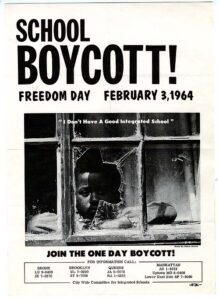 The New York City school boycott, known as Freedom Day, takes place in New York City. It is the largest civil rights demonstration of the 1960s and involves nearly half a million Black and Puerto Rican students in a mass boycott and demonstration protesting segregation in the New York City public school system. Students and teachers stayed out of public schools to highlight the deplorable conditions, and demonstrators held rallies demanding integration. Learn more. The New York City school boycott, known as Freedom Day, takes place in New York City. It is the largest civil rights demonstration of the 1960s and involves nearly half a million Black and Puerto Rican students in a mass boycott and demonstration protesting segregation in the New York City public school system. Students and teachers stayed out of public schools to highlight the deplorable conditions, and demonstrators held rallies demanding integration. Learn more. | |
| February 4, 1913 |
| |
| February 4, 1943 | 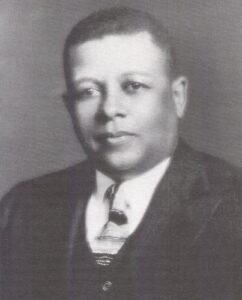 Hugh MacBeth, Sr., an African American attorney from Los Angeles, organizer and advocate for west coast Japanese Americans subjected to internment after Pearl Harbor, secures a a writ of habeas corpus from a three-judge panel on behalf of his clients, Ernest and Toki Wakayama. However, by that time the Wakayamas, worn down by large-scale beatings and ostracism at the Manzanar internment camp in Northern California, had withdrawn their suit and requested “repatriation” to Japan, despite the fact that both were born and had lived their entire lives in America. Despite this defeat, MacBeth continued to defend Japanese Americans from segregation, internment, and other racial-drivem injustices. Learn more. Hugh MacBeth, Sr., an African American attorney from Los Angeles, organizer and advocate for west coast Japanese Americans subjected to internment after Pearl Harbor, secures a a writ of habeas corpus from a three-judge panel on behalf of his clients, Ernest and Toki Wakayama. However, by that time the Wakayamas, worn down by large-scale beatings and ostracism at the Manzanar internment camp in Northern California, had withdrawn their suit and requested “repatriation” to Japan, despite the fact that both were born and had lived their entire lives in America. Despite this defeat, MacBeth continued to defend Japanese Americans from segregation, internment, and other racial-drivem injustices. Learn more. | |
| February 4, 1999 | 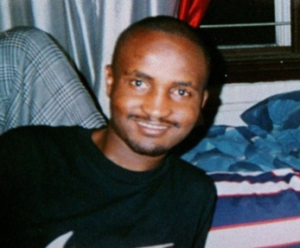 At 12:40 am, four plainclothes New York City police officers exit their vehicle and approach Amadou Diallo, a Guinean immigrant, while he is in the vestibule of his building. While it is unclear if they identified themselves as police officers, they nontheless sought to question Diallo who in turn did not respond to their request but instead reached into his back pocket. One of the officers yelled “gun,” and all four officers began to shoot at Diallo. A total of forty-one shots were fired from the officers’ weapons. Nineteen shots hit Diallo’s body, and he was killed instantly. Neighbors called 911 after the shooting, and the attending officers called in the incident on their radios. Once other officers arrived on the scene, an investigation began. It was discovered that there was no gun and all that was lying next to Diallo’s body were a pager and a wallet. The shooting catalyzed protests in the city of New York because many believed the officers had acted without restraint. All four officers were indicted, but acquitted. The Diallo killing would be the first of a series of high-profile police killings of Black people that would over a decade later spark the Black Lives Matter movement. Learn more. At 12:40 am, four plainclothes New York City police officers exit their vehicle and approach Amadou Diallo, a Guinean immigrant, while he is in the vestibule of his building. While it is unclear if they identified themselves as police officers, they nontheless sought to question Diallo who in turn did not respond to their request but instead reached into his back pocket. One of the officers yelled “gun,” and all four officers began to shoot at Diallo. A total of forty-one shots were fired from the officers’ weapons. Nineteen shots hit Diallo’s body, and he was killed instantly. Neighbors called 911 after the shooting, and the attending officers called in the incident on their radios. Once other officers arrived on the scene, an investigation began. It was discovered that there was no gun and all that was lying next to Diallo’s body were a pager and a wallet. The shooting catalyzed protests in the city of New York because many believed the officers had acted without restraint. All four officers were indicted, but acquitted. The Diallo killing would be the first of a series of high-profile police killings of Black people that would over a decade later spark the Black Lives Matter movement. Learn more. | |
| February 5, 1917 | 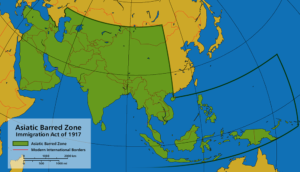 Congress passes the Immigration Act of 1917, also known as the Asiatic Barred Zone Act. Intended to prevent “undesirables” from immigrating to the U.S., the act primarily targeted individuals migrating from Asia. Under the act, people from “any country not owned by the United States adjacent to the continent of Asia” were barred from immigrating to the U.S. The bill was not meant to impact immigrants from Northern and Western Europe but targeted Asian, Mexican, and Mediterranean immigrants. The bill remained law for 35 years, until the Immigration and Naturalization Act of 1952 eliminated racial restrictions in immigration and naturalization statutes. Learn more. Congress passes the Immigration Act of 1917, also known as the Asiatic Barred Zone Act. Intended to prevent “undesirables” from immigrating to the U.S., the act primarily targeted individuals migrating from Asia. Under the act, people from “any country not owned by the United States adjacent to the continent of Asia” were barred from immigrating to the U.S. The bill was not meant to impact immigrants from Northern and Western Europe but targeted Asian, Mexican, and Mediterranean immigrants. The bill remained law for 35 years, until the Immigration and Naturalization Act of 1952 eliminated racial restrictions in immigration and naturalization statutes. Learn more. | |
| February 5, 1917 | 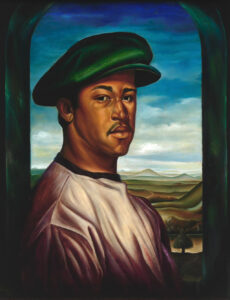 Frederick C. Flemister, an artist most recognized for his paintings during the early 1940s, while he was based in Atlanta, Georgia, is born in Jackson, Georgia. He was one of the foremost artists to emerge from a group taught and influenced by Hale Aspacio Woodruff (1900-1980), founder of Atlanta University’s School of Art. Flemister’s most famous paintings include works such as “Self Portrait” (1941), “Man with a Brush,” “The Mourners,” and “Madonna,” were all produced between 1939 and 1945. Though he emerged during the 1940s, his works are often associated with the Harlem Renaissance artists of the 1920s. His style has been described as expressionistic and is often compared to that of 16th-century Italian Renaissance painters. His professor Hale Woodruff was a major artistic influence. Another was El Greco (1541-1614). Flemister’s work has been featured in several exhibits including the High Art Museum in Atlanta, Dillard University, New Orleans; the American Negro Exposition, Chicago; the Institute of Modern Art in Boston; the Albany Institute of History and Art; City College of New York; Xavier University in Cincinnati, Ohio; and the Smith College Museum of Art, Northampton, Massachusetts. In February 1944 his work was featured as part of “The Negro in Art” exhibition at the Barnett-Aden Gallery, Washington, D.C. Learn more. Frederick C. Flemister, an artist most recognized for his paintings during the early 1940s, while he was based in Atlanta, Georgia, is born in Jackson, Georgia. He was one of the foremost artists to emerge from a group taught and influenced by Hale Aspacio Woodruff (1900-1980), founder of Atlanta University’s School of Art. Flemister’s most famous paintings include works such as “Self Portrait” (1941), “Man with a Brush,” “The Mourners,” and “Madonna,” were all produced between 1939 and 1945. Though he emerged during the 1940s, his works are often associated with the Harlem Renaissance artists of the 1920s. His style has been described as expressionistic and is often compared to that of 16th-century Italian Renaissance painters. His professor Hale Woodruff was a major artistic influence. Another was El Greco (1541-1614). Flemister’s work has been featured in several exhibits including the High Art Museum in Atlanta, Dillard University, New Orleans; the American Negro Exposition, Chicago; the Institute of Modern Art in Boston; the Albany Institute of History and Art; City College of New York; Xavier University in Cincinnati, Ohio; and the Smith College Museum of Art, Northampton, Massachusetts. In February 1944 his work was featured as part of “The Negro in Art” exhibition at the Barnett-Aden Gallery, Washington, D.C. Learn more. | |
| February 5, 1951 | 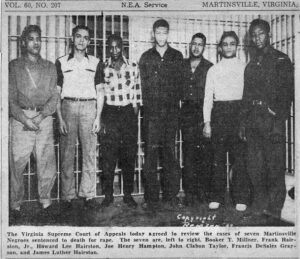 The remaining three of the Martinsville Seven are executed by electrocution, the first four having been executed three days before. The Martinsville Seven were a group of young Black men convicted of raping a white woman in Martinsville, VA. On the evening of January 8, 1949, Ruby Stroud Floyd accused 13 black men of raping her while she passed through a poor African American neighborhood in Martinsville, Virginia. The trials and the electrocutions became a cause célèbre similar to the Scottsboro Case of the 1930s. NAACP officials focused national attention to the case, hoping to delay or overturn the death penalty judgment. NAACP lawyers argued on appeal that Virginia’s legal code was hardly race-neutral since whites convicted of rape “seldom if ever” received the death penalty. All appeals were quickly exhausted. Learn more. The remaining three of the Martinsville Seven are executed by electrocution, the first four having been executed three days before. The Martinsville Seven were a group of young Black men convicted of raping a white woman in Martinsville, VA. On the evening of January 8, 1949, Ruby Stroud Floyd accused 13 black men of raping her while she passed through a poor African American neighborhood in Martinsville, Virginia. The trials and the electrocutions became a cause célèbre similar to the Scottsboro Case of the 1930s. NAACP officials focused national attention to the case, hoping to delay or overturn the death penalty judgment. NAACP lawyers argued on appeal that Virginia’s legal code was hardly race-neutral since whites convicted of rape “seldom if ever” received the death penalty. All appeals were quickly exhausted. Learn more. | |
| February 5, 1995 | 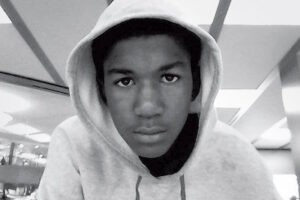 Birth of Trayvon Martin, whose tragic death at age 17 in 2012 became the first catalyst for the national Black Lives Matter movement. Learn more. Birth of Trayvon Martin, whose tragic death at age 17 in 2012 became the first catalyst for the national Black Lives Matter movement. Learn more. | |
| February 6, 1886 | 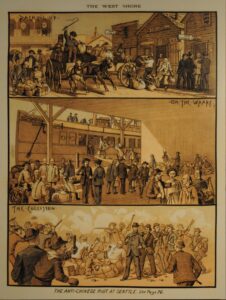 The Seattle Riot of 1886 begins in Seattle, Washington when a mob affiliated with a local Knights of Labor chapter forms committees to carry out a forcible expulsion of all Chinese from the city. Violence erupted between the Knights of Labor rioters and federal troops ordered in by President Grover Cleveland over the next two days. The incident resulted in the removal of over 200 Chinese civilians from Seattle and left two militia men and three rioters seriously injured. Learn more. The Seattle Riot of 1886 begins in Seattle, Washington when a mob affiliated with a local Knights of Labor chapter forms committees to carry out a forcible expulsion of all Chinese from the city. Violence erupted between the Knights of Labor rioters and federal troops ordered in by President Grover Cleveland over the next two days. The incident resulted in the removal of over 200 Chinese civilians from Seattle and left two militia men and three rioters seriously injured. Learn more. | |
| February 6, 1898 | 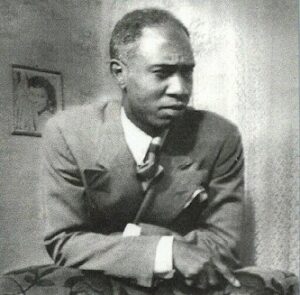 Melvin Beaunorus Tolson, educator and one of the most significant African American modernist poets of his time, is born in Moberly, Missouri. Langston Hughes declared him “the most famous Negro Professor in the Southwest” in the mid-twentieth century. After interviewing significant artists of the Harlem Renaissance for his master’s thesis, Tolson was inspired to write poetry exploring the African American urban experience. His poetry began appearing in African American newspapers such as the Washington, D.C. Tribune in the 1930s. Tolson’s first book of poetry, Rendezvous with America, was published in 1944. In the 1970s, Tolson’s poetry was displayed in an exhibit known as “A Gallery of Harlem Portraits” at the University of Virginia. Learn more. Melvin Beaunorus Tolson, educator and one of the most significant African American modernist poets of his time, is born in Moberly, Missouri. Langston Hughes declared him “the most famous Negro Professor in the Southwest” in the mid-twentieth century. After interviewing significant artists of the Harlem Renaissance for his master’s thesis, Tolson was inspired to write poetry exploring the African American urban experience. His poetry began appearing in African American newspapers such as the Washington, D.C. Tribune in the 1930s. Tolson’s first book of poetry, Rendezvous with America, was published in 1944. In the 1970s, Tolson’s poetry was displayed in an exhibit known as “A Gallery of Harlem Portraits” at the University of Virginia. Learn more. | |
| February 6, 1902 | 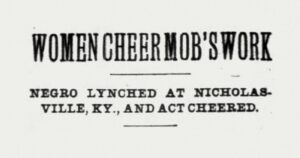 A white mob of 200 seizes Thomas Brown, a 19-year-old Black man, from a jail cell and lynches him on the Jessamine County Courthouse lawn in Nicholasville, Kentucky. Thomas had been arrested for an alleged assault on a white woman but never had the chance to stand trial. Though news reports identified the young woman’s brother as a leader of the mob, no one was ever prosecuted for Thomas Brown’s murder and authorities concluded that he "met death by strangulation at the hands of parties unknown." Learn more. A white mob of 200 seizes Thomas Brown, a 19-year-old Black man, from a jail cell and lynches him on the Jessamine County Courthouse lawn in Nicholasville, Kentucky. Thomas had been arrested for an alleged assault on a white woman but never had the chance to stand trial. Though news reports identified the young woman’s brother as a leader of the mob, no one was ever prosecuted for Thomas Brown’s murder and authorities concluded that he "met death by strangulation at the hands of parties unknown." Learn more. | |
| February 6, 1905 | 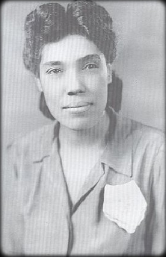 Merze Tate, a historian, political author, world traveler, philanthropist, and the first African American to graduate from Oxford University is born Blanchard, Michigan. Excelling in her studies, she won an oratorical contest at Battle Creek High School and graduated valedictorian at Blanchard High School. Tate received a scholarship to Western State Teachers College (now Western Michigan University) and became the first African American to graduate, earning a teaching diploma and bachelor’s degree with honors in 1927. In 1935, Tate earned a bachelor of literature degree (B.Litt.) in international relations from Oxford University. She returned home to study political science at Radcliffe College, the prestigious all-female school that later merged with Harvard University. In 1941, she obtained her Ph.D. and was the first Black woman to do so at Radcliffe. In the 1950s, she was a Fulbright Scholar and lecturer for the U.S. Information Agency and visited India, Thailand, Japan, the Philippines, Hong Kong, and Singapore. Learn more. Merze Tate, a historian, political author, world traveler, philanthropist, and the first African American to graduate from Oxford University is born Blanchard, Michigan. Excelling in her studies, she won an oratorical contest at Battle Creek High School and graduated valedictorian at Blanchard High School. Tate received a scholarship to Western State Teachers College (now Western Michigan University) and became the first African American to graduate, earning a teaching diploma and bachelor’s degree with honors in 1927. In 1935, Tate earned a bachelor of literature degree (B.Litt.) in international relations from Oxford University. She returned home to study political science at Radcliffe College, the prestigious all-female school that later merged with Harvard University. In 1941, she obtained her Ph.D. and was the first Black woman to do so at Radcliffe. In the 1950s, she was a Fulbright Scholar and lecturer for the U.S. Information Agency and visited India, Thailand, Japan, the Philippines, Hong Kong, and Singapore. Learn more. | |
| February 7, 1904 | 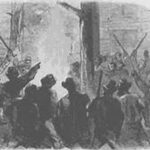 As hundreds of white people watched and cheered, a Black man named Luther Holbert and an unidentified Black woman were tortured and killed in Doddsville, Mississippi. As reported in the Vicksburg, Mississippi, Evening Post, the two victims were tied to tree and forced to hold out their hands and watch as their fingers and ears were chopped off, one at a time, and distributed as souvenirs. The mob next bore into the victims' arms, legs, and bodies with a large corkscrew, pulling out large pieces of raw flesh. The victims were finally thrown on a large fire and burned to death. The event was described as a festive atmosphere, in which the audience of 600 spectators enjoyed deviled eggs, lemonade, and whiskey. Learn more. As hundreds of white people watched and cheered, a Black man named Luther Holbert and an unidentified Black woman were tortured and killed in Doddsville, Mississippi. As reported in the Vicksburg, Mississippi, Evening Post, the two victims were tied to tree and forced to hold out their hands and watch as their fingers and ears were chopped off, one at a time, and distributed as souvenirs. The mob next bore into the victims' arms, legs, and bodies with a large corkscrew, pulling out large pieces of raw flesh. The victims were finally thrown on a large fire and burned to death. The event was described as a festive atmosphere, in which the audience of 600 spectators enjoyed deviled eggs, lemonade, and whiskey. Learn more. | |
| February 7, 1926 | 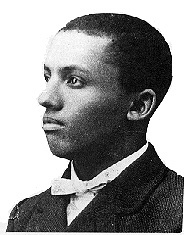 The precursor to Black History Month is observed for the first time in the United States, after the historian Carter G. Woodson and the Association for the Study of Negro Life and History announce the second week of February to be "Negro History Week". This week was chosen because it coincided with the birthday of Abraham Lincoln on February 12 and that of Frederick Douglass on February 14, both of which dates Black communities had celebrated together since the late 19th century. At the time of Negro History Week's launch, Woodson contended that the teaching of Black History was essential to ensure the physical and intellectual survival of the race within broader society. In 1976, President Gerald Ford designated the entire month of February as Black History Month. Learn more. The precursor to Black History Month is observed for the first time in the United States, after the historian Carter G. Woodson and the Association for the Study of Negro Life and History announce the second week of February to be "Negro History Week". This week was chosen because it coincided with the birthday of Abraham Lincoln on February 12 and that of Frederick Douglass on February 14, both of which dates Black communities had celebrated together since the late 19th century. At the time of Negro History Week's launch, Woodson contended that the teaching of Black History was essential to ensure the physical and intellectual survival of the race within broader society. In 1976, President Gerald Ford designated the entire month of February as Black History Month. Learn more. | |
| February 8, 1831 | 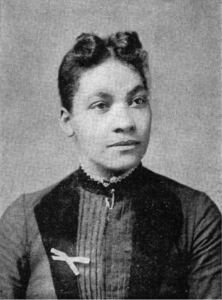 Dr. Rebecca Davis Lee Crumpler, the first African American woman doctor in the United States, is born free to Absolum and Matilda (Webber) Davis in Christiana, Delaware. She was raised by an aunt in Pennsylvania who was noted to have provided health care to her neighbors. She completed medical school at the New England Female Medical College and received her M.D. in 1864. Dr. Crumpler first practiced medicine in Boston and specialized in the care of women, children, and the poor. She moved to Richmond, Virginia in 1865 to minister to freedpeople through the Freedmen’s Bureau. Crumpler returned to Boston in 1869, where she practiced from her home on Beacon Hill and dispensed nutritional advice to poor women and children. In 1883, she published a medical guide book, Book of Medical Discourses, which primarily gave advice for women on the health care of their families. Learn more. Dr. Rebecca Davis Lee Crumpler, the first African American woman doctor in the United States, is born free to Absolum and Matilda (Webber) Davis in Christiana, Delaware. She was raised by an aunt in Pennsylvania who was noted to have provided health care to her neighbors. She completed medical school at the New England Female Medical College and received her M.D. in 1864. Dr. Crumpler first practiced medicine in Boston and specialized in the care of women, children, and the poor. She moved to Richmond, Virginia in 1865 to minister to freedpeople through the Freedmen’s Bureau. Crumpler returned to Boston in 1869, where she practiced from her home on Beacon Hill and dispensed nutritional advice to poor women and children. In 1883, she published a medical guide book, Book of Medical Discourses, which primarily gave advice for women on the health care of their families. Learn more.
| |
| February 8, 1902 | 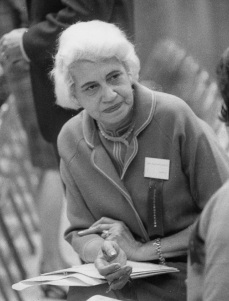 Businesswoman, politician, and civil rights activist, Mae Street Kidd, is born in Millersburg, Kentucky to a Black mother and white father. Kidd’s biological father refused to acknowledge her as his daughter. She attended a segregated Black primary school in her community. As a teenager, Kidd enrolled at Lincoln Institute in Simpsonville, Kentucky, a boarding school for African Americans. She became a successful life insurance agent at the Black owned Mammoth Life Insurance Company. She served in the American Red Cross in England during WWII. Following the war, she became an entrepreneur, opening a cosmetic and an insurance company in the Midwest. Kidd became active in the burgeoning civil rights movement in Louisville. In 1948, she founded the Louisville Urban League Guild. In her sixties, she served in the Kentucky House of Representatives from 1968 to 1984, representing Louisville’s 41st legislative district. Learn more.
Businesswoman, politician, and civil rights activist, Mae Street Kidd, is born in Millersburg, Kentucky to a Black mother and white father. Kidd’s biological father refused to acknowledge her as his daughter. She attended a segregated Black primary school in her community. As a teenager, Kidd enrolled at Lincoln Institute in Simpsonville, Kentucky, a boarding school for African Americans. She became a successful life insurance agent at the Black owned Mammoth Life Insurance Company. She served in the American Red Cross in England during WWII. Following the war, she became an entrepreneur, opening a cosmetic and an insurance company in the Midwest. Kidd became active in the burgeoning civil rights movement in Louisville. In 1948, she founded the Louisville Urban League Guild. In her sixties, she served in the Kentucky House of Representatives from 1968 to 1984, representing Louisville’s 41st legislative district. Learn more. | |
| February 8, 1915 | 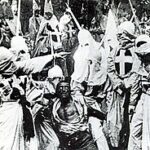 The silent epic drama film, The Birth of a Nation, originally called The Clansman, debuts. The film has been called "the most reprehensibly racist film in Hollywood history" and promotes the "Lost Cause" ideology. The film portrays African Americans (many of whom are played by white actors in blackface) as unintelligent and sexually aggressive toward white women. The Ku Klux Klan (KKK) is portrayed as a heroic force, necessary to preserve American values, protect white women, and maintain white supremacy. The film was a huge commercial success and profoundly influenced both the film industry and American culture. The film has been acknowledged as an inspiration for the rebirth of the Ku Klux Klan, which took place only a few months after its release. Learn more. The silent epic drama film, The Birth of a Nation, originally called The Clansman, debuts. The film has been called "the most reprehensibly racist film in Hollywood history" and promotes the "Lost Cause" ideology. The film portrays African Americans (many of whom are played by white actors in blackface) as unintelligent and sexually aggressive toward white women. The Ku Klux Klan (KKK) is portrayed as a heroic force, necessary to preserve American values, protect white women, and maintain white supremacy. The film was a huge commercial success and profoundly influenced both the film industry and American culture. The film has been acknowledged as an inspiration for the rebirth of the Ku Klux Klan, which took place only a few months after its release. Learn more. | |
| February 8, 1944 | 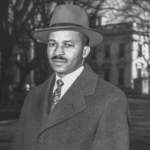 Harry S. McAlpin becomes the first African American reporter to attend a U.S. Presidential news conference. He is greeted by President Franklin D. Roosevelt, who shakes his hand and says, "I'm glad to see you, McAlpin, and very happy to have you here." In 1943 the National Negro Publishers Association (NNPA) petitioned the White House Correspondents Association (WHCA) for press credentials on the grounds that the Atlanta Daily World was one of its member papers. All other African American papers at the time were weeklies, and the press credentials were limited to reporters for daily papers. The WHCA agreed but it took several more months before the NNPA could afford to open its own Washington bureau and hire McAlpin as its full-time Washington correspondent. Learn more. Harry S. McAlpin becomes the first African American reporter to attend a U.S. Presidential news conference. He is greeted by President Franklin D. Roosevelt, who shakes his hand and says, "I'm glad to see you, McAlpin, and very happy to have you here." In 1943 the National Negro Publishers Association (NNPA) petitioned the White House Correspondents Association (WHCA) for press credentials on the grounds that the Atlanta Daily World was one of its member papers. All other African American papers at the time were weeklies, and the press credentials were limited to reporters for daily papers. The WHCA agreed but it took several more months before the NNPA could afford to open its own Washington bureau and hire McAlpin as its full-time Washington correspondent. Learn more. | |
| February 8, 1968 |  On the campus of South Carolina State College, a historically Black college in Orangeburg, South Carolina, white state troopers fire into a large crowd of mostly African Americans protesting segregation in the town. In what became known as the “Orangeburg Massacre,” the troopers shot and wounded 28 people and killed three Black male students: Samuel Hammond, 18, a freshman from Florida; Henry Smith, 18, a sophomore from Marion, South Carolina; and Delano Middleton, 17, an Orangeburg high school student. Witness accounts from reporters, firemen, and students reported that officers had fired on the crowd without warning. No evidence was ever presented that the protesters were armed. None of the nine officers charged for their roles in the shooting were convicted of any wrongdoing, but Cleveland Sellers, program director of the Student Nonviolent Coordinating Committee (SNCC), and a protest organizer was convicted of rioting and served seven months in prison. Learn more. On the campus of South Carolina State College, a historically Black college in Orangeburg, South Carolina, white state troopers fire into a large crowd of mostly African Americans protesting segregation in the town. In what became known as the “Orangeburg Massacre,” the troopers shot and wounded 28 people and killed three Black male students: Samuel Hammond, 18, a freshman from Florida; Henry Smith, 18, a sophomore from Marion, South Carolina; and Delano Middleton, 17, an Orangeburg high school student. Witness accounts from reporters, firemen, and students reported that officers had fired on the crowd without warning. No evidence was ever presented that the protesters were armed. None of the nine officers charged for their roles in the shooting were convicted of any wrongdoing, but Cleveland Sellers, program director of the Student Nonviolent Coordinating Committee (SNCC), and a protest organizer was convicted of rioting and served seven months in prison. Learn more. | |
| February 9, 1907 | 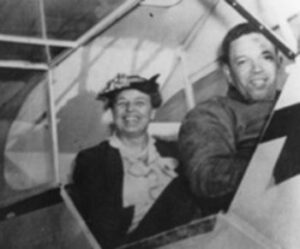 Charles Alfred Anderson, often called the “Father of Black Aviation,” because of his training and mentoring of hundreds of African American pilots, is born in Bryn Mawr, Pennsylvania, a Philadelphia suburb, to Janie and Iverson Anderson. Charles Anderson earned the name “Chief” because he was the most ranked and experienced African American pilot before coming to Tuskegee Army Air Field (TAAF) in 1940. By that point he had amassed 3,500 hours of flight prompting most of his contemporaries and students to call him by that name as a sign of their respect for his accomplishments. Anderson was also the Chief flight Instructor for all cadets and flight instructors at Tuskegee, Alabama during World War II. Learn more. Charles Alfred Anderson, often called the “Father of Black Aviation,” because of his training and mentoring of hundreds of African American pilots, is born in Bryn Mawr, Pennsylvania, a Philadelphia suburb, to Janie and Iverson Anderson. Charles Anderson earned the name “Chief” because he was the most ranked and experienced African American pilot before coming to Tuskegee Army Air Field (TAAF) in 1940. By that point he had amassed 3,500 hours of flight prompting most of his contemporaries and students to call him by that name as a sign of their respect for his accomplishments. Anderson was also the Chief flight Instructor for all cadets and flight instructors at Tuskegee, Alabama during World War II. Learn more. | |
| February 9, 1919 | 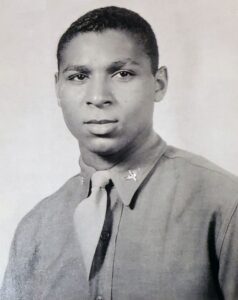 Robert Leander Martin, a member of the Tuskegee Airmen, is born in Dubuque, Iowa. Martin became inspired to become a pilot after attending an air show when he was thirteen years old. After graduating from high school, Martin enrolled at Iowa State University in Ames, Iowa. While there he learned to fly in a civilian pilot training program before graduating from the institution in 1942 with a bachelor’s degree in electrical engineering. Martin entered the Tuskegee flight training program, the only one the U.S. Army sponsored to train Black pilots for military combat. He graduated from flight training at the Tuskegee Army Airfield as a second lieutenant and soon afterwards was assigned to the 100th Fighter Squadron and the 332nd Fighter Group. During the war, Martin earned the Distinguished Flying Cross, The Air Medal with 6 Oak Leaf Clusters, and the Purple Heart for his heroism. Learn more. Robert Leander Martin, a member of the Tuskegee Airmen, is born in Dubuque, Iowa. Martin became inspired to become a pilot after attending an air show when he was thirteen years old. After graduating from high school, Martin enrolled at Iowa State University in Ames, Iowa. While there he learned to fly in a civilian pilot training program before graduating from the institution in 1942 with a bachelor’s degree in electrical engineering. Martin entered the Tuskegee flight training program, the only one the U.S. Army sponsored to train Black pilots for military combat. He graduated from flight training at the Tuskegee Army Airfield as a second lieutenant and soon afterwards was assigned to the 100th Fighter Squadron and the 332nd Fighter Group. During the war, Martin earned the Distinguished Flying Cross, The Air Medal with 6 Oak Leaf Clusters, and the Purple Heart for his heroism. Learn more. | |
| February 9, 1944 | 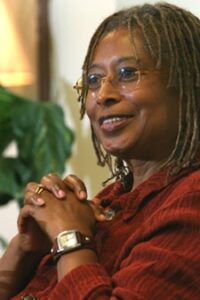 Prolific writer, educator, and activist Alice Walker, the first African American to win the Pulitzer Prize for fiction, is born the eighth child of sharecroppers Willie Lee and Minnie Lou Grant Walker in Eatonton, Georgia. Walker became the valedictorian of her segregated high school class, despite an accident at age eight that impaired the vision in her left eye. Before transferring to Sarah Lawrence College, where she received a B.A., she attended Atlanta’s Spelman College for two years, where she became a political activist, met Dr. Martin Luther King, Jr., and participated in the 1963 March on Washington. Walker later became a major voice in the emerging feminist movement led by mostly white middle-class women. Aware of the issues of race in that movement, Walker later created a specific Black woman centered feminist theory, which she called “womanism,” to identity and assess the oppression based on racism and classism that African American women often experience. Walker’s collected work includes poetry, novels, short fiction, essays, critical essays, and children’s stories. Learn more. Prolific writer, educator, and activist Alice Walker, the first African American to win the Pulitzer Prize for fiction, is born the eighth child of sharecroppers Willie Lee and Minnie Lou Grant Walker in Eatonton, Georgia. Walker became the valedictorian of her segregated high school class, despite an accident at age eight that impaired the vision in her left eye. Before transferring to Sarah Lawrence College, where she received a B.A., she attended Atlanta’s Spelman College for two years, where she became a political activist, met Dr. Martin Luther King, Jr., and participated in the 1963 March on Washington. Walker later became a major voice in the emerging feminist movement led by mostly white middle-class women. Aware of the issues of race in that movement, Walker later created a specific Black woman centered feminist theory, which she called “womanism,” to identity and assess the oppression based on racism and classism that African American women often experience. Walker’s collected work includes poetry, novels, short fiction, essays, critical essays, and children’s stories. Learn more. | |
| February 9, 1960 |  Just four weeks before her graduation, a bomb exploded at the home of Carlotta Walls, the youngest member of the original “Little Rock Nine," who integrated Little Rock Central High School in 1957. Carlotta, her mother, and her sister were at home when the bomb exploded, but no one was injured. Police arrested and beat Carlotta's father in unsuccessful efforts to coerce a confession. Police then arrested two young Black men, Herbert Monts, a family friend, and Maceo Binns, Jr.; Walls never believed either man was responsible, but both were convicted and sentenced to five years in prison. Three years before, hundreds of white people had attacked Black residents and reporters when the Little Rock Nine entered the high school. In response, segregationist Governor Orville Faubus closed all public high schools in Little Rock for the 1958-1959 school year. Learn more. Just four weeks before her graduation, a bomb exploded at the home of Carlotta Walls, the youngest member of the original “Little Rock Nine," who integrated Little Rock Central High School in 1957. Carlotta, her mother, and her sister were at home when the bomb exploded, but no one was injured. Police arrested and beat Carlotta's father in unsuccessful efforts to coerce a confession. Police then arrested two young Black men, Herbert Monts, a family friend, and Maceo Binns, Jr.; Walls never believed either man was responsible, but both were convicted and sentenced to five years in prison. Three years before, hundreds of white people had attacked Black residents and reporters when the Little Rock Nine entered the high school. In response, segregationist Governor Orville Faubus closed all public high schools in Little Rock for the 1958-1959 school year. Learn more. | |
| February 17, 1891 | 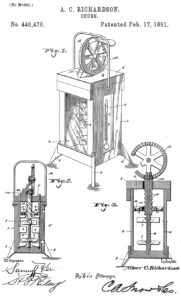 African American A.C. Richardson secures US Patent number 446,470 for his invention of an improved butter churn. Learn more. African American A.C. Richardson secures US Patent number 446,470 for his invention of an improved butter churn. Learn more. | |
| February 17, 1938 | 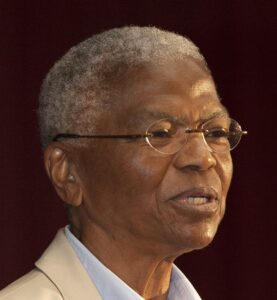 Mary Frances Berry, scholar, professor, author, and civil rights activist who served on the U.S. Commission on Civil Rights, is born in Nashville, Tennessee to parents Frances Southall Berry and George Ford Berry. Due to her mother’s poverty and the desertion of her father, she and her brothers spent time in an orphanage. She attended the segregated public schools in Nashville but in the 10th grade she found a mentor in her teacher, Minerva Hawkins, who challenged Berry to excel in academics. Berry earned her B.A. in history from Howard University in 1961. She earned a history Ph.D. in 1966 from the University of Michigan. In 1968 Berry became a faculty member at the University of Maryland and supervised the establishment of an African American Studies Program at that institution. Berry earned her law degree from the University of Michigan Law School in 1970 and became the acting director of the Department of Afro-American Studies at the University of Maryland. From 1974 to 1976 she served as University Provost, becoming the first African American woman to hold that position. President Jimmy Carter appointed her to the U.S. Commission on Civil Rights in 1980. Her 1993 book The Politics of Parenthood: Child Care, Women’s Rights, and the Myth of the Good Mother, argued for men to take an equal role in child care and for a rethinking of gender roles. In 1993 Berry was appointed Chair of the U.S. Civil Rights Commission by President Bill Clinton and reappointed in 1999. After leaving government in 2004, Berry returned to academia as a professor at the University of Pennsylvania. Learn more.
Mary Frances Berry, scholar, professor, author, and civil rights activist who served on the U.S. Commission on Civil Rights, is born in Nashville, Tennessee to parents Frances Southall Berry and George Ford Berry. Due to her mother’s poverty and the desertion of her father, she and her brothers spent time in an orphanage. She attended the segregated public schools in Nashville but in the 10th grade she found a mentor in her teacher, Minerva Hawkins, who challenged Berry to excel in academics. Berry earned her B.A. in history from Howard University in 1961. She earned a history Ph.D. in 1966 from the University of Michigan. In 1968 Berry became a faculty member at the University of Maryland and supervised the establishment of an African American Studies Program at that institution. Berry earned her law degree from the University of Michigan Law School in 1970 and became the acting director of the Department of Afro-American Studies at the University of Maryland. From 1974 to 1976 she served as University Provost, becoming the first African American woman to hold that position. President Jimmy Carter appointed her to the U.S. Commission on Civil Rights in 1980. Her 1993 book The Politics of Parenthood: Child Care, Women’s Rights, and the Myth of the Good Mother, argued for men to take an equal role in child care and for a rethinking of gender roles. In 1993 Berry was appointed Chair of the U.S. Civil Rights Commission by President Bill Clinton and reappointed in 1999. After leaving government in 2004, Berry returned to academia as a professor at the University of Pennsylvania. Learn more. | |
| February 17, 1942 | 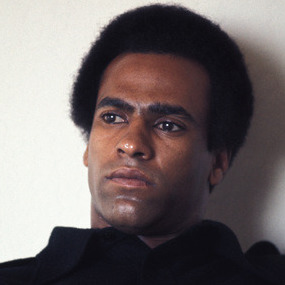 Huey P. Newton, cofounder of the Black Panther Party, is born. Despite graduating from high school not knowing how to read, he taught himself literacy by reading Plato's Republic and earned a Ph.D. in social philosophy from the University of California at Santa Cruz's History of Consciousness program in 1980. Newton crafted the Black Panther Party's ten-point manifesto with Bobby Seale in 1966. Under Newton's leadership, the Black Panther Party founded over 60 community support programs (renamed survival programs in 1971) including food banks, medical clinics, sickle cell anemia tests, prison busing for families of inmates, legal advice seminars, clothing banks, housing cooperatives, and their own ambulance service. The most famous of these programs was the Free Breakfast for Children program which fed thousands of impoverished children daily during the early 1970s. Newton also used his position as a leader within the Black Panther Party to welcome women and LGBT people into the party, describing homosexuals as "the most oppressed people" in society.Newton also co-founded the Black Panther newspaper service which became one of America's most widely distributed African-American newspapers. In 1967, he was involved in a shootout which led to the death of a police officer John Frey and injuries to himself and another police officer. In 1968, Newton was convicted of voluntary manslaughter for Frey's death and sentenced to 2 to 15 years in prison, but the conviction was later reversed and after two subsequent trials ended in hung juries, the charges were dropped. Later in life he was also accused of murdering Kathleen Smith and Betty Patter, although he was never convicted for either deaths. In 1989, Newton was murdered in Oakland, California. Learn more. Huey P. Newton, cofounder of the Black Panther Party, is born. Despite graduating from high school not knowing how to read, he taught himself literacy by reading Plato's Republic and earned a Ph.D. in social philosophy from the University of California at Santa Cruz's History of Consciousness program in 1980. Newton crafted the Black Panther Party's ten-point manifesto with Bobby Seale in 1966. Under Newton's leadership, the Black Panther Party founded over 60 community support programs (renamed survival programs in 1971) including food banks, medical clinics, sickle cell anemia tests, prison busing for families of inmates, legal advice seminars, clothing banks, housing cooperatives, and their own ambulance service. The most famous of these programs was the Free Breakfast for Children program which fed thousands of impoverished children daily during the early 1970s. Newton also used his position as a leader within the Black Panther Party to welcome women and LGBT people into the party, describing homosexuals as "the most oppressed people" in society.Newton also co-founded the Black Panther newspaper service which became one of America's most widely distributed African-American newspapers. In 1967, he was involved in a shootout which led to the death of a police officer John Frey and injuries to himself and another police officer. In 1968, Newton was convicted of voluntary manslaughter for Frey's death and sentenced to 2 to 15 years in prison, but the conviction was later reversed and after two subsequent trials ended in hung juries, the charges were dropped. Later in life he was also accused of murdering Kathleen Smith and Betty Patter, although he was never convicted for either deaths. In 1989, Newton was murdered in Oakland, California. Learn more. | |
| February 17, 1947 | 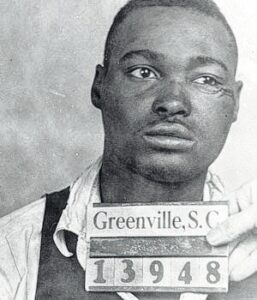 Willie Earle, a 24-year-old African American man, was being held in the Pickens County Jail in South Carolina on charges of assaulting a white taxi cab driver. A mob of white men—mostly taxi cab drivers—seized Mr. Earle from the jail, took him to a deserted country road near Greenville, brutally beat him with guns and knives, and then shot him to death. When arrested, 26 of the 31 defendants gave full statements admitting participation in Mr. Earle’s death. The defense did not rebut the confessions, but instead blamed “northern interference” for bringing the case to trial at all. At one point, the defense attorney likened Mr. Earle to a “mad dog” that deserved killing, and the mostly white spectators laughed in support. Despite the undisputed confession, the all-white jury acquitted the defendants of all charges on May 21, 1947, and the judge ordered them released. Learn more. Willie Earle, a 24-year-old African American man, was being held in the Pickens County Jail in South Carolina on charges of assaulting a white taxi cab driver. A mob of white men—mostly taxi cab drivers—seized Mr. Earle from the jail, took him to a deserted country road near Greenville, brutally beat him with guns and knives, and then shot him to death. When arrested, 26 of the 31 defendants gave full statements admitting participation in Mr. Earle’s death. The defense did not rebut the confessions, but instead blamed “northern interference” for bringing the case to trial at all. At one point, the defense attorney likened Mr. Earle to a “mad dog” that deserved killing, and the mostly white spectators laughed in support. Despite the undisputed confession, the all-white jury acquitted the defendants of all charges on May 21, 1947, and the judge ordered them released. Learn more. | |
| February 26, 1844 | 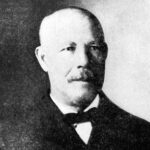 Birthday of James E. O’Hara, educator, Howard University law school graduate, practicing attorney admitted to the North Carolina bar, member of the North Carolina House of Representatives in 1868-1869, and only African American member of Congress in 1883, during the 48th Congress. O’Hara was born a free man in New York City to an Irish American father and West Indian mother, settling in North Carolina as a young man. He served two terms in congress before losing re-election in 1886. He died on September 15, 1905 in New Bern, North Carolina at age 61. Learn more. Birthday of James E. O’Hara, educator, Howard University law school graduate, practicing attorney admitted to the North Carolina bar, member of the North Carolina House of Representatives in 1868-1869, and only African American member of Congress in 1883, during the 48th Congress. O’Hara was born a free man in New York City to an Irish American father and West Indian mother, settling in North Carolina as a young man. He served two terms in congress before losing re-election in 1886. He died on September 15, 1905 in New Bern, North Carolina at age 61. Learn more.
| |
| February 26, 1926 | 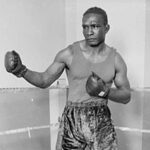 Theodore “Tiger” Flowers, nicknamed the “Georgia Deacon,” becomes the first Black middleweight boxing champion. Learn more. Theodore “Tiger” Flowers, nicknamed the “Georgia Deacon,” becomes the first Black middleweight boxing champion. Learn more. | |
| February 26, 1928 | 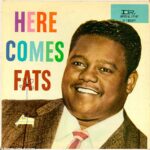 Birthday of American pianist, singer-songwriter, and pioneering rock-and-roller, Antoine Dominique “Fats” Domino Jr., whose music sold more than 65 million records. Though little known today, music historians cite his 1949 recording of “The Fat Man” as the first true rock song; it was also the first recording to sell over 1M copies. Elvis Presley called Domino “the real king of rock and roll”. Domino also set the pattern for later rock and pop acts by writing his own music, rather than merely covering songs written by other composers. Learn more.
Birthday of American pianist, singer-songwriter, and pioneering rock-and-roller, Antoine Dominique “Fats” Domino Jr., whose music sold more than 65 million records. Though little known today, music historians cite his 1949 recording of “The Fat Man” as the first true rock song; it was also the first recording to sell over 1M copies. Elvis Presley called Domino “the real king of rock and roll”. Domino also set the pattern for later rock and pop acts by writing his own music, rather than merely covering songs written by other composers. Learn more. | |
| February 27, 1902 | 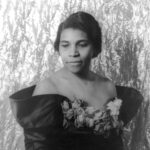 Birthday of renowned contralto opera singer Marian Anderson, an important figure in the struggle against racial prejudice. She was at the center of an international news story in 1939, when the Daughters of the American Revolution (DAR) refused to allow Anderson to sing to an integrated audience in Constitution Hall in Washington, D.C. With the aid of First Lady Eleanor Roosevelt and her husband President Franklin D. Roosevelt, Anderson performed a critically acclaimed open-air concert on Easter Sunday, April 9, 1939, on the Lincoln Memorial steps in the capital. She sang before an integrated crowd of more than 75,000 people and a radio audience in the millions. Learn more. Birthday of renowned contralto opera singer Marian Anderson, an important figure in the struggle against racial prejudice. She was at the center of an international news story in 1939, when the Daughters of the American Revolution (DAR) refused to allow Anderson to sing to an integrated audience in Constitution Hall in Washington, D.C. With the aid of First Lady Eleanor Roosevelt and her husband President Franklin D. Roosevelt, Anderson performed a critically acclaimed open-air concert on Easter Sunday, April 9, 1939, on the Lincoln Memorial steps in the capital. She sang before an integrated crowd of more than 75,000 people and a radio audience in the millions. Learn more. | |
| February 27, 1988 |  Figure skater Debi Thomas takes the bronze medal at the Winter Olympics, becoming the first black athlete to win medal at a Winter Olympics. Thomas was the 1986 World Champion and a two-time US National Champion. Learn more. Figure skater Debi Thomas takes the bronze medal at the Winter Olympics, becoming the first black athlete to win medal at a Winter Olympics. Thomas was the 1986 World Champion and a two-time US National Champion. Learn more. | |
| February 28, 1708 | 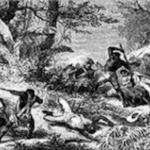 One of the first recorded revolts by enslaved people in America erupts in Newton, Long Island, NY, resulting in the deaths of seven white people. Following the rebellion, a Black woman is burned alive and one Native American man and two Black men are hanged. One of the first recorded revolts by enslaved people in America erupts in Newton, Long Island, NY, resulting in the deaths of seven white people. Following the rebellion, a Black woman is burned alive and one Native American man and two Black men are hanged. | |
| February 28, 1895 |  Bluefield Colored Institute is founded in Bluefield, West Virginia, as a “high graded school” for African American youth in the surrounding area. It is known today as Bluefield State College and is a part of West Virginia's public education system. Despite tenuous funding, hostility from the state, and distance from northern cities, the college was heavily involved in the explosion of Black American culture known as the "Harlem Renaissance” of the 1920s and 1930s. Langston Hughes read poetry, John Hope Franklin taught Negro History, and heavyweight champion Joe Louis boxed exhibitions on campus. Fats Waller, Duke Ellington, Dizzie Gillespie, and Count Basie entertained at campus events. Bluefield State's "Big Blue" football team twice won national Negro College Athletic Association championships in the late 1920s. Bluefield was one of the first historically Black colleges/universities (HBCU) to become and remain predominantly white. Learn more. Bluefield Colored Institute is founded in Bluefield, West Virginia, as a “high graded school” for African American youth in the surrounding area. It is known today as Bluefield State College and is a part of West Virginia's public education system. Despite tenuous funding, hostility from the state, and distance from northern cities, the college was heavily involved in the explosion of Black American culture known as the "Harlem Renaissance” of the 1920s and 1930s. Langston Hughes read poetry, John Hope Franklin taught Negro History, and heavyweight champion Joe Louis boxed exhibitions on campus. Fats Waller, Duke Ellington, Dizzie Gillespie, and Count Basie entertained at campus events. Bluefield State's "Big Blue" football team twice won national Negro College Athletic Association championships in the late 1920s. Bluefield was one of the first historically Black colleges/universities (HBCU) to become and remain predominantly white. Learn more. | |
| February 28, 1910 | 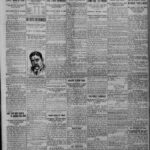 After a reported verbal altercation between an unidentifiable African American man and three white men on the evening of February 26, an armed white mob formed and began shooting at and vandalizing the storefronts of the primarily black business district in Eldorado, AR. The violence ended on February 28, upon deployment of the local National Guard unit. Following the violence a significant percentage of Eldorado’s Black population left the area. Learn more. After a reported verbal altercation between an unidentifiable African American man and three white men on the evening of February 26, an armed white mob formed and began shooting at and vandalizing the storefronts of the primarily black business district in Eldorado, AR. The violence ended on February 28, upon deployment of the local National Guard unit. Following the violence a significant percentage of Eldorado’s Black population left the area. Learn more. | |
| March 1, 1843 | 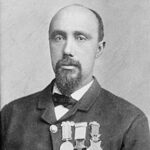 African American Union Army soldier Robert Alexander Pinn is born. Pinn received the Medal of Honor, America's highest military decoration, for his actions at the Battle of Chaffin's Farm during the American Civil War. In 1973, the Ohio National Guard named its new armory in Stow, Ohio, in his honor. In 1998, the shooting facility at the University of Akron was renamed the Robert A. Pinn Shooting Range in his honor. The range, used by the university's ROTC component and NCAA rifle team, is one of the premier shooting facilities in the state of Ohio. Learn more. African American Union Army soldier Robert Alexander Pinn is born. Pinn received the Medal of Honor, America's highest military decoration, for his actions at the Battle of Chaffin's Farm during the American Civil War. In 1973, the Ohio National Guard named its new armory in Stow, Ohio, in his honor. In 1998, the shooting facility at the University of Akron was renamed the Robert A. Pinn Shooting Range in his honor. The range, used by the university's ROTC component and NCAA rifle team, is one of the premier shooting facilities in the state of Ohio. Learn more. | |
| March 1, 1875 | 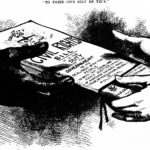 Congress passed and President Grant signed into law a Civil Rights Bill that banned discrimination in places of public accommodation. The Supreme Court overturned the law in 1883. Learn more. Congress passed and President Grant signed into law a Civil Rights Bill that banned discrimination in places of public accommodation. The Supreme Court overturned the law in 1883. Learn more. | |
| March 1, 1914 | 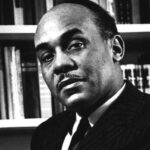 Writer and scholar Ralph Ellison is born. He is best known for his renowned, award-winning 1952 novel Invisible Man, a seminal work on marginalization from an African American protagonist's perspective. Ellison chronicled the "Invisible Man" as educated and self-aware, with a broad intellectual curiosity; invisible, but not insubstantial. Ellison's unfinished novel Juneteenth was published posthumously in 1999. Learn more. Writer and scholar Ralph Ellison is born. He is best known for his renowned, award-winning 1952 novel Invisible Man, a seminal work on marginalization from an African American protagonist's perspective. Ellison chronicled the "Invisible Man" as educated and self-aware, with a broad intellectual curiosity; invisible, but not insubstantial. Ellison's unfinished novel Juneteenth was published posthumously in 1999. Learn more. | |
| March 1, 1927 | 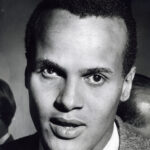 Noted American singer, actor, producer, and civil rights activist Harry Belafonte (full name Harold George Belafonte, Jr.) is born in New York City. He is a key figure in the folk music scene of the 1950s, especially known for popularizing the Caribbean folk songs known as calypsos. He is equally renowned for his conscientious involvement in the civil rights movement and other social causes. Learn more. Noted American singer, actor, producer, and civil rights activist Harry Belafonte (full name Harold George Belafonte, Jr.) is born in New York City. He is a key figure in the folk music scene of the 1950s, especially known for popularizing the Caribbean folk songs known as calypsos. He is equally renowned for his conscientious involvement in the civil rights movement and other social causes. Learn more. | |
| March 1, 1971 |  The US Defense Department curtails domestic electronic surveillance after disclosure of a "civil disturbance information collection plan" that spied on and gathered information about civil rights groups. Heavy government surveillance of peaceful, law-abiding Black Americans and civil rights groups continues to this day. Learn more here and here. The US Defense Department curtails domestic electronic surveillance after disclosure of a "civil disturbance information collection plan" that spied on and gathered information about civil rights groups. Heavy government surveillance of peaceful, law-abiding Black Americans and civil rights groups continues to this day. Learn more here and here. | |
| March 2, 1955 | 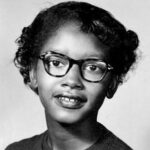 Nine months before Rosa Parks famously refused to give up her bus seat and triggered the year-long Montgomery Bus Boycott, 15-year old high school student Claudette Colvin refused to give up her seat on a Montgomery bus. Colvin was arrested, charged with disturbing the peace, as well as assault and violating the segregation law. After her arrest, Claudette Colvin was one of the plaintiffs of the historic court case Browder v. Gayle, which ruled that segregation was illegal. The Supreme Court’s subsequent affirmation of the ruling officially led to the end of segregation. In the interim, Colvin’s actions inspired planning of Parks’s action and the bus boycott later that same year. Learn more. Nine months before Rosa Parks famously refused to give up her bus seat and triggered the year-long Montgomery Bus Boycott, 15-year old high school student Claudette Colvin refused to give up her seat on a Montgomery bus. Colvin was arrested, charged with disturbing the peace, as well as assault and violating the segregation law. After her arrest, Claudette Colvin was one of the plaintiffs of the historic court case Browder v. Gayle, which ruled that segregation was illegal. The Supreme Court’s subsequent affirmation of the ruling officially led to the end of segregation. In the interim, Colvin’s actions inspired planning of Parks’s action and the bus boycott later that same year. Learn more. | |
| March 3, 1821 | 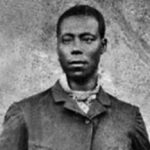 Inventor, tradesman, entrepreneur, and abolitionist Thomas L. Jennings becomes the first African American awarded a patent for his invention of modern dry cleaning. Through his invention and business acumen, Jennings built a substantial fortune which he invested in the US Abolitionist movement. Learn more. Inventor, tradesman, entrepreneur, and abolitionist Thomas L. Jennings becomes the first African American awarded a patent for his invention of modern dry cleaning. Through his invention and business acumen, Jennings built a substantial fortune which he invested in the US Abolitionist movement. Learn more. | |
| March 3, 1836 | 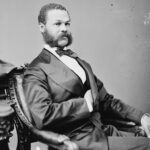 U.S. Representative Jefferson Franklin Long is born. Long was the second African American sworn into the US House of Representatives, the first African-American congressman from Georgia, and the first African-American Representative to speak on the floor of the U.S. House (opposing the Amnesty Bill that exempted former Confederates serving in the House from swearing allegiance to the Constitution). He remained the only African American to represent Georgia until Andrew Young was elected in 1972. Enslaved from birth, Long secretly taught himself to read and write (which was illegal and thus mortally dangerous for enslaved people) while setting type for a newspaper. Learn more. U.S. Representative Jefferson Franklin Long is born. Long was the second African American sworn into the US House of Representatives, the first African-American congressman from Georgia, and the first African-American Representative to speak on the floor of the U.S. House (opposing the Amnesty Bill that exempted former Confederates serving in the House from swearing allegiance to the Constitution). He remained the only African American to represent Georgia until Andrew Young was elected in 1972. Enslaved from birth, Long secretly taught himself to read and write (which was illegal and thus mortally dangerous for enslaved people) while setting type for a newspaper. Learn more. | |
| March 3, 1913 | 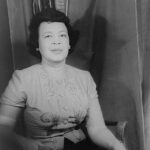 American composer, pianist, arranger, and teacher, Margaret Allison Bonds is born. One of the first Black composers and performers to gain recognition in the United States, she is best remembered today for her popular arrangements of African-American spirituals and frequent collaborations with Langston Hughes. Learn more. American composer, pianist, arranger, and teacher, Margaret Allison Bonds is born. One of the first Black composers and performers to gain recognition in the United States, she is best remembered today for her popular arrangements of African-American spirituals and frequent collaborations with Langston Hughes. Learn more. | |
| March 3, 1991 | 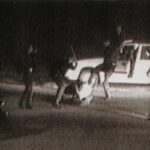 In one of the earliest instances of a widely-distributed, uninvolved bystander-captured video of extreme police brutality against an unarmed African American, author and activist Rodney King was savagely beaten by four Los Angeles police officers as he lay prone on the ground after having surrendered. The video footage sparked worldwide outrage and condemnations of the officers and the LAPD. Nonetheless, in 1992 a jury acquitted three of the four officers, and failed to reach a verdict on the fourth. Outrage over the officers’ escape from justice despite the widely-viewed video evidence and related longer-term frustrations with LAPD brutality toward the Black population, triggered 6-days of riots in Los Angeles. The federal government subsequently indicted and tried the four officers for federal civil rights violations, securing guilty verdicts and prison terms for two of the officers. In a separate civil lawsuit, a jury found the city of Los Angeles liable for the abuse and brutality inflicted on Mr. King. Learn more. In one of the earliest instances of a widely-distributed, uninvolved bystander-captured video of extreme police brutality against an unarmed African American, author and activist Rodney King was savagely beaten by four Los Angeles police officers as he lay prone on the ground after having surrendered. The video footage sparked worldwide outrage and condemnations of the officers and the LAPD. Nonetheless, in 1992 a jury acquitted three of the four officers, and failed to reach a verdict on the fourth. Outrage over the officers’ escape from justice despite the widely-viewed video evidence and related longer-term frustrations with LAPD brutality toward the Black population, triggered 6-days of riots in Los Angeles. The federal government subsequently indicted and tried the four officers for federal civil rights violations, securing guilty verdicts and prison terms for two of the officers. In a separate civil lawsuit, a jury found the city of Los Angeles liable for the abuse and brutality inflicted on Mr. King. Learn more. | |
| March 4, 1867 | 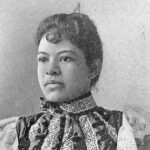 Ida Gray (also known as Ida Gray Nelson and Ida Rollins) is born. The first African-American woman to become a dentist in the United States, Dr. Gray became interested in dentistry when she went to work in the offices of Jonathan Taft, an early advocate for women to learn dentistry. After her apprenticeship in his office, Gray passed the entrance examinations and then attended the University of Michigan School of Dentistry. When she graduated, it was widely published that she was the first African American dentist in the United States and she was promoted as a role model for women to follow. Gray practiced in Ohio before settling in Chicago, where she remained until her death. The School of Dentistry at the University of Michigan gives an annual diversity award in Dr. Gray’s name. Learn more. Ida Gray (also known as Ida Gray Nelson and Ida Rollins) is born. The first African-American woman to become a dentist in the United States, Dr. Gray became interested in dentistry when she went to work in the offices of Jonathan Taft, an early advocate for women to learn dentistry. After her apprenticeship in his office, Gray passed the entrance examinations and then attended the University of Michigan School of Dentistry. When she graduated, it was widely published that she was the first African American dentist in the United States and she was promoted as a role model for women to follow. Gray practiced in Ohio before settling in Chicago, where she remained until her death. The School of Dentistry at the University of Michigan gives an annual diversity award in Dr. Gray’s name. Learn more. | |
| March 4, 1877 | 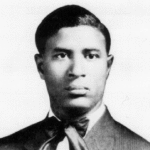 African-American inventor, businessman, and community leader Garrett Morgan is born. His most notable inventions were a the sewing machine zigzag stitch attachment, the three-color traffic signal (still in use today), and an early type of gas mask that was notably used in a 1916 tunnel construction disaster rescue. Morgan also discovered and developed a chemical hair-processing and straightening solution. He created a successful company based on his hair product inventions along with a complete line of hair-care products, and became involved in the civic and political advancement of African-Americans. Learn more. African-American inventor, businessman, and community leader Garrett Morgan is born. His most notable inventions were a the sewing machine zigzag stitch attachment, the three-color traffic signal (still in use today), and an early type of gas mask that was notably used in a 1916 tunnel construction disaster rescue. Morgan also discovered and developed a chemical hair-processing and straightening solution. He created a successful company based on his hair product inventions along with a complete line of hair-care products, and became involved in the civic and political advancement of African-Americans. Learn more. | |
| March 4, 1916 | 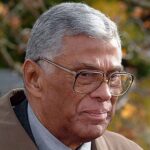 Homer E. Harris Jr., M.D., a groundbreaking African American athlete, is born. He became the first Black captain of Seattle's Garfield High School football team. He played college football for the University of Iowa, becoming the team's Most Valuable Player and the first Black player to captain a Big Ten team in 1937. He was named All-Big Ten three years in a row. Because the National Football League (NFL) was whites-only at that time, a pro-career was closed to him, despite his proven, superior skills. Instead, Harris went to medical school and became a dermatologist. He served as head coach of the North Carolina A&T football team in 1940. Dr. Harris was inducted into the Hawkeyes' Hall of Fame in 2002, and had a Seattle park named after him the same year. Homer E. Harris Jr., M.D., a groundbreaking African American athlete, is born. He became the first Black captain of Seattle's Garfield High School football team. He played college football for the University of Iowa, becoming the team's Most Valuable Player and the first Black player to captain a Big Ten team in 1937. He was named All-Big Ten three years in a row. Because the National Football League (NFL) was whites-only at that time, a pro-career was closed to him, despite his proven, superior skills. Instead, Harris went to medical school and became a dermatologist. He served as head coach of the North Carolina A&T football team in 1940. Dr. Harris was inducted into the Hawkeyes' Hall of Fame in 2002, and had a Seattle park named after him the same year. | |
| March 5, 1770 | 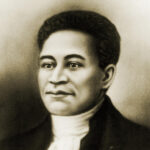 Crispus Attucks, who had previously escaped enslavement, is the first of five Americans to fall in the Boston Massacre. Learn more. Crispus Attucks, who had previously escaped enslavement, is the first of five Americans to fall in the Boston Massacre. Learn more. | |
| March 5, 1920 | 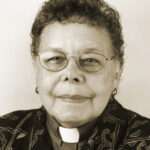 Leontine Turpeau Current Kelly, an American bishop of the United Methodist Church, is born. Bishop Kelly was only the second woman, and the first African American woman, to become a bishop in any major Christian denomination in the world. Learn more. Leontine Turpeau Current Kelly, an American bishop of the United Methodist Church, is born. Bishop Kelly was only the second woman, and the first African American woman, to become a bishop in any major Christian denomination in the world. Learn more. | |
| March 5, 1997 |  Desi Arnaz Giles, a Black actor, receives death threats after portraying Jesus in the Park Theater Performing Arts Center's annual production of the "Passion Play" in Union City, NJ. Learn more. Desi Arnaz Giles, a Black actor, receives death threats after portraying Jesus in the Park Theater Performing Arts Center's annual production of the "Passion Play" in Union City, NJ. Learn more. | |
| March 6, 1857 | 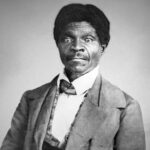 The U.S. Supreme Court issues its universally reviled 7–2 decision in Dred Scott v. Sanford (Dred Scott Decision). The case was brought by Dred Scott on behalf of himself, his wife, and their two daughters, who as enslaved people had been taken him from Missouri, which was a slave-holding state, into Illinois and the Wisconsin Territory, the laws of which forbade slavery and further provided that enslaved people became free after entering those jurisdictions. When Scott and his family were brought back to Missouri, Scott sued in court for their freedom and claimed that because they had been taken into "free" U.S. territory, they had automatically been freed and were legally no longer enslaved.
In the majority opinion written by Chief Justice Roger Taney, the Court ruled that black people "are not included, and were not intended to be included, under the word 'citizens' in the Constitution, and can therefore claim none of the rights and privileges which that instrument provides for and secures to citizens of the United States." Taney’s opinion included an extended survey of American state and local laws from the time of the Constitution's drafting in 1787 that purported to show that a "perpetual and impassable barrier was intended to be erected between the white race and the one which they had reduced to slavery." Because the Court ruled that Scott was not an American citizen, he was also not a citizen of any state and, accordingly, could never establish the "diversity of citizenship" that Article III of the US Constitution requires for a US federal court to be able to exercise jurisdiction over a case. After ruling on those issues surrounding Scott, Taney continued further and struck down the entire Missouri Compromise as a limitation on slavery that exceeded the US Congress's constitutional powers.
The decision is universally recognized as the worst Supreme Court decision of all time. The Court's rulings in Dred Scott were voided by the Thirteenth Amendment to the US Constitution, which abolished slavery except as punishment for a crime, and the Fourteenth Amendment, which guaranteed citizenship for "all persons born or naturalized in the United States, and subject to the jurisdiction thereof." The U.S. Supreme Court issues its universally reviled 7–2 decision in Dred Scott v. Sanford (Dred Scott Decision). The case was brought by Dred Scott on behalf of himself, his wife, and their two daughters, who as enslaved people had been taken him from Missouri, which was a slave-holding state, into Illinois and the Wisconsin Territory, the laws of which forbade slavery and further provided that enslaved people became free after entering those jurisdictions. When Scott and his family were brought back to Missouri, Scott sued in court for their freedom and claimed that because they had been taken into "free" U.S. territory, they had automatically been freed and were legally no longer enslaved.
In the majority opinion written by Chief Justice Roger Taney, the Court ruled that black people "are not included, and were not intended to be included, under the word 'citizens' in the Constitution, and can therefore claim none of the rights and privileges which that instrument provides for and secures to citizens of the United States." Taney’s opinion included an extended survey of American state and local laws from the time of the Constitution's drafting in 1787 that purported to show that a "perpetual and impassable barrier was intended to be erected between the white race and the one which they had reduced to slavery." Because the Court ruled that Scott was not an American citizen, he was also not a citizen of any state and, accordingly, could never establish the "diversity of citizenship" that Article III of the US Constitution requires for a US federal court to be able to exercise jurisdiction over a case. After ruling on those issues surrounding Scott, Taney continued further and struck down the entire Missouri Compromise as a limitation on slavery that exceeded the US Congress's constitutional powers.
The decision is universally recognized as the worst Supreme Court decision of all time. The Court's rulings in Dred Scott were voided by the Thirteenth Amendment to the US Constitution, which abolished slavery except as punishment for a crime, and the Fourteenth Amendment, which guaranteed citizenship for "all persons born or naturalized in the United States, and subject to the jurisdiction thereof." | |
| March 7, 1539 | 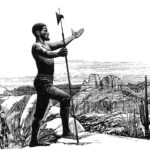 Moroccan explorer Estevanico ("Little Stephen") (modern spelling Estebanico), or as Esteban de Dorantes, sets out to explore what is now the southwestern United States. Though the first non-Native American to explore areas of the American South and West (preceding Coronado, who is widely credited in popular historical accounts), de Dorantes’s achievements in the 16th century largely remain unknown and undervalued due to his race and his status as an enslaved person. He was among the only four survivors of about 600 men that went on a Spanish (conquistador) expedition to present-day Florida in the United States of America and widely believed to be the first African to have reached the present-day USA. Learn more. Moroccan explorer Estevanico ("Little Stephen") (modern spelling Estebanico), or as Esteban de Dorantes, sets out to explore what is now the southwestern United States. Though the first non-Native American to explore areas of the American South and West (preceding Coronado, who is widely credited in popular historical accounts), de Dorantes’s achievements in the 16th century largely remain unknown and undervalued due to his race and his status as an enslaved person. He was among the only four survivors of about 600 men that went on a Spanish (conquistador) expedition to present-day Florida in the United States of America and widely believed to be the first African to have reached the present-day USA. Learn more. | |
| March 7, 1759 | 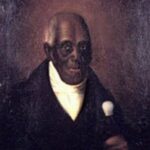 Agrippa Hull a free African-American patriot is born. An important patriot of the Revolutionary War, Hull’s relative obscurity in history is an illustration of the erasure of Black accomplishment in popular narratives. Hull was assigned by George Washington to served as an orderly to Tadeusz Kościuszko, a Polish military officer, engineer and nobleman, for five years during the American Revolutionary War. He served for a total of six years and two months. After the war, he received a veteran's pension. It was signed by George Washington, and he treasured it for the rest of his life. Born free in Northampton, Massachusetts, in 1759 in the middle of the Seven Years' War, Hull became the most significant black landowner in Stockbridge, where he lived after the Revolutionary War. He lived to the age of eighty-nine. Learn more. Agrippa Hull a free African-American patriot is born. An important patriot of the Revolutionary War, Hull’s relative obscurity in history is an illustration of the erasure of Black accomplishment in popular narratives. Hull was assigned by George Washington to served as an orderly to Tadeusz Kościuszko, a Polish military officer, engineer and nobleman, for five years during the American Revolutionary War. He served for a total of six years and two months. After the war, he received a veteran's pension. It was signed by George Washington, and he treasured it for the rest of his life. Born free in Northampton, Massachusetts, in 1759 in the middle of the Seven Years' War, Hull became the most significant black landowner in Stockbridge, where he lived after the Revolutionary War. He lived to the age of eighty-nine. Learn more. | |
| March 7, 1942 | 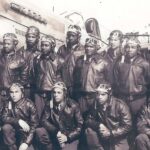 The first cadets graduate from the flight school at the Tuskegee Institute (now Tuskegee University). They were the first Black pilots in commissioned for US military service. Previously, African Americans had been denied flight service in the military specifically on account of racist discrimination. Learn more. The first cadets graduate from the flight school at the Tuskegee Institute (now Tuskegee University). They were the first Black pilots in commissioned for US military service. Previously, African Americans had been denied flight service in the military specifically on account of racist discrimination. Learn more. | |
| March 7, 1965 | 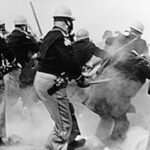 African American voting rights activists conduct the first (of three) Selma to Montgomery protest marches in March 1965. This first march is met with violent suppression and the date becomes known worldwide as “Bloody Sunday”.
The Selma to Montgomery marches were a series of marches along the 54-mile (87 km) highway from Selma, Alabama, to the state capital of Montgomery, the marches were organized by nonviolent activists to demonstrate the desire of African-American citizens to exercise their constitutional right to vote, in defiance of violent segregationist repression. The marches were part of a broader voting rights movement underway in Selma and throughout the American South. By highlighting racial injustice, they contributed to passage that year of the Voting Rights Act, a landmark federal achievement of the civil rights movement.
The Selma to Montgomery marches were preceded earlier in the year by several local and regional marches protesting the denial of voting rights. Local and state officials sought to fiercely repress the peaceful marches were fiercely suppressed, with approximately 3,000 people arrested by the end of February. On February 26, 1965, activist and deacon Jimmie Lee Jackson died after being shot several days earlier by state trooper James Bonard Fowler, during a peaceful march in nearby Marion, Alabama.
To defuse and refocus the community's outrage, James Bevel, who was directing SCLC's Selma voting rights movement, called for a march of dramatic length, from Selma to the state capital of Montgomery. The first march took place on March 7, 1965, organized locally by Bevel, Amelia Boynton, and others. State troopers and county possemen attacked the unarmed marchers with billy clubs and tear gas after they passed over the county line, and the event became known as Bloody Sunday. Law enforcement beat Boynton unconscious, and the media publicized worldwide a picture of her lying wounded on the Edmund Pettus Bridge. Learn more. African American voting rights activists conduct the first (of three) Selma to Montgomery protest marches in March 1965. This first march is met with violent suppression and the date becomes known worldwide as “Bloody Sunday”.
The Selma to Montgomery marches were a series of marches along the 54-mile (87 km) highway from Selma, Alabama, to the state capital of Montgomery, the marches were organized by nonviolent activists to demonstrate the desire of African-American citizens to exercise their constitutional right to vote, in defiance of violent segregationist repression. The marches were part of a broader voting rights movement underway in Selma and throughout the American South. By highlighting racial injustice, they contributed to passage that year of the Voting Rights Act, a landmark federal achievement of the civil rights movement.
The Selma to Montgomery marches were preceded earlier in the year by several local and regional marches protesting the denial of voting rights. Local and state officials sought to fiercely repress the peaceful marches were fiercely suppressed, with approximately 3,000 people arrested by the end of February. On February 26, 1965, activist and deacon Jimmie Lee Jackson died after being shot several days earlier by state trooper James Bonard Fowler, during a peaceful march in nearby Marion, Alabama.
To defuse and refocus the community's outrage, James Bevel, who was directing SCLC's Selma voting rights movement, called for a march of dramatic length, from Selma to the state capital of Montgomery. The first march took place on March 7, 1965, organized locally by Bevel, Amelia Boynton, and others. State troopers and county possemen attacked the unarmed marchers with billy clubs and tear gas after they passed over the county line, and the event became known as Bloody Sunday. Law enforcement beat Boynton unconscious, and the media publicized worldwide a picture of her lying wounded on the Edmund Pettus Bridge. Learn more. | |
| March 8, 1825 | 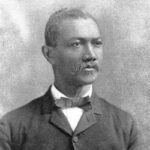 Alexander Thomas Augusta, a surgeon, veteran of the American Civil War, and the first Black professor of medicine in the United States, is born. After gaining his medical education in Toronto in the Province of Canada, from 1850 to 1856, he set up a practice there. He returned to the United States shortly before the start of the American Civil War. Augusta offered his services to the United States Army and in 1863, he was commissioned as major and the Army's first African-American physician; he became the first black hospital administrator in U.S. history while serving in the army. He left the army in 1866 at the rank of brevetlieutenant colonel. Learn more. Alexander Thomas Augusta, a surgeon, veteran of the American Civil War, and the first Black professor of medicine in the United States, is born. After gaining his medical education in Toronto in the Province of Canada, from 1850 to 1856, he set up a practice there. He returned to the United States shortly before the start of the American Civil War. Augusta offered his services to the United States Army and in 1863, he was commissioned as major and the Army's first African-American physician; he became the first black hospital administrator in U.S. history while serving in the army. He left the army in 1866 at the rank of brevetlieutenant colonel. Learn more. | |
| March 8, 1921 | 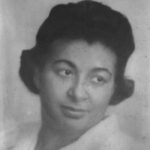 Marjorie Edwina Pitter King, the first African American woman to serve as a Washington State legislator and was one of the state's earliest African American businesswomen, is born. For nearly 50 years she owned and operated M and M Accounting and Tax Services. Pitter King also served as Chair of the 37th District Democratic Party, Vice President of the King County Democratic Party, and Treasurer of the Washington State Federation of Democratic Women, Inc. She provided leadership in drafting the National Democratic Party Platform, while attending the 1972 Democratic National Convention. Learn more. Marjorie Edwina Pitter King, the first African American woman to serve as a Washington State legislator and was one of the state's earliest African American businesswomen, is born. For nearly 50 years she owned and operated M and M Accounting and Tax Services. Pitter King also served as Chair of the 37th District Democratic Party, Vice President of the King County Democratic Party, and Treasurer of the Washington State Federation of Democratic Women, Inc. She provided leadership in drafting the National Democratic Party Platform, while attending the 1972 Democratic National Convention. Learn more. | |
| March 8, 1929 | 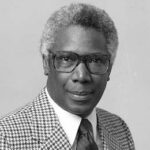 Walter R. Hundley, minister, sociologist, civil rights worker, and administrator who served in a number of important offices in Seattle government, is born. Learn more. Walter R. Hundley, minister, sociologist, civil rights worker, and administrator who served in a number of important offices in Seattle government, is born. Learn more. | |
| March 8, 1945 | 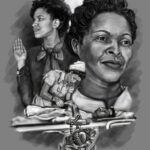 Phyllis Mae Dailey, a registered nurse, is inducted as an ensign into the United States Navy Nurse Corps. She graduated from the Lincoln School of Nursing in New York City and studied public health at Teacher's College, Columbia University. Before joining the Navy, she was denied entrance by the U.S. Air Force. Dailey was the first African American sworn in as a Navy nurse, following changes in Navy recruitment and admittance procedures that had previously excluded black women from joining the Nurse Corps.
First Lady Eleanor Roosevelt, a well known proponent for the change, had put pressure on the Marine Corps Women’s Reserve, WAVES (Women Accepted for Volunteer Emergency Service), and SPARS (the women’s component of the Coast Guard) — all subsets of the Navy — to do the same. The SPARS would finally be integrated in October 1944, and the WAVES in December 1944. The Women’s Army Auxiliary Corps (later fully incorporated and called the Women’s Army Corps) accepted African Americans beginning in January 1941, but capped the number who could serve to around 10% of the corps.
Under pressure from several directions, the Navy ended exclusion based on race in January 1945. Due to the Navy Nurse Corps being one of the last units to accept African Americans, it had the smallest representation of black women. By August 1945, when the war ended, there were just four active duty African American nurses in the Navy Nurse Corps, versus more than 6,000 that had served with the Women’s Army Corps during the war. Phyllis Mae Dailey, a registered nurse, is inducted as an ensign into the United States Navy Nurse Corps. She graduated from the Lincoln School of Nursing in New York City and studied public health at Teacher's College, Columbia University. Before joining the Navy, she was denied entrance by the U.S. Air Force. Dailey was the first African American sworn in as a Navy nurse, following changes in Navy recruitment and admittance procedures that had previously excluded black women from joining the Nurse Corps.
First Lady Eleanor Roosevelt, a well known proponent for the change, had put pressure on the Marine Corps Women’s Reserve, WAVES (Women Accepted for Volunteer Emergency Service), and SPARS (the women’s component of the Coast Guard) — all subsets of the Navy — to do the same. The SPARS would finally be integrated in October 1944, and the WAVES in December 1944. The Women’s Army Auxiliary Corps (later fully incorporated and called the Women’s Army Corps) accepted African Americans beginning in January 1941, but capped the number who could serve to around 10% of the corps.
Under pressure from several directions, the Navy ended exclusion based on race in January 1945. Due to the Navy Nurse Corps being one of the last units to accept African Americans, it had the smallest representation of black women. By August 1945, when the war ended, there were just four active duty African American nurses in the Navy Nurse Corps, versus more than 6,000 that had served with the Women’s Army Corps during the war. | |
| March 9, 1841 | 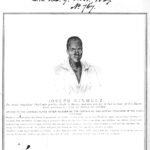 The U.S. Supreme Court issued its decision in United States v. Schooner Amistad, affirming the lower federal district court’s earlier ruling that the captive Mende Africans aboard the Schooner La Amistad were free people when they fought to escape their kidnapping and illegal confinement, entitled to take whatever legal measures necessary to secure their freedom, including the use of force, and authorizing their release. Learn more. The U.S. Supreme Court issued its decision in United States v. Schooner Amistad, affirming the lower federal district court’s earlier ruling that the captive Mende Africans aboard the Schooner La Amistad were free people when they fought to escape their kidnapping and illegal confinement, entitled to take whatever legal measures necessary to secure their freedom, including the use of force, and authorizing their release. Learn more. | |
| March 9, 1911 | 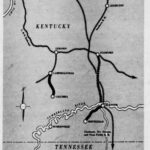 White firemen on various lines of the Cincinnati, New Orleans, and Texas Pacific Railroad went on strike and violently rioted in Somerset, KY, after the company refused to honor their demand that all Black firemen be fired within 90 days. Previously, the railroad and the white firemen had agreed that one of the three lines between Nashville and Oakland would employ Black firemen, none of whom could be promoted to engineers. In the ensuing riot violence, eight Black firemen and two deputy sheriffs were killed and locomotive cab windows were shot out of passing trains. Learn more. White firemen on various lines of the Cincinnati, New Orleans, and Texas Pacific Railroad went on strike and violently rioted in Somerset, KY, after the company refused to honor their demand that all Black firemen be fired within 90 days. Previously, the railroad and the white firemen had agreed that one of the three lines between Nashville and Oakland would employ Black firemen, none of whom could be promoted to engineers. In the ensuing riot violence, eight Black firemen and two deputy sheriffs were killed and locomotive cab windows were shot out of passing trains. Learn more. | |
| March 9, 1965 | 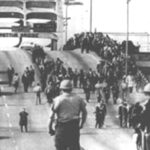 African American voting rights activists conduct the second (of three) Selma to Montgomery protest marches in March 1965. The immediately-preceding prior march, on March 7, had ended when state troopers and county possemen violently attacked the nonviolent marchers at the Edmund Pettus Bridge in an event now known as Bloody Sunday. In sharp contrast, second march ended peacefully and has come to be known as Turnaround Tuesday. It is so named because when troopers, police, and marchers confronted each other at the county end of the bridge, the troopers stepped aside to let them pass, but Martin Luther King, Jr., them led the marchers back to the church Selma church from which the March had originated. However, that evening three white Unitarian Universalist ministers in Selma for the march were attacked on the street and beaten with clubs by four KKK members. The worst injured was Reverend James Reeb from Boston. Fearing that Selma's public hospital would refuse to treat Reeb, activists took him to Birmingham's University Hospital, two hours away. Reeb died on Thursday, March 11 at University Hospital, with his wife by his side.
The Selma to Montgomery marches were a series of marches along the 54-mile (87 km) highway from Selma, Alabama, to the state capital of Montgomery. The marches were organized by nonviolent activists to demonstrate the desire of African-American citizens to exercise their constitutional right to vote, in defiance of violent segregationist repression. The marches were part of a broader voting rights movement underway in Selma and throughout the American South. By highlighting racial injustice, they contributed to passage that year of the Voting Rights Act, a landmark federal achievement of the civil rights movement. The Selma to Montgomery marches were preceded earlier in the year by several local and regional marches protesting the denial of voting rights. Local and state officials sought to fiercely repress the peaceful marches, with approximately 3,000 people arrested by the end of February. The February 18 murder of Jimmie Lee Jackson by a state trooper directly precipitated planning for the Selma to Montgomery marches. Learn more. African American voting rights activists conduct the second (of three) Selma to Montgomery protest marches in March 1965. The immediately-preceding prior march, on March 7, had ended when state troopers and county possemen violently attacked the nonviolent marchers at the Edmund Pettus Bridge in an event now known as Bloody Sunday. In sharp contrast, second march ended peacefully and has come to be known as Turnaround Tuesday. It is so named because when troopers, police, and marchers confronted each other at the county end of the bridge, the troopers stepped aside to let them pass, but Martin Luther King, Jr., them led the marchers back to the church Selma church from which the March had originated. However, that evening three white Unitarian Universalist ministers in Selma for the march were attacked on the street and beaten with clubs by four KKK members. The worst injured was Reverend James Reeb from Boston. Fearing that Selma's public hospital would refuse to treat Reeb, activists took him to Birmingham's University Hospital, two hours away. Reeb died on Thursday, March 11 at University Hospital, with his wife by his side.
The Selma to Montgomery marches were a series of marches along the 54-mile (87 km) highway from Selma, Alabama, to the state capital of Montgomery. The marches were organized by nonviolent activists to demonstrate the desire of African-American citizens to exercise their constitutional right to vote, in defiance of violent segregationist repression. The marches were part of a broader voting rights movement underway in Selma and throughout the American South. By highlighting racial injustice, they contributed to passage that year of the Voting Rights Act, a landmark federal achievement of the civil rights movement. The Selma to Montgomery marches were preceded earlier in the year by several local and regional marches protesting the denial of voting rights. Local and state officials sought to fiercely repress the peaceful marches, with approximately 3,000 people arrested by the end of February. The February 18 murder of Jimmie Lee Jackson by a state trooper directly precipitated planning for the Selma to Montgomery marches. Learn more. | |
| March 10, 1849 | 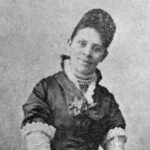 Educator, writer, and activist Hallie Quinn Brown is born to parents who had been enslaved. Brown's family moved to Canada in 1864 and then to Ohio in 1870. She graduated from Wilberforce University, Ohio, with the degree of Bachelor of Science in 1873 and a Master of Science degree in 1887, being the first woman to do so. Brown taught in schools in South Carolina, Mississippi, and Dayton, Ohio, and later at the Tuskegee Institute.
In 1893, Brown presented a paper at the World's Congress of Representative Women in Chicago. Four other African American women also presented at the conference: Anna Julia Cooper, Fannie Barrier Williams, Fanny Jackson Coppin, and Sarah Jane Woodson Early. Brown was a founder of the Colored Woman's League of Washington, D.C., which in 1894 merged into the National Association of Colored Women. She was president of the Ohio State Federation of Colored Women's Clubs from 1905 until 1912, and of the National Association of Colored Women from 1920 until 1924. She spoke at the Republican National Convention in 1924 and later directed campaign work among African-American women for President Calvin Coolidge. Brown was inducted as an honorary member of Delta Sigma Theta. Educator, writer, and activist Hallie Quinn Brown is born to parents who had been enslaved. Brown's family moved to Canada in 1864 and then to Ohio in 1870. She graduated from Wilberforce University, Ohio, with the degree of Bachelor of Science in 1873 and a Master of Science degree in 1887, being the first woman to do so. Brown taught in schools in South Carolina, Mississippi, and Dayton, Ohio, and later at the Tuskegee Institute.
In 1893, Brown presented a paper at the World's Congress of Representative Women in Chicago. Four other African American women also presented at the conference: Anna Julia Cooper, Fannie Barrier Williams, Fanny Jackson Coppin, and Sarah Jane Woodson Early. Brown was a founder of the Colored Woman's League of Washington, D.C., which in 1894 merged into the National Association of Colored Women. She was president of the Ohio State Federation of Colored Women's Clubs from 1905 until 1912, and of the National Association of Colored Women from 1920 until 1924. She spoke at the Republican National Convention in 1924 and later directed campaign work among African-American women for President Calvin Coolidge. Brown was inducted as an honorary member of Delta Sigma Theta. | |
| March 11, 1895 | 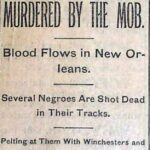 The 2-day “New Orleans Dockworkers Massacre,” an attack against black, non-union dockworkers by unionized white workers begins. The mob killed six black workers. The incident had its roots in both economic pressure and racial hatred. The men killed in the massacre were Henry James, Jules Calise Carrebe, Leonard Mallard, William Campbell, and two unknown men. Learn more. The 2-day “New Orleans Dockworkers Massacre,” an attack against black, non-union dockworkers by unionized white workers begins. The mob killed six black workers. The incident had its roots in both economic pressure and racial hatred. The men killed in the massacre were Henry James, Jules Calise Carrebe, Leonard Mallard, William Campbell, and two unknown men. Learn more. | |
| March 11, 1911 | 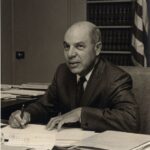 Civil rights activist, attorney, judge, and the first black American to serve as an Ambassador, Edward Dudley is born in South Boston, VA. Dudley earned a Bachelor’s degree from Johnson C. Smith College in Charlotte, NC in 1932, and a law degree from St. John’s University in New York City in 1941. In 1942 he was appointed to the New York Attorney General’s Office, where he served until he was recruited the following year by Thurgood Marshall, the Chief Legal Counsel of the National Association for the Advancement of Colored People (NAACP) to become a Special Assistant Counsel. In 1945, Dudley became the Legal Counsel to the Governor of the U.S. Virgin Islands. In 1948, President Harry Truman sent Dudley to Liberia as U.S. Envoy and Minister, elevating Dudley to the rank of Ambassador in May of 1949. In 1955 Dudley was named a judge in the New York state domestic relations court. Ambassador Dudley was elected to the New York Supreme Court in 1965. Learn more. Civil rights activist, attorney, judge, and the first black American to serve as an Ambassador, Edward Dudley is born in South Boston, VA. Dudley earned a Bachelor’s degree from Johnson C. Smith College in Charlotte, NC in 1932, and a law degree from St. John’s University in New York City in 1941. In 1942 he was appointed to the New York Attorney General’s Office, where he served until he was recruited the following year by Thurgood Marshall, the Chief Legal Counsel of the National Association for the Advancement of Colored People (NAACP) to become a Special Assistant Counsel. In 1945, Dudley became the Legal Counsel to the Governor of the U.S. Virgin Islands. In 1948, President Harry Truman sent Dudley to Liberia as U.S. Envoy and Minister, elevating Dudley to the rank of Ambassador in May of 1949. In 1955 Dudley was named a judge in the New York state domestic relations court. Ambassador Dudley was elected to the New York Supreme Court in 1965. Learn more. | |
| March 11, 1926 | 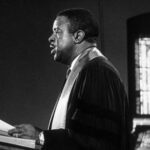 American religious leader and pioneering civil rights activist Ralph David Abernathy is born. The son of a successful farmer, Abernathy was ordained as a Baptist minister in 1948 and graduated with a B.S. degree from Alabama State University in 1950. His interest then shifted from mathematics to sociology, and he earned an M.A. degree in the latter from Atlanta University in 1951. That same year Abernathy became pastor of the First Baptist Church in Montgomery, AL.
Shortly thereafter, Rev. Abernathy met and became Dr. Martin Luther King’s chief aide and closest associate. In 1955–56, King and Abernathy organized a boycott by black citizens of the Montgomery bus system that forced the system’s racial desegregation in 1956. This nonviolent boycott marked the beginning of the civil rights movement of the following two decades. Abernathy and King subsequently co-founded the Southern Christian Leadership Conference (SCLC), respectively serving as secretary-treasurer and president. Learn more. American religious leader and pioneering civil rights activist Ralph David Abernathy is born. The son of a successful farmer, Abernathy was ordained as a Baptist minister in 1948 and graduated with a B.S. degree from Alabama State University in 1950. His interest then shifted from mathematics to sociology, and he earned an M.A. degree in the latter from Atlanta University in 1951. That same year Abernathy became pastor of the First Baptist Church in Montgomery, AL.
Shortly thereafter, Rev. Abernathy met and became Dr. Martin Luther King’s chief aide and closest associate. In 1955–56, King and Abernathy organized a boycott by black citizens of the Montgomery bus system that forced the system’s racial desegregation in 1956. This nonviolent boycott marked the beginning of the civil rights movement of the following two decades. Abernathy and King subsequently co-founded the Southern Christian Leadership Conference (SCLC), respectively serving as secretary-treasurer and president. Learn more. | |
| March 11, 1959 | 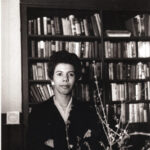 Lorraine Hansberry’s landmark play, A Raisin in the Sun, premieres on Broadway. It is the first play written by a Black woman to be produced on Broadway, as well as the first with a Black director, Mr. Lloyd Richards, and featuring a cast in which all but one character is Black. The production would be nominated for four Tony Awards: Best Play – written by Lorraine Hansberry; produced by Philip Rose, David J. Cogan; Best Actor in Play – Sidney Poitier; Best Actress in a Play – Claudia McNeil; and Best Direction of a Play – Lloyd Richards. Publications such as The Independent and Time Out have listed it among the best plays ever written. Learn more.
Lorraine Hansberry’s landmark play, A Raisin in the Sun, premieres on Broadway. It is the first play written by a Black woman to be produced on Broadway, as well as the first with a Black director, Mr. Lloyd Richards, and featuring a cast in which all but one character is Black. The production would be nominated for four Tony Awards: Best Play – written by Lorraine Hansberry; produced by Philip Rose, David J. Cogan; Best Actor in Play – Sidney Poitier; Best Actress in a Play – Claudia McNeil; and Best Direction of a Play – Lloyd Richards. Publications such as The Independent and Time Out have listed it among the best plays ever written. Learn more. | |
| March 11, 1965 | 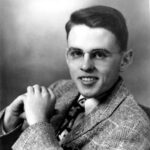 While participating in the Selma to Montgomery marches actions in Selma, Alabama, in 1965, ally James Reeb is murdered by white segregationists, dying of head injuries in the hospital two days after being severely beaten (on the evening of March 9, 1965, following the 2nd Selma to Montgomery protest March earlier that day). Reeb was a 38-year old American Unitarian Universalistminister, pastor, and activist during the civil rights movement in Washington, D.C. and Boston, Massachusetts. Three men were tried for Reeb's murder but were acquitted by an all-white jury. His murder remains officially unsolved. Learn more. While participating in the Selma to Montgomery marches actions in Selma, Alabama, in 1965, ally James Reeb is murdered by white segregationists, dying of head injuries in the hospital two days after being severely beaten (on the evening of March 9, 1965, following the 2nd Selma to Montgomery protest March earlier that day). Reeb was a 38-year old American Unitarian Universalistminister, pastor, and activist during the civil rights movement in Washington, D.C. and Boston, Massachusetts. Three men were tried for Reeb's murder but were acquitted by an all-white jury. His murder remains officially unsolved. Learn more. | |
| March 12, 1895 |  The 2-day “New Orleans Dockworkers Massacre,” an attack against black, non-union dockworkers by unionized white workers finally ends after Governor Murphy calls in the state militia. The mob killed six black workers. The incident had its roots in both economic pressure and racial hatred. The men killed in the massacre were Henry James, Jules Calise Carrebe, Leonard Mallard, William Campbell, and two unknown men. Learn more. The 2-day “New Orleans Dockworkers Massacre,” an attack against black, non-union dockworkers by unionized white workers finally ends after Governor Murphy calls in the state militia. The mob killed six black workers. The incident had its roots in both economic pressure and racial hatred. The men killed in the massacre were Henry James, Jules Calise Carrebe, Leonard Mallard, William Campbell, and two unknown men. Learn more. | |
| March 12, 1932 | 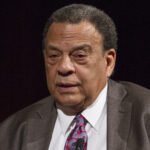 Andrew Jackson Young Jr., an American politician, diplomat, and activist, is born. Beginning his career as a pastor, Young was an early leader in the civil rights movement, serving as executive director of the Southern Christian Leadership Conference (SCLC) and a close confidant to Martin Luther King Jr. Young later became active in politics, serving as a U.S. Congressman from Georgia, United States Ambassador to the United Nations in the Carter Administration, and 55th Mayor of Atlanta. Since leaving office, Young has founded or served in many organizations working on issues of public policy and political lobbying. Learn more.
Andrew Jackson Young Jr., an American politician, diplomat, and activist, is born. Beginning his career as a pastor, Young was an early leader in the civil rights movement, serving as executive director of the Southern Christian Leadership Conference (SCLC) and a close confidant to Martin Luther King Jr. Young later became active in politics, serving as a U.S. Congressman from Georgia, United States Ambassador to the United Nations in the Carter Administration, and 55th Mayor of Atlanta. Since leaving office, Young has founded or served in many organizations working on issues of public policy and political lobbying. Learn more. | |
| March 13, 1773 | 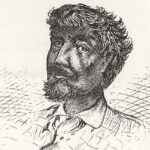 Jean Baptiste Point du Sable, a free African American (born around the year 1750 in Haiti), establishes the settlement that is now known as Chicago, Illinois. In Chicago, Point du Sable is recognized as it’s founder and his name is honored around the city on a bridge, museum, park and in other areas. Point du Sable was a wealthy trader and landowner. He later moved to St. Charles, Missouri and it was there that he died on August 28,1818. Learn more. Jean Baptiste Point du Sable, a free African American (born around the year 1750 in Haiti), establishes the settlement that is now known as Chicago, Illinois. In Chicago, Point du Sable is recognized as it’s founder and his name is honored around the city on a bridge, museum, park and in other areas. Point du Sable was a wealthy trader and landowner. He later moved to St. Charles, Missouri and it was there that he died on August 28,1818. Learn more. | |
| March 13, 1932 | 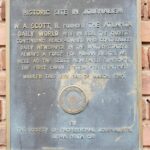 Founded by William A. Scott II, the Atlanta Daily World, the first Black daily newspaper, begins publication. Scott was a Morehouse graduate who later worked as the only black clerk on the Jacksonville to Washington, D.C., rail line, then in 1927 published a Jacksonville business directory to help blacks find each other. A year later, Scott, who was only 26 at the time, began publishing a similar directory for Atlanta. The paper became a semi-weekly in May 1930, triweekly in April 1931, and became a daily and added "Daily" to its title on March 13, 1932. In 1931, Scott also began publishing the Chattanooga Tribune and Memphis World, and by doing so, founded the first chain of Black newspapers, a chain that would eventually grow, at its peak, to fifty publications. Learn more. Founded by William A. Scott II, the Atlanta Daily World, the first Black daily newspaper, begins publication. Scott was a Morehouse graduate who later worked as the only black clerk on the Jacksonville to Washington, D.C., rail line, then in 1927 published a Jacksonville business directory to help blacks find each other. A year later, Scott, who was only 26 at the time, began publishing a similar directory for Atlanta. The paper became a semi-weekly in May 1930, triweekly in April 1931, and became a daily and added "Daily" to its title on March 13, 1932. In 1931, Scott also began publishing the Chattanooga Tribune and Memphis World, and by doing so, founded the first chain of Black newspapers, a chain that would eventually grow, at its peak, to fifty publications. Learn more. | |
| March 13, 1964 | 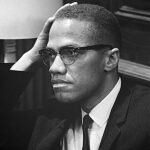 Malcolm X announces his split from Elijah Muhammad's Nation of Islam. Learn more. Malcolm X announces his split from Elijah Muhammad's Nation of Islam. Learn more. | |
| March 13, 2020 |  Breonna Taylor, a 26-year-old African-American woman and decorated Emergency Medical Technician (EMT), is shot and killed in her Louisville, Kentucky, apartment on March 13, 2020, when white plainclothes officers Jonathan Mattingly, Brett Hankison, and Myles Cosgrove of the Louisville Metro Police Department (LMPD) force entry into the apartment unannounced. Taylor's boyfriend, Kenneth Walker, was inside the apartment with her when the officers knocked on the door and then forced entry. Walker thought the officers were intruders and fired a warning shot at them. According to officials, it hit Mattingly in the leg; in return, the officers blindly fired 32 shots during two "flurries" or waves of shots separated by one minute and eight seconds. Walker was unhurt but Taylor was hit by six bullets and died. The shooting of Taylor by police officers led to numerous protests across the United States against police brutality and racism, especially in the aftermath of the subsequent police killing of George Floyd in Minnesota and a grand jury’s failure to indict the officers for Taylor’s death. Learn more. Breonna Taylor, a 26-year-old African-American woman and decorated Emergency Medical Technician (EMT), is shot and killed in her Louisville, Kentucky, apartment on March 13, 2020, when white plainclothes officers Jonathan Mattingly, Brett Hankison, and Myles Cosgrove of the Louisville Metro Police Department (LMPD) force entry into the apartment unannounced. Taylor's boyfriend, Kenneth Walker, was inside the apartment with her when the officers knocked on the door and then forced entry. Walker thought the officers were intruders and fired a warning shot at them. According to officials, it hit Mattingly in the leg; in return, the officers blindly fired 32 shots during two "flurries" or waves of shots separated by one minute and eight seconds. Walker was unhurt but Taylor was hit by six bullets and died. The shooting of Taylor by police officers led to numerous protests across the United States against police brutality and racism, especially in the aftermath of the subsequent police killing of George Floyd in Minnesota and a grand jury’s failure to indict the officers for Taylor’s death. Learn more. | |
| March 14, 1821 | 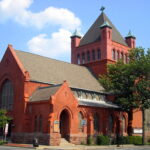 The African Methodist Episcopal Zion Church, or the AME Zion Church or AMEZ, a historically African-American Christian denomination based in the United States, is officially formed in New York City. However, it had operated for a number of years before then. The origins of the church can be traced to the John Street Methodist Church of New York City. Following acts of overt discrimination (such as black parishioners being forced to leave worship), many black Christians left to form their own churches. The first church founded by the AME Zion Church was built in 1800 and was named Zion; one of the founders was William Hamilton, a prominent orator and abolitionist. These early black churches still belonged to the Methodist Episcopal Church denomination, although the congregations were independent. The fledgling Zion church grew, and soon multiple churches developed from the original congregation. In 1820, six of the churches met to ordain James Varick as an elder, and in 1821 he was made the first General Superintendent of the AME Zion Church. A debate raged in the white-dominated Methodist church over accepting black ministers. The debate ended on July 30, 1822, when James Varick was ordained as the first bishop of the AME Zion church, a newly independent denomination.
The African Methodist Episcopal Zion Church, or the AME Zion Church or AMEZ, a historically African-American Christian denomination based in the United States, is officially formed in New York City. However, it had operated for a number of years before then. The origins of the church can be traced to the John Street Methodist Church of New York City. Following acts of overt discrimination (such as black parishioners being forced to leave worship), many black Christians left to form their own churches. The first church founded by the AME Zion Church was built in 1800 and was named Zion; one of the founders was William Hamilton, a prominent orator and abolitionist. These early black churches still belonged to the Methodist Episcopal Church denomination, although the congregations were independent. The fledgling Zion church grew, and soon multiple churches developed from the original congregation. In 1820, six of the churches met to ordain James Varick as an elder, and in 1821 he was made the first General Superintendent of the AME Zion Church. A debate raged in the white-dominated Methodist church over accepting black ministers. The debate ended on July 30, 1822, when James Varick was ordained as the first bishop of the AME Zion church, a newly independent denomination. | |
| March 14, 1977 | 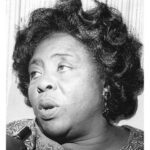 Civil rights activist Fannie Lou Hamer, called "the spirit of the civil rights movement,” dies. Born a sharecropper, she worked from the age of six as a timekeeper on a cotton plantation. Later, she became involved in the Black Freedom Struggle and eventually moved on to become a field secretary for the Student Nonviolent Coordinating Committee (SNCC). Because African Americans were excluded from the Mississippi Democratic Party, the Mississippi Freedom Democratic Party (MFDP) was formed, with Fannie Lou Hamer as a founding member and vice president. She also lectured extensively, and was known for a signature line she often used, "I'm sick and tired of being sick and tired." She was known as a powerful speaker, and her singing voice lent another power to civil rights meetings. Suffering from breast cancer, diabetes, and heart problems, Fannie Lou Hamer died in Mississippi. Learn more. Civil rights activist Fannie Lou Hamer, called "the spirit of the civil rights movement,” dies. Born a sharecropper, she worked from the age of six as a timekeeper on a cotton plantation. Later, she became involved in the Black Freedom Struggle and eventually moved on to become a field secretary for the Student Nonviolent Coordinating Committee (SNCC). Because African Americans were excluded from the Mississippi Democratic Party, the Mississippi Freedom Democratic Party (MFDP) was formed, with Fannie Lou Hamer as a founding member and vice president. She also lectured extensively, and was known for a signature line she often used, "I'm sick and tired of being sick and tired." She was known as a powerful speaker, and her singing voice lent another power to civil rights meetings. Suffering from breast cancer, diabetes, and heart problems, Fannie Lou Hamer died in Mississippi. Learn more. | |
| March 15, 1815 | 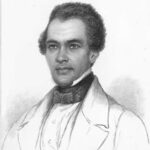 William Wells Brown, a prominent African-American abolitionist lecturer, novelist, playwright, and historian in the United States, is (estimated to have been) born into slavery in Montgomery County, Kentucky, near the town of Mount Sterling. Brown escaped to Ohio in 1834 at the age of 19. He settled in Boston, Massachusetts, where he worked for abolitionist causes and became a prolific writer. While working for abolition, Brown also supported causes including: temperance, women's suffrage, pacifism, prison reform, and an anti-tobacco movement. His novel Clotel (1853), considered the first novel written by an African American, was published in London, England, where he resided at the time; it was later published in the United States. Brown was an African-American pioneer in several different literary genres, including travel writing, fiction, and drama. In 1858 he became the first published African-American playwright, and often read from this work on the lecture circuit. Following the Civil War, in 1867 he published what is considered the first history of African Americans in the Revolutionary War. He was among the first writers inducted to the Kentucky Writers Hall of Fame, established in 2013. A public school was named for him in Lexington, Kentucky. Learn more. William Wells Brown, a prominent African-American abolitionist lecturer, novelist, playwright, and historian in the United States, is (estimated to have been) born into slavery in Montgomery County, Kentucky, near the town of Mount Sterling. Brown escaped to Ohio in 1834 at the age of 19. He settled in Boston, Massachusetts, where he worked for abolitionist causes and became a prolific writer. While working for abolition, Brown also supported causes including: temperance, women's suffrage, pacifism, prison reform, and an anti-tobacco movement. His novel Clotel (1853), considered the first novel written by an African American, was published in London, England, where he resided at the time; it was later published in the United States. Brown was an African-American pioneer in several different literary genres, including travel writing, fiction, and drama. In 1858 he became the first published African-American playwright, and often read from this work on the lecture circuit. Following the Civil War, in 1867 he published what is considered the first history of African Americans in the Revolutionary War. He was among the first writers inducted to the Kentucky Writers Hall of Fame, established in 2013. A public school was named for him in Lexington, Kentucky. Learn more. | |
| March 15, 1842 | 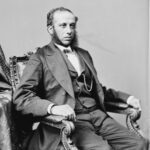 Robert Carlos De Large is born in Aiken, South Carolina, the mixed-race son of a Haitian free woman of color and a Sephardi Jewish father; some scholars suggest both parents were of mixed race. De Large graduated high school and became a tailor and farmer. As a young man, De Large became a member of the Brown Fellowship Society of Charleston, made up of people of color who had been free before the war. They were among the elite African Americans in the city who were skilled artisans and led the people of color. De Large was a Republican member of the United States House of Representatives from South Carolina, serving 1871 to 1873. He was earlier a delegate to the 1868 state constitutional convention and elected in 1868 to the South Carolina House of Representatives for one term. Learn more. Robert Carlos De Large is born in Aiken, South Carolina, the mixed-race son of a Haitian free woman of color and a Sephardi Jewish father; some scholars suggest both parents were of mixed race. De Large graduated high school and became a tailor and farmer. As a young man, De Large became a member of the Brown Fellowship Society of Charleston, made up of people of color who had been free before the war. They were among the elite African Americans in the city who were skilled artisans and led the people of color. De Large was a Republican member of the United States House of Representatives from South Carolina, serving 1871 to 1873. He was earlier a delegate to the 1868 state constitutional convention and elected in 1868 to the South Carolina House of Representatives for one term. Learn more. | |
| March 15, 1947 |  Lt. Commander John W. Lee Jr. becomes the first Black commissioned Navy officer. The late Navy man made it his personal mission to aid other qualified Black servicemen in his branch to get the same opportunities he did. Lee was born February 13, 1924 and raised in Indianapolis, Indiana, entering the Navy during WWII. After boot camp, he was admitted into the V-12 Officer Candidate Program at Indianapolis’ DePauw University and graduated as an Ensign. Lee believed other Black Navy men could have become officers and worked behind the scenes to move things into that direction. Lee also served in WWII and the Korean War. In 1960, Lee became the commanding officer of the Oceanographic Detachment Two division. Before his retirement in 1966, Lee served on the NATO staff in Paris and left the Navy with the rank of Lieutenant Commander. Afterwards, he worked two years for Indianapolis’ Naval Avionics Center. Learn more. Lt. Commander John W. Lee Jr. becomes the first Black commissioned Navy officer. The late Navy man made it his personal mission to aid other qualified Black servicemen in his branch to get the same opportunities he did. Lee was born February 13, 1924 and raised in Indianapolis, Indiana, entering the Navy during WWII. After boot camp, he was admitted into the V-12 Officer Candidate Program at Indianapolis’ DePauw University and graduated as an Ensign. Lee believed other Black Navy men could have become officers and worked behind the scenes to move things into that direction. Lee also served in WWII and the Korean War. In 1960, Lee became the commanding officer of the Oceanographic Detachment Two division. Before his retirement in 1966, Lee served on the NATO staff in Paris and left the Navy with the rank of Lieutenant Commander. Afterwards, he worked two years for Indianapolis’ Naval Avionics Center. Learn more. | |
| March 16, 1827 | 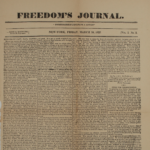 Freedom's Journal, the first African-American owned and operated newspaper published in the United States, is founded by Rev. John Wilk and other free black men in New York City, published weekly starting with the 16 March 1827 issue. Freedom's Journal was superseded in 1829 by The Rights of All, published between 1829 and 1830 by Samuel Cornish, the former senior editor of the Journal. Learn more. Freedom's Journal, the first African-American owned and operated newspaper published in the United States, is founded by Rev. John Wilk and other free black men in New York City, published weekly starting with the 16 March 1827 issue. Freedom's Journal was superseded in 1829 by The Rights of All, published between 1829 and 1830 by Samuel Cornish, the former senior editor of the Journal. Learn more. | |
| March 16, 1846 | 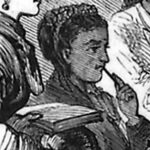 Physician, organization founder, and social reformer Rebecca J. Cole is born. In 1867, she became the second African-American woman to become a doctor in the United States (after Rebecca Lee Crumpler's achievement three years earlier). Throughout her life, Dr Cole overcame racial and gender barriers to medical education by training in all-female institutions run by women who had been part of the first generation of female physicians graduating mid-century. Learn more. Physician, organization founder, and social reformer Rebecca J. Cole is born. In 1867, she became the second African-American woman to become a doctor in the United States (after Rebecca Lee Crumpler's achievement three years earlier). Throughout her life, Dr Cole overcame racial and gender barriers to medical education by training in all-female institutions run by women who had been part of the first generation of female physicians graduating mid-century. Learn more. | |
| March 17, 1806 | 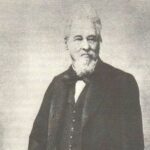 Mixed race inventor Norbert Rillieux is born. Rillieux is widely considered one of the earliest chemical engineers and is noted for his pioneering invention of the multiple-effect evaporator. This invention was an important development in the growth of the sugar industry. Rillieux was born into a prominent Creole family in New Orleans, Louisiana, the son of Vincent Rillieux, a white plantation owner and inventor, and Constance Vivant, a free person of color. Learn more. Mixed race inventor Norbert Rillieux is born. Rillieux is widely considered one of the earliest chemical engineers and is noted for his pioneering invention of the multiple-effect evaporator. This invention was an important development in the growth of the sugar industry. Rillieux was born into a prominent Creole family in New Orleans, Louisiana, the son of Vincent Rillieux, a white plantation owner and inventor, and Constance Vivant, a free person of color. Learn more. | |
| March 17, 1896 | 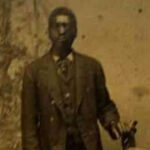 African American inventor Charles B. Brooks receives US Patent #556,711 for his street sweeper design. Unlike other sweepers at that time (1890s), Brooks’ sweeper was the first self-propelled street sweeping truck. His design had revolving brushes attached to the front fender, and the brushes were interchangeable so that when snow fell, scrapers could be attached for snow removal. Learn more. African American inventor Charles B. Brooks receives US Patent #556,711 for his street sweeper design. Unlike other sweepers at that time (1890s), Brooks’ sweeper was the first self-propelled street sweeping truck. His design had revolving brushes attached to the front fender, and the brushes were interchangeable so that when snow fell, scrapers could be attached for snow removal. Learn more. | |
| March 17, 1912 | 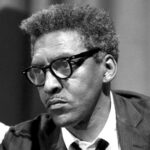 Civil rights organizer Bayard Rustin is born. A key advisor to Dr. Martin Luther King, Jr, Rustin is credited with introducing King to and expanding his knowledge of non-violence. Rustin was instrumental in organizing the Montgomery bus boycot and the March on Washington, among other historic actions. A Quaker, Rustin studied Gandhian non-violence in India in 1948, and helped organize independence movements in Africa in the early 1950s. A gay man, Rustin was suffered arrest and conviction on charges related to homosexual activity. Rustin was likewise persecuted for his status as a conscientious objector and spent two years in prison during WWII as a result. While Rustin’s homosexuality and former affiliation with the Communist Party led some to question King’s relationship with him, King recognized the importance of Rustin’s skills and dedication to the movement. In a 1960 letter, King told a colleague: “We are thoroughly committed to the method of nonviolence in our struggle and we are convinced that Bayard’s expertness and commitment in this area will be of inestimable value”. Learn more. Civil rights organizer Bayard Rustin is born. A key advisor to Dr. Martin Luther King, Jr, Rustin is credited with introducing King to and expanding his knowledge of non-violence. Rustin was instrumental in organizing the Montgomery bus boycot and the March on Washington, among other historic actions. A Quaker, Rustin studied Gandhian non-violence in India in 1948, and helped organize independence movements in Africa in the early 1950s. A gay man, Rustin was suffered arrest and conviction on charges related to homosexual activity. Rustin was likewise persecuted for his status as a conscientious objector and spent two years in prison during WWII as a result. While Rustin’s homosexuality and former affiliation with the Communist Party led some to question King’s relationship with him, King recognized the importance of Rustin’s skills and dedication to the movement. In a 1960 letter, King told a colleague: “We are thoroughly committed to the method of nonviolence in our struggle and we are convinced that Bayard’s expertness and commitment in this area will be of inestimable value”. Learn more. | |
| March 18, 1933 |  Unita Zelma Blackwell, American civil rights activist who was the first African-American woman to be elected mayor in the U.S. state of Mississippi, is born. Blackwell was a project director for the Student Nonviolent Coordinating Committee (SNCC) and helped organize voter drives for African Americans across Mississippi. She was also a founder of the US China Peoples Friendship Association, a group dedicated to promoting cultural exchange between the United States and China. Learn more. Unita Zelma Blackwell, American civil rights activist who was the first African-American woman to be elected mayor in the U.S. state of Mississippi, is born. Blackwell was a project director for the Student Nonviolent Coordinating Committee (SNCC) and helped organize voter drives for African Americans across Mississippi. She was also a founder of the US China Peoples Friendship Association, a group dedicated to promoting cultural exchange between the United States and China. Learn more. | |
| March 19, 1883 | 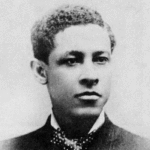 African American inventor Jan Ernst Matzeliger is issued US Patent # 274,307, for his invention of the automatic shoe lasting machine. The machine substantially automated the production of shoes, cutting the cost by over half and creating the mass produced shoe industry. Learn more. African American inventor Jan Ernst Matzeliger is issued US Patent # 274,307, for his invention of the automatic shoe lasting machine. The machine substantially automated the production of shoes, cutting the cost by over half and creating the mass produced shoe industry. Learn more. | |
| March 19, 1891 | 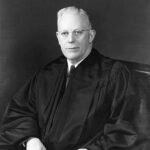 Earl Warren, who served as Chief Justice of the United States from 1953 to 1969, is born. The "Warren Court" presided over major advances in American constitutional jurisprudence, especially in regard to civil rights. Warren wrote the majority opinions in landmark cases such as Brown v. Board of Education (1954), Reynolds v. Sims (1964), Miranda v. Arizona (1966), and Loving v. Virginia (1967). Learn more. Earl Warren, who served as Chief Justice of the United States from 1953 to 1969, is born. The "Warren Court" presided over major advances in American constitutional jurisprudence, especially in regard to civil rights. Warren wrote the majority opinions in landmark cases such as Brown v. Board of Education (1954), Reynolds v. Sims (1964), Miranda v. Arizona (1966), and Loving v. Virginia (1967). Learn more. | |
| March 20, 1852 | 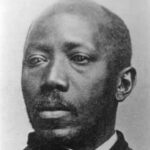 Martin Robison Delany, an African-American abolitionist, journalist, physician, soldier, and writer, and arguably the first proponent of black nationalism, publishes his book, The Condition, Elevation, Emigration, and Destiny of the Colored People of the United States, Politically Considered. It is considered the first statement of the Black nationalist position. Delany wrote, "The claims of no people, according to established policy and usage, are respected by any nation, until they are presented in a national capacity." He added: "We are a nation within a nation; as the Poles in Russia, the Hungarians in Austria, the Welsh, Irish, and Scotch in the British dominions." Learn more. Martin Robison Delany, an African-American abolitionist, journalist, physician, soldier, and writer, and arguably the first proponent of black nationalism, publishes his book, The Condition, Elevation, Emigration, and Destiny of the Colored People of the United States, Politically Considered. It is considered the first statement of the Black nationalist position. Delany wrote, "The claims of no people, according to established policy and usage, are respected by any nation, until they are presented in a national capacity." He added: "We are a nation within a nation; as the Poles in Russia, the Hungarians in Austria, the Welsh, Irish, and Scotch in the British dominions." Learn more. | |
| March 20, 1910 | 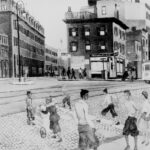 Boston-based African American artist Allan Rohan Crite is born. Crite won several honors, including the 350th Harvard University Anniversary Medal. Crite sought to depict the life of African-Americans living in Boston in a new and different way: as ordinary citizens or the "middle class" rather than stereotypical jazz musicians or sharecroppers. Through his art, he intended to tell the story of African Americans as part of the fabric of American society and its reality. By using representational style rather than modernism, Crite felt that he could more adequately "report" and capture the reality that African Americans were part of but often unaccounted for. Crite explained his body of work as having a common theme: “I've only done one piece of work in my whole life and I am still at it. I wanted to paint people of color as normal humans. I tell the story of man through the black figure.” [Image of Crite’s painting, Douglass Square, Boston. Oil. 20" x 24". 1936. Commissioned by the Federal Arts Project]. Learn more. Boston-based African American artist Allan Rohan Crite is born. Crite won several honors, including the 350th Harvard University Anniversary Medal. Crite sought to depict the life of African-Americans living in Boston in a new and different way: as ordinary citizens or the "middle class" rather than stereotypical jazz musicians or sharecroppers. Through his art, he intended to tell the story of African Americans as part of the fabric of American society and its reality. By using representational style rather than modernism, Crite felt that he could more adequately "report" and capture the reality that African Americans were part of but often unaccounted for. Crite explained his body of work as having a common theme: “I've only done one piece of work in my whole life and I am still at it. I wanted to paint people of color as normal humans. I tell the story of man through the black figure.” [Image of Crite’s painting, Douglass Square, Boston. Oil. 20" x 24". 1936. Commissioned by the Federal Arts Project]. Learn more. | |
| March 20, 1950 | 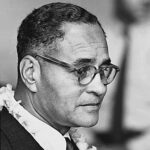 Ralph Johnson Bunche, PhD, an American political scientist, academic, and diplomat, receives the 1950 Nobel Peace Prize for his late 1940s mediation in Israel. Dr. Bunche was the first African American to be so honored.
Dr Bunche graduated graduated summa cum laude and Phi Beta Kappa in 1927 as the valedictorian of his class from the University of California, Los Angeles (UCLA). He earned a doctorate in political science from Harvard University in 1934, the first African American to gain a PhD in political science from an American university. He published his first book, World View of Race, in 1936. From 1928 to 1950, Dr Bunche served as chair of the Department of Political Science at Howard University, where he also taught generations of students. Dr Bunche was elected to the American Philosophical Society in 1950, the first Black member to be inducted into the Society since its founding in 1743. Dr Bunche was involved in the formation and administration of the United Nations and played a major role in numerous peacekeeping operations sponsored by the UN. In 1963, he was awarded the Presidential Medal of Freedom by President John F. Kennedy. Learn more. Ralph Johnson Bunche, PhD, an American political scientist, academic, and diplomat, receives the 1950 Nobel Peace Prize for his late 1940s mediation in Israel. Dr. Bunche was the first African American to be so honored.
Dr Bunche graduated graduated summa cum laude and Phi Beta Kappa in 1927 as the valedictorian of his class from the University of California, Los Angeles (UCLA). He earned a doctorate in political science from Harvard University in 1934, the first African American to gain a PhD in political science from an American university. He published his first book, World View of Race, in 1936. From 1928 to 1950, Dr Bunche served as chair of the Department of Political Science at Howard University, where he also taught generations of students. Dr Bunche was elected to the American Philosophical Society in 1950, the first Black member to be inducted into the Society since its founding in 1743. Dr Bunche was involved in the formation and administration of the United Nations and played a major role in numerous peacekeeping operations sponsored by the UN. In 1963, he was awarded the Presidential Medal of Freedom by President John F. Kennedy. Learn more. | |
| March 21, 1861 | 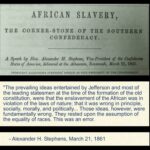 Unintentionally and preemptively exposing later, persisting revisionist lies about the reason for the Civil War, Confederate Vice President Alexander H. Stephens delivers the “Cornerstone Speech” in Savannah, Georgia, laying out the rationale for secession and identifying slavery as the “immediate cause” of secession. Stephens declared that Thomas Jefferson’s and other founding fathers’ ambivalence about slavery, was misplaced and unwarranted, and that servitude and subordination to the white race was the “natural and normal condition” of blacks in the South. Learn more. Unintentionally and preemptively exposing later, persisting revisionist lies about the reason for the Civil War, Confederate Vice President Alexander H. Stephens delivers the “Cornerstone Speech” in Savannah, Georgia, laying out the rationale for secession and identifying slavery as the “immediate cause” of secession. Stephens declared that Thomas Jefferson’s and other founding fathers’ ambivalence about slavery, was misplaced and unwarranted, and that servitude and subordination to the white race was the “natural and normal condition” of blacks in the South. Learn more. | |
| March 21, 1938 | 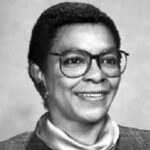 Lois Jean Barron White, the first African American President of the National Parent Teacher Association (PTA) is born in Nashville, Tennessee. White earned a B.A. in Music at Fisk University, Nashville, Tennessee in 1960 and received further training at Indiana University. She then taught music at Mills College in Birmingham, Alabama from 1960 to 1962. In 1963 she became a member of the Community Orchestra of Atlanta; in 1967 she joined Oak Ridge Symphony Orchestra in Knoxville, Tennessee, serving primarily as a principal flutist. She retired in 1991 after 24 years with the Orchestra. In 1989 White became the first African American elected Tennessee State PTA President. Six years later, in 1995, she was elected president of the National PTA. As president she led nearly 6.5 million parents, teachers, school administrators, and other children’s advocates in teaching parenting skills, supporting public education, and advocating for legislation at the national level that would positively affect children’s lives. White worked to address the problems of urban families, a population previously neglected by PTA efforts. Under her leadership the PTA developed programs that encouraged inner city children to stay and succeed in school. She also led the effort to bring PTA to inner city neighborhoods in New York City, Boston, and Philadelphia and other major cities where the organization had not previously existed. Learn more. Lois Jean Barron White, the first African American President of the National Parent Teacher Association (PTA) is born in Nashville, Tennessee. White earned a B.A. in Music at Fisk University, Nashville, Tennessee in 1960 and received further training at Indiana University. She then taught music at Mills College in Birmingham, Alabama from 1960 to 1962. In 1963 she became a member of the Community Orchestra of Atlanta; in 1967 she joined Oak Ridge Symphony Orchestra in Knoxville, Tennessee, serving primarily as a principal flutist. She retired in 1991 after 24 years with the Orchestra. In 1989 White became the first African American elected Tennessee State PTA President. Six years later, in 1995, she was elected president of the National PTA. As president she led nearly 6.5 million parents, teachers, school administrators, and other children’s advocates in teaching parenting skills, supporting public education, and advocating for legislation at the national level that would positively affect children’s lives. White worked to address the problems of urban families, a population previously neglected by PTA efforts. Under her leadership the PTA developed programs that encouraged inner city children to stay and succeed in school. She also led the effort to bring PTA to inner city neighborhoods in New York City, Boston, and Philadelphia and other major cities where the organization had not previously existed. Learn more. | |
| March 21, 1965 | 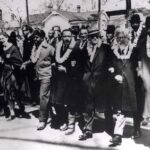 The third and final Selma to Montgomery voting rights March begins as Rev. Dr. Martin Luther King, Jr, leads close to 8,000 people from the starting point at Brown Chapel A.M.E. Church in Selma, commencing the trek to Montgomery. The March would continue over the next four days, completing on March 25. Most of the participants were black, but some were white and some were Asian and Latino. Spiritual leaders of multiple races, religions, and creeds marched abreast with Dr. King, including Rev. Fred Shuttlesworth, Greek Orthodox Archbishop Iakovos, Rabbis Abraham Joshua Heschel and Maurice Davis, and at least one nun, all of whom were depicted in a photo that has become famous. The Dutch Catholic priest Henri Nouwen joined the march on March 24. Learn more. The third and final Selma to Montgomery voting rights March begins as Rev. Dr. Martin Luther King, Jr, leads close to 8,000 people from the starting point at Brown Chapel A.M.E. Church in Selma, commencing the trek to Montgomery. The March would continue over the next four days, completing on March 25. Most of the participants were black, but some were white and some were Asian and Latino. Spiritual leaders of multiple races, religions, and creeds marched abreast with Dr. King, including Rev. Fred Shuttlesworth, Greek Orthodox Archbishop Iakovos, Rabbis Abraham Joshua Heschel and Maurice Davis, and at least one nun, all of whom were depicted in a photo that has become famous. The Dutch Catholic priest Henri Nouwen joined the march on March 24. Learn more. | |
| March 22, 1965 |  Day 2 of the 5-day, 54-mile Selma to Montgomery March, taking place March 21-25. This third and final Selma voting rights march followed the earlier March 7, “Bloody Sunday” march, and the March 9, “Turnaround Tuesday” march.
On the preceding day (March 21), approximately 8,000 marchers walked along Highway-80 from Selma to Lowndes County. In 1965, the road to Montgomery was four lanes wide going east from Selma, then narrowed to two lanes through Lowndes County, and widened to four lanes again at the Montgomery county border. Under the terms of a court order, the march was limited to no more than 300 participants for the two days they were on the two-lane portion of Highway-80. At the end of the first day (March 21), most of the marchers returned to Selma by bus and car, leaving 300 to camp overnight and take up the journey the next day.
On March 22 and 23, 300 protesters marched through chilling rain across Lowndes County, camping at three sites in muddy fields. At the time of the march, the population of Lowndes County was 81% black and 19% white, but not a single black was registered to vote. There were 2,240 whites registered to vote in Lowndes County, a figure that represented 118% of the adult white population (in many Southern counties of that era it was common practice to retain white voters on the rolls after they died or moved away). Learn more. Day 2 of the 5-day, 54-mile Selma to Montgomery March, taking place March 21-25. This third and final Selma voting rights march followed the earlier March 7, “Bloody Sunday” march, and the March 9, “Turnaround Tuesday” march.
On the preceding day (March 21), approximately 8,000 marchers walked along Highway-80 from Selma to Lowndes County. In 1965, the road to Montgomery was four lanes wide going east from Selma, then narrowed to two lanes through Lowndes County, and widened to four lanes again at the Montgomery county border. Under the terms of a court order, the march was limited to no more than 300 participants for the two days they were on the two-lane portion of Highway-80. At the end of the first day (March 21), most of the marchers returned to Selma by bus and car, leaving 300 to camp overnight and take up the journey the next day.
On March 22 and 23, 300 protesters marched through chilling rain across Lowndes County, camping at three sites in muddy fields. At the time of the march, the population of Lowndes County was 81% black and 19% white, but not a single black was registered to vote. There were 2,240 whites registered to vote in Lowndes County, a figure that represented 118% of the adult white population (in many Southern counties of that era it was common practice to retain white voters on the rolls after they died or moved away). Learn more. | |
| March 23, 1965 |  Day 3 of the 5-day, 54-mile Selma to Montgomery March, taking place March 21-25. This third and final Selma voting rights march followed the earlier March 7, “Bloody Sunday” march, and the March 9, “Turnaround Tuesday” march.On the preceding day (March 21), approximately 8,000 marchers walked along Highway-80 from Selma to Lowndes County. In 1965, the road to Montgomery was four lanes wide going east from Selma, then narrowed to two lanes through Lowndes County, and widened to four lanes again at the Montgomery county border. Under the terms of a court order, the march was limited to no more than 300 participants for the two days they were on the two-lane portion of Highway-80. At the end of the first day (March 21), most of the marchers returned to Selma by bus and car, leaving 300 to camp overnight and take up the journey the next two days. On March 22 and 23, 300 protesters marched through chilling rain across Lowndes County, camping at three sites in muddy fields. At the time of the march, the population of Lowndes County was 81% black and 19% white, but not a single black was registered to vote. There were 2,240 whites registered to vote in Lowndes County, a figure that represented 118% of the adult white population (in many Southern counties of that era it was common practice to retain white voters on the rolls after they died or moved away). Learn more. Day 3 of the 5-day, 54-mile Selma to Montgomery March, taking place March 21-25. This third and final Selma voting rights march followed the earlier March 7, “Bloody Sunday” march, and the March 9, “Turnaround Tuesday” march.On the preceding day (March 21), approximately 8,000 marchers walked along Highway-80 from Selma to Lowndes County. In 1965, the road to Montgomery was four lanes wide going east from Selma, then narrowed to two lanes through Lowndes County, and widened to four lanes again at the Montgomery county border. Under the terms of a court order, the march was limited to no more than 300 participants for the two days they were on the two-lane portion of Highway-80. At the end of the first day (March 21), most of the marchers returned to Selma by bus and car, leaving 300 to camp overnight and take up the journey the next two days. On March 22 and 23, 300 protesters marched through chilling rain across Lowndes County, camping at three sites in muddy fields. At the time of the march, the population of Lowndes County was 81% black and 19% white, but not a single black was registered to vote. There were 2,240 whites registered to vote in Lowndes County, a figure that represented 118% of the adult white population (in many Southern counties of that era it was common practice to retain white voters on the rolls after they died or moved away). Learn more. | |
| March 23, 2007 |  Barrington Irving departs Miami, FL, beginning his successful solo flight around the world. After stopping in various countries in Europe and Asia, Irving returned to Miami on the 27th of June. In so doing, Irving became the first African American to fly solo around the world as well as the youngest person to complete the feat. He made his flight at the age of 23. Irving was born in Kingston, Jamaica on November 11th, 1983. He was the oldest of three brothers. When Irving was six years old, his family relocated to inner-city Miami, Florida. Learn more. Barrington Irving departs Miami, FL, beginning his successful solo flight around the world. After stopping in various countries in Europe and Asia, Irving returned to Miami on the 27th of June. In so doing, Irving became the first African American to fly solo around the world as well as the youngest person to complete the feat. He made his flight at the age of 23. Irving was born in Kingston, Jamaica on November 11th, 1983. He was the oldest of three brothers. When Irving was six years old, his family relocated to inner-city Miami, Florida. Learn more. | |
| March 24, 1884 | 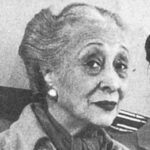 Zoë Dusanne, a pioneering art dealer and collector who opened Seattle’s first professional modern-art gallery, is born. Described by those who knew her as exotic, flamboyant, and colorful, Dushanne opened the Zoë Dusanne Gallery in 1950, and worked tirelessly to both introduce modern art to a northwest audience and to promote northwest art and artists to a larger international art community. Learn more. Zoë Dusanne, a pioneering art dealer and collector who opened Seattle’s first professional modern-art gallery, is born. Described by those who knew her as exotic, flamboyant, and colorful, Dushanne opened the Zoë Dusanne Gallery in 1950, and worked tirelessly to both introduce modern art to a northwest audience and to promote northwest art and artists to a larger international art community. Learn more. | |
| March 24, 1912 | 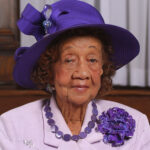 African American civil rights and women's rights activist Dorothy Irene Height is born. Height focused on the issues of African American women, including unemployment, illiteracy, and voter awareness. Height is credited as the first leader in the civil rights movement to recognize inequality for women and African Americans as problems that should be considered as a whole. She was the president of the National Council of Negro Women for 40 years. Learn more. African American civil rights and women's rights activist Dorothy Irene Height is born. Height focused on the issues of African American women, including unemployment, illiteracy, and voter awareness. Height is credited as the first leader in the civil rights movement to recognize inequality for women and African Americans as problems that should be considered as a whole. She was the president of the National Council of Negro Women for 40 years. Learn more. | |
| March 24, 1965 |  Day 4 of the 5-day, 54-mile Selma to Montgomery March, taking place March 21-25. This third and final Selma voting rights march followed the earlier March 7, “Bloody Sunday” march, and the March 9, “Turnaround Tuesday” march. On the preceding day (March 21), approximately 8,000 marchers walked along Highway-80 from Selma to Lowndes County. On days 2 and 3, the march was limited by court order to 300 participants owing to Highway-80 having just 2 lanes through Lowndes County. On the morning of March 24 (day 4), the march crossed into Montgomery County and the highway widened again to four lanes. All day as the march approached the city, additional marchers were ferried by bus and car to join the line. By evening, several thousand marchers had reached the final campsite at the City of St. Jude, a complex on the outskirts of Montgomery. That night on a makeshift stage, a "Stars for Freedom" rally was held, with singers Harry Belafonte, Tony Bennett, Frankie Laine, Peter, Paul and Mary, Sammy Davis, Jr., Joan Baez, Nina Simone, and The Chad Mitchell Trio all performing. Thousands more people continued to join the march. Learn more Day 4 of the 5-day, 54-mile Selma to Montgomery March, taking place March 21-25. This third and final Selma voting rights march followed the earlier March 7, “Bloody Sunday” march, and the March 9, “Turnaround Tuesday” march. On the preceding day (March 21), approximately 8,000 marchers walked along Highway-80 from Selma to Lowndes County. On days 2 and 3, the march was limited by court order to 300 participants owing to Highway-80 having just 2 lanes through Lowndes County. On the morning of March 24 (day 4), the march crossed into Montgomery County and the highway widened again to four lanes. All day as the march approached the city, additional marchers were ferried by bus and car to join the line. By evening, several thousand marchers had reached the final campsite at the City of St. Jude, a complex on the outskirts of Montgomery. That night on a makeshift stage, a "Stars for Freedom" rally was held, with singers Harry Belafonte, Tony Bennett, Frankie Laine, Peter, Paul and Mary, Sammy Davis, Jr., Joan Baez, Nina Simone, and The Chad Mitchell Trio all performing. Thousands more people continued to join the march. Learn more | |
| March 25, 1924 | 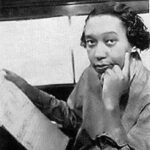 Prolific neoclassical music composer Julia Amanda Perry is born in Lexington Kentucky. Her father, Dr. Abe Perry, was a doctor and amateur pianist, who once accompanied the tenor Roland Hayes on tour. Her mother, America Perry, encouraged her children’s musical endeavors; both Julia and her sisters studied violin from a young age, Julia switched to the piano after two years of violin. Perry graduated Westminster Choir College in Princeton, New Jersey with a bachelors and masters in music. She continued her musical training at the Julliard School of Music and she also spent summers at the Berkshire Music Center in Tanglewood, Massachusetts. Perry received two Guggenheim fellowships to study in Florence, Italy under the tutelage of Lugia Dallapiccola and in Paris, France with Nadia Boulanger. Her works are performed by major orchestras and she won awards and accolades from the National Association of Negro Musicians, the Boulanger Grand Prix, and the National Institute of Arts and Letters, among others. During her life, Perry completed 12 symphonies, two concertos, and three operas, in addition to numerous smaller pieces. Learn more. Prolific neoclassical music composer Julia Amanda Perry is born in Lexington Kentucky. Her father, Dr. Abe Perry, was a doctor and amateur pianist, who once accompanied the tenor Roland Hayes on tour. Her mother, America Perry, encouraged her children’s musical endeavors; both Julia and her sisters studied violin from a young age, Julia switched to the piano after two years of violin. Perry graduated Westminster Choir College in Princeton, New Jersey with a bachelors and masters in music. She continued her musical training at the Julliard School of Music and she also spent summers at the Berkshire Music Center in Tanglewood, Massachusetts. Perry received two Guggenheim fellowships to study in Florence, Italy under the tutelage of Lugia Dallapiccola and in Paris, France with Nadia Boulanger. Her works are performed by major orchestras and she won awards and accolades from the National Association of Negro Musicians, the Boulanger Grand Prix, and the National Institute of Arts and Letters, among others. During her life, Perry completed 12 symphonies, two concertos, and three operas, in addition to numerous smaller pieces. Learn more. | |
| March 25, 1931 | 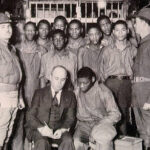 In a gross miscarriage of justice typical of that era and especially in that region, the “Scottsboro Boys” — nine African American teenagers, ages 12-18 — are falsely accused, arrested, and charged with raping two white women. The arrests set off a cascading set of injustices. It is commonly cited as an example of a miscarriage of justice in the United States legal system. The case was first heard in Scottsboro, Alabama, in three rushed trials, in which the defendants received poor legal representation. All but 13-year-old Roy Wright were convicted of rape and sentenced to death (the common sentence in Alabama at the time for black men convicted of raping white women), even though there was no medical evidence to suggest that they had committed such a crime. The cases were twice appealed to the United States Supreme Court, which led to landmark decisions on the conduct of trials. In Powell v. Alabama (1932), it ordered new trials. During the retrials, one of the alleged victims admitted to fabricating the rape story and asserted that none of the Scottsboro Boys touched either of the white women. The jury found the defendants guilty, but the judge set aside the verdict and granted a new trial. The judge was replaced and the case tried under a judge who ruled frequently against the defense, and the third jury returned a guilty verdict. The case was sent to the US Supreme Court on appeal. It ruled that African-Americans had to be included on juries, and ordered retrials. Charges were finally dropped for four of the nine defendants. Sentences for the rest ranged from 75 years to death. All but two served prison sentences; all were released or escaped by 1946. Two escaped, were later charged with other crimes, convicted, and sent back to prison. Learn more. In a gross miscarriage of justice typical of that era and especially in that region, the “Scottsboro Boys” — nine African American teenagers, ages 12-18 — are falsely accused, arrested, and charged with raping two white women. The arrests set off a cascading set of injustices. It is commonly cited as an example of a miscarriage of justice in the United States legal system. The case was first heard in Scottsboro, Alabama, in three rushed trials, in which the defendants received poor legal representation. All but 13-year-old Roy Wright were convicted of rape and sentenced to death (the common sentence in Alabama at the time for black men convicted of raping white women), even though there was no medical evidence to suggest that they had committed such a crime. The cases were twice appealed to the United States Supreme Court, which led to landmark decisions on the conduct of trials. In Powell v. Alabama (1932), it ordered new trials. During the retrials, one of the alleged victims admitted to fabricating the rape story and asserted that none of the Scottsboro Boys touched either of the white women. The jury found the defendants guilty, but the judge set aside the verdict and granted a new trial. The judge was replaced and the case tried under a judge who ruled frequently against the defense, and the third jury returned a guilty verdict. The case was sent to the US Supreme Court on appeal. It ruled that African-Americans had to be included on juries, and ordered retrials. Charges were finally dropped for four of the nine defendants. Sentences for the rest ranged from 75 years to death. All but two served prison sentences; all were released or escaped by 1946. Two escaped, were later charged with other crimes, convicted, and sent back to prison. Learn more. | |
| March 25, 1965 | 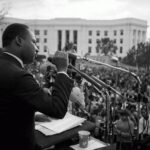 Day 5 of the 5-day, 54-mile Selma to Montgomery March, taking place March 21-25. This third and final Selma voting rights march followed the earlier March 7, “Bloody Sunday” march, and the March 9, “Turnaround Tuesday” march. On Thursday, March 25, 25,000 people marched from the previous night campsite at the Town of St. Jude complex on the outskirts of Montgomery to the steps of the State Capitol Building in Montgomery where King delivered the speech "How Long, Not Long". He said: “The end we seek is a society at peace with itself, a society that can live with its conscience. ... I know you are asking today, How long will it take? I come to say to you this afternoon however difficult the moment, however frustrating the hour, it will not be long.” After delivering the speech, King and the marchers approached the entrance to the capitol with a petition for Governor Wallace. A line of state troopers blocked the door. One announced that the governor was not in. Undeterred, the marchers remained at the entrance until one of Wallace's secretaries appeared and took the petition. The three Selma to Montgomery marches had a powerful effect in Washington. After witnessing the police violent attacks on the “Bloody Sunday” marchers, President Johnson presented a voting rights bill to a joint session of Congress in a televised speech on March 15. It was considered to be a watershed moment for the civil rights movement. The Voting Rights Act of 1965 was signed into law by President Johnson on August 6, 1965, and prohibited most of the unfair practices used to prevent blacks from registering to vote, and provided for federal registrars to go to Alabama and other states with a history of voting-related discrimination to ensure that the law was implemented by overseeing registration and elections. Day 5 of the 5-day, 54-mile Selma to Montgomery March, taking place March 21-25. This third and final Selma voting rights march followed the earlier March 7, “Bloody Sunday” march, and the March 9, “Turnaround Tuesday” march. On Thursday, March 25, 25,000 people marched from the previous night campsite at the Town of St. Jude complex on the outskirts of Montgomery to the steps of the State Capitol Building in Montgomery where King delivered the speech "How Long, Not Long". He said: “The end we seek is a society at peace with itself, a society that can live with its conscience. ... I know you are asking today, How long will it take? I come to say to you this afternoon however difficult the moment, however frustrating the hour, it will not be long.” After delivering the speech, King and the marchers approached the entrance to the capitol with a petition for Governor Wallace. A line of state troopers blocked the door. One announced that the governor was not in. Undeterred, the marchers remained at the entrance until one of Wallace's secretaries appeared and took the petition. The three Selma to Montgomery marches had a powerful effect in Washington. After witnessing the police violent attacks on the “Bloody Sunday” marchers, President Johnson presented a voting rights bill to a joint session of Congress in a televised speech on March 15. It was considered to be a watershed moment for the civil rights movement. The Voting Rights Act of 1965 was signed into law by President Johnson on August 6, 1965, and prohibited most of the unfair practices used to prevent blacks from registering to vote, and provided for federal registrars to go to Alabama and other states with a history of voting-related discrimination to ensure that the law was implemented by overseeing registration and elections. | |
| March 25, 1965 | 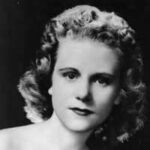 Civil rights ally and activist Viola Liuzzo is martyred by the Ku Klux Klan(KKK). Liuzzo, a 39-year old mother of five and later-in-life college student, heeded Dr. Martin Luther King Jr.'s 1965 call and traveled from Detroit, Michigan, to Selma, Alabama, in the wake of the Bloody Sunday attempt to march across the Edmund Pettus Bridge. While returning from shuttling fellow activists to the Montgomery airport after the third Selma to Montgomery march, she was shot and killed from a pursuing car containing KKK members Collie Wilkins, William Eaton, Eugene Thomas, and Gary Thomas Rowe, the latter of whom was actually an undercover informant working for the Federal Bureau of Investigation (FBI). Rowe testified that Wilkins had fired two shots into Liuzzo on the order of Thomas, and was placed in the witness protection program by the FBI. To deflect attention from having employed Rowe as an informant, the FBI falsely claimed Liuzzo was a heroin-addicted member of the Communist Party who had abandoned her children to have sexual relationships with African-Americans involved in the Civil Rights Movement. In addition to other honors, Liuzzo's name is today inscribed on the Civil Rights Memorial in Montgomery, Alabama, created by Maya Lin. Learn more. Civil rights ally and activist Viola Liuzzo is martyred by the Ku Klux Klan(KKK). Liuzzo, a 39-year old mother of five and later-in-life college student, heeded Dr. Martin Luther King Jr.'s 1965 call and traveled from Detroit, Michigan, to Selma, Alabama, in the wake of the Bloody Sunday attempt to march across the Edmund Pettus Bridge. While returning from shuttling fellow activists to the Montgomery airport after the third Selma to Montgomery march, she was shot and killed from a pursuing car containing KKK members Collie Wilkins, William Eaton, Eugene Thomas, and Gary Thomas Rowe, the latter of whom was actually an undercover informant working for the Federal Bureau of Investigation (FBI). Rowe testified that Wilkins had fired two shots into Liuzzo on the order of Thomas, and was placed in the witness protection program by the FBI. To deflect attention from having employed Rowe as an informant, the FBI falsely claimed Liuzzo was a heroin-addicted member of the Communist Party who had abandoned her children to have sexual relationships with African-Americans involved in the Civil Rights Movement. In addition to other honors, Liuzzo's name is today inscribed on the Civil Rights Memorial in Montgomery, Alabama, created by Maya Lin. Learn more. | |
| March 26, 1872 | 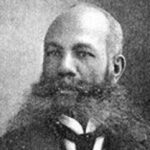 African-American inventor Thomas J Martin is granted a patent for his version of the fire extinguisher. Martin’s invention, listed in the U. S. Patent Office in Washington, DC under patent number 125,063, improved upon an earlier model of the fire extinguisher. Learn more. African-American inventor Thomas J Martin is granted a patent for his version of the fire extinguisher. Martin’s invention, listed in the U. S. Patent Office in Washington, DC under patent number 125,063, improved upon an earlier model of the fire extinguisher. Learn more. | |
| March 26, 1932 | 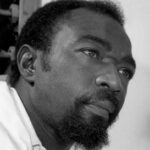 American nuclear chemist James Andrew Harris is born. Harris was involved in the discovery of elements 104 and 105 (rutherfordium and dubnium, respectively). Harris spent most of his scientific career working in the in the Heavy Isotopes Production Group of the Nuclear Chemistry department of the Lawrence Radiation Laboratory at the University of California-Berkeley. It was there that he designed and purified the targets that were used to discover elements 104 and 105. In 1977, Harris was promoted to Head of Engineering and Technical Services Division at Lawrence. Harris retired from the lab in 1988. Learn more. American nuclear chemist James Andrew Harris is born. Harris was involved in the discovery of elements 104 and 105 (rutherfordium and dubnium, respectively). Harris spent most of his scientific career working in the in the Heavy Isotopes Production Group of the Nuclear Chemistry department of the Lawrence Radiation Laboratory at the University of California-Berkeley. It was there that he designed and purified the targets that were used to discover elements 104 and 105. In 1977, Harris was promoted to Head of Engineering and Technical Services Division at Lawrence. Harris retired from the lab in 1988. Learn more. | |
| March 26, 1944 | 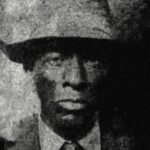 A group of white men brutally lynched Rev. Isaac Simmons, a Black minister and farmer, so they could steal his land in Amite County, Mississippi. Members of his family, some of whom witnessed his murder, fled the state, fearing for their lives. The white men responsible for lynching him successfully stole the Simmons’s land, and were never convicted for their crimes. Rev. Simmons was one of at least 14 Black people lynched in Amite County, Mississippi between 1865 and 1950, and one of over 6,500 Black women, men, and children who were victims of racial terror lynching in the U.S. between 1865-1950. Learn more. A group of white men brutally lynched Rev. Isaac Simmons, a Black minister and farmer, so they could steal his land in Amite County, Mississippi. Members of his family, some of whom witnessed his murder, fled the state, fearing for their lives. The white men responsible for lynching him successfully stole the Simmons’s land, and were never convicted for their crimes. Rev. Simmons was one of at least 14 Black people lynched in Amite County, Mississippi between 1865 and 1950, and one of over 6,500 Black women, men, and children who were victims of racial terror lynching in the U.S. between 1865-1950. Learn more. | |
| March 27, 1876 | 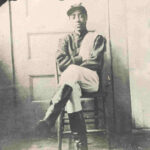 Alonzo "Lonnie" Clayton is born. An African American jockey in Thoroughbred horse racing, Clayton was one of the all-time great riders, holding the record as the youngest jockey to ever win the Kentucky Derby. In 1890 at just fourteen-years-old, Clayton began his professional riding career and was Immediately successful. At Morris Park Racetrack in The Bronx, New York, Clayton won the important Champagne Stakes. On May 11, 1892, he rode to victory in the Kentucky Derby which at age fifteen made him the youngest jockey in history to ever win the Derby. Clayton followed up his Derby success with victories in the Clark Handicap and the Travers Stakes. At Monmouth Park in New Jersey Clayton won the 1893 Monmouth Handicap and went on to win the fall riding title at Churchill Downs. One of the leading money winners on the East Coast racing circuit during the 1890s, he won races from New York to California. In 1895, he won 144 races and finished in the money sixty percent of the time. By the start of the 20th century, racism forced the complete elimination of African-American jockeys, who had dominated racing and who had played a major role in bringing Thoroughbred racing to the forefront of American sport. Since 1909, no African-American jockey has ridden a winner in any major American Graded stakes race. No longer permitted to make a living in horse racing, Clayton spent his final years working as a hotel bellhop in California, where he died at age 40 of chronic pulmonary tuberculosis in 1917. Learn more. Alonzo "Lonnie" Clayton is born. An African American jockey in Thoroughbred horse racing, Clayton was one of the all-time great riders, holding the record as the youngest jockey to ever win the Kentucky Derby. In 1890 at just fourteen-years-old, Clayton began his professional riding career and was Immediately successful. At Morris Park Racetrack in The Bronx, New York, Clayton won the important Champagne Stakes. On May 11, 1892, he rode to victory in the Kentucky Derby which at age fifteen made him the youngest jockey in history to ever win the Derby. Clayton followed up his Derby success with victories in the Clark Handicap and the Travers Stakes. At Monmouth Park in New Jersey Clayton won the 1893 Monmouth Handicap and went on to win the fall riding title at Churchill Downs. One of the leading money winners on the East Coast racing circuit during the 1890s, he won races from New York to California. In 1895, he won 144 races and finished in the money sixty percent of the time. By the start of the 20th century, racism forced the complete elimination of African-American jockeys, who had dominated racing and who had played a major role in bringing Thoroughbred racing to the forefront of American sport. Since 1909, no African-American jockey has ridden a winner in any major American Graded stakes race. No longer permitted to make a living in horse racing, Clayton spent his final years working as a hotel bellhop in California, where he died at age 40 of chronic pulmonary tuberculosis in 1917. Learn more. | |
| March 27, 1908 | 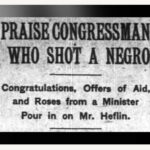 Alabama Representative James Thomas Heflin shoots Louis Lundy, a Black man, claiming that Lundy cursed in front of a white woman while riding on a Washington, D.C. streetcar. The congressman claimed that Mr. Lundy’s alleged cursing was “raising a disturbance,” and received an outpouring of support from the white public and his fellow representatives after shooting Mr. Lundy through his neck. Heflin was never held accountable for shooting Mr. Lundy. Alabama Representative James Thomas Heflin shoots Louis Lundy, a Black man, claiming that Lundy cursed in front of a white woman while riding on a Washington, D.C. streetcar. The congressman claimed that Mr. Lundy’s alleged cursing was “raising a disturbance,” and received an outpouring of support from the white public and his fellow representatives after shooting Mr. Lundy through his neck. Heflin was never held accountable for shooting Mr. Lundy. | |
| March 27, 1924 | 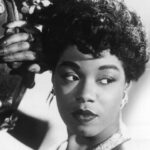 Popular twentieth century African-American Jazz singing virtuoso Sarah Vaughn is born. She was recognized for her beautiful voice and often nicknamed ‘Sassy’, ‘Sailor’ and ‘The Divine One’ for her salty speech. Moreover, she won a Grammy Award and was awarded the “highest honor in jazz” by The National Endowment for the Arts. Learn more.
Popular twentieth century African-American Jazz singing virtuoso Sarah Vaughn is born. She was recognized for her beautiful voice and often nicknamed ‘Sassy’, ‘Sailor’ and ‘The Divine One’ for her salty speech. Moreover, she won a Grammy Award and was awarded the “highest honor in jazz” by The National Endowment for the Arts. Learn more. | |
| March 27, 1934 | 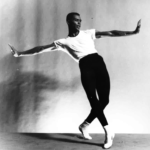 American ballet dancer, choreographer, and ballet companies founder and director Arthur Mitchell is born. In 1955, he was the first African-American dancer with the New York City Ballet, where he was promoted to principal dancer the following year and danced in major roles until 1966. He then founded ballet companies in Spoleto, Washington, D.C., and Brazil. In 1969, he founded a training school and the first African-American classical ballet company, Dance Theatre of Harlem. Among other awards, Mitchell was recognized as a MacArthur Fellow, inducted into the National Museum of Dance's Mr. & Mrs. Cornelius Vanderbilt Whitney Hall of Fame, and received the United States National Medal of Arts and a Fletcher Foundation fellowship. Learn more. American ballet dancer, choreographer, and ballet companies founder and director Arthur Mitchell is born. In 1955, he was the first African-American dancer with the New York City Ballet, where he was promoted to principal dancer the following year and danced in major roles until 1966. He then founded ballet companies in Spoleto, Washington, D.C., and Brazil. In 1969, he founded a training school and the first African-American classical ballet company, Dance Theatre of Harlem. Among other awards, Mitchell was recognized as a MacArthur Fellow, inducted into the National Museum of Dance's Mr. & Mrs. Cornelius Vanderbilt Whitney Hall of Fame, and received the United States National Medal of Arts and a Fletcher Foundation fellowship. Learn more. | |
| March 28, 1925 | 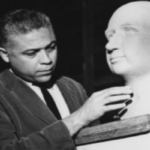 Award winning sculptor and teacher Edward N. Wilson, Jr., is born. His work was featured in the landmark 1976 exhibition Two Centuries of Black American Art. Mr. Wilson produced some two dozen sculptures, working variously in bronze, aluminum and red hickory. He became chairman of the department of art and art history at the State University of New York in Birmingham, NY, in 1964. Among his acclaimed works are a memorial to John F. Kennedy, a piece titled “Falling Man,” “Second Genesis,” “Jazz Musicians,” “Middle Passage,” subtly depicting the horrors of slave ships, and a memorial to Ralph Ellison, the author of “The Invisible Man,” that stands at the Ralph Ellison Library in Oklahoma City. In their book, “A History of African-American Artists” (Random House, 1992), Romare Bearden and Harry Henderson devoted a chapter to Mr. Wilson, ranking him as a significant artist. Learn more. Award winning sculptor and teacher Edward N. Wilson, Jr., is born. His work was featured in the landmark 1976 exhibition Two Centuries of Black American Art. Mr. Wilson produced some two dozen sculptures, working variously in bronze, aluminum and red hickory. He became chairman of the department of art and art history at the State University of New York in Birmingham, NY, in 1964. Among his acclaimed works are a memorial to John F. Kennedy, a piece titled “Falling Man,” “Second Genesis,” “Jazz Musicians,” “Middle Passage,” subtly depicting the horrors of slave ships, and a memorial to Ralph Ellison, the author of “The Invisible Man,” that stands at the Ralph Ellison Library in Oklahoma City. In their book, “A History of African-American Artists” (Random House, 1992), Romare Bearden and Harry Henderson devoted a chapter to Mr. Wilson, ranking him as a significant artist. Learn more. | |
| March 28, 1958 | 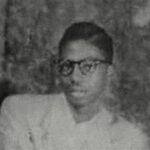 22-year-old Black man named Jeremiah Reeves is executed by the state of Alabama after police tortured him until he gave a false confession as a 16-year-old child. In July 1951, Jeremiah, who was a 16-year-old high school student at the time, and Mabel Ann Crowder, a white woman, were discovered having sex in her home. Though it was known to be a consensual relationship, Ms. Crowder claimed she was raped and Jeremiah was immediately arrested and taken to Kilby Prison for “questioning.” Police strapped the frightened boy into the electric chair and told him that he would be electrocuted unless he admitted to having committed all of the rapes white women had reported that summer. Under this terrifying pressure, he falsely confessed to the charges in fear. Though he soon recanted and insisted he was innocent, Jeremiah was convicted and sentenced to death after a two-day trial during which the all-white jury deliberated for less than 30 minutes. On April 6, 1958, Dr. Martin Luther King Jr. spoke at an Easter rally in Montgomery, Alabama and decried Jeremiah Reeves’s wrongful conviction and execution, which had been carried out a little over a week before. Afterward, a group of 39 local white ministers released a statement decrying the activists’ “exaggerated emphasis on wrongs and grievances.” Learn more. 22-year-old Black man named Jeremiah Reeves is executed by the state of Alabama after police tortured him until he gave a false confession as a 16-year-old child. In July 1951, Jeremiah, who was a 16-year-old high school student at the time, and Mabel Ann Crowder, a white woman, were discovered having sex in her home. Though it was known to be a consensual relationship, Ms. Crowder claimed she was raped and Jeremiah was immediately arrested and taken to Kilby Prison for “questioning.” Police strapped the frightened boy into the electric chair and told him that he would be electrocuted unless he admitted to having committed all of the rapes white women had reported that summer. Under this terrifying pressure, he falsely confessed to the charges in fear. Though he soon recanted and insisted he was innocent, Jeremiah was convicted and sentenced to death after a two-day trial during which the all-white jury deliberated for less than 30 minutes. On April 6, 1958, Dr. Martin Luther King Jr. spoke at an Easter rally in Montgomery, Alabama and decried Jeremiah Reeves’s wrongful conviction and execution, which had been carried out a little over a week before. Afterward, a group of 39 local white ministers released a statement decrying the activists’ “exaggerated emphasis on wrongs and grievances.” Learn more. | |
| March 28, 1968 | 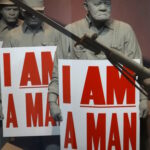 A peaceful protest march in Memphis, TN led by the Reverend Dr. Martin Luther King, Jr, and Reverend James Lawson in support of striking city sanitation workers, is interrupted by violence and unprovoked murder by police. City officials estimated that 22,000 students skipped school to participate in the march. Dr. King arrived late to find a massive crowd on the brink of chaos, causing Lawson and King to call off the demonstration as violence erupted. After peacefully marching for several blocks, singing "We Shall Overcome", armed men with iron pipes and bricks, and carrying signs, began smashing windows and looting along the stores. Police immediately reacted to the riot, moving into the crowd with nightsticks, mace, teargas, and gunfire. They arrested 280 individuals and 60 were reported injured, most of them black. Lawson told the demonstration participants to return to Clayborn Temple. The police followed the crowd back to the church where they released tear gas and clubbed people. In the midst of the chaos, a police shot and killed sixteen-year-old Larry Payne. Witnesses said Payne had his hands raised as the officer pressed a shotgun to Payne's stomach and fired it. Five days later, on April 3, 1968, Dr King returned to Memphis and gave the “I’ve Been to the Mountaintop” speech a day before his assassination. Learn more. A peaceful protest march in Memphis, TN led by the Reverend Dr. Martin Luther King, Jr, and Reverend James Lawson in support of striking city sanitation workers, is interrupted by violence and unprovoked murder by police. City officials estimated that 22,000 students skipped school to participate in the march. Dr. King arrived late to find a massive crowd on the brink of chaos, causing Lawson and King to call off the demonstration as violence erupted. After peacefully marching for several blocks, singing "We Shall Overcome", armed men with iron pipes and bricks, and carrying signs, began smashing windows and looting along the stores. Police immediately reacted to the riot, moving into the crowd with nightsticks, mace, teargas, and gunfire. They arrested 280 individuals and 60 were reported injured, most of them black. Lawson told the demonstration participants to return to Clayborn Temple. The police followed the crowd back to the church where they released tear gas and clubbed people. In the midst of the chaos, a police shot and killed sixteen-year-old Larry Payne. Witnesses said Payne had his hands raised as the officer pressed a shotgun to Payne's stomach and fired it. Five days later, on April 3, 1968, Dr King returned to Memphis and gave the “I’ve Been to the Mountaintop” speech a day before his assassination. Learn more. | |
| March 29, 1931 | 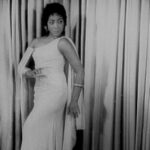 Gloria Davy, a rich-voiced (lirico-spinto) soprano who “sang for the sheer joy of singing” and had a four decade career as a concert singer is born. Early in her career she replaced Leontyne Price as Bess in the 1954 international tour of Porgy and Bess. In 1958 Davy broke color barriers when she was chosen for the lead in Aida with the Metropolitan Opera. After moving to Europe she gained international recognition for singing, acting, and teaching. Learn more. Gloria Davy, a rich-voiced (lirico-spinto) soprano who “sang for the sheer joy of singing” and had a four decade career as a concert singer is born. Early in her career she replaced Leontyne Price as Bess in the 1954 international tour of Porgy and Bess. In 1958 Davy broke color barriers when she was chosen for the lead in Aida with the Metropolitan Opera. After moving to Europe she gained international recognition for singing, acting, and teaching. Learn more. | |
| March 29, 1964 | 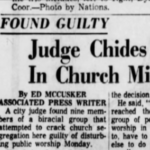 Several white churches in Jackson, Mississippi barred three Black men—including one minister—from attending Easter Sunday services, forcibly removing them from church or blocking their entrance. Two of the Black men and seven white clergymen who had accompanied them were arrested and jailed after the churches turned them away; their bonds were set at $1,000 each. The day after their arrests, a judge convicted all nine men of “disturbing public worship” and sentenced them each to six months in jail and a $500 fine. Learn more. Several white churches in Jackson, Mississippi barred three Black men—including one minister—from attending Easter Sunday services, forcibly removing them from church or blocking their entrance. Two of the Black men and seven white clergymen who had accompanied them were arrested and jailed after the churches turned them away; their bonds were set at $1,000 each. The day after their arrests, a judge convicted all nine men of “disturbing public worship” and sentenced them each to six months in jail and a $500 fine. Learn more. | |
| March 30, 1870 | 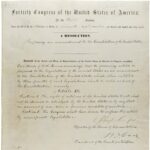 The Fifteenth Amendment to the United States Constitution, the third and last of the Reconstruction Amendments, is certified as duly ratified and part of the Constitution. The Amendment prohibits the federal government and each state from denying a citizen the right to vote based on that citizen's "race, color, or previous condition of servitude." In actual practice, the courts would for the next 3/4 century interpret the amendment so narrowly and so peculiarly as to be nearly meaningless; the interpretations deviated so severely from the plain, clear language of the Amendment that there was no pretense of enforcement. It was not until the second half of the late 20th century that courts began to enforce the plain meaning of the amendment, especially after passage of the Voting Rights Act of 1965. Learn more.
The Fifteenth Amendment to the United States Constitution, the third and last of the Reconstruction Amendments, is certified as duly ratified and part of the Constitution. The Amendment prohibits the federal government and each state from denying a citizen the right to vote based on that citizen's "race, color, or previous condition of servitude." In actual practice, the courts would for the next 3/4 century interpret the amendment so narrowly and so peculiarly as to be nearly meaningless; the interpretations deviated so severely from the plain, clear language of the Amendment that there was no pretense of enforcement. It was not until the second half of the late 20th century that courts began to enforce the plain meaning of the amendment, especially after passage of the Voting Rights Act of 1965. Learn more. | |
| March 30, 1908 | 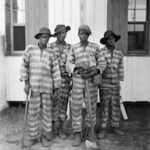 In an all too common incident of the Jim Crow era, a 22 year old Black man named Green Cottenham is arrested and charged with “vagrancy” in Shelby County, Alabama. An offense created at the end of Reconstruction and disproportionately enforced against Black citizens, vagrancy was defined as an inability to prove employment when demanded by a white person. Cottenham was quickly found guilty in a brief appearance before the county judge without a lawyer, and received a sentence of 30 days of hard labor. He was also assessed fees payable to nearly everyone involved in the process, from the sheriff, to the deputy, to the court clerk, to the witnesses. Due to his inability to pay these fees, Mr. Cottenham’s sentence would actually last nearly a year. For that year, Cottenham was leased by Shelby County to the railroad and forced to labor as a coal miner under deadly conditions. The railroad paid the county $12/month for Cottenham’s labor, the proceeds of which were allocated to pay the rigged fees the County assessed on Cottenham. This convict leasing system re-enslaved countless Black people for generations after Emancipation. Learn more. In an all too common incident of the Jim Crow era, a 22 year old Black man named Green Cottenham is arrested and charged with “vagrancy” in Shelby County, Alabama. An offense created at the end of Reconstruction and disproportionately enforced against Black citizens, vagrancy was defined as an inability to prove employment when demanded by a white person. Cottenham was quickly found guilty in a brief appearance before the county judge without a lawyer, and received a sentence of 30 days of hard labor. He was also assessed fees payable to nearly everyone involved in the process, from the sheriff, to the deputy, to the court clerk, to the witnesses. Due to his inability to pay these fees, Mr. Cottenham’s sentence would actually last nearly a year. For that year, Cottenham was leased by Shelby County to the railroad and forced to labor as a coal miner under deadly conditions. The railroad paid the county $12/month for Cottenham’s labor, the proceeds of which were allocated to pay the rigged fees the County assessed on Cottenham. This convict leasing system re-enslaved countless Black people for generations after Emancipation. Learn more. | |
| March 31, 1856 | 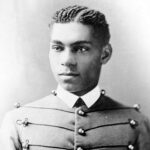 Henry Ossian Flipper, an American soldier, engineer, former slave, the first African American to graduate from the United States Military Academy at West Point, and author who wrote about scientific topics and his life experiences, is born. After his commissioning, Flipper was assigned to one of the all-black regiments in the U.S. Army, which were historically led by white officers. Assigned to 'A' Troop, he became the first nonwhite officer to lead buffalo soldiers of the 10th Cavalry. Flipper served with competency and distinction during the Apache Wars and the Victorio Campaign. Nonetheless, his military career was cut short by racism. Eventually, he was set up, court-martialed, and dismissed from the U.S. Army. Subsequently, Flipper built a successful career as a civil engineer, advisor to a US Senator, and assistant to the US Secretary of the Interior. In 1994, Flipper’s court-martial was reviewed, found to be unjust, and Flipper was posthumously pardoned. Learn more. Henry Ossian Flipper, an American soldier, engineer, former slave, the first African American to graduate from the United States Military Academy at West Point, and author who wrote about scientific topics and his life experiences, is born. After his commissioning, Flipper was assigned to one of the all-black regiments in the U.S. Army, which were historically led by white officers. Assigned to 'A' Troop, he became the first nonwhite officer to lead buffalo soldiers of the 10th Cavalry. Flipper served with competency and distinction during the Apache Wars and the Victorio Campaign. Nonetheless, his military career was cut short by racism. Eventually, he was set up, court-martialed, and dismissed from the U.S. Army. Subsequently, Flipper built a successful career as a civil engineer, advisor to a US Senator, and assistant to the US Secretary of the Interior. In 1994, Flipper’s court-martial was reviewed, found to be unjust, and Flipper was posthumously pardoned. Learn more. | |
| March 31, 1914 | 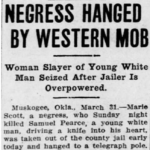 A white lynch mob in Wagoner County, Oklahoma, seized a 17-year-old Black teenaged girl named Marie Scott from the local jail, dragged her screaming from her cell, and hanged her from a nearby telephone pole. Days before, a young white man named Lemuel Pierce was stabbed to death while he and several other white men were in the city's "colored section"; Marie was accused of being involved. The Associated Press wire report and accounts published by Northern papers explained that the group of white men had ventured into the Black residential area to sexually assault Black women and attempted to rape Marie Scott. Learn more. A white lynch mob in Wagoner County, Oklahoma, seized a 17-year-old Black teenaged girl named Marie Scott from the local jail, dragged her screaming from her cell, and hanged her from a nearby telephone pole. Days before, a young white man named Lemuel Pierce was stabbed to death while he and several other white men were in the city's "colored section"; Marie was accused of being involved. The Associated Press wire report and accounts published by Northern papers explained that the group of white men had ventured into the Black residential area to sexually assault Black women and attempted to rape Marie Scott. Learn more. | |
| April 1, 1875 | 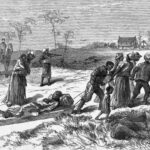 The United States Supreme Court finished hearing arguments in United States v. Cruikshank, a case that asked whether the federal government had the power to punish white men convicted of slaughtering dozens of Black people in Louisiana. Two years earlier, on Easter Sunday, April 13, 1873, hundreds of white men clashed with formerly enslaved Black men at the Grant Parish courthouse in Colfax, Louisiana. It is estimated that nearly 150 Black people died in the ensuing Coalfax Massacre - many murdered in cold blood after surrendering. Only three white men died. After the massacre, the federal government indicted over 100 members of the white mob under the Enforcement Act of 1870, a law was specifically enacted during Reconstruction to protect newly freed Black voters from the Ku Klux Klan and other white supremacist terrorists. Only three members of the mob were convicted, and they appealed. Nearly one year after hearing arguments, the Supreme Court issued a ruling reversing the criminal convictions of the three white men and holding that that the Bill of Rights did not apply to private actors or to state governments despite the adoption of the Fourteenth Amendment. The Cruikshank decision severely limited the federal government's authority to legally enforce Black civil rights and protect Black citizens from racial terror at the hands of mobs intent on enhancing white racial dominance. Learn more. The United States Supreme Court finished hearing arguments in United States v. Cruikshank, a case that asked whether the federal government had the power to punish white men convicted of slaughtering dozens of Black people in Louisiana. Two years earlier, on Easter Sunday, April 13, 1873, hundreds of white men clashed with formerly enslaved Black men at the Grant Parish courthouse in Colfax, Louisiana. It is estimated that nearly 150 Black people died in the ensuing Coalfax Massacre - many murdered in cold blood after surrendering. Only three white men died. After the massacre, the federal government indicted over 100 members of the white mob under the Enforcement Act of 1870, a law was specifically enacted during Reconstruction to protect newly freed Black voters from the Ku Klux Klan and other white supremacist terrorists. Only three members of the mob were convicted, and they appealed. Nearly one year after hearing arguments, the Supreme Court issued a ruling reversing the criminal convictions of the three white men and holding that that the Bill of Rights did not apply to private actors or to state governments despite the adoption of the Fourteenth Amendment. The Cruikshank decision severely limited the federal government's authority to legally enforce Black civil rights and protect Black citizens from racial terror at the hands of mobs intent on enhancing white racial dominance. Learn more. | |
| April 1, 1899 | 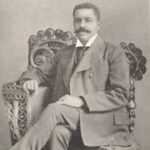 Serial African American entrepreneur and successful businessman John Merrick establishes the North Carolina Mutual Life Insurance Company (“NC Mutual”, successor to the North Carolina Mutual and Provident Society which he had co-founded the year prior). Born into slavery in Clinton, North Carolina, Merrick founded various companies in the Raleigh, North Carolina and Durham, North Carolina areas. Portions of his wealth were channeled back into the black community through philanthropy. His business acumen and social consciousness made him one of the most influential members of the African-American community in his lifetime. Merrick gained his first business success by founding a chain of barbershops catering to wealthy white men. Merrick parlayed his wealth from the barber business into other ventures that served the Black community, including NC Mutual (thr oldest and largest Black-owned life insurance company), the Mechanics and Farmers Bank (the first bank in Durham owned and controlled by African Americans), and Bull City Drug Company (a much-needed African American drug store in Durham). Learn more. Serial African American entrepreneur and successful businessman John Merrick establishes the North Carolina Mutual Life Insurance Company (“NC Mutual”, successor to the North Carolina Mutual and Provident Society which he had co-founded the year prior). Born into slavery in Clinton, North Carolina, Merrick founded various companies in the Raleigh, North Carolina and Durham, North Carolina areas. Portions of his wealth were channeled back into the black community through philanthropy. His business acumen and social consciousness made him one of the most influential members of the African-American community in his lifetime. Merrick gained his first business success by founding a chain of barbershops catering to wealthy white men. Merrick parlayed his wealth from the barber business into other ventures that served the Black community, including NC Mutual (thr oldest and largest Black-owned life insurance company), the Mechanics and Farmers Bank (the first bank in Durham owned and controlled by African Americans), and Bull City Drug Company (a much-needed African American drug store in Durham). Learn more. | |
| April 1, 1942 | 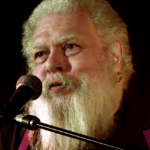 Samuel Ray “Chip” Delany Jr., an award-winning African American gay writer, editor, professor, and literary critic, is born. He is the first major African American science fiction writer as well as one of the most influential writers of this genre in the United States. He transformed the field in the 1960s and 1970s with daring and visionary novels. He has published over 40 works. Much of his fiction combines mythology, linguistics, deconstructed gender politics, and a frank treatment of sex. Delany’s best known work, Dhalgren (1975), was based on burned out inner cities and explores the life of a black man considered a sexual predator. It sold over a million copies. Since the 1980s, he has focused more on non-fiction. Delany’s memoir, The Motion of Light In Water, was published in 1988. Delany received four Nebula Awards for science fiction: Babel-17, The Einstein Intersection, and two of his short stories. Hugo Awards went to the novella “Time Considered as a Helix of Semi-Precious Stones” and his autobiography. He earned the Stonewall Book Award in 2007 for his novel, Dark Reflections. In 2002, he was inducted into the Science Fiction Hall of Fame. Two lifetime achievement awards have been bestowed upon him: the Bill Whitehead Award for Gay Literature in 1993 and the J. Lloyd Eaton Award in 2010. Learn more. Samuel Ray “Chip” Delany Jr., an award-winning African American gay writer, editor, professor, and literary critic, is born. He is the first major African American science fiction writer as well as one of the most influential writers of this genre in the United States. He transformed the field in the 1960s and 1970s with daring and visionary novels. He has published over 40 works. Much of his fiction combines mythology, linguistics, deconstructed gender politics, and a frank treatment of sex. Delany’s best known work, Dhalgren (1975), was based on burned out inner cities and explores the life of a black man considered a sexual predator. It sold over a million copies. Since the 1980s, he has focused more on non-fiction. Delany’s memoir, The Motion of Light In Water, was published in 1988. Delany received four Nebula Awards for science fiction: Babel-17, The Einstein Intersection, and two of his short stories. Hugo Awards went to the novella “Time Considered as a Helix of Semi-Precious Stones” and his autobiography. He earned the Stonewall Book Award in 2007 for his novel, Dark Reflections. In 2002, he was inducted into the Science Fiction Hall of Fame. Two lifetime achievement awards have been bestowed upon him: the Bill Whitehead Award for Gay Literature in 1993 and the J. Lloyd Eaton Award in 2010. Learn more. | |
| April 2, 1918 | 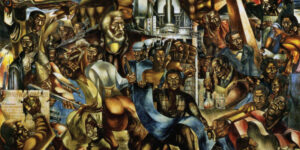 Renowned African-Americccan artist Charles Wilbert White, Jr. is born. White was known for his chronicling of African American related subjects in paintings, drawings, lithographs, and murals. Among White's most noted works are: The Contribution of the Negro to American Democracy , a mural at Hampton University (pictured); J'Accuse, a series of charcoal drawings depicting a variety of African-Americans from all ages and walks of life; the Wanted posters, a series of paintings based on old runaway slave posters; and Homage to Langston Hughes. An early activist, as a teenager, White volunteered his talents and became the house artist at the National Negro Congress in Chicago. Later, in a union with fellow black artists, White was arrested while picketing. White won a grant during the seventh grade to attend Saturday art classes at the Art Institute of Chicago. After reading Alain Locke's book The New Negro: An Interpretation, a critique of the Harlem Renaissance, White's social views changed. He learned after reading Locke's text about important African American figures in American history, and questioned his teachers on why they were not taught to students in school, causing some to label him a "rebel problematic child". White did not graduate from high school, having lost a year due to his refusal to attend class after being disillusioned with the teaching system. While he was encouraged by his art teachers to submit his art works and won various scholarships, these would later be taken away from him as an "error" and given to whites instead. He was admitted to two art schools, each then pulled his acceptance because of his race. White ultimately received a full scholarship to attend the School of the Art Institute of Chicago. Learn more. Renowned African-Americccan artist Charles Wilbert White, Jr. is born. White was known for his chronicling of African American related subjects in paintings, drawings, lithographs, and murals. Among White's most noted works are: The Contribution of the Negro to American Democracy , a mural at Hampton University (pictured); J'Accuse, a series of charcoal drawings depicting a variety of African-Americans from all ages and walks of life; the Wanted posters, a series of paintings based on old runaway slave posters; and Homage to Langston Hughes. An early activist, as a teenager, White volunteered his talents and became the house artist at the National Negro Congress in Chicago. Later, in a union with fellow black artists, White was arrested while picketing. White won a grant during the seventh grade to attend Saturday art classes at the Art Institute of Chicago. After reading Alain Locke's book The New Negro: An Interpretation, a critique of the Harlem Renaissance, White's social views changed. He learned after reading Locke's text about important African American figures in American history, and questioned his teachers on why they were not taught to students in school, causing some to label him a "rebel problematic child". White did not graduate from high school, having lost a year due to his refusal to attend class after being disillusioned with the teaching system. While he was encouraged by his art teachers to submit his art works and won various scholarships, these would later be taken away from him as an "error" and given to whites instead. He was admitted to two art schools, each then pulled his acceptance because of his race. White ultimately received a full scholarship to attend the School of the Art Institute of Chicago. Learn more. | |
| April 2, 1982 |  Lenell Geter, an aerospace engineer employed by military defense contractor E-Systems, Inc. in Greenville, TX, is falsely convicted of armed robbery of $615 from a Kentucky Fried Chicken (“KFC”) restaurant in Balch Springs, TX and sentenced to life in prison by an all white jury in an expedited trial, despite the testimony of nine co-workers and his supervisor that he was at work 50 miles away from the KFC at the time of the robbery. Following his conviction, Geter’s legal representation was taken over by the NAACP. There was a great deal of public attention and media focus on Geter’s case, including a feature episode of “60 Minutes.” His new attorneys succeeded in showing that some of the police testimony at trial was false and introduced additional evidence that he couldn’t have committed the crime. Geter’s conviction was overturned and, in December 1983, he was released from prison (after having served over 16 months) while awaiting his new trial, which was scheduled to begin on April 9, 1984. Instead of being retried, Geter's indictment was dismissed on March 26, 1984. Geter’s experience of being wrongly convicted is more common than his exoneration approximately 2 years after conviction. Learn more. Lenell Geter, an aerospace engineer employed by military defense contractor E-Systems, Inc. in Greenville, TX, is falsely convicted of armed robbery of $615 from a Kentucky Fried Chicken (“KFC”) restaurant in Balch Springs, TX and sentenced to life in prison by an all white jury in an expedited trial, despite the testimony of nine co-workers and his supervisor that he was at work 50 miles away from the KFC at the time of the robbery. Following his conviction, Geter’s legal representation was taken over by the NAACP. There was a great deal of public attention and media focus on Geter’s case, including a feature episode of “60 Minutes.” His new attorneys succeeded in showing that some of the police testimony at trial was false and introduced additional evidence that he couldn’t have committed the crime. Geter’s conviction was overturned and, in December 1983, he was released from prison (after having served over 16 months) while awaiting his new trial, which was scheduled to begin on April 9, 1984. Instead of being retried, Geter's indictment was dismissed on March 26, 1984. Geter’s experience of being wrongly convicted is more common than his exoneration approximately 2 years after conviction. Learn more. | |
| April 3, 1944 | 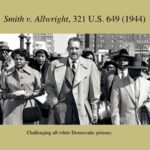 The United States Supreme Court issues a landmark ruling on voting rights in Smith v. Allwright, 321 U.S. 649 (1944). The decision overturns the Texas state law that authorized political parties to set their internal rules, including the use of whites-only primaries. The court ruled it was unconstitutional for the state to delegate its authority over elections to parties in order to allow discrimination to be practiced. This ruling affected all other states where the parties used the white primary rule. The Democratic Party had effectively excluded minority voter participation by this means, another device for legal disenfranchisement of Blacks across the South beginning in the late 19th century. Thurgood Marshall, who would later become the first African American justice on the Supreme Court, led the case as executive director of the NAACP Legal Defense and Educational Fund and stated that it was his most important case. Learn more. The United States Supreme Court issues a landmark ruling on voting rights in Smith v. Allwright, 321 U.S. 649 (1944). The decision overturns the Texas state law that authorized political parties to set their internal rules, including the use of whites-only primaries. The court ruled it was unconstitutional for the state to delegate its authority over elections to parties in order to allow discrimination to be practiced. This ruling affected all other states where the parties used the white primary rule. The Democratic Party had effectively excluded minority voter participation by this means, another device for legal disenfranchisement of Blacks across the South beginning in the late 19th century. Thurgood Marshall, who would later become the first African American justice on the Supreme Court, led the case as executive director of the NAACP Legal Defense and Educational Fund and stated that it was his most important case. Learn more. | |
| April 3, 1964 |  Malcolm X delivers his “The Ballot or the Bullet” speech in Cleveland, Ohio. In it, he explains his departure from/break with The Nation of Islam and his reason for establishing a separation between his religion and his politics. He also makes clear that those politics are still rooted in black nationalism and that his opposition to the non-violent approach of civil rights leaders such as Martin Luther King is based on his belief that their efforts will delay and possibly deny forever complete black liberation. Learn more. Malcolm X delivers his “The Ballot or the Bullet” speech in Cleveland, Ohio. In it, he explains his departure from/break with The Nation of Islam and his reason for establishing a separation between his religion and his politics. He also makes clear that those politics are still rooted in black nationalism and that his opposition to the non-violent approach of civil rights leaders such as Martin Luther King is based on his belief that their efforts will delay and possibly deny forever complete black liberation. Learn more. | |
| April 3, 1968 | 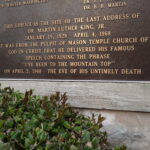 Rev. Dr. Martin Luther King, Jr, delivers his last public address, popularly known as the "I've Been to the Mountaintop" speech, at the Mason Temple (Church of God in Christ Headquarters) in Memphis, Tennessee. The speech primarily concerns the Memphis Sanitation Strike. King calls for unity, economic actions, boycotts, and nonviolent protest, while challenging the United States to live up to its ideals. At the end of the speech, he discusses the possibility of an untimely death. On the following day, King is assassinated. Learn more. Rev. Dr. Martin Luther King, Jr, delivers his last public address, popularly known as the "I've Been to the Mountaintop" speech, at the Mason Temple (Church of God in Christ Headquarters) in Memphis, Tennessee. The speech primarily concerns the Memphis Sanitation Strike. King calls for unity, economic actions, boycotts, and nonviolent protest, while challenging the United States to live up to its ideals. At the end of the speech, he discusses the possibility of an untimely death. On the following day, King is assassinated. Learn more. | |
| April 4, 1913 | 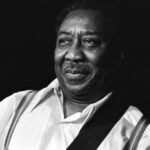 Exceptionally innovative and influential African American blues musician Muddy Waters (originally named McKinley Morganfield) is born. He is deemed the “father of modern Chicago blues” and influenced the 1960s generation of England which resulted in the appearance of British blues. Learn more. Exceptionally innovative and influential African American blues musician Muddy Waters (originally named McKinley Morganfield) is born. He is deemed the “father of modern Chicago blues” and influenced the 1960s generation of England which resulted in the appearance of British blues. Learn more. | |
| April 4, 1928 | 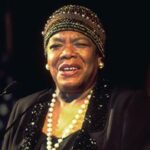 Prolific American poet, memoirist, and civil rights activist Maya Angelou (original name Marguerite Annie Johnson) is born. She published seven autobiographies, three books of essays, several books of poetry, and is credited with a list of plays, movies, and television shows spanning over 50 years. She received dozens of awards and more than 50 honorary degrees. Angelou is best known for her series of seven autobiographies, which focus on her childhood and early adult experiences. The first, I Know Why the Caged Bird Sings (1969), tells of her life up to the age of 17 and brought her international recognition and acclaim. Learn more. Prolific American poet, memoirist, and civil rights activist Maya Angelou (original name Marguerite Annie Johnson) is born. She published seven autobiographies, three books of essays, several books of poetry, and is credited with a list of plays, movies, and television shows spanning over 50 years. She received dozens of awards and more than 50 honorary degrees. Angelou is best known for her series of seven autobiographies, which focus on her childhood and early adult experiences. The first, I Know Why the Caged Bird Sings (1969), tells of her life up to the age of 17 and brought her international recognition and acclaim. Learn more. | |
| April 4, 1968 | 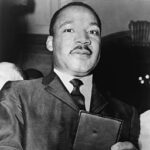 Rev. Dr. Martin Luther King, Jr. is assassinated in Memphis, TN. Learn more. Rev. Dr. Martin Luther King, Jr. is assassinated in Memphis, TN. Learn more. | |
| April 4, 2015 |  Walter Scott is fatally shot in North Charleston, South Carolina, by Michael Slager, a North Charleston police officer. Slager had stopped Scott for a non-functioning brake light. Slager was charged with murder after a video surfaced showing him shooting Scott from behind while Scott was fleeing, which contradicted Slager's report of the incident. Learn more. Walter Scott is fatally shot in North Charleston, South Carolina, by Michael Slager, a North Charleston police officer. Slager had stopped Scott for a non-functioning brake light. Slager was charged with murder after a video surfaced showing him shooting Scott from behind while Scott was fleeing, which contradicted Slager's report of the incident. Learn more. | |
| April 5, 1839 | 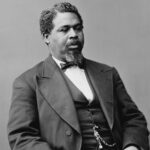 American politician, publisher, businessman, and naval pilot Robert Smalls is born into slavery in Beaufort, South Carolina. Smalls gained renown by freeing himself, his crew, and their families during the American Civil War by commandeering a Confederate transport ship, CSS Planter, in Charleston harbor, on May 13, 1862, and sailing it from Confederate-controlled waters of the harbor to the U.S. blockade that surrounded it. He then piloted the ship to the Union-controlled enclave in Beaufort-Port Royal-Hilton Head area, where it became a Union warship. His example and persuasion helped convince President Abraham Lincoln to accept African-American soldiers into the Union Army. After the American Civil War Smalls returned to Beaufort and became a politician, winning election as a Republican to the South Carolina Legislature and the United States House of Representatives during the Reconstruction era. Smalls authored state legislation providing for South Carolina to have the first free and compulsory public school system in the United States. He founded the Republican Party of South Carolina. Smalls was the last Republican to represent South Carolina's 5th congressional district until 2011. Learn more. American politician, publisher, businessman, and naval pilot Robert Smalls is born into slavery in Beaufort, South Carolina. Smalls gained renown by freeing himself, his crew, and their families during the American Civil War by commandeering a Confederate transport ship, CSS Planter, in Charleston harbor, on May 13, 1862, and sailing it from Confederate-controlled waters of the harbor to the U.S. blockade that surrounded it. He then piloted the ship to the Union-controlled enclave in Beaufort-Port Royal-Hilton Head area, where it became a Union warship. His example and persuasion helped convince President Abraham Lincoln to accept African-American soldiers into the Union Army. After the American Civil War Smalls returned to Beaufort and became a politician, winning election as a Republican to the South Carolina Legislature and the United States House of Representatives during the Reconstruction era. Smalls authored state legislation providing for South Carolina to have the first free and compulsory public school system in the United States. He founded the Republican Party of South Carolina. Smalls was the last Republican to represent South Carolina's 5th congressional district until 2011. Learn more. | |
| April 5, 1856 | 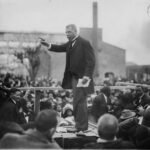 African American leader, orator and educator, Booker T. Washington is born into slavery in Hale’s Ford, Virginia. Washington would become one of America’s most recognized African American leaders by the beginning of the twentieth century. Washington worked his way through Hampton Normal Agricultural Institute in Virginia (now Hampton University). He also studied at Wayland Seminary (now Virginia Union University). On July 4, 1881 Booker T. Washington founded Tuskegee Normal and Industrial Institute (now Tuskegee University) located in Tuskegee, Alabama. Learn more. African American leader, orator and educator, Booker T. Washington is born into slavery in Hale’s Ford, Virginia. Washington would become one of America’s most recognized African American leaders by the beginning of the twentieth century. Washington worked his way through Hampton Normal Agricultural Institute in Virginia (now Hampton University). He also studied at Wayland Seminary (now Virginia Union University). On July 4, 1881 Booker T. Washington founded Tuskegee Normal and Industrial Institute (now Tuskegee University) located in Tuskegee, Alabama. Learn more. | |
| April 5, 1880 | 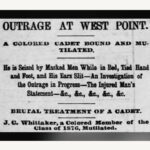 In the early hours of the morning, Cadet Johnson Whittaker, one of the first Black students in the U.S. Military Academy at West Point, was brutally beaten by white cadets while sleeping in his barracks. Three white cadets ambushed Cadet Whittaker, slashed his head and ears, burned his Bible, threatened his life and then left him in his underwear, tied to the bed and bleeding profusely. West Point opened an investigation into Whittaker, declined to hold his white attackers accountable, and charged and convicted Cadet Whittaker of staging the attack to get out of his final exams. After two years in prison, the court martial was overturned by order of US President Chester A. Arthur, but West Point then reinstated Whittaker’s expulsion by claiming he had failed one of his exams. Learn more. In the early hours of the morning, Cadet Johnson Whittaker, one of the first Black students in the U.S. Military Academy at West Point, was brutally beaten by white cadets while sleeping in his barracks. Three white cadets ambushed Cadet Whittaker, slashed his head and ears, burned his Bible, threatened his life and then left him in his underwear, tied to the bed and bleeding profusely. West Point opened an investigation into Whittaker, declined to hold his white attackers accountable, and charged and convicted Cadet Whittaker of staging the attack to get out of his final exams. After two years in prison, the court martial was overturned by order of US President Chester A. Arthur, but West Point then reinstated Whittaker’s expulsion by claiming he had failed one of his exams. Learn more. | |
| April 5, 1938 |  Prominent educator Walter Eugene Massey is born in Hattiesburg, Mississippi. His father, Almar, was a steelworker and his mother, Essie, a teacher. Massey had an exceptional mind, even at an early age. By the time he finished 10th grade, his skills in mathematics were strong enough to earn him a college scholarship. Massey enrolled at Morehouse College in Atlanta, Georgia, and graduated with a BS in math and physics in 1958. While working on his master’s and doctorate degrees at Washington University in St. Louis, Massey conducted research on the quantum of liquids and solids. He received a PhD in 1966. Massey began his teaching career as an associate professor at the University of Illinois then moved to Brown University in 1970, becoming a full professor five years later. Massey became the first African American president of the American Association for the Advancement of Science and as a director of the National Science Foundation, where he promoted more opportunities for minority students in math, science, and engineering programs at predominately white institutions. Massey also served as chair of the board of directors of Bank of America, chair of the Secretary of Energy Advisory Board in 1997, and member of the President’s Council of Advisors on Science and Technology. Learn more. Prominent educator Walter Eugene Massey is born in Hattiesburg, Mississippi. His father, Almar, was a steelworker and his mother, Essie, a teacher. Massey had an exceptional mind, even at an early age. By the time he finished 10th grade, his skills in mathematics were strong enough to earn him a college scholarship. Massey enrolled at Morehouse College in Atlanta, Georgia, and graduated with a BS in math and physics in 1958. While working on his master’s and doctorate degrees at Washington University in St. Louis, Massey conducted research on the quantum of liquids and solids. He received a PhD in 1966. Massey began his teaching career as an associate professor at the University of Illinois then moved to Brown University in 1970, becoming a full professor five years later. Massey became the first African American president of the American Association for the Advancement of Science and as a director of the National Science Foundation, where he promoted more opportunities for minority students in math, science, and engineering programs at predominately white institutions. Massey also served as chair of the board of directors of Bank of America, chair of the Secretary of Energy Advisory Board in 1997, and member of the President’s Council of Advisors on Science and Technology. Learn more. | |
| April 6, 1798 | 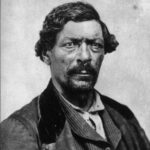 African American mountain man, fur trader, pioneer, and explorer James Pierson Beckwourth is born. He was famously known as "Bloody Arm" because of his skill as a fighter. Born into slavery in Virginia, he was freed by his white father (and master), and as a young man moved to the American West, first making connections with fur traders in St. Louis, Missouri. As a fur trapper, he lived with the Crow Nation for years. He is credited with the discovery of Beckwourth Pass, through the Sierra Nevada Mountains, between present-day Reno, Nevada, and Portola, California, during the California Gold Rush years. He improved the Beckwourth Trail, enabling thousands of settlers to arrive in central California. Beckwourth narrated his life story in a book published in New York City and London in 1856 as The Life and Adventures of James P. Beckwourth: Mountaineer, Scout and Pioneer, and Chief of the Crow Nation of Indians. A translation was published in France in 1860. Learn more. African American mountain man, fur trader, pioneer, and explorer James Pierson Beckwourth is born. He was famously known as "Bloody Arm" because of his skill as a fighter. Born into slavery in Virginia, he was freed by his white father (and master), and as a young man moved to the American West, first making connections with fur traders in St. Louis, Missouri. As a fur trapper, he lived with the Crow Nation for years. He is credited with the discovery of Beckwourth Pass, through the Sierra Nevada Mountains, between present-day Reno, Nevada, and Portola, California, during the California Gold Rush years. He improved the Beckwourth Trail, enabling thousands of settlers to arrive in central California. Beckwourth narrated his life story in a book published in New York City and London in 1856 as The Life and Adventures of James P. Beckwourth: Mountaineer, Scout and Pioneer, and Chief of the Crow Nation of Indians. A translation was published in France in 1860. Learn more. | |
| April 6, 1909 | 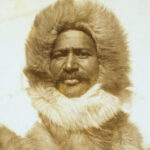 Matthew Alexander Henson is the first member of the first expedition to reach the geographic North Pole. Henson collaborated with Robert Peary on seven voyages to the Arctic over a period of nearly 23 years, spending a total of 18 years on expeditions together. Henson achieved a degree of fame as a result of participating in the expedition, and in 1912 he published a memoir titled A Negro Explorer at the North Pole. As he approached old age, his exploits received renewed attention. In 1937 he was the first African American to be made a life member of The Explorers Club; in 1948 he was elevated to the club's highest level of membership. In 1944 Henson was awarded the Peary Polar Expedition Medal, and he was received at the White House by Presidents Harry Truman and Dwight Eisenhower. In 1988 he and his wife were re-interred at Arlington National Cemetery. In 2000 Henson was posthumously awarded the Hubbard Medal by the National Geographic Society. Learn more. Matthew Alexander Henson is the first member of the first expedition to reach the geographic North Pole. Henson collaborated with Robert Peary on seven voyages to the Arctic over a period of nearly 23 years, spending a total of 18 years on expeditions together. Henson achieved a degree of fame as a result of participating in the expedition, and in 1912 he published a memoir titled A Negro Explorer at the North Pole. As he approached old age, his exploits received renewed attention. In 1937 he was the first African American to be made a life member of The Explorers Club; in 1948 he was elevated to the club's highest level of membership. In 1944 Henson was awarded the Peary Polar Expedition Medal, and he was received at the White House by Presidents Harry Truman and Dwight Eisenhower. In 1988 he and his wife were re-interred at Arlington National Cemetery. In 2000 Henson was posthumously awarded the Hubbard Medal by the National Geographic Society. Learn more. | |
| April 7, 1712 | 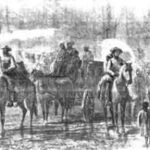 The first revolt against slavery in New York City takes place. Between twenty-five and fifty enslaved Blacks congregated at midnight. With guns, swords and knives in hand, they first set fire to an outhouse then fired shots at several white slave owners, who had raced to scene to fight the fire. By the end of the night, nine whites were killed and six whites were injured. The next day the governor of New York ordered the New York and Westchester militias to “drive the island.” With the exception of six rebels who committed suicide before they were apprehended, all of the rebels were captured and tortured, most to death, with ferocity ranging from being burned alive to being broken at the wheel. Learn more. The first revolt against slavery in New York City takes place. Between twenty-five and fifty enslaved Blacks congregated at midnight. With guns, swords and knives in hand, they first set fire to an outhouse then fired shots at several white slave owners, who had raced to scene to fight the fire. By the end of the night, nine whites were killed and six whites were injured. The next day the governor of New York ordered the New York and Westchester militias to “drive the island.” With the exception of six rebels who committed suicide before they were apprehended, all of the rebels were captured and tortured, most to death, with ferocity ranging from being burned alive to being broken at the wheel. Learn more. | |
| April 7, 1872 | 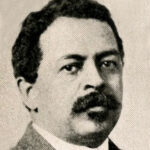 Newspaper editor, Boston real estate businessman, and African-American civil rights activist William Monroe Trotter (sometimes just Monroe Trotter) is born. Trotter earned his graduate and post-graduate degrees at Harvard University, and was the first man of color to earn a Phi Beta Kappa key there. Seeing an increase in segregation in northern facilities, he began to engage in a life of activism, to which he devoted his assets. Trotter was an early opponent of Booker T. Washington’s accommodationist policies, and in 1901 founded the Boston Guardian, an independent African-American newspaper he used to express that opposition. He joined with W. E. B. Du Bois in founding the Niagara Movement in 1905, a forerunner of the National Association for the Advancement of Colored People (NAACP). His protest activities were sometimes seen to be at cross purposes to those of the NAACP. In 1914, he had a highly publicized meeting with President Woodrow Wilson, in which he protested Wilson's introduction of segregation into the federal workplace. In Boston, Trotter succeeded in shutting down productions of The Clansman in 1910, but he was unsuccessful in 1915 with screenings of the movie The Birth of a Nation, which also portrayed the Ku Klux Klan in favorable terms. In 1921, in an alliance with Roman Catholics, he got a revival screening of The Birth of a Nation banned. He died on his 62nd birthday. Learn more. Newspaper editor, Boston real estate businessman, and African-American civil rights activist William Monroe Trotter (sometimes just Monroe Trotter) is born. Trotter earned his graduate and post-graduate degrees at Harvard University, and was the first man of color to earn a Phi Beta Kappa key there. Seeing an increase in segregation in northern facilities, he began to engage in a life of activism, to which he devoted his assets. Trotter was an early opponent of Booker T. Washington’s accommodationist policies, and in 1901 founded the Boston Guardian, an independent African-American newspaper he used to express that opposition. He joined with W. E. B. Du Bois in founding the Niagara Movement in 1905, a forerunner of the National Association for the Advancement of Colored People (NAACP). His protest activities were sometimes seen to be at cross purposes to those of the NAACP. In 1914, he had a highly publicized meeting with President Woodrow Wilson, in which he protested Wilson's introduction of segregation into the federal workplace. In Boston, Trotter succeeded in shutting down productions of The Clansman in 1910, but he was unsuccessful in 1915 with screenings of the movie The Birth of a Nation, which also portrayed the Ku Klux Klan in favorable terms. In 1921, in an alliance with Roman Catholics, he got a revival screening of The Birth of a Nation banned. He died on his 62nd birthday. Learn more. | |
| April 7, 1885 | 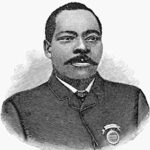 Granville T. Woods, a leading inventor of the 19th and early 20th centuries, patents an apparatus for transmission of messages by using electricity. Woods’s Synchronous Multiplex Railway Telegraph enabled communications from moving trains, completely changing the operation of the railway system. The invention dramatically improved the safety and reliability of America’s transportation system, saving perhaps thousands of lives, by allowing trains to communicate with each other while moving on the rails. Woods sold his telegraphony invention which was a system in which a telegraph station could use a single wire to send messages by voice and telegraph to American Bell Telephone Company. Learn more. Granville T. Woods, a leading inventor of the 19th and early 20th centuries, patents an apparatus for transmission of messages by using electricity. Woods’s Synchronous Multiplex Railway Telegraph enabled communications from moving trains, completely changing the operation of the railway system. The invention dramatically improved the safety and reliability of America’s transportation system, saving perhaps thousands of lives, by allowing trains to communicate with each other while moving on the rails. Woods sold his telegraphony invention which was a system in which a telegraph station could use a single wire to send messages by voice and telegraph to American Bell Telephone Company. Learn more. | |
| April 7, 1915 | 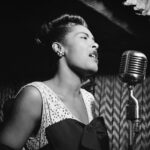 Eleanora Fagan, known professionally as Billie Holiday, is born. An American jazz and swing music singer nicknamed "Lady Day" by her friend and music partner Lester Young, Holiday had an innovative influence on jazz music and popsinging. Her vocal style, strongly inspired by jazz instrumentalists, pioneered a new way of manipulating phrasing and tempo. She was known for her vocal delivery and improvisational skills. Learn more. Eleanora Fagan, known professionally as Billie Holiday, is born. An American jazz and swing music singer nicknamed "Lady Day" by her friend and music partner Lester Young, Holiday had an innovative influence on jazz music and popsinging. Her vocal style, strongly inspired by jazz instrumentalists, pioneered a new way of manipulating phrasing and tempo. She was known for her vocal delivery and improvisational skills. Learn more. | |
| April 8, 1872 | 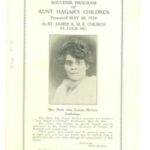 Playwright and educator Ruth Ada Gaines-Shelton is born in Glasgow, Missouri. Gaines-Shelton was raised by her father, a minister in the African Methodist Episcopal Church. She graduated from Wilberforce University in 1895 and went on to teach school in Montgomery, Missouri. Ruth Gaines-Shelton plays were part of the Harlem Renaissance. She is best known for her allegorical comedy The Church Fight, written in 1925. Unique and innovative for its era, The Church Fight does not deal with the relationship between different racial communities, but rather is totally centered around the black experience, written for a black audience. Many of Gaines-Shelton's plays were written for her own church and women's clubs. Not all of her plays have survived with many of her manuscripts lost and unpublished. Learn more. Playwright and educator Ruth Ada Gaines-Shelton is born in Glasgow, Missouri. Gaines-Shelton was raised by her father, a minister in the African Methodist Episcopal Church. She graduated from Wilberforce University in 1895 and went on to teach school in Montgomery, Missouri. Ruth Gaines-Shelton plays were part of the Harlem Renaissance. She is best known for her allegorical comedy The Church Fight, written in 1925. Unique and innovative for its era, The Church Fight does not deal with the relationship between different racial communities, but rather is totally centered around the black experience, written for a black audience. Many of Gaines-Shelton's plays were written for her own church and women's clubs. Not all of her plays have survived with many of her manuscripts lost and unpublished. Learn more. | |
| April 8, 1920 | 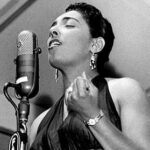 American jazz singer Carmen Mercedes McRae is born. She is considered one of the most influential jazz vocalists of the 20th century and is remembered for her behind-the-beat phrasing and ironic interpretation of lyrics. McRae was born in Harlem, New York City, United States. Her father, Osmond, and mother, Evadne (Gayle) McRae, were immigrants from Jamaica. She began studying piano when she was eight, and the music of jazz greats such as Louis Armstrong and Duke Ellington filled her home. When she was 17 years old, she met singer Billie Holiday. As a teenager McRae came to the attention of Teddy Wilson and his wife, the composer Irene Kitchings. One of McRae's early songs, "Dream of Life", was, through their influence, recorded in 1939 by Wilson’s long-time collaborator Billie Holiday. McRae considered Holiday to be her primary influence. Learn more. American jazz singer Carmen Mercedes McRae is born. She is considered one of the most influential jazz vocalists of the 20th century and is remembered for her behind-the-beat phrasing and ironic interpretation of lyrics. McRae was born in Harlem, New York City, United States. Her father, Osmond, and mother, Evadne (Gayle) McRae, were immigrants from Jamaica. She began studying piano when she was eight, and the music of jazz greats such as Louis Armstrong and Duke Ellington filled her home. When she was 17 years old, she met singer Billie Holiday. As a teenager McRae came to the attention of Teddy Wilson and his wife, the composer Irene Kitchings. One of McRae's early songs, "Dream of Life", was, through their influence, recorded in 1939 by Wilson’s long-time collaborator Billie Holiday. McRae considered Holiday to be her primary influence. Learn more. | |
| April 8, 1960 |  The Student Nonviolent Coordinating Committee (SNCC), the principal channel of student commitment in the United States to the civil rights movement during the 1960s, is formed. Emerging from the student-led sit-ins at segregated lunch counters in Greensboro, North Carolina, and Nashville, Tennessee, the SNCC sought to coordinate and assist direct-action challenges to the civic segregation and political exclusion of African Americans. From 1962, with the support of the Voter Education Project, SNCC committed to the registration and mobilization of black voters in the Deep South. Affiliates such as the Mississippi Freedom Democratic Party and the Lowndes County Freedom Organization in Alabama increased dramatically the pressure on federal and state government to enforce constitutional protections. Learn more. The Student Nonviolent Coordinating Committee (SNCC), the principal channel of student commitment in the United States to the civil rights movement during the 1960s, is formed. Emerging from the student-led sit-ins at segregated lunch counters in Greensboro, North Carolina, and Nashville, Tennessee, the SNCC sought to coordinate and assist direct-action challenges to the civic segregation and political exclusion of African Americans. From 1962, with the support of the Voter Education Project, SNCC committed to the registration and mobilization of black voters in the Deep South. Affiliates such as the Mississippi Freedom Democratic Party and the Lowndes County Freedom Organization in Alabama increased dramatically the pressure on federal and state government to enforce constitutional protections. Learn more. | |
| April 9, 1775 | 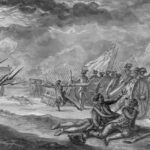 Free Blacks fight with the Minutemen in the opening skirmishes of the Revolutionary War at Lexington and Concord. Learn more. Free Blacks fight with the Minutemen in the opening skirmishes of the Revolutionary War at Lexington and Concord. Learn more. | |
| April 9, 1887 | 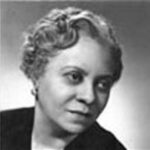 Florence Beatrice Price (née Smith) is born. A classical composer, pianist, organist and music teacher, Price is noted as the first African-American woman to be recognized as a symphonic composer, and the first to have a composition played by a major orchestra. In 1932, Price submitted compositions for the Wanamaker Foundation Awards. Price won first prize with her Symphony in E minor, and third for her Piano Sonata. The Chicago Symphony Orchestra, conducted by Frederick Stock, premiered the Symphony on June 15, 1933, making Price’s piece the first composition by an African-American woman to be played by a major orchestra. A number of Price's other orchestral works were played by the WPA Symphony Orchestra of Detroit, the Chicago Women’s Symphony, and the Women's Symphony Orchestra of Chicago. Price wrote other extended works for orchestra, chamber works, art songs, works for violin, organ anthems, piano pieces, spiritual arrangements, four symphonies, three piano concertos, and a violin concerto. Some of her more popular works are: "Three Little Negro Dances," "Songs to the Dark Virgin", "My Soul's Been Anchored in the Lord" for piano or orchestra and voice, and "Moon Bridge". Price made considerable use of characteristic African-American melodies and rhythms in many of her works. Her Concert Overture on Negro Spirituals, Symphony in E minor, and Negro Folksongs in Counterpoint for string quartet, all serve as excellent examples of her idiomatic work. Price was inducted into the American Society of Composers, Authors, and Publishers in 1940 for her work as a composer. In 1949, Price published two of her spiritual arrangements, "I Am Bound for the Kingdom," and "I'm Workin’ on My Buildin'", and dedicated them to Marian Anderson, who performed them on a regular basis. Learn more. Florence Beatrice Price (née Smith) is born. A classical composer, pianist, organist and music teacher, Price is noted as the first African-American woman to be recognized as a symphonic composer, and the first to have a composition played by a major orchestra. In 1932, Price submitted compositions for the Wanamaker Foundation Awards. Price won first prize with her Symphony in E minor, and third for her Piano Sonata. The Chicago Symphony Orchestra, conducted by Frederick Stock, premiered the Symphony on June 15, 1933, making Price’s piece the first composition by an African-American woman to be played by a major orchestra. A number of Price's other orchestral works were played by the WPA Symphony Orchestra of Detroit, the Chicago Women’s Symphony, and the Women's Symphony Orchestra of Chicago. Price wrote other extended works for orchestra, chamber works, art songs, works for violin, organ anthems, piano pieces, spiritual arrangements, four symphonies, three piano concertos, and a violin concerto. Some of her more popular works are: "Three Little Negro Dances," "Songs to the Dark Virgin", "My Soul's Been Anchored in the Lord" for piano or orchestra and voice, and "Moon Bridge". Price made considerable use of characteristic African-American melodies and rhythms in many of her works. Her Concert Overture on Negro Spirituals, Symphony in E minor, and Negro Folksongs in Counterpoint for string quartet, all serve as excellent examples of her idiomatic work. Price was inducted into the American Society of Composers, Authors, and Publishers in 1940 for her work as a composer. In 1949, Price published two of her spiritual arrangements, "I Am Bound for the Kingdom," and "I'm Workin’ on My Buildin'", and dedicated them to Marian Anderson, who performed them on a regular basis. Learn more. | |
| April 9, 1898 | 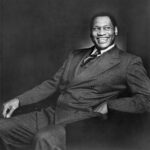 Paul Leroy Robeson is born. An American bass baritone concert artist and stage and film actor, Robeson became famous both for his cultural accomplishments and for his political activism. Educated at Rutgers College and Columbia University, he was a star athlete in his youth. Robeson also studied Swahili and phonetics at the School of Oriental and African Studies in London in 1934. His political activities began with his involvement with unemployed workers and anti-imperialist students whom he met in Britain and continued with support for the Republican cause in the Spanish Civil War and his opposition to fascism. In the United States he became active in the Civil Rights Movement and other social justice campaigns. Learn more. Paul Leroy Robeson is born. An American bass baritone concert artist and stage and film actor, Robeson became famous both for his cultural accomplishments and for his political activism. Educated at Rutgers College and Columbia University, he was a star athlete in his youth. Robeson also studied Swahili and phonetics at the School of Oriental and African Studies in London in 1934. His political activities began with his involvement with unemployed workers and anti-imperialist students whom he met in Britain and continued with support for the Republican cause in the Spanish Civil War and his opposition to fascism. In the United States he became active in the Civil Rights Movement and other social justice campaigns. Learn more. | |
| April 9, 1939 |  Marian Anderson gives a concert on the steps of the Lincoln Memorial in Washington, DC before a crowd of 75,000 people in attendance and millions more listening over the radio. The greatest opera singer of her day, lauded by European nobility and called by great Italian conductor Arturo Toscanini a voice heard “once in a hundred years,”Anderson had previously been denied rental of the Daughters of the American Revolution (DAR) Constitution Hall and all the local public school auditoriums owing to their whites-only policies. Sixteen years after the Lincoln Memorial concert, Ms. Anderson performed at the Metropolitan Opera in New York in 1955, becoming the first Black artist to do so. Throughout her career, Ms. Anderson continued to perform all over the world while also lending her talent to the struggle against racial injustice. The granddaughter of Black people once enslaved in Virginia, she sang at the March on Washington in 1963, and was awarded the Presidential Medal of Freedom that same year. Learn more. Marian Anderson gives a concert on the steps of the Lincoln Memorial in Washington, DC before a crowd of 75,000 people in attendance and millions more listening over the radio. The greatest opera singer of her day, lauded by European nobility and called by great Italian conductor Arturo Toscanini a voice heard “once in a hundred years,”Anderson had previously been denied rental of the Daughters of the American Revolution (DAR) Constitution Hall and all the local public school auditoriums owing to their whites-only policies. Sixteen years after the Lincoln Memorial concert, Ms. Anderson performed at the Metropolitan Opera in New York in 1955, becoming the first Black artist to do so. Throughout her career, Ms. Anderson continued to perform all over the world while also lending her talent to the struggle against racial injustice. The granddaughter of Black people once enslaved in Virginia, she sang at the March on Washington in 1963, and was awarded the Presidential Medal of Freedom that same year. Learn more. | |
| April 10, 1822 | 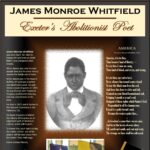 African-American poet, abolitionist, and political activist James Monroe Whitfield is born. A notable writer and activist in abolitionism and African emigration during the antebellum era, he published the book "America and other poems" in 1853, which is still in print. Learn more. African-American poet, abolitionist, and political activist James Monroe Whitfield is born. A notable writer and activist in abolitionism and African emigration during the antebellum era, he published the book "America and other poems" in 1853, which is still in print. Learn more. | |
| April 10, 1956 | 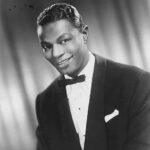 While performing before an all-white audience of 4,000 at the Municipal Auditorium in Birmingham, Alabama, African American singer and pianist Nat King Cole is attacked and knocked down by a group of white men. Before the attack, a drunk man near the front row jeered at Mr. Cole, "Negro, go home." Outside the arena, police later found a car containing rifles, a blackjack, and brass knuckles. Learn more. While performing before an all-white audience of 4,000 at the Municipal Auditorium in Birmingham, Alabama, African American singer and pianist Nat King Cole is attacked and knocked down by a group of white men. Before the attack, a drunk man near the front row jeered at Mr. Cole, "Negro, go home." Outside the arena, police later found a car containing rifles, a blackjack, and brass knuckles. Learn more. | |
| April 11, 1899 | 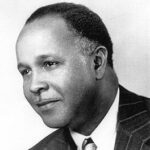 Percy Lavon Julian, PhD, research chemist and a pioneer in the chemical synthesis of medicinal drugs from plants, is born. Dr. Julian was the first to synthesize the natural product physostigmine and was a pioneer in the industrial large-scale chemical synthesis of the human hormones progesterone and testosterone from plant sterols such as stigmasterol and sitosterol. His work laid the foundation for the steroid drug industry's production of cortisone, other corticosteroids, and birth control pills. He later started his own company to synthesize steroid intermediates from the wild Mexican yam. His work helped greatly reduce the cost of steroid intermediates to large multinational pharmaceutical companies, helping to significantly expand the use of several important drugs. Julian received more than 130 chemical patents. He was the first African-American chemist inducted into the National Academy of Sciences, and the second African-American scientist inducted (after David Blackwell) from any field. Learn more. Percy Lavon Julian, PhD, research chemist and a pioneer in the chemical synthesis of medicinal drugs from plants, is born. Dr. Julian was the first to synthesize the natural product physostigmine and was a pioneer in the industrial large-scale chemical synthesis of the human hormones progesterone and testosterone from plant sterols such as stigmasterol and sitosterol. His work laid the foundation for the steroid drug industry's production of cortisone, other corticosteroids, and birth control pills. He later started his own company to synthesize steroid intermediates from the wild Mexican yam. His work helped greatly reduce the cost of steroid intermediates to large multinational pharmaceutical companies, helping to significantly expand the use of several important drugs. Julian received more than 130 chemical patents. He was the first African-American chemist inducted into the National Academy of Sciences, and the second African-American scientist inducted (after David Blackwell) from any field. Learn more. | |
| April 11, 1913 | 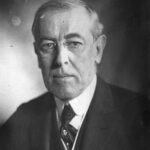 Recently inaugurated President Woodrow Wilson receives Postmaster General Albert Burleson's plan to segregate the Railway Mail Service. Burleson reported that he found it “intolerable” that white and Black employees had to work together and share drinking glasses and washrooms. This sentiment was shared by others in Wilson's administration; William McAdoo, Secretary of the Treasury, argued that segregation was necessary “to remove the causes of complaint and irritation where white women have been forced unnecessarily to sit at desks with colored men.”By the end of 1913, Black employees in several federal departments had been relegated to separate or screened-off work areas and segregated lavatories and lunchrooms. In addition to physical separation from white workers, Black employees were appointed to menial positions or reassigned to divisions slated for elimination. The government also began requiring photographs on civil service applications, to better enable racial screening. Meanwhile, segregation in federal employment was seen as a significant blow to Black Americans' rights and seemed to signify official Presidential approval of Jim Crow policies in the South. Wilson's aggressive segregation of the federal government was an extreme betrayal of African Americans, many of whom had split from the Republican Party to back Democratic Party-candidate Wilson in the 1912 election based on his repeated campaign assurances to Black leaders. Learn more here, here, and here. Recently inaugurated President Woodrow Wilson receives Postmaster General Albert Burleson's plan to segregate the Railway Mail Service. Burleson reported that he found it “intolerable” that white and Black employees had to work together and share drinking glasses and washrooms. This sentiment was shared by others in Wilson's administration; William McAdoo, Secretary of the Treasury, argued that segregation was necessary “to remove the causes of complaint and irritation where white women have been forced unnecessarily to sit at desks with colored men.”By the end of 1913, Black employees in several federal departments had been relegated to separate or screened-off work areas and segregated lavatories and lunchrooms. In addition to physical separation from white workers, Black employees were appointed to menial positions or reassigned to divisions slated for elimination. The government also began requiring photographs on civil service applications, to better enable racial screening. Meanwhile, segregation in federal employment was seen as a significant blow to Black Americans' rights and seemed to signify official Presidential approval of Jim Crow policies in the South. Wilson's aggressive segregation of the federal government was an extreme betrayal of African Americans, many of whom had split from the Republican Party to back Democratic Party-candidate Wilson in the 1912 election based on his repeated campaign assurances to Black leaders. Learn more here, here, and here. | |
| April 12, 1825 | 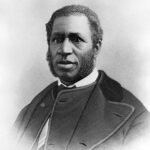 Reverend Richard Harvey Cain is born. Cain was a minister, abolitionist, and United States Representative from South Carolina from 1873–1875 and 1877-1879. After the Civil War, he was appointed by Bishop Daniel Payne as a missionaryof the African Methodist Episcopal Church in South Carolina. He also was one of the founders of Lincolnville, South Carolina. Learn more. Reverend Richard Harvey Cain is born. Cain was a minister, abolitionist, and United States Representative from South Carolina from 1873–1875 and 1877-1879. After the Civil War, he was appointed by Bishop Daniel Payne as a missionaryof the African Methodist Episcopal Church in South Carolina. He also was one of the founders of Lincolnville, South Carolina. Learn more. | |
| April 12, 1864 | 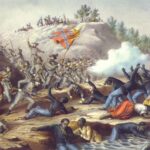 Rebel troops commanded by Confederate General Nathan Bedford Forrest commit the Fort Pillow Massacre, murdering several hundred Union soldiers, the vast majority of whom were Black, after they had already surrendered. Forrest, who after the war become the first Grand Wizard of the Ku Klux Klan, initially described a river as “dyed with the blood of the slaughtered for 200 yards,” and his field commander bragged that his men had taught “the mongrel garrison” a memorable lesson; later, Forrest and his staff later either denied there was a massacre or blamed it on the garrison itself. The Fort Pillow affair became a target of Southern revisionists, and many reference works balk at deeming the battle a massacre. But recent accounts drawn from primary sources conclude emphatically that a massacre did indeed transpire, and that Forrest’s field officers did little to stop it, for which Forrest himself bears the ultimate responsibility. Learn more here and here. Rebel troops commanded by Confederate General Nathan Bedford Forrest commit the Fort Pillow Massacre, murdering several hundred Union soldiers, the vast majority of whom were Black, after they had already surrendered. Forrest, who after the war become the first Grand Wizard of the Ku Klux Klan, initially described a river as “dyed with the blood of the slaughtered for 200 yards,” and his field commander bragged that his men had taught “the mongrel garrison” a memorable lesson; later, Forrest and his staff later either denied there was a massacre or blamed it on the garrison itself. The Fort Pillow affair became a target of Southern revisionists, and many reference works balk at deeming the battle a massacre. But recent accounts drawn from primary sources conclude emphatically that a massacre did indeed transpire, and that Forrest’s field officers did little to stop it, for which Forrest himself bears the ultimate responsibility. Learn more here and here. | |
| April 13, 1873 |  The Colfax Massacre occurred on Easter Sunday, April 13, 1873, in Colfax, Louisiana, the seat of Grant Parish. An estimated 62-153 Black men were killed while surrendering to a white mob composed of former Confederate soldiers, members of the Ku Klux Klan, and the White League (a white paramilitary terrorist organization). Only three white men died. After the massacre, the federal government indicted over 100 members of the white mob under the Enforcement Act of 1870, a law specifically enacted during Reconstruction to protect newly freed Black voters from the Ku Klux Klan and other white supremacist terrorists. Only three members of the mob were convicted, and they appealed. Nearly one year later, the Supreme Court reversed the criminal convictions of the three white men and holding that that the Bill of Rights did not apply to private actors or to state governments despite the adoption of the Fourteenth Amendment. The decision severely limited the federal government’s authority to legally enforce Black civil rights and protect Black citizens from racial terror at the hands of mobs intent on enhancing white racial dominance. Learn more. The Colfax Massacre occurred on Easter Sunday, April 13, 1873, in Colfax, Louisiana, the seat of Grant Parish. An estimated 62-153 Black men were killed while surrendering to a white mob composed of former Confederate soldiers, members of the Ku Klux Klan, and the White League (a white paramilitary terrorist organization). Only three white men died. After the massacre, the federal government indicted over 100 members of the white mob under the Enforcement Act of 1870, a law specifically enacted during Reconstruction to protect newly freed Black voters from the Ku Klux Klan and other white supremacist terrorists. Only three members of the mob were convicted, and they appealed. Nearly one year later, the Supreme Court reversed the criminal convictions of the three white men and holding that that the Bill of Rights did not apply to private actors or to state governments despite the adoption of the Fourteenth Amendment. The decision severely limited the federal government’s authority to legally enforce Black civil rights and protect Black citizens from racial terror at the hands of mobs intent on enhancing white racial dominance. Learn more. | |
| April 13, 1891 | 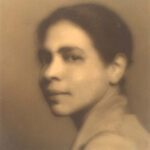 Nellallitea "Nella" Larsen, born Nellie Walker, an American novelist of the Harlem Renaissance, is born. Working as a nurse and a librarian, she published two novels, Quicksand (1928) and Passing (1929), and a few short stories. Though her literary output was scant, she earned recognition by her contemporaries. A revival of interest in her writing has occurred since the late 20th century, when issues of racial and sexual identity have been studied. Her works have been the subjects of numerous academic studies, and she is now widely lauded as "not only the premier novelist of the Harlem Renaissance, but also an important figure in American modernism." Learn more. Nellallitea "Nella" Larsen, born Nellie Walker, an American novelist of the Harlem Renaissance, is born. Working as a nurse and a librarian, she published two novels, Quicksand (1928) and Passing (1929), and a few short stories. Though her literary output was scant, she earned recognition by her contemporaries. A revival of interest in her writing has occurred since the late 20th century, when issues of racial and sexual identity have been studied. Her works have been the subjects of numerous academic studies, and she is now widely lauded as "not only the premier novelist of the Harlem Renaissance, but also an important figure in American modernism." Learn more. | |
| April 14, 1875 | 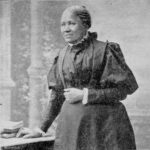 Frances Ellen Watkins Harper, an abolitionist, suffragist, poet, teacher, public speaker, and writer (she was one of the first African American women to be published in the United States), delivered an address in Philadelphia at the Centennial Anniversary of the nation’s oldest abolitionist society, the Pennsylvania Society for Promoting the Abolition of Slavery outlining the work yet to be done in the cause of African American freedom. Harper publicized the violence and intimidation in the South directed at the freedpeople. She argued African Americans must organize to complete the work of Reconstruction rather than relying on political parties or organizations, and that Black women must play an important role in these crucial efforts. Read her address. Frances Ellen Watkins Harper, an abolitionist, suffragist, poet, teacher, public speaker, and writer (she was one of the first African American women to be published in the United States), delivered an address in Philadelphia at the Centennial Anniversary of the nation’s oldest abolitionist society, the Pennsylvania Society for Promoting the Abolition of Slavery outlining the work yet to be done in the cause of African American freedom. Harper publicized the violence and intimidation in the South directed at the freedpeople. She argued African Americans must organize to complete the work of Reconstruction rather than relying on political parties or organizations, and that Black women must play an important role in these crucial efforts. Read her address. | |
| April 14, 1906 | 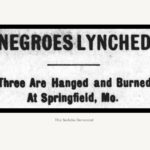 A white mob breaks into the Springfield, Missouri county jail, and lynches two black men, Horace Duncan and Fred Coker, for allegedly sexually assaulting Mina Edwards, a white woman. Later the mob returns to the jail, where other African-American prisoners are being held, and pull out Will Allen, who had been accused of murdering a white man. All three suspects were hanged from the Gottfried Tower, which held a replica of the Statue of Liberty, and burned in the courthouse square by the white mob of more than 2,000. No one was convicted of the lynchings. The proceedings were covered by national newspapers, the New York Times and Los Angeles Times. Duncan's and Coker's employer testified that they were at his business at the time of the crime against Edwards, Edwards gave a public statement saying they were not her attackers, and other evidence suggested that they and Allen were all innocent. Extrajudicial murders were part of a pattern of discrimination, repeated violence and intimidation of African Americans in Springfield and southwest Missouri from 1894 to 1909, in an attempt to expel them from the region. Whites in Lawrence County also lynched three African-American men in this period. After the mass lynching in Springfield, many African Americans left the area in a large exodus. There are at least 60 recorded African American victims of racial terror lynching in Missouri between 1877 and 1950. Learn more. A white mob breaks into the Springfield, Missouri county jail, and lynches two black men, Horace Duncan and Fred Coker, for allegedly sexually assaulting Mina Edwards, a white woman. Later the mob returns to the jail, where other African-American prisoners are being held, and pull out Will Allen, who had been accused of murdering a white man. All three suspects were hanged from the Gottfried Tower, which held a replica of the Statue of Liberty, and burned in the courthouse square by the white mob of more than 2,000. No one was convicted of the lynchings. The proceedings were covered by national newspapers, the New York Times and Los Angeles Times. Duncan's and Coker's employer testified that they were at his business at the time of the crime against Edwards, Edwards gave a public statement saying they were not her attackers, and other evidence suggested that they and Allen were all innocent. Extrajudicial murders were part of a pattern of discrimination, repeated violence and intimidation of African Americans in Springfield and southwest Missouri from 1894 to 1909, in an attempt to expel them from the region. Whites in Lawrence County also lynched three African-American men in this period. After the mass lynching in Springfield, many African Americans left the area in a large exodus. There are at least 60 recorded African American victims of racial terror lynching in Missouri between 1877 and 1950. Learn more. | |
| April 14, 1938 | 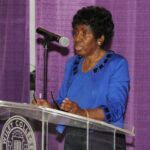 Civic and educational leader Gloria Dean Randle Scott, the first African-American president of the Girl Scouts of America and the twelfth president of Bennett College, is born in Houston, Texas to Juanita Bell and Freeman Randle. Scott grew up in Houston, attending Blackshear Elementary and Jack Yates Secondary School. Acquiring a scholarship, she continued her education at Indiana University where she received a BA in 1959, an MA in Zoology in 1960, and a PhD in education in 1965. Scott has received numerous awards, including six honorary degrees, League of Women Voters prizes in 2008 and 2010, the Star of Texas Award in 2009 and the Urban League Star Award. She was noted as a History Maker in November 2010. She is a member of Delta Sigma Theta Sorority, has chaired the Corpus Christi Juneteenth Coalition for several years, and is an active member of the Corpus Christi Black Chamber of Commerce. She is also president of G. Randle Services, a consulting firm. Learn more. Civic and educational leader Gloria Dean Randle Scott, the first African-American president of the Girl Scouts of America and the twelfth president of Bennett College, is born in Houston, Texas to Juanita Bell and Freeman Randle. Scott grew up in Houston, attending Blackshear Elementary and Jack Yates Secondary School. Acquiring a scholarship, she continued her education at Indiana University where she received a BA in 1959, an MA in Zoology in 1960, and a PhD in education in 1965. Scott has received numerous awards, including six honorary degrees, League of Women Voters prizes in 2008 and 2010, the Star of Texas Award in 2009 and the Urban League Star Award. She was noted as a History Maker in November 2010. She is a member of Delta Sigma Theta Sorority, has chaired the Corpus Christi Juneteenth Coalition for several years, and is an active member of the Corpus Christi Black Chamber of Commerce. She is also president of G. Randle Services, a consulting firm. Learn more. | |
| April 15, 1852 | 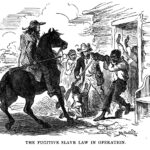 California enacts a harsh fugitive slave law that condemns dozens of African American migrants to deportation and lifelong slavery. Nearly all African Americans who came to California as slaves arrived during the pre-statehood torrent of goldseekers in 1849-50 and were susceptible to deportation. Even free African Americans easily fell victim to kidnapping and fraud because California’s black codes prohibited them from testifying against whites in state courts. Newspapers reported stories of nearly two dozen slaves arrested and sent back to the South between 1852 and 1855. Even after the lapse of the fugitive slave law in 1855, masters informally held slaves in California until 1864. Learn more. California enacts a harsh fugitive slave law that condemns dozens of African American migrants to deportation and lifelong slavery. Nearly all African Americans who came to California as slaves arrived during the pre-statehood torrent of goldseekers in 1849-50 and were susceptible to deportation. Even free African Americans easily fell victim to kidnapping and fraud because California’s black codes prohibited them from testifying against whites in state courts. Newspapers reported stories of nearly two dozen slaves arrested and sent back to the South between 1852 and 1855. Even after the lapse of the fugitive slave law in 1855, masters informally held slaves in California until 1864. Learn more. | |
| April 15, 1889 | 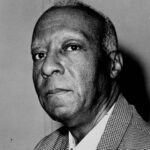 Birthday of A. Philip Randolph, early civil rights leader and labor organizer. Among his many accomplishments, Randolph organized the Brotherhood of Sleeping Car Porters (the first recognized Black labor union), convinced FDR to ban racial discriminatory hiring among defense contractors, and convinced President Truman to end segregation in the military. Learn more. Birthday of A. Philip Randolph, early civil rights leader and labor organizer. Among his many accomplishments, Randolph organized the Brotherhood of Sleeping Car Porters (the first recognized Black labor union), convinced FDR to ban racial discriminatory hiring among defense contractors, and convinced President Truman to end segregation in the military. Learn more. | |
| April 15, 1894 | 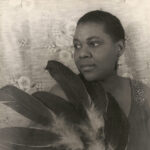 Widely renowned Jazz Age blues singer Bessie Smith is born. Nicknamed the "Empress of the Blues", she was the most popular female blues singer of the 1920s and 1930s. She is often regarded as one of the greatest singers of her era and was a major influence on fellow blues singers, as well as jazz vocalists. Born in Chattanooga, Tennessee, Smith was young when her parents died, and she and her siblings survived by performing on street corners. She began touring and performed in a group that included Ma Rainey, and then went out on her own. Her successful recording career with Columbia Records began in the 1920s, but her performing career was cut short by a car crash that killed her at the age of 43. Learn more. Widely renowned Jazz Age blues singer Bessie Smith is born. Nicknamed the "Empress of the Blues", she was the most popular female blues singer of the 1920s and 1930s. She is often regarded as one of the greatest singers of her era and was a major influence on fellow blues singers, as well as jazz vocalists. Born in Chattanooga, Tennessee, Smith was young when her parents died, and she and her siblings survived by performing on street corners. She began touring and performed in a group that included Ma Rainey, and then went out on her own. Her successful recording career with Columbia Records began in the 1920s, but her performing career was cut short by a car crash that killed her at the age of 43. Learn more. | |
| April 15, 1926 | 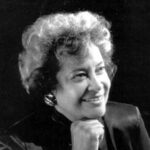 Norma Merrick Sklarek is born. The first African American woman to pass her license exam to officially become an architect in both New York (1954) and California (1962), Sklarek is most recognized for designing the United States Embassy in Tokyo, Japan in 1976 and the Terminal One station at the Los Angeles International Airport in 1984. After designing several buildings, she became the first black woman to own her own architectural practice with two women Margot Siegel and Katherine Diamond from 1985-1989. She earned the nickname "The Rosa Parks of Architecture" from Author Anna M Lewis for her major accomplishments as a black woman in a male dominanted field and continued to be a voice for women who were likely to face discrimination in certain careers. Learn more. Norma Merrick Sklarek is born. The first African American woman to pass her license exam to officially become an architect in both New York (1954) and California (1962), Sklarek is most recognized for designing the United States Embassy in Tokyo, Japan in 1976 and the Terminal One station at the Los Angeles International Airport in 1984. After designing several buildings, she became the first black woman to own her own architectural practice with two women Margot Siegel and Katherine Diamond from 1985-1989. She earned the nickname "The Rosa Parks of Architecture" from Author Anna M Lewis for her major accomplishments as a black woman in a male dominanted field and continued to be a voice for women who were likely to face discrimination in certain careers. Learn more. | |
| April 16, 1862 | 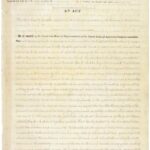 U.S. President Abraham Lincoln signs the District of Columbia Compensated Emancipation Act into law, thereby ending slavery in the District of Columbia and compensating slaveholders for releasing their enslaved people. This signing occurred 9 months prior to Lincoln’s issuance of the Emancipation Proclamation. April 16 is celebrated in Washington, DC as Emancipation Day. Learn more. U.S. President Abraham Lincoln signs the District of Columbia Compensated Emancipation Act into law, thereby ending slavery in the District of Columbia and compensating slaveholders for releasing their enslaved people. This signing occurred 9 months prior to Lincoln’s issuance of the Emancipation Proclamation. April 16 is celebrated in Washington, DC as Emancipation Day. Learn more. | |
| April 16, 1864 | 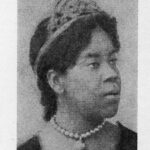 Popular and well-known black concert singer Flora Batson is born. Batson was nicknamed "The Double-Voiced Queen of Song" because of her soprano-baritone range, and was also called "the colored Jenny Lind" in the press. Batson began singing at a young age, in her church choir. In 1885, she began touring with the Bergen Star Company and became internationally known. She was a contemporary of Marie Selika Williams, Madam Flower "Bronze Melba", and Matilda Sissieretta Joyner Jones. She performed with Jones in 1885 in Providence, Rhode Island and was sometimes considered her rival. Batson married John Bergen in 1887 and their interracial marriage was fodder for tabloids. Supported by Bergen's management and touring company, she performed all over the world, including performances for royalty and religious leaders. Learn more. Popular and well-known black concert singer Flora Batson is born. Batson was nicknamed "The Double-Voiced Queen of Song" because of her soprano-baritone range, and was also called "the colored Jenny Lind" in the press. Batson began singing at a young age, in her church choir. In 1885, she began touring with the Bergen Star Company and became internationally known. She was a contemporary of Marie Selika Williams, Madam Flower "Bronze Melba", and Matilda Sissieretta Joyner Jones. She performed with Jones in 1885 in Providence, Rhode Island and was sometimes considered her rival. Batson married John Bergen in 1887 and their interracial marriage was fodder for tabloids. Supported by Bergen's management and touring company, she performed all over the world, including performances for royalty and religious leaders. Learn more. | |
| April 16, 1903 | 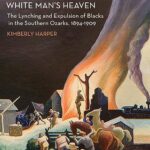 A mob of 2,000 angry white men storms the Joplin, Missouri jail, forcibly removes Thomas Gilyard, who had been arrested just an hour before for murder of a white police officer on no real evidence, and lynches him by hanging from a telephone and burning. The mob than proceeded to violently attack every Black person on sight in the city, then descended upon the Joplin’s Black districts, looting and burning houses, buildings, and businesses, and blockading the fire department from responding. These actions effectively drove every African American from Joplin, forcing most to flee with nothing but the clothes on their backs, foreclosed by threat of violence from ever recovering their losses. The lynching and terrorist racial cleansing made national newspapers, but were otherwise unexceptional for the era. Learn more. A mob of 2,000 angry white men storms the Joplin, Missouri jail, forcibly removes Thomas Gilyard, who had been arrested just an hour before for murder of a white police officer on no real evidence, and lynches him by hanging from a telephone and burning. The mob than proceeded to violently attack every Black person on sight in the city, then descended upon the Joplin’s Black districts, looting and burning houses, buildings, and businesses, and blockading the fire department from responding. These actions effectively drove every African American from Joplin, forcing most to flee with nothing but the clothes on their backs, foreclosed by threat of violence from ever recovering their losses. The lynching and terrorist racial cleansing made national newspapers, but were otherwise unexceptional for the era. Learn more. | |
| April 17, 1823 | 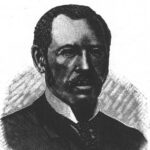 Widely accomplished “renaissance man” Mifflin Wistar Gibbs is born in Philadelphia, Pennsylvania. By his early 20s he was an activist in the abolition movement, sharing platforms with Frederick Douglass and helping in the Underground Railroad. Black intellectual ferment of the era gave him a superb education outside the classroom, and he became a powerful writer. In 1850 he migrated to San Francisco, California; he was soon a successful merchant, the founder of a black newspaper, Mirror of the Times, and a leading member of the city’s black community. Later moving to Victoria, British Columbia, Gibbs again prospered, first as a merchant, then as a property developer, contractor, and elected politician. Upon returning to the United States, Gibbs studied law in Oberlin, Ohio, then settled in Little Rock, Arkansas, soon becoming the first black elected municipal judge in the United States. He was later appointed U.S. consul in Tamatave, Madagascar. Upon returning to Little Rock, Gibbs launched Capital City Savings Bank, became a partner in the Little Rock Electric Light Company, gained control of several pieces of local real estate, and supported various philanthropic causes. He published an autobiography, Shadow and Light, in 1902, with an introduction by Booker T. Washington. Learn more. Widely accomplished “renaissance man” Mifflin Wistar Gibbs is born in Philadelphia, Pennsylvania. By his early 20s he was an activist in the abolition movement, sharing platforms with Frederick Douglass and helping in the Underground Railroad. Black intellectual ferment of the era gave him a superb education outside the classroom, and he became a powerful writer. In 1850 he migrated to San Francisco, California; he was soon a successful merchant, the founder of a black newspaper, Mirror of the Times, and a leading member of the city’s black community. Later moving to Victoria, British Columbia, Gibbs again prospered, first as a merchant, then as a property developer, contractor, and elected politician. Upon returning to the United States, Gibbs studied law in Oberlin, Ohio, then settled in Little Rock, Arkansas, soon becoming the first black elected municipal judge in the United States. He was later appointed U.S. consul in Tamatave, Madagascar. Upon returning to Little Rock, Gibbs launched Capital City Savings Bank, became a partner in the Little Rock Electric Light Company, gained control of several pieces of local real estate, and supported various philanthropic causes. He published an autobiography, Shadow and Light, in 1902, with an introduction by Booker T. Washington. Learn more. | |
| April 17, 1990 |  Playwright August Wilson wins the Pulitzer Prize for Drama (his second) for his play The Piano Lesson. It is the fourth play in Wilson's The Pittsburgh Cycle. Learn more. Playwright August Wilson wins the Pulitzer Prize for Drama (his second) for his play The Piano Lesson. It is the fourth play in Wilson's The Pittsburgh Cycle. Learn more. | |
| April 18, 1934 | 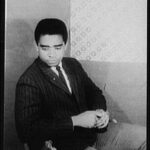 George Irving Shirley, an American operatic tenor and the first African-American tenor to perform a leading role at the Metropolitan Opera in New York City, is born. He earned a bachelor's degree in music education from Wayne State University in 1955 and then was drafted into the Army, where he became the first Black member of the United States Army Chorus. He was also the first African American hired to teach music in Detroit high schools. Learn more. George Irving Shirley, an American operatic tenor and the first African-American tenor to perform a leading role at the Metropolitan Opera in New York City, is born. He earned a bachelor's degree in music education from Wayne State University in 1955 and then was drafted into the Army, where he became the first Black member of the United States Army Chorus. He was also the first African American hired to teach music in Detroit high schools. Learn more. | |
| April 18, 1946 |  Thirty-two-year-old Navy veteran Davis Knight marries Junie Lee Spradley, a white woman. Two years later, the State of Mississippi indicted Knight for violating a state law that prohibited “marriage or cohabitation between white persons and those with one-eighth or more Negro or Mongolian blood.” The State claimed that Mr. Knight’s deceased great-grandmother was Black, making Mr. Knight at least one-eighth Black. On December 18, 1948, Mr. Knight was convicted of being Black and sentenced to five years in prison for marrying outside of his race. On November 14, 1949, the Mississippi Supreme Court reversed the conviction, holding that the State had failed to prove that Mr Knight’s great-grandmother was fully Black, so had failed to prove that Mr. Knight was at least one-eighth Black. The decision did not strike down the state’s miscegenation law, or prevent future prosecution of Mr. Knight or others; the state’s ban on interracial marriage would stand for nearly two more decades, until the United States Supreme Court’s 1967 decision in Loving v. Virginia struck down remaining anti-miscegenation laws in Mississippi and seventeen other states. Learn more. Thirty-two-year-old Navy veteran Davis Knight marries Junie Lee Spradley, a white woman. Two years later, the State of Mississippi indicted Knight for violating a state law that prohibited “marriage or cohabitation between white persons and those with one-eighth or more Negro or Mongolian blood.” The State claimed that Mr. Knight’s deceased great-grandmother was Black, making Mr. Knight at least one-eighth Black. On December 18, 1948, Mr. Knight was convicted of being Black and sentenced to five years in prison for marrying outside of his race. On November 14, 1949, the Mississippi Supreme Court reversed the conviction, holding that the State had failed to prove that Mr Knight’s great-grandmother was fully Black, so had failed to prove that Mr. Knight was at least one-eighth Black. The decision did not strike down the state’s miscegenation law, or prevent future prosecution of Mr. Knight or others; the state’s ban on interracial marriage would stand for nearly two more decades, until the United States Supreme Court’s 1967 decision in Loving v. Virginia struck down remaining anti-miscegenation laws in Mississippi and seventeen other states. Learn more. | |
| April 19, 1775 | 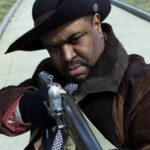 African American minutemen assemble and fight in an integrated colonial militia (first integrated army in American history) on the front lines at Lexington and Concord (the opening skirmish of the Revolutionary War) to defend Boston against a threatened attack by His Majesty's regiments. Although the Continental Army tried to exclude African Americans at one time during the conflict, and some states raised all-Black units, free African Americans and slave militiamen served alongside of white militiamen in many battles from Bunker Hill to Yorktown. Learn more.
African American minutemen assemble and fight in an integrated colonial militia (first integrated army in American history) on the front lines at Lexington and Concord (the opening skirmish of the Revolutionary War) to defend Boston against a threatened attack by His Majesty's regiments. Although the Continental Army tried to exclude African Americans at one time during the conflict, and some states raised all-Black units, free African Americans and slave militiamen served alongside of white militiamen in many battles from Bunker Hill to Yorktown. Learn more. | |
| April 19, 1885 | 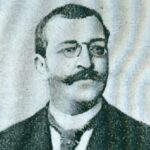 Lucien-Leon Guillaume Lambert‘s 1882 Rossini Concours Prize-winning composition Prométhée enchaîné (Prometheus Bound) is performed for the first time by the Société des Concerts du Conservatoire in Paris. Guillaume Lambert was a child-prodigy pianist, composer, arranger, and music teacher. Born in 1858 in Vernouillet, France, a then-small village near Paris, he was the son of Charles Lucien Lambert, an American, and an unknown French mother. Guillaume Lambert and some other members of his family are part of what has been termed a “Creole Romantic” musical dynasty composed of musicians with ties to New Orleans (Louisiana), France, Portugal, the Antilles Islands in the West Indies, and Latin America. Learn more. Lucien-Leon Guillaume Lambert‘s 1882 Rossini Concours Prize-winning composition Prométhée enchaîné (Prometheus Bound) is performed for the first time by the Société des Concerts du Conservatoire in Paris. Guillaume Lambert was a child-prodigy pianist, composer, arranger, and music teacher. Born in 1858 in Vernouillet, France, a then-small village near Paris, he was the son of Charles Lucien Lambert, an American, and an unknown French mother. Guillaume Lambert and some other members of his family are part of what has been termed a “Creole Romantic” musical dynasty composed of musicians with ties to New Orleans (Louisiana), France, Portugal, the Antilles Islands in the West Indies, and Latin America. Learn more. | |
| April 19, 1887 | 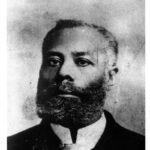 Elijah McCoy patents the Lubricator Attachment for steam engine trains, greatly changing the locomotive industry by allowing trains to be oiled while in motion, saving the train industry the time and money previously expended to completely shut down engines for oil maintenance. McCoy patented 57 inventions, most associated with the locomotive industry, but also including a lawn sprinkler, ironing board, design for a rubber shoe heel, a buggy top support, and tread for tires. McCoy also established his own company (Elijah McCoy Manufacturing Company). Learn more. Elijah McCoy patents the Lubricator Attachment for steam engine trains, greatly changing the locomotive industry by allowing trains to be oiled while in motion, saving the train industry the time and money previously expended to completely shut down engines for oil maintenance. McCoy patented 57 inventions, most associated with the locomotive industry, but also including a lawn sprinkler, ironing board, design for a rubber shoe heel, a buggy top support, and tread for tires. McCoy also established his own company (Elijah McCoy Manufacturing Company). Learn more. | |
| April 19, 1989 | 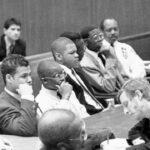 A white woman is brutally raped and beaten in New York City's Central Park. Police quickly arrest and over 12+ excruciating hours torturous badgering extract false confessions from and then charge five innocent teenage boys ranging 14-16 years of age with the brutal crime. The subsequent press spectacle and trial popularize the wholly fictional phenomenon of “wilding”, a false narrative of irredeemably feral African American super-predator youth prowling urban hell-scapes reaping destruction and misery in their wake. Law enforcement and use of the death penalty would be modified for the worse nationwide in response to this fiction. Their arrest triggered one of Donald Trump’s first forays into racism on the national stage when he took out full page ads in multiple national newspapers demanding reinstatement of the death penalty. Despite lack of any evidence beyond the duress-induced and subsequently recanted false confessions, the “Central Park Five” are convicted and sentenced to maximum security confinement. Thirteen years later DNA testing and another man’s voluntary confession prove the innocence of the “Central Park Five”, and their convictions are vacated. Learn more. A white woman is brutally raped and beaten in New York City's Central Park. Police quickly arrest and over 12+ excruciating hours torturous badgering extract false confessions from and then charge five innocent teenage boys ranging 14-16 years of age with the brutal crime. The subsequent press spectacle and trial popularize the wholly fictional phenomenon of “wilding”, a false narrative of irredeemably feral African American super-predator youth prowling urban hell-scapes reaping destruction and misery in their wake. Law enforcement and use of the death penalty would be modified for the worse nationwide in response to this fiction. Their arrest triggered one of Donald Trump’s first forays into racism on the national stage when he took out full page ads in multiple national newspapers demanding reinstatement of the death penalty. Despite lack of any evidence beyond the duress-induced and subsequently recanted false confessions, the “Central Park Five” are convicted and sentenced to maximum security confinement. Thirteen years later DNA testing and another man’s voluntary confession prove the innocence of the “Central Park Five”, and their convictions are vacated. Learn more. | |
| April 20, 1871 | 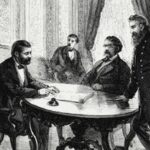 United States President Ulysses S. Grant signs into law The Enforcement Act of 1871 (17 Stat. 13), also known as the Ku Klux Klan Act, Third Enforcement Act, Third Ku Klux Klan Act, Civil Rights Act of 1871, or Force Act of 1871, which empowered the President to suspend the writ of habeas corpus to combat the Ku Klux Klan (KKK) and other white supremacy organizations. The act was the last of three Enforcement Acts passed by the United States Congress from 1870 to 1871 during the Reconstruction Era to combat attacks upon the suffrage rights of African Americans. The statute has been subject to only minor changes since then, but has been the subject of voluminous interpretation by courts. Grant had requested the act of congress just one month before as a result of widespread racial threats in the Deep South, particularly in South Carolina. After the act's passage, the president had the power for the first time to both suppress state disorders on his own initiative and to suspend the right of habeas corpus. Grant did not hesitate to use this authority on numerous occasions during his presidency, and as a result the KKK was completely dismantled (ending the "first Klan" era) and did not resurface in any meaningful way until the beginning of the 20th century. Several of the act's provisions still exist today as codified statutes. The most important of these is 42 U.S.C. § 1983: Civil action for deprivation of rights. Learn more. United States President Ulysses S. Grant signs into law The Enforcement Act of 1871 (17 Stat. 13), also known as the Ku Klux Klan Act, Third Enforcement Act, Third Ku Klux Klan Act, Civil Rights Act of 1871, or Force Act of 1871, which empowered the President to suspend the writ of habeas corpus to combat the Ku Klux Klan (KKK) and other white supremacy organizations. The act was the last of three Enforcement Acts passed by the United States Congress from 1870 to 1871 during the Reconstruction Era to combat attacks upon the suffrage rights of African Americans. The statute has been subject to only minor changes since then, but has been the subject of voluminous interpretation by courts. Grant had requested the act of congress just one month before as a result of widespread racial threats in the Deep South, particularly in South Carolina. After the act's passage, the president had the power for the first time to both suppress state disorders on his own initiative and to suspend the right of habeas corpus. Grant did not hesitate to use this authority on numerous occasions during his presidency, and as a result the KKK was completely dismantled (ending the "first Klan" era) and did not resurface in any meaningful way until the beginning of the 20th century. Several of the act's provisions still exist today as codified statutes. The most important of these is 42 U.S.C. § 1983: Civil action for deprivation of rights. Learn more. | |
| April 20, 1882 | 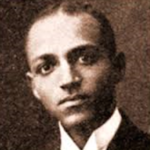 Journalist, entertainment professional, and diplomat who promoted civil rights at home and abroad, Lester Aglar Walton is born in St. Louis, Missouri. At the age of 20 in 1902, when he was hired by the St. Louis Star to be its golf writer and later its court reporter, he became the first black reporter to write for a white daily paper in St. Louis. Walton later became theatrical editor for the New York Age, the largest black newspaper in the nation at the time, and wrote for the St. Louis Globe-Democrat, the New York World, and the New York Herald Tribune. During his years with these newspapers, Walton started the movement which was eventually supported by the New York Times and the Associated Press, to have the spelling of the word “Negro” written with a capital “N. President Franklin D. Roosevelt to name Walton as Envoy and Minister to Liberia in July 1935. He served in Monrovia, the nation’s capital, until 1946. After returning to New York City, Walton served on the New York City Commission on Human Rights which focused on civil rights, civil liberties, and fair housing. Learn more. Journalist, entertainment professional, and diplomat who promoted civil rights at home and abroad, Lester Aglar Walton is born in St. Louis, Missouri. At the age of 20 in 1902, when he was hired by the St. Louis Star to be its golf writer and later its court reporter, he became the first black reporter to write for a white daily paper in St. Louis. Walton later became theatrical editor for the New York Age, the largest black newspaper in the nation at the time, and wrote for the St. Louis Globe-Democrat, the New York World, and the New York Herald Tribune. During his years with these newspapers, Walton started the movement which was eventually supported by the New York Times and the Associated Press, to have the spelling of the word “Negro” written with a capital “N. President Franklin D. Roosevelt to name Walton as Envoy and Minister to Liberia in July 1935. He served in Monrovia, the nation’s capital, until 1946. After returning to New York City, Walton served on the New York City Commission on Human Rights which focused on civil rights, civil liberties, and fair housing. Learn more. | |
| April 20, 1965 | 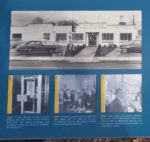 An all-white jury acquits Lester Maddox of all charges after the white man threatened three young Black seminary students at gunpoint for attempting to enter his racially-segregated Atlanta restaurant. The jury deliberated for only 47 minutes before returning its not guilty verdict, despite clear evidence of his guilt and the fact that the Civil Rights Act of 1964 expressly prohibited racial segregation of restaurants and other public accommodations. After his acquittal for threatening these Black men, Mr. Maddox capitalized on his increased notoriety and broad white support for his segregationist positions by mounting a campaign for Governor of Georgia the following year. With the KKK’s endorsement, he won. During his term in office, Mr. Maddox promoted a racist, segregationist agenda, vigorously opposed integrating Georgia public schools, and refused to permit Dr. Martin Luther King Jr. to lie in state after his April 1968 assassination. Learn more. An all-white jury acquits Lester Maddox of all charges after the white man threatened three young Black seminary students at gunpoint for attempting to enter his racially-segregated Atlanta restaurant. The jury deliberated for only 47 minutes before returning its not guilty verdict, despite clear evidence of his guilt and the fact that the Civil Rights Act of 1964 expressly prohibited racial segregation of restaurants and other public accommodations. After his acquittal for threatening these Black men, Mr. Maddox capitalized on his increased notoriety and broad white support for his segregationist positions by mounting a campaign for Governor of Georgia the following year. With the KKK’s endorsement, he won. During his term in office, Mr. Maddox promoted a racist, segregationist agenda, vigorously opposed integrating Georgia public schools, and refused to permit Dr. Martin Luther King Jr. to lie in state after his April 1968 assassination. Learn more. | |
| April 21, 1878 | 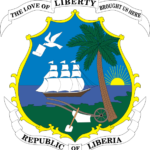 A total of 206 African Americans from Charleston, South Carolina set sail aboard the ship Azor to Liberia in what is often referred to as the Liberian Exodus. The Liberian Exodus Joint Stock Steamship Company was formed in 1877 by Blacks who wanted to emigrate to Africa due to the harsh conditions they suffered in America. The emigrants achieved success in Liberia, albeit slowly. By 1880, most had found a livelihood and did not wish to return to the United States. By 1890, the Azor's passengers were well represented among Liberia's most prominent citizens. Learn more. A total of 206 African Americans from Charleston, South Carolina set sail aboard the ship Azor to Liberia in what is often referred to as the Liberian Exodus. The Liberian Exodus Joint Stock Steamship Company was formed in 1877 by Blacks who wanted to emigrate to Africa due to the harsh conditions they suffered in America. The emigrants achieved success in Liberia, albeit slowly. By 1880, most had found a livelihood and did not wish to return to the United States. By 1890, the Azor's passengers were well represented among Liberia's most prominent citizens. Learn more. | |
| April 21, 1881 |  Master architect Julian Francis Abele is born in Philadelphia, Pennsylvania. Abele designed the Philadelphia Free Library, the Philadelphia Museum of Art, Widener Memorial Library on the Harvard University campus in Cambridge, Massachusetts, churches, mausoleums, banks, stores, school buildings, hotels, and apartments. He designed three of the buildings on the Duke University campus: the Duke University Chapel, the Cameron Indoor Stadium (one of the most revered athletic venues in the world), and the Allen Administrative Building. In all, Abele designed or helped design over 400 buildings in his career and was elected to the American Institute of Architects. Abele also worked with wood, ceramics, iron, copper, brass, precious metals, stained glass, and water colors, producing furniture, jewelry, paintings, and lithographs. Learn more. Master architect Julian Francis Abele is born in Philadelphia, Pennsylvania. Abele designed the Philadelphia Free Library, the Philadelphia Museum of Art, Widener Memorial Library on the Harvard University campus in Cambridge, Massachusetts, churches, mausoleums, banks, stores, school buildings, hotels, and apartments. He designed three of the buildings on the Duke University campus: the Duke University Chapel, the Cameron Indoor Stadium (one of the most revered athletic venues in the world), and the Allen Administrative Building. In all, Abele designed or helped design over 400 buildings in his career and was elected to the American Institute of Architects. Abele also worked with wood, ceramics, iron, copper, brass, precious metals, stained glass, and water colors, producing furniture, jewelry, paintings, and lithographs. Learn more. | |
| April 21, 1966 | 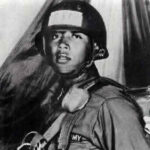 United States Army soldier Milton Lee Olive III is posthumously awarded America's highest military decoration — the Medal of Honor — for his actions in the Vietnam War. Olive joined the Army from his birth city of Chicago, Illinois in 1964, and by 1965 was serving as a Private First Class in Company B of the 2nd Battalion (Airborne), 503rd Infantry Regiment, 173rd Airborne Brigade in Vietnam. On October 22, 1965, while moving through the jungle with four fellow soldiers in Phu Cuong, Olive sacrificed his life by smothering an enemy-thrown grenade with his body. For his actions on that day, he was posthumously awarded the Medal of Honor. He was the first African-American recipient of the Medal of Honor from the Vietnam War. Learn more. United States Army soldier Milton Lee Olive III is posthumously awarded America's highest military decoration — the Medal of Honor — for his actions in the Vietnam War. Olive joined the Army from his birth city of Chicago, Illinois in 1964, and by 1965 was serving as a Private First Class in Company B of the 2nd Battalion (Airborne), 503rd Infantry Regiment, 173rd Airborne Brigade in Vietnam. On October 22, 1965, while moving through the jungle with four fellow soldiers in Phu Cuong, Olive sacrificed his life by smothering an enemy-thrown grenade with his body. For his actions on that day, he was posthumously awarded the Medal of Honor. He was the first African-American recipient of the Medal of Honor from the Vietnam War. Learn more. | |
| April 21, 2007 |  Students of Turner County High School located in Ashburn, Georgia, attended the school's first racially integrated prom. Previously, only privately-funded, separate "white" and "Black" proms sponsored by parent groups had been held. White parents still held a private, white-only prom one week before the school-wide event and some parents refused to allow their children to attend the integrated prom. Learn more. Students of Turner County High School located in Ashburn, Georgia, attended the school's first racially integrated prom. Previously, only privately-funded, separate "white" and "Black" proms sponsored by parent groups had been held. White parents still held a private, white-only prom one week before the school-wide event and some parents refused to allow their children to attend the integrated prom. Learn more. | |
| April 22, 1526 | 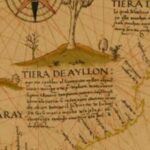 The first revolt of enslaved Africans in what is now the United States occurs in what is now South Carolina or Georgia. Although 1619 marks the start of continuous enslavement of Africans on the land of the present-day United States, the first attempt to enslave Africans within this land occurred 93 years earlier when Spanish explorers brought 100 slaves with them to the doomed settlement settlement of San Miguel de Gualdape (also referred to as "Tiera De Ayllon" or the "Land of Ayllon") in what is now South Carolina or Georgia. Within weeks of their arrival, those enslaved Africans revolted. Then they vanished. Thus the first enslaved Africans in America were also the first to revolt, initiating a pattern for numerous and regular revolts by enslaved Africans in America over the next 3 1/2 centuries, wholly contrary to the white supremacist narrative that Africans were only suited for chattel servitude and incapable of freedom. Learn more. The first revolt of enslaved Africans in what is now the United States occurs in what is now South Carolina or Georgia. Although 1619 marks the start of continuous enslavement of Africans on the land of the present-day United States, the first attempt to enslave Africans within this land occurred 93 years earlier when Spanish explorers brought 100 slaves with them to the doomed settlement settlement of San Miguel de Gualdape (also referred to as "Tiera De Ayllon" or the "Land of Ayllon") in what is now South Carolina or Georgia. Within weeks of their arrival, those enslaved Africans revolted. Then they vanished. Thus the first enslaved Africans in America were also the first to revolt, initiating a pattern for numerous and regular revolts by enslaved Africans in America over the next 3 1/2 centuries, wholly contrary to the white supremacist narrative that Africans were only suited for chattel servitude and incapable of freedom. Learn more. | |
| April 22, 1987 |  In an ignoble decision that remains the law of the land in the United States today and that should go down in history as morally akin to the Dred Scott Decision, the US Supreme Court rules 5-4 in McClesky v. Kemp that proven racial disparities are "an inevitable part of our criminal justice system" and NOT grounds for rejecting a conviction or death sentence, unless it can be shown that the demonstrated and proven bias is also proven to have occurred intentionally. In dissent, Justice William Brennan wrote that the majority was motivated to deny relief by a "fear of too much justice." In dissent, Justice William Brennan wrote that the majority was motivated to deny relief by a "fear of too much justice." The U.S. has executed more than 1,200 people since 1987, including Warren McCleskey (the petitioner) who died in the electric chair on September 26, 1991. Learn more. In an ignoble decision that remains the law of the land in the United States today and that should go down in history as morally akin to the Dred Scott Decision, the US Supreme Court rules 5-4 in McClesky v. Kemp that proven racial disparities are "an inevitable part of our criminal justice system" and NOT grounds for rejecting a conviction or death sentence, unless it can be shown that the demonstrated and proven bias is also proven to have occurred intentionally. In dissent, Justice William Brennan wrote that the majority was motivated to deny relief by a "fear of too much justice." In dissent, Justice William Brennan wrote that the majority was motivated to deny relief by a "fear of too much justice." The U.S. has executed more than 1,200 people since 1987, including Warren McCleskey (the petitioner) who died in the electric chair on September 26, 1991. Learn more. | |
| April 23, 1856 |  Prolific inventor Granville Tailer Woods, who held more than 60 patents in the U.S., is born. He was the first African American mechanical and electrical engineer after the Civil War. Self-taught, he concentrated most of his work on trains and streetcars. One of his notable inventions was a device he called the Synchronous Multiplex Railway Telegraph, a variation of induction telegraph which relied on ambient static electricity from existing telegraph lines to send messages between train stations and moving trains. His work assured a safer and better public transportation system for the cities of the United States. Woods was described as an articulate and well-spoken man, as meticulous and stylish in his choice of clothing, and as a man who preferred to dress in black. At times, he would refer to himself as an immigrant from Australia, in the belief that he would be given more respect if people thought he was from a foreign country, as opposed to being an African American. Black newspapers of the day expressed pride in his achievements, saying he was "the greatest of Negro inventors". In 1887, Woods patented the Synchronous Multiplex Railway Telegraph which allowed communications between train stations from moving trains by creating a magnetic field around a coiled wire under the train. Woods caught smallpox prior to patenting the technology and Lucius Phelps patented it in 1884. In 1887, Woods used notes, sketches and a working model of the invention to secure the patent. The invention was so successful that Woods began the Woods Electric Company in Cincinnati, Ohio to market and sell his patents. However, the company quickly became devoted to invention creation until it dissolved in 1893. Thomas Edison later filed a claim to the ownership of this patent, stating that he had first created a similar telegraph and that he was entitled to the patent for the device, and Woods often had difficulties in enjoying his success as other inventors made claims to his devices. Woods was twice successful in defending himself, proving that there were no other devices upon which he could have depended or relied upon to make his device. After Thomas Edison's second defeat, he decided to offer Granville Woods a position with the Edison Company, but Granville declined. Learn more. Prolific inventor Granville Tailer Woods, who held more than 60 patents in the U.S., is born. He was the first African American mechanical and electrical engineer after the Civil War. Self-taught, he concentrated most of his work on trains and streetcars. One of his notable inventions was a device he called the Synchronous Multiplex Railway Telegraph, a variation of induction telegraph which relied on ambient static electricity from existing telegraph lines to send messages between train stations and moving trains. His work assured a safer and better public transportation system for the cities of the United States. Woods was described as an articulate and well-spoken man, as meticulous and stylish in his choice of clothing, and as a man who preferred to dress in black. At times, he would refer to himself as an immigrant from Australia, in the belief that he would be given more respect if people thought he was from a foreign country, as opposed to being an African American. Black newspapers of the day expressed pride in his achievements, saying he was "the greatest of Negro inventors". In 1887, Woods patented the Synchronous Multiplex Railway Telegraph which allowed communications between train stations from moving trains by creating a magnetic field around a coiled wire under the train. Woods caught smallpox prior to patenting the technology and Lucius Phelps patented it in 1884. In 1887, Woods used notes, sketches and a working model of the invention to secure the patent. The invention was so successful that Woods began the Woods Electric Company in Cincinnati, Ohio to market and sell his patents. However, the company quickly became devoted to invention creation until it dissolved in 1893. Thomas Edison later filed a claim to the ownership of this patent, stating that he had first created a similar telegraph and that he was entitled to the patent for the device, and Woods often had difficulties in enjoying his success as other inventors made claims to his devices. Woods was twice successful in defending himself, proving that there were no other devices upon which he could have depended or relied upon to make his device. After Thomas Edison's second defeat, he decided to offer Granville Woods a position with the Edison Company, but Granville declined. Learn more. | |
| April 23, 1872 | 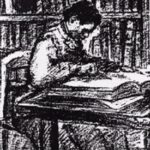 Howard University School of Law graduate Charlotte E. Ray becomes the first Black American female lawyer in the United States. She was also the first female admitted to the District of Columbia Bar, and the first woman admitted to practice before the Supreme Court of the District of Columbia. Her admission was used as a precedent by women in other states who sought admission to the bar. Ray opened her own law office. However, she practiced law for only a few years because prejudice against African Americans and women made her business unsustainable. Ray eventually moved to New York, where she became a teacher in Brooklyn. She was involved in the women's suffrage movement and joined the National Association of Colored Women. Learn more. Howard University School of Law graduate Charlotte E. Ray becomes the first Black American female lawyer in the United States. She was also the first female admitted to the District of Columbia Bar, and the first woman admitted to practice before the Supreme Court of the District of Columbia. Her admission was used as a precedent by women in other states who sought admission to the bar. Ray opened her own law office. However, she practiced law for only a few years because prejudice against African Americans and women made her business unsustainable. Ray eventually moved to New York, where she became a teacher in Brooklyn. She was involved in the women's suffrage movement and joined the National Association of Colored Women. Learn more. | |
| April 23, 1963 | 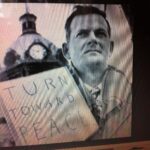 William L. Moore, postal worker and white ally in the struggle for civil rights, is assassinated while conducting a one-man march from Chattanooga, Tennessee to Jackson, Mississippi, to implore Mississippi Governor Ross Barnett to support integration efforts. Mr. Moore was shot in the head with a .22-caliber rifle that was traced to Floyd Simpson, a white Alabamian. Mr. Simpson was arrested but never indicted for Mr. Moore's murder. When activists from the Student Nonviolent Coordinating Committee (SNCC) and CORE attempted to finish Mr. Moore’s march using the same route, they were beaten and arrested by Alabama State Troopers. Learn more. William L. Moore, postal worker and white ally in the struggle for civil rights, is assassinated while conducting a one-man march from Chattanooga, Tennessee to Jackson, Mississippi, to implore Mississippi Governor Ross Barnett to support integration efforts. Mr. Moore was shot in the head with a .22-caliber rifle that was traced to Floyd Simpson, a white Alabamian. Mr. Simpson was arrested but never indicted for Mr. Moore's murder. When activists from the Student Nonviolent Coordinating Committee (SNCC) and CORE attempted to finish Mr. Moore’s march using the same route, they were beaten and arrested by Alabama State Troopers. Learn more. | |
| April 24, 1867 | 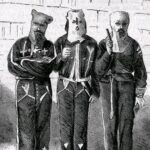 The Ku Klux Klan (the first iteration) holds its first national meeting in Nashville, Tennessee. Learn more. The Ku Klux Klan (the first iteration) holds its first national meeting in Nashville, Tennessee. Learn more. | |
| April 24, 1877 | 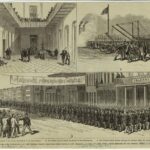 As part of a political compromise that enabled his election, President Rutherford B. Hayes withdraws federal troops from Louisiana—the last federally-occupied former Confederate state—just 12 years after the end of the Civil War. The withdrawal marked the end of Reconstruction and paved the way for the unrestrained resurgence of white supremacist rule in the South, carrying with it the rapid deterioration of political rights for Black people. Congressional efforts to provide federal protection to formerly enslaved Black people were undermined by the U.S. Supreme Court, which overturned laws that provided remedies to Black people facing violent intimidation. In the 1870s, Northern politicians began retreating from a commitment to protect Black rights and lives, culminating in the withdrawal of troops in 1877, the subsequent development and wide implementation of “Jim Crow” rule, and mass terrorizing and deprivation of rights of Black people. Learn more. As part of a political compromise that enabled his election, President Rutherford B. Hayes withdraws federal troops from Louisiana—the last federally-occupied former Confederate state—just 12 years after the end of the Civil War. The withdrawal marked the end of Reconstruction and paved the way for the unrestrained resurgence of white supremacist rule in the South, carrying with it the rapid deterioration of political rights for Black people. Congressional efforts to provide federal protection to formerly enslaved Black people were undermined by the U.S. Supreme Court, which overturned laws that provided remedies to Black people facing violent intimidation. In the 1870s, Northern politicians began retreating from a commitment to protect Black rights and lives, culminating in the withdrawal of troops in 1877, the subsequent development and wide implementation of “Jim Crow” rule, and mass terrorizing and deprivation of rights of Black people. Learn more. | |
| April 24, 1919 | 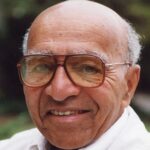 David Harold Blackwell, an American statistician and mathematician who made significant contributions to game theory, probability theory, information theory, and Bayesian statistics, is born to working class parents in Centralia, Illinois. He is one of the eponyms of the Rao–Blackwell theorem. He was the first African American inducted into the National Academy of Sciences, the first black tenured faculty member at the University of California, Berkeley, and the seventh African American to receive a Ph.D. in Mathematics. Blackwell was also a pioneer in textbook writing. He wrote one of the first Bayesian textbooks, his 1969 Basic Statistics. By the time he retired, he had published over 90 books and papers on dynamic programming, game theory, and mathematical statistics. Learn more. David Harold Blackwell, an American statistician and mathematician who made significant contributions to game theory, probability theory, information theory, and Bayesian statistics, is born to working class parents in Centralia, Illinois. He is one of the eponyms of the Rao–Blackwell theorem. He was the first African American inducted into the National Academy of Sciences, the first black tenured faculty member at the University of California, Berkeley, and the seventh African American to receive a Ph.D. in Mathematics. Blackwell was also a pioneer in textbook writing. He wrote one of the first Bayesian textbooks, his 1969 Basic Statistics. By the time he retired, he had published over 90 books and papers on dynamic programming, game theory, and mathematical statistics. Learn more. | |
| April 25, 1944 |  UNCF, the United Negro College Fund, also known as the United Fund, an American philanthropic organization that funds scholarships for Black students and general scholarship funds for 37 private historically Black colleges and universities is incorporated by Frederick D. Patterson (then president of what is now Tuskegee University), Mary McLeod Bethune, and others. Operating under the tagline, “A mind is a terrible thing to waste,”® in its 70 years of operations UNCF has raised more than $5 billion and helped more than 500,000 students and counting not just attend college, but thrive, graduate and become leaders. UNCF fulfills its mission in three ways: (1) by awarding more than 10,000 students scholarships, worth more than $100 million, each year; (2) by providing financial support to 37 historically Black colleges and universities (HBCUs); and (3) by serving as the nation’s leading advocate for the importance of minority education and community engagement. Since its founding in 1944, UNCF has helped to more than double the number of minorities attending college. The six-year graduation rate for UNCF African American scholarship recipient is 70%, 11% higher than the national average and 31% higher than the national average for all African Americans. Learn more. UNCF, the United Negro College Fund, also known as the United Fund, an American philanthropic organization that funds scholarships for Black students and general scholarship funds for 37 private historically Black colleges and universities is incorporated by Frederick D. Patterson (then president of what is now Tuskegee University), Mary McLeod Bethune, and others. Operating under the tagline, “A mind is a terrible thing to waste,”® in its 70 years of operations UNCF has raised more than $5 billion and helped more than 500,000 students and counting not just attend college, but thrive, graduate and become leaders. UNCF fulfills its mission in three ways: (1) by awarding more than 10,000 students scholarships, worth more than $100 million, each year; (2) by providing financial support to 37 historically Black colleges and universities (HBCUs); and (3) by serving as the nation’s leading advocate for the importance of minority education and community engagement. Since its founding in 1944, UNCF has helped to more than double the number of minorities attending college. The six-year graduation rate for UNCF African American scholarship recipient is 70%, 11% higher than the national average and 31% higher than the national average for all African Americans. Learn more. | |
| April 25, 1959 |  Mack Charles Parker is murdered by a a vigilante mob of eight to ten hooded and masked men, wearing gloves, in Mississippi. He had been accused of raping a pregnant white woman at gunpoint in northern Pearl River County, Mississippi. Mr. Parker vehemently denied having raped anyone, and statements from his supporters after his death suggested that the rape accusations may have been fabricated by the alleged victim as a means of concealing an ongoing consensual affair with a local white man. Additionally, while awaiting trial, Mr. Parker was subjected to several lie detector tests, all of which either indicated he was telling the truth or were inconclusive. In addition, no handgun was ever found by police, nor was one ever connected to Mr. Parker. Three days before he was to stand trial, Mr. Parker was kidnapped from his jail cell in the Pearl River County Courthouse by a mob, beaten and shot. His body was found in the Pearl River, 20 miles west of Poplarville, 10 days later. Following an investigation by the Federal Bureau of Investigation, the men who killed him were released. Despite confessions, no one was ever indicted for the killing. Historian Howard Smead called the killing the "last classic lynching in America." Learn more. Mack Charles Parker is murdered by a a vigilante mob of eight to ten hooded and masked men, wearing gloves, in Mississippi. He had been accused of raping a pregnant white woman at gunpoint in northern Pearl River County, Mississippi. Mr. Parker vehemently denied having raped anyone, and statements from his supporters after his death suggested that the rape accusations may have been fabricated by the alleged victim as a means of concealing an ongoing consensual affair with a local white man. Additionally, while awaiting trial, Mr. Parker was subjected to several lie detector tests, all of which either indicated he was telling the truth or were inconclusive. In addition, no handgun was ever found by police, nor was one ever connected to Mr. Parker. Three days before he was to stand trial, Mr. Parker was kidnapped from his jail cell in the Pearl River County Courthouse by a mob, beaten and shot. His body was found in the Pearl River, 20 miles west of Poplarville, 10 days later. Following an investigation by the Federal Bureau of Investigation, the men who killed him were released. Despite confessions, no one was ever indicted for the killing. Historian Howard Smead called the killing the "last classic lynching in America." Learn more. | |
| April 25, 1960 | 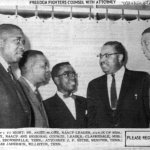 In the midst of a years long voting and civil rights struggle in Fayette County, Tennessee, the federal government is finally able to end the boycott by election officials in Fayette County, and voter registration begins again through a consent decree in United States v. Fayette County Executive Committee. Registration only opens on Wednesdays, and Black citizens are forced to stand in line for hours in high temperatures to vote, some even fainting. On the other hand, white citizens who wish to register to vote are able to show up, register, and leave within a matter of minutes. Whites and courthouse employees harass Blacks by throwing hot coffee and pepper, or spitting on them. At this point, only 1,000 of the 9,000 voting age adults have registered to vote. The organized voting and civil rights actions in Fayette County were initiated by Memphis NAACP-affiliated Attorney James F. Estesin 1958, who organized local leaders to register Blacks to vote in Fayette County. Following the initiation of these efforts, whites in Fayette County undertake a decade-plus long retaliation effort, including pressuring local businesses to refuse to sell products or services to register Blacks, evicting registered Black sharecroppers and renters from their homes and livelihoods, shutting down voter registration altogether, and other actions to starve out and punish any African American who registered to vote. Learn more. In the midst of a years long voting and civil rights struggle in Fayette County, Tennessee, the federal government is finally able to end the boycott by election officials in Fayette County, and voter registration begins again through a consent decree in United States v. Fayette County Executive Committee. Registration only opens on Wednesdays, and Black citizens are forced to stand in line for hours in high temperatures to vote, some even fainting. On the other hand, white citizens who wish to register to vote are able to show up, register, and leave within a matter of minutes. Whites and courthouse employees harass Blacks by throwing hot coffee and pepper, or spitting on them. At this point, only 1,000 of the 9,000 voting age adults have registered to vote. The organized voting and civil rights actions in Fayette County were initiated by Memphis NAACP-affiliated Attorney James F. Estesin 1958, who organized local leaders to register Blacks to vote in Fayette County. Following the initiation of these efforts, whites in Fayette County undertake a decade-plus long retaliation effort, including pressuring local businesses to refuse to sell products or services to register Blacks, evicting registered Black sharecroppers and renters from their homes and livelihoods, shutting down voter registration altogether, and other actions to starve out and punish any African American who registered to vote. Learn more. | |
| April 26, 1886 | 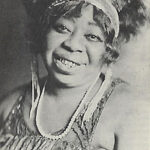 Gertrude "Ma" Rainey (née Pridgett) is born. An influential American blues singer and early blues recording artist, she was dubbed the "Mother of the Blues" and bridged earlier vaudeville and the authentic expression of southern blues, influencing a generation of blues singers. Her first recording was made in 1923. In the following five years, she made over 100 recordings, including "Bo-Weevil Blues" (1923), "Moonshine Blues" (1923), "See See Rider Blues" (1924), "Ma Rainey's Black Bottom" (1927), and "Soon This Morning" (1927). Rainey was known for her powerful vocal abilities, energetic disposition, majestic phrasing, and a "moaning" style of singing. Rainey recorded with Thomas Dorsey and Louis Armstrong, and she toured and recorded with the Georgia Jazz Band. Learn more. Gertrude "Ma" Rainey (née Pridgett) is born. An influential American blues singer and early blues recording artist, she was dubbed the "Mother of the Blues" and bridged earlier vaudeville and the authentic expression of southern blues, influencing a generation of blues singers. Her first recording was made in 1923. In the following five years, she made over 100 recordings, including "Bo-Weevil Blues" (1923), "Moonshine Blues" (1923), "See See Rider Blues" (1924), "Ma Rainey's Black Bottom" (1927), and "Soon This Morning" (1927). Rainey was known for her powerful vocal abilities, energetic disposition, majestic phrasing, and a "moaning" style of singing. Rainey recorded with Thomas Dorsey and Louis Armstrong, and she toured and recorded with the Georgia Jazz Band. Learn more. | |
| April 26, 1892 | 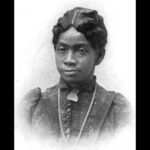 Inventor Sarah Boone obtains United States patent number 473,563 for her improvements to the ironing board. Boone's ironing board was designed to improve the quality of ironing sleeves and the bodies of women's garments. Previously, The board was very narrow, curved, and made of wood. The shape and structure allowed it to fit a sleeve and it was reversible, so one could iron both sides of the sleeve. Along with Miriam Benjamin, Ellen Eglin, and Sarah Goode, Boone was one of four African American women inventors of her time who developed new technology for the home. Learn more. Inventor Sarah Boone obtains United States patent number 473,563 for her improvements to the ironing board. Boone's ironing board was designed to improve the quality of ironing sleeves and the bodies of women's garments. Previously, The board was very narrow, curved, and made of wood. The shape and structure allowed it to fit a sleeve and it was reversible, so one could iron both sides of the sleeve. Along with Miriam Benjamin, Ellen Eglin, and Sarah Goode, Boone was one of four African American women inventors of her time who developed new technology for the home. Learn more. | |
| April 26, 1960 | 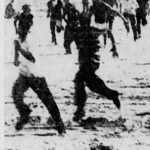 Black demonstrators engage in a locally-organized nonviolent protest and walk onto Biloxi Beach on Mississippi's Gulf Coast in order to hold a “wade-in” challenging the segregated beach area. The Black activists are met by a group of angry white people who tell them to leave the beach. When the Black people refuse to leave, the white mob attacks them with sticks, clubs, pipes, and whips while local law enforcement do nothing to intervene. When white airmen from a nearby Air Force base try to protect injured protesters, they too are attacked. Learn more. Black demonstrators engage in a locally-organized nonviolent protest and walk onto Biloxi Beach on Mississippi's Gulf Coast in order to hold a “wade-in” challenging the segregated beach area. The Black activists are met by a group of angry white people who tell them to leave the beach. When the Black people refuse to leave, the white mob attacks them with sticks, clubs, pipes, and whips while local law enforcement do nothing to intervene. When white airmen from a nearby Air Force base try to protect injured protesters, they too are attacked. Learn more. | |
| April 27, 1903 | 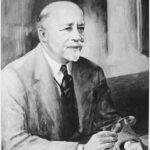 W. E. B. Du Bois publishes The Souls of Black Folk: Essays and Sketches, a seminal work in the history of sociology and a cornerstone of African-American literature. The book contains several essays on race. To develop this work, Du Bois drew from his own experiences as an African American in American society. Outside of its notable relevance in African-American history, The Souls of Black Folk also holds an important place in social science as one of the early works in the field of sociology. In the book, Du Bois used the term "double consciousness", applying it to the idea that Black people must at all times be conscious both of how they view themselves and of how the world views them. Learn more. W. E. B. Du Bois publishes The Souls of Black Folk: Essays and Sketches, a seminal work in the history of sociology and a cornerstone of African-American literature. The book contains several essays on race. To develop this work, Du Bois drew from his own experiences as an African American in American society. Outside of its notable relevance in African-American history, The Souls of Black Folk also holds an important place in social science as one of the early works in the field of sociology. In the book, Du Bois used the term "double consciousness", applying it to the idea that Black people must at all times be conscious both of how they view themselves and of how the world views them. Learn more. | |
| April 27, 1903 | 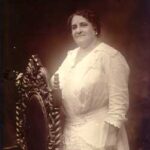 African-American businesswoman and teacher Maggie Lena Walker becomes the first African-American woman to charter a bank and serve as its president in the United States. Later Walker agreed to serve as chairman of the board of directors when the bank merged with two other Richmond banks to become The Consolidated Bank and Trust Company, which grew to serve generations of Richmonders as an African-American owned institution. As a leader, Walker achieved successes with the vision to make tangible improvements in the way of life for African Americans. Learn more. African-American businesswoman and teacher Maggie Lena Walker becomes the first African-American woman to charter a bank and serve as its president in the United States. Later Walker agreed to serve as chairman of the board of directors when the bank merged with two other Richmond banks to become The Consolidated Bank and Trust Company, which grew to serve generations of Richmonders as an African-American owned institution. As a leader, Walker achieved successes with the vision to make tangible improvements in the way of life for African Americans. Learn more. | |
| April 27, 1945 |  American playwright August Wilson is born. He has been referred to as the "theater's poet of Black America" and is best known for a series of ten plays collectively called The Pittsburgh Cycle, which chronicle the experiences and heritage of the African-American community in the 20th century. Plays in the series include, Jitney (1982), Fences (1984), Ma Rainey's Black Bottom (1984), Joe Turner's Come and Gone (1986), The Piano Lesson (1987), King Hedley II (1999). Two of his plays received the Pulitzer Prize for Drama, and two of his other works won the Tony Award for Best Play. In 2006 Wilson was inducted into the American Theater Hall of Fame. His works delve into the African American experience as well as examinations of the human condition. Other themes have ranged from the systemic and historical exploitation of African Americans, as well as race relations, identity, migration, and racial discrimination. Learn more. American playwright August Wilson is born. He has been referred to as the "theater's poet of Black America" and is best known for a series of ten plays collectively called The Pittsburgh Cycle, which chronicle the experiences and heritage of the African-American community in the 20th century. Plays in the series include, Jitney (1982), Fences (1984), Ma Rainey's Black Bottom (1984), Joe Turner's Come and Gone (1986), The Piano Lesson (1987), King Hedley II (1999). Two of his plays received the Pulitzer Prize for Drama, and two of his other works won the Tony Award for Best Play. In 2006 Wilson was inducted into the American Theater Hall of Fame. His works delve into the African American experience as well as examinations of the human condition. Other themes have ranged from the systemic and historical exploitation of African Americans, as well as race relations, identity, migration, and racial discrimination. Learn more. | |
| April 28, 1936 | 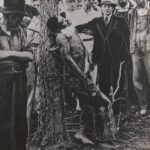 Lint Shaw, a 45-year-old Black farmer, was seized and shot to death by a mob of 40 white men in Colbert, Georgia, just eight hours before he was scheduled to stand trial on allegations of attempting to assault two white women (a common accusation of the Jim Crow era, frequently lodged on spurious or nonexistent grounds). No one was ever prosecuted for his murder. Learn more. Lint Shaw, a 45-year-old Black farmer, was seized and shot to death by a mob of 40 white men in Colbert, Georgia, just eight hours before he was scheduled to stand trial on allegations of attempting to assault two white women (a common accusation of the Jim Crow era, frequently lodged on spurious or nonexistent grounds). No one was ever prosecuted for his murder. Learn more. | |
| April 28, 1941 | 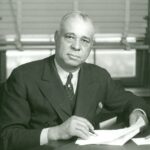 In Mitchell v. United States, a case brought by and co-argued by Congressman Arthur Mitchell (the first African American elected to Congress from Illinois as a Democrat), the United States Supreme Court unanimously rules that African Americans are entitled to equal passenger accommodations on the nation’s railroads. As later described by Congressman Mitchell, his legal victory was a “step in the destruction of Mr. Jim Crow himself.” Learn more about Congressman Mitchell and about Mitchell v. United States, here and here. In Mitchell v. United States, a case brought by and co-argued by Congressman Arthur Mitchell (the first African American elected to Congress from Illinois as a Democrat), the United States Supreme Court unanimously rules that African Americans are entitled to equal passenger accommodations on the nation’s railroads. As later described by Congressman Mitchell, his legal victory was a “step in the destruction of Mr. Jim Crow himself.” Learn more about Congressman Mitchell and about Mitchell v. United States, here and here. | |
| April 28, 1971 | 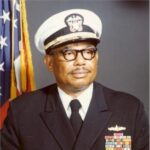 United States Navy officer Samuel Lee Gravely Jr. is promoter to rear admiral, the first African American to become a flag officer. Previously, he was the first African American in the U.S. Navy to serve aboard a fighting ship as an officer, the first to command a Navy ship, and the first fleet commander. He retired with the rank of vice admiral. Learn more. United States Navy officer Samuel Lee Gravely Jr. is promoter to rear admiral, the first African American to become a flag officer. Previously, he was the first African American in the U.S. Navy to serve aboard a fighting ship as an officer, the first to command a Navy ship, and the first fleet commander. He retired with the rank of vice admiral. Learn more. | |
| April 28, 1983 | 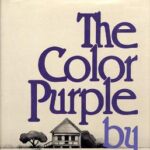 Alice Walker’s 1982 epistolary novel, The Color Purple, wins the 1983 National Book Award for Fiction. It also won the Pulitzer Prize for Fiction and was later adapted into a film and a musical for the stage. Learn more. Alice Walker’s 1982 epistolary novel, The Color Purple, wins the 1983 National Book Award for Fiction. It also won the Pulitzer Prize for Fiction and was later adapted into a film and a musical for the stage. Learn more. | |
| April 29, 1890 | African American i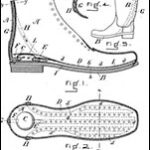 nventor Henry Faulkner patents the ventilated show, thereby providing comfort and healthy feet to the world. Prior to Faulkner's invention, lack of ventilation inside of shoes caused foot problems suffered by people worldwide. Faulkner devised a method for placing holes in specific locations within the shoe, thus allowing for adequate circulation and greater comfort. Learn more. nventor Henry Faulkner patents the ventilated show, thereby providing comfort and healthy feet to the world. Prior to Faulkner's invention, lack of ventilation inside of shoes caused foot problems suffered by people worldwide. Faulkner devised a method for placing holes in specific locations within the shoe, thus allowing for adequate circulation and greater comfort. Learn more. | |
| April 29, 1947 |  American Pulitzer Prize-winning poet and professor Yusef Komunyakaa, original name in full James William Brown, Jr., is born in Bogalusa, Louisiana. Professor Komunyakaa is known for his autobiographical poems about race, the Vietnam War, and jazz and blues, including the Pulitzer Prize-winning collection of poems Neon Vernacular: New & Selected Poems 1977–1989 (1993). From 1999 to 2005 Komunyakaa was chancellor of the Academy of American Poets, and in 2006 he became Distinguished Senior Poet (later global Distinguished Professor of English) in the creative writing program at New York University. In addition to teaching and writing, Komunyakaa collaborated on several musical projects: with composer T.J. Anderson, he wrote librettos for the operas Slip Knot (2003), based on the historical testament of an enslaved African American man wrongly hanged for raping a white woman, and The Reincarnated Beethoven, based on a newspaper article about the self-image of a black teenager, among others. Learn more. American Pulitzer Prize-winning poet and professor Yusef Komunyakaa, original name in full James William Brown, Jr., is born in Bogalusa, Louisiana. Professor Komunyakaa is known for his autobiographical poems about race, the Vietnam War, and jazz and blues, including the Pulitzer Prize-winning collection of poems Neon Vernacular: New & Selected Poems 1977–1989 (1993). From 1999 to 2005 Komunyakaa was chancellor of the Academy of American Poets, and in 2006 he became Distinguished Senior Poet (later global Distinguished Professor of English) in the creative writing program at New York University. In addition to teaching and writing, Komunyakaa collaborated on several musical projects: with composer T.J. Anderson, he wrote librettos for the operas Slip Knot (2003), based on the historical testament of an enslaved African American man wrongly hanged for raping a white woman, and The Reincarnated Beethoven, based on a newspaper article about the self-image of a black teenager, among others. Learn more. | |
| April 29, 1992 |  An all-white jury in Los Angeles chose to acquit three of the four officers who beat Rodney King during a violent arrest in March of 1991, and could not agree on a verdict for the fourth officer, despite video evidence establishing their culpability. Learn more. An all-white jury in Los Angeles chose to acquit three of the four officers who beat Rodney King during a violent arrest in March of 1991, and could not agree on a verdict for the fourth officer, despite video evidence establishing their culpability. Learn more. | |
| April 30, 1863 | 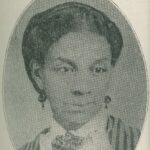 Educator and suffragist Sarah J. Tompkins Garnet (née Smith) becomes the first African-American female school principal in the New York City public school system. Sarah began teaching at the segregated African Free School of Williamsburg in 1854, later taking over as principal of Grammar School Number 4. She taught many prominent students, including musician Walter F. Craig. She served as teacher and principal for 37 years. Learn more. Educator and suffragist Sarah J. Tompkins Garnet (née Smith) becomes the first African-American female school principal in the New York City public school system. Sarah began teaching at the segregated African Free School of Williamsburg in 1854, later taking over as principal of Grammar School Number 4. She taught many prominent students, including musician Walter F. Craig. She served as teacher and principal for 37 years. Learn more. | |
| April 30, 1892 |  A white mob lynches Ephraim Grizzard in Nashville, Tennessee, just days after the lynching of his brother, Henry. In the middle of the afternoon, the unmasked mob dragged Ephraim Grizzard from the Nashville jail, stripped him naked, beat and stabbed him severely, and then hanged him from the Woodland Street Bridge. As Mr. Grizzard’s corpse swayed in the air, members of the mob riddled his body with bullets. Thousands of spectators viewed the brutal scene as Mr. Grizzard’s mutilated body was reportedly left on display for almost 90 minutes. Four or five black men, including Mr. Grizzard and his brothers Henry and John, had been arrested on April 27 in response to the nonspecific allegations of two white girls that Black men had assaulted them. Ephraim and Henry were murdered before ever having been specifically identified, investigated, or tried. Despite the bold, public nature of both lynchings, no one was held accountable for either of the brothers’ deaths. Learn more. A white mob lynches Ephraim Grizzard in Nashville, Tennessee, just days after the lynching of his brother, Henry. In the middle of the afternoon, the unmasked mob dragged Ephraim Grizzard from the Nashville jail, stripped him naked, beat and stabbed him severely, and then hanged him from the Woodland Street Bridge. As Mr. Grizzard’s corpse swayed in the air, members of the mob riddled his body with bullets. Thousands of spectators viewed the brutal scene as Mr. Grizzard’s mutilated body was reportedly left on display for almost 90 minutes. Four or five black men, including Mr. Grizzard and his brothers Henry and John, had been arrested on April 27 in response to the nonspecific allegations of two white girls that Black men had assaulted them. Ephraim and Henry were murdered before ever having been specifically identified, investigated, or tried. Despite the bold, public nature of both lynchings, no one was held accountable for either of the brothers’ deaths. Learn more. | |
| April 30, 1920 | 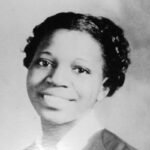 Community organizer and relentlessly energetic children's health advocate Odessa Brown is born. Brown was a staunch supporter of a health care facility for children in the Central Area. She worked tirelessly in this mostly African American neighborhood to make residents aware of the health needs of the area and to express these needs to the planners at Seattle Model Cities, a federally-funded anti-poverty agency. Her efforts persuaded Seattle Model Cities to develop a children’s clinic to serve the city’s Central District. She died before the clinic opened its doors in 1970, and it was named the Odessa Brown Children’s Clinic in her memory. Learn more. Community organizer and relentlessly energetic children's health advocate Odessa Brown is born. Brown was a staunch supporter of a health care facility for children in the Central Area. She worked tirelessly in this mostly African American neighborhood to make residents aware of the health needs of the area and to express these needs to the planners at Seattle Model Cities, a federally-funded anti-poverty agency. Her efforts persuaded Seattle Model Cities to develop a children’s clinic to serve the city’s Central District. She died before the clinic opened its doors in 1970, and it was named the Odessa Brown Children’s Clinic in her memory. Learn more. | |
| April 30, 1983 | 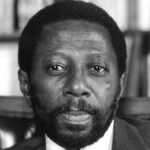 American journalist, newspaper publisher, and editor Robert C. Maynard becomes the first African American to gain a controlling interest in a major metropolitan newspaper when he purchases the The Oakland Tribune from Gannett. He is widely recognized for turning around the then struggling newspaper and transforming it into a 1990 Pulitzer Prize-winning journal. Maynard was friends with influential New York writers James Baldwin and Langston Hughes, and was also co-founder of the Robert C. Maynard Institute for Journalism Education in Oakland, California. Learn more. American journalist, newspaper publisher, and editor Robert C. Maynard becomes the first African American to gain a controlling interest in a major metropolitan newspaper when he purchases the The Oakland Tribune from Gannett. He is widely recognized for turning around the then struggling newspaper and transforming it into a 1990 Pulitzer Prize-winning journal. Maynard was friends with influential New York writers James Baldwin and Langston Hughes, and was also co-founder of the Robert C. Maynard Institute for Journalism Education in Oakland, California. Learn more. | |
| May 1, 1863 | 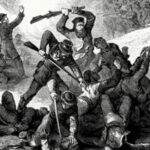 By a joint resolution adopted by the Confederate Congress and signed by Confederate President Jefferson Davis, the Confederacy authorizes enslavement or execution of Black union troops captured in the Civil War. The barbaric policy states that “negroes or mulattoes, slave or free, taken in arms should be turned over to the authorities in the state in which they were captured and that their officers would be tried by Confederate military tribunals for inciting insurrection and be subject, at the discretion of the court and the president, to the death penalty." Learn more. By a joint resolution adopted by the Confederate Congress and signed by Confederate President Jefferson Davis, the Confederacy authorizes enslavement or execution of Black union troops captured in the Civil War. The barbaric policy states that “negroes or mulattoes, slave or free, taken in arms should be turned over to the authorities in the state in which they were captured and that their officers would be tried by Confederate military tribunals for inciting insurrection and be subject, at the discretion of the court and the president, to the death penalty." Learn more. | |
| May 1, 1865 | 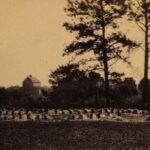 Over 10,000 formerly enslaved African Americans establish the precedent for our modern observance of Memorial Day when they march onto the former Washington Race Course in Charleston, South Carolina, which had been turned into a prison camp for Union Soldiers, in order to commemorate the hundreds of soldiers who had died on those grounds. The African American freedman had worked in the previous weeks burying the bodies of the soldiers. They also cleaned up the grounds while creating an enclosure and an arch that stated “Martyrs of the Race Course”. The day, which was called “Decoration Day,” was attended by the freedman, teachers, missionaries and members of the National Print Press. The marchers brought flowers, sang songs, prayed, listened to sermons and later had picnics. Over 10,000 formerly enslaved African Americans establish the precedent for our modern observance of Memorial Day when they march onto the former Washington Race Course in Charleston, South Carolina, which had been turned into a prison camp for Union Soldiers, in order to commemorate the hundreds of soldiers who had died on those grounds. The African American freedman had worked in the previous weeks burying the bodies of the soldiers. They also cleaned up the grounds while creating an enclosure and an arch that stated “Martyrs of the Race Course”. The day, which was called “Decoration Day,” was attended by the freedman, teachers, missionaries and members of the National Print Press. The marchers brought flowers, sang songs, prayed, listened to sermons and later had picnics. | |
| May 1, 1946 | 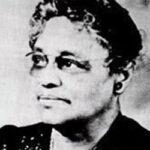 African American theological educator Emma Clarissa Williams is named American Mother-of-the-Year, the first Black woman to hold such an honor. Clement accepted the award “in the name of millions of Negroes in the United States and in the name of all mothers.” After her husbands death, Clement raised alone her four sons and three daughters, all of whom graduated college, four who became college professors, including her son Rufus E. Clement who served as president of Atlanta University. Learn more. African American theological educator Emma Clarissa Williams is named American Mother-of-the-Year, the first Black woman to hold such an honor. Clement accepted the award “in the name of millions of Negroes in the United States and in the name of all mothers.” After her husbands death, Clement raised alone her four sons and three daughters, all of whom graduated college, four who became college professors, including her son Rufus E. Clement who served as president of Atlanta University. Learn more. | |
| May 1, 1950 | 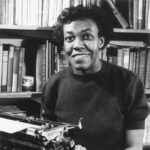 American poet, author, and teacher Gwendolyn Elizabeth Brooks wins the Pulitzer Prize for Poetry for Annie Allen, making her the first African American to receive a Pulitzer Prize. Her work often dealt with the personal celebrations and struggles of ordinary people in her community. Throughout her prolific writing career, Brooks received many more honors. A lifelong resident of Chicago, she was appointed Poet Laureate of Illinois in 1968, a position she held until her death 32 years later. She was also named the Poet Laureate Consultant in Poetry to the Library of Congress for the 1985–86 term. In 1976, she became the first African-American woman inducted into the American Academy of Arts and Letters. Learn more. American poet, author, and teacher Gwendolyn Elizabeth Brooks wins the Pulitzer Prize for Poetry for Annie Allen, making her the first African American to receive a Pulitzer Prize. Her work often dealt with the personal celebrations and struggles of ordinary people in her community. Throughout her prolific writing career, Brooks received many more honors. A lifelong resident of Chicago, she was appointed Poet Laureate of Illinois in 1968, a position she held until her death 32 years later. She was also named the Poet Laureate Consultant in Poetry to the Library of Congress for the 1985–86 term. In 1976, she became the first African-American woman inducted into the American Academy of Arts and Letters. Learn more. | |
| May 2, 1762 | 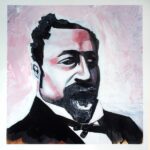 James Derham, the first African American to become a physician in the United States, is born into slavery in Philadelphia. As a child, Derham was transferred to Dr. John Kearsley Jr. under whom Derham studied medicine. Upon Dr. Kearsley’s death, Derham, then fifteen years old, was held in bondage by several different individuals, including Dr. George West, a surgeon for a British regiment during the American Revolutionary War. before being finally being held by New Orleans doctor Robert Dow in whose prescribe Derham assisted. Derham subsequently gained his emancipation and opened his own medical practice in New Orleans. In 1788, Derham and Dr. Benjamin Rush (a signer of the Declaration of Independence) met in Philadelphia, and corresponded with one another for twelve years. Learn more. James Derham, the first African American to become a physician in the United States, is born into slavery in Philadelphia. As a child, Derham was transferred to Dr. John Kearsley Jr. under whom Derham studied medicine. Upon Dr. Kearsley’s death, Derham, then fifteen years old, was held in bondage by several different individuals, including Dr. George West, a surgeon for a British regiment during the American Revolutionary War. before being finally being held by New Orleans doctor Robert Dow in whose prescribe Derham assisted. Derham subsequently gained his emancipation and opened his own medical practice in New Orleans. In 1788, Derham and Dr. Benjamin Rush (a signer of the Declaration of Independence) met in Philadelphia, and corresponded with one another for twelve years. Learn more. | |
| May 2, 1844 | 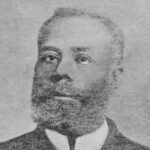 Elijah McCoy, a Black American inventor who received more than 50 patents for his inventions during his lifetime, is born. His most famous invention was a cup that feeds lubricating oil to machine bearings through a small tube. Machinists and engineers who wanted genuine McCoy lubricators might have used the expression "the real McCoy"—a term meaning "the real deal" or "the genuine article." Learn more. Elijah McCoy, a Black American inventor who received more than 50 patents for his inventions during his lifetime, is born. His most famous invention was a cup that feeds lubricating oil to machine bearings through a small tube. Machinists and engineers who wanted genuine McCoy lubricators might have used the expression "the real McCoy"—a term meaning "the real deal" or "the genuine article." Learn more. | |
| May 2, 1963 | 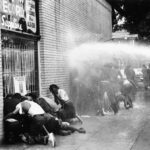 More than 700 Black children peacefully protest racial segregation in Birmingham, Alabama, as part of the Children's Crusade, beginning a movement that sparks widely-publicized police brutality that shocks the nation and spurs major civil rights advances. As part of that effort, more than 1,000 African American children trained in nonviolent protest tactics walked out of their classes on May 2 and assembled at the Sixteenth Street Baptist Church to march to downtown Birmingham. Though hundreds were assaulted, arrested, and transported to jail in school buses and paddy wagons, the children refused to relent their peaceful demonstration. Learn more. More than 700 Black children peacefully protest racial segregation in Birmingham, Alabama, as part of the Children's Crusade, beginning a movement that sparks widely-publicized police brutality that shocks the nation and spurs major civil rights advances. As part of that effort, more than 1,000 African American children trained in nonviolent protest tactics walked out of their classes on May 2 and assembled at the Sixteenth Street Baptist Church to march to downtown Birmingham. Though hundreds were assaulted, arrested, and transported to jail in school buses and paddy wagons, the children refused to relent their peaceful demonstration. Learn more. | |
| May 3, 1866 | 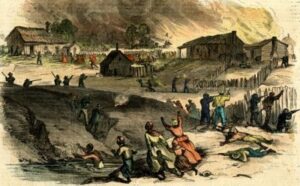 As the day ends, Federal troops finally quell the Memphis Massacre that had begun two days before (on May 1) in Memphis, Tennessee. For three days white residents and policemen rampaged through Black neighbourhoods and the houses of freedmen, attacking and killing Black Union soldiers and civilians and committing many acts of robbery and arson. Blacks suffered most of the injuries and deaths by far: 46 Black and 2 white people were killed, 75 Black people were injured, over 100 were Black persons robbed, 5 Black women were raped, and 91 homes, 4 churches and 8 schools (every Black church and school) were burned in the Black community. Many Black people fled the city permanently; by 1870, their population had fallen by one quarter compared to 1865. Among the causes attributed for the massacre was the desire of white plantation owners to drive Freedmen out of Memphis and back to laboring on cotton plantations, with the violence intended to enforce white supremacist social order after the end of slavery. Learn more. As the day ends, Federal troops finally quell the Memphis Massacre that had begun two days before (on May 1) in Memphis, Tennessee. For three days white residents and policemen rampaged through Black neighbourhoods and the houses of freedmen, attacking and killing Black Union soldiers and civilians and committing many acts of robbery and arson. Blacks suffered most of the injuries and deaths by far: 46 Black and 2 white people were killed, 75 Black people were injured, over 100 were Black persons robbed, 5 Black women were raped, and 91 homes, 4 churches and 8 schools (every Black church and school) were burned in the Black community. Many Black people fled the city permanently; by 1870, their population had fallen by one quarter compared to 1865. Among the causes attributed for the massacre was the desire of white plantation owners to drive Freedmen out of Memphis and back to laboring on cotton plantations, with the violence intended to enforce white supremacist social order after the end of slavery. Learn more. | |
| May 3, 1913 | 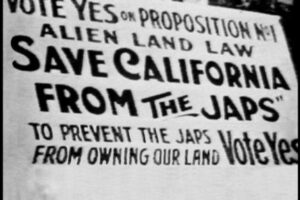 California enacts the Alien Land Law, barring Asian immigrants from owning land. California tightened the law further in 1920 and 1923, barring the leasing of land and land ownership by American-born children of Asian immigrant parents or by corporations controlled by Asian immigrants. These laws were supported by the California press, as well as the Hollywood Association, Japanese and Korean (later Asiatic) Exclusion League and the Anti-Jap Laundry League (both founded by labor unions). Combined, these groups claimed tens of thousands of members. Learn more. California enacts the Alien Land Law, barring Asian immigrants from owning land. California tightened the law further in 1920 and 1923, barring the leasing of land and land ownership by American-born children of Asian immigrant parents or by corporations controlled by Asian immigrants. These laws were supported by the California press, as well as the Hollywood Association, Japanese and Korean (later Asiatic) Exclusion League and the Anti-Jap Laundry League (both founded by labor unions). Combined, these groups claimed tens of thousands of members. Learn more. | |
| May 3, 1948 | 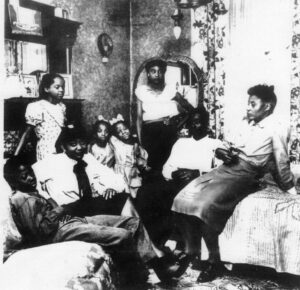 The United States Supreme Court issues its landmark decision in Shelley v. Kraemer, 334 U.S. 1 (1948), striking down racially restrictive housing covenants. The case arose after an African-American family purchased a house in St. Louis that was subject to a restrictive covenant preventing "people of the Negro or Mongolian Race" from occupying the property. The purchase was challenged in court by a neighboring resident, and was blocked by the Supreme Court of Missouri before going to the U.S. Supreme Court on appeal. In a majority opinion that was joined by the other five participating justices, U.S. Supreme Court Chief Justice Fred Vinson struck down the covenant, holding that the Fourteenth Amendment's Equal Protection Clause prohibits racially restrictive housing covenants from being enforced. Vinson held that private parties could abide by the terms of a racially restrictive covenant, but that judicial enforcement of the covenant qualified as a state action and was thus prohibited by the Equal Protection Clause. Learn more. The United States Supreme Court issues its landmark decision in Shelley v. Kraemer, 334 U.S. 1 (1948), striking down racially restrictive housing covenants. The case arose after an African-American family purchased a house in St. Louis that was subject to a restrictive covenant preventing "people of the Negro or Mongolian Race" from occupying the property. The purchase was challenged in court by a neighboring resident, and was blocked by the Supreme Court of Missouri before going to the U.S. Supreme Court on appeal. In a majority opinion that was joined by the other five participating justices, U.S. Supreme Court Chief Justice Fred Vinson struck down the covenant, holding that the Fourteenth Amendment's Equal Protection Clause prohibits racially restrictive housing covenants from being enforced. Vinson held that private parties could abide by the terms of a racially restrictive covenant, but that judicial enforcement of the covenant qualified as a state action and was thus prohibited by the Equal Protection Clause. Learn more. | |
| May 4, 1897 |  African American scientist and inventor Joseph H. Smith patents the lawn sprinkler, U.S. patent number 581,785. Later Smith would patent an improvement on the original design. Learn more. African American scientist and inventor Joseph H. Smith patents the lawn sprinkler, U.S. patent number 581,785. Later Smith would patent an improvement on the original design. Learn more. | |
| May 4, 1905 | 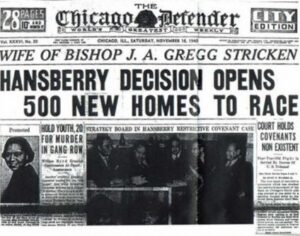 Robert S. Abbott founds and begins publishing The Chicago Defender, a Chicago-based African-American newspaper that at one time is considered the "most important" newspaper of its kind. The newspaper reported and campaigned against Jim Crow era violence and urged Black people in the American South to come north in what became the Great Migration. Abbott worked out an informal distribution system with Pullman porters who surreptitiously (and sometimes against southern state laws and mores) took his paper by rail far beyond Chicago, especially to African American readers in the Southern United States. Under his nephew and chosen successor, John H. Sengstacke, the paper took on segregation, especially in the U.S. military, during World War II. Copies of the paper were passed along in communities, and it is estimated that at its most successful, each copy made its way into the hands of four out of five African-Americans. Over its century-plus history, Langston Hughes, Washington D.C and international correspondent Ethel Payne, poet Gwendolyn Brooks, author Willard Motley, journalists Ida B. Wells, L. Alex Wilson, and Louis Lomax all wrote for the paper at different times. Learn more. Robert S. Abbott founds and begins publishing The Chicago Defender, a Chicago-based African-American newspaper that at one time is considered the "most important" newspaper of its kind. The newspaper reported and campaigned against Jim Crow era violence and urged Black people in the American South to come north in what became the Great Migration. Abbott worked out an informal distribution system with Pullman porters who surreptitiously (and sometimes against southern state laws and mores) took his paper by rail far beyond Chicago, especially to African American readers in the Southern United States. Under his nephew and chosen successor, John H. Sengstacke, the paper took on segregation, especially in the U.S. military, during World War II. Copies of the paper were passed along in communities, and it is estimated that at its most successful, each copy made its way into the hands of four out of five African-Americans. Over its century-plus history, Langston Hughes, Washington D.C and international correspondent Ethel Payne, poet Gwendolyn Brooks, author Willard Motley, journalists Ida B. Wells, L. Alex Wilson, and Louis Lomax all wrote for the paper at different times. Learn more. | |
| May 4, 1921 | 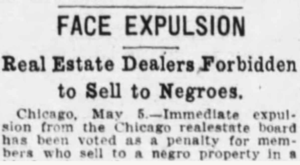 The Chicago Real Estate Board votes unanimously to expel members from the board who sold property to Black families in neighborhoods where white people lived. The president of the board, M. L. Smith, openly expressed his commitment to maintaining segregation throughout Chicago and advocated for a plan to exclude Black families from most of Chicago’s available housing. Within a decade, close to 90% of Chicago neighborhoods were covered by covenants restricting access for Black people. White real estate associations, homeowners, and politicians in Chicago remained committed to residential segregation well into the later half of the twentieth century. Learn more. The Chicago Real Estate Board votes unanimously to expel members from the board who sold property to Black families in neighborhoods where white people lived. The president of the board, M. L. Smith, openly expressed his commitment to maintaining segregation throughout Chicago and advocated for a plan to exclude Black families from most of Chicago’s available housing. Within a decade, close to 90% of Chicago neighborhoods were covered by covenants restricting access for Black people. White real estate associations, homeowners, and politicians in Chicago remained committed to residential segregation well into the later half of the twentieth century. Learn more. | |
| May 4, 1961 | 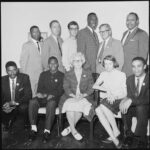 The first thirteen Freedom Riders depart Washington, D.C. (scheduled to arrive in New Orleans on May 17) on an interstate bus trip through the segregated southern United States to challenge the non-enforcement of the United States Supreme Court decisions banning segregated public buses. The Freedom Riders confronted the segregated status quo by riding interstate buses in the South in mixed racial groups to challenge local laws or customs that enforced segregation in seating. The Freedom Rides, and the violent reactions they provoked, bolstered the credibility of the American Civil Rights Movement. They called national attention to the disregard for the federal law and the local violence used to enforce segregation in the southern United States. Police arrested riders for trespassing, unlawful assembly, violating state and local Jim Crow laws, and other alleged offenses, but often coordinated with local Ku Klux Klan chapters to first allow white mobs to violently attack the Riders without intervention. Learn more. The first thirteen Freedom Riders depart Washington, D.C. (scheduled to arrive in New Orleans on May 17) on an interstate bus trip through the segregated southern United States to challenge the non-enforcement of the United States Supreme Court decisions banning segregated public buses. The Freedom Riders confronted the segregated status quo by riding interstate buses in the South in mixed racial groups to challenge local laws or customs that enforced segregation in seating. The Freedom Rides, and the violent reactions they provoked, bolstered the credibility of the American Civil Rights Movement. They called national attention to the disregard for the federal law and the local violence used to enforce segregation in the southern United States. Police arrested riders for trespassing, unlawful assembly, violating state and local Jim Crow laws, and other alleged offenses, but often coordinated with local Ku Klux Klan chapters to first allow white mobs to violently attack the Riders without intervention. Learn more. | |
| May 5, 1864 | 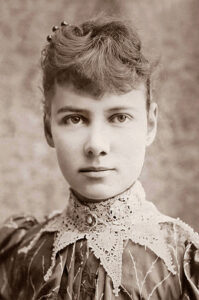 American journalist, industrialist, inventor, and charity worker Elizabeth Cochrane Seaman, better known by her pen name Nellie Bly, is born. Bly became widely known for her record-breaking trip around the world in 72 days, in emulation of Jules Verne's fictional character Phileas Fogg, and an exposé in which she worked undercover to report on a mental institution from within. She pioneered a new kind of investigative journalism. Learn more. American journalist, industrialist, inventor, and charity worker Elizabeth Cochrane Seaman, better known by her pen name Nellie Bly, is born. Bly became widely known for her record-breaking trip around the world in 72 days, in emulation of Jules Verne's fictional character Phileas Fogg, and an exposé in which she worked undercover to report on a mental institution from within. She pioneered a new kind of investigative journalism. Learn more. | |
| May 5, 1865 | 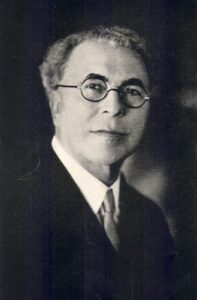 Adam Clayton Powell, an American pastor, community activist, author, and the father of Congressman Adam Clayton Powell Jr., is born into poverty in southwestern Virginia. Powell worked to put himself through school and Wayland Seminary, where he was ordained in 1892. After serving in churches in Philadelphia, Pennsylvania and New Haven, Connecticut, Powell was called as pastor to the Abyssinian Baptist Church in Harlem, New York. From 1908 to 1936, he developed the church into the largest Protestant congregation in the country, with 10,000 members. During the Great Migration out of the rural South, thousands of African Americans moved to New York and Harlem became the center of African-American life in the city. During his tenure, Powell supervised the purchase of land, fundraising, and the construction of a much larger church and facilities. He was a founder of the National Urban League, active in the NAACP and several fraternal organizations, and served as trustee of several historically black colleges and schools. Learn more. Adam Clayton Powell, an American pastor, community activist, author, and the father of Congressman Adam Clayton Powell Jr., is born into poverty in southwestern Virginia. Powell worked to put himself through school and Wayland Seminary, where he was ordained in 1892. After serving in churches in Philadelphia, Pennsylvania and New Haven, Connecticut, Powell was called as pastor to the Abyssinian Baptist Church in Harlem, New York. From 1908 to 1936, he developed the church into the largest Protestant congregation in the country, with 10,000 members. During the Great Migration out of the rural South, thousands of African Americans moved to New York and Harlem became the center of African-American life in the city. During his tenure, Powell supervised the purchase of land, fundraising, and the construction of a much larger church and facilities. He was a founder of the National Urban League, active in the NAACP and several fraternal organizations, and served as trustee of several historically black colleges and schools. Learn more. | |
| May 5, 1908 | 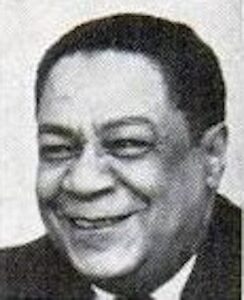 Clinton Everett Knox is born in Silver Springs, Maryland. Knox became the first African American secretary to the United States Mission to the North Atlantic Treaty Organization (NATO). He also served as U.S. Ambassador to the West African Republic of Dahomey (now the country of Benin) and as U.S. Ambassador to Haiti. While serving in Haiti, Ambassador Knox and Consul General Ward L. Christensen were held hostage for almost 20 hours on January 24, 1973, until they were released in exchange for the release of 12 Haitian prisoners, safe conduct to Mexico, and a ransom of $70,000. Learn more. Clinton Everett Knox is born in Silver Springs, Maryland. Knox became the first African American secretary to the United States Mission to the North Atlantic Treaty Organization (NATO). He also served as U.S. Ambassador to the West African Republic of Dahomey (now the country of Benin) and as U.S. Ambassador to Haiti. While serving in Haiti, Ambassador Knox and Consul General Ward L. Christensen were held hostage for almost 20 hours on January 24, 1973, until they were released in exchange for the release of 12 Haitian prisoners, safe conduct to Mexico, and a ransom of $70,000. Learn more. | |
| May 5, 1969 | 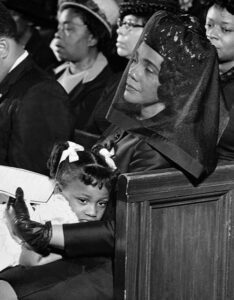 Moneta J. Sleet Jr. is awarded the Pulitzer Prize for Feature Photography for his photograph of Coretta Scott King, Martin Luther King Jr.'s widow, at her husband's funeral. An American press photographer, Sleet is best known for his work as a staff photographer for Ebony magazine. Learn more. Moneta J. Sleet Jr. is awarded the Pulitzer Prize for Feature Photography for his photograph of Coretta Scott King, Martin Luther King Jr.'s widow, at her husband's funeral. An American press photographer, Sleet is best known for his work as a staff photographer for Ebony magazine. Learn more. | |
| May 6, 1812 | 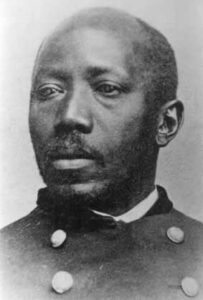 African-American abolitionist, journalist, physician, soldier, and writer, and arguably the first proponent of black nationalism, Martin Robison Delany is born. Delany is credited with the Pan-African slogan of "Africa for Africans." Born a free person of color, Delany trained as a physician's assistant. In 1850, Delany was one of the first three black men admitted to Harvard Medical School, but all were dismissed after a few weeks because of widespread protests by white students. Beginning in 1847, Delaney worked alongside Frederick Douglass in Rochester, New York to publish the North Star. When the United States Colored Troops were created in 1863, he recruited for them. Commissioned as a major in February 1865, Delany became the first African-American field grade officer in the United States Army. Learn more. African-American abolitionist, journalist, physician, soldier, and writer, and arguably the first proponent of black nationalism, Martin Robison Delany is born. Delany is credited with the Pan-African slogan of "Africa for Africans." Born a free person of color, Delany trained as a physician's assistant. In 1850, Delany was one of the first three black men admitted to Harvard Medical School, but all were dismissed after a few weeks because of widespread protests by white students. Beginning in 1847, Delaney worked alongside Frederick Douglass in Rochester, New York to publish the North Star. When the United States Colored Troops were created in 1863, he recruited for them. Commissioned as a major in February 1865, Delany became the first African-American field grade officer in the United States Army. Learn more. | |
| May 6, 1882 | 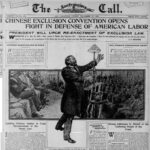 President Chester A. Arthur signs into law the Chinese Exclusion Act. The first major law restricting voluntary immigration to the U.S., the act banned all immigrants from China for 10 years, prohibited Chinese immigrants from becoming American citizens, and restricted the entry and re-entry of Chinese nationals. Learn more. President Chester A. Arthur signs into law the Chinese Exclusion Act. The first major law restricting voluntary immigration to the U.S., the act banned all immigrants from China for 10 years, prohibited Chinese immigrants from becoming American citizens, and restricted the entry and re-entry of Chinese nationals. Learn more. | |
| May 6, 1937 | 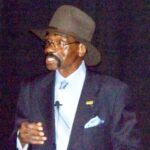 Rubin "Hurricane" Carter is born. In 1967, Carter, an American-Canadian middleweight boxer, was wrongfully convicted of murder in New Jersey and sentenced to life in prison. He was later released following a petition of habeas corpus after serving almost 20 years in prison. Carter's autobiography, titled The Sixteenth Round, written while he was in prison, was published in 1974 by Viking Press. The story inspired the 1975 Bob Dylan song "Hurricane" and the 1999 film The Hurricane (with Denzel Washington playing Carter). From 1993 to 2005, Carter served as executive director of the Association in Defence of the Wrongly Convicted (later rebranded as Innocence Canada). Learn more. Rubin "Hurricane" Carter is born. In 1967, Carter, an American-Canadian middleweight boxer, was wrongfully convicted of murder in New Jersey and sentenced to life in prison. He was later released following a petition of habeas corpus after serving almost 20 years in prison. Carter's autobiography, titled The Sixteenth Round, written while he was in prison, was published in 1974 by Viking Press. The story inspired the 1975 Bob Dylan song "Hurricane" and the 1999 film The Hurricane (with Denzel Washington playing Carter). From 1993 to 2005, Carter served as executive director of the Association in Defence of the Wrongly Convicted (later rebranded as Innocence Canada). Learn more. | |
| May 6, 1960 | 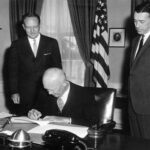 President Dwight D. Eisenhower signs The Civil Rights Act of 1960 (Pub.L. 86–449, 74 Stat. 89, into law. The Act establishes federal inspection of local voter registration polls and introduces penalties for anyone who obstructs someone's attempt to register to vote. It was designed to deal with discriminatory laws and practices in the segregated South, by which blacks and Mexican Texans had been effectively disenfranchised since the late 19th and start of the 20th century. It extended the life of the Civil Rights Commission, previously limited to two years, to oversee registration and voting practices. Learn more. President Dwight D. Eisenhower signs The Civil Rights Act of 1960 (Pub.L. 86–449, 74 Stat. 89, into law. The Act establishes federal inspection of local voter registration polls and introduces penalties for anyone who obstructs someone's attempt to register to vote. It was designed to deal with discriminatory laws and practices in the segregated South, by which blacks and Mexican Texans had been effectively disenfranchised since the late 19th and start of the 20th century. It extended the life of the Civil Rights Commission, previously limited to two years, to oversee registration and voting practices. Learn more. | |
| May 7, 1839 | 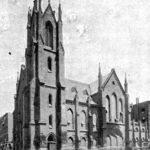 Andrew Harris, just one year after graduating from the University of Vermont, delivers an address to nearly five thousand abolitionists at New York City’s Broadway Tabernacle, arguing that slavery in the South influences racism in the North. Harris is particularly mindful of his own situation, having been denied admission to Union and Middlebury Colleges because of his race. Read the full text Harris’s brief but powerful speech. Andrew Harris, just one year after graduating from the University of Vermont, delivers an address to nearly five thousand abolitionists at New York City’s Broadway Tabernacle, arguing that slavery in the South influences racism in the North. Harris is particularly mindful of his own situation, having been denied admission to Union and Middlebury Colleges because of his race. Read the full text Harris’s brief but powerful speech. | |
| May 7, 1867 | 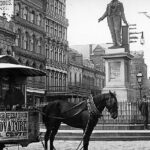 After 9 days of mass sit-ins by African Americans on “whites-only” horse-drawn street cars bring transit in New Orleans to a standstill, city officials and the chief of police order the desegregation of the city’s streetcars. “Have no interference with negroes riding in cars of any kind,” the chief instructed his officers. “No passenger, has a right to eject any other passenger, no matter what his color.” Though the end of Reconstruction and the consequent far-reaching implementation of Jim Crow would result in ubiquitous re-segregation and apartheid conditions in following decades, the mass protests of 1867 previewed Rosa Parks and the Freedom Riders of the next century. Learn more. After 9 days of mass sit-ins by African Americans on “whites-only” horse-drawn street cars bring transit in New Orleans to a standstill, city officials and the chief of police order the desegregation of the city’s streetcars. “Have no interference with negroes riding in cars of any kind,” the chief instructed his officers. “No passenger, has a right to eject any other passenger, no matter what his color.” Though the end of Reconstruction and the consequent far-reaching implementation of Jim Crow would result in ubiquitous re-segregation and apartheid conditions in following decades, the mass protests of 1867 previewed Rosa Parks and the Freedom Riders of the next century. Learn more. | |
| May 7, 1878 | 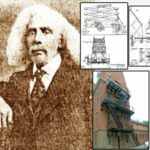 African-American abolitionist and inventor Joseph Richard Winters receives U.S. Patent number 203,517 for his innovations for a wagon-mounted fire escape ladder. Winters' ladder replaced the wooden ladder with a metal frame and parallel steps. Winters' innovation was utilized by the Chambersburg, Pennsylvania fire department who mounted the ladder on a horse-drawn wagon. Subsequently, on April 8, 1879, Winters received U.S. Patent number 214,224 for an "improvement" on the ladder, and on May 16, 1882, he received U.S. Patent number 258,186 for a fire escape ladder that could be affixed to buildings. Learn more. African-American abolitionist and inventor Joseph Richard Winters receives U.S. Patent number 203,517 for his innovations for a wagon-mounted fire escape ladder. Winters' ladder replaced the wooden ladder with a metal frame and parallel steps. Winters' innovation was utilized by the Chambersburg, Pennsylvania fire department who mounted the ladder on a horse-drawn wagon. Subsequently, on April 8, 1879, Winters received U.S. Patent number 214,224 for an "improvement" on the ladder, and on May 16, 1882, he received U.S. Patent number 258,186 for a fire escape ladder that could be affixed to buildings. Learn more. | |
| May 7, 1955 | 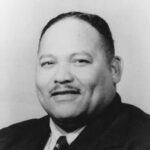 Reverend George Lee, co-founder of the Belzoni, Mississippi NAACP and the first African American to register to vote in Humphreys County since Reconstruction, is shot and killed in Belzoni. He is one of the early martyrs of the post-WWII Civil Rights Movement. Rev. Lee first moved to Belzoni to preach, but began working to register other African Americans to vote after the local NAACP was founded in 1953. He later served as chapter president and successfully registered some 100 African American voters in Belzoni—an extraordinary feat considering the significant risk of violent retaliation facing Black voters in the Deep South at the time. Learn more. Reverend George Lee, co-founder of the Belzoni, Mississippi NAACP and the first African American to register to vote in Humphreys County since Reconstruction, is shot and killed in Belzoni. He is one of the early martyrs of the post-WWII Civil Rights Movement. Rev. Lee first moved to Belzoni to preach, but began working to register other African Americans to vote after the local NAACP was founded in 1953. He later served as chapter president and successfully registered some 100 African American voters in Belzoni—an extraordinary feat considering the significant risk of violent retaliation facing Black voters in the Deep South at the time. Learn more. | |
| May 8, 1879 | 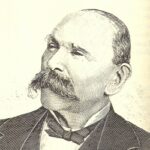 Robert J. Harlan delivers an address titled, “Migration is the Only Remedy for Our Wrongs” arguing that, in the wake of the end of Reconstruction, the withdrawal of federal troops from the south, and rampant violence against and repression of African Americans in the South, migration to the north was not only a way to escape oppression, it was also a powerful protest against those who would deny African Americans their freedom. This position placed Harlan in opposition to Frederick Douglass, the nation’s most prominent African American leader of that time. Read the full text of Harlan’s brief but powerful speech. Robert J. Harlan delivers an address titled, “Migration is the Only Remedy for Our Wrongs” arguing that, in the wake of the end of Reconstruction, the withdrawal of federal troops from the south, and rampant violence against and repression of African Americans in the South, migration to the north was not only a way to escape oppression, it was also a powerful protest against those who would deny African Americans their freedom. This position placed Harlan in opposition to Frederick Douglass, the nation’s most prominent African American leader of that time. Read the full text of Harlan’s brief but powerful speech. | |
| May 8, 1910 | 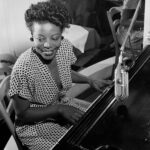 American jazz pianist, arranger, and composer Mary Lou Williams (birth name Mary Elfrieda Scruggs) is born. She wrote hundreds of compositions and arrangements and recorded more than one hundred records (in 78, 45, and LP versions). Williams wrote and arranged for Duke Ellington and Benny Goodman, and she was friend, mentor, and teacher to Thelonious Monk, Charlie Parker, Miles Davis, Tadd Dameron, Bud Powell, and Dizzy Gillespie. Her productive and influential career spanned half a century and remains an inspiration to both women and men in jazz. Learn more. American jazz pianist, arranger, and composer Mary Lou Williams (birth name Mary Elfrieda Scruggs) is born. She wrote hundreds of compositions and arrangements and recorded more than one hundred records (in 78, 45, and LP versions). Williams wrote and arranged for Duke Ellington and Benny Goodman, and she was friend, mentor, and teacher to Thelonious Monk, Charlie Parker, Miles Davis, Tadd Dameron, Bud Powell, and Dizzy Gillespie. Her productive and influential career spanned half a century and remains an inspiration to both women and men in jazz. Learn more. | |
| May 8, 1925 |  The Brotherhood of Sleeping Car Porters, the first successful black trade union, is organized by A. Philip Randolph. Learn more. The Brotherhood of Sleeping Car Porters, the first successful black trade union, is organized by A. Philip Randolph. Learn more. | |
| May 8, 2009 |  On May 8, 2009, Steven Joshua Dinkle of the Ozark, Alabama, chapter of the International Keystone Knights of the Ku Klux Klan (KKK), burned a cross in a local Black neighborhood. Joined by a KKK recruit named Thomas Windell Smith, Dinkle targeted the neighborhood because of the race of its residents. Both men were arrested and pled guilty to conspiracy to violate housing rights. At Dinkle’s plea hearing, he admitted that he burned the cross in order to scare the members of the African American community in Ozark, and that he was motivated to burn the cross because he did not like that African Americans were occupying homes in that area. Learn more. On May 8, 2009, Steven Joshua Dinkle of the Ozark, Alabama, chapter of the International Keystone Knights of the Ku Klux Klan (KKK), burned a cross in a local Black neighborhood. Joined by a KKK recruit named Thomas Windell Smith, Dinkle targeted the neighborhood because of the race of its residents. Both men were arrested and pled guilty to conspiracy to violate housing rights. At Dinkle’s plea hearing, he admitted that he burned the cross in order to scare the members of the African American community in Ozark, and that he was motivated to burn the cross because he did not like that African Americans were occupying homes in that area. Learn more. | |
| May 9, 1867 | 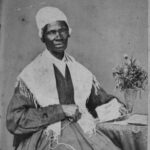 Two years after the end of the Civil War, Sojourner Truth delivers a keynote speech at the first anniversary celebration of the American Equal Rights Association in New York City, calling for universal equal rights, in particular the extending of full rights to women. Truth was born into slavery as Isabella Baumfree in 1797, escaped bondage in 1826 with her infant daughter, then went to court to recover her son in 1828, becoming the first Black woman to win a case against a white man. Truth's speech to the American Equal Rights Association, recorded in the published proceedings, acknowledges the success of the anti-slavery cause, but laments that it was achieved through war. She urges that women be given their rights quickly and peacefully. Learn more. Two years after the end of the Civil War, Sojourner Truth delivers a keynote speech at the first anniversary celebration of the American Equal Rights Association in New York City, calling for universal equal rights, in particular the extending of full rights to women. Truth was born into slavery as Isabella Baumfree in 1797, escaped bondage in 1826 with her infant daughter, then went to court to recover her son in 1828, becoming the first Black woman to win a case against a white man. Truth's speech to the American Equal Rights Association, recorded in the published proceedings, acknowledges the success of the anti-slavery cause, but laments that it was achieved through war. She urges that women be given their rights quickly and peacefully. Learn more. | |
| May 9, 1899 | 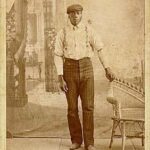 African American inventor John Albert Burr patents an improved rotary blade lawn mower (U.S. patent 624,749). Burr's rotary lawn mower design helped reduce the irritating clogs of clippings that are the bane of manual mowers. It was also more maneuverable and could be used for closer clipping around objects such as posts, walls, and buildings. Burr held over 30 U.S. patents for lawn care and agricultural inventions and received royalties for use of his inventions. Learn more. African American inventor John Albert Burr patents an improved rotary blade lawn mower (U.S. patent 624,749). Burr's rotary lawn mower design helped reduce the irritating clogs of clippings that are the bane of manual mowers. It was also more maneuverable and could be used for closer clipping around objects such as posts, walls, and buildings. Burr held over 30 U.S. patents for lawn care and agricultural inventions and received royalties for use of his inventions. Learn more. | |
| May 9, 1961 | 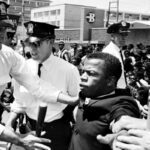 On the sixth day of the first Freedom Ride, three Freedom Riders--including 21-year-old Black civil rights activist John Lewis--were severely beaten by a mob at the Rock Hill, South Carolina, Greyhound bus terminal. On May 4, thirteen Freedom Riders—seven Black and six white—had left Washington, D.C., on a Greyhound bus headed to New Orleans. They sat interracially on the bus, planning to test a Supreme Court ruling that made segregation in interstate transportation illegal. The three Freedom Riders were brutally attacked before a white police officer, who had been present the entire time, finally intervened. The Freedom Riders responded with nonviolence and decided not to press charges, continuing their protest ride further south where they experienced continued violence from white mobs in Alabama. Learn more.
On the sixth day of the first Freedom Ride, three Freedom Riders--including 21-year-old Black civil rights activist John Lewis--were severely beaten by a mob at the Rock Hill, South Carolina, Greyhound bus terminal. On May 4, thirteen Freedom Riders—seven Black and six white—had left Washington, D.C., on a Greyhound bus headed to New Orleans. They sat interracially on the bus, planning to test a Supreme Court ruling that made segregation in interstate transportation illegal. The three Freedom Riders were brutally attacked before a white police officer, who had been present the entire time, finally intervened. The Freedom Riders responded with nonviolence and decided not to press charges, continuing their protest ride further south where they experienced continued violence from white mobs in Alabama. Learn more. | |
| May 10, 1740 | 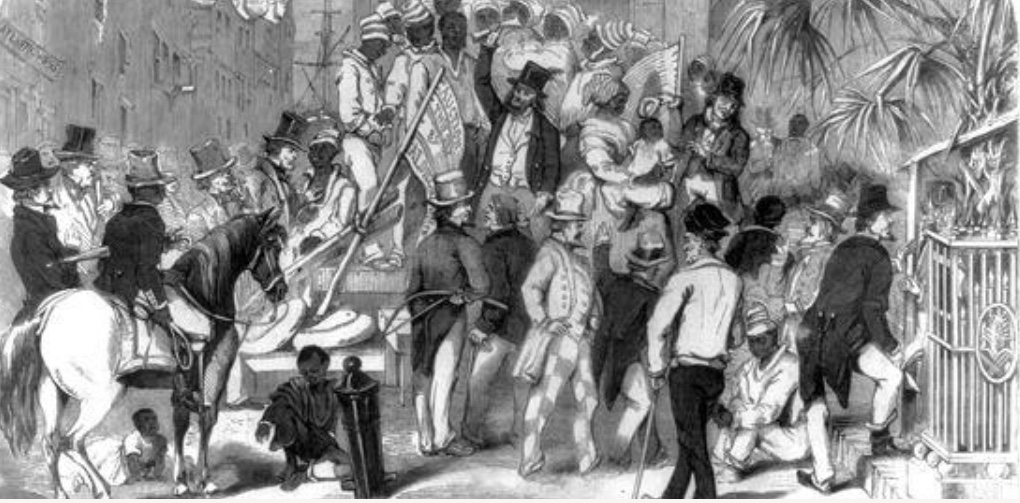 The South Carolina Assembly enacts the “Bill for the better ordering and governing of Negroes and other slaves in this province,” also known as the Negro Act of 1740. The law prohibited enslaved African people from growing their own food, learning to read, moving freely, assembling in groups, or earning money. It also authorized white enslavers to whip and kill enslaved Africans for being "rebellious." The law served as a model for other states before and after US independence. Learn more. The South Carolina Assembly enacts the “Bill for the better ordering and governing of Negroes and other slaves in this province,” also known as the Negro Act of 1740. The law prohibited enslaved African people from growing their own food, learning to read, moving freely, assembling in groups, or earning money. It also authorized white enslavers to whip and kill enslaved Africans for being "rebellious." The law served as a model for other states before and after US independence. Learn more. | |
| May 10, 1775 | 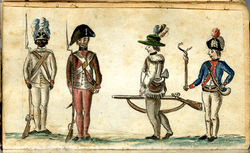 As they would throughout, Black patriot soldiers, the unsung heroes of the American Revolution, fight in the first aggressive action by American forces of the war, the Capture of Fort Ticonderoga by Ethan Allen and the “Green Mountain Boys.” Lemuel Haynes, Primus Black, Epheram Blackman, and Barzilai Lew were some of the Black patriot soldiers fighting with Allen that day. Learn more. As they would throughout, Black patriot soldiers, the unsung heroes of the American Revolution, fight in the first aggressive action by American forces of the war, the Capture of Fort Ticonderoga by Ethan Allen and the “Green Mountain Boys.” Lemuel Haynes, Primus Black, Epheram Blackman, and Barzilai Lew were some of the Black patriot soldiers fighting with Allen that day. Learn more. | |
| May 10, 1868 | 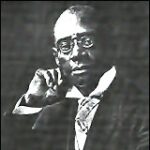 Successful African American inventor, attorney, and real estate businessman Shelby Davidson is born. His life and career served as powerful testimony for the importance of education and tenacity. Learn more. Successful African American inventor, attorney, and real estate businessman Shelby Davidson is born. His life and career served as powerful testimony for the importance of education and tenacity. Learn more. | |
| May 10, 1919 | 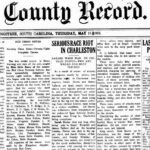 The Charleston Riot of 1919 begins at around 10 pm and continues until after midnight, between white members of the US Navy and the local Black population. The white sailors attacked Black individuals, businesses, and homes killing six and injuring dozens. It began when five white sailors felt they had been cheated by a Black man and, unable to find him, attacked African Americans at random. A Black man named Isaac Doctor shot at them and was killed. According to reports, "Within an hour, word of the street brawls and shooting got back to the Charleston Naval Yard and carloads of sailors poured into the Black district." Learn more. The Charleston Riot of 1919 begins at around 10 pm and continues until after midnight, between white members of the US Navy and the local Black population. The white sailors attacked Black individuals, businesses, and homes killing six and injuring dozens. It began when five white sailors felt they had been cheated by a Black man and, unable to find him, attacked African Americans at random. A Black man named Isaac Doctor shot at them and was killed. According to reports, "Within an hour, word of the street brawls and shooting got back to the Charleston Naval Yard and carloads of sailors poured into the Black district." Learn more. | |
| May 11, 1895 | 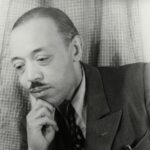 William Grant Still Jr., an American composer of nearly 200 works, including five symphonies, four ballets, eight operas, over thirty choral works, plus art songs, chamber music and works for solo instruments, is born in Mississippi. Still grew up in Little Rock, Arkansas, attended Wilberforce University and Oberlin Conservatory of Music. Due to his close association and collaboration with prominent African-American literary and cultural figures, Still is considered to have been part of the Harlem Renaissance. Often referred to as the "Dean of Afro-American Composers," Still was the first American composer to have an opera produced by the New York City Opera. Also of note, Still was the first African-American to conduct a major American symphony orchestra, the first to have a symphony performed by a leading orchestra, the first to have an opera performed by a major opera company, and the first to have an opera performed on national television. Learn more. William Grant Still Jr., an American composer of nearly 200 works, including five symphonies, four ballets, eight operas, over thirty choral works, plus art songs, chamber music and works for solo instruments, is born in Mississippi. Still grew up in Little Rock, Arkansas, attended Wilberforce University and Oberlin Conservatory of Music. Due to his close association and collaboration with prominent African-American literary and cultural figures, Still is considered to have been part of the Harlem Renaissance. Often referred to as the "Dean of Afro-American Composers," Still was the first American composer to have an opera produced by the New York City Opera. Also of note, Still was the first African-American to conduct a major American symphony orchestra, the first to have a symphony performed by a leading orchestra, the first to have an opera performed by a major opera company, and the first to have an opera performed on national television. Learn more. | |
| May 11, 1963 |  White supremacists bomb the parsonage of Rev. A. D. King, brother of Martin Luther King Jr., and the African American-owned A.G. Gaston Motel, specifically targeting room 30, where King and others organizing the Birmingham campaign, a mass protest for civil rights, had stayed. Historians believe the bombings were carried out by members of the Ku Klux Klan, in cooperation with Birmingham police. Four months later, white supremacists would bomb Birmingham’s 16th Street Baptist Church, killing four young Black girls and injuring 14 other congregation members. Learn more. White supremacists bomb the parsonage of Rev. A. D. King, brother of Martin Luther King Jr., and the African American-owned A.G. Gaston Motel, specifically targeting room 30, where King and others organizing the Birmingham campaign, a mass protest for civil rights, had stayed. Historians believe the bombings were carried out by members of the Ku Klux Klan, in cooperation with Birmingham police. Four months later, white supremacists would bomb Birmingham’s 16th Street Baptist Church, killing four young Black girls and injuring 14 other congregation members. Learn more. | |
| May 11, 1968 | 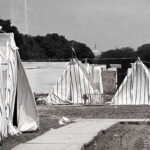 The first nine caravans of poor people arrive in Washington, D.C., for the first phase of the Poor People's Campaign, or Poor People's March on Washington, that will get underway the next day (May 12). The Poor People’s Campaign was a 1968 effort to gain economic justice for poor people in the United States. It was organized by Martin Luther King Jr. and the Southern Christian Leadership Conference (SCLC), and carried out under the leadership of Ralph Abernathy in the wake of King's assassination in April 1968. Learn more. The first nine caravans of poor people arrive in Washington, D.C., for the first phase of the Poor People's Campaign, or Poor People's March on Washington, that will get underway the next day (May 12). The Poor People’s Campaign was a 1968 effort to gain economic justice for poor people in the United States. It was organized by Martin Luther King Jr. and the Southern Christian Leadership Conference (SCLC), and carried out under the leadership of Ralph Abernathy in the wake of King's assassination in April 1968. Learn more. | |
| May 11, 2010 | 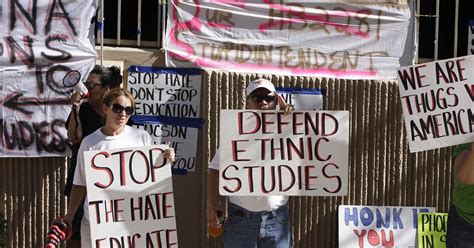 Arizona Governor Jan Brewer signs into law HB 2281, a legislative act to prohibit Ethnic Studies classes in the state. This law banned schools from engaging with certain books written by authors of color and temporarily eliminated the Mexican American Studies program in Tucson schools, preventing hundreds of students from engaging with their history and culture within a school setting for almost a decade. Years later, a federal court found that HB 2281 was passed with the specific intention “to advance a political agenda by capitalizing on race-based fear.” HB 2281 was formally invalidated as unconstitutional in 2017, nearly a decade following its passage, and after the law had already denied hundreds of students the opportunity to study within a culturally diverse setting. Learn more. Arizona Governor Jan Brewer signs into law HB 2281, a legislative act to prohibit Ethnic Studies classes in the state. This law banned schools from engaging with certain books written by authors of color and temporarily eliminated the Mexican American Studies program in Tucson schools, preventing hundreds of students from engaging with their history and culture within a school setting for almost a decade. Years later, a federal court found that HB 2281 was passed with the specific intention “to advance a political agenda by capitalizing on race-based fear.” HB 2281 was formally invalidated as unconstitutional in 2017, nearly a decade following its passage, and after the law had already denied hundreds of students the opportunity to study within a culturally diverse setting. Learn more. | |
| May 12, 1862 | 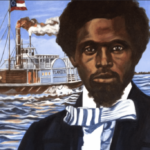 Enslaved crewman Robert Smalls leads his fellow enslaved crew members of the Charleston-based Confederate warship Steamer Planter and their families to escape bondage and deliver possession of their ship to Union forces. Smalls served the remainder of the Civil War in the Union navy and was eventually promoted to ships captain. After the war, Smalls served as a Congressman. Learn more. Enslaved crewman Robert Smalls leads his fellow enslaved crew members of the Charleston-based Confederate warship Steamer Planter and their families to escape bondage and deliver possession of their ship to Union forces. Smalls served the remainder of the Civil War in the Union navy and was eventually promoted to ships captain. After the war, Smalls served as a Congressman. Learn more. | |
| May 12, 1898 | 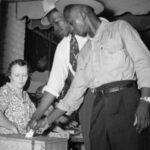 The state of Louisiana adopts a new constitution with numerous restrictive provisions intended to disempower and exclude African Americans from civic participation. After Reconstruction ended in 1877 and white politicians and lawmakers regained control and power in the South, many efforts were made to restore that racial order through very strict laws that stripped Black people of many of their new civil rights. In Louisiana, framers explicitly expressed their goal to “purify the electorate.” The new Louisiana Constitution created a poll tax, literacy and property-ownership requirements, and a complex voter registration form all designed and enforced to disproportionately disenfranchise Black voters. A “Grandfather Clause” created an exception for those whose ancestors were registered to vote before 1867, thus enabling the estimated 25% of whites who were illiterate and poor to be exempted from the literacy and property requirements. Black people remained blocked because Louisiana laws before 1867 disenfranchised nearly all African Americans—especially those who were enslaved. The 1898 Louisiana constitution also eliminated the requirement of unanimous jury verdicts, allowing as much as a 9-3 split to still stand as a conviction, ensuring the conviction of African American defendants even when Black jurors voted to acquit. Learn more. The state of Louisiana adopts a new constitution with numerous restrictive provisions intended to disempower and exclude African Americans from civic participation. After Reconstruction ended in 1877 and white politicians and lawmakers regained control and power in the South, many efforts were made to restore that racial order through very strict laws that stripped Black people of many of their new civil rights. In Louisiana, framers explicitly expressed their goal to “purify the electorate.” The new Louisiana Constitution created a poll tax, literacy and property-ownership requirements, and a complex voter registration form all designed and enforced to disproportionately disenfranchise Black voters. A “Grandfather Clause” created an exception for those whose ancestors were registered to vote before 1867, thus enabling the estimated 25% of whites who were illiterate and poor to be exempted from the literacy and property requirements. Black people remained blocked because Louisiana laws before 1867 disenfranchised nearly all African Americans—especially those who were enslaved. The 1898 Louisiana constitution also eliminated the requirement of unanimous jury verdicts, allowing as much as a 9-3 split to still stand as a conviction, ensuring the conviction of African American defendants even when Black jurors voted to acquit. Learn more. | |
| May 12, 1957 |  Ertharin Cousin, American diplomat, lawyer, and advocate for ending global hunger, is born in Chicago, IL. Cousin served from 2009-2012 under President Barack Obama as the United States Ambassador to the United Nations Agencies for Food and Agriculture, serving in Rome, Italy, and chief of the United States Mission to the UN Agencies in Rome. Cousin served as the twelfth Executive Director of the United Nations World Food Programme from 2012 to 2017. Following the completion of her term, Cousin became Payne Distinguished Professor at Stanford University's Freeman Spogli Institute for International Studies, Distinguished Fellow at the Center on Food Security and the Environment and the Center on Democracy, Development and the Rule of Law, accepted an appointment as a Distinguished Fellow with The Chicago Council on Global Affairs, and became Trustee on the UK based Power of Nutrition Board of Directors. Learn more. Ertharin Cousin, American diplomat, lawyer, and advocate for ending global hunger, is born in Chicago, IL. Cousin served from 2009-2012 under President Barack Obama as the United States Ambassador to the United Nations Agencies for Food and Agriculture, serving in Rome, Italy, and chief of the United States Mission to the UN Agencies in Rome. Cousin served as the twelfth Executive Director of the United Nations World Food Programme from 2012 to 2017. Following the completion of her term, Cousin became Payne Distinguished Professor at Stanford University's Freeman Spogli Institute for International Studies, Distinguished Fellow at the Center on Food Security and the Environment and the Center on Democracy, Development and the Rule of Law, accepted an appointment as a Distinguished Fellow with The Chicago Council on Global Affairs, and became Trustee on the UK based Power of Nutrition Board of Directors. Learn more.
| |
| May 12, 1970 |  Before dawn, police brutally and arbitrarily suppress a 3-day protest that police-initiated violence and white official's intransigence had escalated and provoked into a riot. Three days before, on the evening of May 9, Charles Oatman, a popular, mentally-challenged 16-year-old student at A.R. Johnson Junior High School, had been beaten to death in the county jail. In a tragic accident in late March, Charles had fatally wounded his young niece in the kitchen of his family’s small house. Disregarding the accidental nature of the incident, white authorities charged Charles with killing her and incarcerated him. Over the course of several weeks in the jail, 16-yo Charles Oatman was brutally tortured and beaten, ultimately dying of his injuries. His badly mutilated body carried cigarette burns, marks from a fork, and a deep gash in the back of his head. On the evening of May 10 several hundred demonstrated at the county jail, demanding answers from white officials but making little headway. Sheriff’s deputies were on hand (and on the jail’s roof) with weapons drawn. On the afternoon of May 11 an even larger group demonstrated in front of the Municipal Building, and again were confronted by shotgun-wielding police officers. When the news emerged that the sheriff had concluded his brief, tacit investigation and charged two Black teenagers with manslaughter, many were indignant to the point of rage and began rioting and destroying property of businesses known to discriminate. With the endorsement of the governor, shoot-to-kill orders from their captain, and reinforcements by the National Guard and State Patrol, white police went into violent overdrive at nightfall, firing shotguns indiscriminately at African Americans, wounding at least sixty people and killing six. Despite police claims they acted in self-defense, the six men they killed were all unarmed and all shot in the back, and three were shot multiple times. Learn more. Before dawn, police brutally and arbitrarily suppress a 3-day protest that police-initiated violence and white official's intransigence had escalated and provoked into a riot. Three days before, on the evening of May 9, Charles Oatman, a popular, mentally-challenged 16-year-old student at A.R. Johnson Junior High School, had been beaten to death in the county jail. In a tragic accident in late March, Charles had fatally wounded his young niece in the kitchen of his family’s small house. Disregarding the accidental nature of the incident, white authorities charged Charles with killing her and incarcerated him. Over the course of several weeks in the jail, 16-yo Charles Oatman was brutally tortured and beaten, ultimately dying of his injuries. His badly mutilated body carried cigarette burns, marks from a fork, and a deep gash in the back of his head. On the evening of May 10 several hundred demonstrated at the county jail, demanding answers from white officials but making little headway. Sheriff’s deputies were on hand (and on the jail’s roof) with weapons drawn. On the afternoon of May 11 an even larger group demonstrated in front of the Municipal Building, and again were confronted by shotgun-wielding police officers. When the news emerged that the sheriff had concluded his brief, tacit investigation and charged two Black teenagers with manslaughter, many were indignant to the point of rage and began rioting and destroying property of businesses known to discriminate. With the endorsement of the governor, shoot-to-kill orders from their captain, and reinforcements by the National Guard and State Patrol, white police went into violent overdrive at nightfall, firing shotguns indiscriminately at African Americans, wounding at least sixty people and killing six. Despite police claims they acted in self-defense, the six men they killed were all unarmed and all shot in the back, and three were shot multiple times. Learn more. | |
| May 13, 1925 | 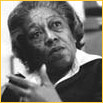 Carolyn Robertson Payton, Ed.D. is born. Dr. Payton was a pioneer in black women’s leadership within the American Psychological Association and psychology. She was appointed Director of the United States Peace Corps in 1977 by President Jimmy Carter, the first female and the first African American to be Peace Corps Director. Learn more. Carolyn Robertson Payton, Ed.D. is born. Dr. Payton was a pioneer in black women’s leadership within the American Psychological Association and psychology. She was appointed Director of the United States Peace Corps in 1977 by President Jimmy Carter, the first female and the first African American to be Peace Corps Director. Learn more. | |
| May 13, 1950 | 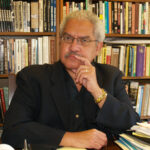 American professor of public affairs, history and African-American Studies at Columbia University, William Manning Marable is born. Marable founded and directed the Institute for Research in African-American Studies. He authored several texts and was active in progressive political causes. At the time of his death, Professor Marable had completed a biography of human rights activist Malcolm X titled Malcolm X: A Life of Reinvention (2011), for which he won the 2012 Pulitzer Prize for History. Learn more. American professor of public affairs, history and African-American Studies at Columbia University, William Manning Marable is born. Marable founded and directed the Institute for Research in African-American Studies. He authored several texts and was active in progressive political causes. At the time of his death, Professor Marable had completed a biography of human rights activist Malcolm X titled Malcolm X: A Life of Reinvention (2011), for which he won the 2012 Pulitzer Prize for History. Learn more. | |
| May 13, 1951 |  Activist, community leader, and the first African American and first woman mayor of the city of Minneapolis, Minnesota, Sharon Sayles Belton is born in St. Paul, MN. For most of her life she has fought for racial equality, women, family and child care issues, youth development and neighborhood development. In 1978 Belton co-founded the Harriet Tubman Shelter for Battered Women in Minneapolis. Learn more. Activist, community leader, and the first African American and first woman mayor of the city of Minneapolis, Minnesota, Sharon Sayles Belton is born in St. Paul, MN. For most of her life she has fought for racial equality, women, family and child care issues, youth development and neighborhood development. In 1978 Belton co-founded the Harriet Tubman Shelter for Battered Women in Minneapolis. Learn more. | |
| May 13, 1960 | 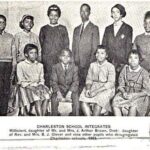 Six years after Brown v. Board of Education, South Carolina’s legislature passed a bill to preserve school segregation and stall Black citizens’ attempts to integrate public schools using the authority of federal courts. On the last day of the 1960 legislative session, South Carolina lawmakers voted for a bill that, on its face, repealed language that declared the state would provide funding to “racially segregated schools only.” However, as local media accurately reported, the legislation was a “maneuver to thwart integration by the fiction of seeming to give in a little to it.” The bill did nothing to change another state law that mandated the closure of any school for white students that admitted a Black student. The bill also left in place provisions requiring racial segregation on school buses and in cafeterias. South Carolina schools would remain wholly segregated until September 1963, when eleven African American students desegregated Charleston County’s white schools, making South Carolina the last state to desegregate its public school system. Learn more. Six years after Brown v. Board of Education, South Carolina’s legislature passed a bill to preserve school segregation and stall Black citizens’ attempts to integrate public schools using the authority of federal courts. On the last day of the 1960 legislative session, South Carolina lawmakers voted for a bill that, on its face, repealed language that declared the state would provide funding to “racially segregated schools only.” However, as local media accurately reported, the legislation was a “maneuver to thwart integration by the fiction of seeming to give in a little to it.” The bill did nothing to change another state law that mandated the closure of any school for white students that admitted a Black student. The bill also left in place provisions requiring racial segregation on school buses and in cafeterias. South Carolina schools would remain wholly segregated until September 1963, when eleven African American students desegregated Charleston County’s white schools, making South Carolina the last state to desegregate its public school system. Learn more. | |
| May 14, 1888 | 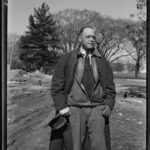 Architect and engineer Archibald Alphonso Alexander is born. He was an early African-American graduate of the University of Iowa and the first to graduate from the University of Iowa's College of Engineering. Through the firm he founded, A. A. Alexander, Inc. (later Alexander & Repass), Alexander spearheaded over 300 projects, including major bridge and highway design and construction projects, garnering multiple awards and honors for achievements in engineering and business. In 1954, Alexander was appointed Governor of the United States Virgin Islands by PresidentDwight D. Eisenhower. Learn more. Architect and engineer Archibald Alphonso Alexander is born. He was an early African-American graduate of the University of Iowa and the first to graduate from the University of Iowa's College of Engineering. Through the firm he founded, A. A. Alexander, Inc. (later Alexander & Repass), Alexander spearheaded over 300 projects, including major bridge and highway design and construction projects, garnering multiple awards and honors for achievements in engineering and business. In 1954, Alexander was appointed Governor of the United States Virgin Islands by PresidentDwight D. Eisenhower. Learn more. | |
| May 14, 1913 | 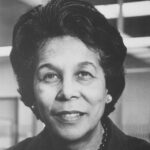 Clara Stanton Jones, the first African American and the first woman to serve as director of a major library system in America (the Detroit Public Library) and later the first African-American president of the American Library Association (ALA), is born. She heavily aided the ALA adoption of a "Resolution on Racism and Sexism Awareness" to encourage librarians to raise the awareness of library patrons and staff to problems of racism and sexism. President Jimmy Carter appointed Jones as Commissioner to the National Commission on Libraries and Information Science. In 1984, Jones and Aileen Clarke Hernandez, former President of the National Organization for Women (NOW), founded the black women's discussion group Black Women Stirring the Waters, in the San Francisco Bay Area. Jones received the Trailblazer Award in 1990 from the Black Caucus of the American Library Association, the highest award given by BCALA. Learn more. Clara Stanton Jones, the first African American and the first woman to serve as director of a major library system in America (the Detroit Public Library) and later the first African-American president of the American Library Association (ALA), is born. She heavily aided the ALA adoption of a "Resolution on Racism and Sexism Awareness" to encourage librarians to raise the awareness of library patrons and staff to problems of racism and sexism. President Jimmy Carter appointed Jones as Commissioner to the National Commission on Libraries and Information Science. In 1984, Jones and Aileen Clarke Hernandez, former President of the National Organization for Women (NOW), founded the black women's discussion group Black Women Stirring the Waters, in the San Francisco Bay Area. Jones received the Trailblazer Award in 1990 from the Black Caucus of the American Library Association, the highest award given by BCALA. Learn more. | |
| May 14, 1961 | 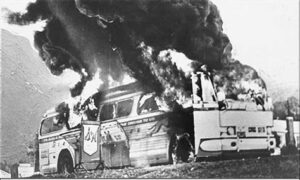 On Mother's Day, May 14, 1961, the Greyhound bus carrying Freedom Riders arrived at the Anniston, Alabama, bus station shortly after 1:00 pm to a mob of 50 men armed with pipes, chains, and bats led by Ku Klux Klan leader William Chapel. The mob smashed windows, slashed tires, and dented the sides of the Riders' bus. Local police, aware of the mob in advance, did not arrive until after the assault was well underway. Police then pretended to escort the crippled bus to safety, but instead abandoned it at the Anniston city limits. Another armed white mob then surrounded and attacked the bus, while two highway patrolmen watched without intervening. When a member of the mob tossed a firebomb through a broken bus window, others in the mob attempted to trap the passengers inside the burning vehicle by barricading the door. The mob stepped back when the fuel tank began to explode. The Riders were able to escape the ensuing flames and smoke through the bus windows and main door, only to be attacked and beaten by the mob outside. After police finally dispersed their attackers, the Freedom Riders received limited medical care. They were soon evacuated from Anniston in a convoy organized by Birmingham Civil Rights leader, Rev. Fred Shuttlesworth. Learn more. On Mother's Day, May 14, 1961, the Greyhound bus carrying Freedom Riders arrived at the Anniston, Alabama, bus station shortly after 1:00 pm to a mob of 50 men armed with pipes, chains, and bats led by Ku Klux Klan leader William Chapel. The mob smashed windows, slashed tires, and dented the sides of the Riders' bus. Local police, aware of the mob in advance, did not arrive until after the assault was well underway. Police then pretended to escort the crippled bus to safety, but instead abandoned it at the Anniston city limits. Another armed white mob then surrounded and attacked the bus, while two highway patrolmen watched without intervening. When a member of the mob tossed a firebomb through a broken bus window, others in the mob attempted to trap the passengers inside the burning vehicle by barricading the door. The mob stepped back when the fuel tank began to explode. The Riders were able to escape the ensuing flames and smoke through the bus windows and main door, only to be attacked and beaten by the mob outside. After police finally dispersed their attackers, the Freedom Riders received limited medical care. They were soon evacuated from Anniston in a convoy organized by Birmingham Civil Rights leader, Rev. Fred Shuttlesworth. Learn more. | |
| May 14, 1970 | 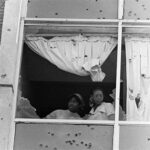 In the evening, city and state police confront a group of students at Jackson State College (now Jackson State University) in Jackson, Mississippi, one of the largest historically Black colleges or universities (HCBU) in the United States. At roughly 12:05 am (on May 15), the police open fire on the crowd gathered in front of Alexander Hall, a women's dormitory, killing two students and injuring twelve. The gunfire lasted for 30 seconds and more than 460 shots were fired by a reported 40 state highway patrolmen, who used shotguns from 30 to 50 feet. Every window on the side of the building facing the street was shattered. In December 1970, a federal grand jury was discharged after it failed to produce an indictment or written findings in a five-month recess, despite having summoned about 40 state patrol men and 26 city police officers. The President's Commission on Campus Unrest investigated the event and concluded "that the 28-second fusillade from police officers was an unreasonable, unjustified overreaction.... A broad barrage of gunfire in response to reported and unconfirmed sniper fire is never warranted." The event, subsequently become known as the Jackson State Killings. Learn more. In the evening, city and state police confront a group of students at Jackson State College (now Jackson State University) in Jackson, Mississippi, one of the largest historically Black colleges or universities (HCBU) in the United States. At roughly 12:05 am (on May 15), the police open fire on the crowd gathered in front of Alexander Hall, a women's dormitory, killing two students and injuring twelve. The gunfire lasted for 30 seconds and more than 460 shots were fired by a reported 40 state highway patrolmen, who used shotguns from 30 to 50 feet. Every window on the side of the building facing the street was shattered. In December 1970, a federal grand jury was discharged after it failed to produce an indictment or written findings in a five-month recess, despite having summoned about 40 state patrol men and 26 city police officers. The President's Commission on Campus Unrest investigated the event and concluded "that the 28-second fusillade from police officers was an unreasonable, unjustified overreaction.... A broad barrage of gunfire in response to reported and unconfirmed sniper fire is never warranted." The event, subsequently become known as the Jackson State Killings. Learn more. | |
| May 15, 1918 | 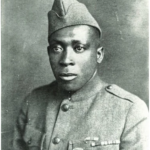 William Henry Johnson, commonly known as Henry Johnson, performs heroically in the first African American unit of the United States Army to engage in combat in World War I. On watch in the Argonne Forest on the evening of May 14, 1918, and carrying over into the early hours of May 15, Johnson fights off a German raid in hand-to-hand combat and rescues a fellow soldier while experiencing 21 wounds. His actions are later brought to the nation's attention by coverage in the New York World and The Saturday Evening Post later that year. Johnson was recognized by the French with a Croix de guerre with star and bronze palm, and was the first U.S. soldier in World War I to receive that honor. Johnson died, poor and in obscurity, in 1929. There was a long struggle to achieve awards for him from the U.S. military. He was awarded the Purple Heart in 1996, the U.S. military awarded him the Distinguished Service Cross in 2002, and on June 2, 2015, he was awarded the Medal of Honor by President Barack Obama in a posthumous ceremony at the White House. Learn more. William Henry Johnson, commonly known as Henry Johnson, performs heroically in the first African American unit of the United States Army to engage in combat in World War I. On watch in the Argonne Forest on the evening of May 14, 1918, and carrying over into the early hours of May 15, Johnson fights off a German raid in hand-to-hand combat and rescues a fellow soldier while experiencing 21 wounds. His actions are later brought to the nation's attention by coverage in the New York World and The Saturday Evening Post later that year. Johnson was recognized by the French with a Croix de guerre with star and bronze palm, and was the first U.S. soldier in World War I to receive that honor. Johnson died, poor and in obscurity, in 1929. There was a long struggle to achieve awards for him from the U.S. military. He was awarded the Purple Heart in 1996, the U.S. military awarded him the Distinguished Service Cross in 2002, and on June 2, 2015, he was awarded the Medal of Honor by President Barack Obama in a posthumous ceremony at the White House. Learn more. | |
| May 15, 1923 | 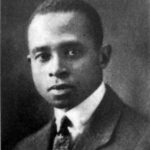 The Chip Woman's Fortune , a one-act play written by African American playwright Willis Richardson, opens at the Frazee Theater on Broadway. It I s the first serious work by an African American playwright to be presented on Broadway. Although Broadway had previously presented African American musical comedies and revues, it had never before presented a serious African American drama. Learn more. The Chip Woman's Fortune , a one-act play written by African American playwright Willis Richardson, opens at the Frazee Theater on Broadway. It I s the first serious work by an African American playwright to be presented on Broadway. Although Broadway had previously presented African American musical comedies and revues, it had never before presented a serious African American drama. Learn more. | |
| May 15, 1942 | 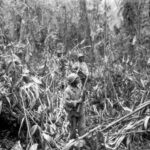 The 93rd Infantry Division, a "colored" segregated unit of the United States Army in World War I and World War II, is reactivated with the "colored" infantry designation, the first African American division activated in WW II. The division was assigned and saw service in the Pacific Theater during World War II. Learn more. The 93rd Infantry Division, a "colored" segregated unit of the United States Army in World War I and World War II, is reactivated with the "colored" infantry designation, the first African American division activated in WW II. The division was assigned and saw service in the Pacific Theater during World War II. Learn more. | |
| May 15, 1946 | 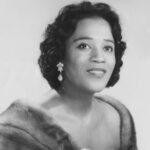 Operatic soprano Camilla Ella Williams, the first African American to receive a regular contract with a major American opera company, debuts with the New York City Opera in the title role in Puccini’s Madama Butterfly. During her time at the New York City Opera, she performed Nedda in Leoncavallo's Pagliacci, Mimi in Puccini's La bohème, Marguerite in Gounod's Faust, Micaela in Bizet's Carmen, and the title role in Verdi's Aida. She had earlier won honors in vocal competitions and the Marian Anderson Fellowship in 1943–44. In 1954 she became the first African American to sing a major role with the Vienna State Opera. She later also performed as a soloist with numerous European orchestras. As a concert artist, she toured throughout the United States as well as Asia, Australia and New Zealand. In August 1963, as part of the civil rights March on Washington for Jobs and Freedom, she sang "The Star-Spangled Banner" at the White House and, when scheduled performer Marian Anderson was delayed trying to get through the gathered throngs, Williams sang the anthem before 250,000 people at the Lincoln Memorial, preceding Martin Luther King Jr.delivered his "I Have a Dream" speech. In 1977, she was the first African American appointed as Professor of Voice at Indiana University, where she taught until 1997. Learn more. Operatic soprano Camilla Ella Williams, the first African American to receive a regular contract with a major American opera company, debuts with the New York City Opera in the title role in Puccini’s Madama Butterfly. During her time at the New York City Opera, she performed Nedda in Leoncavallo's Pagliacci, Mimi in Puccini's La bohème, Marguerite in Gounod's Faust, Micaela in Bizet's Carmen, and the title role in Verdi's Aida. She had earlier won honors in vocal competitions and the Marian Anderson Fellowship in 1943–44. In 1954 she became the first African American to sing a major role with the Vienna State Opera. She later also performed as a soloist with numerous European orchestras. As a concert artist, she toured throughout the United States as well as Asia, Australia and New Zealand. In August 1963, as part of the civil rights March on Washington for Jobs and Freedom, she sang "The Star-Spangled Banner" at the White House and, when scheduled performer Marian Anderson was delayed trying to get through the gathered throngs, Williams sang the anthem before 250,000 people at the Lincoln Memorial, preceding Martin Luther King Jr.delivered his "I Have a Dream" speech. In 1977, she was the first African American appointed as Professor of Voice at Indiana University, where she taught until 1997. Learn more. | |
| May 16, 1947 | 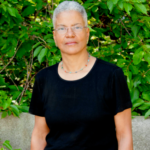 Lesbian poet, essayist, educator, and Black feminist community activist Cheryl L. Clarke is born Washington DC. With her life partner, Barbara Balliet, she is co-owner of Bleinheim Hill Books, a used and rare bookstore in Hobart, NJ. Her younger sister is novelist Breena Clarke, with whom Clarke and Balliet organize the Hobart Festival of Women writers each summer. Her scholarship focuses on African-American women's literature, black lesbian feminism, and the Black Arts Movement in the United States. Retired from her work in higher education, she maintains a teaching affiliation with the Graduate Faculty of the Department of Women and Gender Studies, Rutgers, the State University of New Jersey, and serves on the board of the Newark Pride Alliance. Learn more. Lesbian poet, essayist, educator, and Black feminist community activist Cheryl L. Clarke is born Washington DC. With her life partner, Barbara Balliet, she is co-owner of Bleinheim Hill Books, a used and rare bookstore in Hobart, NJ. Her younger sister is novelist Breena Clarke, with whom Clarke and Balliet organize the Hobart Festival of Women writers each summer. Her scholarship focuses on African-American women's literature, black lesbian feminism, and the Black Arts Movement in the United States. Retired from her work in higher education, she maintains a teaching affiliation with the Graduate Faculty of the Department of Women and Gender Studies, Rutgers, the State University of New Jersey, and serves on the board of the Newark Pride Alliance. Learn more. | |
| May 16, 1997 | 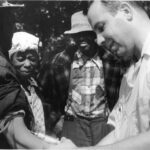 President Bill Clinton formally apologizes at a ceremony at the White House to the surviving “Tuskegee Experiment” victims. The Tuskegee Experiment was an abusive study conducted between 1932 and 1972 by the United States Public Health Service (PHS) and the Centers for Disease Control and Prevention (CDC). Experimenters enrolled 600 impoverished African-American sharecroppers. Of these men, 399 had latent syphilis, with a control group of 201 men who were not infected. The men were promised free medical care, but were deceived by the PHS, who never informed subjects of their diagnosis and disguised placebos, ineffective methods, and diagnostic procedures as treatment. The "study” was extended for 40 years, without informing the men that they would never be treated. None of the infected men were treated with penicillin despite the fact that by 1947, the antibiotic was widely available and had become the standard treatment for syphilis. The study continued until 1972, when a leak to the press resulted in its termination on November 16 of that year. The study caused the deaths of 128 of its participants, either directly from syphilis or related complications. The 40-year Tuskegee Experiment has been cited as "the most infamous biomedical research study in U.S. history." Its revelation has been an important cause of distrust in medical science and the US government amongst African Americans. Learn more.
President Bill Clinton formally apologizes at a ceremony at the White House to the surviving “Tuskegee Experiment” victims. The Tuskegee Experiment was an abusive study conducted between 1932 and 1972 by the United States Public Health Service (PHS) and the Centers for Disease Control and Prevention (CDC). Experimenters enrolled 600 impoverished African-American sharecroppers. Of these men, 399 had latent syphilis, with a control group of 201 men who were not infected. The men were promised free medical care, but were deceived by the PHS, who never informed subjects of their diagnosis and disguised placebos, ineffective methods, and diagnostic procedures as treatment. The "study” was extended for 40 years, without informing the men that they would never be treated. None of the infected men were treated with penicillin despite the fact that by 1947, the antibiotic was widely available and had become the standard treatment for syphilis. The study continued until 1972, when a leak to the press resulted in its termination on November 16 of that year. The study caused the deaths of 128 of its participants, either directly from syphilis or related complications. The 40-year Tuskegee Experiment has been cited as "the most infamous biomedical research study in U.S. history." Its revelation has been an important cause of distrust in medical science and the US government amongst African Americans. Learn more. | |
| May 16, 2012 |  The North Carolina legislature considers a bill recommending compensation for victims of the state's forced sterilization program. Beginning in 1933, and continuing into the 1970s the Eugenics Board of North Carolina oversaw approximately 7,600 forced sterilizations. In contrast with other eugenics programs in the United States, North Carolina's board enabled county departments of public welfare to petition for sterilization of their clients, including some girls as young as ten years old. Approximately 60% of the women sterilized against their will in North Carolina were African American. Learn more. The North Carolina legislature considers a bill recommending compensation for victims of the state's forced sterilization program. Beginning in 1933, and continuing into the 1970s the Eugenics Board of North Carolina oversaw approximately 7,600 forced sterilizations. In contrast with other eugenics programs in the United States, North Carolina's board enabled county departments of public welfare to petition for sterilization of their clients, including some girls as young as ten years old. Approximately 60% of the women sterilized against their will in North Carolina were African American. Learn more. | |
| May 17, 1893 | 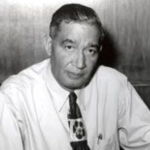 Frederick McKinley Jones an American inventor, entrepreneur, winner of the National Medal of Technology, and an inductee of the National Inventors Hall of Fame is born to a white father and Black mother. Deserted and orphaned as a child, Jones got a job first as a cleaning boy at age 11 and by age 14 he was working as an automobile mechanic. He boosted his natural mechanical ability and inventive mind with independent reading and study. After service with the U.S. Army in World War I, Jones taught himself electronics. His innovations in refrigeration brought great improvement to the long-haul transportation of perishable goods. He co-founded Thermo King. During his life, Jones was awarded 61 patents. Forty were for refrigeration equipment, while others went for portable X-ray machines, sound equipment, and gasoline engines. Learn more. Frederick McKinley Jones an American inventor, entrepreneur, winner of the National Medal of Technology, and an inductee of the National Inventors Hall of Fame is born to a white father and Black mother. Deserted and orphaned as a child, Jones got a job first as a cleaning boy at age 11 and by age 14 he was working as an automobile mechanic. He boosted his natural mechanical ability and inventive mind with independent reading and study. After service with the U.S. Army in World War I, Jones taught himself electronics. His innovations in refrigeration brought great improvement to the long-haul transportation of perishable goods. He co-founded Thermo King. During his life, Jones was awarded 61 patents. Forty were for refrigeration equipment, while others went for portable X-ray machines, sound equipment, and gasoline engines. Learn more. | |
| May 17, 1954 | 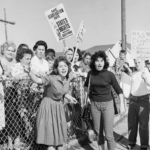 In its landmark decision in Brown v Board of Education, the U.S. Supreme Court unanimously rules that segregation in public education is unconstitutional, overturning the "separate but equal" doctrine in place since 1896, and sparking massive resistance among white Americans committed to racial inequality. The Brown decision signaled the start of a massive cultural shift in racial dynamics in the U.S., and also launched an organized mass movement of opposition. Learn more. In its landmark decision in Brown v Board of Education, the U.S. Supreme Court unanimously rules that segregation in public education is unconstitutional, overturning the "separate but equal" doctrine in place since 1896, and sparking massive resistance among white Americans committed to racial inequality. The Brown decision signaled the start of a massive cultural shift in racial dynamics in the U.S., and also launched an organized mass movement of opposition. Learn more. | |
| May 17, 1980 |  After less than three hours of deliberation, an all-white six-man jury acquits four Dade County Public Safety Department officers on all charges, including evidence tampering, in the death of Arthur McDuffie (December 3, 1946 – December 21, 1979), a black insurance salesman and United States Marine Corps lance corporal. McDuffie was beaten to death by four police officers after a traffic stop. The verdicts provoked a 3-day riot. Learn more. After less than three hours of deliberation, an all-white six-man jury acquits four Dade County Public Safety Department officers on all charges, including evidence tampering, in the death of Arthur McDuffie (December 3, 1946 – December 21, 1979), a black insurance salesman and United States Marine Corps lance corporal. McDuffie was beaten to death by four police officers after a traffic stop. The verdicts provoked a 3-day riot. Learn more. | |
| May 17, 1988 |  Patricia Era Bath, a prominent ophthalmologist and innovative research and laser scientist, receives a patent for her invention of the Laserphaco Probe and the associated new technique used for cataract surgery. The device and procedure restored the sight of thousands of patients worldwide and was the only one available for the removal of cataracts. The invention and Bath’s many other significant contributions changed the field of ophthalmology. Learn more. Patricia Era Bath, a prominent ophthalmologist and innovative research and laser scientist, receives a patent for her invention of the Laserphaco Probe and the associated new technique used for cataract surgery. The device and procedure restored the sight of thousands of patients worldwide and was the only one available for the removal of cataracts. The invention and Bath’s many other significant contributions changed the field of ophthalmology. Learn more. | |
| May 18, 1893 | 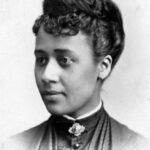 Anna Julia Cooper delivers an address at the World’s Congress of Representative Women meeting in Chicago. Cooper’s speech to the predominately white audience described the progress of African American women since slavery and proclaimed, “women’s cause is one and universal”. Cooper was born into slavery in North Carolina in 1858, she earned B.A. and M.A. degrees at Oberlin and in 1925 at that age of 67 she received a Ph.D. at the Sorbonne in Paris. Cooper spent much of her career at an instructor of Latin and mathematics at M Street (later Dunbar) High School in Washington, D.C. She died in 1964. Read the text of Cooper’s speech. Anna Julia Cooper delivers an address at the World’s Congress of Representative Women meeting in Chicago. Cooper’s speech to the predominately white audience described the progress of African American women since slavery and proclaimed, “women’s cause is one and universal”. Cooper was born into slavery in North Carolina in 1858, she earned B.A. and M.A. degrees at Oberlin and in 1925 at that age of 67 she received a Ph.D. at the Sorbonne in Paris. Cooper spent much of her career at an instructor of Latin and mathematics at M Street (later Dunbar) High School in Washington, D.C. She died in 1964. Read the text of Cooper’s speech. | |
| May 18, 1896 | 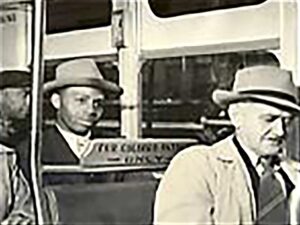 The U.S. Supreme Court issues it’s landmark decision in Plessy v. Ferguson, codifying a doctrine supporting racial segregation laws. In the eyes of the court as long as the segregated facilities were equal in quality, African-Americans could be served separately from the white population. The decision of the court is more commonly known as "separate but equal". In rationalizing it’s 7-1 ruling, the court stated that although the Fourteenth Amendment established the legal equality of whites and blacks it did not and could not require the elimination of all "distinctions based upon color". Justice John Marshall Harlan was the only justice who contradicted the Court's decision. Harlan now known as the "Great Dissenter" wrote " the Constitution is color-blind, and neither knows nor tolerates classes among citizens". The Plessy decision legitimized the many state laws seeking to re-establish white supremacy in the former Confederate States after the end of Reconstruction (1866-1877) and is widely regarded as one of the worst decisions in U.S. Supreme Court history. Learn more. The U.S. Supreme Court issues it’s landmark decision in Plessy v. Ferguson, codifying a doctrine supporting racial segregation laws. In the eyes of the court as long as the segregated facilities were equal in quality, African-Americans could be served separately from the white population. The decision of the court is more commonly known as "separate but equal". In rationalizing it’s 7-1 ruling, the court stated that although the Fourteenth Amendment established the legal equality of whites and blacks it did not and could not require the elimination of all "distinctions based upon color". Justice John Marshall Harlan was the only justice who contradicted the Court's decision. Harlan now known as the "Great Dissenter" wrote " the Constitution is color-blind, and neither knows nor tolerates classes among citizens". The Plessy decision legitimized the many state laws seeking to re-establish white supremacy in the former Confederate States after the end of Reconstruction (1866-1877) and is widely regarded as one of the worst decisions in U.S. Supreme Court history. Learn more. | |
| May 19, 1918 | 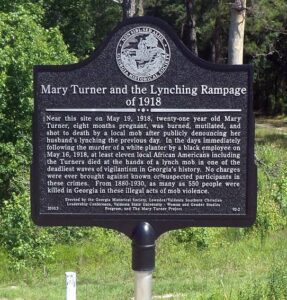 Mary Turner, a Black woman who was eight months pregnant, was lynched by a white mob from Brooks County, Georgia, at Folsom’s Bridge 16 miles north of Valdosta for speaking publicly against the lynching of her husband the day before. A white mob bound her feet, hanged her from a tree with her head facing down, threw gasoline on her, and burned the clothes off her body. Mrs. Turner was still alive when the mob took a large butcher’s knife to her abdomen, cutting the unborn baby from her body. When the baby fell from Mary Turner, a member of the mob crushed the crying baby’s head with his foot. The mob then riddled Mrs. Turner’s body with hundreds of bullets, killing her. No member of the mob was ever held accountable for the lynching of Mary Turner and her unborn baby. The grotesque slaughter of a Black woman eight months pregnant reveals a great deal about the way in which Black women were dehumanized with impunity. Learn more. Mary Turner, a Black woman who was eight months pregnant, was lynched by a white mob from Brooks County, Georgia, at Folsom’s Bridge 16 miles north of Valdosta for speaking publicly against the lynching of her husband the day before. A white mob bound her feet, hanged her from a tree with her head facing down, threw gasoline on her, and burned the clothes off her body. Mrs. Turner was still alive when the mob took a large butcher’s knife to her abdomen, cutting the unborn baby from her body. When the baby fell from Mary Turner, a member of the mob crushed the crying baby’s head with his foot. The mob then riddled Mrs. Turner’s body with hundreds of bullets, killing her. No member of the mob was ever held accountable for the lynching of Mary Turner and her unborn baby. The grotesque slaughter of a Black woman eight months pregnant reveals a great deal about the way in which Black women were dehumanized with impunity. Learn more. | |
| May 19, 1925 | 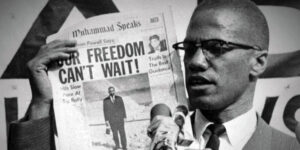 Malcolm X is born as “Malcolm Little”. Intelligent, articulate, charismatic, and driven, he left an indelible imprint on millions of individuals and the world. Learn more. Malcolm X is born as “Malcolm Little”. Intelligent, articulate, charismatic, and driven, he left an indelible imprint on millions of individuals and the world. Learn more. | |
| May 19, 1930 | 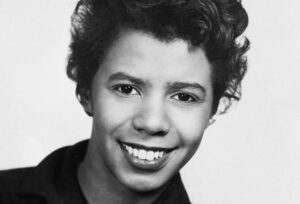 Esteemed playwright Lorraine Hansberry is born. Learn more. Esteemed playwright Lorraine Hansberry is born. Learn more. | |
| May 20, 1893 | 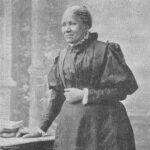 African American abolitionist, suffragist, poet, teacher, public speaker, and writer (one of the first African American women to be published in the United States) Frances Ellen Watkins Harper delivers a speech titled “Woman’s Political Future” before the World’s Congress of Representative Women, meeting in their conference in Chicago, Illinois. Read the transcript. African American abolitionist, suffragist, poet, teacher, public speaker, and writer (one of the first African American women to be published in the United States) Frances Ellen Watkins Harper delivers a speech titled “Woman’s Political Future” before the World’s Congress of Representative Women, meeting in their conference in Chicago, Illinois. Read the transcript. | |
| May 20, 1961 | 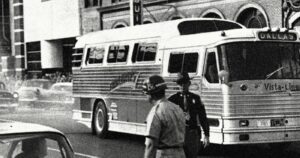 Freedom Riders traveling by bus through the South to challenge segregation laws are brutally attacked by a white mob at the Montgomery, Alabama, downtown Greyhound Station. Several days before, on May 16, the Riders faced mob violence in Birmingham so serious that it threatened to prematurely end the campaign. Montgomery Public Safety Commissioner L.B. Sullivan had promised the Ku Klux Klan several minutes to attack the riders without police interference and, upon arrival, the Riders were met by a mob of several hundred angry white people armed with baseball bats, hammers, and pipes. Montgomery police watched as the mob first attacked reporters and then turned on the Riders. Ignored by ambulances, two injured Riders were saved by good samaritans who transported them to nearby hospitals. Learn more. Freedom Riders traveling by bus through the South to challenge segregation laws are brutally attacked by a white mob at the Montgomery, Alabama, downtown Greyhound Station. Several days before, on May 16, the Riders faced mob violence in Birmingham so serious that it threatened to prematurely end the campaign. Montgomery Public Safety Commissioner L.B. Sullivan had promised the Ku Klux Klan several minutes to attack the riders without police interference and, upon arrival, the Riders were met by a mob of several hundred angry white people armed with baseball bats, hammers, and pipes. Montgomery police watched as the mob first attacked reporters and then turned on the Riders. Ignored by ambulances, two injured Riders were saved by good samaritans who transported them to nearby hospitals. Learn more. | |
| May 21, 1856 | 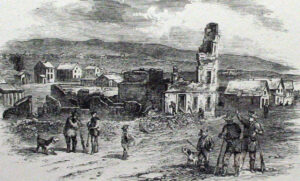 Pro-slavery settlers, led by Douglas County Sheriff Samuel J. Jones, attack and ransack Lawrence, Kansas, a town founded by anti-slavery settlers from Massachusetts who were hoping to make Kansas a free state. The incident, which became known as the Sacking of Lawrence, fueled the irregular conflict in Kansas Territory that later became known as Bleeding Kansas. The human cost of the attack was low: only one person—a member of the proslavery gang—was killed, and his death was accidental. However, Jones and his men halted production of the Free-State newspapers the Kansas Free State and the Herald of Freedom (with the former ceasing publication altogether and the latter taking months to once again start up). The pro-slavery men also destroyed the Free State Hotel and Charles L. Robinson's (first governor of Kansas) house. Learn more. Pro-slavery settlers, led by Douglas County Sheriff Samuel J. Jones, attack and ransack Lawrence, Kansas, a town founded by anti-slavery settlers from Massachusetts who were hoping to make Kansas a free state. The incident, which became known as the Sacking of Lawrence, fueled the irregular conflict in Kansas Territory that later became known as Bleeding Kansas. The human cost of the attack was low: only one person—a member of the proslavery gang—was killed, and his death was accidental. However, Jones and his men halted production of the Free-State newspapers the Kansas Free State and the Herald of Freedom (with the former ceasing publication altogether and the latter taking months to once again start up). The pro-slavery men also destroyed the Free State Hotel and Charles L. Robinson's (first governor of Kansas) house. Learn more. | |
| May 21, 1904 | 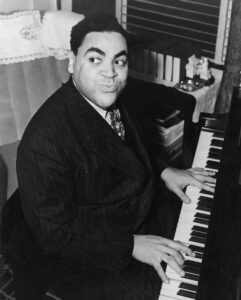 Legendary jazz pianist, organist, composer, violinist, singer, and comedic entertainer Thomas Wright "Fats" Waller is born. His innovations in the Harlem stride style laid the groundwork for modern jazz piano. His best-known compositions, "Ain't Misbehavin'" and "Honeysuckle Rose", were inducted into the Grammy Hall of Fame in 1984 and 1999. Waller copyrighted over 400 songs, many of them co-written with his closest collaborator, Andy Razaf. Razaf described his partner as "the soul of melody... a man who made the piano sing... both big in body and in mind... known for his generosity... a bubbling bundle of joy". In 1938, Waller was one of the first African Americans to purchase a home in the Addisleigh Park section of St. Albans, Queens, a New York City community with racially restrictive covenants. After his purchase, and litigation in the New York State courts, many prosperous African Americans followed, including many jazz artists, such as Count Basie, Lena Horne, Ella Fitzgerald, and Milt Hinton. Learn more. Legendary jazz pianist, organist, composer, violinist, singer, and comedic entertainer Thomas Wright "Fats" Waller is born. His innovations in the Harlem stride style laid the groundwork for modern jazz piano. His best-known compositions, "Ain't Misbehavin'" and "Honeysuckle Rose", were inducted into the Grammy Hall of Fame in 1984 and 1999. Waller copyrighted over 400 songs, many of them co-written with his closest collaborator, Andy Razaf. Razaf described his partner as "the soul of melody... a man who made the piano sing... both big in body and in mind... known for his generosity... a bubbling bundle of joy". In 1938, Waller was one of the first African Americans to purchase a home in the Addisleigh Park section of St. Albans, Queens, a New York City community with racially restrictive covenants. After his purchase, and litigation in the New York State courts, many prosperous African Americans followed, including many jazz artists, such as Count Basie, Lena Horne, Ella Fitzgerald, and Milt Hinton. Learn more. | |
| May 21, 1961 | 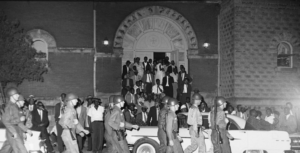 In the evening, a white mob terrorizes 1,000 Black worshippers inside a church in Montgomery, AL. The white rioters began by surrounding the church and vandalizing parked cars, but ramped up the violence as their numbers grew, pelting US Marshalls with bricks and bottles, overturning cars, attacking Black homes with bullets and firebombs, and assaulting Black people in the streets. Learn more. In the evening, a white mob terrorizes 1,000 Black worshippers inside a church in Montgomery, AL. The white rioters began by surrounding the church and vandalizing parked cars, but ramped up the violence as their numbers grew, pelting US Marshalls with bricks and bottles, overturning cars, attacking Black homes with bullets and firebombs, and assaulting Black people in the streets. Learn more. | |
| May 22, 1863 | 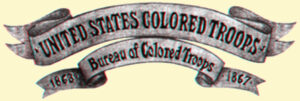 The United States War Department creates the Bureau of Colored Troops under General Order No. 143, during the Civil War, to handle "all matters relating to the organization of colored troops." Major Charles W. Foster was chief of the Bureau, which reported to Adjutant General Lorenzo Thomas. The designation United States Colored Troops replaced the varied state titles that had been given to African-American soldiers. Learn more. The United States War Department creates the Bureau of Colored Troops under General Order No. 143, during the Civil War, to handle "all matters relating to the organization of colored troops." Major Charles W. Foster was chief of the Bureau, which reported to Adjutant General Lorenzo Thomas. The designation United States Colored Troops replaced the varied state titles that had been given to African-American soldiers. Learn more. | |
| May 22, 1872 | 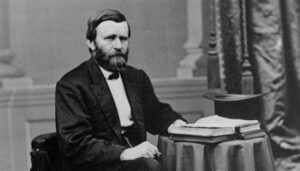 President Ulysses Grant signs the Amnesty Act of 1872 ending — without precondition — office-holding disqualifications against most Confederate leaders and other former civil and military officials who had rebelled against the Union in the Civil War. When Reconstruction ended five years later in 1877 and federal troops left the region, these people who had so recently fought to maintain white supremacy and retain slavery were well-positioned to seize control of their state governments and orchestrate laws and policies to suppress the new civil rights of Black people. Learn more. President Ulysses Grant signs the Amnesty Act of 1872 ending — without precondition — office-holding disqualifications against most Confederate leaders and other former civil and military officials who had rebelled against the Union in the Civil War. When Reconstruction ended five years later in 1877 and federal troops left the region, these people who had so recently fought to maintain white supremacy and retain slavery were well-positioned to seize control of their state governments and orchestrate laws and policies to suppress the new civil rights of Black people. Learn more. | |
| May 23, 1796 | 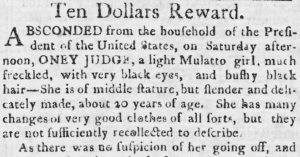 A newspaper ad was placed seeking the return of Ona “Oney” Judge, an enslaved Black woman who had “absconded from the household of the President of the United States,” George Washington. Ms. Judge had successfully escaped enslavement two days earlier, fleeing Philadelphia, Pennsylvania, and settling in freedom in New Hampshire. The Washingtons offered a $10 reward for Ms. Judge's return to bondage—but she evaded capture, married, had several children, and lived for more than 50 years as a free woman in New Hampshire until her death. The extensive efforts of the Washingtons to apprehend Ms. Judge and to gift her to Mrs. Washington's daughter for the full remainder of Ms. Judge's life, belies revisionist claims that there existed a consensus among the founders that slavery should naturally diminish over over time. Learn more. A newspaper ad was placed seeking the return of Ona “Oney” Judge, an enslaved Black woman who had “absconded from the household of the President of the United States,” George Washington. Ms. Judge had successfully escaped enslavement two days earlier, fleeing Philadelphia, Pennsylvania, and settling in freedom in New Hampshire. The Washingtons offered a $10 reward for Ms. Judge's return to bondage—but she evaded capture, married, had several children, and lived for more than 50 years as a free woman in New Hampshire until her death. The extensive efforts of the Washingtons to apprehend Ms. Judge and to gift her to Mrs. Washington's daughter for the full remainder of Ms. Judge's life, belies revisionist claims that there existed a consensus among the founders that slavery should naturally diminish over over time. Learn more. | |
| May 23, 1857 | 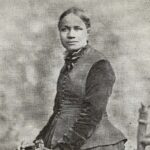 Former teacher, acclaimed novelist and poet, and tireless abolitionist and speaker for the Maine Anti-Slavery Society, Frances Ellen Watkins delivers an address titled "Liberty for Slaves" in which she eloquently calls for the abolition of slavery in the United States. Read the transcript of her speech. Former teacher, acclaimed novelist and poet, and tireless abolitionist and speaker for the Maine Anti-Slavery Society, Frances Ellen Watkins delivers an address titled "Liberty for Slaves" in which she eloquently calls for the abolition of slavery in the United States. Read the transcript of her speech. | |
| May 23, 1917 | 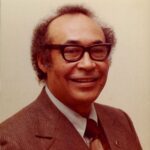 Cornelius Lacy Golightly PhD, philosopher, public intellectual, teacher, civil rights activist, educational administrator, the first Black philosopher permanently hired to teach at a white institution during the 20th century, and the first Black president of the Detroit Board of Education is born. He was the grandchild of formerly enslaved people. Dr. Golightly earned a bachelors degree from Talladega College in Alabama and masters degree and PdD from the University of Michigan. Learn more. Cornelius Lacy Golightly PhD, philosopher, public intellectual, teacher, civil rights activist, educational administrator, the first Black philosopher permanently hired to teach at a white institution during the 20th century, and the first Black president of the Detroit Board of Education is born. He was the grandchild of formerly enslaved people. Dr. Golightly earned a bachelors degree from Talladega College in Alabama and masters degree and PdD from the University of Michigan. Learn more. | |
| May 23, 1918 | 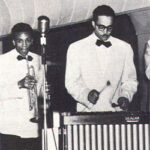 Musician, producer, and composer who worked with the top names in early jazz and rock and roll, Robert “Bumps” Blackwell is born in Seattle, Washington. By the late 1940s his Seattle-based “Bumps Blackwell Junior Band” featured Ray Charles and Quincy Jones, and played with artists like Billie Holiday, Cab Calloway, and Billy Eckstine. Bumps wrote or co-wrote early rock hits including “Good Golly Miss Molly,” “Long Tall Sally,” and “Rip It Up.” Blackwell produced Sam Cooke's hit “You Send Me”, the first #1 hit by a solo black artist. He went on to garner 17 Gold Records while producing a variety of artists including Sly Stone, Lou Rawls, the Fifth Dimension, the Chambers Brothers, the Five Blind Boys of Alabama, the Coasters, Ike and Tina Turner, and Bob Dylan. Learn more. Musician, producer, and composer who worked with the top names in early jazz and rock and roll, Robert “Bumps” Blackwell is born in Seattle, Washington. By the late 1940s his Seattle-based “Bumps Blackwell Junior Band” featured Ray Charles and Quincy Jones, and played with artists like Billie Holiday, Cab Calloway, and Billy Eckstine. Bumps wrote or co-wrote early rock hits including “Good Golly Miss Molly,” “Long Tall Sally,” and “Rip It Up.” Blackwell produced Sam Cooke's hit “You Send Me”, the first #1 hit by a solo black artist. He went on to garner 17 Gold Records while producing a variety of artists including Sly Stone, Lou Rawls, the Fifth Dimension, the Chambers Brothers, the Five Blind Boys of Alabama, the Coasters, Ike and Tina Turner, and Bob Dylan. Learn more. | |
| May 23, 1970 |  Classically trained ballerina Tai Jimenez is born in Jamaica, New York, a neighborhood in the New York City borough of Queens, to Blanche Maria Jimenez, a teacher with a doctorate in education, and Enrique Jimenez. Jimenez’s maternal grandparents were immigrants from Trinidad. Jimenez freelanced and also performed with the Dance Theatre of Harlem for 12 years before she became the only Dance Theatre member to make a successful transition to one of the major ballet companies in North America. In January 2006, she joined Boston Ballet as a principal dancer. Learn more. Classically trained ballerina Tai Jimenez is born in Jamaica, New York, a neighborhood in the New York City borough of Queens, to Blanche Maria Jimenez, a teacher with a doctorate in education, and Enrique Jimenez. Jimenez’s maternal grandparents were immigrants from Trinidad. Jimenez freelanced and also performed with the Dance Theatre of Harlem for 12 years before she became the only Dance Theatre member to make a successful transition to one of the major ballet companies in North America. In January 2006, she joined Boston Ballet as a principal dancer. Learn more. | |
| May 24, 1854 | 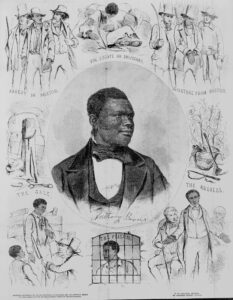 Anthony Burns, who was born enslaved but escaped bondage in 1853, is arrested in Boston under the Fugitive Slave Act of 1850. He was subsequently, tried, convicted, and returned to bondage. The Fugitive Slave Act was despised and fiercely resisted in Boston, and Burns' case attracted national publicity, including large demonstrations, protests, attacks, and violence. Burns’s capture, court case, and extradition led to wide-scale public outcries of injustice, and ultimately, increased opposition to slavery by Northerners. Federal troops were employed to ensure Burns was transported without interference to a ship headed back to Virginia post-trial. Burns was eventually ransomed from slavery, with his freedom purchased by Boston sympathizers. Afterwards, he was educated at Oberlin Collegiate Institute and became a Baptist preacher, moving to Upper Canada for a position, where he remained until his death. Learn more. Anthony Burns, who was born enslaved but escaped bondage in 1853, is arrested in Boston under the Fugitive Slave Act of 1850. He was subsequently, tried, convicted, and returned to bondage. The Fugitive Slave Act was despised and fiercely resisted in Boston, and Burns' case attracted national publicity, including large demonstrations, protests, attacks, and violence. Burns’s capture, court case, and extradition led to wide-scale public outcries of injustice, and ultimately, increased opposition to slavery by Northerners. Federal troops were employed to ensure Burns was transported without interference to a ship headed back to Virginia post-trial. Burns was eventually ransomed from slavery, with his freedom purchased by Boston sympathizers. Afterwards, he was educated at Oberlin Collegiate Institute and became a Baptist preacher, moving to Upper Canada for a position, where he remained until his death. Learn more. | |
| May 24, 1887 | 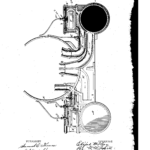 Prolific inventor Elijah J. McCoy receives US patent number 363,529 (one of his 57 US patents) for his improvement of lubricators for steam slide-valves of locomotive-engines. Learn more. Prolific inventor Elijah J. McCoy receives US patent number 363,529 (one of his 57 US patents) for his improvement of lubricators for steam slide-valves of locomotive-engines. Learn more. | |
| May 24, 1961 | 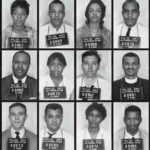 Twenty-seven Freedom Riders (civil rights activists who rode interstate buses into the segregated Southern United States in 1961 and subsequent years to challenge the non-enforcement of Supreme Court decisions that ruled segregated public buses unconstitutional) arrive in Jackson, Mississippi without incident, but are immediately arrested (the first of many Freedom Riders who will fill area jails in coming days and weeks) when they attempt to use the white-only facilities at the Tri-State Trailways depot. Learn more. Twenty-seven Freedom Riders (civil rights activists who rode interstate buses into the segregated Southern United States in 1961 and subsequent years to challenge the non-enforcement of Supreme Court decisions that ruled segregated public buses unconstitutional) arrive in Jackson, Mississippi without incident, but are immediately arrested (the first of many Freedom Riders who will fill area jails in coming days and weeks) when they attempt to use the white-only facilities at the Tri-State Trailways depot. Learn more. | |
| May 24, 2013 |  Federal District Court Judge G. Murray Snow rules that the Maricopa County Arizona Sheriff’s Office (MCSO), led by Sheriff Joe Arpaio, violated the Fourth and Fourteenth Amendments to the Constitution by conducting raids and traffic stops that targeted Latinos based on race. The order enjoined the MCSO from using race as a factor in law enforcement decision-making. Sheriff Arpaio was later convicted of contempt in 2017 for violating Judge Snow's orders against racial profiling -- but never faced any punishment. Two months after his conviction, and before his sentencing, Sheriff Arpaio received an executive pardon from President Donald Trump. Learn more. Federal District Court Judge G. Murray Snow rules that the Maricopa County Arizona Sheriff’s Office (MCSO), led by Sheriff Joe Arpaio, violated the Fourth and Fourteenth Amendments to the Constitution by conducting raids and traffic stops that targeted Latinos based on race. The order enjoined the MCSO from using race as a factor in law enforcement decision-making. Sheriff Arpaio was later convicted of contempt in 2017 for violating Judge Snow's orders against racial profiling -- but never faced any punishment. Two months after his conviction, and before his sentencing, Sheriff Arpaio received an executive pardon from President Donald Trump. Learn more. | |
| May 25, 1849 | 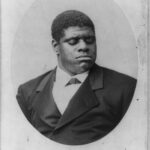 Blind musical prodigy, Thomas "Blind Tom" Wiggins is born into slavery. He had numerous original compositions published and had a lengthy and largely successful performing career throughout the United States. During the 19th century, he was one of the best-known American performing pianists and one of the best-known African-American musicians. He reportedly knew 7,000 pieces of music, including hymns, popular songs, waltzes, and classical repertoire. Learn more. Blind musical prodigy, Thomas "Blind Tom" Wiggins is born into slavery. He had numerous original compositions published and had a lengthy and largely successful performing career throughout the United States. During the 19th century, he was one of the best-known American performing pianists and one of the best-known African-American musicians. He reportedly knew 7,000 pieces of music, including hymns, popular songs, waltzes, and classical repertoire. Learn more. | |
| May 25, 1943 |  At the Alabama Dry Dock Shipping Company, four thousand white workers armed with pipes, clubs, and other dangerous weapons attack any Black employee they can find after 12 Black workers (of 7,000 Black workers, of 50,000 total workers) are promoted to welder, a position previously reserved only for white workers. Although no one was killed, more than 50 people were seriously injured, and several weeks passed before African American workers could safely return to work. Learn more. At the Alabama Dry Dock Shipping Company, four thousand white workers armed with pipes, clubs, and other dangerous weapons attack any Black employee they can find after 12 Black workers (of 7,000 Black workers, of 50,000 total workers) are promoted to welder, a position previously reserved only for white workers. Although no one was killed, more than 50 people were seriously injured, and several weeks passed before African American workers could safely return to work. Learn more. | |
| May 25, 1943 | 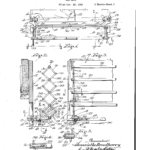 Henrietta Bradberry receives U.S. patent number 2,320,027 for her bed rack invention. Learn more. Henrietta Bradberry receives U.S. patent number 2,320,027 for her bed rack invention. Learn more. | |
| May 25, 2020 |  George Perry Floyd Jr. is murdered by police during an arrest after a store clerk suspected he may have used a counterfeit $20 bill in Minneapolis. Derek Chauvin, one of four police officers who arrived on the scene, knelt on Floyd's neck and back for 9 minutes and 29 seconds. After his death, protests against police brutality, especially towards black people, quickly spread across the United States and globally. As he was dying he said "I can't breathe" which was used as a rallying cry during subsequent protests. Learn more. George Perry Floyd Jr. is murdered by police during an arrest after a store clerk suspected he may have used a counterfeit $20 bill in Minneapolis. Derek Chauvin, one of four police officers who arrived on the scene, knelt on Floyd's neck and back for 9 minutes and 29 seconds. After his death, protests against police brutality, especially towards black people, quickly spread across the United States and globally. As he was dying he said "I can't breathe" which was used as a rallying cry during subsequent protests. Learn more. | |
| May 26, 1845 | 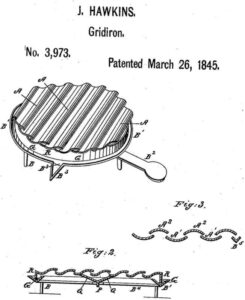 Joseph Hawkins receives a patent for an improved gridiron device (oven racks), allowing different items to be cooked at different level of heat intensity, thus enabling cooks to heat several types of food at once. Learn more. Joseph Hawkins receives a patent for an improved gridiron device (oven racks), allowing different items to be cooked at different level of heat intensity, thus enabling cooks to heat several types of food at once. Learn more. | |
| May 26, 1924 | 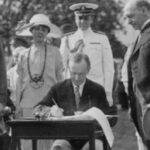 The U.S. government enacts the eugenics-inspired Immigration Act of 1924, which completely prohibited immigration from Asia. Designed to limit all immigration to the U.S., the act was particularly restrictive for Eastern and Southern Europeans and Asians. Upon signing the act into law, President Calvin Coolidge remarked, “America must remain American.” Learn more. The U.S. government enacts the eugenics-inspired Immigration Act of 1924, which completely prohibited immigration from Asia. Designed to limit all immigration to the U.S., the act was particularly restrictive for Eastern and Southern Europeans and Asians. Upon signing the act into law, President Calvin Coolidge remarked, “America must remain American.” Learn more. | |
| May 26, 1965 | 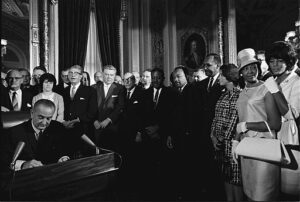 The "Voting Rights Act of 1965", one of the most monumental pieces of civil rights legislation ever enacted in this country, passes in the US Senate on a 77-19 vote. The bill was designed with legal enforcement to insure the voting rights of all Americans guaranteed through the Fourteenth and Fifteenth Amendments to the United States Constitution. It would pass the US House of Representatives in July 1965, and be signed into law by President Johnson in August of that same year. Learn more. The "Voting Rights Act of 1965", one of the most monumental pieces of civil rights legislation ever enacted in this country, passes in the US Senate on a 77-19 vote. The bill was designed with legal enforcement to insure the voting rights of all Americans guaranteed through the Fourteenth and Fifteenth Amendments to the United States Constitution. It would pass the US House of Representatives in July 1965, and be signed into law by President Johnson in August of that same year. Learn more. | |
| May 27, 1861 | 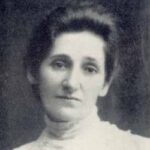 American author, essayist, newspaperwoman, settlement worker, and activist Victoria Earle Matthews (née Ella Victoria Smith) is born into slavery in Fort Valley, Georgia. She moved to New York City with her family after emancipation. There, she briefly attended school and worked as a domestic servant to help her family. As a married woman, Matthews became involved in women's clubs and social work, at a time when the settlement movement started in Great Britain in 1884 and was influencing American social work in major cities. In 1897, Matthews founded the White Rose Industrial Home for Working Class Negro Girls, also known as the White Rose Mission, a settlement house for young Black Women, to provide them with safe housing, education, and life and job skills. Learn more. American author, essayist, newspaperwoman, settlement worker, and activist Victoria Earle Matthews (née Ella Victoria Smith) is born into slavery in Fort Valley, Georgia. She moved to New York City with her family after emancipation. There, she briefly attended school and worked as a domestic servant to help her family. As a married woman, Matthews became involved in women's clubs and social work, at a time when the settlement movement started in Great Britain in 1884 and was influencing American social work in major cities. In 1897, Matthews founded the White Rose Industrial Home for Working Class Negro Girls, also known as the White Rose Mission, a settlement house for young Black Women, to provide them with safe housing, education, and life and job skills. Learn more. | |
| May 27, 1892 | 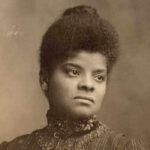 While crusading Black journalist Ida B. Wells is away visiting Philadelphia, a white mob attacks and destroys her newspaper's office in Memphis, Tennessee, and threatens her with bodily harm if she returns to the city. Just months before, in March, three Black men had been lynched in Memphis. In response, Ms. Wells investigated and directly refuted the dominant and wholly false white narrative that lynching was white manhood's appropriate response to the rape of white women by Black men. "Nobody in this section of the country," she wrote, "believes the old threadbare lie that Negro men rape white women." Immediately, Memphis's white newspapers denounced Ms. Wells's editorial, deriding her as a "Black scoundrel" and fanning local white outrage. Just days later, the white mob attacked her newspaper and warned that she would be killed if she returned to the city. Learn more. While crusading Black journalist Ida B. Wells is away visiting Philadelphia, a white mob attacks and destroys her newspaper's office in Memphis, Tennessee, and threatens her with bodily harm if she returns to the city. Just months before, in March, three Black men had been lynched in Memphis. In response, Ms. Wells investigated and directly refuted the dominant and wholly false white narrative that lynching was white manhood's appropriate response to the rape of white women by Black men. "Nobody in this section of the country," she wrote, "believes the old threadbare lie that Negro men rape white women." Immediately, Memphis's white newspapers denounced Ms. Wells's editorial, deriding her as a "Black scoundrel" and fanning local white outrage. Just days later, the white mob attacked her newspaper and warned that she would be killed if she returned to the city. Learn more. | |
| May 27, 1942 | 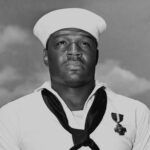 United States Navy cook third class Doris "Dorie" Miller is personally recognized by Admiral Chester W. Nimitz, Commander in Chief, Pacific Fleet, aboard the aircraft carrier Enterprise (CV-6) at anchor in Pearl Harbor, where Nimitz presented Miller with the Navy Cross, the first black American to be awarded the Navy Cross, the second highest decoration for valor in combat. Miller earned the award for his heroic actions during the surprise attack on Pearl Harbor in December 7, 1941. Miller was serving aboard the battleship West Virginia, which was sunk by Japanese torpedo bombers during the attack. He helped several sailors who were wounded, including the seriously wounded captain of the ship, and while manning an anti-aircraft machine gun for which he had no training, he shot down Japanese planes. In November 1943, Miller was killed while serving aboard the aircraft carrier Liscome Bay when it was sunk by a Japanese submarine during the Battle of Makin in the Gilbert Islands. The destroyer escort/Knox-class frigate USS Miller (reclassified as a frigate in June 1975), in service from 1973 to 1991, was named after him. On January 19, 2020, the Navy announced that a Gerald R. Ford–class nuclear powered aircraft carrier, CVN-81, would be named after Miller. The ship is scheduled to be laid down in 2023 and launched in 2028. Learn more. United States Navy cook third class Doris "Dorie" Miller is personally recognized by Admiral Chester W. Nimitz, Commander in Chief, Pacific Fleet, aboard the aircraft carrier Enterprise (CV-6) at anchor in Pearl Harbor, where Nimitz presented Miller with the Navy Cross, the first black American to be awarded the Navy Cross, the second highest decoration for valor in combat. Miller earned the award for his heroic actions during the surprise attack on Pearl Harbor in December 7, 1941. Miller was serving aboard the battleship West Virginia, which was sunk by Japanese torpedo bombers during the attack. He helped several sailors who were wounded, including the seriously wounded captain of the ship, and while manning an anti-aircraft machine gun for which he had no training, he shot down Japanese planes. In November 1943, Miller was killed while serving aboard the aircraft carrier Liscome Bay when it was sunk by a Japanese submarine during the Battle of Makin in the Gilbert Islands. The destroyer escort/Knox-class frigate USS Miller (reclassified as a frigate in June 1975), in service from 1973 to 1991, was named after him. On January 19, 2020, the Navy announced that a Gerald R. Ford–class nuclear powered aircraft carrier, CVN-81, would be named after Miller. The ship is scheduled to be laid down in 2023 and launched in 2028. Learn more. | |
| May 27, 1958 | 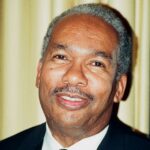 Ernest Gideon Green, one of the Little Rock Nine (a group of African-American students who, in 1957, were the first Black students ever to attend classes at Little Rock Central High School) becomes the first African-American to graduate from Little Rock Central High School in Little Rock, Arkansas. Martin Luther King Jr., who was in Arkansas to speak at Arkansas Agriculture Mechanical and Normal College’s commencement in Pine Bluff, attended the graduation with the Green family. Green attended Michigan State University as the beneficiary of a scholarship provided by an anonymous donor. While at Michigan State, Green continued to engage in activism and protests supporting the Civil Rights Movement. He later learned the anonymous donor was John A. Hannah, the president of Michigan State, and an occasional target of protests by civil rights activists including Green. Green graduated with a Bachelor of Arts in 1962 and a Master's degree in sociology in 1964. In 1999, Green and the other members of the Little Rock Nine were awarded the Congressional Gold Medal by President Bill Clinton. Learn more. Ernest Gideon Green, one of the Little Rock Nine (a group of African-American students who, in 1957, were the first Black students ever to attend classes at Little Rock Central High School) becomes the first African-American to graduate from Little Rock Central High School in Little Rock, Arkansas. Martin Luther King Jr., who was in Arkansas to speak at Arkansas Agriculture Mechanical and Normal College’s commencement in Pine Bluff, attended the graduation with the Green family. Green attended Michigan State University as the beneficiary of a scholarship provided by an anonymous donor. While at Michigan State, Green continued to engage in activism and protests supporting the Civil Rights Movement. He later learned the anonymous donor was John A. Hannah, the president of Michigan State, and an occasional target of protests by civil rights activists including Green. Green graduated with a Bachelor of Arts in 1962 and a Master's degree in sociology in 1964. In 1999, Green and the other members of the Little Rock Nine were awarded the Congressional Gold Medal by President Bill Clinton. Learn more. | |
| May 28, 1830 | 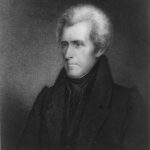 United States President Andrew Jackson signs into law the Indian Removal Act (which he had called for and championed). Although the language of the law authorized the president to “negotiate” with southern (including Mid-Atlantic) Native American tribes for their removal to federal territory west of the Mississippi River in exchange for white settlement of their ancestral lands, it was in fact implemented as brutal forced relocation/ethnic cleansing. The act has been referred to as a unitary act of systematic genocide, because it discriminated against an ethnic group in so far as to make certain the death of vast numbers of its population. The Act was strongly supported by southern and northwestern populations, but was opposed by native tribes and the Whig Party. The Cherokee unsuccessfully resisted and were eventually forcibly removed by the United States government in a march to the west that later became known as the Trail of Tears. This Act was one element of Jackson’s transformation of Jefferson’s pro-states’ rights/pro-slavery party into the virulently white supremacist-dominated Democratic Party of the 19th and early 20th centuries. It was not until LBJ's embrace and support for the Civil Rights Movement in the 1960s, that the Democratic Party shed its white supremacist legacy as well as its political dominance. Learn more. United States President Andrew Jackson signs into law the Indian Removal Act (which he had called for and championed). Although the language of the law authorized the president to “negotiate” with southern (including Mid-Atlantic) Native American tribes for their removal to federal territory west of the Mississippi River in exchange for white settlement of their ancestral lands, it was in fact implemented as brutal forced relocation/ethnic cleansing. The act has been referred to as a unitary act of systematic genocide, because it discriminated against an ethnic group in so far as to make certain the death of vast numbers of its population. The Act was strongly supported by southern and northwestern populations, but was opposed by native tribes and the Whig Party. The Cherokee unsuccessfully resisted and were eventually forcibly removed by the United States government in a march to the west that later became known as the Trail of Tears. This Act was one element of Jackson’s transformation of Jefferson’s pro-states’ rights/pro-slavery party into the virulently white supremacist-dominated Democratic Party of the 19th and early 20th centuries. It was not until LBJ's embrace and support for the Civil Rights Movement in the 1960s, that the Democratic Party shed its white supremacist legacy as well as its political dominance. Learn more. | |
| May 28, 1934 | 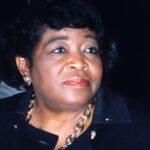 American educator and civil rights advocate Betty Shabazz (originally Betty Dean Sanders), also known as Betty X is born. She was married to Malcolm X. Shabazz grew up in Detroit, Michigan, where her foster parents largely sheltered her from racism. She attended the Tuskegee Institute in Alabama, where she had her first encounters with racism. Unhappy with the situation in Alabama, she moved to New York City, where she became a nurse. It was there that she met Malcolm X and, in 1956, joined the Nation of Islam. The couple married in 1958. Along with her husband, Shabazz left the Nation of Islam in 1964. She witnessed his assassination the following year. Left with the responsibility of raising six daughters as a widow, Shabazz pursued higher education, and went to work at Medgar Evers College in Brooklyn, New York. Learn more. American educator and civil rights advocate Betty Shabazz (originally Betty Dean Sanders), also known as Betty X is born. She was married to Malcolm X. Shabazz grew up in Detroit, Michigan, where her foster parents largely sheltered her from racism. She attended the Tuskegee Institute in Alabama, where she had her first encounters with racism. Unhappy with the situation in Alabama, she moved to New York City, where she became a nurse. It was there that she met Malcolm X and, in 1956, joined the Nation of Islam. The couple married in 1958. Along with her husband, Shabazz left the Nation of Islam in 1964. She witnessed his assassination the following year. Left with the responsibility of raising six daughters as a widow, Shabazz pursued higher education, and went to work at Medgar Evers College in Brooklyn, New York. Learn more. | |
| May 28, 1943 | 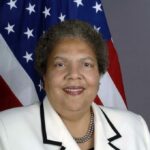 United States diplomat and 24th Director General of the United States Foreign Service, Ruth A. Davis is born. She is the first woman of color to have been appointed as Director General of the Foreign Service and the first African-American Director of the Foreign Service Institute. In 2002, she became a career member of the Senior Foreign Service and a Career Ambassador. She was the Chief of Staff of the Africa Bureau of the U.S. Department of State. Described as a "Diplomatic Pioneer", Davis worked diligently to increase diversity among the ranks of the international diplomatic corps and successfully attracted more diverse people into the Foreign Service. In 2016 Davis was presented the Lifetime Contributions to American Diplomacy Award by the American Foreign Service Association. Learn more. United States diplomat and 24th Director General of the United States Foreign Service, Ruth A. Davis is born. She is the first woman of color to have been appointed as Director General of the Foreign Service and the first African-American Director of the Foreign Service Institute. In 2002, she became a career member of the Senior Foreign Service and a Career Ambassador. She was the Chief of Staff of the Africa Bureau of the U.S. Department of State. Described as a "Diplomatic Pioneer", Davis worked diligently to increase diversity among the ranks of the international diplomatic corps and successfully attracted more diverse people into the Foreign Service. In 2016 Davis was presented the Lifetime Contributions to American Diplomacy Award by the American Foreign Service Association. Learn more. | |
| May 28, 1947 | 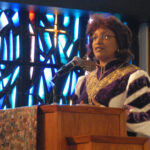 Bishop of the African Methodist Episcopal Church, and author of six books, Vashti Murphy McKenzie is born. In 2000, McKenzie became the first woman to be elected as bishop in the denomination's history. She later served as President of the Council of Bishops, becoming the first woman to serve as Titular head of the AME Church. Learn more. Bishop of the African Methodist Episcopal Church, and author of six books, Vashti Murphy McKenzie is born. In 2000, McKenzie became the first woman to be elected as bishop in the denomination's history. She later served as President of the Council of Bishops, becoming the first woman to serve as Titular head of the AME Church. Learn more. | |
| May 29, 1851 | 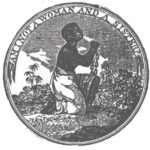 Formerly enslaved abolitionist Sojourner Truth delivers her famous “Ain’t I a Woman?” speech (originally untitled), to the Women's Convention in Akron, Ohio. The speech was briefly reported in two contemporary newspapers, and a transcript of the speech was published in the Anti-Slavery Bugle on June 21, 1851. It received wider publicity in 1863 during the American Civil War when Frances Dana Barker Gage published a different version, at which time it became known as “Ain't I a Woman?” because of its oft-repeated question. This later, better known and more widely available version was the one commonly referenced in popular culture. The speech is considered a critique of single axis analysis of domination, and how an analysis that ignores interlocking identities prevents liberation. Learn more. Formerly enslaved abolitionist Sojourner Truth delivers her famous “Ain’t I a Woman?” speech (originally untitled), to the Women's Convention in Akron, Ohio. The speech was briefly reported in two contemporary newspapers, and a transcript of the speech was published in the Anti-Slavery Bugle on June 21, 1851. It received wider publicity in 1863 during the American Civil War when Frances Dana Barker Gage published a different version, at which time it became known as “Ain't I a Woman?” because of its oft-repeated question. This later, better known and more widely available version was the one commonly referenced in popular culture. The speech is considered a critique of single axis analysis of domination, and how an analysis that ignores interlocking identities prevents liberation. Learn more. | |
| May 29, 1914 | 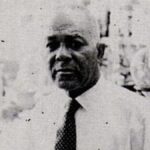 Henry Ransom Cecil McBay, PhD, chemist and educator, is born in Mexia, Texas. He received a Bachelor of Science from Wiley College in 1934 and a Master of Science from Atlanta University in 1936. Dr. McBay earned a Doctor of Philosophy from the University of Chicago in 1945. McBay served as an Instructor of Chemistry at Wiley College and also served as an Instructor at Western University, Kansas City. In 1944 and 1945, he won the Elizabeth Norton prize at the University of Chicago for outstanding research in chemistry. He served as a technical expert on a United Nations Educational Scientific and Cultural Organization mission to Liberia in 1951. He was the first recipient of research funding from George Washington Carver's donation to Tuskegee Institute, for research on extraction of fibers from okra. From 1945 to 1981 Henry McBay was appointed as a teaching faculty at Morehouse College, beginning as an Instructor and advancing to full Professor and served as Chairman of the Department of Chemistry from 1960 to 1981. He was appointed Fuller E. Callaway Professor of Chemistry at Atlanta University in 1982 and became professor emeritus of chemistry at Clark Atlanta University in 1986. Learn more. Henry Ransom Cecil McBay, PhD, chemist and educator, is born in Mexia, Texas. He received a Bachelor of Science from Wiley College in 1934 and a Master of Science from Atlanta University in 1936. Dr. McBay earned a Doctor of Philosophy from the University of Chicago in 1945. McBay served as an Instructor of Chemistry at Wiley College and also served as an Instructor at Western University, Kansas City. In 1944 and 1945, he won the Elizabeth Norton prize at the University of Chicago for outstanding research in chemistry. He served as a technical expert on a United Nations Educational Scientific and Cultural Organization mission to Liberia in 1951. He was the first recipient of research funding from George Washington Carver's donation to Tuskegee Institute, for research on extraction of fibers from okra. From 1945 to 1981 Henry McBay was appointed as a teaching faculty at Morehouse College, beginning as an Instructor and advancing to full Professor and served as Chairman of the Department of Chemistry from 1960 to 1981. He was appointed Fuller E. Callaway Professor of Chemistry at Atlanta University in 1982 and became professor emeritus of chemistry at Clark Atlanta University in 1986. Learn more. | |
| May 29, 1930 | 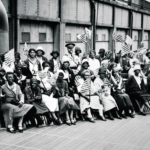 Grieving families of Black veterans killed in World War I are forced to travel separately from white families to visit their loved ones’ graves in France. The U.S. Department of War—which had invited the families of veterans killed during World War I to visit their graves in Europe—denied a petition by Black mothers and spouses to travel on the same ship as white families and instead forced them to travel on segregated boats. This was an extension of the prevailing pattern in which rather than being honored for their service, Black veterans and their families were often the targets of horrible discrimination, mistreatment, and even murder, at the hands of white Americans determined to reinforce white supremacy and to prevent the veterans from fighting for racial equality at home. Learn more. Grieving families of Black veterans killed in World War I are forced to travel separately from white families to visit their loved ones’ graves in France. The U.S. Department of War—which had invited the families of veterans killed during World War I to visit their graves in Europe—denied a petition by Black mothers and spouses to travel on the same ship as white families and instead forced them to travel on segregated boats. This was an extension of the prevailing pattern in which rather than being honored for their service, Black veterans and their families were often the targets of horrible discrimination, mistreatment, and even murder, at the hands of white Americans determined to reinforce white supremacy and to prevent the veterans from fighting for racial equality at home. Learn more. | |
| May 29, 1965 | 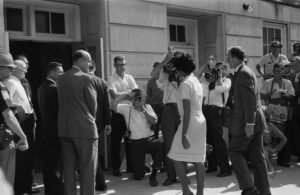 Vivian Juanita Malone Jones graduates from the University of Alabama, the first Black person to do so. In 1963, she and James Hood were the first two Black students to enroll at the University. She was made famous when George Wallace, the Governor of Alabama, attempted to block her and Hood from enrolling at the all-white university. Learn more. Vivian Juanita Malone Jones graduates from the University of Alabama, the first Black person to do so. In 1963, she and James Hood were the first two Black students to enroll at the University. She was made famous when George Wallace, the Governor of Alabama, attempted to block her and Hood from enrolling at the all-white university. Learn more. | |
| May 30, 1854 | 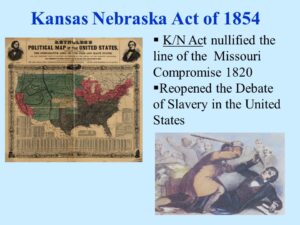 The Kansas-Nebraska Act is signed into law by President Franklin Pierce. The act created the territories of Kansas, Nebraska, Montana, and the Dakotas, but is most notable for repealing the Missouri Compromise and opening the territories to slavery. It’s passage stoked national tensions over slavery and triggered a series of armed conflicts known as "Bleeding Kansas". Learn more. The Kansas-Nebraska Act is signed into law by President Franklin Pierce. The act created the territories of Kansas, Nebraska, Montana, and the Dakotas, but is most notable for repealing the Missouri Compromise and opening the territories to slavery. It’s passage stoked national tensions over slavery and triggered a series of armed conflicts known as "Bleeding Kansas". Learn more. | |
| May 30, 1903 | 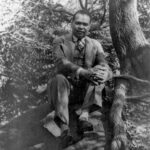 Countee Cullen (born Countee LeRoy Porter), poet, novelist, children's writer, and playwright, particularly well known during the Harlem Renaissance, is born. Cullen graduated from New York University (NYU) in 1925, one of eleven students selected to Phi Beta Kappa that year, and from Harvard University with a master's degree in English in 1926. Cullen’s first collection of poems, Color, was a landmark of the Harlem Renaissance. Learn more. Countee Cullen (born Countee LeRoy Porter), poet, novelist, children's writer, and playwright, particularly well known during the Harlem Renaissance, is born. Cullen graduated from New York University (NYU) in 1925, one of eleven students selected to Phi Beta Kappa that year, and from Harvard University with a master's degree in English in 1926. Cullen’s first collection of poems, Color, was a landmark of the Harlem Renaissance. Learn more. | |
| May 30, 1943 | 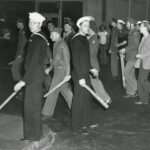 In Los Angeles, California, white soldiers targeted Latino youth in a series of violent attacks that became known as the Zoot Suit Riots. White sailors and soldiers spread throughout Los Angeles attacking any Latino youth wearing zoot suits, beating them with belt buckles and ropes, and stripping them of their clothes. Law enforcement did not intervene in support of the Latino victims and instead charged them with vagrancy. Incidents similar to these riots later occurred in cities throughout the U.S., as white members of the military and white employees of military contractors targeted Black and Latino youth with violence. By one estimate, 242 instances of racial violence occurred in 47 American cities in 1943 alone. Learn more. In Los Angeles, California, white soldiers targeted Latino youth in a series of violent attacks that became known as the Zoot Suit Riots. White sailors and soldiers spread throughout Los Angeles attacking any Latino youth wearing zoot suits, beating them with belt buckles and ropes, and stripping them of their clothes. Law enforcement did not intervene in support of the Latino victims and instead charged them with vagrancy. Incidents similar to these riots later occurred in cities throughout the U.S., as white members of the military and white employees of military contractors targeted Black and Latino youth with violence. By one estimate, 242 instances of racial violence occurred in 47 American cities in 1943 alone. Learn more. | |
| May 30, 1956 | 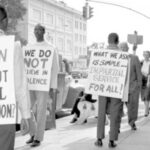 The Tallahassee bus boycott, a citywide boycott in Tallahassee, Florida, begins. The boycott sought to end racial segregation in the employment and seating arrangements of city buses. The boycott was triggered by the actions of two students a few days earlier. On May 26, 1956, Wilhelmina Jakes and Carrie Patterson, two Florida A&M University students, were arrested by the Tallahassee Police Department for "placing themselves in a position to incite a riot", for sitting in “whites-only” seats. Robert Saunders, representing the NAACP, and Rev. C. K. Steele began talks with city authorities while the local African-American community started boycotting the city's buses. The Inter-Civic Council ended the boycott on December 22, 1956. On January 7, 1957, the City Commission repealed the bus-franchise segregation clause because of the United States Supreme Court ruling Browder v. Gayle (1956). Learn more. The Tallahassee bus boycott, a citywide boycott in Tallahassee, Florida, begins. The boycott sought to end racial segregation in the employment and seating arrangements of city buses. The boycott was triggered by the actions of two students a few days earlier. On May 26, 1956, Wilhelmina Jakes and Carrie Patterson, two Florida A&M University students, were arrested by the Tallahassee Police Department for "placing themselves in a position to incite a riot", for sitting in “whites-only” seats. Robert Saunders, representing the NAACP, and Rev. C. K. Steele began talks with city authorities while the local African-American community started boycotting the city's buses. The Inter-Civic Council ended the boycott on December 22, 1956. On January 7, 1957, the City Commission repealed the bus-franchise segregation clause because of the United States Supreme Court ruling Browder v. Gayle (1956). Learn more. | |
| May 31, 1870 | 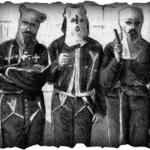 The Enforcement Act of 1870, also known as the Civil Rights Act of 1870 or First Ku Klux Klan Act, or Force Act (41st Congress, Sess. 2, ch. 114, 16 Stat. 140) is enacted. It was a United States federal law that empowered the President to enforce the first section of the Fifteenth Amendment throughout the United States. The act was the first of three Enforcement Acts passed by the United States Congress in 1870 and 1871, during the Reconstruction Era, to combat attacks on the voting rights of African Americans from state officials or violent groups like the Ku Klux Klan. Learn more. The Enforcement Act of 1870, also known as the Civil Rights Act of 1870 or First Ku Klux Klan Act, or Force Act (41st Congress, Sess. 2, ch. 114, 16 Stat. 140) is enacted. It was a United States federal law that empowered the President to enforce the first section of the Fifteenth Amendment throughout the United States. The act was the first of three Enforcement Acts passed by the United States Congress in 1870 and 1871, during the Reconstruction Era, to combat attacks on the voting rights of African Americans from state officials or violent groups like the Ku Klux Klan. Learn more. | |
| May 31, 1921 | 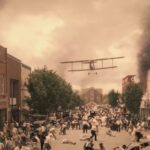 The Tulsa Race Massacre, considered the largest, deadliest, and most destructive incident of mass racial violence in US history, begins. On this and the following day, white mobs attacked (including use of aircraft and firebombs) and totally destroyed the exceptionally prosperous and successful Black community in the Greenwood District in Tulsa, Oklahoma, considered at the time the Black Wall Street. Learn more. The Tulsa Race Massacre, considered the largest, deadliest, and most destructive incident of mass racial violence in US history, begins. On this and the following day, white mobs attacked (including use of aircraft and firebombs) and totally destroyed the exceptionally prosperous and successful Black community in the Greenwood District in Tulsa, Oklahoma, considered at the time the Black Wall Street. Learn more. | |
| May 31, 1924 | 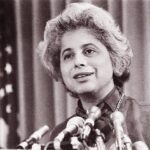 Patricia Roberts Harris is born. She was an American government official and diplomat who served under President Jimmy Carter as United States Secretary of Housing and Urban Development, and United States Secretary of Health, Education, and Welfare (which was renamed the Secretary of Health and Human Services during her tenure). Harris was the first African American woman to serve in the United States Cabinet, and the first to enter the line of succession to the Presidency. She previously served as United States Ambassador to Luxembourgunder President Lyndon B. Johnson, and was the first African-American woman to represent the United States as an ambassador. She was also the first Black American woman to be dean of a law school, and the first to sit on a Fortune 500 company's board of directors. Learn more. Patricia Roberts Harris is born. She was an American government official and diplomat who served under President Jimmy Carter as United States Secretary of Housing and Urban Development, and United States Secretary of Health, Education, and Welfare (which was renamed the Secretary of Health and Human Services during her tenure). Harris was the first African American woman to serve in the United States Cabinet, and the first to enter the line of succession to the Presidency. She previously served as United States Ambassador to Luxembourgunder President Lyndon B. Johnson, and was the first African-American woman to represent the United States as an ambassador. She was also the first Black American woman to be dean of a law school, and the first to sit on a Fortune 500 company's board of directors. Learn more. | |
| May 31, 1930 | 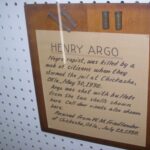 Henry Argo, a 19-year-old Black man, was lynched after a mob of over 1,000 white men and boys as young as 12 stormed the Grady County jail in Chickasha, Oklahoma where he was being held on accusations of raping a white sharecropper’s wife. The African-American community believed Argo did not really did not have the intelligence to understand what he was accused of doing. He was shot in the head and stabbed by members of the mob, despite the presence of the National Guard who were ordered to protect him. Learn more. Henry Argo, a 19-year-old Black man, was lynched after a mob of over 1,000 white men and boys as young as 12 stormed the Grady County jail in Chickasha, Oklahoma where he was being held on accusations of raping a white sharecropper’s wife. The African-American community believed Argo did not really did not have the intelligence to understand what he was accused of doing. He was shot in the head and stabbed by members of the mob, despite the presence of the National Guard who were ordered to protect him. Learn more. | |
| June 1, 1909 | 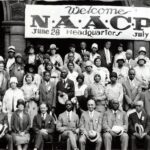 Crusading journalist Ida B. Wells, the most prominent anti-lynching campaigner in the United States, gains a powerful ally for her anti-lynching efforts in the newly formed National Association for the Advancement of Colored People (NAACP), when she delivers a speech entitled, “Lynching, Our National Crime,” at the National Negro Conference in New York City. Read the full speech. Crusading journalist Ida B. Wells, the most prominent anti-lynching campaigner in the United States, gains a powerful ally for her anti-lynching efforts in the newly formed National Association for the Advancement of Colored People (NAACP), when she delivers a speech entitled, “Lynching, Our National Crime,” at the National Negro Conference in New York City. Read the full speech. | |
| June 1, 1921 | 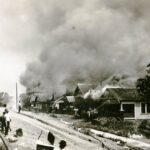 The Tulsa Race Massacre, considered the largest, deadliest, and most destructive incident of mass racial violence in US history, continues into its second (and final) day. White mobs attacked (including use of aircraft and firebombs) and totally destroyed the exceptionally prosperous and successful Black community in the Greenwood District in Tulsa, Oklahoma, considered at the time the Black Wall Street. Learn more. The Tulsa Race Massacre, considered the largest, deadliest, and most destructive incident of mass racial violence in US history, continues into its second (and final) day. White mobs attacked (including use of aircraft and firebombs) and totally destroyed the exceptionally prosperous and successful Black community in the Greenwood District in Tulsa, Oklahoma, considered at the time the Black Wall Street. Learn more. | |
| June 1, 1942 | 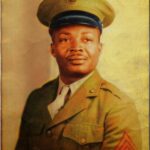 In Oklahoma City, Alfred Masters is sworn in as the first African American United States Marine. He then received his training at the segregated Montford Point training camp. In the Marines, Masters was promoted to the rank of Technical Sergeant. Learn more. In Oklahoma City, Alfred Masters is sworn in as the first African American United States Marine. He then received his training at the segregated Montford Point training camp. In the Marines, Masters was promoted to the rank of Technical Sergeant. Learn more. | |
| June 1, 1966 | 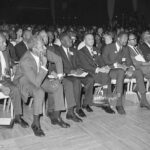 The White House Conference on Civil Rights opens, continuing into June 2. The aim of the conference was to build on the momentum of the Civil Rights Act of 1964 and the Voting Rights Act of 1965 in addressing discrimination against African-Americans. The four areas of discussion were housing, economic security, education, and the administration of justice. There were over 2,400 participants, representing all the major civil rights groups except the Student Nonviolent Coordinating Committee (SNCC), which boycotted the conference. Learn more.
The White House Conference on Civil Rights opens, continuing into June 2. The aim of the conference was to build on the momentum of the Civil Rights Act of 1964 and the Voting Rights Act of 1965 in addressing discrimination against African-Americans. The four areas of discussion were housing, economic security, education, and the administration of justice. There were over 2,400 participants, representing all the major civil rights groups except the Student Nonviolent Coordinating Committee (SNCC), which boycotted the conference. Learn more. | |
| June 2, 1863 | 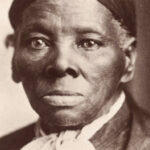 Harriet Tubman — escapee from slavery, abolitionist, agent of the Underground Railroad, Union spy during the Civil War — under the command of Union Colonel James Montgomery, led 150 black Union soldiers in the Combahee River Raid in South Carolina. This was the only Civil War military engagement where a woman was the commander. Tubman, who was already aware of vital information about the location of Confederate torpedoes planted along the river, led Union gunboats to specific areas where fugitive slaves were hiding and waiting to be rescued. Eventually 750 people were liberated from slavery. Some of the men eventually joined the First South Carolina Volunteers, the military regiment established for former slaves in coastal South Carolina in 1862. The Combahee River Raid was a major military and psychological blow to the Confederate cause. Learn more.
Harriet Tubman — escapee from slavery, abolitionist, agent of the Underground Railroad, Union spy during the Civil War — under the command of Union Colonel James Montgomery, led 150 black Union soldiers in the Combahee River Raid in South Carolina. This was the only Civil War military engagement where a woman was the commander. Tubman, who was already aware of vital information about the location of Confederate torpedoes planted along the river, led Union gunboats to specific areas where fugitive slaves were hiding and waiting to be rescued. Eventually 750 people were liberated from slavery. Some of the men eventually joined the First South Carolina Volunteers, the military regiment established for former slaves in coastal South Carolina in 1862. The Combahee River Raid was a major military and psychological blow to the Confederate cause. Learn more. | |
| June 2, 1907 | 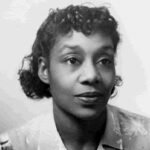 American storyteller, Harlem Renaissance short story writer, and acclaimed novelist Dorothy West is born in Boston, Massachusetts. She is best known for her 1948 novel The Living Is Easy, as well as many other short stories and essays, about the life of an upper-class black family. West attended Girls' Latin school, now called Boston Latin Academy, graduating at 16, and went on to Boston University and the Columbia University School of Journalism. After publication of her first novel, West worked as a journalist, primarily writing for a small newspaper on Martha's Vineyard. At the age of 85 West finally finished a second novel, entitled The Wedding. Though its action occurs in the course of a weekend on Martha's Vinyard, it recounts the history of an affluent Black family over the course of centuries. Published to acclaim in 1995–the Publishers Weekly review stated: "West's first novel in 45 years is a triumph."– the novel was a best-seller and resulted in the publication of a collection of West's short stories and reminiscences called The Richer, the Poorer. Learn more. American storyteller, Harlem Renaissance short story writer, and acclaimed novelist Dorothy West is born in Boston, Massachusetts. She is best known for her 1948 novel The Living Is Easy, as well as many other short stories and essays, about the life of an upper-class black family. West attended Girls' Latin school, now called Boston Latin Academy, graduating at 16, and went on to Boston University and the Columbia University School of Journalism. After publication of her first novel, West worked as a journalist, primarily writing for a small newspaper on Martha's Vineyard. At the age of 85 West finally finished a second novel, entitled The Wedding. Though its action occurs in the course of a weekend on Martha's Vinyard, it recounts the history of an affluent Black family over the course of centuries. Published to acclaim in 1995–the Publishers Weekly review stated: "West's first novel in 45 years is a triumph."– the novel was a best-seller and resulted in the publication of a collection of West's short stories and reminiscences called The Richer, the Poorer. Learn more. | |
| June 2, 1961 |  On June 2, 1961, a Federal judge in Virginia upheld racial segregation in courtrooms, dismissing a lawsuit filed by three Black men who challenged the practice, describing as “totally without merit” their allegation that there was “no moral or legal justification for courtroom segregation,” and dismissing their claim that the practice was “degrading and shameful.” The ruling opined that segregated seating in courtrooms was a “long established practice” that served to “preserve order and decorum.” Learn more. On June 2, 1961, a Federal judge in Virginia upheld racial segregation in courtrooms, dismissing a lawsuit filed by three Black men who challenged the practice, describing as “totally without merit” their allegation that there was “no moral or legal justification for courtroom segregation,” and dismissing their claim that the practice was “degrading and shameful.” The ruling opined that segregated seating in courtrooms was a “long established practice” that served to “preserve order and decorum.” Learn more. | |
| June 2, 1963 | 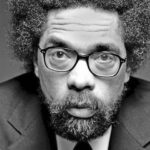 American philosopher, activist, academic, intellectual Cornel West is born in Tulsa, Oklahoma. West was accepted at Harvard University in 1970 where he majored in Near Eastern Languages and Civilization. He also took courses from highly eminent philosophers, including Robert Nozick and Stanley Cavill. In 1980, West became the first African American to earn a PhD in philosophy from Princeton University. During his career, West has taught as a professor at Harvard, Yale, Union Theological Seminary, and Princeton, where created one of the world’s leading centers of African American studies. Learn more. American philosopher, activist, academic, intellectual Cornel West is born in Tulsa, Oklahoma. West was accepted at Harvard University in 1970 where he majored in Near Eastern Languages and Civilization. He also took courses from highly eminent philosophers, including Robert Nozick and Stanley Cavill. In 1980, West became the first African American to earn a PhD in philosophy from Princeton University. During his career, West has taught as a professor at Harvard, Yale, Union Theological Seminary, and Princeton, where created one of the world’s leading centers of African American studies. Learn more. | |
| June 3, 1887 | 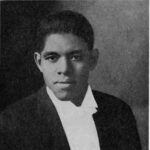 Lyric tenor and composer Roland Hayes is born. Critics lauded his abilities and linguistic skills demonstrated with songs in French, German and Italian. Earlier African-American concert artists were not recorded because in their day recording companies were only interested in a vaudeville type of singer. Hayes was one of the first to break this barrier and in 1939 he recorded with Columbia. Earlier both Marian Anderson and Paul Robeson had recorded from the classical repertoire. Learn more. Lyric tenor and composer Roland Hayes is born. Critics lauded his abilities and linguistic skills demonstrated with songs in French, German and Italian. Earlier African-American concert artists were not recorded because in their day recording companies were only interested in a vaudeville type of singer. Hayes was one of the first to break this barrier and in 1939 he recorded with Columbia. Earlier both Marian Anderson and Paul Robeson had recorded from the classical repertoire. Learn more. | |
| June 3, 1904 | 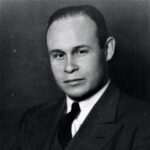 Physician, surgeon, and pioneering medical researcher/inventor Charles Richard Drew, MD, is born in Washington, DC. Dr. Drew researched in the field of blood transfusions, developing improved techniques for blood storage, and applied his expert knowledge to developing large-scale blood banks early in World War II. This allowed medics to save thousands of Allied forces' lives during the war. As the most prominent African American in the field, Dr. Drew protested against the practice of racial segregation in the donation of blood, as it lacked scientific foundation, and resigned his position with the American Red Cross, which maintained the policy until 1950. Learn more. Physician, surgeon, and pioneering medical researcher/inventor Charles Richard Drew, MD, is born in Washington, DC. Dr. Drew researched in the field of blood transfusions, developing improved techniques for blood storage, and applied his expert knowledge to developing large-scale blood banks early in World War II. This allowed medics to save thousands of Allied forces' lives during the war. As the most prominent African American in the field, Dr. Drew protested against the practice of racial segregation in the donation of blood, as it lacked scientific foundation, and resigned his position with the American Red Cross, which maintained the policy until 1950. Learn more. | |
| June 3, 1906 |  American-born French entertainer, French Resistance agent, and civil rights activist Josephine Baker (birth name Freda Josephine McDonald, naturalised French Joséphine Baker) is born in St. Louis, Missouri. She was the first Black woman to star in a major motion picture, the 1927 silent film Siren of the Tropics, directed by Mario Nalpas and Henri Étiévant. During her early career, Baker was renowned as a dancer, and was among the most celebrated performers to headline the revues of the Folies Bergère in Paris. Baker was celebrated by artists and intellectuals of the era, who variously dubbed her the "Black Venus", the "Black Pearl", the "Bronze Venus", and the "Creole Goddess". She was known for aiding the French Resistance during World War II. After the war, she was awarded the Resistance Medal by the French Committee of National Liberation, the Croix de guerre by the French military, and was named a Chevalier of the Légion d'honneur by General Charles de Gaulle. Baker refused to perform for segregated audiences in the United States and is noted for her contributions to the civil rights movement. Learn more. American-born French entertainer, French Resistance agent, and civil rights activist Josephine Baker (birth name Freda Josephine McDonald, naturalised French Joséphine Baker) is born in St. Louis, Missouri. She was the first Black woman to star in a major motion picture, the 1927 silent film Siren of the Tropics, directed by Mario Nalpas and Henri Étiévant. During her early career, Baker was renowned as a dancer, and was among the most celebrated performers to headline the revues of the Folies Bergère in Paris. Baker was celebrated by artists and intellectuals of the era, who variously dubbed her the "Black Venus", the "Black Pearl", the "Bronze Venus", and the "Creole Goddess". She was known for aiding the French Resistance during World War II. After the war, she was awarded the Resistance Medal by the French Committee of National Liberation, the Croix de guerre by the French military, and was named a Chevalier of the Légion d'honneur by General Charles de Gaulle. Baker refused to perform for segregated audiences in the United States and is noted for her contributions to the civil rights movement. Learn more. | |
| June 3, 1943 | 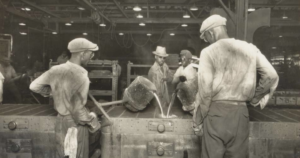 In the midst of World War II, almost all 25,000 white workers at the Detroit Packard Motor Company, which was manufacturing crucial airplane and marine engines for the war effort, go on strike and cease all production to protest the recent promotion of three Black workers. When the striking white workers demanded the promotions be canceled, the company president appealed to the War Labor Board for assistance and a representative from the War Department threatened to fire the striking workers. The strike lasted for three days, but after thirty strike organizers were suspended, white workers returned to their jobs. Learn more. In the midst of World War II, almost all 25,000 white workers at the Detroit Packard Motor Company, which was manufacturing crucial airplane and marine engines for the war effort, go on strike and cease all production to protest the recent promotion of three Black workers. When the striking white workers demanded the promotions be canceled, the company president appealed to the War Labor Board for assistance and a representative from the War Department threatened to fire the striking workers. The strike lasted for three days, but after thirty strike organizers were suspended, white workers returned to their jobs. Learn more. | |
| June 4, 1963 | 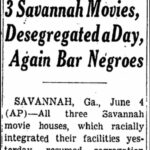 Less than 24 hours after opening their doors for the very first to all patrons equally regardless of race, all three Savannah, Georgia movie theaters cave to objections from white residents, and restoration of segregation policies barring Black people from attending film screenings on an equal basis with white customers. Two of the theaters completely banned Black people from attending movie showings, while the third restricted Black customers to balcony seats. Savannah Mayor Malcolm MacLean condoned the continued racist policies. Learn more. Less than 24 hours after opening their doors for the very first to all patrons equally regardless of race, all three Savannah, Georgia movie theaters cave to objections from white residents, and restoration of segregation policies barring Black people from attending film screenings on an equal basis with white customers. Two of the theaters completely banned Black people from attending movie showings, while the third restricted Black customers to balcony seats. Savannah Mayor Malcolm MacLean condoned the continued racist policies. Learn more. | |
| June 4, 1965 |  U.S. President Lyndon Baines Johnson gives the Commencement Address titled “To Fulfill These Rights”, at Howard University in Washington, D.C.. He uses the occasion to remind his audience and the nation of the long history of racial discrimination and urged the American people to end racial discrimination as the most important step in ensuring equality among all of its citizens. Read the address. U.S. President Lyndon Baines Johnson gives the Commencement Address titled “To Fulfill These Rights”, at Howard University in Washington, D.C.. He uses the occasion to remind his audience and the nation of the long history of racial discrimination and urged the American people to end racial discrimination as the most important step in ensuring equality among all of its citizens. Read the address. | |
| June 4, 1972 | 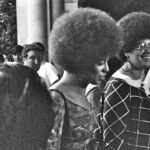 Political activist, philosopher, academic, and author Angela Davis is acquitted by an all-white jury in San Jose, California of all charges stemming from a courtroom shootout in 1970 in which the judge and 3 defendants were killed; Davis had purchased some of the guns used in the shootout. She spent over 16 months incarcerated while trial was pending. Learn more. Political activist, philosopher, academic, and author Angela Davis is acquitted by an all-white jury in San Jose, California of all charges stemming from a courtroom shootout in 1970 in which the judge and 3 defendants were killed; Davis had purchased some of the guns used in the shootout. She spent over 16 months incarcerated while trial was pending. Learn more. | |
| June 4, 1993 |  NAACP attorney, voting rights expert, civil rights theorist, and University of Pennsylvania law school professor Lani Guinier responds at a press conference to President Bill Clinton’s withdrawal of her nomination to head the Civil Rights Division of the Justice Department in his administration because of unprincipled opposition in Congress. In her remarks, Guinier commented on the unfairness of the situation and her “seeking a conversation on race”. Read her entire statement. NAACP attorney, voting rights expert, civil rights theorist, and University of Pennsylvania law school professor Lani Guinier responds at a press conference to President Bill Clinton’s withdrawal of her nomination to head the Civil Rights Division of the Justice Department in his administration because of unprincipled opposition in Congress. In her remarks, Guinier commented on the unfairness of the situation and her “seeking a conversation on race”. Read her entire statement. | |
| June 5, 1894 | 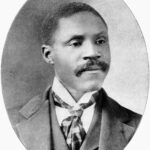 Teacher, farmer, land developer, federal customs inspector, United States Congressman, and inventor George W. Murray, who spent the first 13 years of his life enslaved, secures US patents 520,887 and 520,888 for his inventions of a new planter and a new cotton chopper, respectively. In total, Murray secured 8 patents. Learn more.
Teacher, farmer, land developer, federal customs inspector, United States Congressman, and inventor George W. Murray, who spent the first 13 years of his life enslaved, secures US patents 520,887 and 520,888 for his inventions of a new planter and a new cotton chopper, respectively. In total, Murray secured 8 patents. Learn more. | |
| June 5, 1950 | 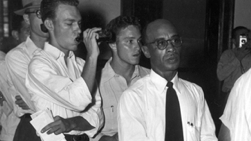 The United States Supreme Court delivers unanimous decisions in three landmark cases that help to undermine the legal foundations of segregation. Sweatt v. Painter involved a black man, Heman Marion Sweatt, who was refused admission to the School of Law of the University of Texas, whose president was Theophilus Painter, on the grounds that the Texas State Constitution prohibited integrated education. In McLaurin v. Oklahoma State Regents, George W. McLaurin, who already had a master's degree in education, was denied admission to the University of Oklahoma to pursue a Doctorate in Education degree because Oklahoma law prohibited schools from instructing blacks and whites together. Henderson v. United States abolished segregation in railroad dining cars. Learn more about: Sweatt v. Painter, McLaurin v. Oklahoma State Regents, and Henderson v. United States. The United States Supreme Court delivers unanimous decisions in three landmark cases that help to undermine the legal foundations of segregation. Sweatt v. Painter involved a black man, Heman Marion Sweatt, who was refused admission to the School of Law of the University of Texas, whose president was Theophilus Painter, on the grounds that the Texas State Constitution prohibited integrated education. In McLaurin v. Oklahoma State Regents, George W. McLaurin, who already had a master's degree in education, was denied admission to the University of Oklahoma to pursue a Doctorate in Education degree because Oklahoma law prohibited schools from instructing blacks and whites together. Henderson v. United States abolished segregation in railroad dining cars. Learn more about: Sweatt v. Painter, McLaurin v. Oklahoma State Regents, and Henderson v. United States. | |
| June 5, 1973 | 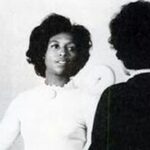 Doris A. Davis is sworn in as mayor of Compton, California, the first African American woman elected to govern a major American City. Learn more. Doris A. Davis is sworn in as mayor of Compton, California, the first African American woman elected to govern a major American City. Learn more. | |
| June 6, 1831 | 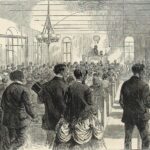 The First Annual Convention of the People of Color is held in Philadelphia, Pennsylvania, the second convention to be conducted within the Colored Conventions Movement (a/k/a the Negro Convention Movement). The Colored Conventions Movement was a series of national, regional, and state conventions held irregularly during the decades preceding and following the American Civil War. The delegates who attended these conventions consisted of both free and fugitive African Americans including religious leaders, businessmen, politicians, writers, publishers, and abolitionists. The conventions provided "an organizational structure through which black men could maintain a distinct black leadership and pursue black abolitionist goals." The minutes from these conventions show that antebellum African Americans sought justice beyond the emancipation of their enslaved countrymen: they also organized to discuss issues concerning labor, health care, temperance, and educational equality. Although the conventions largely subsided following the Civil War, the Colored Conventions of antebellum America are seen as the precursors to larger African-American organizations, including the Colored National Labor Union, the Niagara Movement, and the National Association for the Advancement of Colored People (NAACP). Learn more. The First Annual Convention of the People of Color is held in Philadelphia, Pennsylvania, the second convention to be conducted within the Colored Conventions Movement (a/k/a the Negro Convention Movement). The Colored Conventions Movement was a series of national, regional, and state conventions held irregularly during the decades preceding and following the American Civil War. The delegates who attended these conventions consisted of both free and fugitive African Americans including religious leaders, businessmen, politicians, writers, publishers, and abolitionists. The conventions provided "an organizational structure through which black men could maintain a distinct black leadership and pursue black abolitionist goals." The minutes from these conventions show that antebellum African Americans sought justice beyond the emancipation of their enslaved countrymen: they also organized to discuss issues concerning labor, health care, temperance, and educational equality. Although the conventions largely subsided following the Civil War, the Colored Conventions of antebellum America are seen as the precursors to larger African-American organizations, including the Colored National Labor Union, the Niagara Movement, and the National Association for the Advancement of Colored People (NAACP). Learn more. | |
| June 6, 1939 | 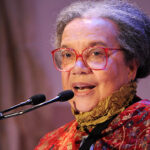 Children’s rights activist, lawyer, and educator Marian Wright Edelman is born in Bennettsville, South Carolina. In 1973, Marian founded the Children’s Defense Fund, which was an organization working to improve the quality of life for poor children. The CDF had a number of agendas, such as preventing teenage pregnancy, child abuse and drug abuse, and helping children to remain healthy and acquire a good education. Learn more. Children’s rights activist, lawyer, and educator Marian Wright Edelman is born in Bennettsville, South Carolina. In 1973, Marian founded the Children’s Defense Fund, which was an organization working to improve the quality of life for poor children. The CDF had a number of agendas, such as preventing teenage pregnancy, child abuse and drug abuse, and helping children to remain healthy and acquire a good education. Learn more. | |
| June 6, 1966 | 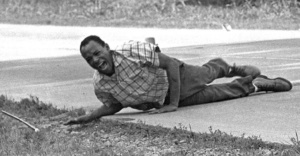 While conducting his one-man “March Against Fear” in Mississippi, James Meredith is shot by a white man. Mr. Meredith, an activist who had integrated the University of Mississippi four years earlier, organized the one-man march to encourage African Americans in Mississippi to register to vote and to challenge the culture of fear perpetuated by white supremacists in the state. The shooter, Aubrey Norvell, pleaded guilty to assault and battery and was sentenced to two years in prison. Mr. Meredith’s march was taken up by civil rights leaders and thousands of others. Mr. Meredith rejoined the march near its end. Learn more. While conducting his one-man “March Against Fear” in Mississippi, James Meredith is shot by a white man. Mr. Meredith, an activist who had integrated the University of Mississippi four years earlier, organized the one-man march to encourage African Americans in Mississippi to register to vote and to challenge the culture of fear perpetuated by white supremacists in the state. The shooter, Aubrey Norvell, pleaded guilty to assault and battery and was sentenced to two years in prison. Mr. Meredith’s march was taken up by civil rights leaders and thousands of others. Mr. Meredith rejoined the march near its end. Learn more. | |
| June 6, 1969 | 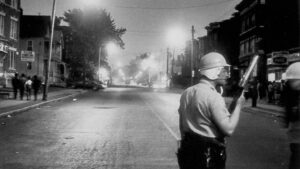 As racial tensions boil over, Hartford, Connecticut Mayor George B. Kinsella institutes a city curfew and an official state of emergency. The city would experience escalating unrest and violence throughout the summer. Hartford, Connecticut in the late 1960’s was a city immersed in racial unrest, class disputes, and activism. The city was a dichotomy between the ghetto, predominantly Black or Puerto Rican and impoverished, in the North End and the South End, white and middle or working class. The Black population had grown dramatically in 1965 from 25 percent to 75 percent. Job opportunities for Puerto Rican and Black people were few and never well-paying, with the added hindrance that white people owned 80 percent of the businesses in the North End. Racial discrimination permeated every aspect of the city, and police brutality in particular was heavy on Black Hartford citizens. The curfew was finally lifted on September 8, but the fight for civil rights by both Blacks and Puerto Ricans continued. Learn more. As racial tensions boil over, Hartford, Connecticut Mayor George B. Kinsella institutes a city curfew and an official state of emergency. The city would experience escalating unrest and violence throughout the summer. Hartford, Connecticut in the late 1960’s was a city immersed in racial unrest, class disputes, and activism. The city was a dichotomy between the ghetto, predominantly Black or Puerto Rican and impoverished, in the North End and the South End, white and middle or working class. The Black population had grown dramatically in 1965 from 25 percent to 75 percent. Job opportunities for Puerto Rican and Black people were few and never well-paying, with the added hindrance that white people owned 80 percent of the businesses in the North End. Racial discrimination permeated every aspect of the city, and police brutality in particular was heavy on Black Hartford citizens. The curfew was finally lifted on September 8, but the fight for civil rights by both Blacks and Puerto Ricans continued. Learn more. | |
| June 7, 1892 | 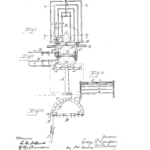 African-American inventor George T. Sampson is issued U.S. patent #476,416 for his invention of an early automatic clothes dryer. Sampson's invention eliminated the need for an open flame to dry clothes. Learn more. African-American inventor George T. Sampson is issued U.S. patent #476,416 for his invention of an early automatic clothes dryer. Sampson's invention eliminated the need for an open flame to dry clothes. Learn more. | |
| June 7, 1917 |  Pulitzer Prize-winning poet, author, teacher, and Illinois poet laureate Gwendolyn Elizabeth Brooks is born. Her work often dealt with the personal celebrations and struggles of ordinary people in her community. She won the Pulitzer Prize for Poetry in 1950 for, making her the first African American to receive a Pulitzer Prize. Throughout her prolific writing career, Brooks received many more honors. A lifelong resident of Chicago, Brooks was appointed Poet Laureate of Illinois in 1968, a position she held until her death 32 years later. She was also named the Poet Laureate Consultant in Poetry to the Library of Congress for the 1985–86 term. In 1976, she became the first African-American woman inducted into the American Academy of Arts and Letters. Learn more. Pulitzer Prize-winning poet, author, teacher, and Illinois poet laureate Gwendolyn Elizabeth Brooks is born. Her work often dealt with the personal celebrations and struggles of ordinary people in her community. She won the Pulitzer Prize for Poetry in 1950 for, making her the first African American to receive a Pulitzer Prize. Throughout her prolific writing career, Brooks received many more honors. A lifelong resident of Chicago, Brooks was appointed Poet Laureate of Illinois in 1968, a position she held until her death 32 years later. She was also named the Poet Laureate Consultant in Poetry to the Library of Congress for the 1985–86 term. In 1976, she became the first African-American woman inducted into the American Academy of Arts and Letters. Learn more. | |
| June 7, 1920 | 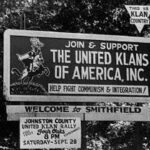 The Ku Klux Klan launches a professionally-created public relations campaign that exploits white anxieties following the first World War. The “100 Percent Americanism” campaign promotes the Klan as defenders of the white American nation from defilement by Black people, Catholics, Jewish people, foreigners, and “moral offenders.” This “neat package of hatred” caught attention quickly, and within 16 months, nearly 100,000 new members had joined. By 1924, there were three million active Klan members nationwide, including 35,000 in Detroit, 55,000 in Chicago, 200,000 in Ohio, 240,000 in Indiana, and 260,000 in Pennsylvania. Learn more. The Ku Klux Klan launches a professionally-created public relations campaign that exploits white anxieties following the first World War. The “100 Percent Americanism” campaign promotes the Klan as defenders of the white American nation from defilement by Black people, Catholics, Jewish people, foreigners, and “moral offenders.” This “neat package of hatred” caught attention quickly, and within 16 months, nearly 100,000 new members had joined. By 1924, there were three million active Klan members nationwide, including 35,000 in Detroit, 55,000 in Chicago, 200,000 in Ohio, 240,000 in Indiana, and 260,000 in Pennsylvania. Learn more. | |
| June 7, 1943 | 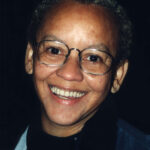 Poet, writer, commentator, activist, and educator Yolande Cornelia "Nikki" Giovanni Jr. is born. One of the world's most well-known African-American poets, her work includes poetry anthologies, poetry recordings, and nonfiction essays, and covers topics ranging from race and social issues to children's literature. She has won numerous awards, including the Langston Hughes Medal and the NAACP Image Award. She has been nominated for a Grammy Award for her poetry album, The Nikki Giovanni Poetry Collection. Learn more. Poet, writer, commentator, activist, and educator Yolande Cornelia "Nikki" Giovanni Jr. is born. One of the world's most well-known African-American poets, her work includes poetry anthologies, poetry recordings, and nonfiction essays, and covers topics ranging from race and social issues to children's literature. She has won numerous awards, including the Langston Hughes Medal and the NAACP Image Award. She has been nominated for a Grammy Award for her poetry album, The Nikki Giovanni Poetry Collection. Learn more. | |
| June 7, 1998 | 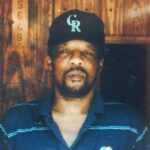 James Byrd Jr., an African-American man, is brutally murdered by three white supremacists in Jasper, Texas. Shawn Berry, Lawrence Brewer, and John King dragged him for three miles behind a pickup truck along an asphalt road. Byrd is killed about halfway through the dragging when his body hit the edge of a culvert, severing his right arm and head. The murderers drove on for another 1.5 miles (2.4 km) before dumping his torso in front of a black church. Brewer and King were the first white men to be sentenced to death for killing a black person in the history of modern Texas. Berry was sentenced to life imprisonment and will be eligible for parole in 2038. Byrd's lynching-by-dragging gave impetus to passage of a Texan hate crimes law, which later led to passage by Congress of the Matthew Shepard and James Byrd Jr. Hate Crimes Prevention Act (commonly known as the Matthew Shepard Act) in 2009. Learn more. James Byrd Jr., an African-American man, is brutally murdered by three white supremacists in Jasper, Texas. Shawn Berry, Lawrence Brewer, and John King dragged him for three miles behind a pickup truck along an asphalt road. Byrd is killed about halfway through the dragging when his body hit the edge of a culvert, severing his right arm and head. The murderers drove on for another 1.5 miles (2.4 km) before dumping his torso in front of a black church. Brewer and King were the first white men to be sentenced to death for killing a black person in the history of modern Texas. Berry was sentenced to life imprisonment and will be eligible for parole in 2038. Byrd's lynching-by-dragging gave impetus to passage of a Texan hate crimes law, which later led to passage by Congress of the Matthew Shepard and James Byrd Jr. Hate Crimes Prevention Act (commonly known as the Matthew Shepard Act) in 2009. Learn more. | |
| June 8, 1823 | 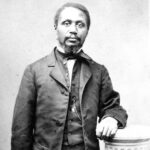 Robert Morris, one of the first African-American attorneys in the United States and called "the first really successful colored lawyer in America," is born in Salem, Massachusetts. At the age of 15, Morris went to work as a household servant for the abolitionist lawyer, Ellis Gray Loring. When Loring's regular copyist, a white youth, neglected his duties, Morris took over for him. Impressed with Morris's intellect, Loring tutored him in the law, and in 1847 presented him for admission to the Massachusetts bar. After his admission to the bar in 1847, Morris may have been the first black male lawyer to file a lawsuit in the U.S. He was also the first black lawyer to win a lawsuit. Morris was active in black and abolitionist causes. Notable cases include Roberts v. Boston, the first legal challenge to the "separate but equal" practice of segregation in America (which the courts staunchly maintained until the Supreme Court's 1954 ruling in Brown v Board of Education) and representing Anthony Burns and Shadrach Minkins in their challenges of the Fugitive Slave Act. Learn more. Robert Morris, one of the first African-American attorneys in the United States and called "the first really successful colored lawyer in America," is born in Salem, Massachusetts. At the age of 15, Morris went to work as a household servant for the abolitionist lawyer, Ellis Gray Loring. When Loring's regular copyist, a white youth, neglected his duties, Morris took over for him. Impressed with Morris's intellect, Loring tutored him in the law, and in 1847 presented him for admission to the Massachusetts bar. After his admission to the bar in 1847, Morris may have been the first black male lawyer to file a lawsuit in the U.S. He was also the first black lawyer to win a lawsuit. Morris was active in black and abolitionist causes. Notable cases include Roberts v. Boston, the first legal challenge to the "separate but equal" practice of segregation in America (which the courts staunchly maintained until the Supreme Court's 1954 ruling in Brown v Board of Education) and representing Anthony Burns and Shadrach Minkins in their challenges of the Fugitive Slave Act. Learn more. | |
| June 8, 1849 | 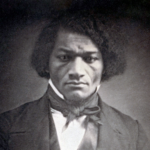 Frederick Douglass gives a major oration at Faneuil Hall in Boston, addressing a number of issues including the politics of Senator Henry Clay of Kentucky. After his main address, Douglass returned to the podium and critiqued the recently ended war with Mexico and its relation to the extension of slavery. Click to read the speech. Frederick Douglass gives a major oration at Faneuil Hall in Boston, addressing a number of issues including the politics of Senator Henry Clay of Kentucky. After his main address, Douglass returned to the podium and critiqued the recently ended war with Mexico and its relation to the extension of slavery. Click to read the speech. | |
| June 8, 1868 | 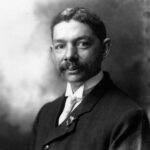 American architect and educator Robert Robinson Taylor is born. Taylor was the first African-American student enrolled at the Massachusetts Institute of Technology, and the first accredited African-American architect when he graduated in 1892. He was an early and influential member of the Tuskegee Institute faculty. A native of Wilmington, North Carolina, Taylor remained in architectural practice in the American South for over forty years. He designed many of the early buildings of the Tuskegee Institute, and at several other Historically black colleges and universities. As second-in-command to Booker T. Washington, the Tuskegee Institute's founder, Taylor was instrumental in both campus planning and inventing the school's industrial curriculum. Learn more. American architect and educator Robert Robinson Taylor is born. Taylor was the first African-American student enrolled at the Massachusetts Institute of Technology, and the first accredited African-American architect when he graduated in 1892. He was an early and influential member of the Tuskegee Institute faculty. A native of Wilmington, North Carolina, Taylor remained in architectural practice in the American South for over forty years. He designed many of the early buildings of the Tuskegee Institute, and at several other Historically black colleges and universities. As second-in-command to Booker T. Washington, the Tuskegee Institute's founder, Taylor was instrumental in both campus planning and inventing the school's industrial curriculum. Learn more. | |
| June 8, 1900 | 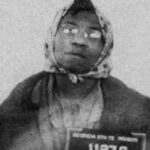 Birthday of Lena Baker, who was convicted of capital murder of a white man, Ernest Knight, and was executed by the state of Georgia in 1945, the only woman in Georgia to be executed by electrocution. At the time of the trial, a local newspaper reported that Baker was held as a "slave woman" by Knight, and that she shot him in self-defense during a struggle. In 2005, sixty years after her execution, the state of Georgia granted Baker a full and unconditional pardon. Learn more. Birthday of Lena Baker, who was convicted of capital murder of a white man, Ernest Knight, and was executed by the state of Georgia in 1945, the only woman in Georgia to be executed by electrocution. At the time of the trial, a local newspaper reported that Baker was held as a "slave woman" by Knight, and that she shot him in self-defense during a struggle. In 2005, sixty years after her execution, the state of Georgia granted Baker a full and unconditional pardon. Learn more. | |
| June 8, 1953 | 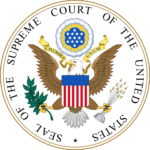 The U.S. Supreme Court rules unanimously in District of Columbia v. John R. Thompson Co. Inc., 346 U.S. 100 (1953), upholding the validity of the local Washington Acts of 1872 and 1873, which prohibited segregation in public places within the District. With the court's decision, the 1872 and 1873 Acts could once again be enforced. The case transpired during growing racial tension in the nation's capital. Learn more. The U.S. Supreme Court rules unanimously in District of Columbia v. John R. Thompson Co. Inc., 346 U.S. 100 (1953), upholding the validity of the local Washington Acts of 1872 and 1873, which prohibited segregation in public places within the District. With the court's decision, the 1872 and 1873 Acts could once again be enforced. The case transpired during growing racial tension in the nation's capital. Learn more. | |
| June 8, 2016 |  A Texas grand jury votes not to indict Brad Miller, a white police trainee who shot and killed African American college student and football player Christian Taylor in August 2015. Neither of the two officers at the scene was wearing a body camera, so no footage of the shooting exists. As the senior officer attempted to use a taser on the unarmed Taylor, who had made no physical contact with either officer, Miller shot him four times in the neck, chest, and abdomen. Miller was fired from the police force in August 2015 for “inappropriate judgment,” but has never been indicted or faced criminal prosecution for the killing. Learn more. A Texas grand jury votes not to indict Brad Miller, a white police trainee who shot and killed African American college student and football player Christian Taylor in August 2015. Neither of the two officers at the scene was wearing a body camera, so no footage of the shooting exists. As the senior officer attempted to use a taser on the unarmed Taylor, who had made no physical contact with either officer, Miller shot him four times in the neck, chest, and abdomen. Miller was fired from the police force in August 2015 for “inappropriate judgment,” but has never been indicted or faced criminal prosecution for the killing. Learn more. | |
| June 9, 1877 | 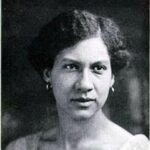 Meta Vaux Warrick Fuller, notable artist who celebrated Afrocentric themes, is born. At the fore of the Harlem Renaissance, Warrick was known for being a poet, painter, theater designer, and sculptor of the black American experience. At the turn of the 20th century, she had achieved a reputation as a well-known sculptor in Paris, before returning to the United States. Warrick was a protégée of Auguste Rodin, and has been described as "one of the most imaginative Black artists of her generation." Through adopting a horror-based figural style and choosing to depict events of racial injustice, like the lynching of Mary Turner, Warrick used her platform to address the societal traumas of African Americans. Learn more. Meta Vaux Warrick Fuller, notable artist who celebrated Afrocentric themes, is born. At the fore of the Harlem Renaissance, Warrick was known for being a poet, painter, theater designer, and sculptor of the black American experience. At the turn of the 20th century, she had achieved a reputation as a well-known sculptor in Paris, before returning to the United States. Warrick was a protégée of Auguste Rodin, and has been described as "one of the most imaginative Black artists of her generation." Through adopting a horror-based figural style and choosing to depict events of racial injustice, like the lynching of Mary Turner, Warrick used her platform to address the societal traumas of African Americans. Learn more. | |
| June 9, 1904 | 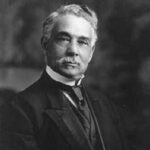 American businessman, lawyer, Register of the Treasury (1911-1913), politician, and civil rights leader James Carroll Napier is the first African American to organize a bank when he charters the One Cent Savings Bank (later renamed the Citizens' Savings Bank and Trust Company and still operating) in Nashville, Tennessee. Learn more. American businessman, lawyer, Register of the Treasury (1911-1913), politician, and civil rights leader James Carroll Napier is the first African American to organize a bank when he charters the One Cent Savings Bank (later renamed the Citizens' Savings Bank and Trust Company and still operating) in Nashville, Tennessee. Learn more. | |
| June 9, 1963 | 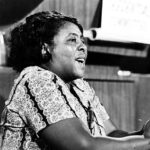 Fannie Lou Hamer is brutalized in police custody after being arrested along with other civil rights activists for refusing to sit in the “colored section” in the Winona, Mississippi Greyhound station. White police officers forced two African American prisoners to brutally beat Ms. Hamer with loaded blackjacks; she was nearly killed. As Ms. Hamer regained consciousness, she overheard one of the white officers propose, "We could put them SOBs in [the] Big Black [River] and nobody would ever find them." Ms. Hamer never fully recovered from the attack; she lost vision in one of her eyes and suffered permanent kidney damage, which contributed to her death in 1977 at age 59. The Winona police officers were acquitted by an all-white jury. Learn more. Fannie Lou Hamer is brutalized in police custody after being arrested along with other civil rights activists for refusing to sit in the “colored section” in the Winona, Mississippi Greyhound station. White police officers forced two African American prisoners to brutally beat Ms. Hamer with loaded blackjacks; she was nearly killed. As Ms. Hamer regained consciousness, she overheard one of the white officers propose, "We could put them SOBs in [the] Big Black [River] and nobody would ever find them." Ms. Hamer never fully recovered from the attack; she lost vision in one of her eyes and suffered permanent kidney damage, which contributed to her death in 1977 at age 59. The Winona police officers were acquitted by an all-white jury. Learn more. | |
| June 10, 1897 |  The Improved Benevolent Protective Order of Elks of the World (IBPOEW), an African-American fraternal order modeled on the Benevolent and Protective Order of Elks, is founded in Cincinnati, Ohio. In the early 21st century, it has 500,000 members and 1500 lodges in the world. Learn more. The Improved Benevolent Protective Order of Elks of the World (IBPOEW), an African-American fraternal order modeled on the Benevolent and Protective Order of Elks, is founded in Cincinnati, Ohio. In the early 21st century, it has 500,000 members and 1500 lodges in the world. Learn more. | |
| June 10, 1954 |  Governors and representatives from 12 Southern states meet in Richmond, Virginia, and resolve to defiantly resist the U.S. Supreme Court's decision in Brown v. Board of Education. Released less than a month earlier, the Brown decision struck down racial segregation laws—prevalent in the South—that required separate public schools for Black and white children. After a six-hour meeting, representatives from all but three of the 12 states present agreed that they would work to resist the desegregation ruling. The campaign of massive resistance to integration in the South discussed at this meeting was largely successful. By 1960, only 98 of Arkansas’s 104,000 Black students attended desegregated schools; as did 34 of 302,000 in North Carolina; 169 of 146,000 in Tennessee; and 103 of 203,000 in Virginia. In the five Deep South states, every single one of 1.4 million Black schoolchildren attended segregated schools until the fall of 1960. By the start of the 1964-65 school year, less than 3% of the South’s Black children attended school with white students, and in Alabama, Arkansas, Georgia, Mississippi, and South Carolina that number remained substantially below 1%. Learn more. Governors and representatives from 12 Southern states meet in Richmond, Virginia, and resolve to defiantly resist the U.S. Supreme Court's decision in Brown v. Board of Education. Released less than a month earlier, the Brown decision struck down racial segregation laws—prevalent in the South—that required separate public schools for Black and white children. After a six-hour meeting, representatives from all but three of the 12 states present agreed that they would work to resist the desegregation ruling. The campaign of massive resistance to integration in the South discussed at this meeting was largely successful. By 1960, only 98 of Arkansas’s 104,000 Black students attended desegregated schools; as did 34 of 302,000 in North Carolina; 169 of 146,000 in Tennessee; and 103 of 203,000 in Virginia. In the five Deep South states, every single one of 1.4 million Black schoolchildren attended segregated schools until the fall of 1960. By the start of the 1964-65 school year, less than 3% of the South’s Black children attended school with white students, and in Alabama, Arkansas, Georgia, Mississippi, and South Carolina that number remained substantially below 1%. Learn more. | |
| June 10, 1964 | 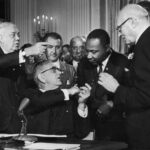 The United States Senate breaks the 75-day Southern Filibuster against the Civil Rights Act of 1964 by a vote of 71-29, leading to the bill's passage. This was the first time in history the Senate imposed cloture on (i.e., broke a filibuster of) any civil rights legislation. The Civil Rights Act of 1964, with public accommodation and fair employment sections, was signed by President Johnson on July 2. Throughout the existence of the filibuster (created by the Senate accidentally and unintentionally in the 19th century) it has been used nearly exclusively to block civil rights and voting rights legislation. Learn more. The United States Senate breaks the 75-day Southern Filibuster against the Civil Rights Act of 1964 by a vote of 71-29, leading to the bill's passage. This was the first time in history the Senate imposed cloture on (i.e., broke a filibuster of) any civil rights legislation. The Civil Rights Act of 1964, with public accommodation and fair employment sections, was signed by President Johnson on July 2. Throughout the existence of the filibuster (created by the Senate accidentally and unintentionally in the 19th century) it has been used nearly exclusively to block civil rights and voting rights legislation. Learn more. | |
| June 11, 1920 |  Critically acclaimed performing artist, jazz and classical pianist, singer, and actor Hazel Dorothy Scott is born in Port of Spain, Trinidad. Scott moved to New York City with her mother at the age of four. Scott was a child musical prodigy, receiving scholarships to study at the Juilliard School when she was eight. In her teens, she performed in a jazz band. She also performed on the radio. She was prominent as a jazz singer throughout the 1930s and 1940s. In 1950, she became the first black American to host her own TV show, The Hazel Scott Show. Her career in America faltered after she testified before the House Un-American Activities Committee in 1950 during the McCarthy era. Scott subsequently moved to Paris in 1957 and began performing in Europe, not returning to the United States until 1967. Scott was an outspoken critic of racial discrimination and segregation, and used her influence to improve the representation of Black Americans in film. Learn more. Critically acclaimed performing artist, jazz and classical pianist, singer, and actor Hazel Dorothy Scott is born in Port of Spain, Trinidad. Scott moved to New York City with her mother at the age of four. Scott was a child musical prodigy, receiving scholarships to study at the Juilliard School when she was eight. In her teens, she performed in a jazz band. She also performed on the radio. She was prominent as a jazz singer throughout the 1930s and 1940s. In 1950, she became the first black American to host her own TV show, The Hazel Scott Show. Her career in America faltered after she testified before the House Un-American Activities Committee in 1950 during the McCarthy era. Scott subsequently moved to Paris in 1957 and began performing in Europe, not returning to the United States until 1967. Scott was an outspoken critic of racial discrimination and segregation, and used her influence to improve the representation of Black Americans in film. Learn more.
| |
| June 11, 1963 | 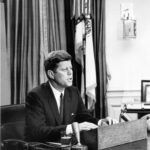 President John F. Kennedy delivered a civil rights speech in which he proposed the Civil Rights Act of 1964. During the speech President Kennedy called segregation "morally wrong" and moved America to view civil rights not just as a legal issue, but as a moral one. This speech was given in response to the National Guard being sent to protect African American students Vivian Malone and James Hood’s enrollment at the University of Alabama. This speech clearly placed President Kennedy as an advocate for the civil rights of African Americans and helped transform the thoughts of many towards seeing and seeking a change of civil rights for African Americans in this country. Learn more. President John F. Kennedy delivered a civil rights speech in which he proposed the Civil Rights Act of 1964. During the speech President Kennedy called segregation "morally wrong" and moved America to view civil rights not just as a legal issue, but as a moral one. This speech was given in response to the National Guard being sent to protect African American students Vivian Malone and James Hood’s enrollment at the University of Alabama. This speech clearly placed President Kennedy as an advocate for the civil rights of African Americans and helped transform the thoughts of many towards seeing and seeking a change of civil rights for African Americans in this country. Learn more. | |
| June 11, 1963 | 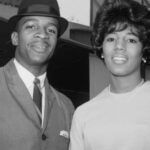 James Hood and Vivian Malone are the first African-Americans to enroll at the University of Alabama in 1963, after being temporarily delayed by Alabama Governor George Wallace who attempted to block their entry, an incident known as the “Stand in the Schoolhouse Door.” Wallace stood in front of the university’s Foster Auditorium when Hood arrived to pay his fees, accompanied by Malone and U.S. Deputy Attorney General Nicholas Katzenbach. As Hood and Malone waited in the car, Katzenbach and a small team of federal marshals confronted Wallace to demand that Malone and Hood be allowed entry by order of the state court and for Wallace to step aside. Wallace refused the order and in front of crowds of media crews delivered a short, defiant speech. With Wallace refusing to allow entry, President John F. Kennedy federalized the Alabama National Guard later the same day. Guardsmen then escorted Hood and Malone back to the auditorium, where Wallace moved aside at the request of General Henry Graham, while Hood and Malone entered the building, through another door. Learn more. James Hood and Vivian Malone are the first African-Americans to enroll at the University of Alabama in 1963, after being temporarily delayed by Alabama Governor George Wallace who attempted to block their entry, an incident known as the “Stand in the Schoolhouse Door.” Wallace stood in front of the university’s Foster Auditorium when Hood arrived to pay his fees, accompanied by Malone and U.S. Deputy Attorney General Nicholas Katzenbach. As Hood and Malone waited in the car, Katzenbach and a small team of federal marshals confronted Wallace to demand that Malone and Hood be allowed entry by order of the state court and for Wallace to step aside. Wallace refused the order and in front of crowds of media crews delivered a short, defiant speech. With Wallace refusing to allow entry, President John F. Kennedy federalized the Alabama National Guard later the same day. Guardsmen then escorted Hood and Malone back to the auditorium, where Wallace moved aside at the request of General Henry Graham, while Hood and Malone entered the building, through another door. Learn more. | |
| June 11, 1967 | 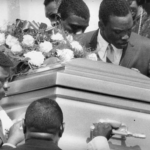 Police officer James Calvert shoots unarmed Black teen Martin Chambers in the back in Tampa, Florida, setting off three days of civil unrest. Calvert pursued Chambers on unverified suspicion of robbing a local photo supply store. Calvert claimed he shot to stop the Chambers from running away, aimed for his shoulder, but missed. Three Black men who witnessed the shooting claimed Calvert shot Chambers after he had stopped running and had his hands up against a chain link fence. After just two days of investigation, officials ruled the shooting necessary. Learn more. Police officer James Calvert shoots unarmed Black teen Martin Chambers in the back in Tampa, Florida, setting off three days of civil unrest. Calvert pursued Chambers on unverified suspicion of robbing a local photo supply store. Calvert claimed he shot to stop the Chambers from running away, aimed for his shoulder, but missed. Three Black men who witnessed the shooting claimed Calvert shot Chambers after he had stopped running and had his hands up against a chain link fence. After just two days of investigation, officials ruled the shooting necessary. Learn more. | |
| June 12, 1945 | 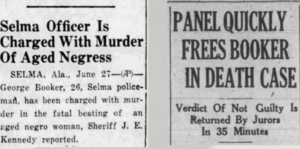 Off-duty white police officer George Booker forcibly enters the Selma, Alabama home of 74-year-old Black woman Niecey Brown, brutally beats her with a bottle and crushing her skull, resulting in her death 2 days later during which she never regained consciousness. Mrs. Brown's husband, Life, and their two grandchildren witnessed the brutal attack. Officer Booker was arrested and charged with murder. During his trial in September 1945, his lawyer cautioned the all-white jury, “[I]f we convict this brave man who is upholding the banner of white supremacy by his actions, then we may as well give all our guns to the niggers and let them run the Black Belt.” The jury heeded this advice, ignoring eyewitness testimony and deliberating for only a few minutes before acquitting Officer Booker of all charges. Learn more. Off-duty white police officer George Booker forcibly enters the Selma, Alabama home of 74-year-old Black woman Niecey Brown, brutally beats her with a bottle and crushing her skull, resulting in her death 2 days later during which she never regained consciousness. Mrs. Brown's husband, Life, and their two grandchildren witnessed the brutal attack. Officer Booker was arrested and charged with murder. During his trial in September 1945, his lawyer cautioned the all-white jury, “[I]f we convict this brave man who is upholding the banner of white supremacy by his actions, then we may as well give all our guns to the niggers and let them run the Black Belt.” The jury heeded this advice, ignoring eyewitness testimony and deliberating for only a few minutes before acquitting Officer Booker of all charges. Learn more. | |
| June 12, 1963 | 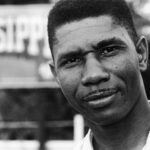 American civil rights activist, the first field secretary for the NAACP in Mississippi, and World War II veteran who had served in the United States Army, Medgar Wiley Evers is assassinated at his home where his young children were present. He was just 37 years old when he was killed. Evers worked to overturn segregation at the University of Mississippi, end the segregation of public facilities, and expand opportunities for African Americans, which included the enforcement of voting rights. A college graduate, Evers became active in the Civil Rights Movement in the 1950s. Following the 1954 ruling of the United States Supreme Court in Brown v. Board of Education that segregated public schools were unconstitutional, Evers challenged the segregation of the state-supported public University of Mississippi, applying to law school there. He also worked for voting rights, economic opportunity, access to public facilities, and other changes in the segregated society. Evers was awarded the 1963 NAACP Spingarn Medal. Evers was assassinated by Byron De La Beckwith, a member of the White Citizens' Council in Jackson, Mississippi. This group was formed in 1954 in Mississippi to resist the integration of schools and civil rights activism; Beckwith assassinated Evers mere hours after President Kennedy gave an historic speech calling segregation morally wrong. As a veteran, Evers was buried with full military honors at Arlington National Cemetery. His murder and the resulting trials inspired civil rights protests; his life and these events inspired numerous works of art, music, and film. All-white juries failed to reach verdicts in the first two trials of Beckwith in the 1960s. He was convicted in 1994 in a new state trial based on new evidence. Medgar's widow, Myrlie Evers, became a noted activist in her own right, serving as national chair of the NAACP. His brother Charles Evers was the first African American to be elected as mayor of a city in Mississippi in the post-Reconstruction era; he won the office in 1969 in Fayette. Learn more.
American civil rights activist, the first field secretary for the NAACP in Mississippi, and World War II veteran who had served in the United States Army, Medgar Wiley Evers is assassinated at his home where his young children were present. He was just 37 years old when he was killed. Evers worked to overturn segregation at the University of Mississippi, end the segregation of public facilities, and expand opportunities for African Americans, which included the enforcement of voting rights. A college graduate, Evers became active in the Civil Rights Movement in the 1950s. Following the 1954 ruling of the United States Supreme Court in Brown v. Board of Education that segregated public schools were unconstitutional, Evers challenged the segregation of the state-supported public University of Mississippi, applying to law school there. He also worked for voting rights, economic opportunity, access to public facilities, and other changes in the segregated society. Evers was awarded the 1963 NAACP Spingarn Medal. Evers was assassinated by Byron De La Beckwith, a member of the White Citizens' Council in Jackson, Mississippi. This group was formed in 1954 in Mississippi to resist the integration of schools and civil rights activism; Beckwith assassinated Evers mere hours after President Kennedy gave an historic speech calling segregation morally wrong. As a veteran, Evers was buried with full military honors at Arlington National Cemetery. His murder and the resulting trials inspired civil rights protests; his life and these events inspired numerous works of art, music, and film. All-white juries failed to reach verdicts in the first two trials of Beckwith in the 1960s. He was convicted in 1994 in a new state trial based on new evidence. Medgar's widow, Myrlie Evers, became a noted activist in her own right, serving as national chair of the NAACP. His brother Charles Evers was the first African American to be elected as mayor of a city in Mississippi in the post-Reconstruction era; he won the office in 1969 in Fayette. Learn more. | |
| June 12, 1967 | 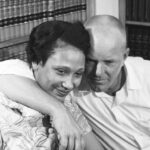 The United States Supreme Court announces its unanimous landmark civil rights decision in Loving v. Virginia, ruling that laws banning interracial marriage violate the Equal Protection and Due Process Clauses of the Fourteenth Amendment to the U.S. Constitution. Beginning in 2013, it was cited as precedent in U.S. federal court decisions holding restrictions on same-sex marriage in the United States unconstitutional, including in the 2015 Supreme Court decision Obergefell v. Hodges. The case involved Mildred Loving, a woman of color, and her white husband Richard Loving, who in 1958 were sentenced to a year in prison for marrying each other in violation of Virginia's Racial Integrity Act of 1924. The Lovings appealed their conviction to the Supreme Court of Virginia, which upheld it. They then appealed to the U.S. Supreme Court, which agreed to hear their case. Learn more.
The United States Supreme Court announces its unanimous landmark civil rights decision in Loving v. Virginia, ruling that laws banning interracial marriage violate the Equal Protection and Due Process Clauses of the Fourteenth Amendment to the U.S. Constitution. Beginning in 2013, it was cited as precedent in U.S. federal court decisions holding restrictions on same-sex marriage in the United States unconstitutional, including in the 2015 Supreme Court decision Obergefell v. Hodges. The case involved Mildred Loving, a woman of color, and her white husband Richard Loving, who in 1958 were sentenced to a year in prison for marrying each other in violation of Virginia's Racial Integrity Act of 1924. The Lovings appealed their conviction to the Supreme Court of Virginia, which upheld it. They then appealed to the U.S. Supreme Court, which agreed to hear their case. Learn more. | |
| June 13, 1850 | 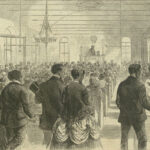 The American League of Colored Laborers (ALCL), the first African American labor union, assembled for its inaugural meeting in New York City as a collective for skilled free craftsmen. Frederick Douglass helped organize the union in response to the difficulty black laborers had in joining white unions. The ALCL sought to develop agricultural and industrial arts skills among its members, and to encourage African American business. Learn more. The American League of Colored Laborers (ALCL), the first African American labor union, assembled for its inaugural meeting in New York City as a collective for skilled free craftsmen. Frederick Douglass helped organize the union in response to the difficulty black laborers had in joining white unions. The ALCL sought to develop agricultural and industrial arts skills among its members, and to encourage African American business. Learn more. | |
| June 13, 1937 |  Eleanor Holmes Norton is born in Washington, D.C. In 1990, Eleanor Holmes Norton was elected as a delegate to the US Congress representing the District of Columbia. During her three decades serving as DC delegate to Congress, Holmes has fought for full voting rights for District of Columbia residents. She also engineered passage of a bill that allows District of Columbia residents to attend any public college or university in the nation at in-state tuition rates or to attend any private university with a subsidy of up to $2,500 per year. While serving in Congress Norton teaches part-time in the Georgetown University Law School. Learn more. Eleanor Holmes Norton is born in Washington, D.C. In 1990, Eleanor Holmes Norton was elected as a delegate to the US Congress representing the District of Columbia. During her three decades serving as DC delegate to Congress, Holmes has fought for full voting rights for District of Columbia residents. She also engineered passage of a bill that allows District of Columbia residents to attend any public college or university in the nation at in-state tuition rates or to attend any private university with a subsidy of up to $2,500 per year. While serving in Congress Norton teaches part-time in the Georgetown University Law School. Learn more. | |
| June 13, 1967 | 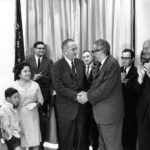 President Lyndon Johnson nominates sitting US Solicitor General, former justice of the US Court of Appeals for the Second Circuit, and former Chief Counsel for the NAACP Legal Defense and Educational Fund and civil rights activist Thurgood Marshall to the United States Supreme Court, saying this is "the right thing to do, the right time to do it, the right man and the right place." Marshall was confirmed as an Associate Justice by a Senate vote of 69–11 on August 30, 1967 (32–1 in the Senate Republican Conference and 37–10 in the Senate Democratic Caucus) with 20 members voting present or abstaining. He was the first African American to hold the position. Learn more. President Lyndon Johnson nominates sitting US Solicitor General, former justice of the US Court of Appeals for the Second Circuit, and former Chief Counsel for the NAACP Legal Defense and Educational Fund and civil rights activist Thurgood Marshall to the United States Supreme Court, saying this is "the right thing to do, the right time to do it, the right man and the right place." Marshall was confirmed as an Associate Justice by a Senate vote of 69–11 on August 30, 1967 (32–1 in the Senate Republican Conference and 37–10 in the Senate Democratic Caucus) with 20 members voting present or abstaining. He was the first African American to hold the position. Learn more. | |
| June 13, 2005 | 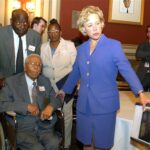 The United States Senate formally apologized for failing to pass anti-lynching legislation. The senate resolution had nearly eighty co-sponsors. Between 1877 and 1950, more than 4,400 African American men, women, and children were killed in racial terror lynchings throughout the United States. During that period, seven U.S. presidents exhorted Congress to pass anti-lynching legislation and 200 anti-lynching bills were introduced; however, only three bills passed the House of Representatives and none passed the Senate, where Southern conservative Congressmen successfully filibustered the bills to avoid a floor vote. In the absence of federal protection, and amidst the inaction of local state courts, lynchings persisted for decades, killing thousands and traumatizing many, many more. Learn more. The United States Senate formally apologized for failing to pass anti-lynching legislation. The senate resolution had nearly eighty co-sponsors. Between 1877 and 1950, more than 4,400 African American men, women, and children were killed in racial terror lynchings throughout the United States. During that period, seven U.S. presidents exhorted Congress to pass anti-lynching legislation and 200 anti-lynching bills were introduced; however, only three bills passed the House of Representatives and none passed the Senate, where Southern conservative Congressmen successfully filibustered the bills to avoid a floor vote. In the absence of federal protection, and amidst the inaction of local state courts, lynchings persisted for decades, killing thousands and traumatizing many, many more. Learn more. | |
| June 14, 1811 | 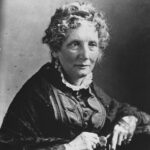 American author and abolitionist Harriet Beecher Stoweis born in Litchfield, Connecticut. She came from the Beecher family, a famous religious family, and became best known for her novel Uncle Tom's Cabin (1852), which depicts the harsh conditions experienced by enslaved African Americans. The book reached an audience of millions as a novel and play, and became influential in the United States and in Great Britain, energizing anti-slavery forces in the American North, while provoking widespread anger in the South. Stowe wrote 30 books, including novels, three travel memoirs, and collections of articles and letters. She was influential both for her writings and for her public stances and debates on social issues of the day. Learn more.
American author and abolitionist Harriet Beecher Stoweis born in Litchfield, Connecticut. She came from the Beecher family, a famous religious family, and became best known for her novel Uncle Tom's Cabin (1852), which depicts the harsh conditions experienced by enslaved African Americans. The book reached an audience of millions as a novel and play, and became influential in the United States and in Great Britain, energizing anti-slavery forces in the American North, while provoking widespread anger in the South. Stowe wrote 30 books, including novels, three travel memoirs, and collections of articles and letters. She was influential both for her writings and for her public stances and debates on social issues of the day. Learn more. | |
| June 14, 1910 | 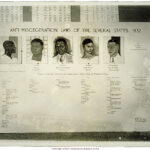 Louisiana’s House of Representatives broadens its ban on interracial marriage by passing legislation, by a vote of 93 to 10, prohibiting Black people and white people from living together under any circumstances. Under the new legislation, cohabitation becomes a felony punishable by imprisonment for up to five years. The bill is signed into the law by Governor Jared Sanders two days later. Like Louisiana, states throughout the country relied on laws banning interracial marriage to maintain a rigid racial caste system. These laws remained in effect until the Supreme Court declared anti-miscegenation statutes unconstitutional in 1967, in Loving v. Virginia. Louisiana did not formally repeal its ban on interracial marriage until five years later, in 1972. Learn more. Louisiana’s House of Representatives broadens its ban on interracial marriage by passing legislation, by a vote of 93 to 10, prohibiting Black people and white people from living together under any circumstances. Under the new legislation, cohabitation becomes a felony punishable by imprisonment for up to five years. The bill is signed into the law by Governor Jared Sanders two days later. Like Louisiana, states throughout the country relied on laws banning interracial marriage to maintain a rigid racial caste system. These laws remained in effect until the Supreme Court declared anti-miscegenation statutes unconstitutional in 1967, in Loving v. Virginia. Louisiana did not formally repeal its ban on interracial marriage until five years later, in 1972. Learn more. | |
| June 14, 1918 |  LeRoy T. Walker, the first Black president of the United States Olympic Committee, is born in Atlanta, Georgia. In the 1996 Olympics, Walker was delegated to lead a 10,000 member group of the most talented athletes in the world. His goal was to make sure that American citizens have a feeling of ownership in the program, saying, "We ought to keep them informed. We ought to let them know what the Olympic movement is all about and what’s happening to the dollars that they give." In 1988, he was the treasurer of the committee's contingency fund. While under his wing, the fund increased about $43 million. Later, he gave up his six figure salary position as the director of sports for the Atlanta Committee for the Olympic Games to take the unpaid presidency position. Learn more. LeRoy T. Walker, the first Black president of the United States Olympic Committee, is born in Atlanta, Georgia. In the 1996 Olympics, Walker was delegated to lead a 10,000 member group of the most talented athletes in the world. His goal was to make sure that American citizens have a feeling of ownership in the program, saying, "We ought to keep them informed. We ought to let them know what the Olympic movement is all about and what’s happening to the dollars that they give." In 1988, he was the treasurer of the committee's contingency fund. While under his wing, the fund increased about $43 million. Later, he gave up his six figure salary position as the director of sports for the Atlanta Committee for the Olympic Games to take the unpaid presidency position. Learn more. | |
| June 14, 1941 | 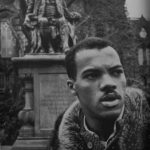 Novelist, short story writer, memoirist, and essayist John Edgar Wideman is born. He was the first person to win the PEN/Faulkner Award for Fiction twice. His writing is known for experimental techniques and a focus on the African-American experience. Raised in Pittsburgh, Pennsylvania, Wideman excelled as a student athlete at the University of Pennsylvania. In 1963, he became the second African American to win a Rhodes Scholarship to attend the University of Oxford. In addition to his work as a writer, Wideman has had a career in academia as a literature and creative writing professor at both public and Ivy League universities. In his writing, Wideman has explored the complexities of race, family, trauma, storytelling, and justice in the United States. His personal experience, including the incarceration of his brother, has played a significant role in his work. He is a professor emeritus at Brown University and lives in New York City and France. Learn more. Novelist, short story writer, memoirist, and essayist John Edgar Wideman is born. He was the first person to win the PEN/Faulkner Award for Fiction twice. His writing is known for experimental techniques and a focus on the African-American experience. Raised in Pittsburgh, Pennsylvania, Wideman excelled as a student athlete at the University of Pennsylvania. In 1963, he became the second African American to win a Rhodes Scholarship to attend the University of Oxford. In addition to his work as a writer, Wideman has had a career in academia as a literature and creative writing professor at both public and Ivy League universities. In his writing, Wideman has explored the complexities of race, family, trauma, storytelling, and justice in the United States. His personal experience, including the incarceration of his brother, has played a significant role in his work. He is a professor emeritus at Brown University and lives in New York City and France. Learn more. | |
| June 15, 1877 | 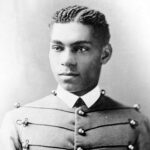 Henry O. Flipper becomes the first Black graduate of West Point Military Academy. Learn more. Henry O. Flipper becomes the first Black graduate of West Point Military Academy. Learn more. | |
| June 15, 1897 | 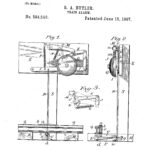 African American inventor Richard A. Butler wins US patent 584,540 for improvements in train alarms. See the patent. African American inventor Richard A. Butler wins US patent 584,540 for improvements in train alarms. See the patent. | |
| June 15, 1920 | 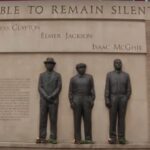 Three falsely-accused young Black men are lynched in Duluth, Minnesota. Two white teenagers, James Sullivan and Irene Tuskan, claim that the night before Mr. Sullivan had been held at gunpoint while six Black circus workers raped Ms. Tuskan. Though a doctor examining Ms. Tuskan found no evidence of assault, six young Black men were arrested and jailed. Newspapers reported the alleged assault and false rumors soon spread that Ms. Tuskan had died from her injuries. A mob of 5,000 to 10,000 white people gathered at the jail and seized three of the arrested Black men: Isaac McGhie, Elmer Jackson, and Elias Clayton. The mob beat and lynched them all, hanging the men from a light pole in downtown Duluth. The Minnesota National Guard arrived the next morning to secure the area and guard the surviving prisoners, but no one was ever arrested or convicted for the lynchings. Learn more. Three falsely-accused young Black men are lynched in Duluth, Minnesota. Two white teenagers, James Sullivan and Irene Tuskan, claim that the night before Mr. Sullivan had been held at gunpoint while six Black circus workers raped Ms. Tuskan. Though a doctor examining Ms. Tuskan found no evidence of assault, six young Black men were arrested and jailed. Newspapers reported the alleged assault and false rumors soon spread that Ms. Tuskan had died from her injuries. A mob of 5,000 to 10,000 white people gathered at the jail and seized three of the arrested Black men: Isaac McGhie, Elmer Jackson, and Elias Clayton. The mob beat and lynched them all, hanging the men from a light pole in downtown Duluth. The Minnesota National Guard arrived the next morning to secure the area and guard the surviving prisoners, but no one was ever arrested or convicted for the lynchings. Learn more. | |
| June 15, 1921 | 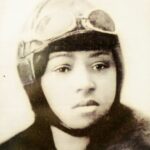 Bessie Coleman becomes the first African American woman to earn an international aviation license. Learn more. Bessie Coleman becomes the first African American woman to earn an international aviation license. Learn more. | |
| June 16, 1858 |  In Springfield, Illinois, just three hours after the Illinois Republican Party nominated him as its candidate for the United States Senate from that state, Abraham Lincoln delivers his “A House Divided” speech, the most famous oration from an anti-slavery politician delivered before the U.S. Civil War. Read the full speech. In Springfield, Illinois, just three hours after the Illinois Republican Party nominated him as its candidate for the United States Senate from that state, Abraham Lincoln delivers his “A House Divided” speech, the most famous oration from an anti-slavery politician delivered before the U.S. Civil War. Read the full speech. | |
| June 16, 1864 | 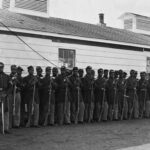 The Union offensive, the Richmond–Petersburg Campaign (commonly known as the Siege of Petersburg), begins, with substantial participation by U.S. Colored Troops (USCT). The campaign will continue into April 1865. Thirty Black infantry and Black cavalry regiments will be involved. During the war a total of nearly 187,000 African Americans served in the Union Army. Of those the greatest concentration of USCT personnel was at Petersburg. In the initial assault upon the city, a division of USCTs in the XVIII Corps helped capture and secure a section of the Dimmock Line. The other division at Petersburg was with the IX Corps and it fought in the Battle of the Crater, July 30. In December, all the United States Colored Troops around Petersburg were incorporated into three divisions and became the XXV Corps of the Army of the James. It was the largest Black force assembled during the war and varied between 9,000 and 16,000 men. Overall in the Petersburg Campaign USCTs would participate in 6 major engagements and earn 15 of the 16 total Medals of Honor awarded African American soldiers in the Civil War. Learn more. The Union offensive, the Richmond–Petersburg Campaign (commonly known as the Siege of Petersburg), begins, with substantial participation by U.S. Colored Troops (USCT). The campaign will continue into April 1865. Thirty Black infantry and Black cavalry regiments will be involved. During the war a total of nearly 187,000 African Americans served in the Union Army. Of those the greatest concentration of USCT personnel was at Petersburg. In the initial assault upon the city, a division of USCTs in the XVIII Corps helped capture and secure a section of the Dimmock Line. The other division at Petersburg was with the IX Corps and it fought in the Battle of the Crater, July 30. In December, all the United States Colored Troops around Petersburg were incorporated into three divisions and became the XXV Corps of the Army of the James. It was the largest Black force assembled during the war and varied between 9,000 and 16,000 men. Overall in the Petersburg Campaign USCTs would participate in 6 major engagements and earn 15 of the 16 total Medals of Honor awarded African American soldiers in the Civil War. Learn more. | |
| June 16, 1943 | 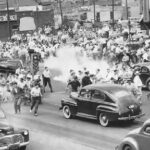 Whites continue attacking Blacks and destroying Black property in the first first full day of rioting in Beaumont, Texas (which had began the evening of June 15 and ended on June 17). The riot likely escalated from wartime tensions in the overcrowded city, which had been flooded by workers from across the South. The immediate catalyst was a rumor that a white woman had been raped by a Black man (a common false rumor that regularly triggered mass white violence against African Americans and their property throughout the 19th and 20th centuries). White workers from the Pennsylvania Shipyard in Beaumont initiated the violence by attacking Black people and destroying their property. This was one of several such incidents in the summer of 1943 in which Black people were attacked and their property destroyed by white mob violence. The first took place in the largest shipyard in Mobile, Alabama in late May; other large scale attacks took place in Detroit in June, Harlem in August. Learn more. Whites continue attacking Blacks and destroying Black property in the first first full day of rioting in Beaumont, Texas (which had began the evening of June 15 and ended on June 17). The riot likely escalated from wartime tensions in the overcrowded city, which had been flooded by workers from across the South. The immediate catalyst was a rumor that a white woman had been raped by a Black man (a common false rumor that regularly triggered mass white violence against African Americans and their property throughout the 19th and 20th centuries). White workers from the Pennsylvania Shipyard in Beaumont initiated the violence by attacking Black people and destroying their property. This was one of several such incidents in the summer of 1943 in which Black people were attacked and their property destroyed by white mob violence. The first took place in the largest shipyard in Mobile, Alabama in late May; other large scale attacks took place in Detroit in June, Harlem in August. Learn more. | |
| June 16, 1944 | 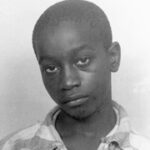 George Stinney Jr., a 90-pound, Black, 14-year-old boy, is executed in the electric chair in Columbia, South Carolina. Three months earlier, George and his sister were playing in their yard when two young white girls briefly approached and asked where they could find flowers. Hours later, the girls failed to return home and a search party was organized to find them. George joined the search party and casually mentioned to a bystander that he had seen the girls earlier. The following morning, their dead bodies were found in a shallow ditch. George was immediately arrested for the murders and subjected to hours of interrogation without his parents or an attorney. On April 24, George Stinney faced a sham trial virtually alone. No African Americans were allowed inside the courthouse and his court-appointed attorney, a tax lawyer with political aspirations, failed to call a single witness. The prosecution presented the sheriff's otherwise unverified testimony that George had confessed as the only evidence of guilt. An all-white jury deliberated for 10 minutes before convicting George Stinney of rape and murder, and the judge promptly sentenced the 14-year-old to death. Learn more. George Stinney Jr., a 90-pound, Black, 14-year-old boy, is executed in the electric chair in Columbia, South Carolina. Three months earlier, George and his sister were playing in their yard when two young white girls briefly approached and asked where they could find flowers. Hours later, the girls failed to return home and a search party was organized to find them. George joined the search party and casually mentioned to a bystander that he had seen the girls earlier. The following morning, their dead bodies were found in a shallow ditch. George was immediately arrested for the murders and subjected to hours of interrogation without his parents or an attorney. On April 24, George Stinney faced a sham trial virtually alone. No African Americans were allowed inside the courthouse and his court-appointed attorney, a tax lawyer with political aspirations, failed to call a single witness. The prosecution presented the sheriff's otherwise unverified testimony that George had confessed as the only evidence of guilt. An all-white jury deliberated for 10 minutes before convicting George Stinney of rape and murder, and the judge promptly sentenced the 14-year-old to death. Learn more. | |
| June 17, 1775 | 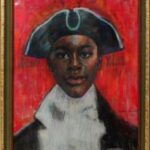 At a crucial point in the Battle of Bunker Hill, formerly-enslaved African American Peter Salem becomes one of the first military heroes of the American Revolutionary War when he fires the shot that kills British major John Pitcairn. Previously, Salem had fought in the war's first battles at Concord on April 19, 1775. About a dozen other free African Americans took part in the Battle of Bunker Hill, including Phillip Abbot, Barzillai Lew, Salem Poor, Titus Coburn, Alexander Ames, Cato Howe, and Seymour Burr. Learn more. At a crucial point in the Battle of Bunker Hill, formerly-enslaved African American Peter Salem becomes one of the first military heroes of the American Revolutionary War when he fires the shot that kills British major John Pitcairn. Previously, Salem had fought in the war's first battles at Concord on April 19, 1775. About a dozen other free African Americans took part in the Battle of Bunker Hill, including Phillip Abbot, Barzillai Lew, Salem Poor, Titus Coburn, Alexander Ames, Cato Howe, and Seymour Burr. Learn more. | |
| June 17, 1871 | 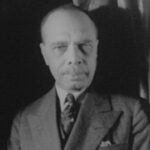 James Weldon Johnson, writer, composer, educator, diplomat, social critic, and civil rights activist, is born in Jacksonville, Florida. In 1898, Johnson became one of the first African Americans admitted to the Florida bar, though he did not subsequently practice law. Johnson served as U.S. consul in Venezuela and Nicaragua for most of the period from 1906 to 1913. In 1920, Johnson became the first African American appointed to lead the National Association for the Advancement of Colored People (NAACP). As a writer, Johnson was known during the Harlem Renaissance for his poems, novels, and anthologies collecting both poems and spirituals of Black culture. He wrote the lyrics for "Lift Every Voice and Sing", which later became known as the “Negro National Anthem”. In 1934 he was the first African-American professor to be hired at New York University. Later in life, he was a professor of creative literature and writing at Fisk University, a historically black university. Learn more. James Weldon Johnson, writer, composer, educator, diplomat, social critic, and civil rights activist, is born in Jacksonville, Florida. In 1898, Johnson became one of the first African Americans admitted to the Florida bar, though he did not subsequently practice law. Johnson served as U.S. consul in Venezuela and Nicaragua for most of the period from 1906 to 1913. In 1920, Johnson became the first African American appointed to lead the National Association for the Advancement of Colored People (NAACP). As a writer, Johnson was known during the Harlem Renaissance for his poems, novels, and anthologies collecting both poems and spirituals of Black culture. He wrote the lyrics for "Lift Every Voice and Sing", which later became known as the “Negro National Anthem”. In 1934 he was the first African-American professor to be hired at New York University. Later in life, he was a professor of creative literature and writing at Fisk University, a historically black university. Learn more. | |
| June 17, 1971 | 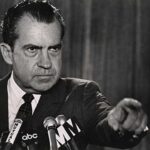 President Richard Nixon launches what becomes known as the “War on Drugs." Since Nixon’s announcement, the United States has had a 700 percent increase in the national prison population and become the world's most carceral nation. Although the country accounts for only five percent of the world's population, it confines 25 percent of the world's prisoners. According to the Federal Bureau of Prisons, nearly 50 percent of people in federal prisons are currently incarcerated for nonviolent drug offenses. The drug war has been waged almost exclusively in poor communities of color. Though rates of drug use and sales are comparable across racial lines, people of color are far more likely to be stopped, searched, arrested, prosecuted, convicted, and incarcerated for drug law violations when compared to white people. Learn more. President Richard Nixon launches what becomes known as the “War on Drugs." Since Nixon’s announcement, the United States has had a 700 percent increase in the national prison population and become the world's most carceral nation. Although the country accounts for only five percent of the world's population, it confines 25 percent of the world's prisoners. According to the Federal Bureau of Prisons, nearly 50 percent of people in federal prisons are currently incarcerated for nonviolent drug offenses. The drug war has been waged almost exclusively in poor communities of color. Though rates of drug use and sales are comparable across racial lines, people of color are far more likely to be stopped, searched, arrested, prosecuted, convicted, and incarcerated for drug law violations when compared to white people. Learn more. | |
| June 17, 2015 |  In the Charleston Church Massacre, nine African Americans, including senior pastor and state senator Clementa C. Pinckney, are killed by a 21-year-old white supremacist during a Bible study at the Emanuel African Methodist Episcopal Church in Charleston, South Carolina. The church is one of the oldest Black churches in the United States and has long been a center for civil rights organizing. The killer, Dylann Roof, targeted members of the church because of its history and stature. Learn more. In the Charleston Church Massacre, nine African Americans, including senior pastor and state senator Clementa C. Pinckney, are killed by a 21-year-old white supremacist during a Bible study at the Emanuel African Methodist Episcopal Church in Charleston, South Carolina. The church is one of the oldest Black churches in the United States and has long been a center for civil rights organizing. The killer, Dylann Roof, targeted members of the church because of its history and stature. Learn more. | |
| June 18, 1822 | 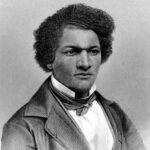 Denmark Vesey (also Telemaque), a free African American carpenter and leader in Charleston, South Carolina, is arrested on accusations he is the leader of a planned major slave revolt scheduled to take place in the city. He will be executed on July 2. Learn more. Denmark Vesey (also Telemaque), a free African American carpenter and leader in Charleston, South Carolina, is arrested on accusations he is the leader of a planned major slave revolt scheduled to take place in the city. He will be executed on July 2. Learn more. | |
| June 18, 1889 | 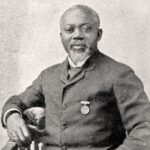 African American inventor William H. Richardson receives U.S. patent 405,600 for his invention of the reversible baby carriage. Richardson’s innovation ditched the existing shell shaped carrier for a basket-shaped carriage that was more symmetrical. The bassinet could be positioned to face either out or in and rotated on a central joint. A limiting device kept it from being rotated more than 90 degrees. The wheels also moved independently, which made it more maneuverable. Now a parent or nanny could have the child face them or face away from them, whichever they preferred, and change it at will. Learn more. African American inventor William H. Richardson receives U.S. patent 405,600 for his invention of the reversible baby carriage. Richardson’s innovation ditched the existing shell shaped carrier for a basket-shaped carriage that was more symmetrical. The bassinet could be positioned to face either out or in and rotated on a central joint. A limiting device kept it from being rotated more than 90 degrees. The wheels also moved independently, which made it more maneuverable. Now a parent or nanny could have the child face them or face away from them, whichever they preferred, and change it at will. Learn more. | |
| June 18, 1942 | 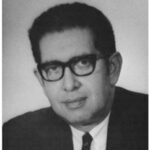 Bernard W. Robinson becomes the first African American Naval officer, commissioned in the US Naval Reserve. Facing ubiquitous discrimination, African Americans were, until this action, not even considered for commissions. Robinson attended Harvard Medical School and became a prominent radiologist after the war. Dedicated to the care of veterans, Robinson served in the Veterans Administration Hospitals system for the remainder of his career, interrupted only by his re-enlistment in the Navy from 1953-55. Learn more. Bernard W. Robinson becomes the first African American Naval officer, commissioned in the US Naval Reserve. Facing ubiquitous discrimination, African Americans were, until this action, not even considered for commissions. Robinson attended Harvard Medical School and became a prominent radiologist after the war. Dedicated to the care of veterans, Robinson served in the Veterans Administration Hospitals system for the remainder of his career, interrupted only by his re-enlistment in the Navy from 1953-55. Learn more. | |
| June 18, 1968 | 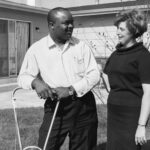 The United States Supreme Court releases its landmark decision in Jones v. Alfred H. Mayer Co, banning housing discrimination in sales and rentals. Reversing many precedents, the Court holds that: (1) Congress can regulate the sale of private property to prevent racial discrimination; (2) the Civil Rights Act of 1866 bars all racial discrimination, private as well as public, in the sale or rental of property; and (3) that the law is a valid exercise of the power of Congress to enforce the Thirteenth Amendment. Learn more. The United States Supreme Court releases its landmark decision in Jones v. Alfred H. Mayer Co, banning housing discrimination in sales and rentals. Reversing many precedents, the Court holds that: (1) Congress can regulate the sale of private property to prevent racial discrimination; (2) the Civil Rights Act of 1866 bars all racial discrimination, private as well as public, in the sale or rental of property; and (3) that the law is a valid exercise of the power of Congress to enforce the Thirteenth Amendment. Learn more. | |
| June 19, 1864 | 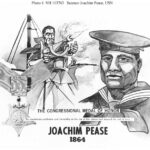 Black United States Navy sailor Joachim Pease, serving as an artillery loader on the USS Kearsarge in battle against the Confederate sloop-of-war CSS Alabama off the coast of Cherbourg, France, during the Civil War, performs in a manner that “fully sustained his reputation as one of the best men in the ship.” For his conduct during this Battle of Cherbourg, Pease was awarded America's highest military decoration, the Medal of Honor, with the citation: “Served as seaman on board the U.S.S. Kearsarge when she destroyed the Alabama off Cherbourg, France, 19 June 1864. Acting as loader on the No. 2 gun during this bitter engagement, Pease exhibited marked coolness and good conduct and was highly recommended by the divisional officer for gallantry under fire.” He left the Navy at the end of his enlistment never having received his Medal of Honor. It is on display in the National Museum of the United States Navy, located in the Washington Navy Yard, Washington, D.C. Learn more. Black United States Navy sailor Joachim Pease, serving as an artillery loader on the USS Kearsarge in battle against the Confederate sloop-of-war CSS Alabama off the coast of Cherbourg, France, during the Civil War, performs in a manner that “fully sustained his reputation as one of the best men in the ship.” For his conduct during this Battle of Cherbourg, Pease was awarded America's highest military decoration, the Medal of Honor, with the citation: “Served as seaman on board the U.S.S. Kearsarge when she destroyed the Alabama off Cherbourg, France, 19 June 1864. Acting as loader on the No. 2 gun during this bitter engagement, Pease exhibited marked coolness and good conduct and was highly recommended by the divisional officer for gallantry under fire.” He left the Navy at the end of his enlistment never having received his Medal of Honor. It is on display in the National Museum of the United States Navy, located in the Washington Navy Yard, Washington, D.C. Learn more.
| |
| June 19, 1865 | 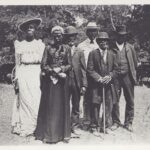 Two months after the surrender of the Confederacy, Union troops arrive in Texas and for the first time inform local Black men, women, and children that the Confederacy lost the war and that they were free under the Emancipation Proclamation. The date came to be known as “Juneteenth” in the African American community, and has for generations remained a day of remembrance, joyous celebration, and hope: remembrance of the hardships and pain of enslavement; joyous celebration of survival; and hope for the opportunity and peace that freedom ought to bring. Juneteenth does not denote a struggle completed or a finished line reached. Black Americans faced many threats to their liberty and their lives in the years after the Civil War, and face continued injustice today as the struggle continues. Learn more. Two months after the surrender of the Confederacy, Union troops arrive in Texas and for the first time inform local Black men, women, and children that the Confederacy lost the war and that they were free under the Emancipation Proclamation. The date came to be known as “Juneteenth” in the African American community, and has for generations remained a day of remembrance, joyous celebration, and hope: remembrance of the hardships and pain of enslavement; joyous celebration of survival; and hope for the opportunity and peace that freedom ought to bring. Juneteenth does not denote a struggle completed or a finished line reached. Black Americans faced many threats to their liberty and their lives in the years after the Civil War, and face continued injustice today as the struggle continues. Learn more. | |
| June 19, 1953 | 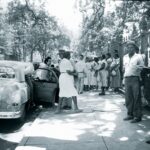 African-American residents of Baton Rouge, Louisiana begin the Baton Rouge bus boycott of city buses in order to secure integration of the system. African Americans made up about 80% of the ridership of the city buses in the early 1950s but, under Jim Crow rules, Black people were forced to sit in the back of the bus, even when the front of the bus was empty. State laws prohibited Black citizens from owning private buses outside the city systems. The boycott ended after six hours when the city passed Ordinance 251, which directed that Black riders would fill the bus from the rear forward and whites from the front toward the back. Blacks and whites were prohibited from sitting next to each other in the same row. Two front seats were declared off-limits to Black riders, and only Black riders could occupy the wide rear seat that spanned the back of the bus. The 1953 Baton Rouge Bus boycott served as a model for the internationally known 1955 Montgomery bus boycott. The 1953 Baton Rouge Bus boycott also inspired residents to mobilize around other issues, such as securing the right to vote. Learn more. African-American residents of Baton Rouge, Louisiana begin the Baton Rouge bus boycott of city buses in order to secure integration of the system. African Americans made up about 80% of the ridership of the city buses in the early 1950s but, under Jim Crow rules, Black people were forced to sit in the back of the bus, even when the front of the bus was empty. State laws prohibited Black citizens from owning private buses outside the city systems. The boycott ended after six hours when the city passed Ordinance 251, which directed that Black riders would fill the bus from the rear forward and whites from the front toward the back. Blacks and whites were prohibited from sitting next to each other in the same row. Two front seats were declared off-limits to Black riders, and only Black riders could occupy the wide rear seat that spanned the back of the bus. The 1953 Baton Rouge Bus boycott served as a model for the internationally known 1955 Montgomery bus boycott. The 1953 Baton Rouge Bus boycott also inspired residents to mobilize around other issues, such as securing the right to vote. Learn more. | |
| June 19, 1964 | 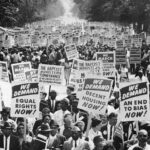 The United States Senate breaks an 83-day filibuster in order to vote on and pass, with an amendment, the Civil Rights Act of 1964, a landmark civil rights and labor law in the United States that outlaws discrimination based on race, color, religion, sex, national origin, and later sexual orientation and gender identity. It prohibits unequal application of voter registration requirements, racial segregation in schools and public accommodations, and employment discrimination. The act "remains one of the most significant legislative achievements in American history". The U.S. House of Representatives approved the Senate amendment on July 2, 1964, and President Lyndon Johnson signed the full Act that same day. Learn more. The United States Senate breaks an 83-day filibuster in order to vote on and pass, with an amendment, the Civil Rights Act of 1964, a landmark civil rights and labor law in the United States that outlaws discrimination based on race, color, religion, sex, national origin, and later sexual orientation and gender identity. It prohibits unequal application of voter registration requirements, racial segregation in schools and public accommodations, and employment discrimination. The act "remains one of the most significant legislative achievements in American history". The U.S. House of Representatives approved the Senate amendment on July 2, 1964, and President Lyndon Johnson signed the full Act that same day. Learn more. | |
| June 20, 1894 | 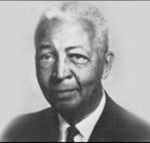 Chemist Lloyd Augustus Hall, who contributed to the science of food preservation, is born in Elgin, IL. By the end of his career, Hall had amassed 59 United States patents, and a number of his inventions were also patented in other countries. Hall's grandmother came to Illinois using the "Underground Railroad" at the age of sixteen. His grandfather came to Chicago in 1837 and was one of the founders of the Quinn Chapel A.M.E. Church. Hall earned a B.S. in pharmaceutical chemistry from Northwestern University and a Master's degree at the University of Chicago. After leaving university, Hall was hired by the Western Electric Company after a phone interview. The company refused to hire Hall after they discovered he was Black. Hall then went to work as a chemist for the Department of Health in Chicago followed by a job as chief chemist with the John Morrell Company. During World War I, Hall served with the United States Ordnance Department where he was promoted to Chief Inspector of Powder and Explosives. In 2004, he was inducted into the National Inventors Hall of Fame for his work. Following the war, Hall worked as chief chemist for the Boyer Chemical Laboratory. Following this, Hall became President and Chemical director for Chemical Products Corporation's consulting laboratory. In 1925, Hall took a position with Griffith Laboratories where he remained for 34 years. Learn more. Chemist Lloyd Augustus Hall, who contributed to the science of food preservation, is born in Elgin, IL. By the end of his career, Hall had amassed 59 United States patents, and a number of his inventions were also patented in other countries. Hall's grandmother came to Illinois using the "Underground Railroad" at the age of sixteen. His grandfather came to Chicago in 1837 and was one of the founders of the Quinn Chapel A.M.E. Church. Hall earned a B.S. in pharmaceutical chemistry from Northwestern University and a Master's degree at the University of Chicago. After leaving university, Hall was hired by the Western Electric Company after a phone interview. The company refused to hire Hall after they discovered he was Black. Hall then went to work as a chemist for the Department of Health in Chicago followed by a job as chief chemist with the John Morrell Company. During World War I, Hall served with the United States Ordnance Department where he was promoted to Chief Inspector of Powder and Explosives. In 2004, he was inducted into the National Inventors Hall of Fame for his work. Following the war, Hall worked as chief chemist for the Boyer Chemical Laboratory. Following this, Hall became President and Chemical director for Chemical Products Corporation's consulting laboratory. In 1925, Hall took a position with Griffith Laboratories where he remained for 34 years. Learn more. | |
| June 20, 1940 | 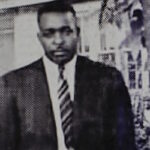 NAACP leader Elbert Williams is abducted from his home in Brownsville, Tennessee, by a group of white men led by the local sheriff and the night marshal. Three days later, Mr. Williams’s lifeless and brutalized body was found in the nearby Hatchie River. He was 31 years old. Williams’s murder was a continuation of the white supremacist terrorism that had prevented African Americans — who, by 1940, made up 75% of the 19,000 people living in town — from voting in Brownsville since 1884. Despite investigations launched by local authorities, the Department of Justice, and the FBI, charges were never lodged against the well-known men responsible. According to one contemporary observer, the perpetrators of the abuses and murders “can be seen in Brownsville each day going about their work as though they had killed only a rabbit.” Learn more. NAACP leader Elbert Williams is abducted from his home in Brownsville, Tennessee, by a group of white men led by the local sheriff and the night marshal. Three days later, Mr. Williams’s lifeless and brutalized body was found in the nearby Hatchie River. He was 31 years old. Williams’s murder was a continuation of the white supremacist terrorism that had prevented African Americans — who, by 1940, made up 75% of the 19,000 people living in town — from voting in Brownsville since 1884. Despite investigations launched by local authorities, the Department of Justice, and the FBI, charges were never lodged against the well-known men responsible. According to one contemporary observer, the perpetrators of the abuses and murders “can be seen in Brownsville each day going about their work as though they had killed only a rabbit.” Learn more. | |
| June 20, 1943 | 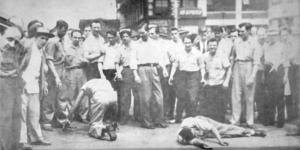 The 1943 Detroit race riot starts in the evening, one of five race riots in the U.S. that summer; it followed riots in Beaumont, TX, Harlem, NY, Los Angeles, CA (the Zoot Suit Riot), and Mobile, AL. The Detroit riot would continue until suppressed by 6,000 federal troops on the morning of June 22. A total of 34 people were killed, 25 of them Black and most at the hands of the white police force, while 433 were wounded (75 percent of them Black), and property valued at $2 million ($30.4 million in 2020 US dollars) was destroyed. Most of the riot took place in the Black area of Paradise Valley, the poorest neighborhood of the city. White commissions of the time falsely attributed the cause of the riot to Black people and youths. A late 20th-century analysis of the rioters showed that the white rioters were younger and often unemployed (characteristics that the riot commissions had falsely attributed to Blacks, despite evidence in front of them). If working, the whites often held semi-skilled or skilled positions. Whites traveled long distances across the city to join the first stage of the riot near the bridge to Belle Isle Park, and later some traveled in armed groups explicitly to attack the Black neighborhood in Paradise Valley. The Black participants were often older, established city residents, who in many cases had lived in the city for more than a decade. Many were married working men and were defending their homes and neighborhood against police and white rioters. Learn more. The 1943 Detroit race riot starts in the evening, one of five race riots in the U.S. that summer; it followed riots in Beaumont, TX, Harlem, NY, Los Angeles, CA (the Zoot Suit Riot), and Mobile, AL. The Detroit riot would continue until suppressed by 6,000 federal troops on the morning of June 22. A total of 34 people were killed, 25 of them Black and most at the hands of the white police force, while 433 were wounded (75 percent of them Black), and property valued at $2 million ($30.4 million in 2020 US dollars) was destroyed. Most of the riot took place in the Black area of Paradise Valley, the poorest neighborhood of the city. White commissions of the time falsely attributed the cause of the riot to Black people and youths. A late 20th-century analysis of the rioters showed that the white rioters were younger and often unemployed (characteristics that the riot commissions had falsely attributed to Blacks, despite evidence in front of them). If working, the whites often held semi-skilled or skilled positions. Whites traveled long distances across the city to join the first stage of the riot near the bridge to Belle Isle Park, and later some traveled in armed groups explicitly to attack the Black neighborhood in Paradise Valley. The Black participants were often older, established city residents, who in many cases had lived in the city for more than a decade. Many were married working men and were defending their homes and neighborhood against police and white rioters. Learn more. | |
| June 21, 1832 | 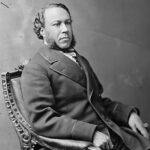 Joseph Hayne Rainey is born into slavery in South Carolina. Following the Civil War, he was the first Black person to serve in the United States House of Representatives and the second Black person (after Hiram Revels) to serve in the United States Congress. His service included time as presiding officer of the House of Representatives. Both Revels and Rainey were members of the Republican Party. Toward the end of Reconstruction, Rainey moved his family to Windsor, Connecticut in order to escape white supremacist terror groups associated with southern Democratic Party. Learn more. Joseph Hayne Rainey is born into slavery in South Carolina. Following the Civil War, he was the first Black person to serve in the United States House of Representatives and the second Black person (after Hiram Revels) to serve in the United States Congress. His service included time as presiding officer of the House of Representatives. Both Revels and Rainey were members of the Republican Party. Toward the end of Reconstruction, Rainey moved his family to Windsor, Connecticut in order to escape white supremacist terror groups associated with southern Democratic Party. Learn more. | |
| June 21, 1859 | 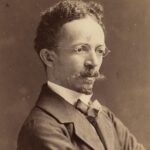 Internationally acclaimed painter Henry Ossawa Tanner is born. After his own self-study in art as a young man, Tanner enrolled in 1879 at the Pennsylvania Academy of the Fine Arts in Philadelphia. The only Black student, he became a favorite of the painter Thomas Eakins, who had recently begun teaching there. Although Tanner gained confidence as an artist and began to sell his work, he faced racism working as a professional artist in Philadelphia. In his autobiography, The Story of an Artist's Life, Tanner described the burden of racism: Internationally acclaimed painter Henry Ossawa Tanner is born. After his own self-study in art as a young man, Tanner enrolled in 1879 at the Pennsylvania Academy of the Fine Arts in Philadelphia. The only Black student, he became a favorite of the painter Thomas Eakins, who had recently begun teaching there. Although Tanner gained confidence as an artist and began to sell his work, he faced racism working as a professional artist in Philadelphia. In his autobiography, The Story of an Artist's Life, Tanner described the burden of racism:
“I was extremely timid and to be made to feel that I was not wanted, although in a place where I had every right to be, even months afterwards caused me sometimes weeks of pain. Every time any one of these disagreeable incidents came into my mind, my heart sank, and I was anew tortured by the thought of what I had endured, almost as much as the incident itself.” Tanner moved to Paris, France, in 1891 to study, and continued to live there after being accepted in French artistic circles. His painting entitled Daniel in the Lions' Den was accepted into the 1896 Salon, the official art exhibition of the Académie des Beaux-Arts in Paris. In the late 1890s he was sponsored for a trip to the Mutasarrifate of Jerusalem by Rodman Wanamaker, who was impressed by his paintings of biblical themes. In his adopted home of France, in 1923 Tanner received one of its highest honors, when he was appointed Chevalier of the Legion of Honor, the highest national order of merit. He considered this "citation by the French government to be the greatest honor of his illustrious career." Learn more. | |
| June 21, 1940 |  A 26-year-old Black man named Jesse Thornton is lynched in Luverne, Alabama for failing to call a white man “Mr.”. Thornton referred to a passing white police officer by his name: Doris Rhodes. When the officer overheard, Thornton attempted to correct himself by referring to the officer as “Mr. Doris Rhodes.” Unsatisfied, the officer hurled a racial slur at Mr. Thornton while knocking him to the ground, then arrested him and took him into the city jail as a mob of white men formed just outside. When Mr. Thornton attempted to flee, the mob pursued, firing gunshots and pelting him with bricks, bats, and stones. The white mob shot Mr. Thornton, dumped him into a truck, drove him to to an isolated street, dragged him into a nearby swamp, and shot him again. A local fisherman found Mr. Thornton’s decomposing, vulture-ravaged body a week later in the Patsaliga River, near Tuskegee Institute. There is no record that anyone was ever prosecuted for Mr. Thornton’s murder. Learn more. A 26-year-old Black man named Jesse Thornton is lynched in Luverne, Alabama for failing to call a white man “Mr.”. Thornton referred to a passing white police officer by his name: Doris Rhodes. When the officer overheard, Thornton attempted to correct himself by referring to the officer as “Mr. Doris Rhodes.” Unsatisfied, the officer hurled a racial slur at Mr. Thornton while knocking him to the ground, then arrested him and took him into the city jail as a mob of white men formed just outside. When Mr. Thornton attempted to flee, the mob pursued, firing gunshots and pelting him with bricks, bats, and stones. The white mob shot Mr. Thornton, dumped him into a truck, drove him to to an isolated street, dragged him into a nearby swamp, and shot him again. A local fisherman found Mr. Thornton’s decomposing, vulture-ravaged body a week later in the Patsaliga River, near Tuskegee Institute. There is no record that anyone was ever prosecuted for Mr. Thornton’s murder. Learn more. | |
| June 21, 1964 | 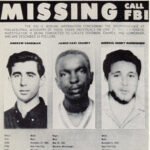 James Chaney, Andrew Goodman, and Michael Schwerner, three civil rights workers attempting to register African Americans in Mississippi to vote, are murdered in Neshoba County, Mississippi, United States, by members of the Ku Klux Klan. The trio was arrested following a traffic stop for speeding outside Philadelphia, Mississippi, escorted to the local jail, and held several hours. As the three left town in their car, they were followed by law enforcement and others. Before leaving Neshoba County, their car was pulled over. The three were abducted, driven to another location, and shot to death at close range. The three men's bodies were not discovered until two months later. During the investigation it emerged that members of the local White Knights of the Ku Klux Klan, the Neshoba County Sheriff's Office, and the Philadelphia Police Department were involved in the incident. The murder of the activists sparked national outrage and an extensive federal investigation. In 1967, after the state government refused to prosecute, the United States federal government charged eighteen individuals with civil rights violations. Seven were convicted and received relatively minor sentences for their actions. Outrage over the activists' disappearances helped gain passage of the Civil Rights Act of 1964. Learn more. James Chaney, Andrew Goodman, and Michael Schwerner, three civil rights workers attempting to register African Americans in Mississippi to vote, are murdered in Neshoba County, Mississippi, United States, by members of the Ku Klux Klan. The trio was arrested following a traffic stop for speeding outside Philadelphia, Mississippi, escorted to the local jail, and held several hours. As the three left town in their car, they were followed by law enforcement and others. Before leaving Neshoba County, their car was pulled over. The three were abducted, driven to another location, and shot to death at close range. The three men's bodies were not discovered until two months later. During the investigation it emerged that members of the local White Knights of the Ku Klux Klan, the Neshoba County Sheriff's Office, and the Philadelphia Police Department were involved in the incident. The murder of the activists sparked national outrage and an extensive federal investigation. In 1967, after the state government refused to prosecute, the United States federal government charged eighteen individuals with civil rights violations. Seven were convicted and received relatively minor sentences for their actions. Outrage over the activists' disappearances helped gain passage of the Civil Rights Act of 1964. Learn more. | |
| June 22, 1908 | 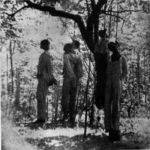 In a reign of racial terror set off by the shooting death of a white farmer in his home by an unknown assailant the prior evening, nine Black men are lynched in Sabine County, Texas, within a 24-hour period. A mob of about 200 white men broke into the local jail and seized six Black men who were incarcerated at the time of the shooting—Jerry Evans, William Johnson, William Manuel, Moses Spellman, Cleveland Williams, and Frank Williams. The mob hung five of the men from a tree outside of the jail and shot the sixth in the back as he tried to escape. Later that evening, marauding white men shot and killed a Black man named Bill McCoy near the white farmer's home, and shot and killed two unidentified Black men and threw their bodies into a creek. A Black church and school house in the town were also burned to the ground. Learn more. In a reign of racial terror set off by the shooting death of a white farmer in his home by an unknown assailant the prior evening, nine Black men are lynched in Sabine County, Texas, within a 24-hour period. A mob of about 200 white men broke into the local jail and seized six Black men who were incarcerated at the time of the shooting—Jerry Evans, William Johnson, William Manuel, Moses Spellman, Cleveland Williams, and Frank Williams. The mob hung five of the men from a tree outside of the jail and shot the sixth in the back as he tried to escape. Later that evening, marauding white men shot and killed a Black man named Bill McCoy near the white farmer's home, and shot and killed two unidentified Black men and threw their bodies into a creek. A Black church and school house in the town were also burned to the ground. Learn more. | |
| June 22, 1909 | 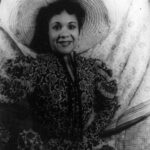 African-American dancer, choreographer, creator of the Dunham Technique, author, educator, anthropologist, and social activist Katherine Dunham is born. Dunham had one of the most successful dance careers in African-American and European theater of the 20th century, and directed her own dance company for many years. She has been called the "matriarch and queen mother of Black dance." Dunham was an innovator in African-American modern dance as well as a leader in the field of dance anthropology, or ethnochoreology. Learn more. African-American dancer, choreographer, creator of the Dunham Technique, author, educator, anthropologist, and social activist Katherine Dunham is born. Dunham had one of the most successful dance careers in African-American and European theater of the 20th century, and directed her own dance company for many years. She has been called the "matriarch and queen mother of Black dance." Dunham was an innovator in African-American modern dance as well as a leader in the field of dance anthropology, or ethnochoreology. Learn more. | |
| June 23, 1855 | 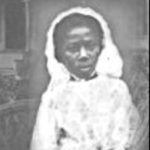 A sixty-five-year-old white enslaver named Robert Newsom tells Celia, an enslaved Black woman on his property, that he was “coming to her cabin” that night. Newsom had repeatedly raped Celia since she was 14 years old. When Newsom arrives that evening and lowers his face over hers, Celia strikes him in the head with a stick, killing him. Under Missouri law at the time, a woman who believed she was in “imminent danger of forced sexual intercourse” could be acquitted of murder based on a theory of self-defense. However, the judge in Celia’s case refused to give such an instruction to the jury because, in his view, an enslaved woman had no right to refuse her “master.” Celia was convicted of first-degree murder on October 10, 1855. On December 20, 1855, she was hanged. Learn more. A sixty-five-year-old white enslaver named Robert Newsom tells Celia, an enslaved Black woman on his property, that he was “coming to her cabin” that night. Newsom had repeatedly raped Celia since she was 14 years old. When Newsom arrives that evening and lowers his face over hers, Celia strikes him in the head with a stick, killing him. Under Missouri law at the time, a woman who believed she was in “imminent danger of forced sexual intercourse” could be acquitted of murder based on a theory of self-defense. However, the judge in Celia’s case refused to give such an instruction to the jury because, in his view, an enslaved woman had no right to refuse her “master.” Celia was convicted of first-degree murder on October 10, 1855. On December 20, 1855, she was hanged. Learn more. | |
| June 23, 1940 |  American sprinter and world-record-holding Olympic champion Wilma Glodean Rudolph is born. Rudolph became an international sports icon in track and field following her successes in the 1956 and 1960 Olympic Games. Rudolph competed in the 200-meter dash and won a bronze medal in the 4 × 100-meter relay at the 1956 Summer Olympics at Melbourne, Australia. She also won three gold medals, in the 100- and 200-meter individual events and the 4 x 100-meter relay at the 1960 Summer Olympics in Rome, Italy. Rudolph was acclaimed the fastest woman in the world in the 1960s and became the first American woman to win three gold medals in a single Olympic Games. As an Olympic champion in the early 1960s, Rudolph was among the most highly visible Black women in America and abroad. She became a role model for Black and female athletes and her Olympic successes helped elevate women's track and field in the United States. Rudolph is also regarded as a civil rights and women's rights pioneer. In 1962 Rudolph retired from competition at the peak of her athletic career as the world record-holder in the 100- and 200-meter individual events and the 4 × 100-meter relays. After competing in the 1960 Summer Olympics, the 1963 graduate of Tennessee State University became an educator and coach. Learn more. American sprinter and world-record-holding Olympic champion Wilma Glodean Rudolph is born. Rudolph became an international sports icon in track and field following her successes in the 1956 and 1960 Olympic Games. Rudolph competed in the 200-meter dash and won a bronze medal in the 4 × 100-meter relay at the 1956 Summer Olympics at Melbourne, Australia. She also won three gold medals, in the 100- and 200-meter individual events and the 4 x 100-meter relay at the 1960 Summer Olympics in Rome, Italy. Rudolph was acclaimed the fastest woman in the world in the 1960s and became the first American woman to win three gold medals in a single Olympic Games. As an Olympic champion in the early 1960s, Rudolph was among the most highly visible Black women in America and abroad. She became a role model for Black and female athletes and her Olympic successes helped elevate women's track and field in the United States. Rudolph is also regarded as a civil rights and women's rights pioneer. In 1962 Rudolph retired from competition at the peak of her athletic career as the world record-holder in the 100- and 200-meter individual events and the 4 × 100-meter relays. After competing in the 1960 Summer Olympics, the 1963 graduate of Tennessee State University became an educator and coach. Learn more. | |
| June 23, 1972 | 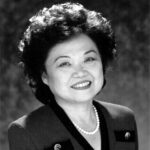 Title IX of the United States Civil Rights Act of 1964 is amended to prohibit sexual discrimination to any educational program receiving federal funds. The early legislative draft was authored by Representative Patsy Mink with the assistance of Representative Edith Green. It was then co-authored and introduced to Congress by Senator Birch Bayh in the U.S. Senate, and Congresswoman Patsy Mink in the House. It was later renamed the Patsy T. Mink Equal Opportunity in Education Act following Mink's death in 2002. Learn more. Title IX of the United States Civil Rights Act of 1964 is amended to prohibit sexual discrimination to any educational program receiving federal funds. The early legislative draft was authored by Representative Patsy Mink with the assistance of Representative Edith Green. It was then co-authored and introduced to Congress by Senator Birch Bayh in the U.S. Senate, and Congresswoman Patsy Mink in the House. It was later renamed the Patsy T. Mink Equal Opportunity in Education Act following Mink's death in 2002. Learn more. | |
| June 24, 1884 | 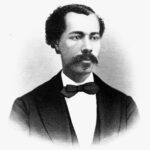 John R. Lynch, former congressman from Mississippi, is elected temporary chairman of the Republican Party Convention, thereby becoming the first African American to preside over deliberations of a national political party.
Lynch (September 10, 1847 – November 2, 1939) was a Black Republican politician, writer, attorney and military officer. Born into slavery in Louisiana, he became free in 1863 under the Emancipation Proclamation. After serving for several years in the state legislature, in 1873 Lynch was elected as the first African-American Speaker of the Mississippi House of Representatives; he was the first Black man to hold this position in the country. During Reconstruction after the American Civil War, he was among the first generation of African Americans from the South elected to the U.S. House of Representatives, serving from 1873 to 1877 and again in the 1880s. Faced with increasing restrictions in Mississippi, Lynch studied law, passed the bar, and returned to Washington, DC to set up a practice.
After Democrats regained power in the state legislature following Reconstruction, in 1890 they disenfranchised most Blacks in the state (who were a majority of the population) by a new constitution that raised barriers to voter registration. Seeing the effects of disenfranchisement, Lynch left the state and returned to Washington, DC to practice law. He served in the United States Army during the Spanish–American War and for a decade into the early 1900s, achieving the rank of major. After retiring, Lynch moved to Chicago, Illinois, where he lived for more than two decades. After his military service, Lynch was active in law and real estate in Chicago.
Beginning in 1877, when Reconstruction ended with the federal government withdrawing its troops from the South, Lynch wrote and published four books: these analyzed the political situation in the South during and after Reconstruction. He is best known for his book, The Facts of Reconstruction (1913). It is available online at the Gutenberg Project. In it, he argued against the prevailing view of the Dunning School, conservative white historians who downplayed African-American contributions and the achievements of the Reconstruction era. Lynch emphasized how significant was the ratification of the 14th and 15th Amendments to the Constitution, which granted full citizenship to all persons without restriction of race or color, and suffrage to minority males. Learn more. John R. Lynch, former congressman from Mississippi, is elected temporary chairman of the Republican Party Convention, thereby becoming the first African American to preside over deliberations of a national political party.
Lynch (September 10, 1847 – November 2, 1939) was a Black Republican politician, writer, attorney and military officer. Born into slavery in Louisiana, he became free in 1863 under the Emancipation Proclamation. After serving for several years in the state legislature, in 1873 Lynch was elected as the first African-American Speaker of the Mississippi House of Representatives; he was the first Black man to hold this position in the country. During Reconstruction after the American Civil War, he was among the first generation of African Americans from the South elected to the U.S. House of Representatives, serving from 1873 to 1877 and again in the 1880s. Faced with increasing restrictions in Mississippi, Lynch studied law, passed the bar, and returned to Washington, DC to set up a practice.
After Democrats regained power in the state legislature following Reconstruction, in 1890 they disenfranchised most Blacks in the state (who were a majority of the population) by a new constitution that raised barriers to voter registration. Seeing the effects of disenfranchisement, Lynch left the state and returned to Washington, DC to practice law. He served in the United States Army during the Spanish–American War and for a decade into the early 1900s, achieving the rank of major. After retiring, Lynch moved to Chicago, Illinois, where he lived for more than two decades. After his military service, Lynch was active in law and real estate in Chicago.
Beginning in 1877, when Reconstruction ended with the federal government withdrawing its troops from the South, Lynch wrote and published four books: these analyzed the political situation in the South during and after Reconstruction. He is best known for his book, The Facts of Reconstruction (1913). It is available online at the Gutenberg Project. In it, he argued against the prevailing view of the Dunning School, conservative white historians who downplayed African-American contributions and the achievements of the Reconstruction era. Lynch emphasized how significant was the ratification of the 14th and 15th Amendments to the Constitution, which granted full citizenship to all persons without restriction of race or color, and suffrage to minority males. Learn more. | |
| June 24, 1936 | 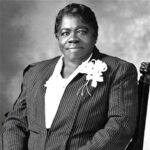 Mary Mcleod Bethune is named the Director of Negro Affairs of the National Youth Administration, the first African American women to receive a major appointment in the federal government. Bethune (July 10, 1875 – May 18, 1955) was an American educator, stateswoman, philanthropist, humanitarian, womanist, and civil rights activist. Bethune founded the National Council for Negro Women in 1935, established the organization's flagship journal Aframerican Women's Journal, and resided as president or leader for myriad African American women's organizations including the National Association for Colored Women and the National Youth Administration's Negro Division. She also was appointed as a national adviser to president Franklin D. Roosevelt, whom she worked with to create the Federal Council on colored Affairs, also known as the Black Cabinet. She is well known for starting a private school for African-American students in Daytona Beach, Florida; it later continued to develop as Bethune-Cookman University. Bethune was the sole African American woman officially a part of the US delegation that created the United Nations charter, and she held a leadership position for the American Women's Voluntary Services founded by Alice Throckmorton McLean. For her lifetime of activism, she was deemed "acknowledged First Lady of Negro America" by Ebony magazine in July 1949 and was known by the Black Press as the "Female Booker T. Washington". She was known as "The First Lady of The Struggle" because of her commitment to gain better lives for African Americans. Learn more. Mary Mcleod Bethune is named the Director of Negro Affairs of the National Youth Administration, the first African American women to receive a major appointment in the federal government. Bethune (July 10, 1875 – May 18, 1955) was an American educator, stateswoman, philanthropist, humanitarian, womanist, and civil rights activist. Bethune founded the National Council for Negro Women in 1935, established the organization's flagship journal Aframerican Women's Journal, and resided as president or leader for myriad African American women's organizations including the National Association for Colored Women and the National Youth Administration's Negro Division. She also was appointed as a national adviser to president Franklin D. Roosevelt, whom she worked with to create the Federal Council on colored Affairs, also known as the Black Cabinet. She is well known for starting a private school for African-American students in Daytona Beach, Florida; it later continued to develop as Bethune-Cookman University. Bethune was the sole African American woman officially a part of the US delegation that created the United Nations charter, and she held a leadership position for the American Women's Voluntary Services founded by Alice Throckmorton McLean. For her lifetime of activism, she was deemed "acknowledged First Lady of Negro America" by Ebony magazine in July 1949 and was known by the Black Press as the "Female Booker T. Washington". She was known as "The First Lady of The Struggle" because of her commitment to gain better lives for African Americans. Learn more.
| |
| June 24, 1943 | 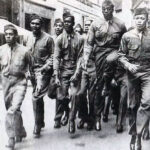 The Battle of Bamber Bridge, an outbreak of racial violence between Black and white American servicemen, takes place in the British village of Bamber Bridge, Lancashire. During WWII the US Armed Forces were racially segregated. Bamber Bridge hosted the Black 1511th US Quartermaster Truck regiment at one base and the white 234th US Military Police Company at a separate base. All but one of the officers of the Black regiment were white and the regiment was used as a “dumping ground” for less competent white officers. When the white US commanders had demanded a colour bar in the town, the people of Bamber Bridge supported the Black troops and all three pubs in the town posted "Black Troops Only" signs.
On the day of the incident, racial tensions were elevated due to race riots in Detroit earlier in the week, which had led to 34 deaths, including 25 black casualties. The Bamber Bridge incident was triggered when white MPs attempted to arrest several African American soldiers at the Ye Old Hob Inn public house in Bamber Bridge. After the arrival of more military police armed with machine guns, Black soldiers armed themselves with rifles from their base armoury. Both sides exchanged fire through the night. One Black soldier was killed and several MPs and soldiers injured. Although a court martial convicted 32 African American soldiers of mutiny and related crimes, the true cause of the incident was poor leadership and racist attitudes among the MPs. Learn more. The Battle of Bamber Bridge, an outbreak of racial violence between Black and white American servicemen, takes place in the British village of Bamber Bridge, Lancashire. During WWII the US Armed Forces were racially segregated. Bamber Bridge hosted the Black 1511th US Quartermaster Truck regiment at one base and the white 234th US Military Police Company at a separate base. All but one of the officers of the Black regiment were white and the regiment was used as a “dumping ground” for less competent white officers. When the white US commanders had demanded a colour bar in the town, the people of Bamber Bridge supported the Black troops and all three pubs in the town posted "Black Troops Only" signs.
On the day of the incident, racial tensions were elevated due to race riots in Detroit earlier in the week, which had led to 34 deaths, including 25 black casualties. The Bamber Bridge incident was triggered when white MPs attempted to arrest several African American soldiers at the Ye Old Hob Inn public house in Bamber Bridge. After the arrival of more military police armed with machine guns, Black soldiers armed themselves with rifles from their base armoury. Both sides exchanged fire through the night. One Black soldier was killed and several MPs and soldiers injured. Although a court martial convicted 32 African American soldiers of mutiny and related crimes, the true cause of the incident was poor leadership and racist attitudes among the MPs. Learn more. | |
| June 25, 1908 | 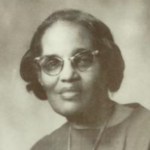 Poet, editor, founder of the Negro Bibliographic and Research Center, and editor of Bibliographic Survey: The Negro in Print, Beatrice M. Murphy Campbell (who published under the name Beatrice M. Murphy) is born. Murphy was a columnist and editor at the Washington Tribune in the early 1930s. In 1938, she became book review editor for the Afro-American. She worked as a secretary at Catholic University and was joint owner of a circulating library and stenography shop. She was a columnist for the Associated Negro Press and wrote poetry and reviews for many periodicals. She worked for the Office of Price Administration in the 1940s and 1950s and later at the Veterans Administration. She was suspended without pay from her job as procurement clerk in 1954 for supposedly having joined a subversive organization, the Washington Bookshop Association. She fought the charges—having never joined the organization but attended a pair of public lectures there—and was reinstated at her job which she retired from on disability in 1959. Murphy's first poetry anthology, Negro Voices, was published in 1938. She published two additional anthologies Ebony Rhythm in 1948, and New Negro Voices in 1970 which featured works by Nikki Giovanni and Carolyn M. Rodgers. Her anthologies published and preserved poetry by Black Americans that were mostly not published by major journals. She also wrote poetry books including the titles Love is a terrible thing; Get with it, Lord; and The rocks cry out. Her poems were also published in The Crisis and other publications. The Negro Bibliographic and Research Center was founded in 1965 and was a nonprofit and "nonpolitical" organization which published bibliographies and provided research "...to help meet the reading public's growing interest in the vast amount of written material on the Negro." The organization's publication Bibliographic Survey: The Negro in Print, was published between 1965 and 1971. The organization was later renamed The Minority Research Center Inc. In 1977, the Beatrice M. Murphy Foundation was created by her friends to encourage the collection and dissemination of books by and about Black people. Murphy also donated 1700 books from her personal collection to improve DC Public Library's Black Studies Center holdings. Learn more. Poet, editor, founder of the Negro Bibliographic and Research Center, and editor of Bibliographic Survey: The Negro in Print, Beatrice M. Murphy Campbell (who published under the name Beatrice M. Murphy) is born. Murphy was a columnist and editor at the Washington Tribune in the early 1930s. In 1938, she became book review editor for the Afro-American. She worked as a secretary at Catholic University and was joint owner of a circulating library and stenography shop. She was a columnist for the Associated Negro Press and wrote poetry and reviews for many periodicals. She worked for the Office of Price Administration in the 1940s and 1950s and later at the Veterans Administration. She was suspended without pay from her job as procurement clerk in 1954 for supposedly having joined a subversive organization, the Washington Bookshop Association. She fought the charges—having never joined the organization but attended a pair of public lectures there—and was reinstated at her job which she retired from on disability in 1959. Murphy's first poetry anthology, Negro Voices, was published in 1938. She published two additional anthologies Ebony Rhythm in 1948, and New Negro Voices in 1970 which featured works by Nikki Giovanni and Carolyn M. Rodgers. Her anthologies published and preserved poetry by Black Americans that were mostly not published by major journals. She also wrote poetry books including the titles Love is a terrible thing; Get with it, Lord; and The rocks cry out. Her poems were also published in The Crisis and other publications. The Negro Bibliographic and Research Center was founded in 1965 and was a nonprofit and "nonpolitical" organization which published bibliographies and provided research "...to help meet the reading public's growing interest in the vast amount of written material on the Negro." The organization's publication Bibliographic Survey: The Negro in Print, was published between 1965 and 1971. The organization was later renamed The Minority Research Center Inc. In 1977, the Beatrice M. Murphy Foundation was created by her friends to encourage the collection and dissemination of books by and about Black people. Murphy also donated 1700 books from her personal collection to improve DC Public Library's Black Studies Center holdings. Learn more. | |
| June 25, 1910 | 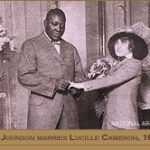 President William Howard Taft signs the White-Slave Traffic Act, also called the Mann Act (named after Congressman James Robert Mann of Illinois), into law. In its original form the act made it a felony to engage in interstate or foreign commerce transport of "any woman or girl for the purpose of prostitution or debauchery, or for any other immoral purpose" (emphasis added). Its primary stated intent was to address prostitution, immorality, and human trafficking, particularly where trafficking was for the purposes of prostitution. It was one of several acts of protective legislation aimed at moral reform during the Progressive Era. In practice, its ambiguous language about "immorality" resulted in it being frequently used to criminalize even consensual sexual behavior between adults, especially to punish consensual interracial relationships. Enactment of the law was spurred, at least in part, by negative reactions to African American world champion heavyweight boxer Jack Johnson. Johnson was known to be intimate with white women. In 1912 Johnson was prosecuted, and later convicted, for "transporting women across state lines for immoral purposes" as a result of his relationship with a white prostitute named Belle Schreiber; the month prior to the prosecution, Johnson had been charged with violating the Mann Act due to traveling with his white girlfriend, Lucille Cameron, who refused to cooperate with the prosecution and whom he married soon thereafter. It is generally acknowledged that both arrests were racially motivated. Learn more. President William Howard Taft signs the White-Slave Traffic Act, also called the Mann Act (named after Congressman James Robert Mann of Illinois), into law. In its original form the act made it a felony to engage in interstate or foreign commerce transport of "any woman or girl for the purpose of prostitution or debauchery, or for any other immoral purpose" (emphasis added). Its primary stated intent was to address prostitution, immorality, and human trafficking, particularly where trafficking was for the purposes of prostitution. It was one of several acts of protective legislation aimed at moral reform during the Progressive Era. In practice, its ambiguous language about "immorality" resulted in it being frequently used to criminalize even consensual sexual behavior between adults, especially to punish consensual interracial relationships. Enactment of the law was spurred, at least in part, by negative reactions to African American world champion heavyweight boxer Jack Johnson. Johnson was known to be intimate with white women. In 1912 Johnson was prosecuted, and later convicted, for "transporting women across state lines for immoral purposes" as a result of his relationship with a white prostitute named Belle Schreiber; the month prior to the prosecution, Johnson had been charged with violating the Mann Act due to traveling with his white girlfriend, Lucille Cameron, who refused to cooperate with the prosecution and whom he married soon thereafter. It is generally acknowledged that both arrests were racially motivated. Learn more. | |
| June 25, 1933 | 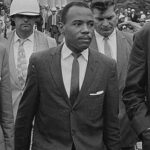 American civil rights movement figure, writer, political adviser, and Air Force veteran James Howard Meredith is born. In 1962, Meredith became the first African-American student admitted to the theretofore segregated University of Mississippi, after the intervention of the federal government, an event that was a flashpoint in the civil rights movement. Inspired by President John F. Kennedy's inaugural address, Meredith decided to exercise his constitutional rights and apply to the University of Mississippi. His goal was to put pressure on the Kennedy administration to enforce civil rights for African Americans. In 1966, Meredith planned a solo 220-mile March Against Fear from Memphis, Tennessee, to Jackson, Mississippi; he wanted to highlight continuing racism in the South and encourage voter registration after passage of the Voting Rights Act of 1965. He did not want major civil rights organizations involved. The second day, he was shot by a white gunman and suffered numerous wounds. Leaders of major organizations vowed to complete the march in his name after he was taken to the hospital. While Meredith was recovering, more people from across the country became involved as marchers. He rejoined the march and when Meredith and other leaders entered Jackson on June 26, they were leading an estimated 15,000 marchers, in what was the largest civil rights march in Mississippi. During the march, more than 4,000 African Americans registered to vote, and it was a catalyst to continued community organizing and additional registration. In 2002 and again in 2012, the University of Mississippi led year-long series of events to celebrate the 40th and 50th anniversaries of Meredith's integration of the institution. He was among numerous speakers invited to the campus, where a statue of him commemorates his role. The Lyceum-The Circle Historic District at the center of the campus has been designated as a National Historic Landmark for these events. Learn more. American civil rights movement figure, writer, political adviser, and Air Force veteran James Howard Meredith is born. In 1962, Meredith became the first African-American student admitted to the theretofore segregated University of Mississippi, after the intervention of the federal government, an event that was a flashpoint in the civil rights movement. Inspired by President John F. Kennedy's inaugural address, Meredith decided to exercise his constitutional rights and apply to the University of Mississippi. His goal was to put pressure on the Kennedy administration to enforce civil rights for African Americans. In 1966, Meredith planned a solo 220-mile March Against Fear from Memphis, Tennessee, to Jackson, Mississippi; he wanted to highlight continuing racism in the South and encourage voter registration after passage of the Voting Rights Act of 1965. He did not want major civil rights organizations involved. The second day, he was shot by a white gunman and suffered numerous wounds. Leaders of major organizations vowed to complete the march in his name after he was taken to the hospital. While Meredith was recovering, more people from across the country became involved as marchers. He rejoined the march and when Meredith and other leaders entered Jackson on June 26, they were leading an estimated 15,000 marchers, in what was the largest civil rights march in Mississippi. During the march, more than 4,000 African Americans registered to vote, and it was a catalyst to continued community organizing and additional registration. In 2002 and again in 2012, the University of Mississippi led year-long series of events to celebrate the 40th and 50th anniversaries of Meredith's integration of the institution. He was among numerous speakers invited to the campus, where a statue of him commemorates his role. The Lyceum-The Circle Historic District at the center of the campus has been designated as a National Historic Landmark for these events. Learn more. | |
| June 25, 1941 | 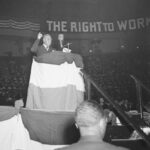 In response to demands by civil rights activists A. Philip Randolph, Walter White, and others involved in the March on Washington Movement who had planned a march on Washington, D.C. in 1941 to protest racial discrimination in industry and the military, President Franklin D. Roosevelt signs Executive Order 8802 prohibiting ethnic or racial discrimination in the nation's defense industry and establishing the Fair Employment Practice Committee. The planned march was suspended after Executive Order 8802 was issued. It was the first federal action, though not a law, to promote equal opportunity and prohibit employment discrimination in the United States. The President's statement that accompanied the Order cited the war effort, saying that "the democratic way of life within the nation can be defended successfully only with the help and support of all groups." The order required federal agencies and departments involved with defense production to ensure that vocational and training programs were administered without discrimination as to "race, creed, color, or national origin." All defense contracts were to include provisions that barred private contractors from discrimination as well. Learn more. In response to demands by civil rights activists A. Philip Randolph, Walter White, and others involved in the March on Washington Movement who had planned a march on Washington, D.C. in 1941 to protest racial discrimination in industry and the military, President Franklin D. Roosevelt signs Executive Order 8802 prohibiting ethnic or racial discrimination in the nation's defense industry and establishing the Fair Employment Practice Committee. The planned march was suspended after Executive Order 8802 was issued. It was the first federal action, though not a law, to promote equal opportunity and prohibit employment discrimination in the United States. The President's statement that accompanied the Order cited the war effort, saying that "the democratic way of life within the nation can be defended successfully only with the help and support of all groups." The order required federal agencies and departments involved with defense production to ensure that vocational and training programs were administered without discrimination as to "race, creed, color, or national origin." All defense contracts were to include provisions that barred private contractors from discrimination as well. Learn more. | |
| June 26, 1844 | 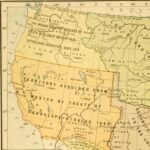 The legislative committee of the territory then known as “Oregon Country” passed the first of a series of “Black exclusion” laws. The law dictated that free African Americans were prohibited from moving into Oregon Country and those who violated the ban could be whipped “not less than twenty nor more than thirty-nine stripes." Between 1840 and 1860, in the midst of this exclusion and discrimination, African Americans never constituted more than 1% of the population in the American Pacific Northwest. Oregon, which joined the Union as a "free state" on February 14, 1859, stands as a clear illustration that racial discrimination and oppression against Black people was widespread in jurisdictions where slavery was illegal. As of 2018, the U.S. census bureau estimated that less than 3% of Oregon residents were African American. Learn more. The legislative committee of the territory then known as “Oregon Country” passed the first of a series of “Black exclusion” laws. The law dictated that free African Americans were prohibited from moving into Oregon Country and those who violated the ban could be whipped “not less than twenty nor more than thirty-nine stripes." Between 1840 and 1860, in the midst of this exclusion and discrimination, African Americans never constituted more than 1% of the population in the American Pacific Northwest. Oregon, which joined the Union as a "free state" on February 14, 1859, stands as a clear illustration that racial discrimination and oppression against Black people was widespread in jurisdictions where slavery was illegal. As of 2018, the U.S. census bureau estimated that less than 3% of Oregon residents were African American. Learn more. | |
| June 26, 1934 | 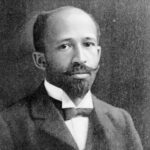 W.E.B. Du Bois, co-founder and first leader of the National Association for the Advancement of Colored People ("NAACP") resigns from the NAACP board because of his new advocacy of an African-American nationalist strategy. The strategy was to be implemented in African-American controlled institutions, schools, and economic cooperatives. This approach opposed the NAACP’s commitment to integration. However, Du Bois returned to the NAACP as director of special research from 1944 to 1948. During this period he was active in placing the grievances of African-Americans before the United Nations, serving as a consultant to the UN founding convention (1945) and writing the famous “An Appeal to the World” (1947). Learn more. W.E.B. Du Bois, co-founder and first leader of the National Association for the Advancement of Colored People ("NAACP") resigns from the NAACP board because of his new advocacy of an African-American nationalist strategy. The strategy was to be implemented in African-American controlled institutions, schools, and economic cooperatives. This approach opposed the NAACP’s commitment to integration. However, Du Bois returned to the NAACP as director of special research from 1944 to 1948. During this period he was active in placing the grievances of African-Americans before the United Nations, serving as a consultant to the UN founding convention (1945) and writing the famous “An Appeal to the World” (1947). Learn more. | |
| June 26, 1959 |  The Prince Edward County, Virginia, Board of Supervisors shuts down the county's public school system in order to prevent integration. Whites had been threatening for five years (since the Supreme Court's decision in Brown v. Board of Education outlawing segregation in public schools) that they were perfectly willing to close county schools to avoid integration. For five long years, nearly 3,000 Black students had no public schools. Because of limited means, most were unable to attend any schools. Meanwhile, white students attended the new private school Prince Edward Academy. In the beginning, local legislators used public school funds for the private school, but that was quickly outlawed. To get around the law Prince Edward County changed its tax laws so now locals paid almost nothing on property taxes so they could afford the cost of the private school for their students. In 1961, newly-inaugurated President Kennedy took up the cause, initiating court cases to force reopening of public schools. While the cases were pending, the Kennedy Administration initiated the establishment of the Free Schools Association to serve the disadvantaged students of the county, funded by donations from across the country and staffed by teachers from across the country; the Free Schools opened in fall 1963, welcoming 1,578 students, including four white students. Finally, on May 25, 1964, the U.S. Supreme Court in Griffin v. School Board of Prince Edward County ruled that the county had violated the rights of students to an education and ordered the Prince Edward County schools to reopen. And in the fall of 1964, they did. Learn more. The Prince Edward County, Virginia, Board of Supervisors shuts down the county's public school system in order to prevent integration. Whites had been threatening for five years (since the Supreme Court's decision in Brown v. Board of Education outlawing segregation in public schools) that they were perfectly willing to close county schools to avoid integration. For five long years, nearly 3,000 Black students had no public schools. Because of limited means, most were unable to attend any schools. Meanwhile, white students attended the new private school Prince Edward Academy. In the beginning, local legislators used public school funds for the private school, but that was quickly outlawed. To get around the law Prince Edward County changed its tax laws so now locals paid almost nothing on property taxes so they could afford the cost of the private school for their students. In 1961, newly-inaugurated President Kennedy took up the cause, initiating court cases to force reopening of public schools. While the cases were pending, the Kennedy Administration initiated the establishment of the Free Schools Association to serve the disadvantaged students of the county, funded by donations from across the country and staffed by teachers from across the country; the Free Schools opened in fall 1963, welcoming 1,578 students, including four white students. Finally, on May 25, 1964, the U.S. Supreme Court in Griffin v. School Board of Prince Edward County ruled that the county had violated the rights of students to an education and ordered the Prince Edward County schools to reopen. And in the fall of 1964, they did. Learn more. | |
| June 27, 1833 | 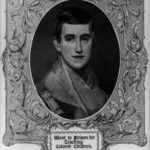 White Connecticut school teacher and activist Prudence Crandall is arrested and spends the night in jail for the "offense" of operating the first school for Black girls ("young Ladies and little Misses of color") in the United States, located in Canterbury, Connecticut. When Crandall admitted Sarah Harris, a 20-year-old African-American female student in 1832 to her school, she had what is considered to be the first integrated classroom in the United States. Parents of the white children began to withdraw them. Rather than ask the African-American student to leave, she decided that if white girls would not attend with the Blacks, she would educate Black girls. She was arrested and spent a night in jail. Soon the violence of the townspeople forced her to close the school. She left Connecticut and never lived there again. Much later the Connecticut legislature, with lobbying from Mark Twain, a resident of Hartford, passed a resolution honoring Crandall and providing her with a pension. Twain offered to buy her former Canterbury home for her retirement, but she declined. She died a few years later. In 1995 the Connecticut General Assembly named her the Official Heroine of Connecticut. Learn more. White Connecticut school teacher and activist Prudence Crandall is arrested and spends the night in jail for the "offense" of operating the first school for Black girls ("young Ladies and little Misses of color") in the United States, located in Canterbury, Connecticut. When Crandall admitted Sarah Harris, a 20-year-old African-American female student in 1832 to her school, she had what is considered to be the first integrated classroom in the United States. Parents of the white children began to withdraw them. Rather than ask the African-American student to leave, she decided that if white girls would not attend with the Blacks, she would educate Black girls. She was arrested and spent a night in jail. Soon the violence of the townspeople forced her to close the school. She left Connecticut and never lived there again. Much later the Connecticut legislature, with lobbying from Mark Twain, a resident of Hartford, passed a resolution honoring Crandall and providing her with a pension. Twain offered to buy her former Canterbury home for her retirement, but she declined. She died a few years later. In 1995 the Connecticut General Assembly named her the Official Heroine of Connecticut. Learn more. | |
| June 27, 1872 | 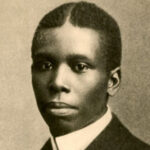 Internationally acclaimed poet, novelist, and essayist Paul Laurence Dunbar is born to two formerly enslaved people from Kentucky. Dunbar became one of the first influential Black poets in American literature, and was internationally acclaimed for his dialectic verse in collections such as Majors and Minors (1895) and Lyrics of Lowly Life (1896). But the dialectic poems constitute only a small portion of Dunbar’s canon, which is replete with novels, short stories, essays, and many poems in standard English. In its entirety, Dunbar’s literary body is regarded as an impressive representation of Black life in turn-of-the-century America. As Dunbar’s friend James Weldon Johnson noted in the preface to his Book of American Poetry: “Paul Laurence Dunbar stands out as the first poet from the Negro race in the United States to show a combined mastery over poetic material and poetic technique, to reveal innate literary distinction in what he wrote, and to maintain a high level of performance. He was the first to rise to a height from which he could take a perspective view of his own race. He was the first to see objectively its humor, its superstitions, its short-comings; the first to feel sympathetically its heart-wounds, its yearnings, its aspirations, and to voice them all in a purely literary form.” Learn more. Internationally acclaimed poet, novelist, and essayist Paul Laurence Dunbar is born to two formerly enslaved people from Kentucky. Dunbar became one of the first influential Black poets in American literature, and was internationally acclaimed for his dialectic verse in collections such as Majors and Minors (1895) and Lyrics of Lowly Life (1896). But the dialectic poems constitute only a small portion of Dunbar’s canon, which is replete with novels, short stories, essays, and many poems in standard English. In its entirety, Dunbar’s literary body is regarded as an impressive representation of Black life in turn-of-the-century America. As Dunbar’s friend James Weldon Johnson noted in the preface to his Book of American Poetry: “Paul Laurence Dunbar stands out as the first poet from the Negro race in the United States to show a combined mastery over poetic material and poetic technique, to reveal innate literary distinction in what he wrote, and to maintain a high level of performance. He was the first to rise to a height from which he could take a perspective view of his own race. He was the first to see objectively its humor, its superstitions, its short-comings; the first to feel sympathetically its heart-wounds, its yearnings, its aspirations, and to voice them all in a purely literary form.” Learn more. | |
| June 27, 1911 | 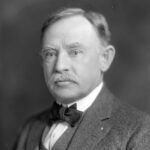 A Walton County, Georgia mob of several hundred unmasked white men lynches two Black men named Tom Allen and Joe Watts after a local white judge—Charles H. Brand—refuses to allow state guardsmen to be present to prevent mob action. Judge Brand had been aware of the threat of mob violence for weeks, and had purposely delayed the trial until previously deployed guardsmen were no longer present to provide protection. Three months earlier, Judge Brand had also refused the assistance of state troops to protect a Black man named Charles Hale, who, left without the protection of those troops, was taken by a white mob and lynched. Despite his failure to protect these men, Judge Brand continued to serve as a judge until 1917. In 1917, Judge Brand was elected to Congress to represent Georgia's 8th Congressional District, where he served seven consecutive terms. Learn more. A Walton County, Georgia mob of several hundred unmasked white men lynches two Black men named Tom Allen and Joe Watts after a local white judge—Charles H. Brand—refuses to allow state guardsmen to be present to prevent mob action. Judge Brand had been aware of the threat of mob violence for weeks, and had purposely delayed the trial until previously deployed guardsmen were no longer present to provide protection. Three months earlier, Judge Brand had also refused the assistance of state troops to protect a Black man named Charles Hale, who, left without the protection of those troops, was taken by a white mob and lynched. Despite his failure to protect these men, Judge Brand continued to serve as a judge until 1917. In 1917, Judge Brand was elected to Congress to represent Georgia's 8th Congressional District, where he served seven consecutive terms. Learn more. | |
| June 27, 1922 | 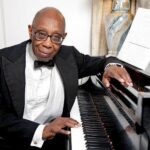 Composer, pianist, organist, and the first African American to win the Pulitzer Prize for Music, George Theophilus Walker is born. Walker received the Pulitzer for his work Lilacs in 1996. Walker was married to pianist and scholar Helen Walker-Hill and was the father of two sons, violinist and composer Gregory T.S. Walker and playwright Ian Walker. Learn more. Composer, pianist, organist, and the first African American to win the Pulitzer Prize for Music, George Theophilus Walker is born. Walker received the Pulitzer for his work Lilacs in 1996. Walker was married to pianist and scholar Helen Walker-Hill and was the father of two sons, violinist and composer Gregory T.S. Walker and playwright Ian Walker. Learn more. | |
| June 27, 1939 |  Prolific African American inventor, entrepreneur, winner of the National Medal of Technology, and an inductee of the National Inventors Hall of Fame Frederick McKinley Jones secures US patent # US2163754A for his invention of the ticket dispensing machine. His major inventions and innovations were in the area of refrigeration and brought great improvements to the long-haul transportation of perishable goods. He co-founded Thermo King. Learn more. Prolific African American inventor, entrepreneur, winner of the National Medal of Technology, and an inductee of the National Inventors Hall of Fame Frederick McKinley Jones secures US patent # US2163754A for his invention of the ticket dispensing machine. His major inventions and innovations were in the area of refrigeration and brought great improvements to the long-haul transportation of perishable goods. He co-founded Thermo King. Learn more. | |
| June 28, 1839 | 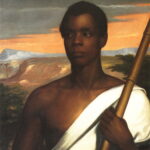 Sengbe Pieh also known as Joseph Cinqué or Cinquez and sometimes referred to mononymously as Cinqué, a West African man and son of the king of the Mende people of present-day Sierra Leone, is illegally kidnapped and enslaved. Cinque subsequently led his fellow Africans to rebel and capture the Spanish slave ship La Amistad on which they were imprisoned. After the ship was taken into custody by the United States Revenue Cutter Service, Cinqué and his fellow Africans were tried for mutiny and killing officers on the ship, in a case known as United States v. The Amistad. The case reached the U.S. Supreme Court, where Cinqué and his fellow Africans were found to have rightfully defended themselves from being enslaved through the illegal Atlantic slave trade and were released. Americans helped raise money for the return of 35 of the survivors, including Cinque, to Sierra Leone. Learn more. Sengbe Pieh also known as Joseph Cinqué or Cinquez and sometimes referred to mononymously as Cinqué, a West African man and son of the king of the Mende people of present-day Sierra Leone, is illegally kidnapped and enslaved. Cinque subsequently led his fellow Africans to rebel and capture the Spanish slave ship La Amistad on which they were imprisoned. After the ship was taken into custody by the United States Revenue Cutter Service, Cinqué and his fellow Africans were tried for mutiny and killing officers on the ship, in a case known as United States v. The Amistad. The case reached the U.S. Supreme Court, where Cinqué and his fellow Africans were found to have rightfully defended themselves from being enslaved through the illegal Atlantic slave trade and were released. Americans helped raise money for the return of 35 of the survivors, including Cinque, to Sierra Leone. Learn more. | |
| June 28, 1874 | 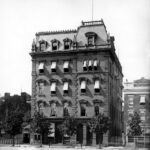 The Freedmen’s Savings and Trust Company, more commonly referred to as The Freedmen’s Bank, fails and closes, wiping out millions of dollars in Black wealth, none of which was recovered. The bank was chartered by the U.S. Congress on March 3, 1865 as a private savings bank to collect deposits from and help previously enslaved people economically transition to freedom. Within 7 years of its formation, the bank operated 37 branches across 17 states and the District of Columbia and collected funds from over 67,000 depositors. At its height, the Freedman's Bank held assets worth more than $3.7 million in 1872 dollars, which translates to approximately $80 million in 2021. A major contributing factor to the bank's 1874 failure was mismanagement and fraud by the bank’s white officials throughout its existence. There is a consensus among historians that the bank’s failure not only devastated the savings of many African Americans, but also their trust in financial institutions. Learn more. The Freedmen’s Savings and Trust Company, more commonly referred to as The Freedmen’s Bank, fails and closes, wiping out millions of dollars in Black wealth, none of which was recovered. The bank was chartered by the U.S. Congress on March 3, 1865 as a private savings bank to collect deposits from and help previously enslaved people economically transition to freedom. Within 7 years of its formation, the bank operated 37 branches across 17 states and the District of Columbia and collected funds from over 67,000 depositors. At its height, the Freedman's Bank held assets worth more than $3.7 million in 1872 dollars, which translates to approximately $80 million in 2021. A major contributing factor to the bank's 1874 failure was mismanagement and fraud by the bank’s white officials throughout its existence. There is a consensus among historians that the bank’s failure not only devastated the savings of many African Americans, but also their trust in financial institutions. Learn more. | |
| June 28, 1964 |  At a public meeting in New York's Audubon Ballroom, Malcolm X announces founding of the Organization of Afro-American Unity (OAAU). The purpose of the OAAU was to fight for the human rights of African Americans and promote cooperation among Africans and people of African descent in the Americas. Malcolm X had written the group's charter with John Henrik Clarke, Albert Cleage, Jesse Gray, and Gloria Richardson, among others. In a memo dated July 2, 1964, FBI Director J. Edgar Hoover described the nascent OAAU as a threat to the national security of the United States. Malcolm X did not have sufficient time to invest in the OAAU to help it flourish. After his death, dwindling membership and Malcolm X's absence eventually led to the collapse of the organization. Learn more. At a public meeting in New York's Audubon Ballroom, Malcolm X announces founding of the Organization of Afro-American Unity (OAAU). The purpose of the OAAU was to fight for the human rights of African Americans and promote cooperation among Africans and people of African descent in the Americas. Malcolm X had written the group's charter with John Henrik Clarke, Albert Cleage, Jesse Gray, and Gloria Richardson, among others. In a memo dated July 2, 1964, FBI Director J. Edgar Hoover described the nascent OAAU as a threat to the national security of the United States. Malcolm X did not have sufficient time to invest in the OAAU to help it flourish. After his death, dwindling membership and Malcolm X's absence eventually led to the collapse of the organization. Learn more. | |
| June 28, 1971 | 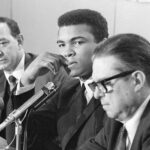 In Clay v. United States, the United States Supreme Court, by a unanimous 8–0 decision (Justice Thurgood Marshall recused himself, as he had been the U.S. Solicitor General at the time of Ali's conviction) overturns Muhammad Ali's 1967 conviction on the criminal offense of violating the Selective Service laws by refusing to be drafted. Before the planned induction and Ali's arrest, Ali's local draft board had rejected his application for conscientious objector classification. The Supreme Court found the government had failed to properly specify why Ali's application had been denied, thereby requiring the conviction to be overturned: "the court said the record shows that [Ali's] beliefs are founded on tenets of the Muslim religion as he understands them." Learn more. In Clay v. United States, the United States Supreme Court, by a unanimous 8–0 decision (Justice Thurgood Marshall recused himself, as he had been the U.S. Solicitor General at the time of Ali's conviction) overturns Muhammad Ali's 1967 conviction on the criminal offense of violating the Selective Service laws by refusing to be drafted. Before the planned induction and Ali's arrest, Ali's local draft board had rejected his application for conscientious objector classification. The Supreme Court found the government had failed to properly specify why Ali's application had been denied, thereby requiring the conviction to be overturned: "the court said the record shows that [Ali's] beliefs are founded on tenets of the Muslim religion as he understands them." Learn more. | |
| June 29, 1886 | 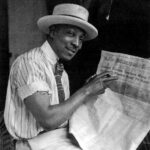 American photographer James Augustus Van Der Zee, best known for his portraits of Black New Yorkers, is born. He was a leading figure in the Harlem Renaissance. Aside from the artistic merits of his work, Van Der Zee produced the most comprehensive documentation of the period. Among his most famous subjects during this time were Marcus Garvey, Bill "Bojangles" Robinson and Countee Cullen. Learn more. American photographer James Augustus Van Der Zee, best known for his portraits of Black New Yorkers, is born. He was a leading figure in the Harlem Renaissance. Aside from the artistic merits of his work, Van Der Zee produced the most comprehensive documentation of the period. Among his most famous subjects during this time were Marcus Garvey, Bill "Bojangles" Robinson and Countee Cullen. Learn more. | |
| June 29, 1925 | 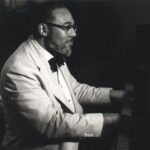 Noted jazz and classical music performer, composer, arranger, and educator Hale Smith, Jr. is born in Cleveland, Ohio to parents Hale and Jimmie Smith. Beginning piano at age seven, he was introduced to composing and collecting musical scores. His father owned a printing business and his parents were highly supportive. He trained in jazz and classical composition, performance, and teaching. By high school he was playing jazz piano and composing. One of his early compositions was encouraged by Duke Ellington. His collaborations and influence crossed multiple fields where he set out to resolve the paradoxes of both improvisation and notated music. In 1973 Smith became the first African American to receive the Cleveland Art Prize in Music. Other awards included an honorary doctorate degree from the Cleveland Institute of Music, serving on the New York State Council on the Arts from 1993 to 1997 and service on the boards of several composers’ organizations. In 2001 Smith was awarded the American Music Center’s Letter of Distinction. Learn more. Noted jazz and classical music performer, composer, arranger, and educator Hale Smith, Jr. is born in Cleveland, Ohio to parents Hale and Jimmie Smith. Beginning piano at age seven, he was introduced to composing and collecting musical scores. His father owned a printing business and his parents were highly supportive. He trained in jazz and classical composition, performance, and teaching. By high school he was playing jazz piano and composing. One of his early compositions was encouraged by Duke Ellington. His collaborations and influence crossed multiple fields where he set out to resolve the paradoxes of both improvisation and notated music. In 1973 Smith became the first African American to receive the Cleveland Art Prize in Music. Other awards included an honorary doctorate degree from the Cleveland Institute of Music, serving on the New York State Council on the Arts from 1993 to 1997 and service on the boards of several composers’ organizations. In 2001 Smith was awarded the American Music Center’s Letter of Distinction. Learn more.
| |
| June 29, 1941 | 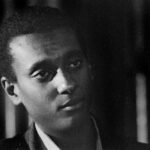 Civil Rights activist and global Pan-African movement leader Stokely Carmichael, also known as Kwame Touré, is born in Port of Spain, Trinidad and Tobago. A working class family, his father was a carpenter and taxi driver, and his mother was a stewardess for a steamship line. The family first moved to Harlem, New York and then to the Van Nest neighborhood in the East Bronx. There Carmichael attended the elite Bronx High School of Science, which only admitted students with outstanding academic performance. In the 1960s, Carmichael he led the Student Nonviolent Coordinating Committee (SNCC) and served at the Black Panther Party as Honorary Prime Minister. He later led the All-African People’s Revolutionary Party. Learn more. Civil Rights activist and global Pan-African movement leader Stokely Carmichael, also known as Kwame Touré, is born in Port of Spain, Trinidad and Tobago. A working class family, his father was a carpenter and taxi driver, and his mother was a stewardess for a steamship line. The family first moved to Harlem, New York and then to the Van Nest neighborhood in the East Bronx. There Carmichael attended the elite Bronx High School of Science, which only admitted students with outstanding academic performance. In the 1960s, Carmichael he led the Student Nonviolent Coordinating Committee (SNCC) and served at the Black Panther Party as Honorary Prime Minister. He later led the All-African People’s Revolutionary Party. Learn more. | |
| June 29, 1958 |  On early Sunday morning a bomb explodes outside Bethel Street Baptist Church on the north side of Birmingham, Alabama, in one of the segregated city's African American neighborhoods. The church's pastor, Reverend Fred Shuttlesworth, was a civil rights activist working to eliminate segregation in Birmingham. Bethel Street Baptist had been bombed before, on Christmas Day 1956, and since then several volunteers had kept watch over the neighborhood every night. Around 1:30 am, Will Hall, who was on watch that night, was alerted to smoke coming from the church. He discovered a paint can containing dynamite near the church wall and carried it into the street before taking cover as it exploded. "This shows that America has a long way to go before it can try to be called democratic," Rev. Shuttlesworth said. Learn more. On early Sunday morning a bomb explodes outside Bethel Street Baptist Church on the north side of Birmingham, Alabama, in one of the segregated city's African American neighborhoods. The church's pastor, Reverend Fred Shuttlesworth, was a civil rights activist working to eliminate segregation in Birmingham. Bethel Street Baptist had been bombed before, on Christmas Day 1956, and since then several volunteers had kept watch over the neighborhood every night. Around 1:30 am, Will Hall, who was on watch that night, was alerted to smoke coming from the church. He discovered a paint can containing dynamite near the church wall and carried it into the street before taking cover as it exploded. "This shows that America has a long way to go before it can try to be called democratic," Rev. Shuttlesworth said. Learn more. | |
| June 30, 1829 | 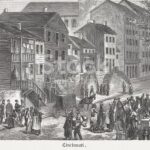 Officials in Cincinnati, Ohio, issue a notice requiring Black residents to adhere to laws passed in 1804 and 1807 aimed at preventing “fugitive slaves” and freed Black people from settling in Ohio, thereby forcing hundreds of Black people to flee Ohio. At that time, Black residents represented at least 10% of Cincinnati’s population. Officials also posted a notice informing the public that the 1807 law would be “rigidly enforced” and warning against helping any Black person in violation of the law. The notice effectively sanctioned mob violence against the Black community, stating, “The full cooperation of the public is expected in carrying these laws into full effect.” Recognizing the notice as a threat, hundreds of Black people organized, requested, and were granted asylum in Canada. Learn more.
Officials in Cincinnati, Ohio, issue a notice requiring Black residents to adhere to laws passed in 1804 and 1807 aimed at preventing “fugitive slaves” and freed Black people from settling in Ohio, thereby forcing hundreds of Black people to flee Ohio. At that time, Black residents represented at least 10% of Cincinnati’s population. Officials also posted a notice informing the public that the 1807 law would be “rigidly enforced” and warning against helping any Black person in violation of the law. The notice effectively sanctioned mob violence against the Black community, stating, “The full cooperation of the public is expected in carrying these laws into full effect.” Recognizing the notice as a threat, hundreds of Black people organized, requested, and were granted asylum in Canada. Learn more. | |
| June 30, 1956 | 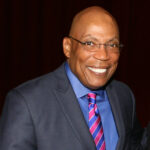 Award-winning American television director, producer, and LGBT rights activist Paris K.C. Barclay is born in Chicago Heights, Illinois, near to where he grew up in Harvey, Illinois. In 2013, he broke new ground when he was named President of the Directors Guild of America, making him the first out gay male and the first African American to hold the post. Learn more. Award-winning American television director, producer, and LGBT rights activist Paris K.C. Barclay is born in Chicago Heights, Illinois, near to where he grew up in Harvey, Illinois. In 2013, he broke new ground when he was named President of the Directors Guild of America, making him the first out gay male and the first African American to hold the post. Learn more. | |
| June 30, 1966 |  The National Organization for Women (NOW) is founded by 28 women at the Third National Conference of Commissions on the Status of Women (the successor to the Presidential Commission on the Status of Women). The founders were inspired by the failure of the Equal Employment Opportunity Commission to enforce Title VII of the Civil Rights Act of 1964; at the Third National Conference of State Commissions on the Status of Women they were prohibited from issuing a resolution that recommended the EEOC carry out its legal mandate to end sex discrimination in employment. They thus gathered in Friedan's hotel room to form a new organization. On a paper napkin Friedan scribbled the acronym "NOW". Betty Friedan and Pauli Murray (who later became the first African American woman ordained as an Episcopal priest) wrote NOW's Statement of Purpose. Learn more. The National Organization for Women (NOW) is founded by 28 women at the Third National Conference of Commissions on the Status of Women (the successor to the Presidential Commission on the Status of Women). The founders were inspired by the failure of the Equal Employment Opportunity Commission to enforce Title VII of the Civil Rights Act of 1964; at the Third National Conference of State Commissions on the Status of Women they were prohibited from issuing a resolution that recommended the EEOC carry out its legal mandate to end sex discrimination in employment. They thus gathered in Friedan's hotel room to form a new organization. On a paper napkin Friedan scribbled the acronym "NOW". Betty Friedan and Pauli Murray (who later became the first African American woman ordained as an Episcopal priest) wrote NOW's Statement of Purpose. Learn more. | |
| June 30, 1986 |  In in its infamous 5-4 landmark decision in Bowers v. Hardwick the US Supreme Court that upholds the constitutionality of a Georgia sodomy law criminalizing oral and anal sex in private between consenting adults, in this case with respect to homosexual sodomy, though the law did not differentiate between homosexual sodomy and heterosexual sodomy. This case was directly overturned in 2003 in Lawrence v. Texas, though the statute had already been struck down by the Supreme Court of Georgia in 1998. Bowers is now considered among the worst Supreme Court decisions of all time. Learn more. In in its infamous 5-4 landmark decision in Bowers v. Hardwick the US Supreme Court that upholds the constitutionality of a Georgia sodomy law criminalizing oral and anal sex in private between consenting adults, in this case with respect to homosexual sodomy, though the law did not differentiate between homosexual sodomy and heterosexual sodomy. This case was directly overturned in 2003 in Lawrence v. Texas, though the statute had already been struck down by the Supreme Court of Georgia in 1998. Bowers is now considered among the worst Supreme Court decisions of all time. Learn more. | |
| July 1, 1893 | 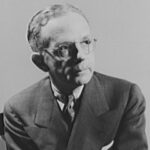 African American civil rights activist Walter Francis White, who led the National Association for the Advancement of Colored People (NAACP) from 1929 to 1955, is born. He directed a broad program of legal challenges to racial segregation and disfranchisement. He was also a journalist, novelist, and essayist. In 1918, White joined the small national staff of the NAACP in New York at the invitation of James Weldon Johnson. He acted as Johnson's assistant national secretary and traveled to the South to investigate lynchings and riots. Of multiracial, majority-white ancestry, at times he passed as white to facilitate his investigations and protect himself in tense situations. White succeeded Johnson as the head of the NAACP, leading the organization from 1929 to 1955. He joined the Advisory Council for the Government of the Virgin Islands in 1934 and resigned in 1935 to protest President Roosevelt's silence at Southern Democrats' blocking of anti-lynching legislation to avoid retaliatory obstruction of his New Deal policies. White oversaw the plans and organizational structure of the fight against public segregation. He worked with President Truman on desegregating the armed forces after the Second World War and gave him a draft for the Executive Order to implement this. Under White's leadership, the NAACP set up its Legal Defense Fund, which conducted numerous legal challenges to segregation and disfranchisement, and achieved many successes. Among these was the Supreme Courtruling in Brown v. Board of Education (1954), which determined that segregated education was inherently unequal. White also quintupled NAACP membership to nearly 500,000. Learn more. African American civil rights activist Walter Francis White, who led the National Association for the Advancement of Colored People (NAACP) from 1929 to 1955, is born. He directed a broad program of legal challenges to racial segregation and disfranchisement. He was also a journalist, novelist, and essayist. In 1918, White joined the small national staff of the NAACP in New York at the invitation of James Weldon Johnson. He acted as Johnson's assistant national secretary and traveled to the South to investigate lynchings and riots. Of multiracial, majority-white ancestry, at times he passed as white to facilitate his investigations and protect himself in tense situations. White succeeded Johnson as the head of the NAACP, leading the organization from 1929 to 1955. He joined the Advisory Council for the Government of the Virgin Islands in 1934 and resigned in 1935 to protest President Roosevelt's silence at Southern Democrats' blocking of anti-lynching legislation to avoid retaliatory obstruction of his New Deal policies. White oversaw the plans and organizational structure of the fight against public segregation. He worked with President Truman on desegregating the armed forces after the Second World War and gave him a draft for the Executive Order to implement this. Under White's leadership, the NAACP set up its Legal Defense Fund, which conducted numerous legal challenges to segregation and disfranchisement, and achieved many successes. Among these was the Supreme Courtruling in Brown v. Board of Education (1954), which determined that segregated education was inherently unequal. White also quintupled NAACP membership to nearly 500,000. Learn more. | |
| July 1, 1899 | 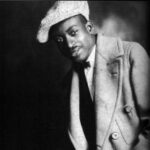 African American musician, composer, and Christian evangelist influential in the development of early blues and 20th-century gospel music, Thomas A. Dorsey is born in rural Georgia. He penned 3,000 songs, a third of them gospel, including "Take My Hand, Precious Lord" and "Peace in the Valley". Recordings of these sold millions of copies in both gospel and secular markets in the 20th century. He initially gained fame accompanying blues belter Ma Rainey on tour and, billed as "Georgia Tom," joined with guitarist Tampa Red in a successful recording career. After a spiritual awakening, Dorsey began concentrating on writing and arranging religious music. Dorsey served as the music director at Chicago's Pilgrim Baptist Church for 50 years, introducing musical improvisation and encouraging personal elements of participation such as clapping, stomping, and shouting in churches when these were widely condemned as unrefined and common. In 1932, he co-founded the National Convention of Gospel Choirs and Choruses, an organization dedicated to training musicians and singers from all over the U.S. that remains active. The first generation of gospel singers in the 20th century worked or trained with Dorsey: Sallie Martin, Mahalia Jackson, Roberta Martin, and James Cleveland, among others. Dorsey has been called the "Father of Gospel Music" and many credit him with creating or, at the least, popularizing the musical form. Learn more. African American musician, composer, and Christian evangelist influential in the development of early blues and 20th-century gospel music, Thomas A. Dorsey is born in rural Georgia. He penned 3,000 songs, a third of them gospel, including "Take My Hand, Precious Lord" and "Peace in the Valley". Recordings of these sold millions of copies in both gospel and secular markets in the 20th century. He initially gained fame accompanying blues belter Ma Rainey on tour and, billed as "Georgia Tom," joined with guitarist Tampa Red in a successful recording career. After a spiritual awakening, Dorsey began concentrating on writing and arranging religious music. Dorsey served as the music director at Chicago's Pilgrim Baptist Church for 50 years, introducing musical improvisation and encouraging personal elements of participation such as clapping, stomping, and shouting in churches when these were widely condemned as unrefined and common. In 1932, he co-founded the National Convention of Gospel Choirs and Choruses, an organization dedicated to training musicians and singers from all over the U.S. that remains active. The first generation of gospel singers in the 20th century worked or trained with Dorsey: Sallie Martin, Mahalia Jackson, Roberta Martin, and James Cleveland, among others. Dorsey has been called the "Father of Gospel Music" and many credit him with creating or, at the least, popularizing the musical form. Learn more. | |
| July 1, 1965 | 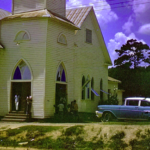 A white sheriff in Camden, Alabama, responded to a white mob's violent attacks on members of a Black church where leaders were discussing civil rights, by announcing that the church was the cause of “too much disturbance,” ordered parishioners to collect their belongings and leave, then padlocked on the church doors, despite having no authority to do so. According to the 1960 census, Black residents made up over 75% of the population of Wilcox County, but in the 1964 election, no Black people were registered to vote in Wilcox County because of established practices and laws passed with the intent of suppressing the Black vote that were enforced in discriminatory ways to achieve that result. Learn more. A white sheriff in Camden, Alabama, responded to a white mob's violent attacks on members of a Black church where leaders were discussing civil rights, by announcing that the church was the cause of “too much disturbance,” ordered parishioners to collect their belongings and leave, then padlocked on the church doors, despite having no authority to do so. According to the 1960 census, Black residents made up over 75% of the population of Wilcox County, but in the 1964 election, no Black people were registered to vote in Wilcox County because of established practices and laws passed with the intent of suppressing the Black vote that were enforced in discriminatory ways to achieve that result. Learn more. | |
| July 1, 2014 |  Michelle Howard becomes the first woman promoted to the rank of four-star admiral in the U.S. Navy. That day she was also appointed the 38th vice-chief of naval operations (VCNO), making her the second highest-ranking officer in the U.S. Navy. In 2016 she became commander of naval forces in Europe and Africa. She had made history in 1999 as the first African American woman to captain a U.S. naval ship. Learn more. Michelle Howard becomes the first woman promoted to the rank of four-star admiral in the U.S. Navy. That day she was also appointed the 38th vice-chief of naval operations (VCNO), making her the second highest-ranking officer in the U.S. Navy. In 2016 she became commander of naval forces in Europe and Africa. She had made history in 1999 as the first African American woman to captain a U.S. naval ship. Learn more. | |
| July 2, 1777 | 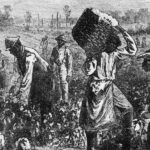 Vermont formally abolishes slavery by constitutional dictum. Although estimates place the number of enslaved persons at 25 in 1770 slavery was banned outright upon the founding of Vermont in July 1777, and by a further provision in its Constitution, existing male slaves become free at the age of 21 and females at the age of 18. Not only did Vermont's legislature agree to abolish slavery entirely, it also moved to provide full voting rights for African American males. According to the Smithsonian's National Museum of African-American History and Culture, "Vermont's July 1777 declaration was not entirely altruistic either. While it did set an independent tone from the 13 colonies, the declaration's wording was vague enough to let Vermont's already-established slavery practices continue." Harvey Amani Whitfield's book, The Problem of Slavery in Early Vermont, reports that among those violating the abolition of slavery were Vermont Supreme Court Judge Stephen Jacob and Levi Allen, brother of the military leader Ethan Allen. In 1858 the "Freedom Act" was ratified, declaring that any slave brought into Vermont was free. Learn more. Vermont formally abolishes slavery by constitutional dictum. Although estimates place the number of enslaved persons at 25 in 1770 slavery was banned outright upon the founding of Vermont in July 1777, and by a further provision in its Constitution, existing male slaves become free at the age of 21 and females at the age of 18. Not only did Vermont's legislature agree to abolish slavery entirely, it also moved to provide full voting rights for African American males. According to the Smithsonian's National Museum of African-American History and Culture, "Vermont's July 1777 declaration was not entirely altruistic either. While it did set an independent tone from the 13 colonies, the declaration's wording was vague enough to let Vermont's already-established slavery practices continue." Harvey Amani Whitfield's book, The Problem of Slavery in Early Vermont, reports that among those violating the abolition of slavery were Vermont Supreme Court Judge Stephen Jacob and Levi Allen, brother of the military leader Ethan Allen. In 1858 the "Freedom Act" was ratified, declaring that any slave brought into Vermont was free. Learn more. | |
| July 2, 1822 |  Denmark Vesey, a free Black carpenter, is executed in Charleston, South Carolina, for planning to emancipate enslaved people. Weeks before his execution, Mr. Vesey was accused of designing a rebellion to emancipate thousands of enslaved Black people from Charleston and the surrounding plantations. Even though no rebellion ever occurred and no white people were harmed in any way, Mr. Vesey and 34 other people allegedly involved were executed. After Mr. Vesey was executed, white Charleston officials claimed the Black church had played a crucial role in the planning. They ordered the AME members to disperse and burned the church to the ground. Black churches were soon outlawed in Charleston; the AME church was the last Black church to exist there until after the Civil War. In 1865, under the leadership of Mr. Vesey’s son, Robert Vesey, the church was finally rebuilt. Nearly 200 years after Mr. Vesey’s execution, in 2015, a white 21-year-old attended bible study at the church—renamed the Emanuel AME Church—and opened fire on the other worshippers in attendance, all of whom were Black. Learn more. Denmark Vesey, a free Black carpenter, is executed in Charleston, South Carolina, for planning to emancipate enslaved people. Weeks before his execution, Mr. Vesey was accused of designing a rebellion to emancipate thousands of enslaved Black people from Charleston and the surrounding plantations. Even though no rebellion ever occurred and no white people were harmed in any way, Mr. Vesey and 34 other people allegedly involved were executed. After Mr. Vesey was executed, white Charleston officials claimed the Black church had played a crucial role in the planning. They ordered the AME members to disperse and burned the church to the ground. Black churches were soon outlawed in Charleston; the AME church was the last Black church to exist there until after the Civil War. In 1865, under the leadership of Mr. Vesey’s son, Robert Vesey, the church was finally rebuilt. Nearly 200 years after Mr. Vesey’s execution, in 2015, a white 21-year-old attended bible study at the church—renamed the Emanuel AME Church—and opened fire on the other worshippers in attendance, all of whom were Black. Learn more. | |
| July 2, 1908 | 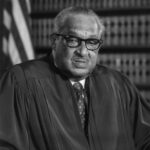 American legal giant Thurgood Marshall is born. Marshall was a civil rights activist and the first African-American Supreme Court Justice in the history of the United States, serving on the court from October 1967 until October 1991. Prior to his judicial service, he successfully argued several cases before the Supreme Court, including the landmark Brown v. Board of Education. Learn more. American legal giant Thurgood Marshall is born. Marshall was a civil rights activist and the first African-American Supreme Court Justice in the history of the United States, serving on the court from October 1967 until October 1991. Prior to his judicial service, he successfully argued several cases before the Supreme Court, including the landmark Brown v. Board of Education. Learn more. | |
| July 2, 1925 |  Civil rights activist and martyr Medgar Wiley Evers is born. Evers was the Mississippi field secretary for the NAACP, and a World War II veteran who had served in the United States Army. He worked to overturn segregation at the University of Mississippi, end the segregation of public facilities, and expand opportunities for African Americans, which included the enforcement of voting rights. Due to his efforts to challenge segregation and to advance voting rights Evers was assassinated in 1963 by a white supremacist. All white juries twice failed to reach verdicts in trials of Evers's murderer; the assassin was finally convicted at a third trial in 1994, 21 years after the assassination. Learn more.
Civil rights activist and martyr Medgar Wiley Evers is born. Evers was the Mississippi field secretary for the NAACP, and a World War II veteran who had served in the United States Army. He worked to overturn segregation at the University of Mississippi, end the segregation of public facilities, and expand opportunities for African Americans, which included the enforcement of voting rights. Due to his efforts to challenge segregation and to advance voting rights Evers was assassinated in 1963 by a white supremacist. All white juries twice failed to reach verdicts in trials of Evers's murderer; the assassin was finally convicted at a third trial in 1994, 21 years after the assassination. Learn more. | |
| July 2, 1935 | 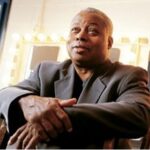 Playwright Ed Bullins is born in Philadelphia, Pennsylvania. Among the best known playwrights of the Black Arts Movement, he has won numerous awards, including the New York Drama Critics' Circle Award and several Obie Awards. He was also the Minister of Culture for the Black Panthers. Learn more. Playwright Ed Bullins is born in Philadelphia, Pennsylvania. Among the best known playwrights of the Black Arts Movement, he has won numerous awards, including the New York Drama Critics' Circle Award and several Obie Awards. He was also the Minister of Culture for the Black Panthers. Learn more. | |
| July 2, 1964 | 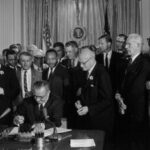 President Lyndon B. Johnson gives a live television- and radio-broadcast address to the nation to announce and witness his signing of the Civil Rights Act of 1964. Johnson had led the passage of the Act, considered by many historians as one of the most important measures enacted by the U.S. Congress in the 20th Century. Read Johnson's Address. President Lyndon B. Johnson gives a live television- and radio-broadcast address to the nation to announce and witness his signing of the Civil Rights Act of 1964. Johnson had led the passage of the Act, considered by many historians as one of the most important measures enacted by the U.S. Congress in the 20th Century. Read Johnson's Address. | |
| July 3, 1844 | 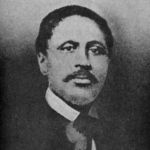 After passing the Maine bar exam, Macon Bolling Allen is granted his license to practice law, the first African American to become a lawyer in the United States. He would subsequently become the first African American to argue before a jury and the first to hold a judicial position in the United States when he became a Massachusetts Justice of the Peace in 1847. He moved to South Carolina after the American Civil War to practice law and was elected as a judge in 1873 and again in 1876. Following the Reconstruction Era, he moved to Washington, D.C., where he continued practicing law. Learn more. After passing the Maine bar exam, Macon Bolling Allen is granted his license to practice law, the first African American to become a lawyer in the United States. He would subsequently become the first African American to argue before a jury and the first to hold a judicial position in the United States when he became a Massachusetts Justice of the Peace in 1847. He moved to South Carolina after the American Civil War to practice law and was elected as a judge in 1873 and again in 1876. Following the Reconstruction Era, he moved to Washington, D.C., where he continued practicing law. Learn more. | |
| July 3, 1917 | 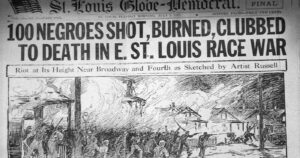 White mobs terrorize and attack Black residents and destroy Black homes and property in East St. Louis, Illinois. The violence began the previous afternoon when white residents of East St. Louis and nearby communities ambushed African American workers as they left factories during a shift change. The National Guard was called in to suppress the violence but they were ordered not to shoot at white rioters; some troops reportedly joined the mobs targeting the Black community. Between July 2-5, 1917, at least 39, and some estimates indicate up to 200, African American men, women, and children were shot, hanged, beaten to death, or burned alive after being driven into burning buildings. The riots caused more than $400,000 in property damage and prompted 6,000 African American residents—more than half of East St. Louis’s African American population—to flee the city. Learn more. White mobs terrorize and attack Black residents and destroy Black homes and property in East St. Louis, Illinois. The violence began the previous afternoon when white residents of East St. Louis and nearby communities ambushed African American workers as they left factories during a shift change. The National Guard was called in to suppress the violence but they were ordered not to shoot at white rioters; some troops reportedly joined the mobs targeting the Black community. Between July 2-5, 1917, at least 39, and some estimates indicate up to 200, African American men, women, and children were shot, hanged, beaten to death, or burned alive after being driven into burning buildings. The riots caused more than $400,000 in property damage and prompted 6,000 African American residents—more than half of East St. Louis’s African American population—to flee the city. Learn more. | |
| July 3, 1917 | 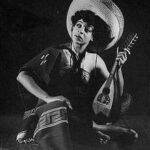 American dancer, choreographer, and dance teacher Syvilla Fort is born in Seattle, Washington. Fort drew on her African-American heritage in her original dance works. American composer John Cage wrote his first piece for prepared piano, Bacchanale (1940), for a dance by Fort. Fort was the first Black student to attend the Cornish School of Allied Arts in Seattle. Fort began dancing and touring with the Katherine Dunham Company and learning the Dunham technique, which was rooted in the dance traditions of Africa, Haiti, and Trinidad. Fort danced with the company until 1945 and was included in the well-known film Stormy Weather (1943). In 1948, Dunham appointed Fort as chief administrator and dance teacher of the Katherine Dunham School of Dance in New York. In 1955, Fort joined her husband Buddy Phillips to open a dance studio on West 44th Street in New York, where Fort developed what she called the "Afro-Modern technique" which fused the Dunham approach with modern styles of dance that Fort learned in her early education. She continued to use this method in her work as a part-time instructor of physical education at Columbia University's Teachers College from 1967 to 1975. Fort shaped three generations of dancers and among her best-known students were Marlon Brando, James Dean, Jane Fonda, James Earl Jones, Eartha Kitt, José Limón, Chita Rivera, and Geoffrey Holder. Learn more. American dancer, choreographer, and dance teacher Syvilla Fort is born in Seattle, Washington. Fort drew on her African-American heritage in her original dance works. American composer John Cage wrote his first piece for prepared piano, Bacchanale (1940), for a dance by Fort. Fort was the first Black student to attend the Cornish School of Allied Arts in Seattle. Fort began dancing and touring with the Katherine Dunham Company and learning the Dunham technique, which was rooted in the dance traditions of Africa, Haiti, and Trinidad. Fort danced with the company until 1945 and was included in the well-known film Stormy Weather (1943). In 1948, Dunham appointed Fort as chief administrator and dance teacher of the Katherine Dunham School of Dance in New York. In 1955, Fort joined her husband Buddy Phillips to open a dance studio on West 44th Street in New York, where Fort developed what she called the "Afro-Modern technique" which fused the Dunham approach with modern styles of dance that Fort learned in her early education. She continued to use this method in her work as a part-time instructor of physical education at Columbia University's Teachers College from 1967 to 1975. Fort shaped three generations of dancers and among her best-known students were Marlon Brando, James Dean, Jane Fonda, James Earl Jones, Eartha Kitt, José Limón, Chita Rivera, and Geoffrey Holder. Learn more. | |
| July 4, 1776 | 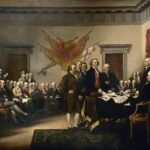 The United States Declaration of Independence is adopted by the Second Continental Congress meeting in Philadelphia, Pennsylvania. During the two days leading up to adoption, the original draft had been subjected to extensive revision, reducing its final length by one-fourth from the original draft. Among the revisions, Congress had, in order to appease the South Carolina and Georgia delegations, both states which had significant involvement in the slave trade, removed a section denouncing the slave trade. Thomas Jefferson later wrote in his autobiography that Northern states were also supportive towards the clauses removal, "for though their people had very few slaves themselves, yet they had been pretty considerable carriers of them to others." Learn more. The United States Declaration of Independence is adopted by the Second Continental Congress meeting in Philadelphia, Pennsylvania. During the two days leading up to adoption, the original draft had been subjected to extensive revision, reducing its final length by one-fourth from the original draft. Among the revisions, Congress had, in order to appease the South Carolina and Georgia delegations, both states which had significant involvement in the slave trade, removed a section denouncing the slave trade. Thomas Jefferson later wrote in his autobiography that Northern states were also supportive towards the clauses removal, "for though their people had very few slaves themselves, yet they had been pretty considerable carriers of them to others." Learn more. | |
| July 4, 1830 | 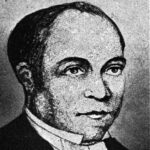 In observance of Independence Day, the Rev. Peter Williams, Jr., minister at the largest predominately black Episcopal Church in New York City, gives an impassioned speech titled "This is Our Country," calling for African American allegiance to the U.S. but also demanding that the nation treat its black citizens as the full equal of others. Read the text of Rev. Williams' oration. In observance of Independence Day, the Rev. Peter Williams, Jr., minister at the largest predominately black Episcopal Church in New York City, gives an impassioned speech titled "This is Our Country," calling for African American allegiance to the U.S. but also demanding that the nation treat its black citizens as the full equal of others. Read the text of Rev. Williams' oration. | |
| July 4, 1876 | 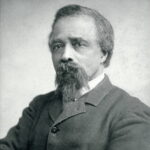 Now-revered painter Edward Mitchell Bannister receives his first national commendation, winning first prize for his large oil Under the Oaks at the 1876 Philadelphia Centennial. Upon learning Bannister's identity, the judge attempted to rescind the award until other exhibition artists protested. Bannister had intentionally submitted his painting with only a signature attached to ensure he would be judged fairly. As his career matured, he received more commissions and accumulated many honors, several from the Massachusetts Charitable Mechanics Association (silver medals in 1881 and 1884). Collectors and local notables Isaac Comstock Bates and Joseph Ely were among his patrons. Learn more. Now-revered painter Edward Mitchell Bannister receives his first national commendation, winning first prize for his large oil Under the Oaks at the 1876 Philadelphia Centennial. Upon learning Bannister's identity, the judge attempted to rescind the award until other exhibition artists protested. Bannister had intentionally submitted his painting with only a signature attached to ensure he would be judged fairly. As his career matured, he received more commissions and accumulated many honors, several from the Massachusetts Charitable Mechanics Association (silver medals in 1881 and 1884). Collectors and local notables Isaac Comstock Bates and Joseph Ely were among his patrons. Learn more. | |
| July 4, 1881 | 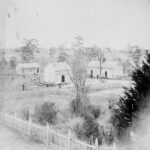 The Tuskegee Normal School for Colored Teachers, later Tuskegee Institute and then Tuskegee University, is founded as a private, historically Black land-grant university in Tuskegee, Alabama, under the leadership of Booker T. Washington. Also founded that same year are the historically Black colleges/universities: Spellman College, Morris Brown College, and Bishop College. Learn more. The Tuskegee Normal School for Colored Teachers, later Tuskegee Institute and then Tuskegee University, is founded as a private, historically Black land-grant university in Tuskegee, Alabama, under the leadership of Booker T. Washington. Also founded that same year are the historically Black colleges/universities: Spellman College, Morris Brown College, and Bishop College. Learn more. | |
| July 4, 1910 | 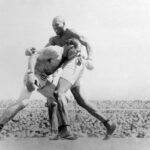 In a boxing match termed the "Fight of the Century", Jack Johnson, the first Black heavyweight champion, retains his championship by knocking out Jim "The Great White Hope" Jeffries, who had specifically come out of retirement "to win back the title for the White race". Johnson had became the first black World Heavyweight champion two years earlier, making extremely unpopular with the predominately white boxing audience. Following Johnson's victory over Jeffries, dozens of riots broke out across the United States as humiliated and enraged white mobs begin indiscriminately attacking African Americans publicly celebrating Johnson's victory. Learn more. In a boxing match termed the "Fight of the Century", Jack Johnson, the first Black heavyweight champion, retains his championship by knocking out Jim "The Great White Hope" Jeffries, who had specifically come out of retirement "to win back the title for the White race". Johnson had became the first black World Heavyweight champion two years earlier, making extremely unpopular with the predominately white boxing audience. Following Johnson's victory over Jeffries, dozens of riots broke out across the United States as humiliated and enraged white mobs begin indiscriminately attacking African Americans publicly celebrating Johnson's victory. Learn more. | |
| July 4, 1933 | 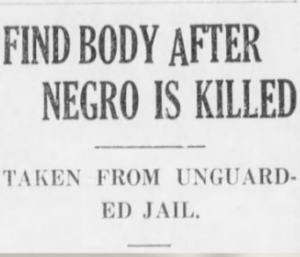 A white mob in Clinton, South Carolina, seizes a 35-year-old Black man named Norris Dendy from a local jail cell, beat him, and hang him. The mob then dumps Mr. Dendy’s brutalized body in a churchyard seven miles from Laurens County. Earlier in the day, while picnicking at a lakeside resort with family and friends for a Fourth of July celebration, Mr. Dendy allegedly struck a white man during an altercation and was arrested for “drunkenness” and “reckless driving.” Despite multiple eyewitnesses to the mob action, a year later, a grand jury refused to indict the members of the mob and no one was ever held accountable for the lynching of Mr. Dendy. Learn more. A white mob in Clinton, South Carolina, seizes a 35-year-old Black man named Norris Dendy from a local jail cell, beat him, and hang him. The mob then dumps Mr. Dendy’s brutalized body in a churchyard seven miles from Laurens County. Earlier in the day, while picnicking at a lakeside resort with family and friends for a Fourth of July celebration, Mr. Dendy allegedly struck a white man during an altercation and was arrested for “drunkenness” and “reckless driving.” Despite multiple eyewitnesses to the mob action, a year later, a grand jury refused to indict the members of the mob and no one was ever held accountable for the lynching of Mr. Dendy. Learn more. | |
| July 5, 1852 |  Invited by “The Ladies Anti-Slavery Society" of Rochester, N.Y., a white abolitionist group, to give a speech on Independence Day, Frederick Douglass said he would instead speak on the following day, July 5. In front of a large crowd in the relatively new Corinthian Hall, Douglass boldly spoke of the hypocrisy of asking him to speak on a day celebrating freedom when one out of eight people are “Not Free”. Douglass was known for his brilliant and persuasive oratory which drew listeners of all races to hear him expound upon the merits of freedom for all people. This famous speech, known by its central question -- "What to the Slave Is the Fourth of July?" -- illustrated his mastery of intellectual persuasion and boldness to speak the truth regardless of any personal consequences. Read the speech. Invited by “The Ladies Anti-Slavery Society" of Rochester, N.Y., a white abolitionist group, to give a speech on Independence Day, Frederick Douglass said he would instead speak on the following day, July 5. In front of a large crowd in the relatively new Corinthian Hall, Douglass boldly spoke of the hypocrisy of asking him to speak on a day celebrating freedom when one out of eight people are “Not Free”. Douglass was known for his brilliant and persuasive oratory which drew listeners of all races to hear him expound upon the merits of freedom for all people. This famous speech, known by its central question -- "What to the Slave Is the Fourth of July?" -- illustrated his mastery of intellectual persuasion and boldness to speak the truth regardless of any personal consequences. Read the speech. | |
| July 5, 1892 | 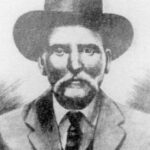 African American inventor Andrew Beard patents a design for a new rotary steam engine, U.S. Patent 478,271. African American inventor Andrew Beard patents a design for a new rotary steam engine, U.S. Patent 478,271. | |
| July 5, 1975 |  Arthur Ashe defeats Jimmy Connors to become the first African American to win the Wimbledon Men’s singles championship. Learn more. Arthur Ashe defeats Jimmy Connors to become the first African American to win the Wimbledon Men’s singles championship. Learn more. | |
| July 5, 2016 |  Two white police officers in Baton Rouge, Louisiana, responding to reports that an armed man with a red shirt was selling CDs outside of a local convenience store, tase, pin to the ground, restrain, and shoot 37-year-old Black man Alton Sterling six times in the chest and back, killing him. Though officials claimed Sterling was reaching for a gun, the convenience store surveillance video and multiple bystander cell phone videos consistently show that his arms and hands were fully restrained when he was shot, and he made no movement suggesting a move to grab a weapon. The coroner ruled the death a homicide, but no charges were ever brought against the two officers. Learn more. Two white police officers in Baton Rouge, Louisiana, responding to reports that an armed man with a red shirt was selling CDs outside of a local convenience store, tase, pin to the ground, restrain, and shoot 37-year-old Black man Alton Sterling six times in the chest and back, killing him. Though officials claimed Sterling was reaching for a gun, the convenience store surveillance video and multiple bystander cell phone videos consistently show that his arms and hands were fully restrained when he was shot, and he made no movement suggesting a move to grab a weapon. The coroner ruled the death a homicide, but no charges were ever brought against the two officers. Learn more. | |
| July 6, 1944 | 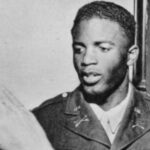 Second Lieutenant Jackie Robinson (who will later become the first Black player in Major League Baseball) refuses a bus driver's demand to move to the back of an unsegregated military bus, triggering a sequence of events that obstruct his military career. Upon reaching the end of the line, the driver summoned military police, who took Robinson into custody. When Robinson confronted the investigating duty officer about racist questioning by the officer and his assistant, the officer recommended Robinson be court-martialed. After Robinson's commander in the 761st "Black Panthers" Tank Battalion, Paul L. Bates, refused to authorize the legal action, Robinson was summarily transferred to the 758th Battalion—where the commander quickly consented to charge Robinson with multiple offenses, including, among other charges, public drunkenness, even though Robinson did not drink. By the time of the court-martial in August 1944, the charges against Robinson had been reduced to two counts of insubordination during questioning. Robinson was acquitted by an all-white panel of nine officers, but his military career was nonetheless derailed. Learn more. Second Lieutenant Jackie Robinson (who will later become the first Black player in Major League Baseball) refuses a bus driver's demand to move to the back of an unsegregated military bus, triggering a sequence of events that obstruct his military career. Upon reaching the end of the line, the driver summoned military police, who took Robinson into custody. When Robinson confronted the investigating duty officer about racist questioning by the officer and his assistant, the officer recommended Robinson be court-martialed. After Robinson's commander in the 761st "Black Panthers" Tank Battalion, Paul L. Bates, refused to authorize the legal action, Robinson was summarily transferred to the 758th Battalion—where the commander quickly consented to charge Robinson with multiple offenses, including, among other charges, public drunkenness, even though Robinson did not drink. By the time of the court-martial in August 1944, the charges against Robinson had been reduced to two counts of insubordination during questioning. Robinson was acquitted by an all-white panel of nine officers, but his military career was nonetheless derailed. Learn more. | |
| July 6, 1957 |  Althea Gibson wins the Wimbledon championships, becoming the first Black athlete to do so. Gibson was an African American tennis player and professional golfer, and one of the first Black athletes to cross the color line of international tennis. In 1956, she became the first African American to win a Grand Slam title (the French Championships). The following year she won both Wimbledon and the US Nationals (precursor of the US Open), then won both again in 1958 and was voted Female Athlete of the Year by the Associated Press in both years. In all, she won 11 Grand Slam tournaments: five singles titles, five doubles titles, and one mixed doubles title. Gibson was inducted into the International Tennis Hall of Fame and the International Women's Sports Hall of Fame. In the early 1960s she also became the first Black player to compete on the Women's Professional Golf Tour. At a time when racism and prejudice were widespread in sports and in society, Gibson was often compared to Jackie Robinson. Learn more. Althea Gibson wins the Wimbledon championships, becoming the first Black athlete to do so. Gibson was an African American tennis player and professional golfer, and one of the first Black athletes to cross the color line of international tennis. In 1956, she became the first African American to win a Grand Slam title (the French Championships). The following year she won both Wimbledon and the US Nationals (precursor of the US Open), then won both again in 1958 and was voted Female Athlete of the Year by the Associated Press in both years. In all, she won 11 Grand Slam tournaments: five singles titles, five doubles titles, and one mixed doubles title. Gibson was inducted into the International Tennis Hall of Fame and the International Women's Sports Hall of Fame. In the early 1960s she also became the first Black player to compete on the Women's Professional Golf Tour. At a time when racism and prejudice were widespread in sports and in society, Gibson was often compared to Jackie Robinson. Learn more. | |
| July 6, 1971 | 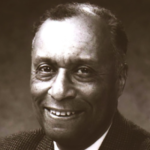 Brilliant and accomplished nuclear engineer and aerospace engineering pioneer Henry T. Sampson Jr., Ph.D. and his colleague/collaborator Dr. George H. Miley are granted US patent #3,591,860 for their invention of the Gamma-Electrical Cell, a device with the main goal of generating auxiliary power from the shielding of a nuclear reactor. The device is used to help power satellites and space exploration missions. Dr. Sampson held additional patents on solid rocket motors and was also a noted historian of Black cinema. When he received his doctorate at the University of Illinois Urbana-Champaign in 1967, he was the first Black American to earn a Ph.D. in Nuclear Engineering in the United States. Learn more. Brilliant and accomplished nuclear engineer and aerospace engineering pioneer Henry T. Sampson Jr., Ph.D. and his colleague/collaborator Dr. George H. Miley are granted US patent #3,591,860 for their invention of the Gamma-Electrical Cell, a device with the main goal of generating auxiliary power from the shielding of a nuclear reactor. The device is used to help power satellites and space exploration missions. Dr. Sampson held additional patents on solid rocket motors and was also a noted historian of Black cinema. When he received his doctorate at the University of Illinois Urbana-Champaign in 1967, he was the first Black American to earn a Ph.D. in Nuclear Engineering in the United States. Learn more. | |
| July 6, 2016 |  Police officer Jeronimo Yanez shoots and kills 32-year-old Philando Castile during a traffic stop for a broken taillight in St. Paul, Minnesota. At the start of the stop, when Officer Yanez asked Mr. Castile if he had a weapon. Mr. Castile responded that he did have a gun and a valid permit, located in his wallet. When Mr. Castile moved to retrieve the items, Officer Yanez ordered him to keep his hands on the wheel; as Mr. Castile complied and moved his hands back up to place them on the steering wheel, Officer Yanez fired at least four shots into the open car window, striking Mr. Castile in the chest and endangering Mr. Castile's fiancé Diamond Reynolds and her 4-year-old daughter. Police who arrived at the scene following the shooting rendered no medical aid to Mr. Castile as he bled to death, instead comforting the crying police officer who had killed him. In the years before his death at the hands of police, Mr. Castile had been stopped for minor traffic violations at least 52 times—approximately every four months. These stops resulted in 86 issued violations, most of which were dismissed, and cost Mr. Castile over $6,500 in fees and fines. In June 2017, Officer Yanez was tried and acquitted of all charges related to Philando Castile's death. Learn more. Police officer Jeronimo Yanez shoots and kills 32-year-old Philando Castile during a traffic stop for a broken taillight in St. Paul, Minnesota. At the start of the stop, when Officer Yanez asked Mr. Castile if he had a weapon. Mr. Castile responded that he did have a gun and a valid permit, located in his wallet. When Mr. Castile moved to retrieve the items, Officer Yanez ordered him to keep his hands on the wheel; as Mr. Castile complied and moved his hands back up to place them on the steering wheel, Officer Yanez fired at least four shots into the open car window, striking Mr. Castile in the chest and endangering Mr. Castile's fiancé Diamond Reynolds and her 4-year-old daughter. Police who arrived at the scene following the shooting rendered no medical aid to Mr. Castile as he bled to death, instead comforting the crying police officer who had killed him. In the years before his death at the hands of police, Mr. Castile had been stopped for minor traffic violations at least 52 times—approximately every four months. These stops resulted in 86 issued violations, most of which were dismissed, and cost Mr. Castile over $6,500 in fees and fines. In June 2017, Officer Yanez was tried and acquitted of all charges related to Philando Castile's death. Learn more. | |
| July 7, 1834 | 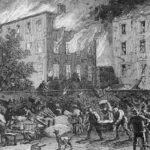 New York City is torn by the massive Anti-Abolitionist Riot (also called Farren Riot or Tappan Riot) that lasts for nearly a week until it is put down by military force. "At times the rioters controlled whole sections of the city while they attacked the homes, businesses, and churches of abolitionist leaders and ransacked black neighborhoods." Learn more. New York City is torn by the massive Anti-Abolitionist Riot (also called Farren Riot or Tappan Riot) that lasts for nearly a week until it is put down by military force. "At times the rioters controlled whole sections of the city while they attacked the homes, businesses, and churches of abolitionist leaders and ransacked black neighborhoods." Learn more. | |
| July 7, 1893 | 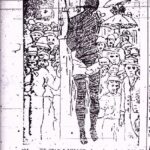 A crowd of over 5,000 white people brutally tortured, mutilated, and lynched a Black man named Seay J. Miller in Bardwell, Kentucky, for allegedly killing Mary and Ruby Ray, two young white girls, despite ample evidence of his innocence. Statements from Mr. Miller’s wife and from law enfocement witnesses indicated that Mr. Miller was not even in Kentucky on the date the girls were killed, and multiple eyewitnesses identified the Ray girls’ killer as a white man. Even John Ray, the girls’ father, was unconvinced of Mr. Miller’s guilt. Frank Gordon was the sole witness who implicated Mr. Miller, but he originally told police that the person he saw was a white man—as did other witnesses. Mr. Gordon changed his statement only after the county sheriff threatened to charge him as an accomplice if he did not do so. This same sheriff handed Mr. Miller over to a crowd of thousands of white citizens to be lynched. Learn more. A crowd of over 5,000 white people brutally tortured, mutilated, and lynched a Black man named Seay J. Miller in Bardwell, Kentucky, for allegedly killing Mary and Ruby Ray, two young white girls, despite ample evidence of his innocence. Statements from Mr. Miller’s wife and from law enfocement witnesses indicated that Mr. Miller was not even in Kentucky on the date the girls were killed, and multiple eyewitnesses identified the Ray girls’ killer as a white man. Even John Ray, the girls’ father, was unconvinced of Mr. Miller’s guilt. Frank Gordon was the sole witness who implicated Mr. Miller, but he originally told police that the person he saw was a white man—as did other witnesses. Mr. Gordon changed his statement only after the county sheriff threatened to charge him as an accomplice if he did not do so. This same sheriff handed Mr. Miller over to a crowd of thousands of white citizens to be lynched. Learn more. | |
| July 7, 1906 |  Leroy Robert "Satchel" Paige, one of the greatest baseball pitchers of all time, is born. Paige played in Negro league baseball and Major League Baseball (MLB). His career spanned five decades and culminated with his induction into the National Baseball Hall of Fame. He began his professional baseball career in 1926 with the Chattanooga Black Lookouts of the Negro Southern League and became one of the most famous and successful players from the Negro leagues. On town tours across the United States, Paige would sometimes have his infielders sit down behind him and then routinely strike out the side. At age 42 in 1948, Paige made his major league debut for the Cleveland Indians; to this day, the oldest debutant in major league history. Paige was 59 years old when he played his last major league game, which is also a record that stands to this day. Paige was the first black pitcher to play in the American League and was the seventh black player to play in Major League Baseball. Also in 1948, Paige became the first player who had played in the Negro leagues to pitch in the World Series; the Indians won the Series that year. He played with the St. Louis Browns from 1951 to 1953, representing the team in the All-Star Game in 1952 and 1953. He played his last professional game on June 21, 1966, for the Peninsula Grays of the Carolina League, two weeks shy of 60. In 1971, Paige became the first electee of the Negro League Committee to be inducted into the Baseball Hall of Fame. Learn more. Leroy Robert "Satchel" Paige, one of the greatest baseball pitchers of all time, is born. Paige played in Negro league baseball and Major League Baseball (MLB). His career spanned five decades and culminated with his induction into the National Baseball Hall of Fame. He began his professional baseball career in 1926 with the Chattanooga Black Lookouts of the Negro Southern League and became one of the most famous and successful players from the Negro leagues. On town tours across the United States, Paige would sometimes have his infielders sit down behind him and then routinely strike out the side. At age 42 in 1948, Paige made his major league debut for the Cleveland Indians; to this day, the oldest debutant in major league history. Paige was 59 years old when he played his last major league game, which is also a record that stands to this day. Paige was the first black pitcher to play in the American League and was the seventh black player to play in Major League Baseball. Also in 1948, Paige became the first player who had played in the Negro leagues to pitch in the World Series; the Indians won the Series that year. He played with the St. Louis Browns from 1951 to 1953, representing the team in the All-Star Game in 1952 and 1953. He played his last professional game on June 21, 1966, for the Peninsula Grays of the Carolina League, two weeks shy of 60. In 1971, Paige became the first electee of the Negro League Committee to be inducted into the Baseball Hall of Fame. Learn more. | |
| July 7, 1915 | 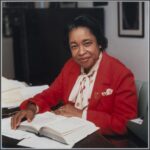 American poet and writer Margaret Walker is born in Birmingham, Alabama, to Sigismund C. Walker, a minister, and Marion (née Dozier) Walker, who helped their daughter by teaching her philosophy and poetry as a child. She was part of the African-American literary movement in Chicago, known as the Chicago Black Renaissance. Her notable works include For My People (1942) which won the Yale Series of Younger Poets Competition, and the novel Jubilee (1966), set in the South during the American Civil War. In 1935, Walker received her Bachelor of Arts Degree from Northwestern University. In 1936 she began work with the Federal Writers' Project under the Works Progress Administration of the President Franklin D. Roosevelt administration during the Great Depression. She was a member of the South Side Writers Group, which included authors such as Richard Wright, Arna Bontemps, Fenton Johnson, Theodore Ward, and Frank Marshall Davis. In 1942, she received her master's degree in creative writing from the University of Iowa. In 1965, she returned to that school to earn her Ph.D. Learn more. American poet and writer Margaret Walker is born in Birmingham, Alabama, to Sigismund C. Walker, a minister, and Marion (née Dozier) Walker, who helped their daughter by teaching her philosophy and poetry as a child. She was part of the African-American literary movement in Chicago, known as the Chicago Black Renaissance. Her notable works include For My People (1942) which won the Yale Series of Younger Poets Competition, and the novel Jubilee (1966), set in the South during the American Civil War. In 1935, Walker received her Bachelor of Arts Degree from Northwestern University. In 1936 she began work with the Federal Writers' Project under the Works Progress Administration of the President Franklin D. Roosevelt administration during the Great Depression. She was a member of the South Side Writers Group, which included authors such as Richard Wright, Arna Bontemps, Fenton Johnson, Theodore Ward, and Frank Marshall Davis. In 1942, she received her master's degree in creative writing from the University of Iowa. In 1965, she returned to that school to earn her Ph.D. Learn more. | |
| July 7, 1972 |  Basketball great Lisa Deshaun Leslie is born. Leslie played in the Women's National Basketball Association (WNBA). She is a three-time WNBA MVP and a four-time Olympic gold medal winner. The number-seven pick in the 1997 inaugural WNBA draft, she followed her career at the University of Southern California with eight WNBA All-Star selections and two WNBA championships over the course of eleven seasons with the Los Angeles Sparks, before retiring in 2009. Leslie was the first player to dunk in a WNBA game. In 2011, she was voted by fans as one of the Top 15 players in WNBA history. In 2015, she was inducted into the Naismith Memorial Basketball Hall of Fame. Leslie was also inducted into the Women's Basketball Hall of Fame in 2015. She is currently the head coach for Triplets in the BIG3 professional basketball league, as well as a studio analyst for Orlando Magic broadcasts on Fox Sports Florida. Learn more. Basketball great Lisa Deshaun Leslie is born. Leslie played in the Women's National Basketball Association (WNBA). She is a three-time WNBA MVP and a four-time Olympic gold medal winner. The number-seven pick in the 1997 inaugural WNBA draft, she followed her career at the University of Southern California with eight WNBA All-Star selections and two WNBA championships over the course of eleven seasons with the Los Angeles Sparks, before retiring in 2009. Leslie was the first player to dunk in a WNBA game. In 2011, she was voted by fans as one of the Top 15 players in WNBA history. In 2015, she was inducted into the Naismith Memorial Basketball Hall of Fame. Leslie was also inducted into the Women's Basketball Hall of Fame in 2015. She is currently the head coach for Triplets in the BIG3 professional basketball league, as well as a studio analyst for Orlando Magic broadcasts on Fox Sports Florida. Learn more. | |
| July 8, 1860 | 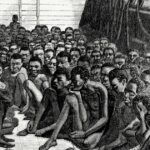 More than 50 years after Congress banned the importation of enslaved Africans into the U.S., the slave ship Clotilde arrives in Mobile, Alabama, carrying more than 100 enslaved people from West Africa. Captain William Foster commanded the boat, working for Timothy Meaher, a white Mobile shipyard owner who built the Clotilde. The smuggled Africans were subsequently distributed as enslaved property amongst the group of white men who had financed the voyage. Mr. Meaher kept more than 30 of the Africans on Magazine Point, his property north of Mobile, Alabama. In 1865, after the Civil War ended and slavery was widely abolished, the Clotilde survivors once held by Mr. Meaher were free—but still trapped in a foreign land far from their home. They settled along the outskirts of Mr. Meaher’s property, at a site that came to be known as “Africatown,” and developed a community modeled after the traditions and government they had been forced to leave behind. Well into the 1950s, descendants of the Clotilde passengers living in Africatown maintained a distinct language and unique community of survival. Today, many descendants of the Africans trafficked on the Clotilde continue to live in northern Mobile, Alabama, and in December 2012, the National Park Service added the Africatown Historic District to the National Register of Historic Places. Learn more. More than 50 years after Congress banned the importation of enslaved Africans into the U.S., the slave ship Clotilde arrives in Mobile, Alabama, carrying more than 100 enslaved people from West Africa. Captain William Foster commanded the boat, working for Timothy Meaher, a white Mobile shipyard owner who built the Clotilde. The smuggled Africans were subsequently distributed as enslaved property amongst the group of white men who had financed the voyage. Mr. Meaher kept more than 30 of the Africans on Magazine Point, his property north of Mobile, Alabama. In 1865, after the Civil War ended and slavery was widely abolished, the Clotilde survivors once held by Mr. Meaher were free—but still trapped in a foreign land far from their home. They settled along the outskirts of Mr. Meaher’s property, at a site that came to be known as “Africatown,” and developed a community modeled after the traditions and government they had been forced to leave behind. Well into the 1950s, descendants of the Clotilde passengers living in Africatown maintained a distinct language and unique community of survival. Today, many descendants of the Africans trafficked on the Clotilde continue to live in northern Mobile, Alabama, and in December 2012, the National Park Service added the Africatown Historic District to the National Register of Historic Places. Learn more. | |
| July 8, 1876 | 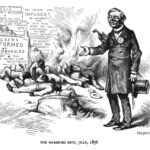 The Hamburg Massacre (or Red Shirt Massacre) begins in the town of Hamburg, South Carolina, the first in a series of violent terrorist actions planned and carried out by white Democrats in majority-black Republican districts across South Carolina in the lead up to the last election season of the Reconstruction Era, with the goal of suppressing black Americans' civil rights and voting rights and disrupting Republican meetings, through actual and threatened violence.
Beginning with a dispute over free passage on a public road, the massacre was rooted in racial hatred and political motives. A court hearing attracted armed white "rifle clubs," colloquially called the "Red Shirts". Desiring to regain control of state governments and eradicate the civil rights of black Americans, over 100 white men attacked about 30 black servicemen of the National Guard at the armory, killing two as they tried to leave that night. Later that night, the Red Shirts tortured and murdered four of the militia while holding them as prisoners, and wounded several others. In total, the events in Hamburg resulted in the death of one white man and six black men with several more blacks being wounded. Although 94 white men were indicted for murder by a coroner's jury, none were prosecuted.
The events were a catalyst in the overarching violence in the volatile 1876 election campaign. There were other episodes of violence in the months before the election, including an estimated 100 blacks killed during several days in Ellenton, South Carolina, also in Aiken County. The Southern Democrats succeeded in "redeeming" the state government and electing Wade Hampton III as governor. During the remainder of the century, they passed laws to establish single-party white rule, impose legal segregation and "Jim Crow," and disenfranchise blacks with a new state constitution adopted in 1895. This exclusion of blacks from the political system was effectively maintained into the late 1960s. Learn more. The Hamburg Massacre (or Red Shirt Massacre) begins in the town of Hamburg, South Carolina, the first in a series of violent terrorist actions planned and carried out by white Democrats in majority-black Republican districts across South Carolina in the lead up to the last election season of the Reconstruction Era, with the goal of suppressing black Americans' civil rights and voting rights and disrupting Republican meetings, through actual and threatened violence.
Beginning with a dispute over free passage on a public road, the massacre was rooted in racial hatred and political motives. A court hearing attracted armed white "rifle clubs," colloquially called the "Red Shirts". Desiring to regain control of state governments and eradicate the civil rights of black Americans, over 100 white men attacked about 30 black servicemen of the National Guard at the armory, killing two as they tried to leave that night. Later that night, the Red Shirts tortured and murdered four of the militia while holding them as prisoners, and wounded several others. In total, the events in Hamburg resulted in the death of one white man and six black men with several more blacks being wounded. Although 94 white men were indicted for murder by a coroner's jury, none were prosecuted.
The events were a catalyst in the overarching violence in the volatile 1876 election campaign. There were other episodes of violence in the months before the election, including an estimated 100 blacks killed during several days in Ellenton, South Carolina, also in Aiken County. The Southern Democrats succeeded in "redeeming" the state government and electing Wade Hampton III as governor. During the remainder of the century, they passed laws to establish single-party white rule, impose legal segregation and "Jim Crow," and disenfranchise blacks with a new state constitution adopted in 1895. This exclusion of blacks from the political system was effectively maintained into the late 1960s. Learn more. | |
| July 8, 1914 | 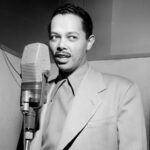 Sublime jazz and pop singer and premier swing era bandleader William Clarence “Billy” Eckstine is born. He was noted for his rich, almost operatic bass-baritone voice. His recording of "I Apologize" (MGM, 1948) was given the Grammy Hall of Fame Award in 1999. The New York Times described him as an "influential band leader" whose "suave bass-baritone" and "full-throated, sugary approach to popular songs inspired singers like Earl Coleman, Johnny Hartman, Joe Williams, Arthur Prysock and Lou Rawls." Dizzy Gillespie, in reflecting on the Eckstine band in his 1979 autobiography To Be or Not to Bop, gives this perspective: "There was no band that sounded like Billy Eckstine's. Our attack was strong, and we were playing bebop, the modern style. No other band like this one existed in the world." Eckstine’s highly successful solo career was adversely impacted after he was the subject of a three-page profile in the 25 April 1950 issue of LIFE magazine. One photograph published in LIFE showed Eckstine with a group of white female admirers, one of whom had her hand on his shoulder and her head on his chest while she laughed. The photograph was considered so controversial that an editor at LIFE sought personal approval from Henry Luce, the magazine's publisher, who said it should be published. The publication of the image caused letters of protest to be written to the magazine, and singer Harry Belafonte subsequently said of the publication that "When that photo hit, in this national publication, it was if a barrier had been broken". The controversy that resulted from the photograph had a seminal effect on the trajectory of Eckstine's career. Tony Bennett would recall that "It changed everything...Before that, he had a tremendous following...and it just offended the white community", a sentiment shared by pianist Billy Taylor who said that the "coverage and that picture just slammed the door shut for him". Learn more. Sublime jazz and pop singer and premier swing era bandleader William Clarence “Billy” Eckstine is born. He was noted for his rich, almost operatic bass-baritone voice. His recording of "I Apologize" (MGM, 1948) was given the Grammy Hall of Fame Award in 1999. The New York Times described him as an "influential band leader" whose "suave bass-baritone" and "full-throated, sugary approach to popular songs inspired singers like Earl Coleman, Johnny Hartman, Joe Williams, Arthur Prysock and Lou Rawls." Dizzy Gillespie, in reflecting on the Eckstine band in his 1979 autobiography To Be or Not to Bop, gives this perspective: "There was no band that sounded like Billy Eckstine's. Our attack was strong, and we were playing bebop, the modern style. No other band like this one existed in the world." Eckstine’s highly successful solo career was adversely impacted after he was the subject of a three-page profile in the 25 April 1950 issue of LIFE magazine. One photograph published in LIFE showed Eckstine with a group of white female admirers, one of whom had her hand on his shoulder and her head on his chest while she laughed. The photograph was considered so controversial that an editor at LIFE sought personal approval from Henry Luce, the magazine's publisher, who said it should be published. The publication of the image caused letters of protest to be written to the magazine, and singer Harry Belafonte subsequently said of the publication that "When that photo hit, in this national publication, it was if a barrier had been broken". The controversy that resulted from the photograph had a seminal effect on the trajectory of Eckstine's career. Tony Bennett would recall that "It changed everything...Before that, he had a tremendous following...and it just offended the white community", a sentiment shared by pianist Billy Taylor who said that the "coverage and that picture just slammed the door shut for him". Learn more. | |
| July 8, 1943 |  Faye Wattleton (a/k/a Alyce Faye Wattleton), American reproductive rights activist who was the first African American and the youngest president ever elected of Planned Parenthood Federation of America, and the first woman since Margaret Sangerto hold the position, is born. She is currently Co-Founder & Director at EeroQ, a quantum computing company. She is best known for her contributions to family planning and reproductive health, as well as the pro-choice movement. Learn more. Faye Wattleton (a/k/a Alyce Faye Wattleton), American reproductive rights activist who was the first African American and the youngest president ever elected of Planned Parenthood Federation of America, and the first woman since Margaret Sangerto hold the position, is born. She is currently Co-Founder & Director at EeroQ, a quantum computing company. She is best known for her contributions to family planning and reproductive health, as well as the pro-choice movement. Learn more. | |
| July 9, 1868 | 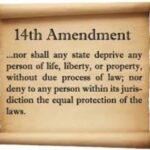 The Fourteenth Amendment (Amendment XIV) to the United States Constitution is ratified and adopted. One of the Reconstruction Amendments, it is considered one of the most consequential amendments. The amendment addresses citizenship rights and equal protection under the law and was proposed in response to issues related to former slaves following the American Civil War. The amendment was bitterly contested, particularly by the states of the defeated Confederacy, which were forced to ratify it in order to regain representation in Congress. The amendment, particularly its first section, is one of the most litigated parts of the Constitution, forming the basis for landmark Supreme Court decisions such as Brown v. Board of Education (1954) regarding racial segregation, Roe v. Wade (1973) regarding abortion, Bush v. Gore (2000) regarding the 2000 presidential election, and Obergefell v. Hodges (2015) regarding same-sex marriage. The amendment limits the actions of all state and local officials, and also those acting on behalf of such officials. The amendment's first section includes the Citizenship Clause, Due Process Clause, and Equal Protection Clause. The Citizenship Clause provides a broad definition of citizenship, nullifying the Supreme Court's decision in Dred Scott v. Sandford (1857), which had held that Americans descended from African slaves could not be citizens of the United States. The Due Process Clause prohibits state and local governments from depriving persons of life, liberty, or property without a fair procedure. The Equal Protection Clause requires each state to provide equal protection under the law to all people, including all non-citizens, within its jurisdiction. Learn more. The Fourteenth Amendment (Amendment XIV) to the United States Constitution is ratified and adopted. One of the Reconstruction Amendments, it is considered one of the most consequential amendments. The amendment addresses citizenship rights and equal protection under the law and was proposed in response to issues related to former slaves following the American Civil War. The amendment was bitterly contested, particularly by the states of the defeated Confederacy, which were forced to ratify it in order to regain representation in Congress. The amendment, particularly its first section, is one of the most litigated parts of the Constitution, forming the basis for landmark Supreme Court decisions such as Brown v. Board of Education (1954) regarding racial segregation, Roe v. Wade (1973) regarding abortion, Bush v. Gore (2000) regarding the 2000 presidential election, and Obergefell v. Hodges (2015) regarding same-sex marriage. The amendment limits the actions of all state and local officials, and also those acting on behalf of such officials. The amendment's first section includes the Citizenship Clause, Due Process Clause, and Equal Protection Clause. The Citizenship Clause provides a broad definition of citizenship, nullifying the Supreme Court's decision in Dred Scott v. Sandford (1857), which had held that Americans descended from African slaves could not be citizens of the United States. The Due Process Clause prohibits state and local governments from depriving persons of life, liberty, or property without a fair procedure. The Equal Protection Clause requires each state to provide equal protection under the law to all people, including all non-citizens, within its jurisdiction. Learn more. | |
| July 9, 1936 |  June Meyer Jordan, writer, editor, poet, educator, environmental and social activist, the only child of Jamaican immigrants Granville Ivanhoe and Mildred Maude Fischer Jordan is born in Harlem, New York City. Following her 1964 divorce, Jordan devoted her life to writing poetry, studying, and doing free-lance journalism to support her son and herself. Jordan also became a Civil Rights activist, joining busloads of “Freedom Riders” to Baltimore as they traveled demanding enforcement of Supreme Court decisions on desegregation. Jordan wrote her first book of poetry Look at Me, a book on African American life, in 1969. The next year she edited an anthology of poetry by children, youth and well-known poets, entitled, Soulscript; A Collection of African-American Poetry. In 1971 Jordan wrote a novel for young adults, His Own Where, addressing her interest in environmental concerns. In all, Jordan authored twenty eight books and numerous short stories . She also worked as an instructor at the City College in New York and at Sarah Lawrence College in New York, and in 1989 she became a Professor of African American Studies at the University of California at Berkley where she founded and directed the Poetry for the People Program. Jordan received numerous awards and honors, including a Rockefeller Grant and National Endowment for the Arts Fellowship. Learn more. June Meyer Jordan, writer, editor, poet, educator, environmental and social activist, the only child of Jamaican immigrants Granville Ivanhoe and Mildred Maude Fischer Jordan is born in Harlem, New York City. Following her 1964 divorce, Jordan devoted her life to writing poetry, studying, and doing free-lance journalism to support her son and herself. Jordan also became a Civil Rights activist, joining busloads of “Freedom Riders” to Baltimore as they traveled demanding enforcement of Supreme Court decisions on desegregation. Jordan wrote her first book of poetry Look at Me, a book on African American life, in 1969. The next year she edited an anthology of poetry by children, youth and well-known poets, entitled, Soulscript; A Collection of African-American Poetry. In 1971 Jordan wrote a novel for young adults, His Own Where, addressing her interest in environmental concerns. In all, Jordan authored twenty eight books and numerous short stories . She also worked as an instructor at the City College in New York and at Sarah Lawrence College in New York, and in 1989 she became a Professor of African American Studies at the University of California at Berkley where she founded and directed the Poetry for the People Program. Jordan received numerous awards and honors, including a Rockefeller Grant and National Endowment for the Arts Fellowship. Learn more. | |
| July 9, 1978 |  White supremacists wearing Nazi uniforms hold a rally in Chicago’s Marquette Park. Over 2,000 spectators descended on the park as representatives of the National Socialist Party of America espoused their views; some eyewitnesses estimated that a third of the crowd was supportive of the speakers’ message, while others were curious onlookers or anti-racist protesters. At the rally, NSPA members expressed violent threats toward Jewish people and blamed them for bringing an influx of African Americans into the area. NSPA leader Frank Collin denied the Holocaust while declaring that Jewish people “deserve one and they will get it.” He also vowed that the NSPA would see Marquette Park become a “graveyard” before allowing it to be integrated or “taken over by blacks.” Learn more. White supremacists wearing Nazi uniforms hold a rally in Chicago’s Marquette Park. Over 2,000 spectators descended on the park as representatives of the National Socialist Party of America espoused their views; some eyewitnesses estimated that a third of the crowd was supportive of the speakers’ message, while others were curious onlookers or anti-racist protesters. At the rally, NSPA members expressed violent threats toward Jewish people and blamed them for bringing an influx of African Americans into the area. NSPA leader Frank Collin denied the Holocaust while declaring that Jewish people “deserve one and they will get it.” He also vowed that the NSPA would see Marquette Park become a “graveyard” before allowing it to be integrated or “taken over by blacks.” Learn more. | |
| July 9, 1979 | 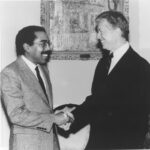 Walter E. Massey, Ph.D., is named Director of the Argonne National Laboratory. Dr. Massey is an American educator, physicist, and executive. President emeritus of the School of the Art Institute of Chicago (SAIC) and of Morehouse College, he is chairman of the board overseeing construction of the Giant Magellan Telescope, and serves as trustee chair of the City Colleges of Chicago. During his career, Massey has served as head of the National Science Foundation, director of Argonne National Laboratory, and chairman of Bank of America. He has also served in professorial and administrative posts at the University of California, University of Chicago, Brown University, and the University of Illinois. Massey is the only individual to serve as both President and Chairman of the American Association for the Advancement of Science (AAAS) and as Chair of the Association of Independent Colleges of Art and Design(AICAD). Additionally, Massey is the only individual to have received both the Enrico Fermi Award for Science and Technology from the Chicago Historical Society and the Public Humanities Award from Illinois Humanities. Learn more. Walter E. Massey, Ph.D., is named Director of the Argonne National Laboratory. Dr. Massey is an American educator, physicist, and executive. President emeritus of the School of the Art Institute of Chicago (SAIC) and of Morehouse College, he is chairman of the board overseeing construction of the Giant Magellan Telescope, and serves as trustee chair of the City Colleges of Chicago. During his career, Massey has served as head of the National Science Foundation, director of Argonne National Laboratory, and chairman of Bank of America. He has also served in professorial and administrative posts at the University of California, University of Chicago, Brown University, and the University of Illinois. Massey is the only individual to serve as both President and Chairman of the American Association for the Advancement of Science (AAAS) and as Chair of the Association of Independent Colleges of Art and Design(AICAD). Additionally, Massey is the only individual to have received both the Enrico Fermi Award for Science and Technology from the Chicago Historical Society and the Public Humanities Award from Illinois Humanities. Learn more. | |
| July 10, 1875 | 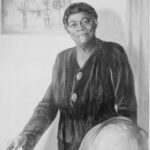 Educator, stateswoman, philanthropist, humanitarian, womanist, and civil rights activist Mary McLeod Bethune is born. Bethune founded the National Council for Negro Women in 1935, established the organization's flagship journal Aframerican Women's Journal, and resided as president or leader for myriad African American women's organizations including the National Association for Colored Women and the National Youth Administration's Negro Division. She also was appointed as a national adviser to president Franklin D. Roosevelt, whom she worked with to create the Federal Council on colored Affairs, also known as the Black Cabinet. She is well known for starting a private school for African-American students in Daytona Beach, Florida; it later continued to develop as Bethune-Cookman University. Bethune was the sole African American woman officially a part of the US delegation that created the United Nations charter, and she held a leadership position for the American Women's Voluntary Services founded by Alice Throckmorton McLean. For her lifetime of activism, she was deemed "acknowledged First Lady of Negro America" by Ebony magazine in July 1949 and was known by the Black Press as the "Female Booker T. Washington". She was known as "The First Lady of The Struggle" because of her commitment to gain better lives for African Americans. Learn more. Educator, stateswoman, philanthropist, humanitarian, womanist, and civil rights activist Mary McLeod Bethune is born. Bethune founded the National Council for Negro Women in 1935, established the organization's flagship journal Aframerican Women's Journal, and resided as president or leader for myriad African American women's organizations including the National Association for Colored Women and the National Youth Administration's Negro Division. She also was appointed as a national adviser to president Franklin D. Roosevelt, whom she worked with to create the Federal Council on colored Affairs, also known as the Black Cabinet. She is well known for starting a private school for African-American students in Daytona Beach, Florida; it later continued to develop as Bethune-Cookman University. Bethune was the sole African American woman officially a part of the US delegation that created the United Nations charter, and she held a leadership position for the American Women's Voluntary Services founded by Alice Throckmorton McLean. For her lifetime of activism, she was deemed "acknowledged First Lady of Negro America" by Ebony magazine in July 1949 and was known by the Black Press as the "Female Booker T. Washington". She was known as "The First Lady of The Struggle" because of her commitment to gain better lives for African Americans. Learn more. | |
| July 10, 1893 | 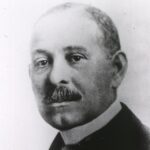 African American surgeon Dr. Daniel Hale Williams performs the first documented, successful heart surgery. The patient had been stabbed the night before and Dr. Williams decided to operate in response to continued bleeding, cough and "pronounced" symptoms of shock. He performed the surgery without the benefit of penicillin or blood transfusion, at Provident Hospital, Chicago. He undertook a second procedure to drain fluid. About fifty days after the initial procedure, Cornish left the hospital and survived another 20 years. Dr. Williams had founded Provident Hospital, the first non-segregated hospital in the United States and also founded an associated nursing school for African Americans. In 1913, Williams was elected as the only African-American charter member of the American College of Surgeons. Learn more. African American surgeon Dr. Daniel Hale Williams performs the first documented, successful heart surgery. The patient had been stabbed the night before and Dr. Williams decided to operate in response to continued bleeding, cough and "pronounced" symptoms of shock. He performed the surgery without the benefit of penicillin or blood transfusion, at Provident Hospital, Chicago. He undertook a second procedure to drain fluid. About fifty days after the initial procedure, Cornish left the hospital and survived another 20 years. Dr. Williams had founded Provident Hospital, the first non-segregated hospital in the United States and also founded an associated nursing school for African Americans. In 1913, Williams was elected as the only African-American charter member of the American College of Surgeons. Learn more. | |
| July 10, 1943 |  American professional tennis player Arthur Ashe Jr., the first Black player selected to the United States Davis Cup team and the first Black man to win the singles title at Wimbledon, the US Open, and the Australian Open, is born. Learn more. American professional tennis player Arthur Ashe Jr., the first Black player selected to the United States Davis Cup team and the first Black man to win the singles title at Wimbledon, the US Open, and the Australian Open, is born. Learn more. | |
| July 10, 1966 | 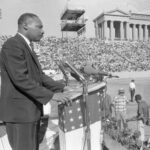 The Chicago Freedom Movement, also known as the Chicago Open Housing Movement, holds a rally at Soldier Field in Chicago. As many as 60,000 people attend. Co-founded and led by Martin Luther King Jr., James Bevel, and Al Raby. the Chicago Freedom Movement was supported by the Chicago based Coordinating Council of Community Organizations (CCCO) and the Southern Christian Leadership Conference (SCLC). The movement issued demands to the City of Chicago in regard to open housing, quality education, transportation and job access, income and employment, health, wealth generation, crime and the criminal justice system, community development, tenants rights, and quality of life. Operation Breadbasket in part led by Jesse Jackson sought to harness African-American consumer power. The Chicago Freedom Movement was the most ambitious civil rights campaign in the North of the United States, lasted from mid-1965 to August 1966, and is largely credited with inspiring the 1968 Fair Housing Act. Learn more. The Chicago Freedom Movement, also known as the Chicago Open Housing Movement, holds a rally at Soldier Field in Chicago. As many as 60,000 people attend. Co-founded and led by Martin Luther King Jr., James Bevel, and Al Raby. the Chicago Freedom Movement was supported by the Chicago based Coordinating Council of Community Organizations (CCCO) and the Southern Christian Leadership Conference (SCLC). The movement issued demands to the City of Chicago in regard to open housing, quality education, transportation and job access, income and employment, health, wealth generation, crime and the criminal justice system, community development, tenants rights, and quality of life. Operation Breadbasket in part led by Jesse Jackson sought to harness African-American consumer power. The Chicago Freedom Movement was the most ambitious civil rights campaign in the North of the United States, lasted from mid-1965 to August 1966, and is largely credited with inspiring the 1968 Fair Housing Act. Learn more. | |
| July 11, 1905 | 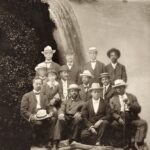 The Niagara Movement civil rights group is organized by W.E.B. Du Bois, William Monroe Trotter, and a group of twenty-nine business owners, teachers, and clergy who gather at Niagara Falls, Ontario (Canada (from which the group’s name derives). The principles behind the Niagara Movement were largely in opposition to Booker T. Washington’s philosophy of Accommodationism. Trotter, editor of the Boston Guardian, had publicly reprimanded Washington at a Boston, Massachusetts meeting in 1903. In The Souls of Black Folk(1903), Du Bois had also condemned Washington for his lowered expectations for African Americans. The Niagara Movement drafted a “Declaration of Principles,” part of which stated: “We refuse to allow the impression to remain that the Negro-American assents to inferiority, is submissive under oppression and apologetic before insults.” The Niagara Movement attempted to bring about legal change, addressing the issues of crime, economics, religion, health, and education. The movement stood apart from other black organizations at the time because of its powerful, unequivocal demand for equal rights. The Niagara Movement forcefully demanded equal economic and educational opportunity as well as the vote for black men and women. Members of the Niagara Movement sent a powerful message to the entire country through their condemnation of racial discrimination and their call for an end to segregation. In the aftermath of 1908 Springfield, Illinois race riot, Black and white activists, including members of the Niagara Movement, felt a new more powerful, interracial organization was needed to combat racism and formed the National Association for the Advancement of Colored People (NAACP). The Niagara Movement was considered the precursor to the NAACP and many of its members, such as W.E.B. Du Bois, were among the new organization’s founders. Learn more. The Niagara Movement civil rights group is organized by W.E.B. Du Bois, William Monroe Trotter, and a group of twenty-nine business owners, teachers, and clergy who gather at Niagara Falls, Ontario (Canada (from which the group’s name derives). The principles behind the Niagara Movement were largely in opposition to Booker T. Washington’s philosophy of Accommodationism. Trotter, editor of the Boston Guardian, had publicly reprimanded Washington at a Boston, Massachusetts meeting in 1903. In The Souls of Black Folk(1903), Du Bois had also condemned Washington for his lowered expectations for African Americans. The Niagara Movement drafted a “Declaration of Principles,” part of which stated: “We refuse to allow the impression to remain that the Negro-American assents to inferiority, is submissive under oppression and apologetic before insults.” The Niagara Movement attempted to bring about legal change, addressing the issues of crime, economics, religion, health, and education. The movement stood apart from other black organizations at the time because of its powerful, unequivocal demand for equal rights. The Niagara Movement forcefully demanded equal economic and educational opportunity as well as the vote for black men and women. Members of the Niagara Movement sent a powerful message to the entire country through their condemnation of racial discrimination and their call for an end to segregation. In the aftermath of 1908 Springfield, Illinois race riot, Black and white activists, including members of the Niagara Movement, felt a new more powerful, interracial organization was needed to combat racism and formed the National Association for the Advancement of Colored People (NAACP). The Niagara Movement was considered the precursor to the NAACP and many of its members, such as W.E.B. Du Bois, were among the new organization’s founders. Learn more. | |
| July 11, 1925 | 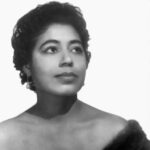 American coloratura soprano Mattiwilda Dobbs is born. Ms.Dobbs was one of the first Black singers to enjoy a major international career in opera. She was the first Black singer to perform at La Scala in Italy, the first Black woman to receive a long-term performance contract and to sing a lead role at the Metropolitan Opera, New York and the first Black singer to play a lead role at the San Francisco Opera. Learn more. American coloratura soprano Mattiwilda Dobbs is born. Ms.Dobbs was one of the first Black singers to enjoy a major international career in opera. She was the first Black singer to perform at La Scala in Italy, the first Black woman to receive a long-term performance contract and to sing a lead role at the Metropolitan Opera, New York and the first Black singer to play a lead role at the San Francisco Opera. Learn more. | |
| July 11, 1954 | 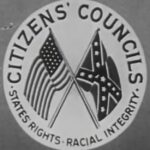 A large group of local white men and women gather at the Town Hall in Indianola, Mississippi, and form the first White Citizens’ Council to organize and carry out massive resistance to racial integration of public schools mandated by the Supreme Court in Brown v. Board of Education. One year later, 250 White Citizens’ Councils had been launched throughout the South, boasting a total of 60,000 members; by 1956, active Councils were operating in 30 states, and by 1957, membership reached 250,000. Robert Patterson, the organizer of that first formation meeting, wrote in 1956, “Integration represents darkness, regimentation, totalitarianism, communism and destruction … . Segregation represents the freedom to choose one’s associates, Americanism, State sovereignty and the survival of the white race. These two ideologies are now engaged in mortal conflict and only one can survive.” The Councils’ membership of business, religious, and civic leaders defended white supremacy and used social pressure and economic retaliation to intimidate and coerce Black and white people who supported integration. The massive resistance by the white community was largely successful in preventing the integration of schools in the South. In 1967, 13 years after Brown, a report by the U.S. Commission on Civil Rights observed that white violence and intimidation against Black people “continues to be a deterrent to school desegregation.” Learn more. A large group of local white men and women gather at the Town Hall in Indianola, Mississippi, and form the first White Citizens’ Council to organize and carry out massive resistance to racial integration of public schools mandated by the Supreme Court in Brown v. Board of Education. One year later, 250 White Citizens’ Councils had been launched throughout the South, boasting a total of 60,000 members; by 1956, active Councils were operating in 30 states, and by 1957, membership reached 250,000. Robert Patterson, the organizer of that first formation meeting, wrote in 1956, “Integration represents darkness, regimentation, totalitarianism, communism and destruction … . Segregation represents the freedom to choose one’s associates, Americanism, State sovereignty and the survival of the white race. These two ideologies are now engaged in mortal conflict and only one can survive.” The Councils’ membership of business, religious, and civic leaders defended white supremacy and used social pressure and economic retaliation to intimidate and coerce Black and white people who supported integration. The massive resistance by the white community was largely successful in preventing the integration of schools in the South. In 1967, 13 years after Brown, a report by the U.S. Commission on Civil Rights observed that white violence and intimidation against Black people “continues to be a deterrent to school desegregation.” Learn more. | |
| July 11, 2000 |  Journalist and clergywoman Vashti Murphy McKenzie becomes the first female bishop of the African Methodist Episcopal (AME) Church. Bishop McKenzie graduated with a degree in journalism from the University of Maryland in 1978. She later earned a master’s of divinity from Howard University and a doctor of ministry from United Theological Seminary. In 2005 she became the first woman to serve as Titular Head of the AME Church, overseeing the Council of Bishops as its president. She currently presides over the 13th Episcopal District. Her commitment to community development is evident in her work with urban American cities as well as in AIDS-stricken Africa. Bishop McKenzie is the author of three books and is married to Stan McKenzie, a former professional basketball player who now works alongside of his wife as Episcopal Supervisor in her district. They have three children. Learn more. Journalist and clergywoman Vashti Murphy McKenzie becomes the first female bishop of the African Methodist Episcopal (AME) Church. Bishop McKenzie graduated with a degree in journalism from the University of Maryland in 1978. She later earned a master’s of divinity from Howard University and a doctor of ministry from United Theological Seminary. In 2005 she became the first woman to serve as Titular Head of the AME Church, overseeing the Council of Bishops as its president. She currently presides over the 13th Episcopal District. Her commitment to community development is evident in her work with urban American cities as well as in AIDS-stricken Africa. Bishop McKenzie is the author of three books and is married to Stan McKenzie, a former professional basketball player who now works alongside of his wife as Episcopal Supervisor in her district. They have three children. Learn more. | |
| July 12, 1887 |  Mound Bayou, a city in Bolivar County, Mississippi, United States, is founded in wilderness by formerly enslaved African Americans led by Isaiah Montgomery. The bottomlands of the Delta were a relatively undeveloped frontier, and Blacks had a chance to make money by clearing land and use the profits to buy lands in such frontier areas. By 1900 two-thirds of the owners of land in the bottomlands were Black farmers. With the loss of political power due to state disenfranchisement, high debt and continuing agricultural problems, most of them lost their land and by 1920 were landless sharecroppers. As cotton prices fell, the town suffered a severe economic decline in the 1920s and 1930s. Shortly after a fire destroyed much of the business district, Mound Bayou began to revive in 1942 after the opening of the Taborian Hospital by the International Order of Twelve Knights and Daughters of Tabor, a fraternal organization. For more than two decades, under its Chief Grand Mentor Perry M. Smith, the hospital provided low-cost health care to thousands of blacks in the Mississippi Delta. The chief surgeon was Dr. T.R.M. Howard, who eventually became one of the wealthiest black men in the state. Howard owned a plantation of more than 1,000 acres (4.0 km2), a home-construction firm, and a small zoo, and he built the first swimming pool for blacks in Mississippi. In 1952, Medgar Evers moved to Mound Bayou to sell insurance for Howard's Magnolia Mutual Life Insurance Company. Howard introduced Evers to civil rights activism through the Regional Council of Negro Leadership which organized a boycott against service stations that refused to provide restrooms for blacks. The RCNL's annual rallies in Mound Bayou between 1952 and 1955 drew crowds of ten thousand or more. During the trial of Emmett Till's killers, black reporters and witnesses stayed in Howard's Mound Bayou home, and Howard gave them an armed escort to the courthouse in Sumner. Learn more. Mound Bayou, a city in Bolivar County, Mississippi, United States, is founded in wilderness by formerly enslaved African Americans led by Isaiah Montgomery. The bottomlands of the Delta were a relatively undeveloped frontier, and Blacks had a chance to make money by clearing land and use the profits to buy lands in such frontier areas. By 1900 two-thirds of the owners of land in the bottomlands were Black farmers. With the loss of political power due to state disenfranchisement, high debt and continuing agricultural problems, most of them lost their land and by 1920 were landless sharecroppers. As cotton prices fell, the town suffered a severe economic decline in the 1920s and 1930s. Shortly after a fire destroyed much of the business district, Mound Bayou began to revive in 1942 after the opening of the Taborian Hospital by the International Order of Twelve Knights and Daughters of Tabor, a fraternal organization. For more than two decades, under its Chief Grand Mentor Perry M. Smith, the hospital provided low-cost health care to thousands of blacks in the Mississippi Delta. The chief surgeon was Dr. T.R.M. Howard, who eventually became one of the wealthiest black men in the state. Howard owned a plantation of more than 1,000 acres (4.0 km2), a home-construction firm, and a small zoo, and he built the first swimming pool for blacks in Mississippi. In 1952, Medgar Evers moved to Mound Bayou to sell insurance for Howard's Magnolia Mutual Life Insurance Company. Howard introduced Evers to civil rights activism through the Regional Council of Negro Leadership which organized a boycott against service stations that refused to provide restrooms for blacks. The RCNL's annual rallies in Mound Bayou between 1952 and 1955 drew crowds of ten thousand or more. During the trial of Emmett Till's killers, black reporters and witnesses stayed in Howard's Mound Bayou home, and Howard gave them an armed escort to the courthouse in Sumner. Learn more. | |
| July 12, 1898 | 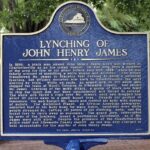 A falsely-accused Black man named John Henry James is killed in a public spectacle lynching in Albemarle County, Virginia, near Charlottesville. Although at least 150 unmasked white men were involved in the lynching—and the police chief and county sheriff were present when Mr. James was lynched—no one was ever held accountable for Mr. James’s killing. The mob dragged Mr. James off a train, 40 yards to a locust tree from which he was hung and then shot several times, and his body left hanging. Newspapers reported that Mr. James’s lynching was later celebrated by several hundred more white people who gathered to see his body and cut off pieces of his clothing, his body, and the locust tree as “souvenirs.” These acts not only victimized the individual, but traumatized and terrorized the wider Black community near and around Charlottesville; Mr. James’s proximity to the railroad tracks meant that hundreds more viewed his body from the passing train cars. Learn more. A falsely-accused Black man named John Henry James is killed in a public spectacle lynching in Albemarle County, Virginia, near Charlottesville. Although at least 150 unmasked white men were involved in the lynching—and the police chief and county sheriff were present when Mr. James was lynched—no one was ever held accountable for Mr. James’s killing. The mob dragged Mr. James off a train, 40 yards to a locust tree from which he was hung and then shot several times, and his body left hanging. Newspapers reported that Mr. James’s lynching was later celebrated by several hundred more white people who gathered to see his body and cut off pieces of his clothing, his body, and the locust tree as “souvenirs.” These acts not only victimized the individual, but traumatized and terrorized the wider Black community near and around Charlottesville; Mr. James’s proximity to the railroad tracks meant that hundreds more viewed his body from the passing train cars. Learn more. | |
| July 12, 1917 | 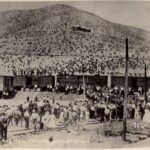 The Bisbee Deportation — the illegal kidnapping and deportation of about 1,300 striking mine workers, their supporters, and citizen bystanders by 2,000 members of a deputized posse — begins in Bisbee, Arizona. The action was orchestrated by mining company Phelps Dodge, which provided lists of workers and others who were to be arrested to the Cochise County sheriff, Harry C. Wheeler. Those arrested were taken to a local baseball park before being loaded onto cattle cars and deported 200 miles (320 km) to Tres Hermanas in New Mexico. The 16-hour journey was through desert without food and with little water. Once unloaded, the deportees, most without money or transportation, were warned against returning to Bisbee. The US government soon brought in the US Army to assist with relocating the deportees to Columbus, New Mexico. The Governor of New Mexico, in consultation with President Woodrow Wilson, provided temporary housing for the deportees. A presidential mediation commission investigated the actions in November 1917, and in its final report, described the deportation as "wholly illegal and without authority in law, either State or Federal." Nevertheless, no individual, company, or agency was ever convicted in connection with the deportations. Arizona and Cochise County never prosecuted the case, and in United States v. Wheeler (1920), the Supreme Court ruled that the Constitution by itself does not give the federal government the power to stop kidnappings, even ones involving moving abductees across state lines on federally-regulated railroads. Learn more. The Bisbee Deportation — the illegal kidnapping and deportation of about 1,300 striking mine workers, their supporters, and citizen bystanders by 2,000 members of a deputized posse — begins in Bisbee, Arizona. The action was orchestrated by mining company Phelps Dodge, which provided lists of workers and others who were to be arrested to the Cochise County sheriff, Harry C. Wheeler. Those arrested were taken to a local baseball park before being loaded onto cattle cars and deported 200 miles (320 km) to Tres Hermanas in New Mexico. The 16-hour journey was through desert without food and with little water. Once unloaded, the deportees, most without money or transportation, were warned against returning to Bisbee. The US government soon brought in the US Army to assist with relocating the deportees to Columbus, New Mexico. The Governor of New Mexico, in consultation with President Woodrow Wilson, provided temporary housing for the deportees. A presidential mediation commission investigated the actions in November 1917, and in its final report, described the deportation as "wholly illegal and without authority in law, either State or Federal." Nevertheless, no individual, company, or agency was ever convicted in connection with the deportations. Arizona and Cochise County never prosecuted the case, and in United States v. Wheeler (1920), the Supreme Court ruled that the Constitution by itself does not give the federal government the power to stop kidnappings, even ones involving moving abductees across state lines on federally-regulated railroads. Learn more. | |
| July 12, 1967 | 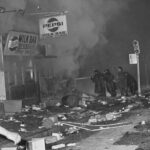 The 1967 Newark riot, one of 159 race riots that swept cities in the United States during the "Long Hot Summer of 1967", begins. Over the four days of rioting, looting, and property destruction, 26 people died and hundreds were injured. Learn more. The 1967 Newark riot, one of 159 race riots that swept cities in the United States during the "Long Hot Summer of 1967", begins. Over the four days of rioting, looting, and property destruction, 26 people died and hundreds were injured. Learn more. | |
| July 13, 1821 | 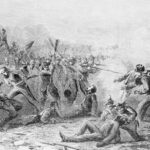 Nathan Bedford Forrest, the Confederate cavalry commander responsible for the April 1864 massacre of African American Union troops stationed at Fort Pillow, Tennessee, during the Civil War, a post-war manager of a convict labor plantation, and the first grand wizard of the Ku Klux Klan, is born. Revered by white supremacists, statues of him and numerous public buildings, parks, and schools bearing his name proliferated across the South. It was only in the latter half of the second decade of the twenty-first century that some of the statues began to be removed and some venues renamed. Learn more. Nathan Bedford Forrest, the Confederate cavalry commander responsible for the April 1864 massacre of African American Union troops stationed at Fort Pillow, Tennessee, during the Civil War, a post-war manager of a convict labor plantation, and the first grand wizard of the Ku Klux Klan, is born. Revered by white supremacists, statues of him and numerous public buildings, parks, and schools bearing his name proliferated across the South. It was only in the latter half of the second decade of the twenty-first century that some of the statues began to be removed and some venues renamed. Learn more. | |
| July 13, 1863 | 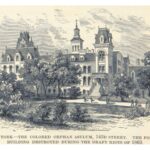 The Colored Orphan Asylum at 44th Street and Fifth Avenue in Manhattan is burned to the ground by white mobs at the start of the New York City Draft Riots, the largest civil and most racially charged urban disturbance in American history; the riots will continue for four days. The rioters were overwhelmingly white working-class men, many of them Irish immigrants, who feared free Black people competing for work and resented the ongoing Civil War military draft. The white rioters attacked Black people in violence throughout the city. The official death toll was listed at either 119 or 120 individuals. In addition to comoletely destroying the Colored Orphan Asylum, the mobs ransacked or destroyed numerous public buildings, two Protestant churches, the homes of various abolitionists or sympathizers, and many Black homes. Large numbers of Black residents subsequently left Manhattan permanently, with many moving to Brooklyn. By 1865, the Black population had fallen below 11,000 for the first time since 1820. Upon learning of the riots, U.S. President Abraham Lincoln diverted several regiments of militia and volunteer troops after the Battle of Gettysburg to control the city. The military did not reach the city until the second day of rioting, by which time much of the destruction and killing had already occurred. Learn more. The Colored Orphan Asylum at 44th Street and Fifth Avenue in Manhattan is burned to the ground by white mobs at the start of the New York City Draft Riots, the largest civil and most racially charged urban disturbance in American history; the riots will continue for four days. The rioters were overwhelmingly white working-class men, many of them Irish immigrants, who feared free Black people competing for work and resented the ongoing Civil War military draft. The white rioters attacked Black people in violence throughout the city. The official death toll was listed at either 119 or 120 individuals. In addition to comoletely destroying the Colored Orphan Asylum, the mobs ransacked or destroyed numerous public buildings, two Protestant churches, the homes of various abolitionists or sympathizers, and many Black homes. Large numbers of Black residents subsequently left Manhattan permanently, with many moving to Brooklyn. By 1865, the Black population had fallen below 11,000 for the first time since 1820. Upon learning of the riots, U.S. President Abraham Lincoln diverted several regiments of militia and volunteer troops after the Battle of Gettysburg to control the city. The military did not reach the city until the second day of rioting, by which time much of the destruction and killing had already occurred. Learn more. | |
| July 13, 1919 | 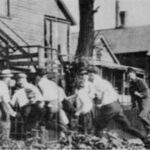 Just one of dozens of white supremacist mass terror actions across the United States during the “Red Summer” of 1919, the Longview, Texas race riot begins when an armed white mob attacks and attempts to batter into the home where S.L. Jones, a reporter for The Chicago Defender, was staying. Jones was in Longview looking into the mysterious death of a Black man named Lemuel Walters. A gunfight ensured between the attackers and the men in the house. Eventually, Jones made a getaway. The white men then began to burn buildings in the Black section of the town. “Red Summer” refers to the period from late winter through early autumn of 1919 during which white supremacist terrorism took place in more than three dozen cities across the United States, as well as in at least one rural county. The highest number of fatalities in a single incident occurred in the rural area around Elaine, Arkansas, where an estimated 100–240 black people and five white people were killed—an event now known as the Elaine Massacre. The Red Summer anti-Black riots occurred in the aftermath of World War I as both Black and white members of the United States Armed Forces demobilized amid an economic slump and increased competition in the jobs and housing markets. Learn more. Just one of dozens of white supremacist mass terror actions across the United States during the “Red Summer” of 1919, the Longview, Texas race riot begins when an armed white mob attacks and attempts to batter into the home where S.L. Jones, a reporter for The Chicago Defender, was staying. Jones was in Longview looking into the mysterious death of a Black man named Lemuel Walters. A gunfight ensured between the attackers and the men in the house. Eventually, Jones made a getaway. The white men then began to burn buildings in the Black section of the town. “Red Summer” refers to the period from late winter through early autumn of 1919 during which white supremacist terrorism took place in more than three dozen cities across the United States, as well as in at least one rural county. The highest number of fatalities in a single incident occurred in the rural area around Elaine, Arkansas, where an estimated 100–240 black people and five white people were killed—an event now known as the Elaine Massacre. The Red Summer anti-Black riots occurred in the aftermath of World War I as both Black and white members of the United States Armed Forces demobilized amid an economic slump and increased competition in the jobs and housing markets. Learn more. | |
| July 13, 1929 | 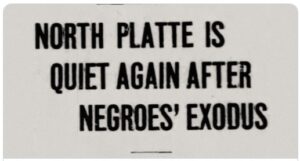 After a Black man shot and killed a local white police officer, a mob of 500 angry white men targeted the entire Black community of North Platte, Nebraska, demanding that all Blacks immediately leave the city. Terrorized and facing the threat of deadly violence, North Platte’s 200 Black residents permanently departed that night by foot, train, and automobile, leaving behind most of their possessions. A county sheriff later commented, “It was the understanding when they left that they were to stay away. The idea is to keep them out.” Learn more. After a Black man shot and killed a local white police officer, a mob of 500 angry white men targeted the entire Black community of North Platte, Nebraska, demanding that all Blacks immediately leave the city. Terrorized and facing the threat of deadly violence, North Platte’s 200 Black residents permanently departed that night by foot, train, and automobile, leaving behind most of their possessions. A county sheriff later commented, “It was the understanding when they left that they were to stay away. The idea is to keep them out.” Learn more. | |
| July 13, 1936 | 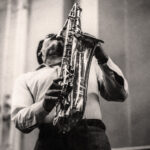 Avant-garde jazz saxophonist, singer and composer Albert Ayler is born. Ayler's style was undeniably original and unorthodox, and his innovations inspired subsequent jazz musicians. His ecstatic music of 1965 and 1966, such as "Spirits Rejoice" and "Truth Is Marching In", has been compared by critics to the sound of a brass band, and involved simple, march-like themes which alternated with wild group improvisations and were regarded as retrieving jazz's pre-Louis Armstrong roots. Learn more. Avant-garde jazz saxophonist, singer and composer Albert Ayler is born. Ayler's style was undeniably original and unorthodox, and his innovations inspired subsequent jazz musicians. His ecstatic music of 1965 and 1966, such as "Spirits Rejoice" and "Truth Is Marching In", has been compared by critics to the sound of a brass band, and involved simple, march-like themes which alternated with wild group improvisations and were regarded as retrieving jazz's pre-Louis Armstrong roots. Learn more. | |
| July 14, 1885 | 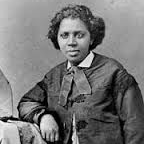 Sarah Elisabeth Goode receives US patent # 322,177 for her invention of the Cabinet Bed, becoming the second known African-American woman to receive a United States patent. A folding bed that was a precursor to the Murphy Bed, the Cabinet Bed folded into a roll-top desk which had compartments for writing supplies and stationary. Learn more. Sarah Elisabeth Goode receives US patent # 322,177 for her invention of the Cabinet Bed, becoming the second known African-American woman to receive a United States patent. A folding bed that was a precursor to the Murphy Bed, the Cabinet Bed folded into a roll-top desk which had compartments for writing supplies and stationary. Learn more. | |
| July 14, 1891 | 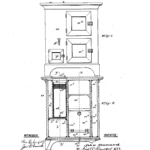 John Stanard, a Black inventor from Newark, New Jersey, patents improvements to the refrigerator; a non-electrical and unpowered design, Stanard's refrigerator uses a manually-filled ice chamber for chilling. In his lifetime he also patented improvements to the oil stove. Overcoming racial segregation in the United States at the time, Stanard revolutionized the modern kitchen. Learn more. John Stanard, a Black inventor from Newark, New Jersey, patents improvements to the refrigerator; a non-electrical and unpowered design, Stanard's refrigerator uses a manually-filled ice chamber for chilling. In his lifetime he also patented improvements to the oil stove. Overcoming racial segregation in the United States at the time, Stanard revolutionized the modern kitchen. Learn more. | |
| July 14, 1941 | 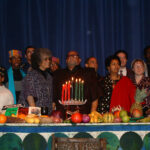 American professor of Africana studies, activist, and author best known as the creator of the pan-African and the African-American holiday of Kwanzaa, Maulana Ndabezitha Karenga (born Ronald McKinley Everett, previously known as Ron Karenga) is born in Parsonsburg, Maryland. Karenga studied at Los Angeles City College and the University of California, Los Angeles. He was active in the Black Power movement of the 1960s and 1970s, joining the Congress of Racial Equality and Student Nonviolent Coordinating Committee. Modeling the holiday after the African "first fruit" traditions, Karenga created Kwanzaa in 1966. The rituals of the holiday promote African traditions, including the "seven principles of African heritage". Karenga holds doctorates in Political Science (1976) and Social Ethics (1994). He chairs the Africana Studies Department at California State University, Long Beach and is the author of several books. Learn more. American professor of Africana studies, activist, and author best known as the creator of the pan-African and the African-American holiday of Kwanzaa, Maulana Ndabezitha Karenga (born Ronald McKinley Everett, previously known as Ron Karenga) is born in Parsonsburg, Maryland. Karenga studied at Los Angeles City College and the University of California, Los Angeles. He was active in the Black Power movement of the 1960s and 1970s, joining the Congress of Racial Equality and Student Nonviolent Coordinating Committee. Modeling the holiday after the African "first fruit" traditions, Karenga created Kwanzaa in 1966. The rituals of the holiday promote African traditions, including the "seven principles of African heritage". Karenga holds doctorates in Political Science (1976) and Social Ethics (1994). He chairs the Africana Studies Department at California State University, Long Beach and is the author of several books. Learn more. | |
| July 14, 1959 | 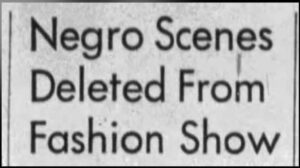 A New York committee organizing a fashion show for the American National Exhibition in Moscow, Russia, announces it will remove three scenes that featured Black and white models together after dozens of fashion editors sign and circulate a petition claiming the scenes are not “representative of the American way of life.” With those scenes cut, only the 3 Black models were eliminated from the show. During this era, many white Americans throughout the U.S., including in Northern states like New York, openly supported and fought efor racial segregation. As this event helps to illustrate, many white people considered even socializing between races to be fundamentally incompatible with American life. Learn more. A New York committee organizing a fashion show for the American National Exhibition in Moscow, Russia, announces it will remove three scenes that featured Black and white models together after dozens of fashion editors sign and circulate a petition claiming the scenes are not “representative of the American way of life.” With those scenes cut, only the 3 Black models were eliminated from the show. During this era, many white Americans throughout the U.S., including in Northern states like New York, openly supported and fought efor racial segregation. As this event helps to illustrate, many white people considered even socializing between races to be fundamentally incompatible with American life. Learn more. | |
| July 15, 1782 | 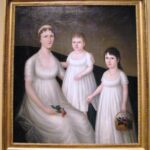 Joshua Johnston, also known as Joshua Johnson, a portraitist active in Baltimore, Maryland between 1790 and 1825, and the first African American to gain recognition as an artist, is freed from enslavement. Primarily a painter of members of the slave-holding aristocracy, he was rediscovered by Baltimore genealogist and art historian J. Hall Pleasants in 1939. Learn more. Joshua Johnston, also known as Joshua Johnson, a portraitist active in Baltimore, Maryland between 1790 and 1825, and the first African American to gain recognition as an artist, is freed from enslavement. Primarily a painter of members of the slave-holding aristocracy, he was rediscovered by Baltimore genealogist and art historian J. Hall Pleasants in 1939. Learn more. | |
| July 15, 1897 | 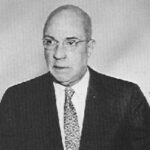 Prominent African-American businessman, Harvard Business School MBA graduate, philanthropist, member of Alpha Phi Alpha Fraternity, Inc., and second President of the historic African-American-owned Atlanta Life Insurance Company, Norris Bumstead Herndon is born. Under Herndon's leadership the Atlanta Life Insurance Company grew from $1 million in 1927, to $84 million in assets at the time of his retirement in 1973. Learn more. Prominent African-American businessman, Harvard Business School MBA graduate, philanthropist, member of Alpha Phi Alpha Fraternity, Inc., and second President of the historic African-American-owned Atlanta Life Insurance Company, Norris Bumstead Herndon is born. Under Herndon's leadership the Atlanta Life Insurance Company grew from $1 million in 1927, to $84 million in assets at the time of his retirement in 1973. Learn more. | |
| July 15, 1942 | 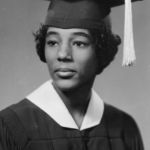 Civil rights activist and icon Vivian Juanita Malone Jones is born. She was one of the first two Black students to enroll at the University of Alabama in 1963, and in 1965 became the university's first Black graduate. She was made famous when George Wallace, the Governor of Alabama, attempted to block her and James Hood from enrolling at the all-white university. In 2000, Jones gave the commencement address at the University of Alabama, and the university bestowed on her a doctorate of humane letters. Learn more. Civil rights activist and icon Vivian Juanita Malone Jones is born. She was one of the first two Black students to enroll at the University of Alabama in 1963, and in 1965 became the university's first Black graduate. She was made famous when George Wallace, the Governor of Alabama, attempted to block her and James Hood from enrolling at the all-white university. In 2000, Jones gave the commencement address at the University of Alabama, and the university bestowed on her a doctorate of humane letters. Learn more. | |
| July 15, 1954 | 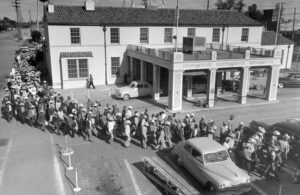 At the direction of U.S. Attorney General Herbert Brownell and under the supervision of Immigration and Naturalization Service (INS) Commissioner Joseph Swing, the U.S. Border Patrol began an immigration law enforcement initiative in the lower Rio Grande Valley of Texas. The program, officially known as “Operation Wetback,” employed the pejorative term used to derisively refer to Mexican citizens who entered the U.S. by swimming across the Rio Grande River. INS deployed hundreds of agents to the Rio Grande Valley to locate and deport to Mexico anyone they suspected of being in the U.S. without legal status. The following September, INS initiated a similar operation in the Midwest. Without a hearing or oversight, agents often seized and deported people who were lawfully in the country. By the end of 1954, according to some reports, INS had deported one million Mexican immigrants nationwide, including many who were citizens or documented residents of the United States. Learn more. At the direction of U.S. Attorney General Herbert Brownell and under the supervision of Immigration and Naturalization Service (INS) Commissioner Joseph Swing, the U.S. Border Patrol began an immigration law enforcement initiative in the lower Rio Grande Valley of Texas. The program, officially known as “Operation Wetback,” employed the pejorative term used to derisively refer to Mexican citizens who entered the U.S. by swimming across the Rio Grande River. INS deployed hundreds of agents to the Rio Grande Valley to locate and deport to Mexico anyone they suspected of being in the U.S. without legal status. The following September, INS initiated a similar operation in the Midwest. Without a hearing or oversight, agents often seized and deported people who were lawfully in the country. By the end of 1954, according to some reports, INS had deported one million Mexican immigrants nationwide, including many who were citizens or documented residents of the United States. Learn more. | |
| July 16, 1862 |  Ida Bell Wells-Barnett, an investigative journalist, educator, early leader in the civil rights movement, and a co-founder of the National Association for the Advancement of Colored People (NAACP), is born into slavery in Holly Springs, Mississippi. Freed by the Emancipation Proclamation during the American Civil War, Wells later co-owned and wrote for the Memphis Free Speech and Headlight newspaper, reporting on incidents of racial segregation and inequality. In articles and through her pamphlet called Southern Horrors: Lynch Law in all its Phases, Wells documented and exposed lynching as a barbaric practice that South whites used to intimidate and oppress African Americans. In response, a white mob destroyed her newspaper office and presses. Subjected to continued threats, Wells left Memphis for Chicago. She married Ferdinand L. Barnett in 1895 and had a family while continuing her work writing, speaking, and organizing for civil rights and the women's movement for the rest of her life. A skilled and persuasive speaker, Wells was outspoken regarding her beliefs as a Black female activist and faced regular public disapproval, sometimes including from other leaders within the civil rights movement and the women's suffrage movement. She established several notable women's organizations. Over the course of a lifetime dedicated to combating prejudice and violence, and the fight for African-American equality, especially that of women, Wells arguably became the most famous Black woman in America. Learn more. Ida Bell Wells-Barnett, an investigative journalist, educator, early leader in the civil rights movement, and a co-founder of the National Association for the Advancement of Colored People (NAACP), is born into slavery in Holly Springs, Mississippi. Freed by the Emancipation Proclamation during the American Civil War, Wells later co-owned and wrote for the Memphis Free Speech and Headlight newspaper, reporting on incidents of racial segregation and inequality. In articles and through her pamphlet called Southern Horrors: Lynch Law in all its Phases, Wells documented and exposed lynching as a barbaric practice that South whites used to intimidate and oppress African Americans. In response, a white mob destroyed her newspaper office and presses. Subjected to continued threats, Wells left Memphis for Chicago. She married Ferdinand L. Barnett in 1895 and had a family while continuing her work writing, speaking, and organizing for civil rights and the women's movement for the rest of her life. A skilled and persuasive speaker, Wells was outspoken regarding her beliefs as a Black female activist and faced regular public disapproval, sometimes including from other leaders within the civil rights movement and the women's suffrage movement. She established several notable women's organizations. Over the course of a lifetime dedicated to combating prejudice and violence, and the fight for African-American equality, especially that of women, Wells arguably became the most famous Black woman in America. Learn more. | |
| July 16, 1882 | 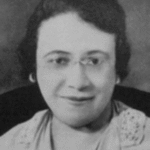 Violette Neatley Anderson, the first African-American woman to practice law before the United States Supreme Court (on January 29, 1926) and one of the most prominent advocates of the landmark Bankhead-Jones Act that helped secure rights and economic mobility for sharecroppers in the South, is born in London, England, in 1882, to a German mother and a West Indian father. She moved to Chicago with her family as a small child. Learn more. Violette Neatley Anderson, the first African-American woman to practice law before the United States Supreme Court (on January 29, 1926) and one of the most prominent advocates of the landmark Bankhead-Jones Act that helped secure rights and economic mobility for sharecroppers in the South, is born in London, England, in 1882, to a German mother and a West Indian father. She moved to Chicago with her family as a small child. Learn more. | |
| July 16, 1936 | 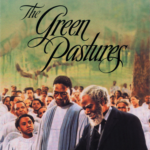 The Green Pastures, an American film depicting stories from the Bible as visualized by Black characters, premieres at New York City’s Radio City Music Hall. It starred Rex Ingram (in several roles, including "De Lawd"), Oscar Polk, and Eddie "Rochester" Anderson. It was based on the 1928 novel Ol' Man Adam an' His Chillun by Roark Bradford and the 1930 Pulitzer Prize-winning play of the same name by Marc Connelly. The Green Pastures was one of only six feature films in the Hollywood Studio era to feature an all-Black cast, though elements of it were criticized by civil rights activists at the time and subsequently. Despite criticisms about its racial stereotyping, The Green Pastures proved to be an enormously popular film. On its opening day at New York's Radio City Music Hall, tickets sold at a rate of 6,000 per hour. The film was held over for an entire year's run at some theaters. It remained the highest-grossing all-Black-cast film until the release of Carmen Jones in 1954. Learn more. The Green Pastures, an American film depicting stories from the Bible as visualized by Black characters, premieres at New York City’s Radio City Music Hall. It starred Rex Ingram (in several roles, including "De Lawd"), Oscar Polk, and Eddie "Rochester" Anderson. It was based on the 1928 novel Ol' Man Adam an' His Chillun by Roark Bradford and the 1930 Pulitzer Prize-winning play of the same name by Marc Connelly. The Green Pastures was one of only six feature films in the Hollywood Studio era to feature an all-Black cast, though elements of it were criticized by civil rights activists at the time and subsequently. Despite criticisms about its racial stereotyping, The Green Pastures proved to be an enormously popular film. On its opening day at New York's Radio City Music Hall, tickets sold at a rate of 6,000 per hour. The film was held over for an entire year's run at some theaters. It remained the highest-grossing all-Black-cast film until the release of Carmen Jones in 1954. Learn more. | |
| July 16, 1944 | 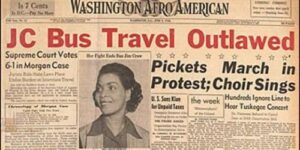 Irene Morgan, a 27-year-old Black woman, traveling by bus from Gloucester, Virginia to Baltimore, Maryland is arrested in Virginia for refusing to give up her seat for a white passenger. Under Virginia law at that time, racial segregation was mandatory on state-sponsored transportation. Ms. Morgan insisted that her presence on an interstate bus meant that Virginia law did not apply. Police physically dragged the young Black woman from the bus, held her in the Saluda City Jail, and convicted her of violating the state segregation law. Ms. Morgan appealed and two years later the United States Supreme Court reversed the conviction and held that state segregation laws were unconstitutional as applied to interstate bus travel. Learn more. Irene Morgan, a 27-year-old Black woman, traveling by bus from Gloucester, Virginia to Baltimore, Maryland is arrested in Virginia for refusing to give up her seat for a white passenger. Under Virginia law at that time, racial segregation was mandatory on state-sponsored transportation. Ms. Morgan insisted that her presence on an interstate bus meant that Virginia law did not apply. Police physically dragged the young Black woman from the bus, held her in the Saluda City Jail, and convicted her of violating the state segregation law. Ms. Morgan appealed and two years later the United States Supreme Court reversed the conviction and held that state segregation laws were unconstitutional as applied to interstate bus travel. Learn more. | |
| July 17, 1888 | 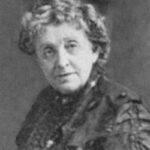 African American school teacher, patent solicitor, and inventor Miriam E. Benjamin obtains U.S. patent no. 386,289 for her invention of the Gong and Signal Chair for Hotels. The chair had both a gong and signal connected to it and would "reduce the expenses of hotels by decreasing the number of waiters and attendants, to add to the convenience and comfort of guests and to obviate the necessity of hand clapping or calling aloud to obtain the services of pages." The chair worked when the person sitting would press a small button on the back of the chair which would then send a signal to a waiting attendant. A light would illuminate as well, allowing the attendant to see which guest needed help. The system was eventually adopted by the United States House of Representatives and was a precursor to the signaling system used on airplanes for passengers to seek assistance from flight attendants. (On December 4, 1917, she received U.S. patent no. 1,249,000 for her Sole for Footwear. This invention was intended to help with temperature regulation in the foot; additionally, music historians believe she, under the gender-neutral pseudonym E.B. Miriam, also composed marches, one of which was used by Theodore Roosevelt's 1904 presidential campaign). Learn more. African American school teacher, patent solicitor, and inventor Miriam E. Benjamin obtains U.S. patent no. 386,289 for her invention of the Gong and Signal Chair for Hotels. The chair had both a gong and signal connected to it and would "reduce the expenses of hotels by decreasing the number of waiters and attendants, to add to the convenience and comfort of guests and to obviate the necessity of hand clapping or calling aloud to obtain the services of pages." The chair worked when the person sitting would press a small button on the back of the chair which would then send a signal to a waiting attendant. A light would illuminate as well, allowing the attendant to see which guest needed help. The system was eventually adopted by the United States House of Representatives and was a precursor to the signaling system used on airplanes for passengers to seek assistance from flight attendants. (On December 4, 1917, she received U.S. patent no. 1,249,000 for her Sole for Footwear. This invention was intended to help with temperature regulation in the foot; additionally, music historians believe she, under the gender-neutral pseudonym E.B. Miriam, also composed marches, one of which was used by Theodore Roosevelt's 1904 presidential campaign). Learn more. | |
| July 17, 1944 |  Munitions detonate while being loaded onto a cargo vessel bound for the World War II Pacific Theater of Operations, killing 320 sailors and civilians and injuring 390 others at the Port Chicago Naval Magazine in Port Chicago, California. Approximately two-thirds of the dead and injured in the Port Chicago Disaster are enlisted African American sailors. A month later, the same white officers that had been in command at the time of the disaster ordered 328 African American sailors to restart munitions loading under the same dangerous conditions. In an act known as the Port Chicago Mutiny, the sailors refused to load the munitions, citing the dangerous conditions. Fifty men—called the "Port Chicago 50"—were convicted of mutiny and sentenced to 15 years of prison and hard labor, as well as dishonorable discharge. During and after the trial, questions were raised about the fairness and legality of the court-martial proceedings. Widespread publicity surrounding the case turned it into a cause célèbre among Americans opposing discrimination targeting African Americans; it and other race-related Navy protests of 1944–45 led the Navy to change its practices and initiate the desegregation of its forces beginning in February 1946. Forty-seven of the Port Chicago 50 were released in January 1946; the remaining three served additional months in prison. On June 11, 2019, a concurrent resolution sponsored by U.S. Representative Mark DeSaulnier was introduced in the 116th United States Congress. The resolution recognizes the victims of the explosion and officially exonerates the 50 men court-martialed by the Navy. Learn more. Munitions detonate while being loaded onto a cargo vessel bound for the World War II Pacific Theater of Operations, killing 320 sailors and civilians and injuring 390 others at the Port Chicago Naval Magazine in Port Chicago, California. Approximately two-thirds of the dead and injured in the Port Chicago Disaster are enlisted African American sailors. A month later, the same white officers that had been in command at the time of the disaster ordered 328 African American sailors to restart munitions loading under the same dangerous conditions. In an act known as the Port Chicago Mutiny, the sailors refused to load the munitions, citing the dangerous conditions. Fifty men—called the "Port Chicago 50"—were convicted of mutiny and sentenced to 15 years of prison and hard labor, as well as dishonorable discharge. During and after the trial, questions were raised about the fairness and legality of the court-martial proceedings. Widespread publicity surrounding the case turned it into a cause célèbre among Americans opposing discrimination targeting African Americans; it and other race-related Navy protests of 1944–45 led the Navy to change its practices and initiate the desegregation of its forces beginning in February 1946. Forty-seven of the Port Chicago 50 were released in January 1946; the remaining three served additional months in prison. On June 11, 2019, a concurrent resolution sponsored by U.S. Representative Mark DeSaulnier was introduced in the 116th United States Congress. The resolution recognizes the victims of the explosion and officially exonerates the 50 men court-martialed by the Navy. Learn more. | |
| July 17, 2001 |  More than 45 years after the Supreme Court’s decision in Brown v. Board of Education, Harvard University’s Civil Rights Project publishes a study on the resegregation of school districts. In the report, Dr. Gary Orfield evaluated statistics from the 1998-1999 school year and concluded that school districts across the nation -- and particularly in the South -- were resegregating at an alarming rate, with many Southern school districts already reflecting segregation levels comparable to those of the early 1970s. The study linked this resegregation trend to a series of early 1990s Supreme Court cases that crippled desegregation efforts and unraveled much of America's fragile progress toward achieving racial integration in public schools. Learn more. More than 45 years after the Supreme Court’s decision in Brown v. Board of Education, Harvard University’s Civil Rights Project publishes a study on the resegregation of school districts. In the report, Dr. Gary Orfield evaluated statistics from the 1998-1999 school year and concluded that school districts across the nation -- and particularly in the South -- were resegregating at an alarming rate, with many Southern school districts already reflecting segregation levels comparable to those of the early 1970s. The study linked this resegregation trend to a series of early 1990s Supreme Court cases that crippled desegregation efforts and unraveled much of America's fragile progress toward achieving racial integration in public schools. Learn more. | |
| July 17, 2014 | 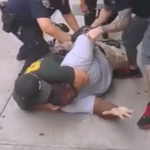 Eric Garner is killed in the New York City borough of Staten Island after Daniel Pantaleo, a New York City Police Department (NYPD) officer, put him in a prohibited chokehold while arresting him. Video footage of the incident generated widespread national attention and raised questions about the appropriate use of force by law enforcement. NYPD officers approached Garner on suspicion of selling single cigarettes from packs without tax stamps. After Garner told the police that he was tired of being harassed and that he was not selling cigarettes, the officers attempted to arrest Garner. When Pantaleo placed his hands on Garner, Garner pulled his arms away. Pantaleo then placed his arm around Garner's neck and wrestled him to the ground. With multiple officers pinning him down, Garner repeated the words "I can't breathe" 11 times while lying face down on the sidewalk. After Garner lost consciousness, he remained lying on the sidewalk for seven minutes while the officers waited for an ambulance to arrive. Garner was pronounced dead at an area hospital approximately one hour later. The medical examiner ruled Garner's death a homicide. According to the medical examiner's definition, a homicide is a death caused by the intentional actions of another person or persons. Specifically, an autopsy indicated that Garner's death resulted from "[compression] of neck, compression of chest and prone positioning during physical restraint by police". Asthma, heart disease, and obesity were cited as contributing factors. On December 4, 2014, a Richmond County grand jury decided not to indict Pantaleo. This decision stirred public protests and rallies, with charges of police brutality made by protesters. In 2019, the U.S. Department of Justice declined to bring criminal charges against Pantaleo under federal civil rights laws. A New York Police Department disciplinary hearing regarding Pantaleo's treatment of Garner was held in the summer of 2019; on August 2, 2019, an administrative judge recommended that Pantaleo's employment be terminated. Pantaleo was fired on August 19, 2019, more than five years after Garner's death. Learn more. Eric Garner is killed in the New York City borough of Staten Island after Daniel Pantaleo, a New York City Police Department (NYPD) officer, put him in a prohibited chokehold while arresting him. Video footage of the incident generated widespread national attention and raised questions about the appropriate use of force by law enforcement. NYPD officers approached Garner on suspicion of selling single cigarettes from packs without tax stamps. After Garner told the police that he was tired of being harassed and that he was not selling cigarettes, the officers attempted to arrest Garner. When Pantaleo placed his hands on Garner, Garner pulled his arms away. Pantaleo then placed his arm around Garner's neck and wrestled him to the ground. With multiple officers pinning him down, Garner repeated the words "I can't breathe" 11 times while lying face down on the sidewalk. After Garner lost consciousness, he remained lying on the sidewalk for seven minutes while the officers waited for an ambulance to arrive. Garner was pronounced dead at an area hospital approximately one hour later. The medical examiner ruled Garner's death a homicide. According to the medical examiner's definition, a homicide is a death caused by the intentional actions of another person or persons. Specifically, an autopsy indicated that Garner's death resulted from "[compression] of neck, compression of chest and prone positioning during physical restraint by police". Asthma, heart disease, and obesity were cited as contributing factors. On December 4, 2014, a Richmond County grand jury decided not to indict Pantaleo. This decision stirred public protests and rallies, with charges of police brutality made by protesters. In 2019, the U.S. Department of Justice declined to bring criminal charges against Pantaleo under federal civil rights laws. A New York Police Department disciplinary hearing regarding Pantaleo's treatment of Garner was held in the summer of 2019; on August 2, 2019, an administrative judge recommended that Pantaleo's employment be terminated. Pantaleo was fired on August 19, 2019, more than five years after Garner's death. Learn more. | |
| July 18, 1863 | 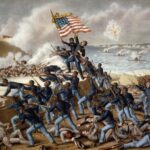 The 54th Massachusetts Infantry -- the nation's first all-Black infantry unit -- storms South Carolina’s Fort Wagner, which guarded the Port of Charleston. Colonel Robert Shaw, their white commander, assembled 600 soldiers to wait just outside Fort Wagner’s fortified walls, then led the men over the walls at nightfall. However, the Union generals had underestimated the number of Confederate soldiers waiting inside: the men of the 54th were outnumbered and outgunned. More than 200 Union soldiers, including Colonel Shaw, were killed. As a sign of disrespect toward the Black soldiers and their white commander, Confederate soldiers at the command of their general unceremoniously dumped the fallen soldiers' bodies, including Colonel Shaw’s, in a single unmarked grave. Learn more. The 54th Massachusetts Infantry -- the nation's first all-Black infantry unit -- storms South Carolina’s Fort Wagner, which guarded the Port of Charleston. Colonel Robert Shaw, their white commander, assembled 600 soldiers to wait just outside Fort Wagner’s fortified walls, then led the men over the walls at nightfall. However, the Union generals had underestimated the number of Confederate soldiers waiting inside: the men of the 54th were outnumbered and outgunned. More than 200 Union soldiers, including Colonel Shaw, were killed. As a sign of disrespect toward the Black soldiers and their white commander, Confederate soldiers at the command of their general unceremoniously dumped the fallen soldiers' bodies, including Colonel Shaw’s, in a single unmarked grave. Learn more. | |
| July 18, 1863 | 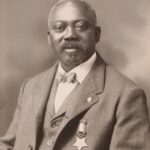 For his gallantry during the Battle of Fort Wagner, Sgt. William H. Carney will later be awarded the Medal of Honor. Sgt. Carney was born enslaved and volunteered with the Union Army during the American Civil War. The action for which he received the Medal of Honor preceded that of any other African American Medal of Honor recipient; however, his medal was not awarded until 1900, one of the last to be awarded for Civil War service (African Americans received the Medal of Honor as early as April 1865). Learn more. For his gallantry during the Battle of Fort Wagner, Sgt. William H. Carney will later be awarded the Medal of Honor. Sgt. Carney was born enslaved and volunteered with the Union Army during the American Civil War. The action for which he received the Medal of Honor preceded that of any other African American Medal of Honor recipient; however, his medal was not awarded until 1900, one of the last to be awarded for Civil War service (African Americans received the Medal of Honor as early as April 1865). Learn more. | |
| July 18, 1899 | 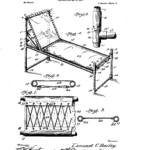 African-American entrepreneur, inventor, and banker Leonard C. Bailey secures U.S. Patent no. 629,286 for his invention of a folding bed. Bailey invented and received patents for a series of devices, many designed for military or government use. His other inventions included a rapid mail-stamping machine, a device to shunt trains to different tracks, and a hernia truss adopted into wide use by the U.S. military. Learn more. African-American entrepreneur, inventor, and banker Leonard C. Bailey secures U.S. Patent no. 629,286 for his invention of a folding bed. Bailey invented and received patents for a series of devices, many designed for military or government use. His other inventions included a rapid mail-stamping machine, a device to shunt trains to different tracks, and a hernia truss adopted into wide use by the U.S. military. Learn more. | |
| July 18, 1964 | 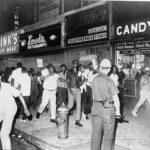 The Harlem Riot of 1964 in Manhattan’s Harlem neighborhood enters its third night. The riot began after James Powell, a slight (5’6”) 15-year-old African American, was shot and killed by police Lieutenant Thomas Gilligan in front of Powell's friends and about a dozen other witnesses on the afternoon of July 16. The shooting set off six consecutive nights of rioting that affected the New York City neighborhoods of Harlem and Bedford-Stuyvesant. In total, 4,000 New Yorkers participated in the riots. Several protesters were severely beaten by NYPD officers. At the end of the conflict, reports counted one dead rioter, 118 injured, and 465 arrested. The killing of African American ninth grader Powell was precipitated when Patrick Lynch, the superintendent of three apartment houses in Yorkville, at the time a predominately working-class white area on the Upper East Side of Manhattan, aggressively turned a hose on Black high school students congregated near the stoop of his building. The angry wet Black students responded by throwing to bottles and garbage-can lids at Lynch. Lynch then retreated to the inside of the building pursued by Powell, who according to a witness, "didn't stay two minutes." As Powell exited the vestibule, off-duty police Lieutenant Thomas Gilligan, who witnessed the scene from a nearby shop, ran to the scene and shot at the 15-year-old James Powell three times. The first round, said to be the warning shot, hit the apartment's window. The next shot hit Powell in the right forearm reaching the main artery just above the heart. The bullet lodged in his lungs. Finally, the last one went through his abdomen and out his back. The autopsy concluded on the fatality of the chest wound in almost any circumstance. However, the pathologist said that Powell could have been saved suffering only the abdominal perforation with a fast response of the ambulance. Learn more. The Harlem Riot of 1964 in Manhattan’s Harlem neighborhood enters its third night. The riot began after James Powell, a slight (5’6”) 15-year-old African American, was shot and killed by police Lieutenant Thomas Gilligan in front of Powell's friends and about a dozen other witnesses on the afternoon of July 16. The shooting set off six consecutive nights of rioting that affected the New York City neighborhoods of Harlem and Bedford-Stuyvesant. In total, 4,000 New Yorkers participated in the riots. Several protesters were severely beaten by NYPD officers. At the end of the conflict, reports counted one dead rioter, 118 injured, and 465 arrested. The killing of African American ninth grader Powell was precipitated when Patrick Lynch, the superintendent of three apartment houses in Yorkville, at the time a predominately working-class white area on the Upper East Side of Manhattan, aggressively turned a hose on Black high school students congregated near the stoop of his building. The angry wet Black students responded by throwing to bottles and garbage-can lids at Lynch. Lynch then retreated to the inside of the building pursued by Powell, who according to a witness, "didn't stay two minutes." As Powell exited the vestibule, off-duty police Lieutenant Thomas Gilligan, who witnessed the scene from a nearby shop, ran to the scene and shot at the 15-year-old James Powell three times. The first round, said to be the warning shot, hit the apartment's window. The next shot hit Powell in the right forearm reaching the main artery just above the heart. The bullet lodged in his lungs. Finally, the last one went through his abdomen and out his back. The autopsy concluded on the fatality of the chest wound in almost any circumstance. However, the pathologist said that Powell could have been saved suffering only the abdominal perforation with a fast response of the ambulance. Learn more. | |
| July 19, 1848 | 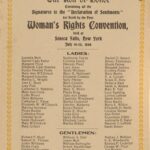 The two-day Seneca Falls Convention, the first women's rights convention in the United States and advertised as “a convention to discuss the social, civil, and religious condition and rights of woman,” is convened in the Wesleyan Chapel of the town of Seneca Falls, New York. Female Quakers local to the area organized the meeting along with Elizabeth Cady Stanton, who was not a Quaker. Abolitionist leader Frederick Douglass, who was the convention's sole African American attendee, played a pivotal part in the convention, arguing eloquently and convincing the attendees to adopt the suffrage resolution that had been prepared by Elizabeth Cady Stanton but that had been subject of heated debate amongst the delegates. Exactly 100 of approximately 300 attendees signed the document, mostly women. Attracting widespread attention, the Seneca Falls Convention was soon followed by other women's rights conventions. Learn more. The two-day Seneca Falls Convention, the first women's rights convention in the United States and advertised as “a convention to discuss the social, civil, and religious condition and rights of woman,” is convened in the Wesleyan Chapel of the town of Seneca Falls, New York. Female Quakers local to the area organized the meeting along with Elizabeth Cady Stanton, who was not a Quaker. Abolitionist leader Frederick Douglass, who was the convention's sole African American attendee, played a pivotal part in the convention, arguing eloquently and convincing the attendees to adopt the suffrage resolution that had been prepared by Elizabeth Cady Stanton but that had been subject of heated debate amongst the delegates. Exactly 100 of approximately 300 attendees signed the document, mostly women. Attracting widespread attention, the Seneca Falls Convention was soon followed by other women's rights conventions. Learn more. | |
| July 19, 1919 | 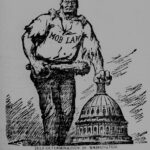 Washington, D.C. becomes one of the over three dozen U.S. cities to erupt in sustained white supremacist terrorism during the “Red Summer” of 1919. White mobs, including uniformed members of all three military services, rampaged in violent attacks against random Black individuals and Black-owned businesses for four days, triggered by an unconfirmed rumor that a Black man had attempted to assault a white woman. The white men rioted, randomly beat Black people on the street, and pulled Black people off streetcars in order to assault them. The four white-owned local newspapers, including the Washington Post, "ginned up...weeks of hysteria", fanning the violence with incendiary headlines, calling in at least one instance for a mobilization of a "clean-up" operation. When police refused to intervene, the Black population fought back and met the attackers. When the violence finally ended owing to federal mobilization of the national guard, a total of 15 people had died: 10 white people, including two police officers; and 5 black people. Fifty people were seriously wounded, while another 100 less severely wounded. It was one of the few times in 20th-century white-on-Black riots that white fatalities outnumbered those of Black people. Learn more. Washington, D.C. becomes one of the over three dozen U.S. cities to erupt in sustained white supremacist terrorism during the “Red Summer” of 1919. White mobs, including uniformed members of all three military services, rampaged in violent attacks against random Black individuals and Black-owned businesses for four days, triggered by an unconfirmed rumor that a Black man had attempted to assault a white woman. The white men rioted, randomly beat Black people on the street, and pulled Black people off streetcars in order to assault them. The four white-owned local newspapers, including the Washington Post, "ginned up...weeks of hysteria", fanning the violence with incendiary headlines, calling in at least one instance for a mobilization of a "clean-up" operation. When police refused to intervene, the Black population fought back and met the attackers. When the violence finally ended owing to federal mobilization of the national guard, a total of 15 people had died: 10 white people, including two police officers; and 5 black people. Fifty people were seriously wounded, while another 100 less severely wounded. It was one of the few times in 20th-century white-on-Black riots that white fatalities outnumbered those of Black people. Learn more. | |
| July 19, 1922 | 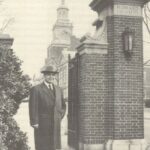 Wyatt Mordecai Johnson was born in Paris, Tennessee in 1890. A lifelong educator, Johnson held degrees from a number of institutions including a 1911 A.B. from Morehouse College and a Doctor of Divinity degree from Howard University. Three years after his graduation from Howard he became the first African American president of that institution and remained at the university’s helm for the next thirty four years. In 1922, 32-year old Johnson gave a powerful address titled, “The Faith of the American Negro.” Read this powerful speech. Wyatt Mordecai Johnson was born in Paris, Tennessee in 1890. A lifelong educator, Johnson held degrees from a number of institutions including a 1911 A.B. from Morehouse College and a Doctor of Divinity degree from Howard University. Three years after his graduation from Howard he became the first African American president of that institution and remained at the university’s helm for the next thirty four years. In 1922, 32-year old Johnson gave a powerful address titled, “The Faith of the American Negro.” Read this powerful speech. | |
| July 19, 1941 | 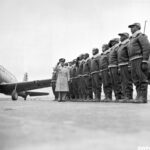 The first United States Army flight school for African American cadets initiates operations at the Tuskegee Institute. Thirteen individuals — the first of the Tuskegee Airmen — made up the inaugural class of aviation cadets (42-C) when they entered Preflight Training at Tuskegee Institute. Before the Tuskegee Airmen, no African-American had been a U.S. military pilot. In 1917, African American men had tried to become aerial observers but were rejected. African American Eugene Bullard served in the French air service during World War I because he was not allowed to serve in an American unit. Learn more. The first United States Army flight school for African American cadets initiates operations at the Tuskegee Institute. Thirteen individuals — the first of the Tuskegee Airmen — made up the inaugural class of aviation cadets (42-C) when they entered Preflight Training at Tuskegee Institute. Before the Tuskegee Airmen, no African-American had been a U.S. military pilot. In 1917, African American men had tried to become aerial observers but were rejected. African American Eugene Bullard served in the French air service during World War I because he was not allowed to serve in an American unit. Learn more. | |
| July 20, 1967 | 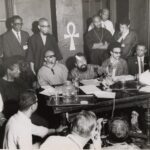 The National Conference on Black Power, the first ever Black Power conference in the United States, convenes over four days in Newark, New Jersey. More than 1,000 delegates representing 286 organizations and institutions from 126 cities in 26 states, Bermuda, and Nigeria, gathered to discuss the most pressing African American issues of the day. The conference held workshops, presented papers for specific programs, and developed resolutions calling for the emphasis of Black Power in political, economic, and cultural affairs. Learn more. The National Conference on Black Power, the first ever Black Power conference in the United States, convenes over four days in Newark, New Jersey. More than 1,000 delegates representing 286 organizations and institutions from 126 cities in 26 states, Bermuda, and Nigeria, gathered to discuss the most pressing African American issues of the day. The conference held workshops, presented papers for specific programs, and developed resolutions calling for the emphasis of Black Power in political, economic, and cultural affairs. Learn more. | |
| July 20, 2015 | 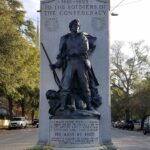 The North Carolina Legislature passes a law requiring legislative approval to change or remove monuments erected to honor “an event, person, or military service that is part of North Carolina’s history.” The Governor signed the bill into law 3 days later. The bill was directly written as a response to efforts to remove Confederate flags and memorials in other states after a white supremacist shot and killed nine Black men and women in a historically Black church in Charleston, South Carolina, on June 17, 2015. Learn more. The North Carolina Legislature passes a law requiring legislative approval to change or remove monuments erected to honor “an event, person, or military service that is part of North Carolina’s history.” The Governor signed the bill into law 3 days later. The bill was directly written as a response to efforts to remove Confederate flags and memorials in other states after a white supremacist shot and killed nine Black men and women in a historically Black church in Charleston, South Carolina, on June 17, 2015. Learn more. | |
| July 21, 1818 | 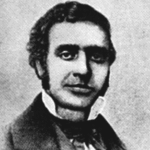 Teacher, pioneering college professor, abolitionist, and activist, Charles L. Reason is born in New York City to parents, Michiel and Elizabeth Reason, immigrants from Haiti. Reason displayed an early aptitude for mathematics when he was a student at the New York African Free School and began his teaching career when he was 14 years old, while continuing his own education with tutors. Reason played a prominent role in the Negro Convention Movement in New York. In 1837 Reason joined Henry Highland Garnet, among others, in an effort to gain voting rights for African American men and he was later one of the co-authors of the Call for the New York Negro Convention of 1840. When the predominantly white Free Mission College (later renamed New York Central College) opened in Courtland County, New York in 1849, it admitted black students and hired Reason to serve on the faculty. In so doing, Reason became the first African American to teach at a predominantly white college, serving as professor of belles lettres, Greek, Latin, French, and adjunct professor of mathematics. Learn more. Teacher, pioneering college professor, abolitionist, and activist, Charles L. Reason is born in New York City to parents, Michiel and Elizabeth Reason, immigrants from Haiti. Reason displayed an early aptitude for mathematics when he was a student at the New York African Free School and began his teaching career when he was 14 years old, while continuing his own education with tutors. Reason played a prominent role in the Negro Convention Movement in New York. In 1837 Reason joined Henry Highland Garnet, among others, in an effort to gain voting rights for African American men and he was later one of the co-authors of the Call for the New York Negro Convention of 1840. When the predominantly white Free Mission College (later renamed New York Central College) opened in Courtland County, New York in 1849, it admitted black students and hired Reason to serve on the faculty. In so doing, Reason became the first African American to teach at a predominantly white college, serving as professor of belles lettres, Greek, Latin, French, and adjunct professor of mathematics. Learn more. | |
| July 21, 1840 | 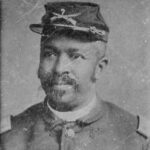 Christian Abraham Fleetwood, a non-commissioned officer in the United States Army, a commissioned officer in the D.C. National Guard, an editor, a musician, and a government official is born to Charles and Anna Maria Fleetwood, both free persons of color. Fleetwood graduated in 1860 from Ashmun Institute (later known as Lincoln University) in Oxford, Pennsylvania. He established and published The Lyceum Observer, said to be the first newspaper in the Upper South to be owned and operated by an African American. Fleetwood enlisted into Company G of the 4th Regiment United States Colored Infantry, Union Army, in August 1863. Due to his educated background, Fleetwood was given the rank of sergeant upon enlistment and was quickly promoted to sergeant major. His regiment, assigned to the 3rd Division, saw service with the 10th, 18th, and 25th Army Corps in campaigns in North Carolina and Virginia, particularly on July 16, 1864, in the Battle of Petersburg and on September 29–30, 1864, in the Battle of Chaffin's Farm. For his actions during this latter battle, Fleetwood received the Medal of Honor. Learn more. Christian Abraham Fleetwood, a non-commissioned officer in the United States Army, a commissioned officer in the D.C. National Guard, an editor, a musician, and a government official is born to Charles and Anna Maria Fleetwood, both free persons of color. Fleetwood graduated in 1860 from Ashmun Institute (later known as Lincoln University) in Oxford, Pennsylvania. He established and published The Lyceum Observer, said to be the first newspaper in the Upper South to be owned and operated by an African American. Fleetwood enlisted into Company G of the 4th Regiment United States Colored Infantry, Union Army, in August 1863. Due to his educated background, Fleetwood was given the rank of sergeant upon enlistment and was quickly promoted to sergeant major. His regiment, assigned to the 3rd Division, saw service with the 10th, 18th, and 25th Army Corps in campaigns in North Carolina and Virginia, particularly on July 16, 1864, in the Battle of Petersburg and on September 29–30, 1864, in the Battle of Chaffin's Farm. For his actions during this latter battle, Fleetwood received the Medal of Honor. Learn more. | |
| July 21, 1896 |  The National Association of Colored Women (later National Association of Colored Women's Clubs) is established in Washington, D.C.. This first of what would later become biennial convention meetings of the association was held at the Nineteenth Street Baptist Church. The organizations attending this convention included the National Federation of Afro-American Women, the Woman's Era Club of Boston, and the National League of Colored Women of Washington, DC, the Women's Loyal Union as well as smaller organizations that had arisen from the African-American women's club movement. These organizations and later others across the country merged to form the National Association of Colored Women. The organization helped all African-American women by working on issues of civil rights and injustice, such as women’s suffrage, lynching, and Jim Crow laws. Learn more. The National Association of Colored Women (later National Association of Colored Women's Clubs) is established in Washington, D.C.. This first of what would later become biennial convention meetings of the association was held at the Nineteenth Street Baptist Church. The organizations attending this convention included the National Federation of Afro-American Women, the Woman's Era Club of Boston, and the National League of Colored Women of Washington, DC, the Women's Loyal Union as well as smaller organizations that had arisen from the African-American women's club movement. These organizations and later others across the country merged to form the National Association of Colored Women. The organization helped all African-American women by working on issues of civil rights and injustice, such as women’s suffrage, lynching, and Jim Crow laws. Learn more. | |
| July 22, 1899 | 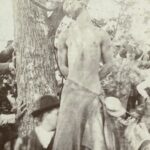 A white mob attack officers transporting Frank Embree to stand trial, seize Embree, drive him to the site of an alleged assault, and attempt to extract a confession by stripping him naked and whipping him in front of an assembled crowd of 1,000 onlookers in Fayette, Missouri. Mr. Embree steadfastly maintained his innocence despite this abuse. After withstanding more than 100 lashes to his body, Mr. Embree began screaming and told the men that he would confess. Rather than plead for his life, Mr. Embree begged his attackers to stop the torture and kill him swiftly. Covered in blood from the whipping, with no courtroom or legal system in sight, Mr. Embree offered a confession to the waiting lynch mob and was immediately hanged from a tree.Though published photographs of Mr. Embree’s lynching clearly depict the faces of many of his assailants, no one was ever arrested or tried for his death. Learn more. A white mob attack officers transporting Frank Embree to stand trial, seize Embree, drive him to the site of an alleged assault, and attempt to extract a confession by stripping him naked and whipping him in front of an assembled crowd of 1,000 onlookers in Fayette, Missouri. Mr. Embree steadfastly maintained his innocence despite this abuse. After withstanding more than 100 lashes to his body, Mr. Embree began screaming and told the men that he would confess. Rather than plead for his life, Mr. Embree begged his attackers to stop the torture and kill him swiftly. Covered in blood from the whipping, with no courtroom or legal system in sight, Mr. Embree offered a confession to the waiting lynch mob and was immediately hanged from a tree.Though published photographs of Mr. Embree’s lynching clearly depict the faces of many of his assailants, no one was ever arrested or tried for his death. Learn more. | |
| July 22, 1929 | 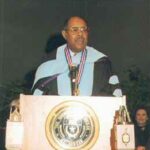 Donald Gayton Phelps, a dedicated and ground breaking educator, intellect, roll model, and social critic is born in Seattle, Washington. Phelps earned his bachelor’s and master’s degrees in education from Seattle University and his doctorate in education from the University of Washington. In 1963, he was appointed principle at Robinswood Elementary, the first African American principal in Bellevue, Washington; for nearly all of his students, he was the first person of color that they knew. In 1967, Phelps became the first African American principal of Bellevue Junior High School which made him the first Black secondary school principal in the state. From 1968 to 1972, Phelps was also a regular commentator on community affairs for KOMO, a Seattle radio and television station. Subsequently, he served as interim superintendent of the Lake Washington School District, president and later chancellor of Seattle Central Community College. Phelps was next appointed chancellor of the Los Angeles Community College District, the largest and most diverse community college system in the nation. In 1994, he moved to Austin, Texas to serve as the W. K. Kellogg Regents Professor at the University of Texas. Learn more. Donald Gayton Phelps, a dedicated and ground breaking educator, intellect, roll model, and social critic is born in Seattle, Washington. Phelps earned his bachelor’s and master’s degrees in education from Seattle University and his doctorate in education from the University of Washington. In 1963, he was appointed principle at Robinswood Elementary, the first African American principal in Bellevue, Washington; for nearly all of his students, he was the first person of color that they knew. In 1967, Phelps became the first African American principal of Bellevue Junior High School which made him the first Black secondary school principal in the state. From 1968 to 1972, Phelps was also a regular commentator on community affairs for KOMO, a Seattle radio and television station. Subsequently, he served as interim superintendent of the Lake Washington School District, president and later chancellor of Seattle Central Community College. Phelps was next appointed chancellor of the Los Angeles Community College District, the largest and most diverse community college system in the nation. In 1994, he moved to Austin, Texas to serve as the W. K. Kellogg Regents Professor at the University of Texas. Learn more. | |
| July 22, 1939 | 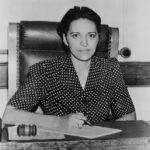 Jane Matilda Bolin is appointed as a judge of the Domestic Relations Court, the first Black woman to serve as a judge in the United States. Bolin had previously been the first Black woman to: (1) graduate from Yale Law School; (2) join the New York City Bar Association; and (3) join the New York City Law Department. For twenty years after her appointment to the bench, she was the only African American female judge in the country. She served on the bench for 40 years, until her mandatory retirement at age 70. During her career, Bolin worked to encourage racially integrated child services, ensuring that probation officers were assigned without regard to race or religion, and publicly funded childcare agencies accepted children without regard to ethnic background. Learn more. Jane Matilda Bolin is appointed as a judge of the Domestic Relations Court, the first Black woman to serve as a judge in the United States. Bolin had previously been the first Black woman to: (1) graduate from Yale Law School; (2) join the New York City Bar Association; and (3) join the New York City Law Department. For twenty years after her appointment to the bench, she was the only African American female judge in the country. She served on the bench for 40 years, until her mandatory retirement at age 70. During her career, Bolin worked to encourage racially integrated child services, ensuring that probation officers were assigned without regard to race or religion, and publicly funded childcare agencies accepted children without regard to ethnic background. Learn more. | |
| July 23, 1840 | 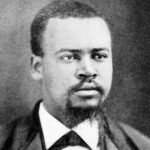 John Adams Hyman, a Republican U.S. Congressman from North Carolina’s 2nd congressional district, including counties in the northeast around New Bern, from 1875 to 1877, the first African American to represent the state in the House of Representatives, is born into slavery near Warrenton, North Carolina. Hyman did not receive any formal education as a child. By 1861, he was working as a janitor for a jeweler named King in Warrenton. King was from the free state of Pennsylvania and taught Hyman to read and write; when this was discovered by whites in town, they forced King and his wife to leave the community. When Hyman persisted in trying to gain an education, at the age of 21 he was sold to a new master in Alabama. In twenty-five years as a slave, Hyman was sold at least eight times. After the American Civil War and the emancipation of enslaved people, Hyman returned to North Carolina in 1865. He worked as a farmer and pursued elementary studies. Recognized for his leadership, Hyman was chosen as a delegate to the state equal rights convention in 1865 and to the state Constitutional Convention in 1868. Hyman was elected to the North Carolina Senate, where he served from 1868 to 1874 in the Reconstruction-era legislature. Learn more. John Adams Hyman, a Republican U.S. Congressman from North Carolina’s 2nd congressional district, including counties in the northeast around New Bern, from 1875 to 1877, the first African American to represent the state in the House of Representatives, is born into slavery near Warrenton, North Carolina. Hyman did not receive any formal education as a child. By 1861, he was working as a janitor for a jeweler named King in Warrenton. King was from the free state of Pennsylvania and taught Hyman to read and write; when this was discovered by whites in town, they forced King and his wife to leave the community. When Hyman persisted in trying to gain an education, at the age of 21 he was sold to a new master in Alabama. In twenty-five years as a slave, Hyman was sold at least eight times. After the American Civil War and the emancipation of enslaved people, Hyman returned to North Carolina in 1865. He worked as a farmer and pursued elementary studies. Recognized for his leadership, Hyman was chosen as a delegate to the state equal rights convention in 1865 and to the state Constitutional Convention in 1868. Hyman was elected to the North Carolina Senate, where he served from 1868 to 1874 in the Reconstruction-era legislature. Learn more. | |
| July 23, 1891 | 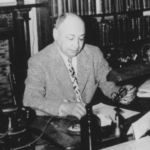 Surgeon and civil rights activist Louis Tompkins Wright, MD, FACS is born. In his position at Harlem Hospital he was the first African-American on the surgical staff of a non-segregated hospital in New York City. He was influential for his medical research as well as his efforts pushing for racial equality in medicine and involvement with the National Association for the Advancement of Colored People(NAACP), for which he served as chairman for nearly two decades. Dr. Wright earned his medical degree from Harvard Medical School. Shortly after completing medical school, Wright joined the Army Medical Corps, serving as a lieutenant during World War I, stationed in France. While there he introduced intradermal vaccination for smallpox and was awarded the Purple Heart after a gas attack. In 1929 he was also appointed to serve as the first African-American police surgeon with the New York Police Department. At Harlem Hospital, Wright headed the team that first used chlortetracycline on humans, founded the hospital's cancer research center, and earned a reputation as an expert on head injuries. He was a Fellow of the American College of Surgeons and the American Medical Association. Learn more. Surgeon and civil rights activist Louis Tompkins Wright, MD, FACS is born. In his position at Harlem Hospital he was the first African-American on the surgical staff of a non-segregated hospital in New York City. He was influential for his medical research as well as his efforts pushing for racial equality in medicine and involvement with the National Association for the Advancement of Colored People(NAACP), for which he served as chairman for nearly two decades. Dr. Wright earned his medical degree from Harvard Medical School. Shortly after completing medical school, Wright joined the Army Medical Corps, serving as a lieutenant during World War I, stationed in France. While there he introduced intradermal vaccination for smallpox and was awarded the Purple Heart after a gas attack. In 1929 he was also appointed to serve as the first African-American police surgeon with the New York Police Department. At Harlem Hospital, Wright headed the team that first used chlortetracycline on humans, founded the hospital's cancer research center, and earned a reputation as an expert on head injuries. He was a Fellow of the American College of Surgeons and the American Medical Association. Learn more. | |
| July 23, 1942 | 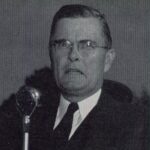 Alabama Governor Frank M. Dixon refuses to sign a contract to produce 1.7 million yards of cloth to assist the U.S. in World War II efforts, fearing that the nondiscrimination clause in the contract could require integration and choosing instead to uphold segregated workforces as a “basic necessity.” Dixon was not alone among politicians who prioritized the preservation of white supremacist segregation over patriotism and the country’s World War II efforts. In the preceding decade, southern Democrats had conditioned their support for desperately-needed New Deal programs upon inclusion of provisions that significantly disadvantaged or altogether excluded African Americans, including the invention and institutionalization of real estate “red-lining”. Learn more. Alabama Governor Frank M. Dixon refuses to sign a contract to produce 1.7 million yards of cloth to assist the U.S. in World War II efforts, fearing that the nondiscrimination clause in the contract could require integration and choosing instead to uphold segregated workforces as a “basic necessity.” Dixon was not alone among politicians who prioritized the preservation of white supremacist segregation over patriotism and the country’s World War II efforts. In the preceding decade, southern Democrats had conditioned their support for desperately-needed New Deal programs upon inclusion of provisions that significantly disadvantaged or altogether excluded African Americans, including the invention and institutionalization of real estate “red-lining”. Learn more. | |
| July 24, 1802 | 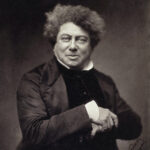 Famed and prolific 19th century author Alexandre Dumas is born in Villiers-Cotterets to a Thomas Alexandre Dumas, a mixed race French nobleman whose mother was an enslaved Black African woman in Haiti, and Marie Labouret Dumas, a French woman. (It is crucial to note that in the United States, Dumas and his father would have been classified as "Negroes" and likely would have inherited Dumas's grandmother's enslaved status). Dumas became an acclaimed author of the French classics The Three Musketeers, The Count of Monte Cristo, The Man in the Iron Mask, and The Corsican Brothers. Dumas wrote hundreds of plays, novels and travel diaries. He wrote several children's stories, and a culinary dictionary. He started several magazines and wrote in them weekly. He was one of the most prolific writers ever. Learn more. Famed and prolific 19th century author Alexandre Dumas is born in Villiers-Cotterets to a Thomas Alexandre Dumas, a mixed race French nobleman whose mother was an enslaved Black African woman in Haiti, and Marie Labouret Dumas, a French woman. (It is crucial to note that in the United States, Dumas and his father would have been classified as "Negroes" and likely would have inherited Dumas's grandmother's enslaved status). Dumas became an acclaimed author of the French classics The Three Musketeers, The Count of Monte Cristo, The Man in the Iron Mask, and The Corsican Brothers. Dumas wrote hundreds of plays, novels and travel diaries. He wrote several children's stories, and a culinary dictionary. He started several magazines and wrote in them weekly. He was one of the most prolific writers ever. Learn more. | |
| July 24, 1807 | 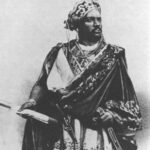 Ira Frederick Aldridge, an American and later British actor, playwright, and theater manager, is born in New York City. Aldridge was the first African American actor to achieve success on the international stage. He also pushed social boundaries by playing opposite white actresses in England and becoming known as the preeminent Shakespearean actor and tragedian of the 19th Century. Aldridge is the only actor of African-American descent among the thirty-three actors of the English stage honoured with bronze plaques at the Shakespeare Memorial Theatre at Stratford-upon-Avon. Aldridge married twice, once to an Englishwoman, once to a Swedish woman, and had a family in England. Two of his daughters became professional opera singers. Learn more. Ira Frederick Aldridge, an American and later British actor, playwright, and theater manager, is born in New York City. Aldridge was the first African American actor to achieve success on the international stage. He also pushed social boundaries by playing opposite white actresses in England and becoming known as the preeminent Shakespearean actor and tragedian of the 19th Century. Aldridge is the only actor of African-American descent among the thirty-three actors of the English stage honoured with bronze plaques at the Shakespeare Memorial Theatre at Stratford-upon-Avon. Aldridge married twice, once to an Englishwoman, once to a Swedish woman, and had a family in England. Two of his daughters became professional opera singers. Learn more. | |
| July 24, 1893 | 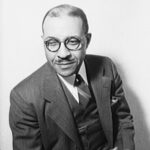 Charles Spurgeon Johnson, noted sociologist and college administrator, the first Black president of historically Black Fisk University, and a lifelong advocate for racial equality and the advancement of civil rights for African Americans and all ethnic minorities, is born. He preferred to work collaboratively with liberal white groups in the South, quietly as a "sideline activist," to get practical results. During Johnson's academic studies and leadership of Fisk University during the 1930s and 1940s, the South had legal racial segregation and Jim Crow discriminatory laws and practices, including having disfranchised most Black voters in constitutions passed at the turn of the century. Learn more. Charles Spurgeon Johnson, noted sociologist and college administrator, the first Black president of historically Black Fisk University, and a lifelong advocate for racial equality and the advancement of civil rights for African Americans and all ethnic minorities, is born. He preferred to work collaboratively with liberal white groups in the South, quietly as a "sideline activist," to get practical results. During Johnson's academic studies and leadership of Fisk University during the 1930s and 1940s, the South had legal racial segregation and Jim Crow discriminatory laws and practices, including having disfranchised most Black voters in constitutions passed at the turn of the century. Learn more. | |
| July 24, 1972 | 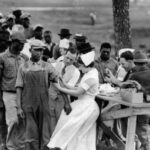 The Washington Star newspaper in Washington, D.C., publishes an article exposing details of the Tuskegee Syphillis Experiment, an ongoing initiative that withheld diagnosis information and treatment from Black men in Alabama in order to study the effects of the disease. Over the preceding 40 years, beginning in 1932, the U.S. Public Health Service (PHS) persuaded 600 African American men—399 with syphilis, and 201 without the disease—to participate in the experiment. They were not given full details about the scope of the study. Nearly all of the men studied were poorly-educated, impoverished sharecroppers. Those with syphilis were not told they were infected and did not receive treatment, even after Penicillin was discovered to be an effective cure for the disease in the 1940s. Their access to treatment outside of the study was also thwarted, as local health workers not affiliated with the project were prevented from caring for syphilis-infected individuals participating in the experiment. Over the study's 40-year span, 128 participants died of syphilis or syphilis-related complications. Learn more. The Washington Star newspaper in Washington, D.C., publishes an article exposing details of the Tuskegee Syphillis Experiment, an ongoing initiative that withheld diagnosis information and treatment from Black men in Alabama in order to study the effects of the disease. Over the preceding 40 years, beginning in 1932, the U.S. Public Health Service (PHS) persuaded 600 African American men—399 with syphilis, and 201 without the disease—to participate in the experiment. They were not given full details about the scope of the study. Nearly all of the men studied were poorly-educated, impoverished sharecroppers. Those with syphilis were not told they were infected and did not receive treatment, even after Penicillin was discovered to be an effective cure for the disease in the 1940s. Their access to treatment outside of the study was also thwarted, as local health workers not affiliated with the project were prevented from caring for syphilis-infected individuals participating in the experiment. Over the study's 40-year span, 128 participants died of syphilis or syphilis-related complications. Learn more. | |
| July 25, 1861 | 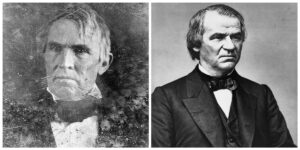 The Crittenden–Johnson Resolution is passed almost unanimously by the 37th United States Congress. Both houses of Congress passed this resolution days after the First Battle of Bull Run made it clear that the Civil War would not end quickly. The bill defined goal of the Union effort solely as preservation of the Constitution and the union. Though passed almost unanimously in July, sentiment shifted so dramatically and quickly that abolitionist Congressman Thaddeus Stevens secured its repeal by decisive majority just 5 months later. Learn more. The Crittenden–Johnson Resolution is passed almost unanimously by the 37th United States Congress. Both houses of Congress passed this resolution days after the First Battle of Bull Run made it clear that the Civil War would not end quickly. The bill defined goal of the Union effort solely as preservation of the Constitution and the union. Though passed almost unanimously in July, sentiment shifted so dramatically and quickly that abolitionist Congressman Thaddeus Stevens secured its repeal by decisive majority just 5 months later. Learn more. | |
| July 25, 1946 | 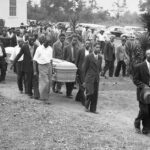 Two Black couples are lynched near Moore’s Ford Bridge in Walton County, Georgia, by 30 armed, unmasked white men in what has been called “the last mass lynching in America.” The victims were George W. Dorsey and his wife, Mae Murray, and Roger Malcolm and his wife, Dorothy, who was seven months pregnant. Mr. Dorsey, a World War II veteran who had served in the Pacific for five years, had been home for only nine months. The white men shot all four people 60 times at close range. A grand jury returned no indictments and the perpetrators were never brought to justice. The FBI recently reopened its investigation into the lynching, only to encounter continued silence and obstruction at the highest levels. In response to charges that he was withholding information, Walton County Superior Court Judge Marvin Sorrells, whose father worked for Walton County law enforcement in 1946, vowed that “until the last person of my daddy’s generation dies, no one will talk.” Learn more. Two Black couples are lynched near Moore’s Ford Bridge in Walton County, Georgia, by 30 armed, unmasked white men in what has been called “the last mass lynching in America.” The victims were George W. Dorsey and his wife, Mae Murray, and Roger Malcolm and his wife, Dorothy, who was seven months pregnant. Mr. Dorsey, a World War II veteran who had served in the Pacific for five years, had been home for only nine months. The white men shot all four people 60 times at close range. A grand jury returned no indictments and the perpetrators were never brought to justice. The FBI recently reopened its investigation into the lynching, only to encounter continued silence and obstruction at the highest levels. In response to charges that he was withholding information, Walton County Superior Court Judge Marvin Sorrells, whose father worked for Walton County law enforcement in 1946, vowed that “until the last person of my daddy’s generation dies, no one will talk.” Learn more. | |
| July 25, 1967 | 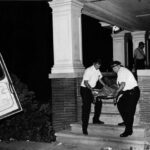 Police officers kill unarmed and subdued young Black men and strip naked their two young white female companions in Algiers Motel Incident in Detroit, Michigan, two days after the Detroit Race Riot began. Despite the three deceased bodies in the Motel Annex, the Detroit police officers on the scene did not report any of the deaths to the Detroit Police Homicide Bureau as required, and instead left the annex after demanding that the survivors keep quiet about the incident. All-white juries returned not-guilty verdicts against the officers, despite confessions and eye witnesses. Learn more. Police officers kill unarmed and subdued young Black men and strip naked their two young white female companions in Algiers Motel Incident in Detroit, Michigan, two days after the Detroit Race Riot began. Despite the three deceased bodies in the Motel Annex, the Detroit police officers on the scene did not report any of the deaths to the Detroit Police Homicide Bureau as required, and instead left the annex after demanding that the survivors keep quiet about the incident. All-white juries returned not-guilty verdicts against the officers, despite confessions and eye witnesses. Learn more. | |
| July 26, 1916 | 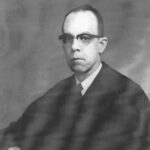 Educator, civil rights attorney, and federal judge Spottiswood William Robinson III is born. Working through the NAACP Legal Defense Fund, Robinson litigated the lawsuit Davis v. County School Board of Prince Edward County, which was consolidated with four other cases decided under Brown v. Board of Education by the Supreme Court of the United States in 1954. In his arguments before the Court, Robinson made the first argument on behalf of the plaintiffs. Robinson also participated as litigator in Chance v. Lambeth, which invalidated carrier-enforced racial segregation in interstate transportation. In 1964, Robinson was appointed a United States District Judge of the United States District Court for the District of Columbia, the first African-American to serve on that court. In 1966, he was elevated to United States Circuit Judge of the United States Court of Appeals for the District of Columbia Circuit, on which he served as Chief Judge from 1981 to 1986, becoming the first African-American to both serve on that court and serve as its Chief Judge. Learn more. Educator, civil rights attorney, and federal judge Spottiswood William Robinson III is born. Working through the NAACP Legal Defense Fund, Robinson litigated the lawsuit Davis v. County School Board of Prince Edward County, which was consolidated with four other cases decided under Brown v. Board of Education by the Supreme Court of the United States in 1954. In his arguments before the Court, Robinson made the first argument on behalf of the plaintiffs. Robinson also participated as litigator in Chance v. Lambeth, which invalidated carrier-enforced racial segregation in interstate transportation. In 1964, Robinson was appointed a United States District Judge of the United States District Court for the District of Columbia, the first African-American to serve on that court. In 1966, he was elevated to United States Circuit Judge of the United States Court of Appeals for the District of Columbia Circuit, on which he served as Chief Judge from 1981 to 1986, becoming the first African-American to both serve on that court and serve as its Chief Judge. Learn more. | |
| July 26, 1948 | 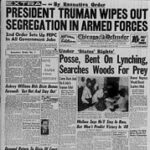 President Harry S. Truman issues Executive Order 9981 abolishing discrimination "on the basis of race, color, religion or national origin" in the United States Armed Forces. The order led to the desegration of the services during the Korean War (1950–1953). It was a crucial event in the post-World War II civil rights movement and a major achievement of Truman's presidency. The order was in large part due to the decades-long efforts of civil rights activist A. Philip Randolph, along with colleague Grant Reynolds, to end discrimination in the military and the federal government. Most of the actual enforcement of the order was accomplished by President Dwight D. Eisenhower's administration (1953–1961), including the desegregation of military schools, hospitals, and bases. The last of the all-black units in the United States military was abolished in September 1954. Learn more. President Harry S. Truman issues Executive Order 9981 abolishing discrimination "on the basis of race, color, religion or national origin" in the United States Armed Forces. The order led to the desegration of the services during the Korean War (1950–1953). It was a crucial event in the post-World War II civil rights movement and a major achievement of Truman's presidency. The order was in large part due to the decades-long efforts of civil rights activist A. Philip Randolph, along with colleague Grant Reynolds, to end discrimination in the military and the federal government. Most of the actual enforcement of the order was accomplished by President Dwight D. Eisenhower's administration (1953–1961), including the desegregation of military schools, hospitals, and bases. The last of the all-black units in the United States military was abolished in September 1954. Learn more. | |
| July 26, 2016 | 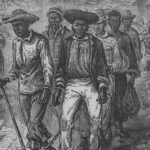 First Lady Michelle Obama is met with public backlash the day after she gave a speech at the Democratic National Convention truthfully acknowledging the history of American slavery. Reflecting on our national history, Mrs. Obama remarked during her July 25th speech: "The story of this country, the story that has brought me to this stage tonight, the story of generations of people who felt the lash of bondage, the shame of servitude, the sting of segregation” she explained, “is the story of striving and hoping and doing what needed to be done so that today I wake up every morning in a house that was built by slaves.” Her truthful statement was answered with derision online and in social media; typical of the hostile responses was one conservative blog’s remark that Mrs. Obama’s statement showed “the disdain she has for America.” The objections to Mrs. Obama’s references to the difficult and painful history of American slavery were an attempt to avoid the truth rather than reveal it. Learn more. First Lady Michelle Obama is met with public backlash the day after she gave a speech at the Democratic National Convention truthfully acknowledging the history of American slavery. Reflecting on our national history, Mrs. Obama remarked during her July 25th speech: "The story of this country, the story that has brought me to this stage tonight, the story of generations of people who felt the lash of bondage, the shame of servitude, the sting of segregation” she explained, “is the story of striving and hoping and doing what needed to be done so that today I wake up every morning in a house that was built by slaves.” Her truthful statement was answered with derision online and in social media; typical of the hostile responses was one conservative blog’s remark that Mrs. Obama’s statement showed “the disdain she has for America.” The objections to Mrs. Obama’s references to the difficult and painful history of American slavery were an attempt to avoid the truth rather than reveal it. Learn more. | |
| July 27, 1816 | 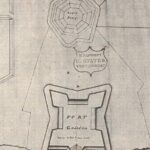 In the Battle of "Negro Fort", United States military forces at the command of General Andrew Jackson completely destroy a fortification and thriving farming/trading community composed of Free Blacks, formerly enslaved fugitive Blacks, and Native Americans of the Creek and Choctaw nations in a remote part of what was at the time Spanish Florida. The American forces fired red-hot shot from a gunboat on the river in attempts to start a fire. A shot landed in the powder magazine, which ignited, blowing up the fort and killing over 270 people instantly. In all the Black and Native American population suffered a total of 334 deaths and casualties, including women and children. Those captured who were formerly enslaved were forced back into bondage. This is the only time in history in which the United States destroyed a community of escaped slaves in another country. The Battle of Negro Fort was the first battle of the Seminole Wars. The battle made Andrew Jackson a hero to all but abolitionists; Jackson's fame led him to the White House and the founding of the Democratic Party. Learn more. In the Battle of "Negro Fort", United States military forces at the command of General Andrew Jackson completely destroy a fortification and thriving farming/trading community composed of Free Blacks, formerly enslaved fugitive Blacks, and Native Americans of the Creek and Choctaw nations in a remote part of what was at the time Spanish Florida. The American forces fired red-hot shot from a gunboat on the river in attempts to start a fire. A shot landed in the powder magazine, which ignited, blowing up the fort and killing over 270 people instantly. In all the Black and Native American population suffered a total of 334 deaths and casualties, including women and children. Those captured who were formerly enslaved were forced back into bondage. This is the only time in history in which the United States destroyed a community of escaped slaves in another country. The Battle of Negro Fort was the first battle of the Seminole Wars. The battle made Andrew Jackson a hero to all but abolitionists; Jackson's fame led him to the White House and the founding of the Democratic Party. Learn more. | |
| July 27, 1880 | 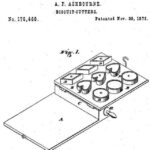 Formerly enslaved African American inventor Alexander P. Ashbourne secures U.S. patent No. 230,518, for his process for refining coconut oil, which went on to be used is used in hair products, foods, and scented products. In all, Ashbourne received four patents, including a patent for the first biscuit/cookie cutter. Learn more. Formerly enslaved African American inventor Alexander P. Ashbourne secures U.S. patent No. 230,518, for his process for refining coconut oil, which went on to be used is used in hair products, foods, and scented products. In all, Ashbourne received four patents, including a patent for the first biscuit/cookie cutter. Learn more. | |
| July 27, 1919 | 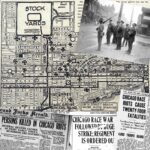 The week-long Chicago Race Riot of 1919 begins, the worst, but just one of the dozens, of violent attacks by white Americans against African Americans that convulsed cities across the country during the Red Summer of 1919. During the riot, 38 people died (23 Black and 15 white). Over the week, injuries attributed to the episodic confrontations stood at 537, with two thirds of the injured being Black and one third white, and approximately 1,000 to 2,000, most of whom were Black, lost their homes. The riot was triggered with the murder of the 17-year-old Eugene Williams, an African American who had inadvertently drifted into a white swimming area at an informally-segregated beach near 29th Street. A group of African-American youths were diving from a 14 foot by 9 foot raft that they had constructed. When the raft drifted into the "white beach area," one white beachgoer was indignant, began hurling rocks at the young men, striking Williams, and caused the teen to drown. The official coroner's report cited that Williams drowned because the stone-throwing had kept him from coming to shore. When Black beach-goers complained that whites attacked them, violence expanded into neighborhoods in which white mobs attacked innocent black residents. Tensions between groups arose in a melee, which became days of unrest. Black neighbors near white areas were attacked, white gangs went into Black neighborhoods, and Black workers seeking to get to and from work were attacked. Meanwhile, some Blacks organized to resist and protect each other, and some whites sought to lend aid to Blacks, but the Chicago Police Department often turned a blind eye, or worse. Learn more. The week-long Chicago Race Riot of 1919 begins, the worst, but just one of the dozens, of violent attacks by white Americans against African Americans that convulsed cities across the country during the Red Summer of 1919. During the riot, 38 people died (23 Black and 15 white). Over the week, injuries attributed to the episodic confrontations stood at 537, with two thirds of the injured being Black and one third white, and approximately 1,000 to 2,000, most of whom were Black, lost their homes. The riot was triggered with the murder of the 17-year-old Eugene Williams, an African American who had inadvertently drifted into a white swimming area at an informally-segregated beach near 29th Street. A group of African-American youths were diving from a 14 foot by 9 foot raft that they had constructed. When the raft drifted into the "white beach area," one white beachgoer was indignant, began hurling rocks at the young men, striking Williams, and caused the teen to drown. The official coroner's report cited that Williams drowned because the stone-throwing had kept him from coming to shore. When Black beach-goers complained that whites attacked them, violence expanded into neighborhoods in which white mobs attacked innocent black residents. Tensions between groups arose in a melee, which became days of unrest. Black neighbors near white areas were attacked, white gangs went into Black neighborhoods, and Black workers seeking to get to and from work were attacked. Meanwhile, some Blacks organized to resist and protect each other, and some whites sought to lend aid to Blacks, but the Chicago Police Department often turned a blind eye, or worse. Learn more. | |
| July 27, 1967 | 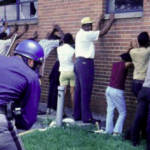 A multi-day uprising of violent clashes between police and Black residents in Detroit ended. The Detroit rebellion began after police raided an after-hours club on July 23; looting and fires broke out, and multiple law enforcement agencies were deployed. On July 26, police and National Guardsmen raided the Algiers motel looking for an alleged sniper. They found not a single gun on the premises, but instead tortured the Black men and white women they found there together and killed three Black teenagers, shooting two of them with shotguns at point-blank range. Despite two officers’ confessions, no one was ever convicted for their deaths. By the rebellion’s end, 33 African American and 10 white people had been killed, most at the hands of law enforcement. Learn more. A multi-day uprising of violent clashes between police and Black residents in Detroit ended. The Detroit rebellion began after police raided an after-hours club on July 23; looting and fires broke out, and multiple law enforcement agencies were deployed. On July 26, police and National Guardsmen raided the Algiers motel looking for an alleged sniper. They found not a single gun on the premises, but instead tortured the Black men and white women they found there together and killed three Black teenagers, shooting two of them with shotguns at point-blank range. Despite two officers’ confessions, no one was ever convicted for their deaths. By the rebellion’s end, 33 African American and 10 white people had been killed, most at the hands of law enforcement. Learn more. | |
| July 28, 1868 | 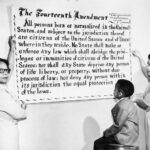 The 14th Amendment to the United States Constitution is certified, establishing African American citizenship and guaranteeing due process of law. Learn more. The 14th Amendment to the United States Constitution is certified, establishing African American citizenship and guaranteeing due process of law. Learn more. | |
| July 28, 1916 | 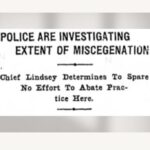 The Chief of Police in Louisville, Kentucky, announced the arrest of at least three people for interracial relations, or miscegenation. He also announced plans to open an investigation into the practice, which would “spare no effort” to prevent people from forming or maintaining interracial romantic relationships in Louisville. Kentucky criminalized interracial marriages from the year it was admitted into the Union in 1792. In 1916, state law made it illegal for a Black person—defined by the Kentucky Supreme Court as a person with “one–fourth part or more of Negro blood”—to marry or live with a white person. Those found in violation of the law faced a fine of up to $5,000 and up to a year in jail. Black people charged with miscegenation faced dehumanizing treatment by law enforcement, and investigations and court proceedings were often humiliating and intrusive. Learn more. The Chief of Police in Louisville, Kentucky, announced the arrest of at least three people for interracial relations, or miscegenation. He also announced plans to open an investigation into the practice, which would “spare no effort” to prevent people from forming or maintaining interracial romantic relationships in Louisville. Kentucky criminalized interracial marriages from the year it was admitted into the Union in 1792. In 1916, state law made it illegal for a Black person—defined by the Kentucky Supreme Court as a person with “one–fourth part or more of Negro blood”—to marry or live with a white person. Those found in violation of the law faced a fine of up to $5,000 and up to a year in jail. Black people charged with miscegenation faced dehumanizing treatment by law enforcement, and investigations and court proceedings were often humiliating and intrusive. Learn more. | |
| July 28, 1917 | 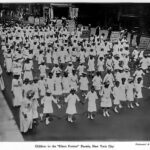 The Negro Silent Protest Parade, commonly known as the Silent Parade, a silent march of about 10,000 African Americans along Fifth Avenue starting at 57th Street takes place in New York City. The event was organized by the NAACP, church, and community leaders to protest violence directed towards African Americans, such as recent lynchings in Waco and Memphis. The parade was precipitated by the East St. Louis riots in May and July 1917 where at least 40 black people were killed by white mobs, in part touched off by a labor dispute where blacks were used for strike breaking. Learn more. The Negro Silent Protest Parade, commonly known as the Silent Parade, a silent march of about 10,000 African Americans along Fifth Avenue starting at 57th Street takes place in New York City. The event was organized by the NAACP, church, and community leaders to protest violence directed towards African Americans, such as recent lynchings in Waco and Memphis. The parade was precipitated by the East St. Louis riots in May and July 1917 where at least 40 black people were killed by white mobs, in part touched off by a labor dispute where blacks were used for strike breaking. Learn more. | |
| July 29, 1880 | 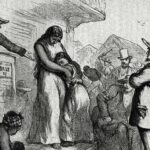 The Philadelphia-based newspaper, The Christian Recorder, publishes a plea from a Black woman named Nancy Williams. Nearly fifteen years after the abolition of chattel slavery in the United States, Ms. Williams ran an ad seeking information about her daughters Millie and Mary, from whom she was sold away in 1860 while enslaved in Missouri. Approximately half of enslaved people were separated from a spouse or parent during the Domestic Slave Trade. The particularly cruel practice of separating children from parents prioritized the desire for money and power that fueled the slave trade in the United States. Ms. Williams’s ad shares the ages of her daughters when she was parted from them: Millie, the oldest, was nine years old, while Mary was six years old. “It will be twenty years in October since I saw them,” Ms. Williams wrote, “and I would be more than glad to hear from them.” Learn more. The Philadelphia-based newspaper, The Christian Recorder, publishes a plea from a Black woman named Nancy Williams. Nearly fifteen years after the abolition of chattel slavery in the United States, Ms. Williams ran an ad seeking information about her daughters Millie and Mary, from whom she was sold away in 1860 while enslaved in Missouri. Approximately half of enslaved people were separated from a spouse or parent during the Domestic Slave Trade. The particularly cruel practice of separating children from parents prioritized the desire for money and power that fueled the slave trade in the United States. Ms. Williams’s ad shares the ages of her daughters when she was parted from them: Millie, the oldest, was nine years old, while Mary was six years old. “It will be twenty years in October since I saw them,” Ms. Williams wrote, “and I would be more than glad to hear from them.” Learn more. | |
| July 29, 1909 | 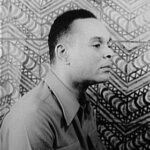 American author Chester Bomar Himes is born. His works, some of which have been filmed, include If He Hollers Let Him Go, published in 1945, and the Harlem Detective series of novels for which he is best known, set in the 1950s and early 1960s and featuring two black policemen called Grave Digger Jones and Coffin Ed Johnson. In 1958 Himes won France's Grand Prix de Littérature Policière. Himes’s view of race relations was profoundly shaped when chemicals exploded in his brother Joseph’s face during a classroom demonstration. Rushed to the nearest hospital, the blinded boy was refused treatment because of Jim Crow laws. "That one moment in my life hurt me as much as all the others put together," Himes wrote in The Quality of Hurt. “I loved my brother. I had never been separated from him and that moment was shocking, shattering, and terrifying....We pulled into the emergency entrance of a white people's hospital. White clad doctors and attendants appeared. I remember sitting in the back seat with Joe watching the pantomime being enacted in the car's bright lights. A white man was refusing; my father was pleading. Dejectedly my father turned away; he was crying like a baby. My mother was fumbling in her handbag for a handkerchief; I hoped it was for a pistol.” Learn more. American author Chester Bomar Himes is born. His works, some of which have been filmed, include If He Hollers Let Him Go, published in 1945, and the Harlem Detective series of novels for which he is best known, set in the 1950s and early 1960s and featuring two black policemen called Grave Digger Jones and Coffin Ed Johnson. In 1958 Himes won France's Grand Prix de Littérature Policière. Himes’s view of race relations was profoundly shaped when chemicals exploded in his brother Joseph’s face during a classroom demonstration. Rushed to the nearest hospital, the blinded boy was refused treatment because of Jim Crow laws. "That one moment in my life hurt me as much as all the others put together," Himes wrote in The Quality of Hurt. “I loved my brother. I had never been separated from him and that moment was shocking, shattering, and terrifying....We pulled into the emergency entrance of a white people's hospital. White clad doctors and attendants appeared. I remember sitting in the back seat with Joe watching the pantomime being enacted in the car's bright lights. A white man was refusing; my father was pleading. Dejectedly my father turned away; he was crying like a baby. My mother was fumbling in her handbag for a handkerchief; I hoped it was for a pistol.” Learn more. | |
| July 29, 1910 |  The Slocum Massacre begins as white mobs roam freely through the predominantly Black community of Slocum, Texas, shooting and attacking as they encounter African Americans. Only six deaths were officially confirmed, but it is estimated as many as one hundred African Americans lost their lives in the massacre. Historians have provided several explanations for the motives of the all-white perpetrators of the massacre. When the story spread, it was altered to favor the white suspects and the Black residents of Slocum were blamed. The whites from the mob did their best to destroy any evidence against them. African Americans reached out to higher levels of government for a fair investigation, but little to nothing was done on their behalf. As a result, the African American population in Slocum, Texas declined drastically. Learn more. The Slocum Massacre begins as white mobs roam freely through the predominantly Black community of Slocum, Texas, shooting and attacking as they encounter African Americans. Only six deaths were officially confirmed, but it is estimated as many as one hundred African Americans lost their lives in the massacre. Historians have provided several explanations for the motives of the all-white perpetrators of the massacre. When the story spread, it was altered to favor the white suspects and the Black residents of Slocum were blamed. The whites from the mob did their best to destroy any evidence against them. African Americans reached out to higher levels of government for a fair investigation, but little to nothing was done on their behalf. As a result, the African American population in Slocum, Texas declined drastically. Learn more. | |
| July 29, 1988 |  Haben Girma, a disability rights advocate and attorney who became the first deaf and blind graduate of Harvard Law School in Massachusetts when she graduated with a Juris Doctor degree (JD) in 2013, is born in Oakland, California to her mother, Saba Gebreyesus, who was a refugee from Eritrea. Girma was educated in the Oakland Public Schools where she benefited from the Americans with Disabilities Act of 1990, a civil rights law that outlawed discrimination based on disability. Girma learned braille while in school using a digital technology device that helped her read and absorb information faster than with the previous generations of Braille readers. Learn more. Haben Girma, a disability rights advocate and attorney who became the first deaf and blind graduate of Harvard Law School in Massachusetts when she graduated with a Juris Doctor degree (JD) in 2013, is born in Oakland, California to her mother, Saba Gebreyesus, who was a refugee from Eritrea. Girma was educated in the Oakland Public Schools where she benefited from the Americans with Disabilities Act of 1990, a civil rights law that outlawed discrimination based on disability. Girma learned braille while in school using a digital technology device that helped her read and absorb information faster than with the previous generations of Braille readers. Learn more. | |
| July 30, 1822 | 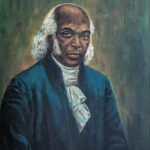 Ordained Methodist elder James Varrick is consecrated as the first bishop of the African Methodist Episcopal Zion Church. Learn more. Ordained Methodist elder James Varrick is consecrated as the first bishop of the African Methodist Episcopal Zion Church. Learn more. | |
| July 30, 1866 | 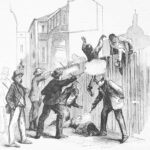 Conservative white Democrats commit the New Orleans Massacre of 1866 in order to stop white and Black Republicans who had reconvened the state Constitutional Convention in an effort to overturn the Black Codes that Louisiana Democrats had recently-enacted to maintain the disenfranchisement of African Americans. The attrocities began when a peaceful demonstration of mostly Black Freedmen outside the Mechanics Institute (the convention site) was set upon by a mob of white rioters, many of whom had been soldiers of the recently defeated Confederate States of America. “The whites stomped, kicked, and clubbed the black marchers mercilessly. Policemen smashed the institute’s windows and fired into it indiscriminately until the floor grew slick with blood. They emptied their revolvers on the convention delegates, who desperately sought to escape. Some leaped from windows and were shot dead when they landed. Those lying wounded on the ground were stabbed repeatedly, their skulls bashed in with brickbats. The sadism was so wanton that men who kneeled and prayed for mercy were killed instantly, while dead bodies were stabbed and mutilated.” Ron Chernow, "Grant" (2017). According to the official report, a total of 38 were killed and 146 wounded, with 34 of the dead and 119 of the wounded black. Unofficial estimates were higher. Gilles Vandal estimated 40 to 50 blacks dead and more than 150 wounded. In addition, three white convention attendees were killed, as was one white demonstrator. Learn more. Conservative white Democrats commit the New Orleans Massacre of 1866 in order to stop white and Black Republicans who had reconvened the state Constitutional Convention in an effort to overturn the Black Codes that Louisiana Democrats had recently-enacted to maintain the disenfranchisement of African Americans. The attrocities began when a peaceful demonstration of mostly Black Freedmen outside the Mechanics Institute (the convention site) was set upon by a mob of white rioters, many of whom had been soldiers of the recently defeated Confederate States of America. “The whites stomped, kicked, and clubbed the black marchers mercilessly. Policemen smashed the institute’s windows and fired into it indiscriminately until the floor grew slick with blood. They emptied their revolvers on the convention delegates, who desperately sought to escape. Some leaped from windows and were shot dead when they landed. Those lying wounded on the ground were stabbed repeatedly, their skulls bashed in with brickbats. The sadism was so wanton that men who kneeled and prayed for mercy were killed instantly, while dead bodies were stabbed and mutilated.” Ron Chernow, "Grant" (2017). According to the official report, a total of 38 were killed and 146 wounded, with 34 of the dead and 119 of the wounded black. Unofficial estimates were higher. Gilles Vandal estimated 40 to 50 blacks dead and more than 150 wounded. In addition, three white convention attendees were killed, as was one white demonstrator. Learn more. | |
| July 30, 1903 | 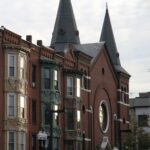 A contest erupts between the Boston newspaper editor William Monroe Trotter and Tuskegee Institute’s Principal (President) Booker T. Washington, and their respective supporters, at the Columbus Avenue African Methodist Episcopal Zion Church (A.M.E. Zion) in Boston, Massachusetts. Trotter had been critical of Washington’s more accommodationist stance for some time. When word got out that the National Negro Business League’s Boston Branch was holding its meeting at the Columbus Avenue Church and would feature Washington, a large crowd assembled, anticipating conflict. Supporters of Washington and Trotter clashed after Trotter disrupted the proceedings, asking Washington nine contentious questions. Disorder ensued, some sustained injuries, and Trotter and two others were ultimately arrested. The incident was formative in the development of the Niagara Movement, a more assertive civil rights group headed by Trotter and W.E.B. DuBois. The reaction to the incident cemented DuBois as a member of Niagara although he was not present at A.M.E. Zion. It also hoisted Trotter to center stage as a symbol of opposition to the “Tuskegee Machine” in the African American community. Learn more.
A contest erupts between the Boston newspaper editor William Monroe Trotter and Tuskegee Institute’s Principal (President) Booker T. Washington, and their respective supporters, at the Columbus Avenue African Methodist Episcopal Zion Church (A.M.E. Zion) in Boston, Massachusetts. Trotter had been critical of Washington’s more accommodationist stance for some time. When word got out that the National Negro Business League’s Boston Branch was holding its meeting at the Columbus Avenue Church and would feature Washington, a large crowd assembled, anticipating conflict. Supporters of Washington and Trotter clashed after Trotter disrupted the proceedings, asking Washington nine contentious questions. Disorder ensued, some sustained injuries, and Trotter and two others were ultimately arrested. The incident was formative in the development of the Niagara Movement, a more assertive civil rights group headed by Trotter and W.E.B. DuBois. The reaction to the incident cemented DuBois as a member of Niagara although he was not present at A.M.E. Zion. It also hoisted Trotter to center stage as a symbol of opposition to the “Tuskegee Machine” in the African American community. Learn more. | |
| July 31, 1873 | 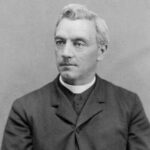 Patrick Francis Healy SJ, an American Catholic priest and Jesuit, is appointed president of Georgetown University. Though he passed as white after his father sent he and his brothers north for their educations, Healy was of mixed race and was born in Georgia as legally enslaved to his father (as were his mother and siblings) under that state’s laws. Healy would be posthumously recognized as the first African American to become a Jesuit, earn a Ph.D., and become the president of a predominantly white university. As president of Georgetown, Healy oversaw a period of growth and transformed the institution into a modern university, becoming known in later years as its "second founder". He increased the prominence of the sciences, raised the standards of the School of Medicine, and oversaw rapid expansion of the Law School. He also constructed a grand flagship building that became known as Healy Hall. Learn more. Patrick Francis Healy SJ, an American Catholic priest and Jesuit, is appointed president of Georgetown University. Though he passed as white after his father sent he and his brothers north for their educations, Healy was of mixed race and was born in Georgia as legally enslaved to his father (as were his mother and siblings) under that state’s laws. Healy would be posthumously recognized as the first African American to become a Jesuit, earn a Ph.D., and become the president of a predominantly white university. As president of Georgetown, Healy oversaw a period of growth and transformed the institution into a modern university, becoming known in later years as its "second founder". He increased the prominence of the sciences, raised the standards of the School of Medicine, and oversaw rapid expansion of the Law School. He also constructed a grand flagship building that became known as Healy Hall. Learn more. | |
| July 31, 1919 | 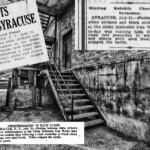 The Syracuse Riot of 1919, a violent racial attack, occurs when the management of the Globe Malleable Iron Works pitted striking white unionized workers against Black strikebreakers in Syracuse, New York. Labor unions were not integrated, so African Americans found themselves excluded from union jobs (and the relatively higher pay they brought) in the Northern industrial communities to which they migrated. During strikes, large companies throughout the nation turned to these Black laborers as a source of cheaper labor, to avoid giving their white workers more money, and with the hope of pitting the two groups against one another to weaken the labor movement. The result was a series of attacks by white workers on Black strikebreakers throughout the US, including in the ironworks at Syracuse. Learn more. The Syracuse Riot of 1919, a violent racial attack, occurs when the management of the Globe Malleable Iron Works pitted striking white unionized workers against Black strikebreakers in Syracuse, New York. Labor unions were not integrated, so African Americans found themselves excluded from union jobs (and the relatively higher pay they brought) in the Northern industrial communities to which they migrated. During strikes, large companies throughout the nation turned to these Black laborers as a source of cheaper labor, to avoid giving their white workers more money, and with the hope of pitting the two groups against one another to weaken the labor movement. The result was a series of attacks by white workers on Black strikebreakers throughout the US, including in the ironworks at Syracuse. Learn more. | |
| August 1, 1842 | 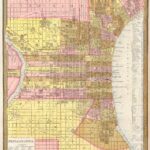 The Lombard Street Riot, three days of mob violence against African Americans in Philadelphia, Pennsylvania, begins. That morning, the Young Men's Vigilant Association, an African American organization, held a parade on Philadelphia's Lombard Street between Fifth and Eighth streets to commemorate of the eighth anniversary of the end of slavery in the British West Indies. As the paraders neared Mother Bethel African Methodist Episcopal Church, they were attacked by an Irish Catholic mob. The Irish rioters moved west, setting fires and attacking firefighters and police as they went, heading for the home of African-American leader Robert Purvis; Purvis and his home were reportedly saved from the Irish mob solely by a Catholic priest's intervention. Requests to the mayor and police for protection initially led to the arrest of several of the victims and none of the rioters. Over three days of attacks, the Second African American Presbyterian Church (on St. Mary's Street near Sixth Street), the abolitionist Smith's Hall, and numerous homes and public buildings were looted, burned and mostly destroyed. The mayor had credible evidence of a plan to burn several local churches, which he ignored. Eventually, as the rioting began to subside, the local militia was brought in to restore order. Learn more. The Lombard Street Riot, three days of mob violence against African Americans in Philadelphia, Pennsylvania, begins. That morning, the Young Men's Vigilant Association, an African American organization, held a parade on Philadelphia's Lombard Street between Fifth and Eighth streets to commemorate of the eighth anniversary of the end of slavery in the British West Indies. As the paraders neared Mother Bethel African Methodist Episcopal Church, they were attacked by an Irish Catholic mob. The Irish rioters moved west, setting fires and attacking firefighters and police as they went, heading for the home of African-American leader Robert Purvis; Purvis and his home were reportedly saved from the Irish mob solely by a Catholic priest's intervention. Requests to the mayor and police for protection initially led to the arrest of several of the victims and none of the rioters. Over three days of attacks, the Second African American Presbyterian Church (on St. Mary's Street near Sixth Street), the abolitionist Smith's Hall, and numerous homes and public buildings were looted, burned and mostly destroyed. The mayor had credible evidence of a plan to burn several local churches, which he ignored. Eventually, as the rioting began to subside, the local militia was brought in to restore order. Learn more. | |
| August 1, 1920 | 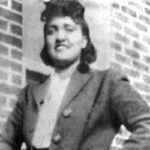 Henrietta Lacks, an African-American woman whose cancer cells are the source of the most important cell line in medical research, is born. Lacks was the unwitting source of these cells from a tumor biopsied during treatment for cervical cancer at Johns Hopkins Hospital in Baltimore, Maryland, in 1951 (Lacks died later that same year). The cells were cultured by George Otto Gey to create the cell line known as HeLa, which is still used for medical research. As was then the practice, no consent was obtained to culture the cells obtained from Lacks's treatment and neither she nor her family were compensated for their extraction or use. The Lacks family was not made aware of the line's existence until 1975. With knowledge of the cell line's genetic provenance becoming public, its use for medical research and for commercial purposes continues to raise concerns about privacy and patients' rights. Learn more. Henrietta Lacks, an African-American woman whose cancer cells are the source of the most important cell line in medical research, is born. Lacks was the unwitting source of these cells from a tumor biopsied during treatment for cervical cancer at Johns Hopkins Hospital in Baltimore, Maryland, in 1951 (Lacks died later that same year). The cells were cultured by George Otto Gey to create the cell line known as HeLa, which is still used for medical research. As was then the practice, no consent was obtained to culture the cells obtained from Lacks's treatment and neither she nor her family were compensated for their extraction or use. The Lacks family was not made aware of the line's existence until 1975. With knowledge of the cell line's genetic provenance becoming public, its use for medical research and for commercial purposes continues to raise concerns about privacy and patients' rights. Learn more. | |
| August 1, 1944 | 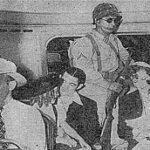 White employees of the Philadelphia Transit Company (PTC) launch a strike and demand the company reverse its recent decision to promote eight Black workers to the position of trolley driver—a job previously reserved for white men. The strike grew to include over 6,000 workers, prevented nearly two million people from traveling, cost businesses almost $1 million per day, and crippled critical WWII war-time production. President Roosevelt authorized the War Department to take control of the PTC and U.S. Army troops moved into Philadelphia to prevent uprisings and protect PTC employees who crossed the picket line. Learn more. White employees of the Philadelphia Transit Company (PTC) launch a strike and demand the company reverse its recent decision to promote eight Black workers to the position of trolley driver—a job previously reserved for white men. The strike grew to include over 6,000 workers, prevented nearly two million people from traveling, cost businesses almost $1 million per day, and crippled critical WWII war-time production. President Roosevelt authorized the War Department to take control of the PTC and U.S. Army troops moved into Philadelphia to prevent uprisings and protect PTC employees who crossed the picket line. Learn more. | |
| August 1, 1993 | 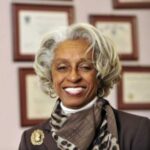 Barbara Ross-Lee, D.O., physician, and academic, becomes the first African-American woman to lead a U.S. medical school when she is appointed dean of Ohio University's Heritage College of Osteopathic Medicine. She majored in biology and chemistry at Wayne State University, graduating in 1965. Then, in 1969, she entered Michigan State University's College of Osteopathic Medicine. Ross-Lee then went on to open her own private family practice, teach as a professor, and hold other positions within the medical community, until 1993 when she was elected as the first woman and first African American woman dean of a medical school. She has earned several awards and honors for her work and accomplishments. Learn more. Barbara Ross-Lee, D.O., physician, and academic, becomes the first African-American woman to lead a U.S. medical school when she is appointed dean of Ohio University's Heritage College of Osteopathic Medicine. She majored in biology and chemistry at Wayne State University, graduating in 1965. Then, in 1969, she entered Michigan State University's College of Osteopathic Medicine. Ross-Lee then went on to open her own private family practice, teach as a professor, and hold other positions within the medical community, until 1993 when she was elected as the first woman and first African American woman dean of a medical school. She has earned several awards and honors for her work and accomplishments. Learn more. | |
| August 2, 1841 |
| |
| August 2, 1900 | 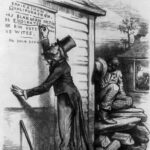 North Carolina voters approve a constitutional amendment requiring residents to pass a literacy test and pay a poll tax in order to register to vote, but exempts registrants with a relative who had voted in an election prior to the year 1863 (when African Americans were enslaved and thus ineligible to vote). By direct design, the amendment effectively disenfranchised most of the state’s African-American population while preserving voting rights for most of the state’s poor and uneducated white residents. Typical of the campaign events in the run up to the vote was an exhortation by judicial candidate and former Confederate officer William A. Guthrie to a crowd of over 12,000: “The amendment will pass and the negro curbed in every part of the state. Good government will be restored everywhere. Then our ladies can walk the streets of our towns in safety, day or night. White women will not be afraid to go about alone in the country. We will teach the colored race that our people must be respected. We have restrained and conquered other races. They obeyed our demands or were exterminated with the sword. We are at a crisis. Let us rise to the occasion. Come together!” Learn more. North Carolina voters approve a constitutional amendment requiring residents to pass a literacy test and pay a poll tax in order to register to vote, but exempts registrants with a relative who had voted in an election prior to the year 1863 (when African Americans were enslaved and thus ineligible to vote). By direct design, the amendment effectively disenfranchised most of the state’s African-American population while preserving voting rights for most of the state’s poor and uneducated white residents. Typical of the campaign events in the run up to the vote was an exhortation by judicial candidate and former Confederate officer William A. Guthrie to a crowd of over 12,000: “The amendment will pass and the negro curbed in every part of the state. Good government will be restored everywhere. Then our ladies can walk the streets of our towns in safety, day or night. White women will not be afraid to go about alone in the country. We will teach the colored race that our people must be respected. We have restrained and conquered other races. They obeyed our demands or were exterminated with the sword. We are at a crisis. Let us rise to the occasion. Come together!” Learn more. | |
| August 2, 1924 | 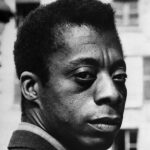 Fiction writer, essayist, dramatist, and poet, James Arthur Baldwin is born in Harlem, New York during the Harlem Renaissance. After graduating from DeWitt Clinton High School in the Bronx in 1942, he began his formal career as a writer. Baldwin was inspired by Richard Wright, despite his being called to the ministry at age fourteen in the Pentecostal faith and church dominated by his father, David Baldwin. Although James Baldwin emerged as a major American literary voice by 1953 when he published his first novel, Go Tell It on the Mountain, his candid and militant essays found in Nobody Knows my Name (1961) and The Fire Next Time (1963) identified his writing with the emerging Civil Rights Movement of the 1960s. Baldwin stood with Dr. Martin Luther King, Jr. at the Lincoln Memorial in 1963, when the civil rights leader delivered his “I Have a Dream” speech. Like John Grimes, the protagonist of his autobiographical novel, Go Tell it on the Mountain, Baldwin struggled with his racial, sexual, and spiritual identities. In his second novel, Giovanni’s Room (1956), he seeks to illustrate through his treatment and characterization of his main characters the validity of homosexual love. Baldwin also unabashedly explores the spectrum and complexity of heterosexual and homosexual love in Another Country (1962). Identifying himself as “a lover born in a loveless world,” Baldwin’s themes of race, sexual orientation, and the multifaceted power of love remained the central focus of his other novels and stories including Going to Meet the Man (1965), Tell Me How Long the Train’s Been Gone (1968), If Beale Street Could Talk (1974), and his last novel, Just Above My Head (1979). Learn more.
Fiction writer, essayist, dramatist, and poet, James Arthur Baldwin is born in Harlem, New York during the Harlem Renaissance. After graduating from DeWitt Clinton High School in the Bronx in 1942, he began his formal career as a writer. Baldwin was inspired by Richard Wright, despite his being called to the ministry at age fourteen in the Pentecostal faith and church dominated by his father, David Baldwin. Although James Baldwin emerged as a major American literary voice by 1953 when he published his first novel, Go Tell It on the Mountain, his candid and militant essays found in Nobody Knows my Name (1961) and The Fire Next Time (1963) identified his writing with the emerging Civil Rights Movement of the 1960s. Baldwin stood with Dr. Martin Luther King, Jr. at the Lincoln Memorial in 1963, when the civil rights leader delivered his “I Have a Dream” speech. Like John Grimes, the protagonist of his autobiographical novel, Go Tell it on the Mountain, Baldwin struggled with his racial, sexual, and spiritual identities. In his second novel, Giovanni’s Room (1956), he seeks to illustrate through his treatment and characterization of his main characters the validity of homosexual love. Baldwin also unabashedly explores the spectrum and complexity of heterosexual and homosexual love in Another Country (1962). Identifying himself as “a lover born in a loveless world,” Baldwin’s themes of race, sexual orientation, and the multifaceted power of love remained the central focus of his other novels and stories including Going to Meet the Man (1965), Tell Me How Long the Train’s Been Gone (1968), If Beale Street Could Talk (1974), and his last novel, Just Above My Head (1979). Learn more. | |
| August 2, 1931 | 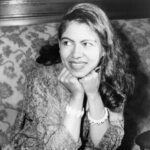 Child prodigy, pianist, author, and journalist Philippa Duke Schuyler is born. The daughter of Black journalist George Schuyler and Josephine Schuyler, a white Texan heiress, Schuyler became famous in the 1930s as a result of her talent, intellect, mixed race parentage, and the eccentric methods employed by her parents to bring her up. Hailed as "the Shirley Temple of American Negroes," Schuyler was a noted pianist performing public recitals and radio broadcasts by the age of four. She performed two piano recitals at the New York World's Fair at the age of eight. Schuyler won numerous music competitions such as the New York Philharmonic Young People's Concerts at Carnegie Hall. She became the youngest member of the National Association for American Composers and Conductors at age eleven. Schuyler encountered racism as she grew older, and had trouble coming to terms with her mixed race heritage. She later became a journalist and was killed in a helicopter crash in South Vietnam in 1967. Learn more. Child prodigy, pianist, author, and journalist Philippa Duke Schuyler is born. The daughter of Black journalist George Schuyler and Josephine Schuyler, a white Texan heiress, Schuyler became famous in the 1930s as a result of her talent, intellect, mixed race parentage, and the eccentric methods employed by her parents to bring her up. Hailed as "the Shirley Temple of American Negroes," Schuyler was a noted pianist performing public recitals and radio broadcasts by the age of four. She performed two piano recitals at the New York World's Fair at the age of eight. Schuyler won numerous music competitions such as the New York Philharmonic Young People's Concerts at Carnegie Hall. She became the youngest member of the National Association for American Composers and Conductors at age eleven. Schuyler encountered racism as she grew older, and had trouble coming to terms with her mixed race heritage. She later became a journalist and was killed in a helicopter crash in South Vietnam in 1967. Learn more. | |
| August 2, 2012 |  Gabrielle Christina Victoria “Gabby” Douglas becomes the first African American Woman to win a gold medal in the gymnastic individual all around championship at the 2012 Summer Olympics in London, England. She is also the first American gymnast to win the gold in individual all around and team competitions at the same Olympic Games. Prior to the 2012 Olympics, Douglas won a Team Gold at the 2011 World Championships. Douglas became the first gymnast to be named Female Athlete of the Year by the Associated Press in December of 2012. Learn more. Gabrielle Christina Victoria “Gabby” Douglas becomes the first African American Woman to win a gold medal in the gymnastic individual all around championship at the 2012 Summer Olympics in London, England. She is also the first American gymnast to win the gold in individual all around and team competitions at the same Olympic Games. Prior to the 2012 Olympics, Douglas won a Team Gold at the 2011 World Championships. Douglas became the first gymnast to be named Female Athlete of the Year by the Associated Press in December of 2012. Learn more. | |
| August 3, 1798 | 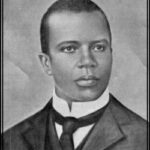 Kwaku Walker Lewis, an early African-American abolitionist and Freemason from Massachusetts, is born, He was an active member of the Underground Railroad and the anti-slavery movement. Lewis, who had worshipped with the Episcopal Church, converted to the Church of Jesus Christ of Latter Day Saints and in the summer of 1843, was ordained an elder (priest) by William Smith, brother of founder Joseph Smith. Lewis became the third Black man known to hold the Mormon priesthood. He migrated to Salt Lake City, but left after 6 months in response to the church’s banning of Black elders/priests and legislation that opened the state to slavery and implemented anti-miscegenation laws. Learn more. Kwaku Walker Lewis, an early African-American abolitionist and Freemason from Massachusetts, is born, He was an active member of the Underground Railroad and the anti-slavery movement. Lewis, who had worshipped with the Episcopal Church, converted to the Church of Jesus Christ of Latter Day Saints and in the summer of 1843, was ordained an elder (priest) by William Smith, brother of founder Joseph Smith. Lewis became the third Black man known to hold the Mormon priesthood. He migrated to Salt Lake City, but left after 6 months in response to the church’s banning of Black elders/priests and legislation that opened the state to slavery and implemented anti-miscegenation laws. Learn more. | |
| August 3, 1897 | 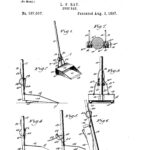 Lloyd P. Ray secures U.S. Patent No. 587,607 for his invention of an improved dustpan. Ray was born into slavery just before the start of the civil war. Learn more. Lloyd P. Ray secures U.S. Patent No. 587,607 for his invention of an improved dustpan. Ray was born into slavery just before the start of the civil war. Learn more. | |
| August 3, 1919 |  Five days of racial violence, gunfire, beatings, and burnings targeting Black communities in Chicago, Illinois, finally come to an end after intervention by the state militia. Overall, 15 white people and 23 African Americans had been killed, 537 people injured, and 1,000 African American families were left homeless. During those five terrifying days, white mobs attacked Black people on sight, set fire to more than 30 properties on Chicago’s south side, and even attempted to attack Provident Hospital—which served mostly Black patients. Though state officials announced a plan to investigate and punish all parties responsible for violence and destruction of property during the unrest, many more Black people were arrested and indicted than white. The city's police chief admitted this was due to bias in his department of white officers, “There is no doubt that a great many police officers were grossly unfair in making arrests," he said in 1922. "They shut their eyes to offenses committed by white men while they were very vigorous in getting all the colored men they could get." Learn more. Five days of racial violence, gunfire, beatings, and burnings targeting Black communities in Chicago, Illinois, finally come to an end after intervention by the state militia. Overall, 15 white people and 23 African Americans had been killed, 537 people injured, and 1,000 African American families were left homeless. During those five terrifying days, white mobs attacked Black people on sight, set fire to more than 30 properties on Chicago’s south side, and even attempted to attack Provident Hospital—which served mostly Black patients. Though state officials announced a plan to investigate and punish all parties responsible for violence and destruction of property during the unrest, many more Black people were arrested and indicted than white. The city's police chief admitted this was due to bias in his department of white officers, “There is no doubt that a great many police officers were grossly unfair in making arrests," he said in 1922. "They shut their eyes to offenses committed by white men while they were very vigorous in getting all the colored men they could get." Learn more. | |
| August 3, 1936 | 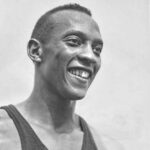 Track and field star Jesse Owens wins the first of his four gold medals in the 1936 Berlin Olympic Games. He was the most successful athlete at the Games and, as a Black man, was credited with "single-handedly crushing Hitler's myth of Aryan supremacy", although he "wasn't invited to the White House to shake hands with the President, either". Learn more. Track and field star Jesse Owens wins the first of his four gold medals in the 1936 Berlin Olympic Games. He was the most successful athlete at the Games and, as a Black man, was credited with "single-handedly crushing Hitler's myth of Aryan supremacy", although he "wasn't invited to the White House to shake hands with the President, either". Learn more. | |
| August 4, 1810 | 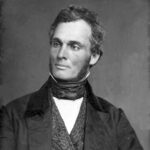 American abolitionist Robert Purvis is born in Charleston, South Carolina. He spent most of his life in Philadelphia, Pennsylvania. In 1833 he helped found the American Anti-Slavery Society and the Library Company of Colored People. From 1845–1850 he served as president of the Pennsylvania Anti-Slavery Society and also traveled to Britain to gain support for the movement. Of mixed race, Purvis and his brothers were three-quarters European by ancestry and inherited considerable wealth from their native British father after his death in 1826. Purvis's parents had lived in common law marriage, prevented from marrying because his mother was a free woman of color, of Moroccan and Jewish descent. The sons chose to identify with the Black community and used their education and wealth to support abolition of slavery and anti-slavery activities, as well as projects in education to help the advance of African Americans. Learn more. American abolitionist Robert Purvis is born in Charleston, South Carolina. He spent most of his life in Philadelphia, Pennsylvania. In 1833 he helped found the American Anti-Slavery Society and the Library Company of Colored People. From 1845–1850 he served as president of the Pennsylvania Anti-Slavery Society and also traveled to Britain to gain support for the movement. Of mixed race, Purvis and his brothers were three-quarters European by ancestry and inherited considerable wealth from their native British father after his death in 1826. Purvis's parents had lived in common law marriage, prevented from marrying because his mother was a free woman of color, of Moroccan and Jewish descent. The sons chose to identify with the Black community and used their education and wealth to support abolition of slavery and anti-slavery activities, as well as projects in education to help the advance of African Americans. Learn more. | |
| August 4, 1913 | 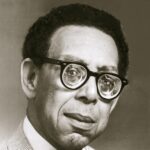 Poet, essayist, and educator Robert Hayden is born in Detroit, Michigan. Hayden grew up in Detroit and attended Detroit City College (now Wayne State University; B.A., 1936). He joined the Federal Writers’ Project, researching Black folklore and the history of the Underground Railroad in Michigan. His first collection of poems, Heart-Shape in the Dust, was published in 1940. While a graduate student at the University of Michigan (M.A., 1944), he studied poetry with W.H. Auden. He served as Consultant in Poetry to the Library of Congress from 1976 to 1978, a role today known as US Poet Laureate. He was the first African-American writer to hold the office. Learn more. Poet, essayist, and educator Robert Hayden is born in Detroit, Michigan. Hayden grew up in Detroit and attended Detroit City College (now Wayne State University; B.A., 1936). He joined the Federal Writers’ Project, researching Black folklore and the history of the Underground Railroad in Michigan. His first collection of poems, Heart-Shape in the Dust, was published in 1940. While a graduate student at the University of Michigan (M.A., 1944), he studied poetry with W.H. Auden. He served as Consultant in Poetry to the Library of Congress from 1976 to 1978, a role today known as US Poet Laureate. He was the first African-American writer to hold the office. Learn more. | |
| August 4, 1948 |  Photographer, scholar, and artist Leo Antony “Tony” Gleaton is born in Detroit, Michigan. Gleason is best known for his photographic images capturing and documenting the African influence in the American West and Central and South America. Gleaton played football in high school and briefly at East Los Angeles Junior College before joining the U.S. Marine Corps in 1967. While on his first tour of duty in Vietnam, he became fascinated with the camera. In 1980 he hitchhiked throughout the American West. His photographic ventures in Texas, Colorado, Nevada, Idaho, and Kansas formed the essence of his project titled Cowboys: Reconstructing an American Myth. This collection featured a series of portraits of African, Native, Mexican, and Euro-American cowboys. From 1986 to 1992, Gleaton resided with the Tarahumara Indians in northern Mexico and then moved to Guerrero and Oaxaca. Here, Gleaton began what is now his most famous project, Tengo Casi 500 Años: Africa’s Legacy in Mexico, Central & South America. In 2002 Gleaton became a visiting professor of photography at Texas Tech University. That same year, he finished a Master’s in Art at Bard College. In 2004 Gleaton became a scholar in residence for the Texas Tech Southwest Collection/Special Collections Library in Lubbock, Texas. The collection houses the Tony Gleaton Archive. Learn more. Photographer, scholar, and artist Leo Antony “Tony” Gleaton is born in Detroit, Michigan. Gleason is best known for his photographic images capturing and documenting the African influence in the American West and Central and South America. Gleaton played football in high school and briefly at East Los Angeles Junior College before joining the U.S. Marine Corps in 1967. While on his first tour of duty in Vietnam, he became fascinated with the camera. In 1980 he hitchhiked throughout the American West. His photographic ventures in Texas, Colorado, Nevada, Idaho, and Kansas formed the essence of his project titled Cowboys: Reconstructing an American Myth. This collection featured a series of portraits of African, Native, Mexican, and Euro-American cowboys. From 1986 to 1992, Gleaton resided with the Tarahumara Indians in northern Mexico and then moved to Guerrero and Oaxaca. Here, Gleaton began what is now his most famous project, Tengo Casi 500 Años: Africa’s Legacy in Mexico, Central & South America. In 2002 Gleaton became a visiting professor of photography at Texas Tech University. That same year, he finished a Master’s in Art at Bard College. In 2004 Gleaton became a scholar in residence for the Texas Tech Southwest Collection/Special Collections Library in Lubbock, Texas. The collection houses the Tony Gleaton Archive. Learn more. | |
| August 4, 1950 |  Novelist, poet, and performance artist Ramona Lofton, better known as Sapphire, is born on August 4, 1950 in Fort Ord, California, the second oldest of four children born to military parents. Her father was an army sergeant and her mother was a soldier in the Women’s Army Corps. Throughout her childhood, her family maintained a middle-class façade while hiding incest and alcoholism. Lofton dropped out of high school, but eventually attended the City College of New York, majored in modern dance and graduated with honors in 1993; she obtained a master degree in fine arts in 1995 from Brooklyn College. In the 1980s, Lofton adopted the stage name Sapphire and immersed herself in the Slam Poetry movement emerging in New York City. She also became a member of the United Lesbians of Color for Change, Inc., a nonprofit organization in New York. She gained prominence for her 1996 debut novel, Push, and other works that focus on the alarming realities of inner city life; in 2009, Push became a widely acclaimed film directed by Lee Daniels. Learn more. Novelist, poet, and performance artist Ramona Lofton, better known as Sapphire, is born on August 4, 1950 in Fort Ord, California, the second oldest of four children born to military parents. Her father was an army sergeant and her mother was a soldier in the Women’s Army Corps. Throughout her childhood, her family maintained a middle-class façade while hiding incest and alcoholism. Lofton dropped out of high school, but eventually attended the City College of New York, majored in modern dance and graduated with honors in 1993; she obtained a master degree in fine arts in 1995 from Brooklyn College. In the 1980s, Lofton adopted the stage name Sapphire and immersed herself in the Slam Poetry movement emerging in New York City. She also became a member of the United Lesbians of Color for Change, Inc., a nonprofit organization in New York. She gained prominence for her 1996 debut novel, Push, and other works that focus on the alarming realities of inner city life; in 2009, Push became a widely acclaimed film directed by Lee Daniels. Learn more. | |
| August 4, 1964 | 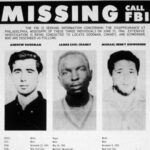 Following several weeks of national news coverage and an intensive search by federal authorities, the bodies of Michael Schwerner, James Chaney, and Andrew Goodman, all three civil rights workers with the Congress of Racial Equality (CORE), are found in Longdale, Mississippi. The three men, who went missing after being released from a local Mississippi jail, had been shot to death and buried in a shallow grave. They had been arrested on “traffic charges” by Neshoba County Deputy Sheriff Cecil Price, a member of the Ku Klux Klan. Price held the three men until other Klansmen could arrive. The three civil rights workers were not seen alive again. While their disappearance resulted in national news stories, Michael Schwerner’s wife and fellow-CORE worker, Rita, admonished reporters in 1964: “The slaying of a Negro in Mississippi is not news. It is only because my husband and Andrew Goodman were white that the national alarm has been sounded.” Indeed, investigators searching Mississippi’s woods, fields, swamps, and rivers that summer found the remains of eight African American men: Henry Dee and Charles Moore, college students who were kidnapped, beaten, and murdered in May 1964; and six unidentified corpses, including one wearing a CORE T-shirt. Learn more. Following several weeks of national news coverage and an intensive search by federal authorities, the bodies of Michael Schwerner, James Chaney, and Andrew Goodman, all three civil rights workers with the Congress of Racial Equality (CORE), are found in Longdale, Mississippi. The three men, who went missing after being released from a local Mississippi jail, had been shot to death and buried in a shallow grave. They had been arrested on “traffic charges” by Neshoba County Deputy Sheriff Cecil Price, a member of the Ku Klux Klan. Price held the three men until other Klansmen could arrive. The three civil rights workers were not seen alive again. While their disappearance resulted in national news stories, Michael Schwerner’s wife and fellow-CORE worker, Rita, admonished reporters in 1964: “The slaying of a Negro in Mississippi is not news. It is only because my husband and Andrew Goodman were white that the national alarm has been sounded.” Indeed, investigators searching Mississippi’s woods, fields, swamps, and rivers that summer found the remains of eight African American men: Henry Dee and Charles Moore, college students who were kidnapped, beaten, and murdered in May 1964; and six unidentified corpses, including one wearing a CORE T-shirt. Learn more. | |
| August 5, 1938 | 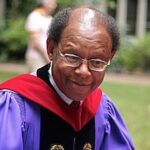 Theologian James Hal Cone, best known for his advocacy of Black theology and Black liberation theology, is born. His 1969 book Black Theology and Black Power provided a new way to comprehensively define the distinctiveness of theology in the Black church. His message was that Black Power, defined as Black people asserting the humanity that white supremacy denied, was the gospel in America. Jesus came to liberate the oppressed, advocating the same thing as Black Power. He argued that white American churches preached a gospel based on white supremacy, antithetical to the gospel of Jesus. Cone's work was influential from the time of the book's publication, and his work remains influential today. His work has been both used and critiqued inside and outside the African-American theological community. He was the Charles Augustus Briggs Distinguished Professor of Systematic Theology at Columbia University-affiliated Union Theological Seminary until his death. Learn more. Theologian James Hal Cone, best known for his advocacy of Black theology and Black liberation theology, is born. His 1969 book Black Theology and Black Power provided a new way to comprehensively define the distinctiveness of theology in the Black church. His message was that Black Power, defined as Black people asserting the humanity that white supremacy denied, was the gospel in America. Jesus came to liberate the oppressed, advocating the same thing as Black Power. He argued that white American churches preached a gospel based on white supremacy, antithetical to the gospel of Jesus. Cone's work was influential from the time of the book's publication, and his work remains influential today. His work has been both used and critiqued inside and outside the African-American theological community. He was the Charles Augustus Briggs Distinguished Professor of Systematic Theology at Columbia University-affiliated Union Theological Seminary until his death. Learn more. | |
| August 5, 1953 | 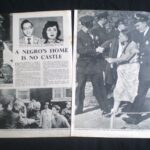 The nearly decade-long cycle of anti-Black riots in the Chicago Housing Authority’s (CHA) Trumbull Park Homes is ignited, as white residents attack the home of Betty Howard with rocks and fireworks, with police doing little to stop them. The attacks continued for weeks, and recurred over years. Trumbull Park is a public housing project located in the South Deering neighborhood on the Far-South Side of Chicago, Illinois. Built in 1938, it consists of 55 buildings and 434 apartments. CHA had moved Ms. Howard and her family into the project — the first African Anerican family to reside in Trumbull Park — six days before, on July 30. In October 1953, the CHA decided to move 10 more Black families in, sparking a new wave of violence. It was not until 1963 that Blacks could go to the neighborhood park without police protection. Learn more. The nearly decade-long cycle of anti-Black riots in the Chicago Housing Authority’s (CHA) Trumbull Park Homes is ignited, as white residents attack the home of Betty Howard with rocks and fireworks, with police doing little to stop them. The attacks continued for weeks, and recurred over years. Trumbull Park is a public housing project located in the South Deering neighborhood on the Far-South Side of Chicago, Illinois. Built in 1938, it consists of 55 buildings and 434 apartments. CHA had moved Ms. Howard and her family into the project — the first African Anerican family to reside in Trumbull Park — six days before, on July 30. In October 1953, the CHA decided to move 10 more Black families in, sparking a new wave of violence. It was not until 1963 that Blacks could go to the neighborhood park without police protection. Learn more. | |
| August 5, 1969 |  The Atlanta Police Department leads a police raid on a screening of the film Lonesome Cowboys at a movie theater in Atlanta, Georgia. The raid targeted members of the city's Lesbian, Gay, Bisexual, Trangender, Queer, and other gender 0r sexually non-conforming (LGBTQ+) communities. The aftermath of the raid let to the creation of the Georgia Gay Liberation Front and an increased push for gay liberation in the area. The event has been compared to New York City's Stonewall Riots, which occurred a little over a month before the raid. Atlanta Pride, one of the largest pride parades in the United States, was started in part as a response to the raid. Learn more. The Atlanta Police Department leads a police raid on a screening of the film Lonesome Cowboys at a movie theater in Atlanta, Georgia. The raid targeted members of the city's Lesbian, Gay, Bisexual, Trangender, Queer, and other gender 0r sexually non-conforming (LGBTQ+) communities. The aftermath of the raid let to the creation of the Georgia Gay Liberation Front and an increased push for gay liberation in the area. The event has been compared to New York City's Stonewall Riots, which occurred a little over a month before the raid. Atlanta Pride, one of the largest pride parades in the United States, was started in part as a response to the raid. Learn more. | |
| August 5, 2012 |  Six people are killed in a racially motivated attack at Sikh Temple in Wisconsin. A white man named Wade Michael Page opened fire on worshippers at a Sikh Temple in Oak Creek, Wisconsin, killing six people and seriously injuring several others before taking his own life. Between 30 and 35 people, including several children, were inside the temple that morning as community members prepared for their usual Sunday services. The investigation revealed images of Mr. Page wearing a “white power” shirt and posing in front of Nazi flags, which he had posted to public social media pages. The six people killed in the attack were Sita Singh, Ranjit Singh, Satwant Singh Kaleka, Prakash Singh, Suveg Singh, and Paramjit Kaur Saini. Baba Punjab Singh, a priest at the temple, initially survived a gunshot wound to the head that left him paralyzed; he died from his injuries in 2020. After 9/11, crimes against South Asian, Muslim, and Arab Americans became more common. Sikh men in particular, who often wear turbans, increasingly became victims of racial profiling and racialized attacks. Learn more. Six people are killed in a racially motivated attack at Sikh Temple in Wisconsin. A white man named Wade Michael Page opened fire on worshippers at a Sikh Temple in Oak Creek, Wisconsin, killing six people and seriously injuring several others before taking his own life. Between 30 and 35 people, including several children, were inside the temple that morning as community members prepared for their usual Sunday services. The investigation revealed images of Mr. Page wearing a “white power” shirt and posing in front of Nazi flags, which he had posted to public social media pages. The six people killed in the attack were Sita Singh, Ranjit Singh, Satwant Singh Kaleka, Prakash Singh, Suveg Singh, and Paramjit Kaur Saini. Baba Punjab Singh, a priest at the temple, initially survived a gunshot wound to the head that left him paralyzed; he died from his injuries in 2020. After 9/11, crimes against South Asian, Muslim, and Arab Americans became more common. Sikh men in particular, who often wear turbans, increasingly became victims of racial profiling and racialized attacks. Learn more. | |
| August 5, 2014 |  John Crawford III, a 22-year-old African-American man, is shot and killed by a police officer in a Walmart store in Beavercreek, Ohio, near Dayton, while he was holding a BB gun that was for sale in the store. The shooting was captured on surveillance video and led to protests from groups including the NAACP and the Black Lives Matter movement. Police officers initially claimed Crawford did not respond to verbal commands to drop the BB gun and lie on the ground, and eventually began to move as if trying to escape. However, the store's security video shows Crawford talking on his cell phone while holding the BB/Pellet air rifle and that the police officer fired almost immediately after entering the store and sighting Crawford holding the BB gun. A grand jury declined to indict the two officers involved on criminal charges. The City of Beavercreek eventually settled civil claims for wrongful death brought by Crawford's estate and family. Learn more. John Crawford III, a 22-year-old African-American man, is shot and killed by a police officer in a Walmart store in Beavercreek, Ohio, near Dayton, while he was holding a BB gun that was for sale in the store. The shooting was captured on surveillance video and led to protests from groups including the NAACP and the Black Lives Matter movement. Police officers initially claimed Crawford did not respond to verbal commands to drop the BB gun and lie on the ground, and eventually began to move as if trying to escape. However, the store's security video shows Crawford talking on his cell phone while holding the BB/Pellet air rifle and that the police officer fired almost immediately after entering the store and sighting Crawford holding the BB gun. A grand jury declined to indict the two officers involved on criminal charges. The City of Beavercreek eventually settled civil claims for wrongful death brought by Crawford's estate and family. Learn more. | |
| August 6, 1925 | 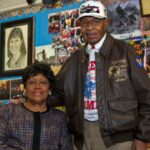 George W. Hickman, Jr. is born in St. Louis, Missouri. A grandson to slaves, he developed a passion for aviation as a child while looking up at passing planes in the sky. In 1943 during the Second World War, Hickman joined the Tuskegee pilot training program of the Army Air Corps in Alabama. After witnessing the maltreatment of a fellow black cadet, he voiced his opposition to his white superiors. As a result of his protest, he was barred from flying as a pilot in the Army despite being a cadet captain. He graduated from the airman program as a crewman in 1944 and served in the European Theater as a flight mechanic for the duration of the war. Following the war, Hickman moved to Amarillo, Texas. Despite being a war veteran, he constantly felt the brunt of Southern discrimination. Amarillo whites pushed him off sidewalks and spat on him even when he wore his army uniform. In 1955, seeking better opportunities and living conditions, Hickman moved to Seattle, Washington, where he made a career as a manager at Boeing and became a fixture at University of Washington sporting events. In 2007, Hickman received the Congressional Gold Medal with his fellow Tuskegee airmen. Two years later, in January 2009, he was invited to, and through efforts of a UW Athletic Department donation drive, was able to attend President Barack Obama’s inauguration. Learn more. George W. Hickman, Jr. is born in St. Louis, Missouri. A grandson to slaves, he developed a passion for aviation as a child while looking up at passing planes in the sky. In 1943 during the Second World War, Hickman joined the Tuskegee pilot training program of the Army Air Corps in Alabama. After witnessing the maltreatment of a fellow black cadet, he voiced his opposition to his white superiors. As a result of his protest, he was barred from flying as a pilot in the Army despite being a cadet captain. He graduated from the airman program as a crewman in 1944 and served in the European Theater as a flight mechanic for the duration of the war. Following the war, Hickman moved to Amarillo, Texas. Despite being a war veteran, he constantly felt the brunt of Southern discrimination. Amarillo whites pushed him off sidewalks and spat on him even when he wore his army uniform. In 1955, seeking better opportunities and living conditions, Hickman moved to Seattle, Washington, where he made a career as a manager at Boeing and became a fixture at University of Washington sporting events. In 2007, Hickman received the Congressional Gold Medal with his fellow Tuskegee airmen. Two years later, in January 2009, he was invited to, and through efforts of a UW Athletic Department donation drive, was able to attend President Barack Obama’s inauguration. Learn more. | |
| August 6, 1941 | 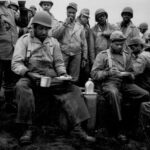 The first in series of violent incidents between Black soldiers and white soldiers and between Black soldiers and white civilians in the run up to America’s entry into World War II occurs when a group of Black soldiers boards a bus in Fayetteville, N.C., headed to Ft. Bragg. The White driver complains they are being “rowdy” and asks for help from Military Police (MPs). White MPs arrive and began hitting the Black soldiers with nightsticks. One of the Black soldiers grabs an MP’s gun and begins shooting. Additional fighting and shooting break out. When the dust settled, one Black private and one white MP were dead and two white MPs and three Black soldiers had been wounded. Military police then staged a “Night of Terror”. According to the Pittsburgh Courier, a Black-owned newspaper, “Colored soldiers by the hundreds were rudely rounded up at gun point throughout the Fayetteville area, packed in trucks, and hustled off to camp without explanation.” They were thrown into the guardhouse, abused, beaten, and robbed. White military police were neither questioned nor interrogated about the incident, and Turman’s killer was acquitted. Learn more. The first in series of violent incidents between Black soldiers and white soldiers and between Black soldiers and white civilians in the run up to America’s entry into World War II occurs when a group of Black soldiers boards a bus in Fayetteville, N.C., headed to Ft. Bragg. The White driver complains they are being “rowdy” and asks for help from Military Police (MPs). White MPs arrive and began hitting the Black soldiers with nightsticks. One of the Black soldiers grabs an MP’s gun and begins shooting. Additional fighting and shooting break out. When the dust settled, one Black private and one white MP were dead and two white MPs and three Black soldiers had been wounded. Military police then staged a “Night of Terror”. According to the Pittsburgh Courier, a Black-owned newspaper, “Colored soldiers by the hundreds were rudely rounded up at gun point throughout the Fayetteville area, packed in trucks, and hustled off to camp without explanation.” They were thrown into the guardhouse, abused, beaten, and robbed. White military police were neither questioned nor interrogated about the incident, and Turman’s killer was acquitted. Learn more. | |
| August 6, 1942 | 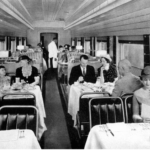 Southern Railway, an interstate railroad company based in Washington, D.C., adopts a policy effectively denying dining service to Black passengers on its rail cars. Previously, the Southern Railway had mandated that trains serve white passengers and Black passengers meals at different times, which often resulted in the denial of meals to Black passengers. The new policy reserved 10 of the train’s 11 dining tables exclusively for white passengers at all times. The one remaining table in the dining car that was theoretically open to Black passengers was also available for use by white passengers and was to be given to white passengers upon request. If Black passengers requested service while white passengers were dining, “they should be advised that they will be served just as soon as those compartments are vacated.” Learn more. Southern Railway, an interstate railroad company based in Washington, D.C., adopts a policy effectively denying dining service to Black passengers on its rail cars. Previously, the Southern Railway had mandated that trains serve white passengers and Black passengers meals at different times, which often resulted in the denial of meals to Black passengers. The new policy reserved 10 of the train’s 11 dining tables exclusively for white passengers at all times. The one remaining table in the dining car that was theoretically open to Black passengers was also available for use by white passengers and was to be given to white passengers upon request. If Black passengers requested service while white passengers were dining, “they should be advised that they will be served just as soon as those compartments are vacated.” Learn more. | |
| August 6, 1965 | 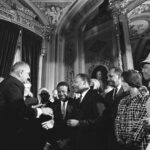 President Lyndon B. Johnson signs the landmark Voting Rights Act of 1965, prohibiting discrimination in voting, into law during the height of the civil rights movement. Designed to enforce the voting rights guaranteed by the Fourteenth and Fifteenth Amendments to the United States Constitution, the Act sought to secure the right to vote for racial minorities throughout the country, especially in the South. According to the U.S. Department of Justice, the Act is considered to be the most effective piece of federal civil rights legislation ever enacted in the country. It is also "one of the most far-reaching pieces of civil rights legislation in U.S. history." The Act was effective in curbing the most naked and egregious efforts to suppress and deny African Americans’ voting rights, until the conservative-dominated Robert’s Court began systematically gutted it in Shelby County v. Holder (2013) and Brnovich v. Democratic National Committee (2021). Learn more. President Lyndon B. Johnson signs the landmark Voting Rights Act of 1965, prohibiting discrimination in voting, into law during the height of the civil rights movement. Designed to enforce the voting rights guaranteed by the Fourteenth and Fifteenth Amendments to the United States Constitution, the Act sought to secure the right to vote for racial minorities throughout the country, especially in the South. According to the U.S. Department of Justice, the Act is considered to be the most effective piece of federal civil rights legislation ever enacted in the country. It is also "one of the most far-reaching pieces of civil rights legislation in U.S. history." The Act was effective in curbing the most naked and egregious efforts to suppress and deny African Americans’ voting rights, until the conservative-dominated Robert’s Court began systematically gutted it in Shelby County v. Holder (2013) and Brnovich v. Democratic National Committee (2021). Learn more. | |
| August 7, 1791 | 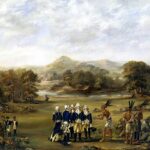 American troops under the command of Lieutenant Colonel (later Brigadier General) James Wilkinson destroy the Miami town of Kenapacomaqua near the site of present-day Logansport, Indiana in the Northwest Indian War. The village was lightly defended, as sixty warriors were patrolling the Wabash River, while others were at Vincennes purchasing ammunition or gathering food in the forests. Only eight warriors were present in the village at the time of the attack. The remaining residents were suffering from a severe flu-like illness, which caused them to bury two or three people each day. Thirty-four Miami were taken prisoner, mostly women and children, including the daughter of Miami war chief Little Turtle. Nine Miami died in the encounter, six warriors, two women, and one child. American troops cut down the corn crops and burned the village houses. The militia made camp for the night, but decided not to proceed further due to fear of retaliation. The departing US troops also stopped to destroy crops planted at another Miami town. Learn more. American troops under the command of Lieutenant Colonel (later Brigadier General) James Wilkinson destroy the Miami town of Kenapacomaqua near the site of present-day Logansport, Indiana in the Northwest Indian War. The village was lightly defended, as sixty warriors were patrolling the Wabash River, while others were at Vincennes purchasing ammunition or gathering food in the forests. Only eight warriors were present in the village at the time of the attack. The remaining residents were suffering from a severe flu-like illness, which caused them to bury two or three people each day. Thirty-four Miami were taken prisoner, mostly women and children, including the daughter of Miami war chief Little Turtle. Nine Miami died in the encounter, six warriors, two women, and one child. American troops cut down the corn crops and burned the village houses. The militia made camp for the night, but decided not to proceed further due to fear of retaliation. The departing US troops also stopped to destroy crops planted at another Miami town. Learn more. | |
| August 7, 1903 | 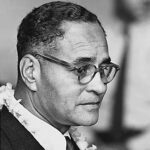 Ralph Johnson Bunche, an American political scientist, diplomat, and Noble laureate, is born. Bunche was a leading actor in the mid-20th Century decolonization process and US civil rights movement. He received the 1950 Nobel Peace Prize for his late 1940s mediation in Israel, the first African American and first person of African descent to be awarded a Nobel Prize. He was involved in the formation and administration of the United Nations and played a major role in both the decolonization process and numerous peacekeeping operations sponsored by the UN. In 1963, he was awarded the Presidential Medal of Freedom by President John F. Kennedy. At the UN, Bunche gained such fame that Ebony magazine proclaimed him perhaps the most influential African American of the first half of the 20th Century and "[f]or nearly a decade, he was the most celebrated African American of his time both [in the US] and abroad." Learn more. Ralph Johnson Bunche, an American political scientist, diplomat, and Noble laureate, is born. Bunche was a leading actor in the mid-20th Century decolonization process and US civil rights movement. He received the 1950 Nobel Peace Prize for his late 1940s mediation in Israel, the first African American and first person of African descent to be awarded a Nobel Prize. He was involved in the formation and administration of the United Nations and played a major role in both the decolonization process and numerous peacekeeping operations sponsored by the UN. In 1963, he was awarded the Presidential Medal of Freedom by President John F. Kennedy. At the UN, Bunche gained such fame that Ebony magazine proclaimed him perhaps the most influential African American of the first half of the 20th Century and "[f]or nearly a decade, he was the most celebrated African American of his time both [in the US] and abroad." Learn more. | |
| August 7, 1930 | 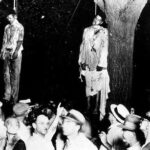 Two young African-American men, J. Thomas Shipp and Abraham S. Smith, are murdered in a spectacle lynching by a mob of thousands in Marion, Indiana. They were taken from jail cells, beaten, and hanged from a tree in the county courthouse square. They had been arrested that night as suspects in a robbery, murder and rape case. A third African-American suspect, 16-year-old James Cameron, had also been arrested and narrowly escaped being killed by the mob. Hours later when authorities attempted to remove the bodies, the mob rushed forward, dismembered, and claimed body parts of the victims as souvenirs. The local chapter of the NAACP had tried to evacuate the suspects from town to avoid the mob violence, but were not successful. The NAACP and the State's Attorney General pressed to indict leaders of the lynch mob, but, as was typical in lynchings, no one was ever charged for their deaths, nor for the attack on Cameron. Mary Ball, the alleged rape victim, later testified that she had not been raped. Cameron was later convicted and sentenced as an accessory to murder before the fact. He served some time in prison, then pursued work and an education. After dedicating his life to civil rights activism, in 1991 Cameron was pardoned by the state of Indiana. The photo of the hanging bodies of Shipp and Smith, surrounded by the mob, was widely distributed and inspired the poem Bitter Fruit and it’s song version Strange Fruit, which was popularized by singer Billie Holiday. Learn more. Two young African-American men, J. Thomas Shipp and Abraham S. Smith, are murdered in a spectacle lynching by a mob of thousands in Marion, Indiana. They were taken from jail cells, beaten, and hanged from a tree in the county courthouse square. They had been arrested that night as suspects in a robbery, murder and rape case. A third African-American suspect, 16-year-old James Cameron, had also been arrested and narrowly escaped being killed by the mob. Hours later when authorities attempted to remove the bodies, the mob rushed forward, dismembered, and claimed body parts of the victims as souvenirs. The local chapter of the NAACP had tried to evacuate the suspects from town to avoid the mob violence, but were not successful. The NAACP and the State's Attorney General pressed to indict leaders of the lynch mob, but, as was typical in lynchings, no one was ever charged for their deaths, nor for the attack on Cameron. Mary Ball, the alleged rape victim, later testified that she had not been raped. Cameron was later convicted and sentenced as an accessory to murder before the fact. He served some time in prison, then pursued work and an education. After dedicating his life to civil rights activism, in 1991 Cameron was pardoned by the state of Indiana. The photo of the hanging bodies of Shipp and Smith, surrounded by the mob, was widely distributed and inspired the poem Bitter Fruit and it’s song version Strange Fruit, which was popularized by singer Billie Holiday. Learn more. | |
| August 7, 1935 | 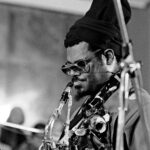 American jazz multi-instrumentalist who played tenor saxophone, flute, and many other instruments, Rahsaan Roland Kirk (born Ronald Theodore Kirk) is born in Columbus, OH. He became blind at two years old, which he said was a result of improper medical treatment. As a teenager, Kirk studied at the Ohio State School for the Blind. By age fifteen he was on the road playing rhythm and blues on weekends with Boyd Moore's band. He was renowned for his onstage vitality, during which virtuoso improvisation was accompanied by comic banter, political ranting, and the ability to play several instruments simultaneously. Kirk was politically outspoken. During his concerts, between songs he often talked about topical issues, including African-American history and the Civil Rights Movement. His monologues were often laced with satire and absurdist humor. Learn more. American jazz multi-instrumentalist who played tenor saxophone, flute, and many other instruments, Rahsaan Roland Kirk (born Ronald Theodore Kirk) is born in Columbus, OH. He became blind at two years old, which he said was a result of improper medical treatment. As a teenager, Kirk studied at the Ohio State School for the Blind. By age fifteen he was on the road playing rhythm and blues on weekends with Boyd Moore's band. He was renowned for his onstage vitality, during which virtuoso improvisation was accompanied by comic banter, political ranting, and the ability to play several instruments simultaneously. Kirk was politically outspoken. During his concerts, between songs he often talked about topical issues, including African-American history and the Civil Rights Movement. His monologues were often laced with satire and absurdist humor. Learn more. | |
| August 8, 1831 | 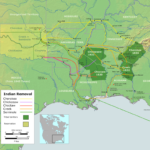 The Treaty of Wapakoneta, under which remnants of the Shawnee Native American tribe in Wapakoneta were forced to relinquish claims that they had to land in western Ohio, is signed. The treaty, along with several other agreements between indigenous tribes and the United States government, marked the slow but gradual removal of Native Americans to land west of the Mississippi River. This United States government policy, known as Indian Removal, was a policy of forced displacement of self-governing tribes of Native Americans from their ancestral homelands in the eastern United States to lands west of the Mississippi River – specifically, to a designated Indian Territory (roughly, present-day Oklahoma). The Indian Removal Act, the key law which authorized the removal of Native tribes, was signed by Andrew Jackson in 1830. Although Jackson took a hard line on Indian removal, the law was enforced primarily during the Martin Van Buren administration. After the passage of the Indian Removal Act in 1830, approximately 60,000 members of the Cherokee, Muscogee (Creek), Seminole, Chickasaw, and Choctaw nations (including thousands of black slaves) were forcibly removed from their ancestral homelands, with thousands dying during the Trail of Tears. Indian removal, a popular policy among white settlers, was a consequence of actions by European settlers in North America during the colonial period and then by the United States government (and its citizens) until the mid-20th century. The policy traced its origins to the administration of James Monroe, although it addressed conflicts between European and Native Americans which had occurred since the 17th century and were escalating into the early 19th century (as white settlers pushed westward in the cultural belief of manifest destiny). Historical views of Indian removal have been reevaluated since that time. Widespread contemporary acceptance of the policy, due in part to the popular embrace of the concept of manifest destiny, has given way to a more-somber perspective. Historians have described the removal of Native Americans as paternalism, ethnic cleansing, or genocide. Learn more. The Treaty of Wapakoneta, under which remnants of the Shawnee Native American tribe in Wapakoneta were forced to relinquish claims that they had to land in western Ohio, is signed. The treaty, along with several other agreements between indigenous tribes and the United States government, marked the slow but gradual removal of Native Americans to land west of the Mississippi River. This United States government policy, known as Indian Removal, was a policy of forced displacement of self-governing tribes of Native Americans from their ancestral homelands in the eastern United States to lands west of the Mississippi River – specifically, to a designated Indian Territory (roughly, present-day Oklahoma). The Indian Removal Act, the key law which authorized the removal of Native tribes, was signed by Andrew Jackson in 1830. Although Jackson took a hard line on Indian removal, the law was enforced primarily during the Martin Van Buren administration. After the passage of the Indian Removal Act in 1830, approximately 60,000 members of the Cherokee, Muscogee (Creek), Seminole, Chickasaw, and Choctaw nations (including thousands of black slaves) were forcibly removed from their ancestral homelands, with thousands dying during the Trail of Tears. Indian removal, a popular policy among white settlers, was a consequence of actions by European settlers in North America during the colonial period and then by the United States government (and its citizens) until the mid-20th century. The policy traced its origins to the administration of James Monroe, although it addressed conflicts between European and Native Americans which had occurred since the 17th century and were escalating into the early 19th century (as white settlers pushed westward in the cultural belief of manifest destiny). Historical views of Indian removal have been reevaluated since that time. Widespread contemporary acceptance of the policy, due in part to the popular embrace of the concept of manifest destiny, has given way to a more-somber perspective. Historians have described the removal of Native Americans as paternalism, ethnic cleansing, or genocide. Learn more. | |
| August 8, 1866 | 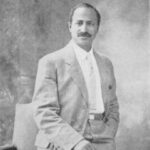 American explorer Matthew Alexander Henson, who accompanied Robert Peary on seven voyages to the Arctic over a period of nearly 23 years, is born. Henson and Perry spent a total of 18 years on expeditions together. Henson is best known for his participation in the 1908–1909 expedition that claimed to have reached the geographic North Pole on April 6, 1909, when Henson was the first of their party to reach the pole. Henson was born in Nanjemoy, Maryland, to sharecropper parents who were free Black Americans before the Civil War. He spent most of his early life in Washington, D.C., but left school at the age of twelve to work as a cabin boy. He later returned to Washington and worked as a salesclerk at a good department store. One of his customers was Robert Peary, who in 1887 hired him as a personal valet. At the time, Peary was working on the Nicaragua Canal. Their first Arctic expedition together was in 1891–92. Henson served as a navigator and craftsman, and was known as Peary's "first man". Like Peary, he studied Inuit survival techniques. Henson achieved a degree of fame as a result of participating in the 1908-1909 expedition, and in 1912 he published a memoir titled A Negro Explorer at the North Pole. As he approached old age, his exploits received renewed attention. In 1937 he was the first African American to be made a life member of The Explorers Club; in 1948 he was elevated to the club's highest level of membership. In 1944 Henson was awarded the Peary Polar Expedition Medal, and he was received at the White House by Presidents Harry Truman and Dwight Eisenhower. In 1988 he and his wife were re-interred at Arlington National Cemetery. In 2000 Henson was posthumously awarded the Hubbard Medal by the National Geographic Society. Learn more. American explorer Matthew Alexander Henson, who accompanied Robert Peary on seven voyages to the Arctic over a period of nearly 23 years, is born. Henson and Perry spent a total of 18 years on expeditions together. Henson is best known for his participation in the 1908–1909 expedition that claimed to have reached the geographic North Pole on April 6, 1909, when Henson was the first of their party to reach the pole. Henson was born in Nanjemoy, Maryland, to sharecropper parents who were free Black Americans before the Civil War. He spent most of his early life in Washington, D.C., but left school at the age of twelve to work as a cabin boy. He later returned to Washington and worked as a salesclerk at a good department store. One of his customers was Robert Peary, who in 1887 hired him as a personal valet. At the time, Peary was working on the Nicaragua Canal. Their first Arctic expedition together was in 1891–92. Henson served as a navigator and craftsman, and was known as Peary's "first man". Like Peary, he studied Inuit survival techniques. Henson achieved a degree of fame as a result of participating in the 1908-1909 expedition, and in 1912 he published a memoir titled A Negro Explorer at the North Pole. As he approached old age, his exploits received renewed attention. In 1937 he was the first African American to be made a life member of The Explorers Club; in 1948 he was elevated to the club's highest level of membership. In 1944 Henson was awarded the Peary Polar Expedition Medal, and he was received at the White House by Presidents Harry Truman and Dwight Eisenhower. In 1988 he and his wife were re-interred at Arlington National Cemetery. In 2000 Henson was posthumously awarded the Hubbard Medal by the National Geographic Society. Learn more. | |
| August 8, 1885 | 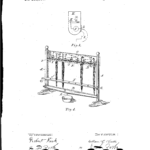 African-American inventor, William C. Carter, secured U.S. patent no. 323,397 for his invention of an improved umbrella stand. African-American inventor, William C. Carter, secured U.S. patent no. 323,397 for his invention of an improved umbrella stand. | |
| August 8, 1907 | 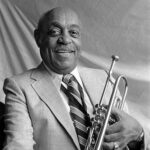 American jazz saxophonist, clarinetist, trumpeter, composer, arranger, and bandleaderBennett Lester "Benny" Carter is born. With Johnny Hodges, he was a pioneer on the alto saxophone. From the beginning of his career in the 1920s, he worked as an arranger including written charts for Fletcher Henderson's big band that shaped the swing style. He had an unusually long career that lasted into the 1990s. During the 1980s and '90s, he was nominated for eight Grammy Awards, which included receiving a Lifetime Achievement Award. Learn more. American jazz saxophonist, clarinetist, trumpeter, composer, arranger, and bandleaderBennett Lester "Benny" Carter is born. With Johnny Hodges, he was a pioneer on the alto saxophone. From the beginning of his career in the 1920s, he worked as an arranger including written charts for Fletcher Henderson's big band that shaped the swing style. He had an unusually long career that lasted into the 1990s. During the 1980s and '90s, he was nominated for eight Grammy Awards, which included receiving a Lifetime Achievement Award. Learn more. | |
| August 9, 1912 | 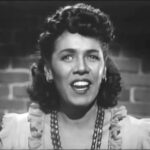 Anne Brown, an American soprano who created the role of "Bess" in the original production of George Gershwin's 1935opera Porgy and Bess, is born. She was also a radio and concert singer. She settled in Norway in 1948 and later became a Norwegian citizen. As a young child, Brown showed a great musical talent. As an African-American, she was not allowed to attend a Roman Catholic elementary school in her native Baltimore. She trained at Morgan College and then applied to the Peabody Institute, but was rejected from the school due to her race. Brown then applied to the Juilliard School in New York at the encouragement of the wife of the owner of The Baltimore Sun. She was admitted to Juilliard when she was 16, becoming the first African-American vocalist to attend there. She studied singing with Lucia Dunham and was awarded Juilliard's Margaret McGill scholarship when she was 20 years old. As a result of her collaboration with Gershwin while he was composing the opera, the role of Bess grew from a secondary character, like it was in DuBose Heyward's novel Porgy, to become one of the opera's leading roles. Learn more. Anne Brown, an American soprano who created the role of "Bess" in the original production of George Gershwin's 1935opera Porgy and Bess, is born. She was also a radio and concert singer. She settled in Norway in 1948 and later became a Norwegian citizen. As a young child, Brown showed a great musical talent. As an African-American, she was not allowed to attend a Roman Catholic elementary school in her native Baltimore. She trained at Morgan College and then applied to the Peabody Institute, but was rejected from the school due to her race. Brown then applied to the Juilliard School in New York at the encouragement of the wife of the owner of The Baltimore Sun. She was admitted to Juilliard when she was 16, becoming the first African-American vocalist to attend there. She studied singing with Lucia Dunham and was awarded Juilliard's Margaret McGill scholarship when she was 20 years old. As a result of her collaboration with Gershwin while he was composing the opera, the role of Bess grew from a secondary character, like it was in DuBose Heyward's novel Porgy, to become one of the opera's leading roles. Learn more. | |
| August 9, 2014 |  Michael Brown, an unarmed Black teenager, was shot to death by a white police officer named Darren Wilson in Ferguson, Missouri. According to reports, Officer Wilson stopped Michael on the street in the afternoon to ask him about a robbery at a nearby convenience store. Although the precise details of what happened next remain unclear, many eyewitness accounts suggest that Michael ran from the officer with his hands raised in the air. Officer Wilson then shot Michael six times and claimed that he had feared for his life. Michael’s body was found approximately 150 feet from the officer’s police vehicle. He had graduated from high school just eight days before and was scheduled to begin a vocational training program two days later. Despite nationwide pleas for accountability, no one was punished for Michael Brown’s death. A grand jury ultimately declined to bring criminal charges against Officer Wilson, and the Department of Justice also refused to file federal civil rights charges. The shooting and its aftermath sparked weeks of protests in Ferguson and beyond. Learn more. Michael Brown, an unarmed Black teenager, was shot to death by a white police officer named Darren Wilson in Ferguson, Missouri. According to reports, Officer Wilson stopped Michael on the street in the afternoon to ask him about a robbery at a nearby convenience store. Although the precise details of what happened next remain unclear, many eyewitness accounts suggest that Michael ran from the officer with his hands raised in the air. Officer Wilson then shot Michael six times and claimed that he had feared for his life. Michael’s body was found approximately 150 feet from the officer’s police vehicle. He had graduated from high school just eight days before and was scheduled to begin a vocational training program two days later. Despite nationwide pleas for accountability, no one was punished for Michael Brown’s death. A grand jury ultimately declined to bring criminal charges against Officer Wilson, and the Department of Justice also refused to file federal civil rights charges. The shooting and its aftermath sparked weeks of protests in Ferguson and beyond. Learn more. | |
| August 10, 1835 | 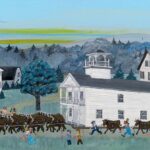 Nearly 500 white men destroyed the new integrated Noyes Academy in Canaan, New Hampshire, using 100 oxen to pull the schoolhouse off its foundation and drag it a mile down the road. Founded by abolitionists with 28 white and 14 Black students, Noyes Academy was just the second integrated school in the country. The African American students had traveled long distances in the face of adversity to get to the school. After destroying the school, the mob fired cannons into the homes where the African American students were boarding and threatened the students. Despite attempts to repair and reopen the school, the structure was burnt to the ground three years later. Learn more.
Nearly 500 white men destroyed the new integrated Noyes Academy in Canaan, New Hampshire, using 100 oxen to pull the schoolhouse off its foundation and drag it a mile down the road. Founded by abolitionists with 28 white and 14 Black students, Noyes Academy was just the second integrated school in the country. The African American students had traveled long distances in the face of adversity to get to the school. After destroying the school, the mob fired cannons into the homes where the African American students were boarding and threatened the students. Despite attempts to repair and reopen the school, the structure was burnt to the ground three years later. Learn more. | |
| August 10, 1854 | 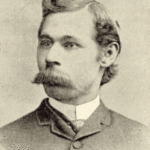 Photographer James Conway Farley is born into slavery in Prince Edward County, Virginia. Both of his parents were slaves. In 1861 he moved with his mother to Richmond, Virginia in 1861, where she worked as a store-room keeper at the Columbia Hotel and he assisted in candle-making and learned to read. He was the proprietor of the Jefferson Fine Arts Gallery from 1895 into the 1900s. He is known as the first nationally recognized African-American photographer. Learn more. Photographer James Conway Farley is born into slavery in Prince Edward County, Virginia. Both of his parents were slaves. In 1861 he moved with his mother to Richmond, Virginia in 1861, where she worked as a store-room keeper at the Columbia Hotel and he assisted in candle-making and learned to read. He was the proprietor of the Jefferson Fine Arts Gallery from 1895 into the 1900s. He is known as the first nationally recognized African-American photographer. Learn more. | |
| August 10, 1858 | 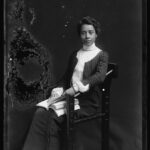 Author, educator, sociologist, speaker, Black liberation activist, and one of the most prominent African-American scholars in United States history, Anna Julia Haywood Cooper is born into slavery. Cooper went on to receive a world-class education and claim power and prestige in academic and social circles. In 1924, she received her PhD in history from the Sorbonne, University of Paris.[4] Cooper became the fourth African-American woman to earn a doctoral degree. She was also a prominent member of Washington, D.C.'s African-American community and a member of Alpha Kappa Alpha sorority. Cooper made contributions to social science fields, particularly in sociology. Her first book, A Voice from the South: By a Black Woman of the South, is widely acknowledged as one of the first articulations of Black feminism, giving Cooper the often-used title of "the Mother of Black Feminism". Learn more. Author, educator, sociologist, speaker, Black liberation activist, and one of the most prominent African-American scholars in United States history, Anna Julia Haywood Cooper is born into slavery. Cooper went on to receive a world-class education and claim power and prestige in academic and social circles. In 1924, she received her PhD in history from the Sorbonne, University of Paris.[4] Cooper became the fourth African-American woman to earn a doctoral degree. She was also a prominent member of Washington, D.C.'s African-American community and a member of Alpha Kappa Alpha sorority. Cooper made contributions to social science fields, particularly in sociology. Her first book, A Voice from the South: By a Black Woman of the South, is widely acknowledged as one of the first articulations of Black feminism, giving Cooper the often-used title of "the Mother of Black Feminism". Learn more. | |
| August 10, 1980 | 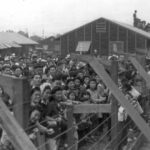 More than 45 years after the start of internment, the U.S. government authorizes reparations payments to Japanese-Americans detained during WWII, when President Reagan signed the Civil Liberties Act of 1988, which provided an apology and compensation of $20,000 to living survivors of Japanese internment. An estimated 50,000 internees had died before the reparation act’s passage. In early 1942, President Franklin D. Roosevelt signed Executive Order 9066, ordering 120,000 people of Japanese descent—including 75,000 American citizens—to be imprisoned in make-shift internment camps for the duration of WWII. The racial basis of the order was demonstrated by the fact that German-American and Italian-American residents were allowed to remain in their homes undisturbed. The 1944 U.S. Supreme Court decision, Korematsu v. U.S., upheld Roosevelt’s executive order. Learn more. More than 45 years after the start of internment, the U.S. government authorizes reparations payments to Japanese-Americans detained during WWII, when President Reagan signed the Civil Liberties Act of 1988, which provided an apology and compensation of $20,000 to living survivors of Japanese internment. An estimated 50,000 internees had died before the reparation act’s passage. In early 1942, President Franklin D. Roosevelt signed Executive Order 9066, ordering 120,000 people of Japanese descent—including 75,000 American citizens—to be imprisoned in make-shift internment camps for the duration of WWII. The racial basis of the order was demonstrated by the fact that German-American and Italian-American residents were allowed to remain in their homes undisturbed. The 1944 U.S. Supreme Court decision, Korematsu v. U.S., upheld Roosevelt’s executive order. Learn more. | |
| August 11, 1873 | 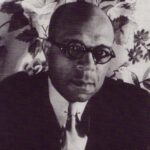 John Rosamond Johnson — composer, actor, pioneer in his field, and one of the most successful of the early African American composers — is born in Jacksonville, Florida. Johnson was the younger brother of prominent composer and civil rights leader James Weldon Johnson. Starting in 1890, John Johnson attended Boston’s New England Conservatory, and for a brief time studied in Europe as well. He began his career as a music teacher in Jacksonville public schools but in 1899 moved to New York with his brother, James Weldon, to pursue a career in show business. Of the music that Johnson wrote himself, Lift Every Voice and Sing (1900) is the best known. The song was so popular that the National Association for the Advancement of Colored People (NAACP) dubbed it The Negro National Anthem. Other well known songs of his include The Maiden with the Dreamy Eyes, Didn’t He Ramble, and Li’l Gal, Since You Went Away. Original and expressive, Johnson’s work propelled him to international acclaim. Learn more. John Rosamond Johnson — composer, actor, pioneer in his field, and one of the most successful of the early African American composers — is born in Jacksonville, Florida. Johnson was the younger brother of prominent composer and civil rights leader James Weldon Johnson. Starting in 1890, John Johnson attended Boston’s New England Conservatory, and for a brief time studied in Europe as well. He began his career as a music teacher in Jacksonville public schools but in 1899 moved to New York with his brother, James Weldon, to pursue a career in show business. Of the music that Johnson wrote himself, Lift Every Voice and Sing (1900) is the best known. The song was so popular that the National Association for the Advancement of Colored People (NAACP) dubbed it The Negro National Anthem. Other well known songs of his include The Maiden with the Dreamy Eyes, Didn’t He Ramble, and Li’l Gal, Since You Went Away. Original and expressive, Johnson’s work propelled him to international acclaim. Learn more. | |
| August 11, 1921 | 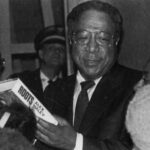 Pulitzer-prize winning author Alex Haley is born in Ithaca, New York. He is best known for his historical work, includingThe Autobiography of Malcolm X (1965) and Roots: The Saga of an American Family (1976), both highly acclaimed and very popular. Learn more.
Pulitzer-prize winning author Alex Haley is born in Ithaca, New York. He is best known for his historical work, includingThe Autobiography of Malcolm X (1965) and Roots: The Saga of an American Family (1976), both highly acclaimed and very popular. Learn more. | |
| August 11, 1925 | 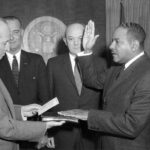 Diplomat, author, reporter, broadcaster, the first Black deputy Secretary of State, the first Black director of the United States Information Agency (USIA), and long-time syndicated columnist Carl Thomas Rowan is born in Tennessee. His father, Thomas, stacked lumber for construction, and his mother, Johnnie, cleaned houses, cooked, and did laundry for wealthier families. The Rowan family home had no electricity, running water, telephone, nor even a clock. One of young Carl’s teachers encouraged him to read and write as much as possible, even going to the library for him because, as a Black person, Rowan wasn’t allowed to check out books. He graduated at the top of his high school class. When the U.S. entered World War II, Rowan signed up for a Navy program that led to an officer’s commission. He was one of the first twenty Black Naval officers during World War II, serving on a tanker in the Atlantic Ocean. Rowan finished Oberlin College in Ohio in 1947, and earned a master’s degree in journalism at the University of Minnesota in 1948. Learn more. Diplomat, author, reporter, broadcaster, the first Black deputy Secretary of State, the first Black director of the United States Information Agency (USIA), and long-time syndicated columnist Carl Thomas Rowan is born in Tennessee. His father, Thomas, stacked lumber for construction, and his mother, Johnnie, cleaned houses, cooked, and did laundry for wealthier families. The Rowan family home had no electricity, running water, telephone, nor even a clock. One of young Carl’s teachers encouraged him to read and write as much as possible, even going to the library for him because, as a Black person, Rowan wasn’t allowed to check out books. He graduated at the top of his high school class. When the U.S. entered World War II, Rowan signed up for a Navy program that led to an officer’s commission. He was one of the first twenty Black Naval officers during World War II, serving on a tanker in the Atlantic Ocean. Rowan finished Oberlin College in Ohio in 1947, and earned a master’s degree in journalism at the University of Minnesota in 1948. Learn more. | |
| August 11, 1965 |  The Watts Riot, also known as the Watts Rebellion, begins in the Watts neighborhood of Los Angeles, California. The riot took 34 lives and injured 1,032 people. There were nearly 4,000 arrests and $40 million in property damage in what was until that point, the largest urban rebellion in the United States in the 1960s. The five day revolt which involved some 30,000 people served as stark testimony to the inequality and poverty that dominated the lives of thousands of Watts’s residents. Many of those engaged in the uprising looted items from local groceries and clothing stores, acquiring what they wanted and needed but often could not afford. Others battled the LAPD which they held immediately responsible for their poverty and alienation. In spite of the protest, the Watts Rebellion did not significantly improve the lives of the community’s black population. While the revolt inspired the federal government to implement programs to address unemployment, education, healthcare, and housing under Lyndon B. Johnson’s “War on Poverty,” much of the money allocated for these programs was eventually absorbed by the Vietnam War. Learn more. The Watts Riot, also known as the Watts Rebellion, begins in the Watts neighborhood of Los Angeles, California. The riot took 34 lives and injured 1,032 people. There were nearly 4,000 arrests and $40 million in property damage in what was until that point, the largest urban rebellion in the United States in the 1960s. The five day revolt which involved some 30,000 people served as stark testimony to the inequality and poverty that dominated the lives of thousands of Watts’s residents. Many of those engaged in the uprising looted items from local groceries and clothing stores, acquiring what they wanted and needed but often could not afford. Others battled the LAPD which they held immediately responsible for their poverty and alienation. In spite of the protest, the Watts Rebellion did not significantly improve the lives of the community’s black population. While the revolt inspired the federal government to implement programs to address unemployment, education, healthcare, and housing under Lyndon B. Johnson’s “War on Poverty,” much of the money allocated for these programs was eventually absorbed by the Vietnam War. Learn more. | |
| August 11, 2017 |  An assembly of more than 200 members of white supremacist, alt-right, neo-Nazi, and pro-Confederate groups from throughout the country converge on the University of Virginia in Charlottesville for a torch-lit march through central campus shouting slogans like “Blood and soil!” “You will not replace us!” “Jews will not replace us!” and “White lives matter!” The procession was the precursor to a planned “Unite the Right” rally, scheduled to take place the next day to protest the Charlottesville City Council’s recent vote to remove a Confederate monument dedicated to Robert E. Lee. As the marchers paraded through the University’s campus, counter-protests quickly emerged and tensions escalated. The next day, approximately two hours after the City of Charlottesville declared a local state of emergency, a neo-Nazi named James Alex Fields Jr. drove his car directly into a crowd of counter-protesters, wounding at least 18 people and killing a 32-year-old white woman named Heather Heyer. Learn more. An assembly of more than 200 members of white supremacist, alt-right, neo-Nazi, and pro-Confederate groups from throughout the country converge on the University of Virginia in Charlottesville for a torch-lit march through central campus shouting slogans like “Blood and soil!” “You will not replace us!” “Jews will not replace us!” and “White lives matter!” The procession was the precursor to a planned “Unite the Right” rally, scheduled to take place the next day to protest the Charlottesville City Council’s recent vote to remove a Confederate monument dedicated to Robert E. Lee. As the marchers paraded through the University’s campus, counter-protests quickly emerged and tensions escalated. The next day, approximately two hours after the City of Charlottesville declared a local state of emergency, a neo-Nazi named James Alex Fields Jr. drove his car directly into a crowd of counter-protesters, wounding at least 18 people and killing a 32-year-old white woman named Heather Heyer. Learn more. | |
| August 12, 1890 | 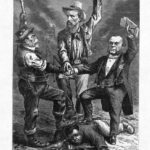 After the Compromise of 1877 and a lengthy campaign of terrorist violence to establish Democratic Party-rule in the Mississippi had succeeded, a constitutional convention composed almost entirely of white Democrats created and adopted the fourth (and current) Mississippi state constitution to specifically disenfranchise, isolate, and marginalize the state's African American population. Unlike the previous constitution, the 1890 constitution did not go to the people of the state at large for their approval and ratification. The convention created, approved, and ratified it all on its own initiative. The new constitution was utilized by the Democrats and the state government, in conjunction with terrorist violence, to marginalize and prohibit Black Mississippians from participating in the state's civil society until the 1960s and 1970s. Mississippi was the first, but not the only U.S. state at the time that created a new constitution specifically for the purpose of disenfranchising their African American voters; South Carolina followed suit in December 1895 under its Democratic governor in replacing its 1868 state constitution. As with Mississippi's current 1890 constitution, the 1895 South Carolinian constitution is still in use today. Mississippi’s 1890 constitution effectively granted the Democratic Party-controlled state government free rein to prevent almost all African Americans from voting and casting ballots, in addition to forcing African Americans to attend separate schools (almost always deliberately of substandard quality), forbidding them to marry people of other ethnic groups, or to bear arms for self-defense. In the 1950s and 1960s, following investigations by the United States government, these discriminatory provisions were ruled by the U.S. Supreme Court to have violated the rights guaranteed to American citizens under the tenets of the U.S. Constitution, thus rendering them legally unenforceable. However, it would take another 20 years to formally remove them from the state's constitution, nearly a century after they were enacted. Learn more. After the Compromise of 1877 and a lengthy campaign of terrorist violence to establish Democratic Party-rule in the Mississippi had succeeded, a constitutional convention composed almost entirely of white Democrats created and adopted the fourth (and current) Mississippi state constitution to specifically disenfranchise, isolate, and marginalize the state's African American population. Unlike the previous constitution, the 1890 constitution did not go to the people of the state at large for their approval and ratification. The convention created, approved, and ratified it all on its own initiative. The new constitution was utilized by the Democrats and the state government, in conjunction with terrorist violence, to marginalize and prohibit Black Mississippians from participating in the state's civil society until the 1960s and 1970s. Mississippi was the first, but not the only U.S. state at the time that created a new constitution specifically for the purpose of disenfranchising their African American voters; South Carolina followed suit in December 1895 under its Democratic governor in replacing its 1868 state constitution. As with Mississippi's current 1890 constitution, the 1895 South Carolinian constitution is still in use today. Mississippi’s 1890 constitution effectively granted the Democratic Party-controlled state government free rein to prevent almost all African Americans from voting and casting ballots, in addition to forcing African Americans to attend separate schools (almost always deliberately of substandard quality), forbidding them to marry people of other ethnic groups, or to bear arms for self-defense. In the 1950s and 1960s, following investigations by the United States government, these discriminatory provisions were ruled by the U.S. Supreme Court to have violated the rights guaranteed to American citizens under the tenets of the U.S. Constitution, thus rendering them legally unenforceable. However, it would take another 20 years to formally remove them from the state's constitution, nearly a century after they were enacted. Learn more. | |
| August 12, 1891 | 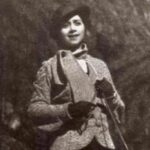 Lillian (Evans) Evanti, one of the first African American women to become an internationally prominent opera performer, is born into a prominent Washington, D.C. family. Her father, Wilson Evans, was a medical doctor and teacher in the city. He was the founder of Armstrong Technical High School and served many years as its principal. Anne Brooks, Evanti’s mother, taught music in the public school system of Washington D.C. Evanti received her education from Armstrong Technical High School and graduated from Howard University in 1917 with her bachelor’s degree in music. A gifted student and performer, she was able to speak and sing in five different languages. Evanti, a lyric soprano, began singing professionally in 1918. Her career progressed slowly until she moved to France in 1925 where she became the first African American to sing with a European opera company. In 1941, Evanti began performing at The National Negro Opera Company, the first black opera company established by Mary Cardwell to provide a venue for African American performers. A series of Company performances of La Traviata, where Evanti sang the part of Violetta, was hugely successful and attracted over 12,000 people. Over her career Evanti performed in twenty four operas. Learn more. Lillian (Evans) Evanti, one of the first African American women to become an internationally prominent opera performer, is born into a prominent Washington, D.C. family. Her father, Wilson Evans, was a medical doctor and teacher in the city. He was the founder of Armstrong Technical High School and served many years as its principal. Anne Brooks, Evanti’s mother, taught music in the public school system of Washington D.C. Evanti received her education from Armstrong Technical High School and graduated from Howard University in 1917 with her bachelor’s degree in music. A gifted student and performer, she was able to speak and sing in five different languages. Evanti, a lyric soprano, began singing professionally in 1918. Her career progressed slowly until she moved to France in 1925 where she became the first African American to sing with a European opera company. In 1941, Evanti began performing at The National Negro Opera Company, the first black opera company established by Mary Cardwell to provide a venue for African American performers. A series of Company performances of La Traviata, where Evanti sang the part of Violetta, was hugely successful and attracted over 12,000 people. Over her career Evanti performed in twenty four operas. Learn more. | |
| August 12, 1903 |  After a white mob attempted and failed to lynch a Black man, armed white residents engaged in a racial reign of terror that forced all Black residents to flee Whitesboro, Texas. The mob went from house to house in the town’s Black neighborhood, destroying the homes, beating the Black people inside, and ordering all of them to leave Whitesboro. Black people fled by train that night, with contemporary news sources reporting that “outgoing trains on all roads were filled” with Black people. The death toll is unknown as authorities made no effort to protect Black residents. A few days later, armed white men rounded up the last 17 remaining Black people in town, tied them to trees, whipped them mercilessly, and again ordered to leave town. Contemporary reports noted that after the conclusion of this violence, not a single Black person remained in Whitesboro. Learn more. After a white mob attempted and failed to lynch a Black man, armed white residents engaged in a racial reign of terror that forced all Black residents to flee Whitesboro, Texas. The mob went from house to house in the town’s Black neighborhood, destroying the homes, beating the Black people inside, and ordering all of them to leave Whitesboro. Black people fled by train that night, with contemporary news sources reporting that “outgoing trains on all roads were filled” with Black people. The death toll is unknown as authorities made no effort to protect Black residents. A few days later, armed white men rounded up the last 17 remaining Black people in town, tied them to trees, whipped them mercilessly, and again ordered to leave town. Contemporary reports noted that after the conclusion of this violence, not a single Black person remained in Whitesboro. Learn more. | |
| August 12, 1922 | 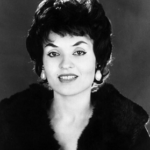 American businesswoman, publisher, and model Ophelia DeVore is born. DeVore graduated from Hunter College High School and went on to New York University, majoring in mathematics and minoring in languages. She was the first model of African-American descent in the United States. In 1946, determined to create a new market for non-white women in the U.S., DeVore would establish The Grace Del Marco Agency, the first agency for non-white models. In the agency's early days, it was a stepping stone for countless household names; Diahann Carroll, Helen Williams, Richard Roundtree, Cicely Tyson and others. Racism was rampant in New York's fashion business and the Grace Del Marco Agency was one of the few places non-white models could gain work. Additionally, DeVore was the CEO and publisher of The Columbus Times newspaper in Columbus, Georgia, a Black-owned newspaper which she ran from the 1970s until retiring in 2009. Learn more. American businesswoman, publisher, and model Ophelia DeVore is born. DeVore graduated from Hunter College High School and went on to New York University, majoring in mathematics and minoring in languages. She was the first model of African-American descent in the United States. In 1946, determined to create a new market for non-white women in the U.S., DeVore would establish The Grace Del Marco Agency, the first agency for non-white models. In the agency's early days, it was a stepping stone for countless household names; Diahann Carroll, Helen Williams, Richard Roundtree, Cicely Tyson and others. Racism was rampant in New York's fashion business and the Grace Del Marco Agency was one of the few places non-white models could gain work. Additionally, DeVore was the CEO and publisher of The Columbus Times newspaper in Columbus, Georgia, a Black-owned newspaper which she ran from the 1970s until retiring in 2009. Learn more. | |
| August 13, 1906 | 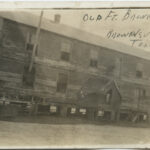 A white bartender is killed and a white police officer wounded by gunshots during the night, prompting an organized campaign by the white townspeople of Brownsville, Texas to accuse the Buffalo Soldiers, Black soldiers in the segregated African-American 25th Infantry Regiment stationed at the adjacent Fort Brown. The Black soldiers had previously complained of local police harassment and civilian discrimination. Although their white commanders said the Black soldiers had been in the barracks all night. To reinforce their accusations, local townspeople of Brownsville produced spent bullet cartridges from Army rifles which they said belonged to the 25th's men; despite the contradictory evidence that demonstrated the spent shells were planted in order to frame men of the 25th Infantry in the shootings, investigators accepted the statements of the local whites and the Brownsville mayor. As a result of the investigation, President Theodore Roosevelt ordered the discharge without honor of 167 soldiers of the 25th Infantry Regiment, costing them pensions and preventing them from ever serving in federal civil service jobs. The case aroused national outrage in Black white communities. After more investigation, several of the men were allowed to re-enlist. Following publication of a history of the affair in the early 1970s, a renewed military investigation of the "Brownsville Affair" exonerated the discharged Black troops. The government pardoned the men in 1972 and restored their records to show honorable discharges, but it did not provide retroactive compensation to them or their descendants. Only one man had survived to that time; Congress passed an act to provide him with a tax-free pension. The other soldiers who had been expelled all received posthumous honorable discharges. Learn more. A white bartender is killed and a white police officer wounded by gunshots during the night, prompting an organized campaign by the white townspeople of Brownsville, Texas to accuse the Buffalo Soldiers, Black soldiers in the segregated African-American 25th Infantry Regiment stationed at the adjacent Fort Brown. The Black soldiers had previously complained of local police harassment and civilian discrimination. Although their white commanders said the Black soldiers had been in the barracks all night. To reinforce their accusations, local townspeople of Brownsville produced spent bullet cartridges from Army rifles which they said belonged to the 25th's men; despite the contradictory evidence that demonstrated the spent shells were planted in order to frame men of the 25th Infantry in the shootings, investigators accepted the statements of the local whites and the Brownsville mayor. As a result of the investigation, President Theodore Roosevelt ordered the discharge without honor of 167 soldiers of the 25th Infantry Regiment, costing them pensions and preventing them from ever serving in federal civil service jobs. The case aroused national outrage in Black white communities. After more investigation, several of the men were allowed to re-enlist. Following publication of a history of the affair in the early 1970s, a renewed military investigation of the "Brownsville Affair" exonerated the discharged Black troops. The government pardoned the men in 1972 and restored their records to show honorable discharges, but it did not provide retroactive compensation to them or their descendants. Only one man had survived to that time; Congress passed an act to provide him with a tax-free pension. The other soldiers who had been expelled all received posthumous honorable discharges. Learn more. | |
| August 13, 1933 | 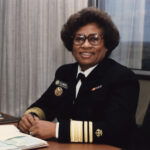 Minnie Joycelyn Elders (born Minnie Lee Jones is an American pediatrician and public health administrator who served as Surgeon General of the United States from 1993 to 1994. A vice admiral in the Public Health Service Commissioned Corps, she was the second woman, second person of color, and first African American to serve as Surgeon General. Elders is best known for her frank discussion of her views on controversial issues such as drug legalization, masturbation, and distributing contraception in schools. She was forced to resign in December 1994 amidst controversy as a result of her views. She is currently a professor emerita of pediatrics at the University of Arkansas for Medical Sciences. Learn more. Minnie Joycelyn Elders (born Minnie Lee Jones is an American pediatrician and public health administrator who served as Surgeon General of the United States from 1993 to 1994. A vice admiral in the Public Health Service Commissioned Corps, she was the second woman, second person of color, and first African American to serve as Surgeon General. Elders is best known for her frank discussion of her views on controversial issues such as drug legalization, masturbation, and distributing contraception in schools. She was forced to resign in December 1994 amidst controversy as a result of her views. She is currently a professor emerita of pediatrics at the University of Arkansas for Medical Sciences. Learn more. | |
| August 13, 1948 |  Soprano Kathleen Battle is born in Portsmouth, Ohio. Battle attended Portsmouth High School and upon graduation was awarded a scholarship to the College Conservatory of Music at the University of Cincinnati. She received a bachelor’s degree in music education in 1970, and an M.A. degree the following year. After graduation, Battle taught music to 5th and 6th graders at inner city public schools in Cincinnati. She also continued to study voice privately which furthered her interest in singing. In 1975 she made her opera debut as “Rosina” in Rossini’s II Barbiere di Siviglia with the Michigan Opera Theatre. Battle has won numerous awards. including the 1985 Laurence Olivier Award for “Best Performance in a New Opera Production” for her work with the Royal Opera in London. She won five Grammy Awards between 1986 and 1993. Battle also won an Emmy for “Outstanding Individual Achievement in Classical Music/Dance Programming and Performance” for her work with the Metropolitan Opera for their Silver Anniversary Gala. Learn more. Soprano Kathleen Battle is born in Portsmouth, Ohio. Battle attended Portsmouth High School and upon graduation was awarded a scholarship to the College Conservatory of Music at the University of Cincinnati. She received a bachelor’s degree in music education in 1970, and an M.A. degree the following year. After graduation, Battle taught music to 5th and 6th graders at inner city public schools in Cincinnati. She also continued to study voice privately which furthered her interest in singing. In 1975 she made her opera debut as “Rosina” in Rossini’s II Barbiere di Siviglia with the Michigan Opera Theatre. Battle has won numerous awards. including the 1985 Laurence Olivier Award for “Best Performance in a New Opera Production” for her work with the Royal Opera in London. She won five Grammy Awards between 1986 and 1993. Battle also won an Emmy for “Outstanding Individual Achievement in Classical Music/Dance Programming and Performance” for her work with the Metropolitan Opera for their Silver Anniversary Gala. Learn more. | |
| August 13, 1955 | 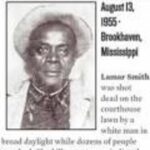 During the middle of the morning, while he was encouraging African Americans to vote in a local run-off election, 63-year-old Black farmer and World War I veteran Lamar Smith is shot and killed on the lawn of the Lincoln County Courthouse in front of dozens of witnesses in Brookhaven, Mississippi. Sheriff Robert E. Case was one of the witnesses; Case permitted the alleged assailants to leave the crime scene covered in blood. Days later, that man and two others were arrested in connection with the shooting. All three suspects were white. In September 1955, a grand jury composed of 20 white men declined to indict the three suspects for murder after witnesses failed to come forward to testify. Although, District Attorney E.C. Barlow criticized the lack of witness cooperation and complained about the sheriff’s handling of the case, the criminal case against the three suspects was dismissed and no one was punished for Lamar Smith's murder. Learn more. During the middle of the morning, while he was encouraging African Americans to vote in a local run-off election, 63-year-old Black farmer and World War I veteran Lamar Smith is shot and killed on the lawn of the Lincoln County Courthouse in front of dozens of witnesses in Brookhaven, Mississippi. Sheriff Robert E. Case was one of the witnesses; Case permitted the alleged assailants to leave the crime scene covered in blood. Days later, that man and two others were arrested in connection with the shooting. All three suspects were white. In September 1955, a grand jury composed of 20 white men declined to indict the three suspects for murder after witnesses failed to come forward to testify. Although, District Attorney E.C. Barlow criticized the lack of witness cooperation and complained about the sheriff’s handling of the case, the criminal case against the three suspects was dismissed and no one was punished for Lamar Smith's murder. Learn more. | |
| August 14, 1883 | 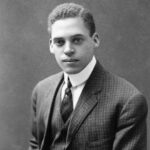 Dr. Ernest E. Just, one of the first African Americans to receive worldwide recognition as a scientist, primarily for his recognition of the fundamental role of the cell surface in the development of organisms, is born in Charleston, South Carolina. In 1896, Just was sent to attend the high school of the Colored Normal Industrial, Agricultural & Mechanical College (later named South Carolina State University). Believing that he would receive a superior education by attending a college preparatory school in the North, Just enrolled in Kimball Union Academy in New Hampshire in 1900. Although he was Kimball Union’s only black student, Just recalled being in a warm and welcoming environment where he excelled in social activities and academics. After graduation from Kimball Union, Just entered Dartmouth College in 1903. In contrast to his experience at Kimball Union, Just felt alone and socially isolated at Dartmouth. Nonetheless, he graduated magna cum laude in biology with a minor in history in 1907. He was also elected to Phi Beta Kappa. Just accepted a position at Howard University as an instructor of rhetoric and English. In 1910, he joined the Department of Biology and was appointed professor in 1912. Just worked for many years at the Marine Biological Laboratory in Woods Hole, Massachusetts. At the laboratory, Just realized that a doctorate in the sciences was key to his success, and he began a program of self-study at the University of Chicago. He earned a doctorate in zoology in 1916. Unable to find work at any major American university because of his race, Just continued his research in Naples, Italy and subsequently became the first American to be invited to conduct research at the Kaiser Wilhelm Institute in Berlin, Germany. Just published fifty scientific papers and two influential books, Basic Methods for Experiments on Eggs of Marine Mammals (1922) and Biology of the Cell Surface (1939). Learn more. Dr. Ernest E. Just, one of the first African Americans to receive worldwide recognition as a scientist, primarily for his recognition of the fundamental role of the cell surface in the development of organisms, is born in Charleston, South Carolina. In 1896, Just was sent to attend the high school of the Colored Normal Industrial, Agricultural & Mechanical College (later named South Carolina State University). Believing that he would receive a superior education by attending a college preparatory school in the North, Just enrolled in Kimball Union Academy in New Hampshire in 1900. Although he was Kimball Union’s only black student, Just recalled being in a warm and welcoming environment where he excelled in social activities and academics. After graduation from Kimball Union, Just entered Dartmouth College in 1903. In contrast to his experience at Kimball Union, Just felt alone and socially isolated at Dartmouth. Nonetheless, he graduated magna cum laude in biology with a minor in history in 1907. He was also elected to Phi Beta Kappa. Just accepted a position at Howard University as an instructor of rhetoric and English. In 1910, he joined the Department of Biology and was appointed professor in 1912. Just worked for many years at the Marine Biological Laboratory in Woods Hole, Massachusetts. At the laboratory, Just realized that a doctorate in the sciences was key to his success, and he began a program of self-study at the University of Chicago. He earned a doctorate in zoology in 1916. Unable to find work at any major American university because of his race, Just continued his research in Naples, Italy and subsequently became the first American to be invited to conduct research at the Kaiser Wilhelm Institute in Berlin, Germany. Just published fifty scientific papers and two influential books, Basic Methods for Experiments on Eggs of Marine Mammals (1922) and Biology of the Cell Surface (1939). Learn more. | |
| August 14, 1894 | 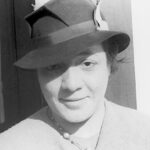 Ada Beatrice Queen Victoria Louise Virginia Smith, better known as "Bricktop", is born in Alderson, West Virginia, the youngest of four children by a Black father and a mixed-race Black mother, who had been born into slavery two years before the Emancipation Proclamation. Smith was an American dancer, jazz singer, vaudevillian, and self-described saloon-keeper who owned the nightclub Chez Bricktop in Paris from 1924 to 1961, as well as clubs in Mexico City and Rome. She has been called "one of the most legendary and enduring figures of twentieth-century American cultural history". Learn more. Ada Beatrice Queen Victoria Louise Virginia Smith, better known as "Bricktop", is born in Alderson, West Virginia, the youngest of four children by a Black father and a mixed-race Black mother, who had been born into slavery two years before the Emancipation Proclamation. Smith was an American dancer, jazz singer, vaudevillian, and self-described saloon-keeper who owned the nightclub Chez Bricktop in Paris from 1924 to 1961, as well as clubs in Mexico City and Rome. She has been called "one of the most legendary and enduring figures of twentieth-century American cultural history". Learn more. | |
| August 14, 1908 | 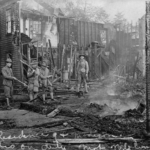 A mob of white citizens gathered at the local jail in Springfield, Illinois, intent on lynching two Black men. When the mob learned that the men had been taken from the jail to another city, a violent riot broke out. The mob attacked police and militia stationed at the jail, destroyed the business of Henry Loper, a man rumored to have helped transport the prisoners from the jail, and then descended on homes and businesses in Springfield’s Black neighborhoods, stealing close to $150,000 worth of property and setting fire to whole blocks. The next day, white terrorists lynch two Black men. After Scott Burton tried to defend himself against the attackers, he was shot four times, dragged through the streets, then hanged and mutilated until the militia interceded. William Donegan, an 84-year-old Black man married to a white woman, was taken from his home and hanged from a tree across the street, where his assailants cut his throat and stabbed him. Mr. Donegan was still alive when the militia arrived at the scene but died the next morning. Police arrested 150 people suspected of participating in the violence and 117 were indicted. Of the three individuals indicted for murder, one committed suicide and two were acquitted. Learn more. A mob of white citizens gathered at the local jail in Springfield, Illinois, intent on lynching two Black men. When the mob learned that the men had been taken from the jail to another city, a violent riot broke out. The mob attacked police and militia stationed at the jail, destroyed the business of Henry Loper, a man rumored to have helped transport the prisoners from the jail, and then descended on homes and businesses in Springfield’s Black neighborhoods, stealing close to $150,000 worth of property and setting fire to whole blocks. The next day, white terrorists lynch two Black men. After Scott Burton tried to defend himself against the attackers, he was shot four times, dragged through the streets, then hanged and mutilated until the militia interceded. William Donegan, an 84-year-old Black man married to a white woman, was taken from his home and hanged from a tree across the street, where his assailants cut his throat and stabbed him. Mr. Donegan was still alive when the militia arrived at the scene but died the next morning. Police arrested 150 people suspected of participating in the violence and 117 were indicted. Of the three individuals indicted for murder, one committed suicide and two were acquitted. Learn more. | |
| August 14, 1914 | 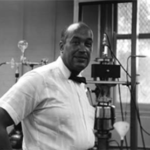 Biophysics pioneer, education advocate, and activist Dr. Herman Branson is born in Pocahontas, Virginia. After a primary and elementary education, Branson attended Virginia College (now Virginia State University). After receiving a Bachelor of Science degree in 1936, Branson enrolled in the University of Cincinnati where he studied physics. In 1939, he received a Ph.D. and started a career in academia. From 1942 to 1943 he served as Assistant Professor of Physics and Chemistry at Howard University. Simultaneously, Branson also served as the Director of the Experimental Science and Mathematics Technology (ESMWT) Program in Physics. In 1944, Dr. Branson became a tenured professor of Physics and was named Chairman of the Physics Department of Howard University. He would serve, nearly uninterrupted, in this capacity from 1941 to 1968. In 1948, Branson entered into partnership with Linus Pauling at the California Institute of Technology, focusing on the structure of proteins. Branson pioneered the use of mathematics to determine possible helical structures that would fit the x-ray data, as well as chemical restrictions that had been outlined by Pauling. Branson narrowed the possible structures of two helices. The two coils were named Alpha and Gamma. Pauling initially dismissed Branson’s work, saying that the shape of Branson’s coil was impossible. Later, however, Pauling published the data in his own name, giving Herman Branson minor credit for his original research. In the initial press release from Caltech University, announcing the discovery of the Alpha Helix, Herman Branson’s name is excluded. When Linus Pauling received a Nobel Prize for his contribution to Chemistry in 1954, Branson was not credited for his contribution. After working with Pauling, Branson returned to his position at Howard University as a full professor of Physics and Chairman of the Physics Department. He stayed at Howard University for 27 years, teaching and directing. In 1968, he served briefly as the President of Central State University in Ohio. In 1970, Branson assumed the position of President at Lincoln University of Pennsylvania where he served until his retirement in 1985. Dr. Branson published more than one hundred articles in his lifetime on topics including physics, biology, science education, and the importance of Historically Black Colleges and Universities (HBCUs). Learn more. Biophysics pioneer, education advocate, and activist Dr. Herman Branson is born in Pocahontas, Virginia. After a primary and elementary education, Branson attended Virginia College (now Virginia State University). After receiving a Bachelor of Science degree in 1936, Branson enrolled in the University of Cincinnati where he studied physics. In 1939, he received a Ph.D. and started a career in academia. From 1942 to 1943 he served as Assistant Professor of Physics and Chemistry at Howard University. Simultaneously, Branson also served as the Director of the Experimental Science and Mathematics Technology (ESMWT) Program in Physics. In 1944, Dr. Branson became a tenured professor of Physics and was named Chairman of the Physics Department of Howard University. He would serve, nearly uninterrupted, in this capacity from 1941 to 1968. In 1948, Branson entered into partnership with Linus Pauling at the California Institute of Technology, focusing on the structure of proteins. Branson pioneered the use of mathematics to determine possible helical structures that would fit the x-ray data, as well as chemical restrictions that had been outlined by Pauling. Branson narrowed the possible structures of two helices. The two coils were named Alpha and Gamma. Pauling initially dismissed Branson’s work, saying that the shape of Branson’s coil was impossible. Later, however, Pauling published the data in his own name, giving Herman Branson minor credit for his original research. In the initial press release from Caltech University, announcing the discovery of the Alpha Helix, Herman Branson’s name is excluded. When Linus Pauling received a Nobel Prize for his contribution to Chemistry in 1954, Branson was not credited for his contribution. After working with Pauling, Branson returned to his position at Howard University as a full professor of Physics and Chairman of the Physics Department. He stayed at Howard University for 27 years, teaching and directing. In 1968, he served briefly as the President of Central State University in Ohio. In 1970, Branson assumed the position of President at Lincoln University of Pennsylvania where he served until his retirement in 1985. Dr. Branson published more than one hundred articles in his lifetime on topics including physics, biology, science education, and the importance of Historically Black Colleges and Universities (HBCUs). Learn more. | |
| August 15, 1829 | 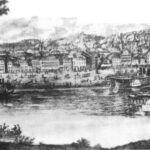 A two-week reign of white terror against African Americans begins in Cincinnati, Ohio. Previously, the Cincinnati Daily Gazette printed a notice warning that the city would rigidly enforce the Black Act of 1807, requiring all Black residents to enter into bond or face expulsion. The Black population understood that warning as a threat of mob violence. White mobs estimated at times at 200 to 300 led by Irish immigrants invaded the riverfront area where African Americans lived with the avowed intent to drive them all out of the city. The mob burned shelters and homes and assaulted a number of individuals. African Americans fought back but the attacks persuaded many in the Black population to evacuate Cincinnati. A number of them emigrated to Canada to a community they named Wilberforce. Those who stayed behind attempted to rebuild their lives but experienced further white assaults in 1836 and beyond. Learn more. A two-week reign of white terror against African Americans begins in Cincinnati, Ohio. Previously, the Cincinnati Daily Gazette printed a notice warning that the city would rigidly enforce the Black Act of 1807, requiring all Black residents to enter into bond or face expulsion. The Black population understood that warning as a threat of mob violence. White mobs estimated at times at 200 to 300 led by Irish immigrants invaded the riverfront area where African Americans lived with the avowed intent to drive them all out of the city. The mob burned shelters and homes and assaulted a number of individuals. African Americans fought back but the attacks persuaded many in the Black population to evacuate Cincinnati. A number of them emigrated to Canada to a community they named Wilberforce. Those who stayed behind attempted to rebuild their lives but experienced further white assaults in 1836 and beyond. Learn more. | |
| August 15, 1907 | 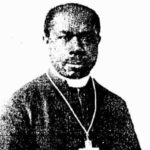 Robert Josias "Raphael" Morgan is ordained as the first Black Eastern Orthodox priest in the United States. After being active in other denominations, including the AME Church, Church of England, and the Episcopal Church, Morgan converted to Orthodoxy. He was ordained as an Orthodox priest of the Ecumenical Patriarchate in Constantinople (Istanbul). He was designated as "Missionary (Greek: Ιεραποστολος) to America and the West Indies." Learn more. Robert Josias "Raphael" Morgan is ordained as the first Black Eastern Orthodox priest in the United States. After being active in other denominations, including the AME Church, Church of England, and the Episcopal Church, Morgan converted to Orthodoxy. He was ordained as an Orthodox priest of the Ecumenical Patriarchate in Constantinople (Istanbul). He was designated as "Missionary (Greek: Ιεραποστολος) to America and the West Indies." Learn more. | |
| August 15, 1962 | 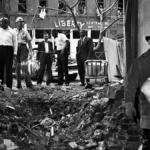 Shady Grove Baptist Church in Leesburg, Georgia, a base for the Student Nonviolent Coordinating Committee (SNCC) and site of voter registration mobilization efforts visited by the civil rights movement’s top leaders, is burned to the ground in suspicious circumstances. It would become the first of four Black churches similarly destroyed that year. Local officials originally attributed the cause to faulty wiring or lightening strike, but that flimsy explanation was disproved two months later when the Federal Bureau of Investigation (FBI), under the direction of J. Edgar Hoover, arrested and charged two White men, Jack Smith and Douglas Parker, with the arson. Learn more. Shady Grove Baptist Church in Leesburg, Georgia, a base for the Student Nonviolent Coordinating Committee (SNCC) and site of voter registration mobilization efforts visited by the civil rights movement’s top leaders, is burned to the ground in suspicious circumstances. It would become the first of four Black churches similarly destroyed that year. Local officials originally attributed the cause to faulty wiring or lightening strike, but that flimsy explanation was disproved two months later when the Federal Bureau of Investigation (FBI), under the direction of J. Edgar Hoover, arrested and charged two White men, Jack Smith and Douglas Parker, with the arson. Learn more. | |
| August 15, 1995 |  Shannon Faulkner matriculates into The Citadel with an otherwise all-male corps of cadets under the escort of United States Marshals, the first female cadet in the institution’s history. She was one of five cadets to suffer heat-stress after the first four hours of training. She spent the remainder of the first week in the infirmary before voluntarily resigning, citing emotional and psychological abuse and physical exhaustion; Faulkner was one of thirty cadets to drop out at that time. After her departure, the male cadets openly celebrated on the campus. In 1999, Faulkner told the Associated Press, "I went into it knowing I may not get anything out of it. I was doing it for the next woman." In a 2012 interview with the Post and Courier newspaper, Faulkner said that what precipitated her leaving so abruptly was a threat to kill her parents by a person present when she entered. Her parents' home was vandalized. After leaving The Citadel, Faulkner attended Anderson College. Upon graduating in 1999, she became a middle school teacher in South Carolina. Learn more. Shannon Faulkner matriculates into The Citadel with an otherwise all-male corps of cadets under the escort of United States Marshals, the first female cadet in the institution’s history. She was one of five cadets to suffer heat-stress after the first four hours of training. She spent the remainder of the first week in the infirmary before voluntarily resigning, citing emotional and psychological abuse and physical exhaustion; Faulkner was one of thirty cadets to drop out at that time. After her departure, the male cadets openly celebrated on the campus. In 1999, Faulkner told the Associated Press, "I went into it knowing I may not get anything out of it. I was doing it for the next woman." In a 2012 interview with the Post and Courier newspaper, Faulkner said that what precipitated her leaving so abruptly was a threat to kill her parents by a person present when she entered. Her parents' home was vandalized. After leaving The Citadel, Faulkner attended Anderson College. Upon graduating in 1999, she became a middle school teacher in South Carolina. Learn more. | |
| August 16, 1902 | 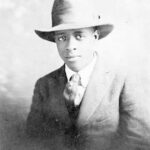 Wallace Thurman, one of the leading novelists, critics, poets, playwrights, and publishers of the Harlem Renaissance, is born in Salt Lake City, Utah. After relocating to Harlem in 1925, Thurman’s writings soon propelled him into the vanguard of the “New Negro Renaissance.” Together with Aaron Douglass, Bruce Nugent, Zora Neale Hurston, and Langston Hughes, Wallace in 1926 founded his third journal: Fire!! Devoted to the Younger Negro Artists. Langston Hughes, Aaron Douglas, Zora Neale Hurston, Richard Bruce Nugent, and Gwendolyn B. Bennett were among the first contributors to Fire!! Thurman published three novels: The Blacker the Berry: A Novel of Negro Life (1929), which explores intra-racial conflicts related to skin color; Infants of the Spring (1932), which satirizes the Harlem Renaissance and its leading artists; and The Interne (1932), co-authored with A.L. Furman. By the time of his death from tuberculosis in 1934 at the young age of 32, Thurman had established himself as a pioneer and literary revolutionary who left an enviable written record as a legacy. Learn more. Wallace Thurman, one of the leading novelists, critics, poets, playwrights, and publishers of the Harlem Renaissance, is born in Salt Lake City, Utah. After relocating to Harlem in 1925, Thurman’s writings soon propelled him into the vanguard of the “New Negro Renaissance.” Together with Aaron Douglass, Bruce Nugent, Zora Neale Hurston, and Langston Hughes, Wallace in 1926 founded his third journal: Fire!! Devoted to the Younger Negro Artists. Langston Hughes, Aaron Douglas, Zora Neale Hurston, Richard Bruce Nugent, and Gwendolyn B. Bennett were among the first contributors to Fire!! Thurman published three novels: The Blacker the Berry: A Novel of Negro Life (1929), which explores intra-racial conflicts related to skin color; Infants of the Spring (1932), which satirizes the Harlem Renaissance and its leading artists; and The Interne (1932), co-authored with A.L. Furman. By the time of his death from tuberculosis in 1934 at the young age of 32, Thurman had established himself as a pioneer and literary revolutionary who left an enviable written record as a legacy. Learn more. | |
| August 16, 1904 |  A white woman in Thomaston, Alabama, claimed that a Black man entered her home and frightened her. An unverified claim circulated that a hat found near the woman’s home belonged to Rufus Lesseur, a 24-year-old Black man. Based on those two unverified claims, a mob of unmasked white men in Marengo County, Alabama, kidnapped Mr. Lesseur, imprisoning him in a makeshift jail in the woods. After a day, the mob lynched Mr. Lesseur and left his body riddled with bullets. Although the lynch mob was composed of unmasked white men in a town with only 300 residents, state officials claimed that no one could be identified, arrested, or prosecuted for the murder. Learn more.
A white woman in Thomaston, Alabama, claimed that a Black man entered her home and frightened her. An unverified claim circulated that a hat found near the woman’s home belonged to Rufus Lesseur, a 24-year-old Black man. Based on those two unverified claims, a mob of unmasked white men in Marengo County, Alabama, kidnapped Mr. Lesseur, imprisoning him in a makeshift jail in the woods. After a day, the mob lynched Mr. Lesseur and left his body riddled with bullets. Although the lynch mob was composed of unmasked white men in a town with only 300 residents, state officials claimed that no one could be identified, arrested, or prosecuted for the murder. Learn more. | |
| August 16, 1922 | 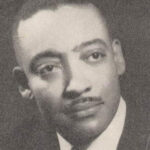 African-American journalist and author Louis Emanuel Lomax is born in Valdosta, Georgia. Lomax attended Paine College in Augusta, Georgia, where he became editor of the student newspaper before he graduated in 1942. He earned an M.A. in 1944 from American University and a Ph.D. in 1947 from Yale University. Lomax began his journalism career at the Afro-American and the Chicago Defender. In 1958, he became the first African-American television journalist when he joined WNTA-TV in New York. In 1959, Lomax initiated and, in collaboration with his colleague Mike Wallace, produced a five-part documentary about the Nation of Islam titled, The Hate That Hate Produced. The program was the first time most white people heard about the Nation and its leader, Elijah Muhammad, as well as its charismatic spokesman, Malcolm X. Lomax later became a freelance writer, with his work appearing in publications such as Harper's, Life, Pageant, The Nation, and The New Leader. His subjects included the Civil Rights Movement, the Nation of Islam, and the Black Panther Party. In 1961, he was awarded the Anisfield-Wolf Book Award for his book, The Reluctant African. Learn more. African-American journalist and author Louis Emanuel Lomax is born in Valdosta, Georgia. Lomax attended Paine College in Augusta, Georgia, where he became editor of the student newspaper before he graduated in 1942. He earned an M.A. in 1944 from American University and a Ph.D. in 1947 from Yale University. Lomax began his journalism career at the Afro-American and the Chicago Defender. In 1958, he became the first African-American television journalist when he joined WNTA-TV in New York. In 1959, Lomax initiated and, in collaboration with his colleague Mike Wallace, produced a five-part documentary about the Nation of Islam titled, The Hate That Hate Produced. The program was the first time most white people heard about the Nation and its leader, Elijah Muhammad, as well as its charismatic spokesman, Malcolm X. Lomax later became a freelance writer, with his work appearing in publications such as Harper's, Life, Pageant, The Nation, and The New Leader. His subjects included the Civil Rights Movement, the Nation of Islam, and the Black Panther Party. In 1961, he was awarded the Anisfield-Wolf Book Award for his book, The Reluctant African. Learn more. | |
| August 16, 1947 |  Carol Moseley Braun, the first black woman to be elected to the U.S. Senate, is born in Chicago, Illinois. Moseley Braun graduated from the University of Illinois in 1969, and from the University of Chicago Law School in 1972. Moseley Braun served as assistant prosecutor in the U.S. Attorney’s Office in Chicago from 1972 to 1978, then was elected to the Illinois House of Representatives in which she served for ten years. She became the first African American assistant majority leader in the history of the Illinois legislature. Moseley Braun returned to Chicago in 1988 to serve as Cook County Recorder of Deeds. Carol Moseley Braun upset incumbent Senator Alan Dixon in the Illinois Democratic Primary in 1992 and went on to become the first female Senator elected from Illinois and the first African American woman in the U.S. Senate. During her term in the U.S. Senate (1992-1998) Moseley Braun focused on education issues. She served on the Senate Finance, Banking and Judiciary Committee; the Small Business Committee; and the Housing and Urban Affairs Committee. Learn more. Carol Moseley Braun, the first black woman to be elected to the U.S. Senate, is born in Chicago, Illinois. Moseley Braun graduated from the University of Illinois in 1969, and from the University of Chicago Law School in 1972. Moseley Braun served as assistant prosecutor in the U.S. Attorney’s Office in Chicago from 1972 to 1978, then was elected to the Illinois House of Representatives in which she served for ten years. She became the first African American assistant majority leader in the history of the Illinois legislature. Moseley Braun returned to Chicago in 1988 to serve as Cook County Recorder of Deeds. Carol Moseley Braun upset incumbent Senator Alan Dixon in the Illinois Democratic Primary in 1992 and went on to become the first female Senator elected from Illinois and the first African American woman in the U.S. Senate. During her term in the U.S. Senate (1992-1998) Moseley Braun focused on education issues. She served on the Senate Finance, Banking and Judiciary Committee; the Small Business Committee; and the Housing and Urban Affairs Committee. Learn more. | |
| August 17, 1849 | 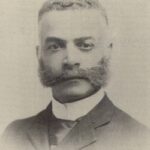 A leading intellectual, activist, and author on racial equality in early 20th century America, Archibald Grimke is born into slavery in South Carolina, the son of Nancy Weston, a slave, and Henry Grimke, her owner. After his father’s death, he and his brother Francis spent eight years living as free men before his half-brother, Montague, took them as servants into his home in 1860. After suffering beatings at Montague’s hand, Archibald fled and hid with relatives until Charleston fell to Union forces in 1865. Grimke attended Lincoln College in Pennsylvania, and in 1872 became one of the first African American students at Harvard Law School in Massachusetts. Upon graduation he established a law practice in Boston, where he became an ardent supporter of suffrage for women and African Americans. From 1894 to 1898, he was consul to Santo Domingo (The Dominican Republic). In 1903, Grimke became president of the American Negro Academy, the nation’s preeminent black intellectual society, a role he held until 1919. In 1909, Archibald Grimke became a founding member of the National Association for the Advancement of Colored People (NAACP). Learn more. A leading intellectual, activist, and author on racial equality in early 20th century America, Archibald Grimke is born into slavery in South Carolina, the son of Nancy Weston, a slave, and Henry Grimke, her owner. After his father’s death, he and his brother Francis spent eight years living as free men before his half-brother, Montague, took them as servants into his home in 1860. After suffering beatings at Montague’s hand, Archibald fled and hid with relatives until Charleston fell to Union forces in 1865. Grimke attended Lincoln College in Pennsylvania, and in 1872 became one of the first African American students at Harvard Law School in Massachusetts. Upon graduation he established a law practice in Boston, where he became an ardent supporter of suffrage for women and African Americans. From 1894 to 1898, he was consul to Santo Domingo (The Dominican Republic). In 1903, Grimke became president of the American Negro Academy, the nation’s preeminent black intellectual society, a role he held until 1919. In 1909, Archibald Grimke became a founding member of the National Association for the Advancement of Colored People (NAACP). Learn more. | |
| August 17, 1915 | 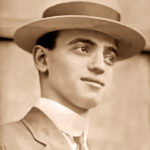 Leo Max Frank is lynched in Marietta, Georgia. Frank, who was Jewish, was an American factory superintendent who was convicted in 1913 of the murder of a 13-year-old employee, Mary Phagan, in Atlanta, Georgia. His trial, conviction, and appeals attracted national attention. His lynching two years later, in response to the commutation of his death sentence, became the focus of social, regional, political, and racial concerns, particularly regarding antisemitism. Today, the consensus of researchers is that Frank was wrongly convicted and Jim Conley was likely the actual murderer. Learn more. Leo Max Frank is lynched in Marietta, Georgia. Frank, who was Jewish, was an American factory superintendent who was convicted in 1913 of the murder of a 13-year-old employee, Mary Phagan, in Atlanta, Georgia. His trial, conviction, and appeals attracted national attention. His lynching two years later, in response to the commutation of his death sentence, became the focus of social, regional, political, and racial concerns, particularly regarding antisemitism. Today, the consensus of researchers is that Frank was wrongly convicted and Jim Conley was likely the actual murderer. Learn more. | |
| August 17, 1923 | 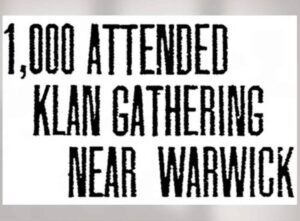 An estimated 1,000 white men and women participated in a Ku Klux Klan initiation ceremony just outside of Warwick, New York. Newspapers reported that motorists traveling from the city of Warwick toward the ceremony site on the evening of August 16 were stopped by Klan guards and asked for a “password” to enter the public area. Beginning at 9 pm, hundreds of white people who arrived for the initiation gathered in an open field near the highway and burned a cross more than 20 feet tall. The meeting lasted until the early hours of the morning on August 17. The leader of the Klansmen reportedly spoke about the organization’s commitment to opposing interracial marriage and immigration. Learn more. An estimated 1,000 white men and women participated in a Ku Klux Klan initiation ceremony just outside of Warwick, New York. Newspapers reported that motorists traveling from the city of Warwick toward the ceremony site on the evening of August 16 were stopped by Klan guards and asked for a “password” to enter the public area. Beginning at 9 pm, hundreds of white people who arrived for the initiation gathered in an open field near the highway and burned a cross more than 20 feet tall. The meeting lasted until the early hours of the morning on August 17. The leader of the Klansmen reportedly spoke about the organization’s commitment to opposing interracial marriage and immigration. Learn more. | |
| August 18, 1907 | 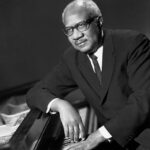 African American composer Howard Swanson, best known for his art songs based on the poetry of Langston Hughes and Paul Lawrence Dunbar, is born into a middle class home in Atlanta, Georgia. Swanson’s first significant composition, “The Negro Speaks of Rivers” (1950), is a musical set to Langston Hughes’s famous poem of that name. His composition was performed in Carnegie Hall by Marian Anderson. Later that year his work Short Symphony was played by the New York Philharmonic orchestra. Swanson’s other works include “Music for Strings” (1952), “Concerto for Orchestra” (1957), and “Symphony No. 3” (1969). Howard Swanson’s style was of the neoclassical school. Although his music drew mostly from western European styles he did incorporate African American styles with the addition of rhythmic complexity, syncopation, and instances of beat phrasing. Learn more. African American composer Howard Swanson, best known for his art songs based on the poetry of Langston Hughes and Paul Lawrence Dunbar, is born into a middle class home in Atlanta, Georgia. Swanson’s first significant composition, “The Negro Speaks of Rivers” (1950), is a musical set to Langston Hughes’s famous poem of that name. His composition was performed in Carnegie Hall by Marian Anderson. Later that year his work Short Symphony was played by the New York Philharmonic orchestra. Swanson’s other works include “Music for Strings” (1952), “Concerto for Orchestra” (1957), and “Symphony No. 3” (1969). Howard Swanson’s style was of the neoclassical school. Although his music drew mostly from western European styles he did incorporate African American styles with the addition of rhythmic complexity, syncopation, and instances of beat phrasing. Learn more. | |
| August 18, 1920 | 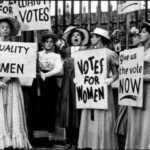 The Nineteenth Amendment (Amendment XIX) to the United States Constitution is ratified by the 36th state and thereby takes effect, essentially guaranteeing women the right to vote. Specifically, the amendment prohibits the United States and its states from denying the right to vote to citizens of the United States on the basis of sex. The amendment was the culmination of a decades-long movement for women's suffrage in the United States, at both the state and national levels, and was part of the worldwide movement towards women's suffrage and part of the wider women's rights movement. The first women's suffrage amendment was introduced in Congress in 1878. However, a suffrage amendment did not pass the House of Representatives until May 21, 1919, which was quickly followed by the Senate, on June 4, 1919. It was then submitted to the states for ratification, achieving the requisite 36 ratifications to secure adoption, and thereby go into effect, on August 18, 1920. The Nineteenth Amendment's adoption was certified on August 26, 1920. Learn more. The Nineteenth Amendment (Amendment XIX) to the United States Constitution is ratified by the 36th state and thereby takes effect, essentially guaranteeing women the right to vote. Specifically, the amendment prohibits the United States and its states from denying the right to vote to citizens of the United States on the basis of sex. The amendment was the culmination of a decades-long movement for women's suffrage in the United States, at both the state and national levels, and was part of the worldwide movement towards women's suffrage and part of the wider women's rights movement. The first women's suffrage amendment was introduced in Congress in 1878. However, a suffrage amendment did not pass the House of Representatives until May 21, 1919, which was quickly followed by the Senate, on June 4, 1919. It was then submitted to the states for ratification, achieving the requisite 36 ratifications to secure adoption, and thereby go into effect, on August 18, 1920. The Nineteenth Amendment's adoption was certified on August 26, 1920. Learn more. | |
| August 19, 1791 | 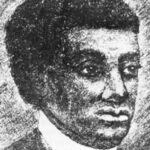 Benjamin Banneker, a free African-American almanac author, surveyor, landowner and farmer who had knowledge of mathematics and natural history, composes and sends to then-Secretary of State (and author of the Declaration of Independence) Thomas Jefferson an historic letter in which he beseeches Jefferson to work for the abolition of slavery. In the letter, Banneker presents Jefferson with the handwritten draft of Banneker’s astronomical almanac for 1792, the first in his series of highly regarded, commercially-successful almanacs. Born in Baltimore County, Maryland, to a free African-American woman and a former slave, Banneker had little or no formal education and was largely self-taught. He became known for assisting Major Andrew Ellicott in a survey that established the original borders of the District of Columbia, the federal capital district of the United States. Banneker's knowledge of astronomy helped him author his series of almanacs. Abolitionists and advocates of racial equality promoted and praised Banneker's works. Learn more about Banneker and read his letter to Jefferson. Benjamin Banneker, a free African-American almanac author, surveyor, landowner and farmer who had knowledge of mathematics and natural history, composes and sends to then-Secretary of State (and author of the Declaration of Independence) Thomas Jefferson an historic letter in which he beseeches Jefferson to work for the abolition of slavery. In the letter, Banneker presents Jefferson with the handwritten draft of Banneker’s astronomical almanac for 1792, the first in his series of highly regarded, commercially-successful almanacs. Born in Baltimore County, Maryland, to a free African-American woman and a former slave, Banneker had little or no formal education and was largely self-taught. He became known for assisting Major Andrew Ellicott in a survey that established the original borders of the District of Columbia, the federal capital district of the United States. Banneker's knowledge of astronomy helped him author his series of almanacs. Abolitionists and advocates of racial equality promoted and praised Banneker's works. Learn more about Banneker and read his letter to Jefferson. | |
| August 19, 1916 | 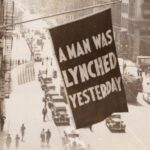 Five Black individuals—Andrew McHenry, Bert Dennis, John Haskins, Mary Dennis and Stella Young—are lynched by a mob of white people in Alachua County, Florida, while a Black man named James Dennis is killed nearby by a “sheriff’s posse.” On the same day, almost 1,000 miles away, in Navarro County, Texas, Ed Lang, a 21-year-old Black man is lynched by a mob of 200 white people. Both of these incidents of racial terror violence occurr just months before the U.S. enters World War I to fight on behalf of the principles of democracy and freedom. Lynchings and racial terror during this era reinforced racial hierarchy and fostered lawlessness and disregard for constitutional guarantees of equal protection. Despite the tragedy of this violence, hundreds of thousands of Black people fought to defend the U.S. when it was threatened during World War I. Learn more. Five Black individuals—Andrew McHenry, Bert Dennis, John Haskins, Mary Dennis and Stella Young—are lynched by a mob of white people in Alachua County, Florida, while a Black man named James Dennis is killed nearby by a “sheriff’s posse.” On the same day, almost 1,000 miles away, in Navarro County, Texas, Ed Lang, a 21-year-old Black man is lynched by a mob of 200 white people. Both of these incidents of racial terror violence occurr just months before the U.S. enters World War I to fight on behalf of the principles of democracy and freedom. Lynchings and racial terror during this era reinforced racial hierarchy and fostered lawlessness and disregard for constitutional guarantees of equal protection. Despite the tragedy of this violence, hundreds of thousands of Black people fought to defend the U.S. when it was threatened during World War I. Learn more. | |
| August 19, 1991 | 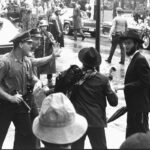 Three days of rioting erupt in the Crown Heights section of Brooklyn, New York City. Black residents turned against Orthodox Jewish Chabad residents, resulting in a deterioration of already tense racial relations in the densely populated community. The riots began after two children of Guyanese immigrants were accidentally struck by a car running a red or yellow light while following the motorcade of Rebbe Menachem Mendel Schneerson, the leader of Chabad, a Jewish religious movement. One child died and the second was severely injured. In the wake of the fatal accident, some Black youths attacked Jews on the street, seriously injuring several and fatally injuring an Orthodox Jewish student from Australia. The riots were a major issue in the 1993 mayoral race, contributing to the defeat of Mayor David Dinkins, an African American, who was blamed for an ineffective police response. Ultimately, Black and Jewish leaders developed an outreach program between their communities to help calm and possibly improve racial relations in Crown Heights over the next decade. Learn more.
Three days of rioting erupt in the Crown Heights section of Brooklyn, New York City. Black residents turned against Orthodox Jewish Chabad residents, resulting in a deterioration of already tense racial relations in the densely populated community. The riots began after two children of Guyanese immigrants were accidentally struck by a car running a red or yellow light while following the motorcade of Rebbe Menachem Mendel Schneerson, the leader of Chabad, a Jewish religious movement. One child died and the second was severely injured. In the wake of the fatal accident, some Black youths attacked Jews on the street, seriously injuring several and fatally injuring an Orthodox Jewish student from Australia. The riots were a major issue in the 1993 mayoral race, contributing to the defeat of Mayor David Dinkins, an African American, who was blamed for an ineffective police response. Ultimately, Black and Jewish leaders developed an outreach program between their communities to help calm and possibly improve racial relations in Crown Heights over the next decade. Learn more. | |
| August 20, 1619 | 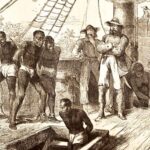 The first enslaved Africans are brought to what would later become the United States. The stage was set for slavery in the U.S. as early as the 14th century, when Spain and Portugal began to capture Africans for enslavement in Europe. Slavery eventually expanded to colonial America, where the first enslaved Africans were brought into the Virginia colony at Point Comfort on the James River on August 20, 1619. It was reported that, “20 and odd Negroes” from the White Lion, an English ship, were sold in exchange for food; the remaining Africans were transported to Jamestown, Virginia and sold into slavery. Learn more. The first enslaved Africans are brought to what would later become the United States. The stage was set for slavery in the U.S. as early as the 14th century, when Spain and Portugal began to capture Africans for enslavement in Europe. Slavery eventually expanded to colonial America, where the first enslaved Africans were brought into the Virginia colony at Point Comfort on the James River on August 20, 1619. It was reported that, “20 and odd Negroes” from the White Lion, an English ship, were sold in exchange for food; the remaining Africans were transported to Jamestown, Virginia and sold into slavery. Learn more. | |
| August 20, 1948 | 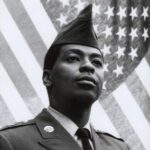 Perry James Henry Watkins, the only openly gay person to be discharged from the U.S. Army with full honors, is born in Joplin, Missouri. After serving almost two decades in the Army, Watkins had to fight to secure this distinction, suing the Army after being forced out because of his sexual orientation. The case went all the way to the Supreme Court. In 1967, during the Vietnam War, Watkins received his draft summons. He marked “yes” on his inductee questionnaire when asked about “homosexual tendencies.” The Army responded by sending him to a psychiatrist who interrogated Watkins about his sexuality but also asked if Watkins had a problem serving his country. Watkins answered, “No problem.” Consequently, his military career as an openly gay man began in May 1968. Several times in those early years he tried to leave the military due to his sexual orientation after hearing that the Army dismissed several white gay peers for that reason. The military, however, denied Watkins’ requests. He surmised that the primary reason for this differential treatment was his race. He reenlisted, again honestly answering the homosexuality question and again, the Army accepted him. Watkins served twice in Korea in the early 1970s. During this period he signed up to entertain the troops using his female impersonator role, Simone, and performed in Army clubs in Germany and throughout Europe. Watkins received several commendations during his years of service. In 1975, without warning, Watkins’ commanding officer started proceedings to discharge him. Watkins, however, fought these charges. In 1979, his military-clearance renewal was rejected due to his gay status. Two years later he sued the Army, which responded by discharging him for being gay. That the Army had earlier accepted Watkins’s sexual orientation early in his career and then later removed him for it, became the center of his nine year legal challenge, which was decided in 1990 by the U.S. Supreme Court. The Court rejected the Army’s argument and ordered him to be reinstated with back pay, retirement benefits, and retroactive promotion to Sergeant First Class. Watkins was then honorably discharged from the U.S. Army in 1990. Learn more. Perry James Henry Watkins, the only openly gay person to be discharged from the U.S. Army with full honors, is born in Joplin, Missouri. After serving almost two decades in the Army, Watkins had to fight to secure this distinction, suing the Army after being forced out because of his sexual orientation. The case went all the way to the Supreme Court. In 1967, during the Vietnam War, Watkins received his draft summons. He marked “yes” on his inductee questionnaire when asked about “homosexual tendencies.” The Army responded by sending him to a psychiatrist who interrogated Watkins about his sexuality but also asked if Watkins had a problem serving his country. Watkins answered, “No problem.” Consequently, his military career as an openly gay man began in May 1968. Several times in those early years he tried to leave the military due to his sexual orientation after hearing that the Army dismissed several white gay peers for that reason. The military, however, denied Watkins’ requests. He surmised that the primary reason for this differential treatment was his race. He reenlisted, again honestly answering the homosexuality question and again, the Army accepted him. Watkins served twice in Korea in the early 1970s. During this period he signed up to entertain the troops using his female impersonator role, Simone, and performed in Army clubs in Germany and throughout Europe. Watkins received several commendations during his years of service. In 1975, without warning, Watkins’ commanding officer started proceedings to discharge him. Watkins, however, fought these charges. In 1979, his military-clearance renewal was rejected due to his gay status. Two years later he sued the Army, which responded by discharging him for being gay. That the Army had earlier accepted Watkins’s sexual orientation early in his career and then later removed him for it, became the center of his nine year legal challenge, which was decided in 1990 by the U.S. Supreme Court. The Court rejected the Army’s argument and ordered him to be reinstated with back pay, retirement benefits, and retroactive promotion to Sergeant First Class. Watkins was then honorably discharged from the U.S. Army in 1990. Learn more. | |
| August 20, 1993 |  Fionnghuala O’Reilly is born in Hardin County, Kentucky, the daughter of Irishman Fergal O’Reilly, a bricklayer and painter, and Vanetta O’Reilly, an African American he met in San Francisco. When her father was finally able to enlist in the United States Army the family, comprised of six girls, made visits to Sword, Ireland, her father’s birthplace. After years spent living outside a military base in Germany the family relocated in California. At age 9 an affinity for math and science resulted in O’Reilly’s attendance at Space Camp in Huntsville, Alabama, and as a teenager participation in the Summer Math and Science Honors Academy at the University of California at Berkeley. O’Reilly earned her bachelor’s degree in systems engineering from George Washington University. A tip from a friend lead to a position in the Datanaut program at the National Aeronautics and Space Administration (NASA) and promotion to executive director of the NASA Space Apps Challenge which allowed her work remotely from her home in Dublin, Ireland. On August 1, 2019, O’Reilly competed for the title of Miss Universe Ireland against 28 finalists in the Round Room of the Mansion House on Dublin’s Dawson Street, where she won the crown, the first person of color and the first person of African heritage to claim victory in the history of the contest. Returning from Atlanta, Georgia, representing Ireland in the 2019 Miss Universe Contest, O’Reilly continued her association with Girls Who Code, a NASA-related program aimed at girls interested in STEM fields, and #ReachForTheStars, a social media initiative she launched that promotes women and diversity in STEM. Learn more. Fionnghuala O’Reilly is born in Hardin County, Kentucky, the daughter of Irishman Fergal O’Reilly, a bricklayer and painter, and Vanetta O’Reilly, an African American he met in San Francisco. When her father was finally able to enlist in the United States Army the family, comprised of six girls, made visits to Sword, Ireland, her father’s birthplace. After years spent living outside a military base in Germany the family relocated in California. At age 9 an affinity for math and science resulted in O’Reilly’s attendance at Space Camp in Huntsville, Alabama, and as a teenager participation in the Summer Math and Science Honors Academy at the University of California at Berkeley. O’Reilly earned her bachelor’s degree in systems engineering from George Washington University. A tip from a friend lead to a position in the Datanaut program at the National Aeronautics and Space Administration (NASA) and promotion to executive director of the NASA Space Apps Challenge which allowed her work remotely from her home in Dublin, Ireland. On August 1, 2019, O’Reilly competed for the title of Miss Universe Ireland against 28 finalists in the Round Room of the Mansion House on Dublin’s Dawson Street, where she won the crown, the first person of color and the first person of African heritage to claim victory in the history of the contest. Returning from Atlanta, Georgia, representing Ireland in the 2019 Miss Universe Contest, O’Reilly continued her association with Girls Who Code, a NASA-related program aimed at girls interested in STEM fields, and #ReachForTheStars, a social media initiative she launched that promotes women and diversity in STEM. Learn more. | |
| August 21, 1831 | 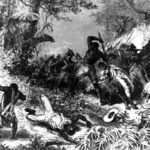 Nat Turner's Rebellion (also known as the Southampton Insurrection), a rebellion of enslaved and free Black Virginians, begins in Southampton County, Virginia. Nat Turner, an enslaved African-American preacher, led the rebellion. The rebels killed between 55 and 65 people, at least 51 of whom were white. The rebellion was put down within a few days, but Turner survived in hiding for more than two months afterwards. The rebellion was effectively suppressed at Belmont Plantation on the morning of August 23, 1831. There was widespread fear in the aftermath, and militias organized in retaliation to the rebels. The state executed 56 enslaved people accused of being part of the rebellion, and many non-participant enslaved individuals were punished in the frenzy. Approximately 120 enslaved people and free African Americans were killed by militias and mobs in the area. State legislatures passed new laws prohibiting education of enslaved people and free Black people, restricting rights of assembly and other civil liberties for free Black people, and requiring white ministers to be present at all worship services. Learn more. Nat Turner's Rebellion (also known as the Southampton Insurrection), a rebellion of enslaved and free Black Virginians, begins in Southampton County, Virginia. Nat Turner, an enslaved African-American preacher, led the rebellion. The rebels killed between 55 and 65 people, at least 51 of whom were white. The rebellion was put down within a few days, but Turner survived in hiding for more than two months afterwards. The rebellion was effectively suppressed at Belmont Plantation on the morning of August 23, 1831. There was widespread fear in the aftermath, and militias organized in retaliation to the rebels. The state executed 56 enslaved people accused of being part of the rebellion, and many non-participant enslaved individuals were punished in the frenzy. Approximately 120 enslaved people and free African Americans were killed by militias and mobs in the area. State legislatures passed new laws prohibiting education of enslaved people and free Black people, restricting rights of assembly and other civil liberties for free Black people, and requiring white ministers to be present at all worship services. Learn more. | |
| August 21, 1959 | 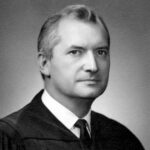 Five years after the United States Supreme Court ruled school segregation to be unconstitutional in its decision in Brown v. Board of Education, Arkansas Supreme Court Justice Jim Johnson exhorts a crowd of 1,000 white residents in Pine Bluff, Arkansas, to “do what needs to be done” to fight the proposed integration of schools in the Dollarway School District. “When Dollarway falls,” Johnson told the cheering crowd, “Arkansas falls!” Johnson was an outspoken segregationist who was openly backed by the KKK. Johnson responded to the Brown decision by forming the White Citizens’ Council of Arkansas, which opposed integration and initiated a voter-passed amendment to the Arkansas Constitution authorizing state officials to ignore federal law. Johnson pressured Arkansas Governor Orval Faubus to embrace segregation and defy federal orders to desegregate Little Rock Central High School in 1957. The massive resistance to integration by the white community was largely successful in preventing integration of schools, especially in the South. Learn more. Five years after the United States Supreme Court ruled school segregation to be unconstitutional in its decision in Brown v. Board of Education, Arkansas Supreme Court Justice Jim Johnson exhorts a crowd of 1,000 white residents in Pine Bluff, Arkansas, to “do what needs to be done” to fight the proposed integration of schools in the Dollarway School District. “When Dollarway falls,” Johnson told the cheering crowd, “Arkansas falls!” Johnson was an outspoken segregationist who was openly backed by the KKK. Johnson responded to the Brown decision by forming the White Citizens’ Council of Arkansas, which opposed integration and initiated a voter-passed amendment to the Arkansas Constitution authorizing state officials to ignore federal law. Johnson pressured Arkansas Governor Orval Faubus to embrace segregation and defy federal orders to desegregate Little Rock Central High School in 1957. The massive resistance to integration by the white community was largely successful in preventing integration of schools, especially in the South. Learn more. | |
| August 21, 1968 | 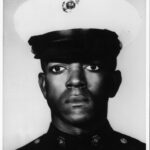 United States Marine Private First Class James Anderson Jr. is posthumously awarded the Medal of Honor for heroism while serving in Vietnam, the first African American U.S. Marine recipient of the Medal of Honor. Joining the U. S. Marine Corps in 1966, Anderson took part in Operation Prairie II in February, 1967. During this operation, Anderson's platoon was advancing through the jungle near Cam Lo Combat Base when they were ambushed by North Vietnamese forces. Anderson jumped on a grenade thrown by a Vietnamese soldier and was killed in action. This action saved other Marines's lives, and Anderson was awarded the Medal of Honor posthumously for his deed. Learn more. United States Marine Private First Class James Anderson Jr. is posthumously awarded the Medal of Honor for heroism while serving in Vietnam, the first African American U.S. Marine recipient of the Medal of Honor. Joining the U. S. Marine Corps in 1966, Anderson took part in Operation Prairie II in February, 1967. During this operation, Anderson's platoon was advancing through the jungle near Cam Lo Combat Base when they were ambushed by North Vietnamese forces. Anderson jumped on a grenade thrown by a Vietnamese soldier and was killed in action. This action saved other Marines's lives, and Anderson was awarded the Medal of Honor posthumously for his deed. Learn more. | |
| August 22, 1880 | 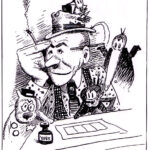 George Joseph Herriman, an American cartoonist best known for the comic strip Krazy Kat (1913–1944), is born in New Orleans, Louisiana to mixed race Creole parents. Herriman grew up in Los Angeles. After he graduated from high school in 1897, he worked in the newspaper industry as an illustrator and engraver. He moved on to cartooning and comic strips—a medium then in its infancy—and drew a variety of strips until he introduced his most famous character, Krazy Kat, in his strip The Dingbat Family in 1910. A Krazy Kat daily strip began in 1913, and from 1916 the strip also appeared on Sundays. It was noted for its poetic, dialect-heavy dialogue; its fantastic, shifting backgrounds; and its bold, experimental page layouts.More influential than popular, Krazy Kat had an appreciative audience among those in the arts. Gilbert Seldes' article "The Krazy Kat Who Walks by Himself" was the earliest example of a critic from the high arts giving serious attention to a comic strip. The Comics Journal placed the strip first on its list of the greatest comics of the 20th century. Herriman's work has been a primary influence on cartoonists such as Will Eisner, Charles M. Schulz, Robert Crumb, Art Spiegelman, Bill Watterson, and Chris Ware. Herriman's artwork made much use of Navajo and Mexican themes and motifs against shifting desert backgrounds. He was a prolific cartoonist who produced a large number of strips and illustrated Don Marquis's books of poetry about Archy and Mehitabel, an alley cat and a cockroach. Newspaper magnate William Randolph Hearst was a proponent of Herriman and gave him a lifetime contract with King Features Syndicate, which guaranteed Herriman a comfortable living and an outlet for his work despite its lack of popularity. Though Herriman's birth certificate lists his race as "colored", he presented himself as white and actively hid his mixed race parentage. Sociologist Arthur Asa Berger made Herriman's mixed-race heritage known in 1971. On reading this, African-American poet Ishmael Reed dedicated his 1972 novel Mumbo Jumbo to "George Herriman, Afro-American, who created Krazy Kat". Learn more. George Joseph Herriman, an American cartoonist best known for the comic strip Krazy Kat (1913–1944), is born in New Orleans, Louisiana to mixed race Creole parents. Herriman grew up in Los Angeles. After he graduated from high school in 1897, he worked in the newspaper industry as an illustrator and engraver. He moved on to cartooning and comic strips—a medium then in its infancy—and drew a variety of strips until he introduced his most famous character, Krazy Kat, in his strip The Dingbat Family in 1910. A Krazy Kat daily strip began in 1913, and from 1916 the strip also appeared on Sundays. It was noted for its poetic, dialect-heavy dialogue; its fantastic, shifting backgrounds; and its bold, experimental page layouts.More influential than popular, Krazy Kat had an appreciative audience among those in the arts. Gilbert Seldes' article "The Krazy Kat Who Walks by Himself" was the earliest example of a critic from the high arts giving serious attention to a comic strip. The Comics Journal placed the strip first on its list of the greatest comics of the 20th century. Herriman's work has been a primary influence on cartoonists such as Will Eisner, Charles M. Schulz, Robert Crumb, Art Spiegelman, Bill Watterson, and Chris Ware. Herriman's artwork made much use of Navajo and Mexican themes and motifs against shifting desert backgrounds. He was a prolific cartoonist who produced a large number of strips and illustrated Don Marquis's books of poetry about Archy and Mehitabel, an alley cat and a cockroach. Newspaper magnate William Randolph Hearst was a proponent of Herriman and gave him a lifetime contract with King Features Syndicate, which guaranteed Herriman a comfortable living and an outlet for his work despite its lack of popularity. Though Herriman's birth certificate lists his race as "colored", he presented himself as white and actively hid his mixed race parentage. Sociologist Arthur Asa Berger made Herriman's mixed-race heritage known in 1971. On reading this, African-American poet Ishmael Reed dedicated his 1972 novel Mumbo Jumbo to "George Herriman, Afro-American, who created Krazy Kat". Learn more. | |
| August 22, 1885 |  Physician and businessman Dr. Midian Othello Bousfield is born in Tipton, Missouri to Willard Hayman Bousfield, a barber and businessman, and Cornelia Catherine Gilbert Bousfield. Dr. Bousfield graduated from the University of Kansas in 1907 with a bachelor of arts degree. He then entered medical school at Northwestern University in Chicago where he earned an M.D. in 1909. The following year Bousfield began working as an intern at Howard University’s Freedman’s Hospital in Washington, D.C. and then worked briefly in Kansas City. Dr. Bousfield was a leader in Chicago’s insurance industry and his diverse career included work in medicine and in the military, advocating for African American health care and for the training of Black medical personnel. He was the first Black person promoted to the rank of colonel in the Army Medical Corps while commanding the Army’s all-African American hospital. Learn more. Physician and businessman Dr. Midian Othello Bousfield is born in Tipton, Missouri to Willard Hayman Bousfield, a barber and businessman, and Cornelia Catherine Gilbert Bousfield. Dr. Bousfield graduated from the University of Kansas in 1907 with a bachelor of arts degree. He then entered medical school at Northwestern University in Chicago where he earned an M.D. in 1909. The following year Bousfield began working as an intern at Howard University’s Freedman’s Hospital in Washington, D.C. and then worked briefly in Kansas City. Dr. Bousfield was a leader in Chicago’s insurance industry and his diverse career included work in medicine and in the military, advocating for African American health care and for the training of Black medical personnel. He was the first Black person promoted to the rank of colonel in the Army Medical Corps while commanding the Army’s all-African American hospital. Learn more.
| |
| August 22, 1978 | 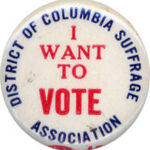 The U.S. Congress proposes the District of Columbia Voting Rights Amendment to the United States Constitution, giving the legislatures of the 50 states seven years to consider it. The propose amendment would have given the District of Columbia full representation in the United States Congress, full representation in the Electoral College system, and full participation in the process by which the Constitution is amended. It would have also repealed the Twenty-third Amendment, which granted the District of Columbia the same number of electoral votes as that of the least populous state, but gave it no role in contingent elections. Ratification by 38 states was necessary for the amendment to become part of the Constitution; only 16 states had ratified it when the seven-year time limit expired on August 22, 1985. This proposed constitutional amendment is the most recent one to have been sent to the states for their consideration. Learn more. The U.S. Congress proposes the District of Columbia Voting Rights Amendment to the United States Constitution, giving the legislatures of the 50 states seven years to consider it. The propose amendment would have given the District of Columbia full representation in the United States Congress, full representation in the Electoral College system, and full participation in the process by which the Constitution is amended. It would have also repealed the Twenty-third Amendment, which granted the District of Columbia the same number of electoral votes as that of the least populous state, but gave it no role in contingent elections. Ratification by 38 states was necessary for the amendment to become part of the Constitution; only 16 states had ratified it when the seven-year time limit expired on August 22, 1985. This proposed constitutional amendment is the most recent one to have been sent to the states for their consideration. Learn more. | |
| August 23, 1961 | 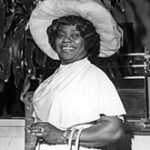 Dr. Vera Mae (Berry) Pigee leads a demonstration to desegregate the Illinois Central train terminal in Clarksdale, Mississippi. Under her leadership, three young students, Adrian Beard (16 year old student attending Immaculate Conception Catholic School), Wilma Jones (14 year old student attending Higgins High School), and Mary Jane Pigee (Vera Mae’s 18 year old daughter at Central State College) went into the terminal to challenge Mississippi’s segregated waiting rooms law. When the agent at the counter refused the purchase, police were called because the protesters refused to move. They were arrested and convicted for violating Mississippi’s segregation law. Undeterred, in the fall of 1961 Vera Mae Pigee and Idessa Johnson went to the whites-only section of Clarksdale Greyhound Bus terminal to stage a protest and continue to challenge the segregation law. This time they were not arrested. Then in December 1961 Dr Pigee and Mary Jane were harassed by Clarksdale police when they entered the whites-only terminal waiting room. They filed a complaint with the U.S. Justice Department, the Interstate Commerce Commission, and the Federal Bureau of Investigation (FBI). The incident also sparked additional protests by other Black residents of Clarksdale against the bus terminal and the police department. Those protests forced the Greyhound terminal to end its segregation policy on December 27, 1961. Learn more. Dr. Vera Mae (Berry) Pigee leads a demonstration to desegregate the Illinois Central train terminal in Clarksdale, Mississippi. Under her leadership, three young students, Adrian Beard (16 year old student attending Immaculate Conception Catholic School), Wilma Jones (14 year old student attending Higgins High School), and Mary Jane Pigee (Vera Mae’s 18 year old daughter at Central State College) went into the terminal to challenge Mississippi’s segregated waiting rooms law. When the agent at the counter refused the purchase, police were called because the protesters refused to move. They were arrested and convicted for violating Mississippi’s segregation law. Undeterred, in the fall of 1961 Vera Mae Pigee and Idessa Johnson went to the whites-only section of Clarksdale Greyhound Bus terminal to stage a protest and continue to challenge the segregation law. This time they were not arrested. Then in December 1961 Dr Pigee and Mary Jane were harassed by Clarksdale police when they entered the whites-only terminal waiting room. They filed a complaint with the U.S. Justice Department, the Interstate Commerce Commission, and the Federal Bureau of Investigation (FBI). The incident also sparked additional protests by other Black residents of Clarksdale against the bus terminal and the police department. Those protests forced the Greyhound terminal to end its segregation policy on December 27, 1961. Learn more. | |
| August 23, 1989 | 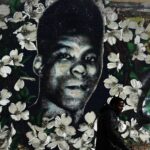 Sixteen-year-old Yusef Hawkins and three friends went to the predominately white Bensonhurst section of Brooklyn, New York, to inquire about a used car for sale. While walking through the neighborhood, the four Black boys encountered a group of 30 white youths gathered in the street. Armed with baseball bats and at least one handgun, the white boys set upon the Black boys. Yusef was shot twice in the chest and was later pronounced dead at the nearby Maimonides Medical Center. It was later discovered that the leader of the group had organized his friends to ambush a Black youth who was rumored to be dating a white girl in the neighborhood who had recently spurned the advances of that leader; the mob mistakenly assumed that Hawkins was the Black youth for whom they intended to ambush. Yusef Hawkins was the third Black male to be murdered by a white mob in increasingly racially-polarized 1980s New York. Learn more. Sixteen-year-old Yusef Hawkins and three friends went to the predominately white Bensonhurst section of Brooklyn, New York, to inquire about a used car for sale. While walking through the neighborhood, the four Black boys encountered a group of 30 white youths gathered in the street. Armed with baseball bats and at least one handgun, the white boys set upon the Black boys. Yusef was shot twice in the chest and was later pronounced dead at the nearby Maimonides Medical Center. It was later discovered that the leader of the group had organized his friends to ambush a Black youth who was rumored to be dating a white girl in the neighborhood who had recently spurned the advances of that leader; the mob mistakenly assumed that Hawkins was the Black youth for whom they intended to ambush. Yusef Hawkins was the third Black male to be murdered by a white mob in increasingly racially-polarized 1980s New York. Learn more. | |
| August 23, 1994 | 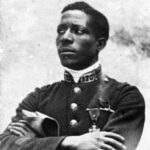 Eugene Bullard, the only African American pilot in World War I, is posthumously commissioned as Second Lieutenant in the United States Air Force. Owing to his race, Bullard was not permitted to fly in the American military, but instead flew for France’s military. Bullard was one of the few Black combat pilots during World War I, along with William Robinson Clarke, a Jamaican who flew for the Royal Flying Corps, Domenico Mondelli from Italy, and Ahmet Ali Çelikten of the Ottoman Empire. Also a boxer and a jazz musician, he was called "L'Hirondelle noire" in French, "Black Swallow". Learn more. Eugene Bullard, the only African American pilot in World War I, is posthumously commissioned as Second Lieutenant in the United States Air Force. Owing to his race, Bullard was not permitted to fly in the American military, but instead flew for France’s military. Bullard was one of the few Black combat pilots during World War I, along with William Robinson Clarke, a Jamaican who flew for the Royal Flying Corps, Domenico Mondelli from Italy, and Ahmet Ali Çelikten of the Ottoman Empire. Also a boxer and a jazz musician, he was called "L'Hirondelle noire" in French, "Black Swallow". Learn more. | |
| August 24, 1923 | 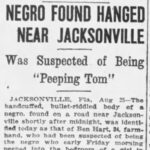 A 34-year-old Black farmhand named Ben Hart is lynched by 10 unmasked men claiming to be sheriff’s deputies near Jacksonville, Florida, after being accused of "peeping" into a young white girl’s bedroom window. Police investigating Ben Hart’s murder soon determined he was at his home 12 miles away when the alleged peeping incident occurred. Learn more. A 34-year-old Black farmhand named Ben Hart is lynched by 10 unmasked men claiming to be sheriff’s deputies near Jacksonville, Florida, after being accused of "peeping" into a young white girl’s bedroom window. Police investigating Ben Hart’s murder soon determined he was at his home 12 miles away when the alleged peeping incident occurred. Learn more. | |
| August 24, 1950 | 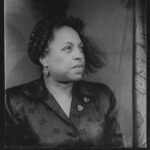 Edith Spurlock Sampson, an American lawyer and judge, becomes the first Black U.S.delegate appointed to the United Nations. on 24 August 1950. Sampson had been forced to leave school at 14 due to family financial difficulties and found work cleaning and deboning fish at a market. She later returned to school and graduated from Peabody High School in Pittsburgh. She then went to work for Associated Charities and studied at the New York School of Social Work. After she received the highest grade in a criminology course, George Kirchwey of Columbia, one of her instructors, encouraged her to become an attorney. She moved to Chicago where, while working full-time during the day as a social worker, she studied law at night. Sampson graduated from John Marshall Law School in 1925 winning a special dean's commendation for ranking at the top of her jurisprudence class. In 1927 Sampson became the first woman to earn a Master of Laws from Loyola University's Graduate Law School. In 1934 Sampson was admitted to practice before the Supreme Court. In 1943, she became one of the first Black members of the National Association of Women Lawyers. In 1947 she was appointed an Assistant State's Attorney in Cook County. Learn more. Edith Spurlock Sampson, an American lawyer and judge, becomes the first Black U.S.delegate appointed to the United Nations. on 24 August 1950. Sampson had been forced to leave school at 14 due to family financial difficulties and found work cleaning and deboning fish at a market. She later returned to school and graduated from Peabody High School in Pittsburgh. She then went to work for Associated Charities and studied at the New York School of Social Work. After she received the highest grade in a criminology course, George Kirchwey of Columbia, one of her instructors, encouraged her to become an attorney. She moved to Chicago where, while working full-time during the day as a social worker, she studied law at night. Sampson graduated from John Marshall Law School in 1925 winning a special dean's commendation for ranking at the top of her jurisprudence class. In 1927 Sampson became the first woman to earn a Master of Laws from Loyola University's Graduate Law School. In 1934 Sampson was admitted to practice before the Supreme Court. In 1943, she became one of the first Black members of the National Association of Women Lawyers. In 1947 she was appointed an Assistant State's Attorney in Cook County. Learn more. | |
| August 24, 2019 |  Elijah McClain, 23-year-old man from Aurora, Colorado, dies of cardiac arrest after being apprehended by police and forcibly injected with sedatives. McClain taught himself to play the violin as a teenager, and he regularly visited animal shelters to play music for abandoned animals to comfort them. On the evening of McClain’s death, three officers from the Aurora Police Department—Nathan Woodyard, Jason Rosenblatt, and Randy Roedema—responded to a 911 call about an individual in a face mask waving his arms. McClain’s friends later noted that he regularly wore a face mask to keep warm due to an anemic condition. He was listening to music and may have been dancing when flailing his arms while walking. In their filed report, the officers claimed that McClain resisted them when confronted and reached for one officer’s holstered gun. No video exists of the encounter because the officers stated their body cameras had fallen off, but the audio recording revealed McClain at one point told the officers, “I am an introvert. Please respect my boundaries that I am speaking. Leave me alone.” The officers handcuffed McClain and pinned him to the ground for fifteen minutes. During that time, he vomited, cried, complained of being unable to breathe, and apologized to the officers. Woodyard placed McClain into a choke-hold, causing him to briefly lose consciousness. Paramedics arrived on the scene and injected McClain with ketamine, a sedative meant to calm him down. McClain suffered cardiac arrest while being transported to the hospital and was pronounced brain dead three days later. Learn more. Elijah McClain, 23-year-old man from Aurora, Colorado, dies of cardiac arrest after being apprehended by police and forcibly injected with sedatives. McClain taught himself to play the violin as a teenager, and he regularly visited animal shelters to play music for abandoned animals to comfort them. On the evening of McClain’s death, three officers from the Aurora Police Department—Nathan Woodyard, Jason Rosenblatt, and Randy Roedema—responded to a 911 call about an individual in a face mask waving his arms. McClain’s friends later noted that he regularly wore a face mask to keep warm due to an anemic condition. He was listening to music and may have been dancing when flailing his arms while walking. In their filed report, the officers claimed that McClain resisted them when confronted and reached for one officer’s holstered gun. No video exists of the encounter because the officers stated their body cameras had fallen off, but the audio recording revealed McClain at one point told the officers, “I am an introvert. Please respect my boundaries that I am speaking. Leave me alone.” The officers handcuffed McClain and pinned him to the ground for fifteen minutes. During that time, he vomited, cried, complained of being unable to breathe, and apologized to the officers. Woodyard placed McClain into a choke-hold, causing him to briefly lose consciousness. Paramedics arrived on the scene and injected McClain with ketamine, a sedative meant to calm him down. McClain suffered cardiac arrest while being transported to the hospital and was pronounced brain dead three days later. Learn more. | |
| August 25, 1860 | 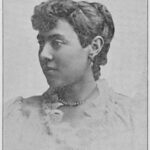 African-American elocutionist, dramatist, impersonator, and activist Henrietta Vinton Davis is born. In addition to being "the premier actor of all nineteenth-century Black performers on the dramatic stage", Davis was proclaimed by Marcus Garvey to be the "greatest woman of the Negro race today". Davis has come to be considered the physical, intellectual, and spiritual link between the abolitionist movement of Frederick Douglass and the African Redemption movement of the UNIA-ACL and Marcus Garvey, the founder of the Universal Negro Improvement Association. At the first international UNIA convention in 1920, she was elected as International Organizer. She had increasingly responsible roles and, after Garvey was deported to Jamaica in 1927, Davis was elected and served as President-General of the UNIA, Inc. from 1934-1940. Learn more. African-American elocutionist, dramatist, impersonator, and activist Henrietta Vinton Davis is born. In addition to being "the premier actor of all nineteenth-century Black performers on the dramatic stage", Davis was proclaimed by Marcus Garvey to be the "greatest woman of the Negro race today". Davis has come to be considered the physical, intellectual, and spiritual link between the abolitionist movement of Frederick Douglass and the African Redemption movement of the UNIA-ACL and Marcus Garvey, the founder of the Universal Negro Improvement Association. At the first international UNIA convention in 1920, she was elected as International Organizer. She had increasingly responsible roles and, after Garvey was deported to Jamaica in 1927, Davis was elected and served as President-General of the UNIA, Inc. from 1934-1940. Learn more. | |
| August 25, 1925 | 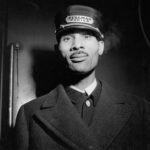 At a meeting in Harlem, NY, 500 Pullman company porters decide to make an effort to organize a union, secretly launching their campaign and choosing A. Philip Randolph, not employed by Pullman and thus beyond retaliation, to lead the effort. The union chose a motto to sum up their resentment over the working conditions: "Fight or Be Slaves". The Brotherhood of Sleeping Car Porters (BSCP) was the first labor organization led by African Americans to receive a charter in the American Federation of Labor (AFL). The BSCP gathered a membership of 18,000 passenger railway workers across Canada, Mexico, and the United States. Beginning after the American Civil War, the job of Pullman porter had become an important means of work in the Black community in the United States. As a result of a decline in railway transportation in the 1960s, BSCP membership declined. It merged in 1978 with the Brotherhood of Railway and Airline Clerks (BRAC), now known as the Transportation Communications International Union. Learn more. At a meeting in Harlem, NY, 500 Pullman company porters decide to make an effort to organize a union, secretly launching their campaign and choosing A. Philip Randolph, not employed by Pullman and thus beyond retaliation, to lead the effort. The union chose a motto to sum up their resentment over the working conditions: "Fight or Be Slaves". The Brotherhood of Sleeping Car Porters (BSCP) was the first labor organization led by African Americans to receive a charter in the American Federation of Labor (AFL). The BSCP gathered a membership of 18,000 passenger railway workers across Canada, Mexico, and the United States. Beginning after the American Civil War, the job of Pullman porter had become an important means of work in the Black community in the United States. As a result of a decline in railway transportation in the 1960s, BSCP membership declined. It merged in 1978 with the Brotherhood of Railway and Airline Clerks (BRAC), now known as the Transportation Communications International Union. Learn more. | |
| August 25, 1927 |  American tennis player and professional golfer, and one of the first Black athletes to cross the color line of international tennis, Althea Neale Gibson is born. In 1956, she became the first African American to win a Grand Slam title (the French Championships). The following year she won both Wimbledon and the US Nationals (precursor of the US Open), then won both again in 1958 and was voted Female Athlete of the Year by the Associated Press in both years. In all, she won 11 Grand Slam tournaments: five singles titles, five doubles titles, and one mixed doubles title. Gibson was inducted into the International Tennis Hall of Fame and the International Women's Sports Hall of Fame. In the early 1960s she also became the first Black player to compete on the Women's Professional Golf Tour. At a time when racism and prejudice were widespread in sports and in society, Gibson was often compared to Jackie Robinson. Learn more. American tennis player and professional golfer, and one of the first Black athletes to cross the color line of international tennis, Althea Neale Gibson is born. In 1956, she became the first African American to win a Grand Slam title (the French Championships). The following year she won both Wimbledon and the US Nationals (precursor of the US Open), then won both again in 1958 and was voted Female Athlete of the Year by the Associated Press in both years. In all, she won 11 Grand Slam tournaments: five singles titles, five doubles titles, and one mixed doubles title. Gibson was inducted into the International Tennis Hall of Fame and the International Women's Sports Hall of Fame. In the early 1960s she also became the first Black player to compete on the Women's Professional Golf Tour. At a time when racism and prejudice were widespread in sports and in society, Gibson was often compared to Jackie Robinson. Learn more. | |
| August 26, 1874 | 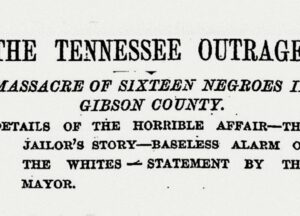 Sixteen Black men who had been accused shooting at two white men were seized from the Gibson County Jail in Trenton, Tennessee, and lynched by a mob of 400-500 masked white men who were mounted on horses and armed with shotguns. Six of the Black men were found lying along nearby Huntingdon Road, their bodies “riddled with bullets.” The bodies of the 10 remaining Black men were later found at the bottom of a river about one mile from town. Piling injury atop injury, the town mayor conjectured that white people were in danger because Black people might retaliate, and ordered police to take all guns belonging to Trenton’s Black residents and to shoot any who resisted. Learn more. Sixteen Black men who had been accused shooting at two white men were seized from the Gibson County Jail in Trenton, Tennessee, and lynched by a mob of 400-500 masked white men who were mounted on horses and armed with shotguns. Six of the Black men were found lying along nearby Huntingdon Road, their bodies “riddled with bullets.” The bodies of the 10 remaining Black men were later found at the bottom of a river about one mile from town. Piling injury atop injury, the town mayor conjectured that white people were in danger because Black people might retaliate, and ordered police to take all guns belonging to Trenton’s Black residents and to shoot any who resisted. Learn more. | |
| August 26, 1900 | 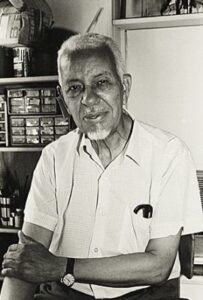 Artist and art educator Hale Woodruff is born in Cairo, Illinois. Woodruff showed an early interest in art and in 1920 entered the Herron Art School in Indianapolis, earning money as a political cartoonist for The Indianapolis Ledger. Woodruff travelled to Paris, France in 1928 to attend Académies Scandinave and Moderne, and studied under Henry Ossawa Tanner, a leading contemporary Black artist. While there he explored the impact of African art on twentieth-century modern art. Woodruff returned to the United States in 1931 to teach at Atlanta University and established the university’s art department. In 1936, Woodruff studied under famed muralist Diego Rivera in Mexico, drawing parallels between Mexican art and African art. In 1942, Woodruff developed the Atlanta University Art Annuals, a national annual exhibition of the works of Black artists that ran successfully until 1970, and established the university’s permanent collection of African-American art. In 1943 he received the Julius Rosenwald Foundation Fellowship for creative painting, moving to New York City with his wife. Three years later he was offered a teaching position at New York University, remaining there until his retirement in 1968. During his years in Atlanta and New York, Woodruff continued with his work, completing three mural series: The Negro in California History (1949), a collaboration with Charles Alston, on display at the Golden State Mutual Life Insurance Company in California; The Amistad Mutiny (1939), displayed at Talladega College; and his most important work, The Art of the Negro (1951), displayed at Clark Atlanta University Art Galleries, which traces the history of African art and its impact on modern art. Learn more. Artist and art educator Hale Woodruff is born in Cairo, Illinois. Woodruff showed an early interest in art and in 1920 entered the Herron Art School in Indianapolis, earning money as a political cartoonist for The Indianapolis Ledger. Woodruff travelled to Paris, France in 1928 to attend Académies Scandinave and Moderne, and studied under Henry Ossawa Tanner, a leading contemporary Black artist. While there he explored the impact of African art on twentieth-century modern art. Woodruff returned to the United States in 1931 to teach at Atlanta University and established the university’s art department. In 1936, Woodruff studied under famed muralist Diego Rivera in Mexico, drawing parallels between Mexican art and African art. In 1942, Woodruff developed the Atlanta University Art Annuals, a national annual exhibition of the works of Black artists that ran successfully until 1970, and established the university’s permanent collection of African-American art. In 1943 he received the Julius Rosenwald Foundation Fellowship for creative painting, moving to New York City with his wife. Three years later he was offered a teaching position at New York University, remaining there until his retirement in 1968. During his years in Atlanta and New York, Woodruff continued with his work, completing three mural series: The Negro in California History (1949), a collaboration with Charles Alston, on display at the Golden State Mutual Life Insurance Company in California; The Amistad Mutiny (1939), displayed at Talladega College; and his most important work, The Art of the Negro (1951), displayed at Clark Atlanta University Art Galleries, which traces the history of African art and its impact on modern art. Learn more. | |
| August 26, 1918 | 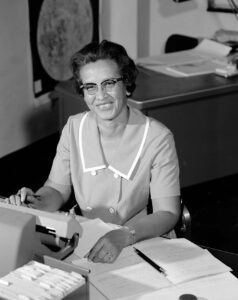 Katherine Goble Johnson, heralded as the first African American woman in Aerospace Engineering, is born in White Sulfur Springs, West Virginia, a city where schooling for “colored” people ended with the eighth grade. In 1937, she graduated summa cum laude (with highest distinction), with a Bachelor of Science in French and Mathematics, from West Virginia State University (formerly West Virginia State College). Twenty years later, married with three children, she transitioned from a teaching career to a coveted research mathematician position, at the National Advisory Committee for Aeronautics (NACA, 1915-1958), the predecessor to the National Aeronautics and Space Administration (NASA, 1958- ). Johnson’s mathematical prowess led her to assist NACA’s all-male team of engineers tasked with finding solutions to America’s space-flight navigation problems. In 1959, when Virginia public schools began desegregating, Johnson was calculating space-flight trajectories in Hampton, Virginia for Project Mercury, America’s first manned space-flight program. When NASA began using computers, she was asked to verify related calculations for the first American to actually orbit the earth, John Glenn, in 1962. Seven years later, she crafted America’s navigational track for the flight landing the first humans, Neil Armstrong and Buzz Aldrin, on the moon’s surface. Learn more.
Katherine Goble Johnson, heralded as the first African American woman in Aerospace Engineering, is born in White Sulfur Springs, West Virginia, a city where schooling for “colored” people ended with the eighth grade. In 1937, she graduated summa cum laude (with highest distinction), with a Bachelor of Science in French and Mathematics, from West Virginia State University (formerly West Virginia State College). Twenty years later, married with three children, she transitioned from a teaching career to a coveted research mathematician position, at the National Advisory Committee for Aeronautics (NACA, 1915-1958), the predecessor to the National Aeronautics and Space Administration (NASA, 1958- ). Johnson’s mathematical prowess led her to assist NACA’s all-male team of engineers tasked with finding solutions to America’s space-flight navigation problems. In 1959, when Virginia public schools began desegregating, Johnson was calculating space-flight trajectories in Hampton, Virginia for Project Mercury, America’s first manned space-flight program. When NASA began using computers, she was asked to verify related calculations for the first American to actually orbit the earth, John Glenn, in 1962. Seven years later, she crafted America’s navigational track for the flight landing the first humans, Neil Armstrong and Buzz Aldrin, on the moon’s surface. Learn more. | |
| August 27, 1918 | 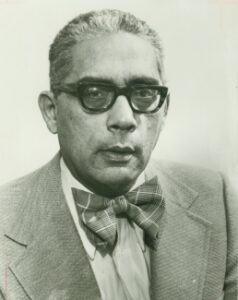 Pioneering journalist and commentator Simeon Saunders Booker Jr. is born to Simeon Saunders Sr. and Roberta Waring Booker as the second of four children. Despite his father’s hopes that he would one day become a Baptist minister, Booker’s passion for deconstructing racism in the United States propelled him into journalism and activism. Booker’s innovative career in journalism transformed how African American readers engaged with news coverage of politics and social injustices. In 1952, Booker became the first African American reporter for the Washington Post. Although Booker’s employment at the Washington Post was groundbreaking, he was displeased with being assigned to cover only general news, and left the Post in 1954 to become Jet’s chief columnist. At Jet, Booker was finally granted the platform to freely provide critical analysis of the Civil Rights Movement. After the murder of 14-year-old Emmett Till in Mississippi, Booker accompanied Mamie Till, to the viewing of the body. It was Booker who insisted that photos of Till’s open-casket be published in Jet while others were hesitant. The photos, along with Booker’s narrative of the tragedy, were published in the September 1955 edition of the magazine, inspiring thousands of people, including Rosa Parks, to take immediate action. Booker’s reporting on Till’s murder, the Freedom Rides, and many other pivotal moments in civil rights history guided him towards becoming the second African American reporter, after Harry S. McAlpin, to gain White House press credentials. Learn more. Pioneering journalist and commentator Simeon Saunders Booker Jr. is born to Simeon Saunders Sr. and Roberta Waring Booker as the second of four children. Despite his father’s hopes that he would one day become a Baptist minister, Booker’s passion for deconstructing racism in the United States propelled him into journalism and activism. Booker’s innovative career in journalism transformed how African American readers engaged with news coverage of politics and social injustices. In 1952, Booker became the first African American reporter for the Washington Post. Although Booker’s employment at the Washington Post was groundbreaking, he was displeased with being assigned to cover only general news, and left the Post in 1954 to become Jet’s chief columnist. At Jet, Booker was finally granted the platform to freely provide critical analysis of the Civil Rights Movement. After the murder of 14-year-old Emmett Till in Mississippi, Booker accompanied Mamie Till, to the viewing of the body. It was Booker who insisted that photos of Till’s open-casket be published in Jet while others were hesitant. The photos, along with Booker’s narrative of the tragedy, were published in the September 1955 edition of the magazine, inspiring thousands of people, including Rosa Parks, to take immediate action. Booker’s reporting on Till’s murder, the Freedom Rides, and many other pivotal moments in civil rights history guided him towards becoming the second African American reporter, after Harry S. McAlpin, to gain White House press credentials. Learn more. | |
| August 27, 1949 | 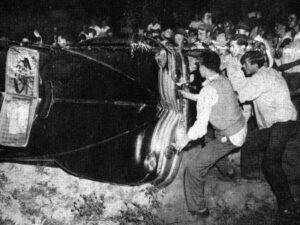 The first of two Peekskill Riots of 1949 takes place when a violent white mob attacks African Americans and Jewish Americans attending a benefit concert in Peekskill, New York (in Westchester County) for the Civil Rights Congress, a legal defense organization. The concert’s headline act was Paul Robeson, the singer and actor whose communist sympathies, opposition to U.S. foreign policy, and outspokenness on issues of racial equality and anticolonialism led him to be blacklisted during the McCarthy era. Just before Robeson arrived in Peekskill, a mob of 300 local residents including many youth, attacked concert attendees with sticks, clubs, and rocks. Rioters lynched an effigy of Robeson, burned a cross on the concert grounds, and chanted, “Go home Commies” and “Dirty Kikes” (the latter slur was likely a reference to Helen Rosen, a friend of Robeson’s and one of the concert organizers). Members of the American Legion and Veterans of Foreign Wars participated in the attacks, while local police refused to respond. Thirteen people were injured. Concert organizers decided to postpone the event until September 4 (when white mobs riot and attack even more violently in the second Peekskill Riot of 1949). Learn more. The first of two Peekskill Riots of 1949 takes place when a violent white mob attacks African Americans and Jewish Americans attending a benefit concert in Peekskill, New York (in Westchester County) for the Civil Rights Congress, a legal defense organization. The concert’s headline act was Paul Robeson, the singer and actor whose communist sympathies, opposition to U.S. foreign policy, and outspokenness on issues of racial equality and anticolonialism led him to be blacklisted during the McCarthy era. Just before Robeson arrived in Peekskill, a mob of 300 local residents including many youth, attacked concert attendees with sticks, clubs, and rocks. Rioters lynched an effigy of Robeson, burned a cross on the concert grounds, and chanted, “Go home Commies” and “Dirty Kikes” (the latter slur was likely a reference to Helen Rosen, a friend of Robeson’s and one of the concert organizers). Members of the American Legion and Veterans of Foreign Wars participated in the attacks, while local police refused to respond. Thirteen people were injured. Concert organizers decided to postpone the event until September 4 (when white mobs riot and attack even more violently in the second Peekskill Riot of 1949). Learn more. | |
| August 27, 1960 | 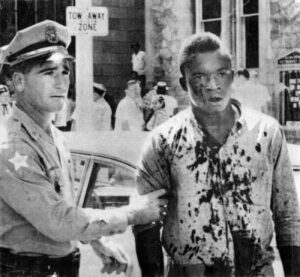 Dozens of Black teens staging a peaceful sit-in protest at a “whites only” Woolworth's lunch counter in downtown Jacksonville, Florida are viciously attacked by a mob of 200 white people wielding ax handles and baseball bats on what has come to be known as Ax Handle Saturday. The attack began when white onlookers angered by the demonstration began spitting on the sit-in protesters and yelling racial slurs at them. When the Black youths refused to respond and continued sitting peacefully, the violence escalated. The white people beat the demonstrators with wooden ax handles and baseball bats and soon spread into the streets of downtown Jacksonville, attacking Black people indiscriminately. The attack left more than fifty people injured. As bloodied and battered Black children fled to a nearby church to seek refuge, many white police officers joined the mob violence, arrested the fleeing civil rights demonstrators, or did nothing. Learn more. Dozens of Black teens staging a peaceful sit-in protest at a “whites only” Woolworth's lunch counter in downtown Jacksonville, Florida are viciously attacked by a mob of 200 white people wielding ax handles and baseball bats on what has come to be known as Ax Handle Saturday. The attack began when white onlookers angered by the demonstration began spitting on the sit-in protesters and yelling racial slurs at them. When the Black youths refused to respond and continued sitting peacefully, the violence escalated. The white people beat the demonstrators with wooden ax handles and baseball bats and soon spread into the streets of downtown Jacksonville, attacking Black people indiscriminately. The attack left more than fifty people injured. As bloodied and battered Black children fled to a nearby church to seek refuge, many white police officers joined the mob violence, arrested the fleeing civil rights demonstrators, or did nothing. Learn more. | |
| August 28, 1952 | 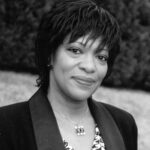 American poet laureate Rita Frances Dove is born in Akron, Ohio. Rita Dove excelled in school and in 1970 she received the Presidential Scholar Award. Dove completed a B.A. in English in three years at Miami University in Ohio, graduating summa cum laude. In 1974-75 she was a Fulbright scholar at Eberhard Karls University in Tubingen, Germany. Rita continued her education at the University of Iowa where she received her Master of Fine Arts in 1977. Rita Dove’s first collection of poetry, The Yellow House on the Corner, was published by Carnegie-Mellon University Press in 1980. In 1986 she wrote Thomas and Beulah a poetic tribute to the lives of her grandparents. It was for this collection of poetry that she became the second African American (after Gwendolyn Brooks) to win a Pulitzer Prize in poetry (1987). Dove has published eight volumes of poetry, a collection of short stories, a collection of essays, a novel, and a play The Darker Face of the Earth (1994). In 1993 Rita Dove became the youngest person and first African American to be named United States Poet Laureate. In 2006 Dove was elected Chancellor of The Academy of American Poets. Learn more. American poet laureate Rita Frances Dove is born in Akron, Ohio. Rita Dove excelled in school and in 1970 she received the Presidential Scholar Award. Dove completed a B.A. in English in three years at Miami University in Ohio, graduating summa cum laude. In 1974-75 she was a Fulbright scholar at Eberhard Karls University in Tubingen, Germany. Rita continued her education at the University of Iowa where she received her Master of Fine Arts in 1977. Rita Dove’s first collection of poetry, The Yellow House on the Corner, was published by Carnegie-Mellon University Press in 1980. In 1986 she wrote Thomas and Beulah a poetic tribute to the lives of her grandparents. It was for this collection of poetry that she became the second African American (after Gwendolyn Brooks) to win a Pulitzer Prize in poetry (1987). Dove has published eight volumes of poetry, a collection of short stories, a collection of essays, a novel, and a play The Darker Face of the Earth (1994). In 1993 Rita Dove became the youngest person and first African American to be named United States Poet Laureate. In 2006 Dove was elected Chancellor of The Academy of American Poets. Learn more. | |
| August 28, 1955 | 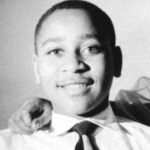 Emmett Till, a 14-year-old Black boy visiting from Chicago, is abducted from his great-uncle’s home in Money, Mississippi by two white men, Roy Bryant and J.W. Milam. The men drive Emmett to a storage shed on Milam’s property in Drew, Mississippi, torture, and beat him with a pistol, then force him to load a 74-pound fan into the back of their pick-up truck. The men then drive Emmett to the edge of the Tallahatchie River, order him to remove his clothes, shoot him in the head, chain the fan to his corpse, and roll it into the river. A few days before, Emmett and a group of friends and cousins had gone into a nearby store to buy candy; Emmett was later accused of acting “familiar” with the young white female storekeeper, Carolyn Bryant. When word of the interaction reached Carolyn Bryant’s husband, Roy, he enlisted his half-brother J.W. in the deadly violence that followed. To show the world the brutality Emmett had suffered, his devastated mother Mamie held an open casket funeral and distributed a photograph of Emmett’s mutilated corpse for publication in newspapers and magazines, later explaining: “The whole nation had to bear witness to this.” Learn more. Emmett Till, a 14-year-old Black boy visiting from Chicago, is abducted from his great-uncle’s home in Money, Mississippi by two white men, Roy Bryant and J.W. Milam. The men drive Emmett to a storage shed on Milam’s property in Drew, Mississippi, torture, and beat him with a pistol, then force him to load a 74-pound fan into the back of their pick-up truck. The men then drive Emmett to the edge of the Tallahatchie River, order him to remove his clothes, shoot him in the head, chain the fan to his corpse, and roll it into the river. A few days before, Emmett and a group of friends and cousins had gone into a nearby store to buy candy; Emmett was later accused of acting “familiar” with the young white female storekeeper, Carolyn Bryant. When word of the interaction reached Carolyn Bryant’s husband, Roy, he enlisted his half-brother J.W. in the deadly violence that followed. To show the world the brutality Emmett had suffered, his devastated mother Mamie held an open casket funeral and distributed a photograph of Emmett’s mutilated corpse for publication in newspapers and magazines, later explaining: “The whole nation had to bear witness to this.” Learn more. | |
| August 28, 1962 | 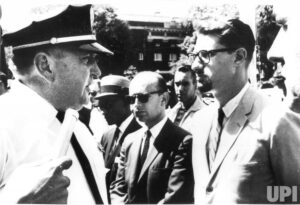 Albany, Georgia police arrest seventy-five clergy and laypeople, 54 white and 21 Black, leaders of Protestant, Roman Catholic, and Jewish denominations, as they conduct an anti-segregation prayer vigil on the steps of City Hall. Seventy of the vigil participants were from the North or Midwest, and five were from Georgia. The arrests occurred as Christian and Jewish clergy took turns reading scripture. They 75 were charged with congregating on the sidewalk, disorderly conduct, and refusing a police order to disperse, and were held in lieu of $200 cash bonds, each. Approximately 400 whites watched the vigil and cheered as the arrests were made. After the arrested had been booked, a white policeman emerged from the jail and paraded through City Hall wearing a skullcap belonging to a New York City rabbi and a fake beard. Learn more. Albany, Georgia police arrest seventy-five clergy and laypeople, 54 white and 21 Black, leaders of Protestant, Roman Catholic, and Jewish denominations, as they conduct an anti-segregation prayer vigil on the steps of City Hall. Seventy of the vigil participants were from the North or Midwest, and five were from Georgia. The arrests occurred as Christian and Jewish clergy took turns reading scripture. They 75 were charged with congregating on the sidewalk, disorderly conduct, and refusing a police order to disperse, and were held in lieu of $200 cash bonds, each. Approximately 400 whites watched the vigil and cheered as the arrests were made. After the arrested had been booked, a white policeman emerged from the jail and paraded through City Hall wearing a skullcap belonging to a New York City rabbi and a fake beard. Learn more. | |
| August 28, 1963 | 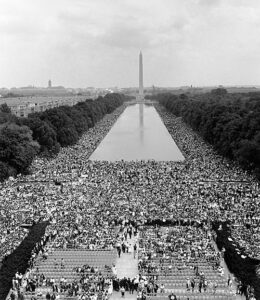 The March on Washington for Jobs and Freedom, also known as simply the March on Washington, is held in Washington, D.C. The purpose of the march was to advocate for the civil and economic rights of African Americans. At the march, final speaker Dr. Martin Luther King Jr., standing in front of the Lincoln Memorial, set aside his prepared remarks and delivered his historic "I Have a Dream" speech. The march was organized by A. Philip Randolph and Bayard Rustin, who built an alliance of civil rights, labor, and religious organizations that came together under the banner of "jobs and freedom." Approximately 250,000 people participated, with an estimated 75–80% of marchers being Black. The march was one of the largest political rallies for human rights in United States history. Walter Reuther, president of the United Auto Workers, was the most integral and highest-ranking white organizer of the march. The march is credited with helping to pass the Civil Rights Act of 1964. Learn more. The March on Washington for Jobs and Freedom, also known as simply the March on Washington, is held in Washington, D.C. The purpose of the march was to advocate for the civil and economic rights of African Americans. At the march, final speaker Dr. Martin Luther King Jr., standing in front of the Lincoln Memorial, set aside his prepared remarks and delivered his historic "I Have a Dream" speech. The march was organized by A. Philip Randolph and Bayard Rustin, who built an alliance of civil rights, labor, and religious organizations that came together under the banner of "jobs and freedom." Approximately 250,000 people participated, with an estimated 75–80% of marchers being Black. The march was one of the largest political rallies for human rights in United States history. Walter Reuther, president of the United Auto Workers, was the most integral and highest-ranking white organizer of the march. The march is credited with helping to pass the Civil Rights Act of 1964. Learn more. | |
| August 28, 2008 |  On the 45th anniversary of Dr. Martin Luther King’s “I Have a Dream” speech, United States Senator (from Illinois) Barack Obama accepts the nomination of the National Democratic Party at its convention in Denver, Colorado. Obama gives his nationally-televised acceptance speech at Invesco Field (formerly Mile High Stadium) before an estimated 85,000 supporters. Learn more. On the 45th anniversary of Dr. Martin Luther King’s “I Have a Dream” speech, United States Senator (from Illinois) Barack Obama accepts the nomination of the National Democratic Party at its convention in Denver, Colorado. Obama gives his nationally-televised acceptance speech at Invesco Field (formerly Mile High Stadium) before an estimated 85,000 supporters. Learn more. | |
| August 29, 1911 | 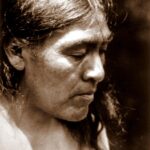 “Ishi”, the last known member of the Native American Yahi people, and last known survivor of the 19th century California Genocide, emerges from hiding near Oroville, California and makes his first contact with European Americans. The rest of the Yahi (as well as many members of their parent tribe, the Yana) were killed in the genocide. The California Genocide was the killing of thousands of indigenous peoples of California by United States government agents and private citizens. It began following the American Conquest of California from Mexico, and the influx of settlers due to the California Gold Rush, which accelerated the decline of the indigenous population of California. Between 1846 and 1873, it is conservatively estimated that American settlers murdered some 9,500 California Natives, and acts of enslavement, kidnapping, rape, child separation and displacement were widespread. These acts were encouraged, tolerated, and carried out by state authorities and militias. Learn more about Ishi and about the California Genocide. “Ishi”, the last known member of the Native American Yahi people, and last known survivor of the 19th century California Genocide, emerges from hiding near Oroville, California and makes his first contact with European Americans. The rest of the Yahi (as well as many members of their parent tribe, the Yana) were killed in the genocide. The California Genocide was the killing of thousands of indigenous peoples of California by United States government agents and private citizens. It began following the American Conquest of California from Mexico, and the influx of settlers due to the California Gold Rush, which accelerated the decline of the indigenous population of California. Between 1846 and 1873, it is conservatively estimated that American settlers murdered some 9,500 California Natives, and acts of enslavement, kidnapping, rape, child separation and displacement were widespread. These acts were encouraged, tolerated, and carried out by state authorities and militias. Learn more about Ishi and about the California Genocide. | |
| August 29, 1920 | 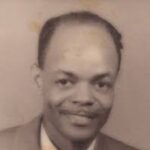 Inventor and engineer Otis Frank Boykin is born in Dallas, Texas. His mother Sarah died of heart failure when Otis was a year old, which later inspired him to help improve the pacemaker. Boykin patented as many as 26 devices. He is best known for inventing multiple different electronic control devices in guided missiles, IBM computers, and in the pacemaker. One of his early inventions was an improved wire resistor, which had reduced inductance and reactance, due to the physical arrangement of the wire. Other notable inventions include a variable resistor used in guided missiles. His most famous invention was likely a control unit for the artificial cardiac pacemaker. The device essentially uses electrical impulses to maintain a regular heartbeat. Among his other inventions is a burglar-proof cash register. Learn more. Inventor and engineer Otis Frank Boykin is born in Dallas, Texas. His mother Sarah died of heart failure when Otis was a year old, which later inspired him to help improve the pacemaker. Boykin patented as many as 26 devices. He is best known for inventing multiple different electronic control devices in guided missiles, IBM computers, and in the pacemaker. One of his early inventions was an improved wire resistor, which had reduced inductance and reactance, due to the physical arrangement of the wire. Other notable inventions include a variable resistor used in guided missiles. His most famous invention was likely a control unit for the artificial cardiac pacemaker. The device essentially uses electrical impulses to maintain a regular heartbeat. Among his other inventions is a burglar-proof cash register. Learn more. | |
| August 29, 1944 | 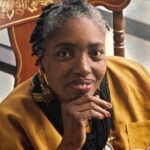 Scholar, playwright, and civil rights activist Endesha Ida Mae Holland is born in Greenwood, Mississippi. Holland never knew her father, was raped at the age of 11, was later expelled from school, and became a prostitute while still as a teenager. Upon hearing that members of the Student Nonviolent Coordinating Committee (SNCC) had come to Greenwood, Holland sought out a male member in hopes of soliciting him for prostitution. The man, however, led her directly to the committee's office hoping to convince her to become involved. On witnessing the office operations, Holland found herself deeply impressed by the sight of African-Americans conducting themselves in such a businesslike manner and she began volunteering there. In 1965 a fire broke out in her home, killing Holland's mother; Holland said afterward that she believed the Ku Klux Klan had firebombed the house in retaliation for her civil rights work. In all, she was jailed thirteen times for her civil rights work. Encouraged by her colleagues in the civil rights movement, Holland earned a high school equivalency diploma. She then studied at the University of Minnesota, where she helped start an African-American studies department and initiated Women Helping Offenders (WHO), a prison-aid program. In 1979 Holland earned a bachelor's degree in African-American studies from the University of Minnesota, followed by a master's degree in American Studies in 1984 and a PhD. in American studies in 1986. She taught at the State University of New York, Buffalo, then was a professor of theater at the University of Southern California, retiring in 2003. Holland authored six plays, and was most famous for writing From the Mississippi Delta, which was performed by the Negro Ensemble Company at the Goodman Theater in Chicago and at the Young Vic in London. She also wrote a memoir of the same name, published by Simon & Schuster in 1997. Learn more. Scholar, playwright, and civil rights activist Endesha Ida Mae Holland is born in Greenwood, Mississippi. Holland never knew her father, was raped at the age of 11, was later expelled from school, and became a prostitute while still as a teenager. Upon hearing that members of the Student Nonviolent Coordinating Committee (SNCC) had come to Greenwood, Holland sought out a male member in hopes of soliciting him for prostitution. The man, however, led her directly to the committee's office hoping to convince her to become involved. On witnessing the office operations, Holland found herself deeply impressed by the sight of African-Americans conducting themselves in such a businesslike manner and she began volunteering there. In 1965 a fire broke out in her home, killing Holland's mother; Holland said afterward that she believed the Ku Klux Klan had firebombed the house in retaliation for her civil rights work. In all, she was jailed thirteen times for her civil rights work. Encouraged by her colleagues in the civil rights movement, Holland earned a high school equivalency diploma. She then studied at the University of Minnesota, where she helped start an African-American studies department and initiated Women Helping Offenders (WHO), a prison-aid program. In 1979 Holland earned a bachelor's degree in African-American studies from the University of Minnesota, followed by a master's degree in American Studies in 1984 and a PhD. in American studies in 1986. She taught at the State University of New York, Buffalo, then was a professor of theater at the University of Southern California, retiring in 2003. Holland authored six plays, and was most famous for writing From the Mississippi Delta, which was performed by the Negro Ensemble Company at the Goodman Theater in Chicago and at the Young Vic in London. She also wrote a memoir of the same name, published by Simon & Schuster in 1997. Learn more. | |
| August 29, 1961 | 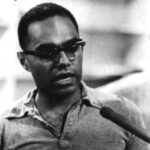 A white man named Billy Jack Caston, who was first cousin of the Sheriff of Amite County, Mississippi, attacked Student Nonviolent Coordinating Committee leader Bob Moses as he accompanied two Black residents, Curtis Dawson and Reverend Alfred Knox, to register to vote. At that time, approximately 70% of white adults in Mississippi were registered to vote, but only 6.7% of eligible Black Mississippians were registered, owing to biased laws and decades of anti-Black violence and intimidation. As Mr. Moses, Mr. Dawson, and Reverend Knox approached the Amite County Courthouse, Mr. Caston demanded that Mr. Moses disclose the group’s intentions. Without waiting for a response, Caston slammed Mr. Moses onto the ground and kneeled over his body for several minutes, beating him with a blunt instrument. Several white men stood nearby watching, but did nothing to intervene. Mr. Moses sustained lacerations to his head and required several stitches. When Mr. Moses sought redress from the local authorities, the county sheriff refused to help Mr. Moses, and directed him to the local justice of the peace, who was “out of the office”. When Mr. Moses finally succeeded in filing a formal complaint, itmarked the first time that a Black person prosecuted a white person for violence in Amite County, Mississippi. Nonetheless, Caston was acquitted by an all-white jury. Learn more about this incident and more about the life of the legendary Bob Moses. A white man named Billy Jack Caston, who was first cousin of the Sheriff of Amite County, Mississippi, attacked Student Nonviolent Coordinating Committee leader Bob Moses as he accompanied two Black residents, Curtis Dawson and Reverend Alfred Knox, to register to vote. At that time, approximately 70% of white adults in Mississippi were registered to vote, but only 6.7% of eligible Black Mississippians were registered, owing to biased laws and decades of anti-Black violence and intimidation. As Mr. Moses, Mr. Dawson, and Reverend Knox approached the Amite County Courthouse, Mr. Caston demanded that Mr. Moses disclose the group’s intentions. Without waiting for a response, Caston slammed Mr. Moses onto the ground and kneeled over his body for several minutes, beating him with a blunt instrument. Several white men stood nearby watching, but did nothing to intervene. Mr. Moses sustained lacerations to his head and required several stitches. When Mr. Moses sought redress from the local authorities, the county sheriff refused to help Mr. Moses, and directed him to the local justice of the peace, who was “out of the office”. When Mr. Moses finally succeeded in filing a formal complaint, itmarked the first time that a Black person prosecuted a white person for violence in Amite County, Mississippi. Nonetheless, Caston was acquitted by an all-white jury. Learn more about this incident and more about the life of the legendary Bob Moses. | |
| August 30, 1931 | 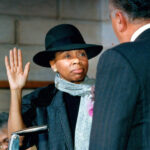 Connecticut politician Carrie Saxon Perry is born in Hartford to David Saxon and Mabel Lee. She was primarily raised by her grandmother after her father left the family when she was only six months old. She was notable as the first African American woman to be elected mayor of a major New England city – Hartford, Connecticut – in 1987. She served three terms as mayor. She served as a member of the Connecticut House of Representatives from 1980 until 1987. Perry was known for her distinctive broad-rimmed hats. Perry graduated from Howard University with a degree of economics and attended Howard University School of Law for two years before leaving school to marry. After leaving law school, she worked with a number of community organizations and help establish boards for organizations such as Planned Parenthood. She also worked for the state welfare agency. Learn more. Connecticut politician Carrie Saxon Perry is born in Hartford to David Saxon and Mabel Lee. She was primarily raised by her grandmother after her father left the family when she was only six months old. She was notable as the first African American woman to be elected mayor of a major New England city – Hartford, Connecticut – in 1987. She served three terms as mayor. She served as a member of the Connecticut House of Representatives from 1980 until 1987. Perry was known for her distinctive broad-rimmed hats. Perry graduated from Howard University with a degree of economics and attended Howard University School of Law for two years before leaving school to marry. After leaving law school, she worked with a number of community organizations and help establish boards for organizations such as Planned Parenthood. She also worked for the state welfare agency. Learn more. | |
| August 30, 1956 |
| |
| August 30, 1967 |  The United States Senate in a 69-11 vote confirms Thurgood Marshall as an Associate Justice on the United States Supreme Court. Marshall served on the high Court for the next twenty four years, compiling a liberal human rights record that included strong support for the civil rights of people of color and for constitutional protection of individual rights, especially the rights of criminal suspects against the government. Justice Marshall also worked closely with Justice William Brennan in helping to craft the Roe v. Wade Decision of 1973 which supported abortion rights. He also opposed the death penalty. In 1972, Marshall argued in Furman v. Georgia that the death penalty was, in all circumstances, unconstitutional. During his years on the Court Marshall was often called the silent revolutionary who viewed the United States Constitution as an evolving shield of freedom. In a 1987 speech he gave for the bicentennial celebration of the United States Constitution, Marshall claimed the government the founding fathers devised was defective from the start; requiring several amendments, a Civil War, and major social transformations to attain the Constitutional guarantees and respect for freedoms and individual rights that the nation holds as fundamental today. Learn more. The United States Senate in a 69-11 vote confirms Thurgood Marshall as an Associate Justice on the United States Supreme Court. Marshall served on the high Court for the next twenty four years, compiling a liberal human rights record that included strong support for the civil rights of people of color and for constitutional protection of individual rights, especially the rights of criminal suspects against the government. Justice Marshall also worked closely with Justice William Brennan in helping to craft the Roe v. Wade Decision of 1973 which supported abortion rights. He also opposed the death penalty. In 1972, Marshall argued in Furman v. Georgia that the death penalty was, in all circumstances, unconstitutional. During his years on the Court Marshall was often called the silent revolutionary who viewed the United States Constitution as an evolving shield of freedom. In a 1987 speech he gave for the bicentennial celebration of the United States Constitution, Marshall claimed the government the founding fathers devised was defective from the start; requiring several amendments, a Civil War, and major social transformations to attain the Constitutional guarantees and respect for freedoms and individual rights that the nation holds as fundamental today. Learn more. | |
| August 30, 1983 |  As a member of the STS-8 space shuttle Challenger crew, Guion “Guy” Bluford, Ph.D. becomes the first African American in space. Dr Bluford became the only Black engineering student at Pennsylvania State University in 1960, from which he graduated with a degree in aerospace engineering in 1964 and went through pilot training at Williams Air Force Base in Arizona where he received his pilot wings one year later. Before being sent to Vietnam in 1967, Bluford felt the sting of racial discrimination when his family was denied housing on base. He flew 144 combat missions with the 557th Squadron in Vietnam. After serving his tour of duty in Vietnam, Dr. Bluford worked as a flight instructor at Sheppard Air Force Base in Texas and started graduate studies at the Air Force Institute of Technology in 1972. He received a M.S. in aerospace engineering in 1974 and a Ph.D. in 1978. The same year, he was one of the thirty-five selected for the National Aeronautics and Space Administration (NASA) astronaut training program out of 10,000 applicants. On August 30, 1983, over a million people and more than 250 famous Black educators and professionals watched Bluford blast off into space. He flew the space shuttle, conducted experiments and helped launch a $45 million satellite to provide communications and weather information for India. Learn more. As a member of the STS-8 space shuttle Challenger crew, Guion “Guy” Bluford, Ph.D. becomes the first African American in space. Dr Bluford became the only Black engineering student at Pennsylvania State University in 1960, from which he graduated with a degree in aerospace engineering in 1964 and went through pilot training at Williams Air Force Base in Arizona where he received his pilot wings one year later. Before being sent to Vietnam in 1967, Bluford felt the sting of racial discrimination when his family was denied housing on base. He flew 144 combat missions with the 557th Squadron in Vietnam. After serving his tour of duty in Vietnam, Dr. Bluford worked as a flight instructor at Sheppard Air Force Base in Texas and started graduate studies at the Air Force Institute of Technology in 1972. He received a M.S. in aerospace engineering in 1974 and a Ph.D. in 1978. The same year, he was one of the thirty-five selected for the National Aeronautics and Space Administration (NASA) astronaut training program out of 10,000 applicants. On August 30, 1983, over a million people and more than 250 famous Black educators and professionals watched Bluford blast off into space. He flew the space shuttle, conducted experiments and helped launch a $45 million satellite to provide communications and weather information for India. Learn more. | |
| August 31, 1842 | 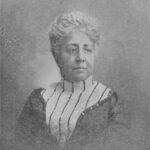 Josephine St. Pierre Ruffin an African-American publisher, journalist, civil rights leader, suffragist, and editor of the Woman's Era, the first national newspaper published by and for African-American women, is born to a mixed race family in Boston, Massachusetts; her mother was an English-born white woman and her father was from the island of Martinique, and founder of the Boston Zion Church. Ruffin founded, with her daughter Florida Ridely and Boston school principal Maria Baldwin, the “Women’s Era Club.” Believing that a national organization for black women was needed, she convened the first annual convention in 1895 which drew 100 women from 20 clubs across the United States. She named the organization the National Federation of Afro-Am Women, which a year later united with the Colored Women’s League to become the National Association of Colored Women. Mary Church Terrell was the combined organization’s president while Ruffin and several others served as vice-presidents. In 1910, Ruffin became one of the founding members of the Boston NAACP. Learn more. Josephine St. Pierre Ruffin an African-American publisher, journalist, civil rights leader, suffragist, and editor of the Woman's Era, the first national newspaper published by and for African-American women, is born to a mixed race family in Boston, Massachusetts; her mother was an English-born white woman and her father was from the island of Martinique, and founder of the Boston Zion Church. Ruffin founded, with her daughter Florida Ridely and Boston school principal Maria Baldwin, the “Women’s Era Club.” Believing that a national organization for black women was needed, she convened the first annual convention in 1895 which drew 100 women from 20 clubs across the United States. She named the organization the National Federation of Afro-Am Women, which a year later united with the Colored Women’s League to become the National Association of Colored Women. Mary Church Terrell was the combined organization’s president while Ruffin and several others served as vice-presidents. In 1910, Ruffin became one of the founding members of the Boston NAACP. Learn more. | |
| August 31, 1945 |  American supermodel and actress Peggy Ann Freeman, known professionally as Donyale Luna, is born. She gained popularity in Western Europe during the late 1960s. Generally cited as "the first black supermodel", Luna was the first African-American model to appear on the cover of the British edition of Vogue, in March 1966.[ She entered modeling in a period that favored "white passing models" and has been described as "the first black model who really began to change things; to enable more diverse beauty paradigms to break through". She is known to have been a covergirl 11 times between 1965 and 1975. She appeared in several underground films like the screen tests of Andy Warhol (1966), and had roles in Qui êtes-vous, Polly Maggoo? (1966), and most notably as Enotea in the 1969 Federico Fellini film Fellini Satyricon, as well as Otto Preminger's Skidoo (1968) in the role of "'God's Mistress". Learn more. American supermodel and actress Peggy Ann Freeman, known professionally as Donyale Luna, is born. She gained popularity in Western Europe during the late 1960s. Generally cited as "the first black supermodel", Luna was the first African-American model to appear on the cover of the British edition of Vogue, in March 1966.[ She entered modeling in a period that favored "white passing models" and has been described as "the first black model who really began to change things; to enable more diverse beauty paradigms to break through". She is known to have been a covergirl 11 times between 1965 and 1975. She appeared in several underground films like the screen tests of Andy Warhol (1966), and had roles in Qui êtes-vous, Polly Maggoo? (1966), and most notably as Enotea in the 1969 Federico Fellini film Fellini Satyricon, as well as Otto Preminger's Skidoo (1968) in the role of "'God's Mistress". Learn more. | |
| August 31, 1989 |  Writer and secular humanist activist Norman (Norm) Robert Allen Jr. founds African Americans for Humanism, the first organization focused on the promotion of humanism and humanist ideals among people of African descent. He was the executive director of the organization from 1991 to 2010 as well as editor of its quarterly, the AAH Examiner. He also edited African American Humanism: An Anthology (1991) and The Black Humanist Experience: An Alternative to Religion (2003). Allen views secular humanism, a human-centered approach to living drawing upon reason, science, and secular ideals and guided by empathy and compassion, as particularly relevant for African Americans because in the narrative of American history Black freethinkers have largely been ignored. Learn more. Writer and secular humanist activist Norman (Norm) Robert Allen Jr. founds African Americans for Humanism, the first organization focused on the promotion of humanism and humanist ideals among people of African descent. He was the executive director of the organization from 1991 to 2010 as well as editor of its quarterly, the AAH Examiner. He also edited African American Humanism: An Anthology (1991) and The Black Humanist Experience: An Alternative to Religion (2003). Allen views secular humanism, a human-centered approach to living drawing upon reason, science, and secular ideals and guided by empathy and compassion, as particularly relevant for African Americans because in the narrative of American history Black freethinkers have largely been ignored. Learn more. | |
| September 1, 1884 | 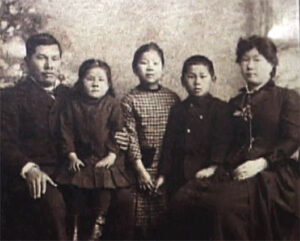 Joseph and Mary Tape, immigrants from China who had lived in the U.S. for over a decade, attempt to enroll their eight-year-old, American-born daughter, Mamie Tape, in San Francisco’s Spring Valley School. The school principal denies the Tapes’ request because of Mamie's race, and the state superintendent—noting that even the California Constitution described Chinese-Americans as “dangerous to the well-being of the state”—supports that decision. Facing these obstacles to securing meaningful education for their daughter, Mr. and Mrs. Tape sued the school and won. In January 1885, a California Superior Court judge ruled that the school's refusal to admit Mamie Tape was a violation of California state law and the U.S. Constitution. The California Supreme Court confirmed that decision when the state appealed, and held that Chinese students had a right to public education. The Court's decision did not, however, prohibit the creation of segregated schools. When Mamie Tape arrived for school immediately after the California Supreme Court's decision, she was denied entry because her vaccinations were not up to date. By the time the Tape family was able to comply with the vaccination requirements, a new school had been opened for Chinese-American students in compliance with a new state law, and Mamie was forced to enroll there. The California law banning Chinese-American students from attending public schools with white students was enforced until the late 1920s. Learn more. Joseph and Mary Tape, immigrants from China who had lived in the U.S. for over a decade, attempt to enroll their eight-year-old, American-born daughter, Mamie Tape, in San Francisco’s Spring Valley School. The school principal denies the Tapes’ request because of Mamie's race, and the state superintendent—noting that even the California Constitution described Chinese-Americans as “dangerous to the well-being of the state”—supports that decision. Facing these obstacles to securing meaningful education for their daughter, Mr. and Mrs. Tape sued the school and won. In January 1885, a California Superior Court judge ruled that the school's refusal to admit Mamie Tape was a violation of California state law and the U.S. Constitution. The California Supreme Court confirmed that decision when the state appealed, and held that Chinese students had a right to public education. The Court's decision did not, however, prohibit the creation of segregated schools. When Mamie Tape arrived for school immediately after the California Supreme Court's decision, she was denied entry because her vaccinations were not up to date. By the time the Tape family was able to comply with the vaccination requirements, a new school had been opened for Chinese-American students in compliance with a new state law, and Mamie was forced to enroll there. The California law banning Chinese-American students from attending public schools with white students was enforced until the late 1920s. Learn more. | |
| September 1, 1971 |  The 1971 Pittsburgh Pirates (a team that would, six weeks later, win the 1971 World Series) field the first all-Black lineup in Major League Baseball history. The on-field starting roster that day was comprised of Hall of Famers Willie Stargell (left fielder) and Roberto Clemente (right fielder), along with All Stars Manny Sanguillen (catcher), Dave Cash (third baseman), Al Oliver (first baseman), and Dock Ellis (pitcher), plus Jackie Hernandez (shortstop), Rennie Stennett (second baseman), and Gene Clines (center fielder). Cash was the first to alert his teammates of the unprecedented makeup of the roster before the start of the game. When Sanguillen told Clemente of the milestone during pre-game warmups, Clemente replied earnestly, “We have to win this game. Can you imagine what they’ll say if we don’t win with all of us on the field?” (Pictured from left to right: Sanguillen, Stargell, Oliver, Cash, and Clemente). Learn more. The 1971 Pittsburgh Pirates (a team that would, six weeks later, win the 1971 World Series) field the first all-Black lineup in Major League Baseball history. The on-field starting roster that day was comprised of Hall of Famers Willie Stargell (left fielder) and Roberto Clemente (right fielder), along with All Stars Manny Sanguillen (catcher), Dave Cash (third baseman), Al Oliver (first baseman), and Dock Ellis (pitcher), plus Jackie Hernandez (shortstop), Rennie Stennett (second baseman), and Gene Clines (center fielder). Cash was the first to alert his teammates of the unprecedented makeup of the roster before the start of the game. When Sanguillen told Clemente of the milestone during pre-game warmups, Clemente replied earnestly, “We have to win this game. Can you imagine what they’ll say if we don’t win with all of us on the field?” (Pictured from left to right: Sanguillen, Stargell, Oliver, Cash, and Clemente). Learn more. | |
| September 1, 1975 |  Daniel "Chappie" James Jr. is promoted to the four-star rank of general (O-10), becoming the highest ranking African-American in the history of the United States military to that date. He was assigned as commander in chief of NORAD/ADCOM at Peterson Air Force Base, Colorado. In these dual capacities he had operational command of all United States and Canadian strategic aerospace defense forces. On December 6, 1977, he assumed duty as special assistant to the Chief of Staff, U.S. Air Force. James retired from the Air Force on January 31, 1978. Previously, General James was a fighter pilot in the United States Air Force. He attended the famous Tuskegee Institute and instructed African American pilots during World War II. He flew combat missions during the Korean War and Vietnam War, and received the Defense Distinguished Service Medal, two Air Force Distinguished Service Medals, two Legions of Merit, three Distinguished Flying Crosses, a Meritorious Service Medal, and fourteen Air Medals. Learn more.
Daniel "Chappie" James Jr. is promoted to the four-star rank of general (O-10), becoming the highest ranking African-American in the history of the United States military to that date. He was assigned as commander in chief of NORAD/ADCOM at Peterson Air Force Base, Colorado. In these dual capacities he had operational command of all United States and Canadian strategic aerospace defense forces. On December 6, 1977, he assumed duty as special assistant to the Chief of Staff, U.S. Air Force. James retired from the Air Force on January 31, 1978. Previously, General James was a fighter pilot in the United States Air Force. He attended the famous Tuskegee Institute and instructed African American pilots during World War II. He flew combat missions during the Korean War and Vietnam War, and received the Defense Distinguished Service Medal, two Air Force Distinguished Service Medals, two Legions of Merit, three Distinguished Flying Crosses, a Meritorious Service Medal, and fourteen Air Medals. Learn more. | |
| September 2, 1766 | 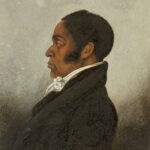 James Forten, an African-American abolitionist and wealthy businessman in Philadelphia, Pennsylvania, is born free in that city. Forten became a sailmaker after the Revolutionary War. Following an apprenticeship, he became the foreman and bought the sail loft when his boss retired. Based on equipment he himself had developed, he established a highly profitable business. It was located on the busy waterfront of the Delaware River, in an area now called Penn's Landing. James Forten used his wealth and social standing to work for civil rights for African Americans in both the city and nationwide. Beginning in 1817, he opposed the colonization movements, particularly that of the American Colonization Society. He affirmed African Americans' claim to a stake in the United States of America. He persuaded William Lloyd Garrison to adopt an anti-colonization position and helped fund his newspaper The Liberator (1831–65), frequently publishing letters on public issues. He became vice-president of the biracial American Anti-Slavery Society, founded in 1833, and worked for national abolition of slavery. His large family was also devoted to these causes, and two daughters married the Purvis brothers, who used their wealth as leaders for abolition. Learn more. James Forten, an African-American abolitionist and wealthy businessman in Philadelphia, Pennsylvania, is born free in that city. Forten became a sailmaker after the Revolutionary War. Following an apprenticeship, he became the foreman and bought the sail loft when his boss retired. Based on equipment he himself had developed, he established a highly profitable business. It was located on the busy waterfront of the Delaware River, in an area now called Penn's Landing. James Forten used his wealth and social standing to work for civil rights for African Americans in both the city and nationwide. Beginning in 1817, he opposed the colonization movements, particularly that of the American Colonization Society. He affirmed African Americans' claim to a stake in the United States of America. He persuaded William Lloyd Garrison to adopt an anti-colonization position and helped fund his newspaper The Liberator (1831–65), frequently publishing letters on public issues. He became vice-president of the biracial American Anti-Slavery Society, founded in 1833, and worked for national abolition of slavery. His large family was also devoted to these causes, and two daughters married the Purvis brothers, who used their wealth as leaders for abolition. Learn more. | |
| September 2, 1884 | 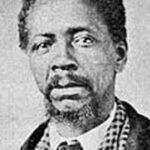 Abolitionist, inventor, iron moulder and industrialist John P. Parker patents the "Parker Pulverizer", a follower-screw for tobacco-presses, US patent number 304,552. Parker was one of the few Black people to patent inventions before 1900. Prior to emancipation and the ending of slavery in the United States, Parker had over a period of fifteen years rescued and helped hundreds of enslaved African Americans to freedom in the Underground Railroad resistance movement based in Ripley, Ohio. Parker's home in Ripley has been designated a National Historic Landmark and restored. Learn more. Abolitionist, inventor, iron moulder and industrialist John P. Parker patents the "Parker Pulverizer", a follower-screw for tobacco-presses, US patent number 304,552. Parker was one of the few Black people to patent inventions before 1900. Prior to emancipation and the ending of slavery in the United States, Parker had over a period of fifteen years rescued and helped hundreds of enslaved African Americans to freedom in the Underground Railroad resistance movement based in Ripley, Ohio. Parker's home in Ripley has been designated a National Historic Landmark and restored. Learn more. | |
| September 2, 1885 | 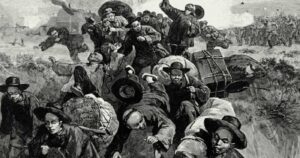 White miners, angry that the Union Pacific Railroad was hiring Chinese miners, violently attack and attempt to drive Chinese people out of Rock Springs, Wyoming, after a dispute breaks out between white and Chinese miners when both groups wanted to work in the same part of the mine. Later that day, 100 white miners gathered with guns, hatchets, and knives and marched toward “Chinatown,” where the Chinese miners lived, to stage a brutal attack. When the Chinese residents attempted to flee, the white miners fired at them while they ran. Twenty-eight Chinese people were killed in the massacre and another 15 were badly wounded. The white miners also looted and burned all 79 houses belonging to Chinese residents, leaving "Chinatown" demolished. Although 14 miners were arrested in connection with the riot and murders, none were ever convicted of any crime. Learn more. White miners, angry that the Union Pacific Railroad was hiring Chinese miners, violently attack and attempt to drive Chinese people out of Rock Springs, Wyoming, after a dispute breaks out between white and Chinese miners when both groups wanted to work in the same part of the mine. Later that day, 100 white miners gathered with guns, hatchets, and knives and marched toward “Chinatown,” where the Chinese miners lived, to stage a brutal attack. When the Chinese residents attempted to flee, the white miners fired at them while they ran. Twenty-eight Chinese people were killed in the massacre and another 15 were badly wounded. The white miners also looted and burned all 79 houses belonging to Chinese residents, leaving "Chinatown" demolished. Although 14 miners were arrested in connection with the riot and murders, none were ever convicted of any crime. Learn more. | |
| September 2, 1914 | 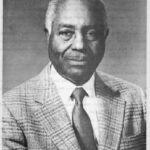 Walter Samuel McAfee, theoretical physicist, professor, and civil servant who was responsible for the first successful reception of echoing signals between earth and the moon, is born in Ore City, Texas to Susie (an educator) and Luther McAfee (a mechanic and carpenter). Dr. McAfee earned a Bachelor’s degree in Mathematics in 1934 from Wiley College, a Historically Black College and University (HBCU) in Marshall, Texas. In 1937, he earned a Master’s of Science degree from Ohio State University. McAfee then taught mathematics and biological sciences at a junior high school in Columbus, Ohio. In 1942, McAfee joined the United States Army Signal Corps Engineering Laboratories at Fort Monmouth in Belmar, New Jersey. His knowledge and mathematical skillset propelled him onto the Project Diana team, a scientific collaboration of engineers and physicists to study the Earth’s relationship to the moon via radar signal echoing. McAfee contributed the necessary theoretical calculations including a radar cross-section of the moon, radar coverage pattern, and the distance to the moon, all of which were crucial to the project’s success. On January 10, 1946, the team successfully received the echoing signals between the Earth and the moon. This success is in no small part due to McAfee’s work, yet he did not immediately receive recognition. Months later, McAfee was recognized for his contribution to Project Diana. After the success of the signal echoing project, he received the Rosenwald Fellowship to continue his doctoral degree at Cornell University in Ithaca, New York. McAfee earned his Ph.D. in Physics in 1949, focusing on nuclear collisions. Learn more. Walter Samuel McAfee, theoretical physicist, professor, and civil servant who was responsible for the first successful reception of echoing signals between earth and the moon, is born in Ore City, Texas to Susie (an educator) and Luther McAfee (a mechanic and carpenter). Dr. McAfee earned a Bachelor’s degree in Mathematics in 1934 from Wiley College, a Historically Black College and University (HBCU) in Marshall, Texas. In 1937, he earned a Master’s of Science degree from Ohio State University. McAfee then taught mathematics and biological sciences at a junior high school in Columbus, Ohio. In 1942, McAfee joined the United States Army Signal Corps Engineering Laboratories at Fort Monmouth in Belmar, New Jersey. His knowledge and mathematical skillset propelled him onto the Project Diana team, a scientific collaboration of engineers and physicists to study the Earth’s relationship to the moon via radar signal echoing. McAfee contributed the necessary theoretical calculations including a radar cross-section of the moon, radar coverage pattern, and the distance to the moon, all of which were crucial to the project’s success. On January 10, 1946, the team successfully received the echoing signals between the Earth and the moon. This success is in no small part due to McAfee’s work, yet he did not immediately receive recognition. Months later, McAfee was recognized for his contribution to Project Diana. After the success of the signal echoing project, he received the Rosenwald Fellowship to continue his doctoral degree at Cornell University in Ithaca, New York. McAfee earned his Ph.D. in Physics in 1949, focusing on nuclear collisions. Learn more. | |
| September 3, 1783 | 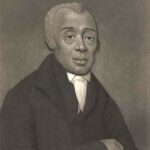 Born into slavery, at the age of 23 Richard Allen purchases his freedom for $2,000 after working odd jobs for five years. Allen would go on to become an educator, writer, minister and founder of the African Methodist Episcopal (AME) Church. Allen cared passionately about education and opened a day school for African American children. He abhorred slavery, worked actively for abolition, and maintained his home as a stop on the Underground Railroad. He was committed to self-determination for African Americans in the United States, and eventually opposed all colonization plans for African Americans in other countries. Learn more. Born into slavery, at the age of 23 Richard Allen purchases his freedom for $2,000 after working odd jobs for five years. Allen would go on to become an educator, writer, minister and founder of the African Methodist Episcopal (AME) Church. Allen cared passionately about education and opened a day school for African American children. He abhorred slavery, worked actively for abolition, and maintained his home as a stop on the Underground Railroad. He was committed to self-determination for African Americans in the United States, and eventually opposed all colonization plans for African Americans in other countries. Learn more. | |
| September 3, 1838 |  Enslaved from birth, Frederick Douglass escapes to freedom at age 21. Dressed in a sailor’s uniform to conceal his identity, Douglass traveled from Maryland by train, steam ferry, steamboat and foot to New York City and freedom in less than 24 hours. After escaping from slavery, Douglass became one of America's greatest orators and writers, and a national leader of the abolitionist movement. He was described by abolitionists in his time as a living counterexample to slaveholders' arguments that slaves lacked the intellectual capacity to function as independent American citizens. Likewise, Northerners at the time found it hard to believe that such a great orator had once been a slave. Douglass also actively supported women's suffrage. Douglass held several public offices, the first African American to do so. Without his permission, Douglass became the first African-American nominated for Vice President of the United States as the running mate and Vice Presidential nominee of Victoria Woodhull, on the Equal Rights Party ticket. Learn more. Enslaved from birth, Frederick Douglass escapes to freedom at age 21. Dressed in a sailor’s uniform to conceal his identity, Douglass traveled from Maryland by train, steam ferry, steamboat and foot to New York City and freedom in less than 24 hours. After escaping from slavery, Douglass became one of America's greatest orators and writers, and a national leader of the abolitionist movement. He was described by abolitionists in his time as a living counterexample to slaveholders' arguments that slaves lacked the intellectual capacity to function as independent American citizens. Likewise, Northerners at the time found it hard to believe that such a great orator had once been a slave. Douglass also actively supported women's suffrage. Douglass held several public offices, the first African American to do so. Without his permission, Douglass became the first African-American nominated for Vice President of the United States as the running mate and Vice Presidential nominee of Victoria Woodhull, on the Equal Rights Party ticket. Learn more. | |
| September 3, 1901 | 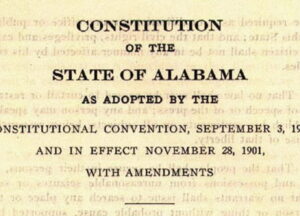 Alabama adopts a new state constitution prohibiting interracial marriage, mandating separate schools for Black and white children, and containing multiple superficially "race-neutral" provisions specifically designed to disenfranchise Black voters and suppress Black political power while providing "grandfather" clauses and exceptions to allow white local registrars (who were specifically chosen and trained to disqualify Black voters) to qualify otherwise ineligible poor white voters. Alabama was home to approximately 75,000 registered African American voters before the new constitution was enacted, but drafters estimated the new rules would reduce that number to less than 30,000. Several of the discriminatory provisions of the 1901 constitution, including the mandate to maintain racially segregated public schools, have never been repealed. Learn more. Alabama adopts a new state constitution prohibiting interracial marriage, mandating separate schools for Black and white children, and containing multiple superficially "race-neutral" provisions specifically designed to disenfranchise Black voters and suppress Black political power while providing "grandfather" clauses and exceptions to allow white local registrars (who were specifically chosen and trained to disqualify Black voters) to qualify otherwise ineligible poor white voters. Alabama was home to approximately 75,000 registered African American voters before the new constitution was enacted, but drafters estimated the new rules would reduce that number to less than 30,000. Several of the discriminatory provisions of the 1901 constitution, including the mandate to maintain racially segregated public schools, have never been repealed. Learn more. | |
| September 3, 1944 | 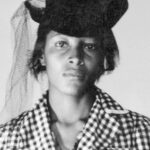 Recy Taylor, a 25-year old African-American woman who grew up as a sharecropper in Abbeville, Alabama, is gang-raped by six white men. At the time of the attack, Recy and her husband, Willie Guy Taylor, had a three-year-old daughter, Joyce. After abducting her at gunpoint, driving her deep into the woods, and each taking turns raping her, the six white men left her at the edge of town. When her father found her, they both went to Three Points police station where Recy told Sheriff George H. Gamble what happened that night. After describing the vehicle, the sheriff located and had its owner, Hugo Wilson, brought to the sheriff’s office where Taylor identified him as one of her attackers. Although Wilson named the other men involved, he insisted that there had been no rape because they paid Recy Taylor for sex; he was not arrested. In an effort to intimidate Taylor, her house was firebombed, forcing her family to move in with her father and siblings. As news spread of Taylor’s attack, she received support from the Black community, including newspapers and civil rights organizations. Responding first to pressure from the NAACP, and later to efforts by Esther Cooper Jackson of the Southern Youth Negro Conference, two separate grand juries were convened in 1944 and 1945, but both declined to indict the six men accused of the rape—Hugo Wilson, Herbert Lovett, Dillard York, Robert Gamble, Joe Culpepper, and Luther Lee. The brutal rape left Taylor unable to have additional children; her only child Joyce died in a car accident in 1967. Though denied justice, Taylors refusal to remain silent after her rape brought attention to the sexual abuse of African-American women in the Jim Crow South and inspired others across the South to speak out. In 2011, the Alabama legislature passed a resolution giving Recy Taylor an official apology. Recy Taylor died on December 28, 2017, in Abbeville, Alabama at the age of 97. She was known for her humor, her love of church, and her love of singing. Learn more. Recy Taylor, a 25-year old African-American woman who grew up as a sharecropper in Abbeville, Alabama, is gang-raped by six white men. At the time of the attack, Recy and her husband, Willie Guy Taylor, had a three-year-old daughter, Joyce. After abducting her at gunpoint, driving her deep into the woods, and each taking turns raping her, the six white men left her at the edge of town. When her father found her, they both went to Three Points police station where Recy told Sheriff George H. Gamble what happened that night. After describing the vehicle, the sheriff located and had its owner, Hugo Wilson, brought to the sheriff’s office where Taylor identified him as one of her attackers. Although Wilson named the other men involved, he insisted that there had been no rape because they paid Recy Taylor for sex; he was not arrested. In an effort to intimidate Taylor, her house was firebombed, forcing her family to move in with her father and siblings. As news spread of Taylor’s attack, she received support from the Black community, including newspapers and civil rights organizations. Responding first to pressure from the NAACP, and later to efforts by Esther Cooper Jackson of the Southern Youth Negro Conference, two separate grand juries were convened in 1944 and 1945, but both declined to indict the six men accused of the rape—Hugo Wilson, Herbert Lovett, Dillard York, Robert Gamble, Joe Culpepper, and Luther Lee. The brutal rape left Taylor unable to have additional children; her only child Joyce died in a car accident in 1967. Though denied justice, Taylors refusal to remain silent after her rape brought attention to the sexual abuse of African-American women in the Jim Crow South and inspired others across the South to speak out. In 2011, the Alabama legislature passed a resolution giving Recy Taylor an official apology. Recy Taylor died on December 28, 2017, in Abbeville, Alabama at the age of 97. She was known for her humor, her love of church, and her love of singing. Learn more. | |
| September 4, 1816 |  The African Methodist Episcopal Church is organized as the first independent black denomination in the United States. Learn more. The African Methodist Episcopal Church is organized as the first independent black denomination in the United States. Learn more. | |
| September 4, 1848 | 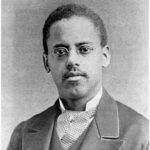 Prolific African American inventor and patent draftsman Lewis Howard Latimer is born in Chelsea, Massachusetts, to Rebecca and George Latimer who had escaped from slavery six years before. After the U.S. Supreme Court’s Dred Scott decision required that former enslaved individuals prove they had the consent of their slaveholder in order to legally become free, Lewis’s parents decided that, for the family’s safety, Lewis's father should flee because he had nothing to prove he was free from enslavement. Lewis joined the U.S. Navy at the age of 15 on September 16, 1863. After receiving an honorable discharge on July 3, 1865, Lattimer was employed as an office boy with a patent law firm; by 1872 he risen to the position of head draftsman. In 1874, Latimer co-patented (with Charles M. Brown) an improved toilet system for railroad cars called the Water Closet for Railroad Cars (U.S. Patent 147,363). In 1876, Alexander Graham Bell employed Latimer to draft the necessary drawings required to receive a patent for Bell's telephone. In 1879, he moved to Bridgeport, Connecticut, and was hired as assistant manager and draftsman for the U.S. Electric Lighting Company, a company owned by Hiram Maxim, a rival of Thomas A. Edison. While Latimer was there he invented a modification to the process for making carbon filaments which aimed to reduce breakages during the carbonization process. While in England on behalf of the Maxim light company he taught the entire process for making Maxim lights, including glassblowing in 9 months in order to get the factory up and running. In 1884, he was invited to work with Thomas Edison. Latimer later developed a forerunner of the air conditioner called "Apparatus for cooling and disinfecting". In 1894, Latimer pursued a patent on a safety elevator which prevented the riders from falling out and into the shaft. Lattimer wrote a book of poetry called Poems of Love and Life, a technical book, Incandescent Electric Lighting (1890), and various pieces for African-American journals. Latimer also played the violin and flute, painted portraits, and wrote plays. An early advocate of civil rights, Latimer wrote an 1895 statement about equality, security, and opportunity in connection with the National Conference of Colored Men. In later life, Latimer taught English and drafting courses to immigrants at the Henry Street Settlement in New York. Learn more. Prolific African American inventor and patent draftsman Lewis Howard Latimer is born in Chelsea, Massachusetts, to Rebecca and George Latimer who had escaped from slavery six years before. After the U.S. Supreme Court’s Dred Scott decision required that former enslaved individuals prove they had the consent of their slaveholder in order to legally become free, Lewis’s parents decided that, for the family’s safety, Lewis's father should flee because he had nothing to prove he was free from enslavement. Lewis joined the U.S. Navy at the age of 15 on September 16, 1863. After receiving an honorable discharge on July 3, 1865, Lattimer was employed as an office boy with a patent law firm; by 1872 he risen to the position of head draftsman. In 1874, Latimer co-patented (with Charles M. Brown) an improved toilet system for railroad cars called the Water Closet for Railroad Cars (U.S. Patent 147,363). In 1876, Alexander Graham Bell employed Latimer to draft the necessary drawings required to receive a patent for Bell's telephone. In 1879, he moved to Bridgeport, Connecticut, and was hired as assistant manager and draftsman for the U.S. Electric Lighting Company, a company owned by Hiram Maxim, a rival of Thomas A. Edison. While Latimer was there he invented a modification to the process for making carbon filaments which aimed to reduce breakages during the carbonization process. While in England on behalf of the Maxim light company he taught the entire process for making Maxim lights, including glassblowing in 9 months in order to get the factory up and running. In 1884, he was invited to work with Thomas Edison. Latimer later developed a forerunner of the air conditioner called "Apparatus for cooling and disinfecting". In 1894, Latimer pursued a patent on a safety elevator which prevented the riders from falling out and into the shaft. Lattimer wrote a book of poetry called Poems of Love and Life, a technical book, Incandescent Electric Lighting (1890), and various pieces for African-American journals. Latimer also played the violin and flute, painted portraits, and wrote plays. An early advocate of civil rights, Latimer wrote an 1895 statement about equality, security, and opportunity in connection with the National Conference of Colored Men. In later life, Latimer taught English and drafting courses to immigrants at the Henry Street Settlement in New York. Learn more.
| |
| September 4, 1875 | 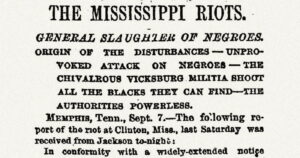 Democrats attack Republicans and massacre local Black populations in Clinton and Vicksburg, Mississippi. In that era (and for decades before and after), the Republican Party was the vanguard of civil rights supporters while the Democratic Party was the vanguard of white supremacy. Republicans in Hinds County, Mississippi, held a barbecue and meeting in the town of Clinton that was attended by 3,000 people. Hoping to curb the risk of violent political conflict, Clinton authorities appointed special police and prohibited serving liquor. When the Republican speakers began making their political speeches in the afternoon, Democratic party representatives unexpectedly joined the meeting and requested speaking time. In the interest of keeping the peace, Republican officials agreed to accommodate Democrats' request to speak and arranged for a public discussion between Judge Amos R. Johnston, a Democratic candidate for state senate, and Captain H.T. Fisher, Republican editor of the Jackson Times. Both speakers were to be given an equal amount of speaking time, and Johnston spoke first. When Mr. Fisher's turn came, he expressed optimism that meetings between the parties could take place peacefully in the future -- but eight minutes into his address, an altercation erupted in the crowd. A gunfight between Black and white people in the audience rang out, as bystanders panicked and rushed to escape the danger. Within fifteen minutes, three white people and four Black people were dead, and six white people and twenty Black people were wounded. Though newspapers reported that the Black people who had fired weapons were acting in self-defense, many white observers were enraged by the Black show of force. That night, armed white men from Clinton and Vicksburg formed roving bands targeting Black men. By the next day, an estimated fifty Black people had been killed. Many more had been forced into the woods and swampland to avoid an attack, where they remained until the attack subsided. Learn more. Democrats attack Republicans and massacre local Black populations in Clinton and Vicksburg, Mississippi. In that era (and for decades before and after), the Republican Party was the vanguard of civil rights supporters while the Democratic Party was the vanguard of white supremacy. Republicans in Hinds County, Mississippi, held a barbecue and meeting in the town of Clinton that was attended by 3,000 people. Hoping to curb the risk of violent political conflict, Clinton authorities appointed special police and prohibited serving liquor. When the Republican speakers began making their political speeches in the afternoon, Democratic party representatives unexpectedly joined the meeting and requested speaking time. In the interest of keeping the peace, Republican officials agreed to accommodate Democrats' request to speak and arranged for a public discussion between Judge Amos R. Johnston, a Democratic candidate for state senate, and Captain H.T. Fisher, Republican editor of the Jackson Times. Both speakers were to be given an equal amount of speaking time, and Johnston spoke first. When Mr. Fisher's turn came, he expressed optimism that meetings between the parties could take place peacefully in the future -- but eight minutes into his address, an altercation erupted in the crowd. A gunfight between Black and white people in the audience rang out, as bystanders panicked and rushed to escape the danger. Within fifteen minutes, three white people and four Black people were dead, and six white people and twenty Black people were wounded. Though newspapers reported that the Black people who had fired weapons were acting in self-defense, many white observers were enraged by the Black show of force. That night, armed white men from Clinton and Vicksburg formed roving bands targeting Black men. By the next day, an estimated fifty Black people had been killed. Many more had been forced into the woods and swampland to avoid an attack, where they remained until the attack subsided. Learn more. | |
| September 4, 1908 | 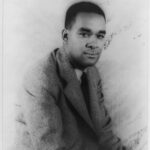 Richard Wright, author of novels, short stories, poems, and non-fiction, is born. Wright’s most famous works are the groundbreaking and highly influential novels Black Boy and Native Son. Much of his literature concerns racial themes, especially related to the plight of African Americans during the late 19th to mid-20th centuries suffering discrimination and violence. Literary critics believe his work helped change race relations in the United States in the mid-20th century. Learn more.
Richard Wright, author of novels, short stories, poems, and non-fiction, is born. Wright’s most famous works are the groundbreaking and highly influential novels Black Boy and Native Son. Much of his literature concerns racial themes, especially related to the plight of African Americans during the late 19th to mid-20th centuries suffering discrimination and violence. Literary critics believe his work helped change race relations in the United States in the mid-20th century. Learn more. | |
| September 5, 1846 | 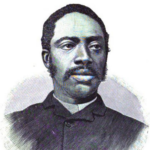 Lawyer, teacher, civil servant, journalist, historian, and civil rights activist John Wesley Cromwell is born into slavery in Portsmouth, Virginia. In 1851, after his father purchased his family’s freedom and moved them to Philadelphia in the free state of Pennsylvania, John began attending school, graduating from the Preparatory Department of the Institute for Colored Youth in 1864. Cromwell was among the founders of the Bethel Literary and Historical Society and the American Negro Academy, both based in Washington, DC. He worked for decades in administration of the US Post Office. He also was a founder, editor, or contributor to a number of newspapers and journals, including most prominently The People's Advocate. In the latter half of his career, he wrote articles and manuscripts and gave speeches, establishing himself as a leading scholar of African-American history. In 1887, he was described as the "best English scholar in the United States." Cromwell was also successful as a lawyer late in life and was the first Black lawyer to appear before the Interstate Commerce Commission. Learn more. Lawyer, teacher, civil servant, journalist, historian, and civil rights activist John Wesley Cromwell is born into slavery in Portsmouth, Virginia. In 1851, after his father purchased his family’s freedom and moved them to Philadelphia in the free state of Pennsylvania, John began attending school, graduating from the Preparatory Department of the Institute for Colored Youth in 1864. Cromwell was among the founders of the Bethel Literary and Historical Society and the American Negro Academy, both based in Washington, DC. He worked for decades in administration of the US Post Office. He also was a founder, editor, or contributor to a number of newspapers and journals, including most prominently The People's Advocate. In the latter half of his career, he wrote articles and manuscripts and gave speeches, establishing himself as a leading scholar of African-American history. In 1887, he was described as the "best English scholar in the United States." Cromwell was also successful as a lawyer late in life and was the first Black lawyer to appear before the Interstate Commerce Commission. Learn more. | |
| September 5, 1877 | 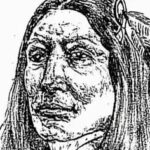 Four months after surrendering to U.S. troops under General George Crook, Oglala Sioux chief Crazy Horse is fatally wounded by a bayonet-wielding military guard while allegedly resisting imprisonment at Camp Robinson in present-day Nebraska.. Crazy Horse was a Lakota war leader of the Oglala band in the 19th century. He took up arms against the United States federal government to fight against encroachment by white American settlers on Native American territory and to preserve the traditional way of life of the Lakota people. His participation in several famous battles of the Black Hills War on the northern Great Plains, among them the Fetterman Fight in 1866 in which he acted as a decoy and the Battle of the Little Bighorn in 1876 in which he led a war party to victory, earned him great respect from both his enemies and his own people. Learn more. Four months after surrendering to U.S. troops under General George Crook, Oglala Sioux chief Crazy Horse is fatally wounded by a bayonet-wielding military guard while allegedly resisting imprisonment at Camp Robinson in present-day Nebraska.. Crazy Horse was a Lakota war leader of the Oglala band in the 19th century. He took up arms against the United States federal government to fight against encroachment by white American settlers on Native American territory and to preserve the traditional way of life of the Lakota people. His participation in several famous battles of the Black Hills War on the northern Great Plains, among them the Fetterman Fight in 1866 in which he acted as a decoy and the Battle of the Little Bighorn in 1876 in which he led a war party to victory, earned him great respect from both his enemies and his own people. Learn more. | |
| September 5, 1912 | 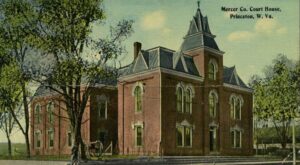 A Black man named Walter Johnson, who authorities later conceded was likely wrongly accused as having assaulted a white girl, is lynched by a mob of armed white men in Princeton, West Virginia. The mob kidnapped Mr. Johnson from police custody, beat him with clubs and rocks, strung him to a telephone pole outside the county courthouse “in the presence of the judge, sheriff, and armed guards” and shot him with hundreds of bullets. After the lynching, the growing mob patrolled the town terrorizing other African Americans, threatening to lynch other Black people they encountered – including those who attempted to cut down Mr. Johnson’s hanging corpse. Instead, the mob cut the dead body down, stripped off most of the clothing to keep as souvenirs, and then again hanged the corpse from the same pole. A grand jury convened to investigate the murder declined to return a single indictment, and no one was ever arrested or prosecuted for Mr. Johnson's lynching. The ubiquity of lynching-based terrorism in 19th and 20th century America is minimally underscored by the fact that typing "Walter Johnson lynching" into a search engine yields results for multiple Black lynching victims with that same exact name in different parts of the country in different years and other victims with the same last name. Learn more. A Black man named Walter Johnson, who authorities later conceded was likely wrongly accused as having assaulted a white girl, is lynched by a mob of armed white men in Princeton, West Virginia. The mob kidnapped Mr. Johnson from police custody, beat him with clubs and rocks, strung him to a telephone pole outside the county courthouse “in the presence of the judge, sheriff, and armed guards” and shot him with hundreds of bullets. After the lynching, the growing mob patrolled the town terrorizing other African Americans, threatening to lynch other Black people they encountered – including those who attempted to cut down Mr. Johnson’s hanging corpse. Instead, the mob cut the dead body down, stripped off most of the clothing to keep as souvenirs, and then again hanged the corpse from the same pole. A grand jury convened to investigate the murder declined to return a single indictment, and no one was ever arrested or prosecuted for Mr. Johnson's lynching. The ubiquity of lynching-based terrorism in 19th and 20th century America is minimally underscored by the fact that typing "Walter Johnson lynching" into a search engine yields results for multiple Black lynching victims with that same exact name in different parts of the country in different years and other victims with the same last name. Learn more. | |
| September 5, 1939 | 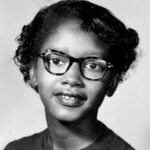 Claudette Colvin, a pioneer of the 1950s civil rights movement, is born. On March 2, 1955, the 15-year old Colvin was arrested in Montgomery, Alabama, for refusing to give up her seat to a white woman on a crowded, segregated bus. This occurred nine months before the more widely known incident in which Rosa Parks, secretary of the local chapter of the National Association for the Advancement of Colored People (NAACP), helped spark the 1955 Montgomery bus boycott. Colvin was one of five plaintiffs in the first federal court case filed by civil rights attorney Fred Gray on February 1, 1956, as Browder v. Gayle, to challenge bus segregation in the city. In a United States district court, she testified before the three-judge panel that heard the case. On June 13, 1956, the judges determined that the state and local laws requiring bus segregation in Alabama were unconstitutional. The case went to the United States Supreme Court on appeal by the state, and it upheld the district court's ruling on November 13, 1956. One month later, the Supreme Court affirmed the order to Montgomery and the state of Alabama to end bus segregation. The Montgomery bus boycott was then called off after a few months. For many years, Montgomery's black leaders did not publicize Colvin's pioneering effort. Colvin's case was dropped by civil rights campaigners because Colvin was pregnant with a child out of wedlock during the proceedings. It is now widely accepted that Colvin was not accredited by civil rights campaigners at the time due to that factor, with even Rosa Parks saying "If the white press got ahold of that information, they would have [had] a field day. They'd call her a bad girl, and her case wouldn't have a chance." Learn more. Claudette Colvin, a pioneer of the 1950s civil rights movement, is born. On March 2, 1955, the 15-year old Colvin was arrested in Montgomery, Alabama, for refusing to give up her seat to a white woman on a crowded, segregated bus. This occurred nine months before the more widely known incident in which Rosa Parks, secretary of the local chapter of the National Association for the Advancement of Colored People (NAACP), helped spark the 1955 Montgomery bus boycott. Colvin was one of five plaintiffs in the first federal court case filed by civil rights attorney Fred Gray on February 1, 1956, as Browder v. Gayle, to challenge bus segregation in the city. In a United States district court, she testified before the three-judge panel that heard the case. On June 13, 1956, the judges determined that the state and local laws requiring bus segregation in Alabama were unconstitutional. The case went to the United States Supreme Court on appeal by the state, and it upheld the district court's ruling on November 13, 1956. One month later, the Supreme Court affirmed the order to Montgomery and the state of Alabama to end bus segregation. The Montgomery bus boycott was then called off after a few months. For many years, Montgomery's black leaders did not publicize Colvin's pioneering effort. Colvin's case was dropped by civil rights campaigners because Colvin was pregnant with a child out of wedlock during the proceedings. It is now widely accepted that Colvin was not accredited by civil rights campaigners at the time due to that factor, with even Rosa Parks saying "If the white press got ahold of that information, they would have [had] a field day. They'd call her a bad girl, and her case wouldn't have a chance." Learn more. | |
| September 6, 1913 | 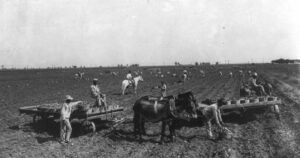 After twelve Black male inmates of a Richmond, Texas prison farm are placed in underground cell for nearly 24 hours as punishment for not picking cotton fast enough, eight die of asphyxiation. The cell was nine feet long, seven feet wide, and seven feet high, and temperatures outside neared 100 degrees Fahrenheit. The only ventilation in the cell came from four small holes connected to pipes in the ceiling that were “just large enough to admit a quarter.” The next day, inspectors found that one of the holes had been plugged. Three of the surviving men explained that they were each able to position themselves by one of the three working holes in the ceiling; the fourth survived by pressing his face against the crack at the bottom of the door. They cried out repeatedly throughout the night that men were dying, but were purposely ignored by the guards. Texas ultimately concluded that prison officials were not culpable because placing these men in this suffocating chamber, and failing to listen to their pleas for help, did not violate the law. Today, millions of Americans are incarcerated in overcrowded, violent, and inhumane jails and prisons operated with the same deadly indifference to human suffering that resulted in the suffocation deaths of these eight Black men in Texas over a century ago. Learn more. After twelve Black male inmates of a Richmond, Texas prison farm are placed in underground cell for nearly 24 hours as punishment for not picking cotton fast enough, eight die of asphyxiation. The cell was nine feet long, seven feet wide, and seven feet high, and temperatures outside neared 100 degrees Fahrenheit. The only ventilation in the cell came from four small holes connected to pipes in the ceiling that were “just large enough to admit a quarter.” The next day, inspectors found that one of the holes had been plugged. Three of the surviving men explained that they were each able to position themselves by one of the three working holes in the ceiling; the fourth survived by pressing his face against the crack at the bottom of the door. They cried out repeatedly throughout the night that men were dying, but were purposely ignored by the guards. Texas ultimately concluded that prison officials were not culpable because placing these men in this suffocating chamber, and failing to listen to their pleas for help, did not violate the law. Today, millions of Americans are incarcerated in overcrowded, violent, and inhumane jails and prisons operated with the same deadly indifference to human suffering that resulted in the suffocation deaths of these eight Black men in Texas over a century ago. Learn more. | |
| September 6, 1960 | 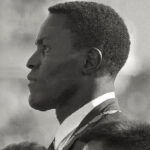 Rafer Johnson wins the gold medal in the decathlon in the 1960 Olympics. He had previously won silver in the 1956 Olympics and gold in the 1955 Pan American Games. He was the USA team's flag bearer at the 1960 Olympics and lit the Olympic cauldron at the Los Angeles Games in 1984. In 1968, Johnson, football player Rosey Grier, and journalist George Plimpton tackled Sirhan Sirhan moments after he had fatally shot Robert F. Kennedy. After he retired from athletics, Johnson turned to acting, sportscasting, and public service and was instrumental in creating the California Special Olympics. His acting career included appearances in The Sins of Rachel Cade (1961), the Elvis Presley film Wild in the Country (1961), Pirates of Tortuga (1961), None but the Brave (1965), two Tarzan films with Mike Henry, The Last Grenade (1970), Soul Soldier (1970), Roots: The Next Generations (1979), the James Bond film Licence to Kill (1989), and Think Big (1990). Learn more.
Rafer Johnson wins the gold medal in the decathlon in the 1960 Olympics. He had previously won silver in the 1956 Olympics and gold in the 1955 Pan American Games. He was the USA team's flag bearer at the 1960 Olympics and lit the Olympic cauldron at the Los Angeles Games in 1984. In 1968, Johnson, football player Rosey Grier, and journalist George Plimpton tackled Sirhan Sirhan moments after he had fatally shot Robert F. Kennedy. After he retired from athletics, Johnson turned to acting, sportscasting, and public service and was instrumental in creating the California Special Olympics. His acting career included appearances in The Sins of Rachel Cade (1961), the Elvis Presley film Wild in the Country (1961), Pirates of Tortuga (1961), None but the Brave (1965), two Tarzan films with Mike Henry, The Last Grenade (1970), Soul Soldier (1970), Roots: The Next Generations (1979), the James Bond film Licence to Kill (1989), and Think Big (1990). Learn more. | |
| September 6, 2018 | 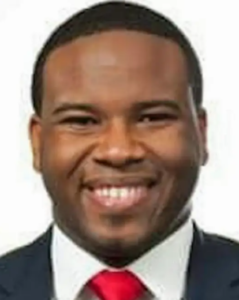 Twenty-six year-old Botham Shem Jean is killed in his Dallas, Texas apartment by off-duty police officer Amber Renee Guyger, setting off nationwide protests from various organizations including Color of Change, a racial justice organization, and Black Lives Matter (BLM), about whether a black man can be safe even in his own home. Officer Guyger was headed home and mistakenly parked her vehicle on the fourth floor instead of on the third floor of the building where her apartment was located. Accounts vary on whether Jean’s apartment door was locked or ajar, but the evidence shows that Guyger entered Apartment 1478 and shouted verbal commands before firing her service weapon twice, striking Jean once in the torso as he sat on his couch eating ice cream. Guyger called 911 and stated, “I thought it was my apartment.” Jean was pronounced dead after being rushed to the Baylor University Medical Center. At trial, Assistant District Attorney Jason Hermus stated that Guyger went against her police training by missing obvious signs that the apartment was not her own, including the different apartment numbers and a bright red mat that she stepped over before entering the darkened room. She also did not call for backup from a police station two blocks away or try to administer CPR. Instead, she texted Officer Martin Riveria with whom she had a relationship and had been sexting prior to the shooting. On Tuesday October 1, 2019, Guyger was sentenced to 10 years in prison. On October 4, 2019, Joshua Brown, a neighbor and key witness, was murdered during a drug deal. On Wednesday October 16, 2019, attorneys for Guyger filed a notice to appeal her conviction. Learn more. Twenty-six year-old Botham Shem Jean is killed in his Dallas, Texas apartment by off-duty police officer Amber Renee Guyger, setting off nationwide protests from various organizations including Color of Change, a racial justice organization, and Black Lives Matter (BLM), about whether a black man can be safe even in his own home. Officer Guyger was headed home and mistakenly parked her vehicle on the fourth floor instead of on the third floor of the building where her apartment was located. Accounts vary on whether Jean’s apartment door was locked or ajar, but the evidence shows that Guyger entered Apartment 1478 and shouted verbal commands before firing her service weapon twice, striking Jean once in the torso as he sat on his couch eating ice cream. Guyger called 911 and stated, “I thought it was my apartment.” Jean was pronounced dead after being rushed to the Baylor University Medical Center. At trial, Assistant District Attorney Jason Hermus stated that Guyger went against her police training by missing obvious signs that the apartment was not her own, including the different apartment numbers and a bright red mat that she stepped over before entering the darkened room. She also did not call for backup from a police station two blocks away or try to administer CPR. Instead, she texted Officer Martin Riveria with whom she had a relationship and had been sexting prior to the shooting. On Tuesday October 1, 2019, Guyger was sentenced to 10 years in prison. On October 4, 2019, Joshua Brown, a neighbor and key witness, was murdered during a drug deal. On Wednesday October 16, 2019, attorneys for Guyger filed a notice to appeal her conviction. Learn more. | |
| September 7, 1859 | 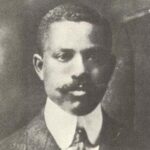 John Henry Merrick—insurance agent, entrepreneur, business owner—is born in Clinton, North Carolina. Merrick was born a slave; he lived with his mother Martha Merrick and a younger brother. With the 1863 Emancipation Proclamation his family was freed. As a child, Merrick worked as a shoe shine boy and a helper in a brickyard, eventually becoming a brick mason as a young adult. After learning the barber trade, Merrick started, owned, and operated a chain of eight barbershops in Durham, North Caroline. He invested in real estate, eventually founding the Merrick-Moore-Spaulding Land Company in Durham. Merrick became involved in the budding insurance business in 1883, and in 1898 became one of the co-founders of the North Carolina Mutual Provident Life Insurance Company which eventually became the largest Black-owned insurance company in the United States. Learn more. John Henry Merrick—insurance agent, entrepreneur, business owner—is born in Clinton, North Carolina. Merrick was born a slave; he lived with his mother Martha Merrick and a younger brother. With the 1863 Emancipation Proclamation his family was freed. As a child, Merrick worked as a shoe shine boy and a helper in a brickyard, eventually becoming a brick mason as a young adult. After learning the barber trade, Merrick started, owned, and operated a chain of eight barbershops in Durham, North Caroline. He invested in real estate, eventually founding the Merrick-Moore-Spaulding Land Company in Durham. Merrick became involved in the budding insurance business in 1883, and in 1898 became one of the co-founders of the North Carolina Mutual Provident Life Insurance Company which eventually became the largest Black-owned insurance company in the United States. Learn more. | |
| September 7, 1918 | 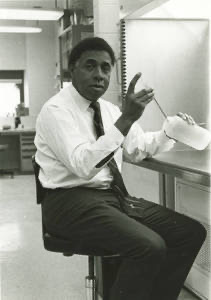 Dr. Harold Amos is born in Pennsauken, New Jersey. The first African American to chair a department of the Harvard Medical School, Dr. Amos was an esteemed teacher, researcher, and mentor at the institution for more than four decades. Amos dedicated much of his career to supporting the advancement of historically underrepresented individuals and communities within the fields of medicine and science. He also pursued an impressive research agenda, gaining international recognition for his work on bacterial metabolism, nutrition, animal cell culture, virology, and the effects of hormones. Amos finished first in his class at Camden High School. He received an academic scholarship to attend Springfield College in Massachusetts, graduating summa cum laude in 1941 with a major in Biology and a minor in Chemistry. During World War II, Amos served in the U.S. Army Quartermaster Corps. Following his discharge from the military in 1946, Amos enrolled in the Biological Sciences program at Harvard Medical School. He progressed quickly through the program, receiving his M.A. in 1947 and his Ph.D. in 1952 and was the first African American to earn a doctoral degree from Harvard’s Division of Medical Sciences. Following graduation, he received a Fulbright Fellowship to spend 2 years in France at the Pasteur Institute. In 1975, he was awarded a prestigious endowed position, the Maude and Lillian Presley Professor of Microbiology and Molecular Genetics. Other awards received in recognition of this scholarship and professional service included: honorary doctoral degrees from Harvard University and Springfield College; the first $50,000 Dr. Charles Drew World Medical Prize from Howard University; and the Public Welfare Medal of the National Academy of Sciences. Amos was also a fellow of the American Academy of Arts and Sciences and a presidential appointee to the National Cancer Advisory Board. Learn more. Dr. Harold Amos is born in Pennsauken, New Jersey. The first African American to chair a department of the Harvard Medical School, Dr. Amos was an esteemed teacher, researcher, and mentor at the institution for more than four decades. Amos dedicated much of his career to supporting the advancement of historically underrepresented individuals and communities within the fields of medicine and science. He also pursued an impressive research agenda, gaining international recognition for his work on bacterial metabolism, nutrition, animal cell culture, virology, and the effects of hormones. Amos finished first in his class at Camden High School. He received an academic scholarship to attend Springfield College in Massachusetts, graduating summa cum laude in 1941 with a major in Biology and a minor in Chemistry. During World War II, Amos served in the U.S. Army Quartermaster Corps. Following his discharge from the military in 1946, Amos enrolled in the Biological Sciences program at Harvard Medical School. He progressed quickly through the program, receiving his M.A. in 1947 and his Ph.D. in 1952 and was the first African American to earn a doctoral degree from Harvard’s Division of Medical Sciences. Following graduation, he received a Fulbright Fellowship to spend 2 years in France at the Pasteur Institute. In 1975, he was awarded a prestigious endowed position, the Maude and Lillian Presley Professor of Microbiology and Molecular Genetics. Other awards received in recognition of this scholarship and professional service included: honorary doctoral degrees from Harvard University and Springfield College; the first $50,000 Dr. Charles Drew World Medical Prize from Howard University; and the Public Welfare Medal of the National Academy of Sciences. Amos was also a fellow of the American Academy of Arts and Sciences and a presidential appointee to the National Cancer Advisory Board. Learn more. | |
| September 7, 1963 | 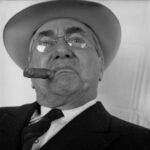 Local merchants in Plaquemines Parish, Louisiana, begin enforcing a new ordinance that denying service to all members of the U.S. military, regardless of their race. The ordinance was an aggressive response to a report from President John F. Kennedy's Committee on Equal Opportunity in the Armed Services ("The Geller Report"), which had urged military officers to declare segregated civilian establishments "off-limits" to those under their command. Leander Perez, the local district attorney and judge who defended the ordinance, admitted it would “hurt our good white boys who are in the military service” and would bring a significant loss in revenue, but he nevertheless argued that banning all troops from being served was necessary because maintaining segregation was more important. Perez gave public speeches pledging to outlaw the NAACP, describing integration as the "mongrelization of the races," and encouraging politicians to commit criminal contempt in defiance of desegregation orders. A devout Catholic, Perez took a segregationist position so extreme that the Archbishop of the Diocese of New Orleans excommunicated him from the church. Learn more.
Local merchants in Plaquemines Parish, Louisiana, begin enforcing a new ordinance that denying service to all members of the U.S. military, regardless of their race. The ordinance was an aggressive response to a report from President John F. Kennedy's Committee on Equal Opportunity in the Armed Services ("The Geller Report"), which had urged military officers to declare segregated civilian establishments "off-limits" to those under their command. Leander Perez, the local district attorney and judge who defended the ordinance, admitted it would “hurt our good white boys who are in the military service” and would bring a significant loss in revenue, but he nevertheless argued that banning all troops from being served was necessary because maintaining segregation was more important. Perez gave public speeches pledging to outlaw the NAACP, describing integration as the "mongrelization of the races," and encouraging politicians to commit criminal contempt in defiance of desegregation orders. A devout Catholic, Perez took a segregationist position so extreme that the Archbishop of the Diocese of New Orleans excommunicated him from the church. Learn more. | |
| September 8, 1954 | 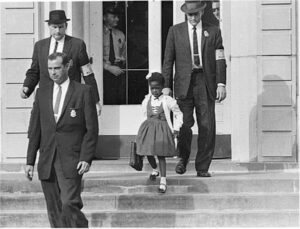 Ruby Nell Bridges Hall is born. In first grade, at the tender age of just 6 years old, she will become the first African-American child to desegregate the all-white William Frantz Elementary School in Louisiana during the New Orleans school desegregation crisis. Owing to constant, virulent anti-integration demonstrations outside the school and threats to her safety Bridges had to be escorted to and from school each day by a contingent of U.S. Marshals and completed all of first-grade in an empty classroom by herself with just her teacher, unable even to eat lunch or take recess outside that classroom. Here first-grade experience is immortalized in a 1964 painting, The Problem We All Live With by Norman Rockwell. After graduating from a desegregated high school, she worked as a travel agent for 15 years and later became a full-time parent. She is now chair of the Ruby Bridges Foundation, which she formed in 1999 to promote "the values of tolerance, respect, and appreciation of all differences". Describing the mission of the group, she says, "racism is a grown-up disease and we must stop using our children to spread it." Learn more. Ruby Nell Bridges Hall is born. In first grade, at the tender age of just 6 years old, she will become the first African-American child to desegregate the all-white William Frantz Elementary School in Louisiana during the New Orleans school desegregation crisis. Owing to constant, virulent anti-integration demonstrations outside the school and threats to her safety Bridges had to be escorted to and from school each day by a contingent of U.S. Marshals and completed all of first-grade in an empty classroom by herself with just her teacher, unable even to eat lunch or take recess outside that classroom. Here first-grade experience is immortalized in a 1964 painting, The Problem We All Live With by Norman Rockwell. After graduating from a desegregated high school, she worked as a travel agent for 15 years and later became a full-time parent. She is now chair of the Ruby Bridges Foundation, which she formed in 1999 to promote "the values of tolerance, respect, and appreciation of all differences". Describing the mission of the group, she says, "racism is a grown-up disease and we must stop using our children to spread it." Learn more. | |
| September 8, 1969 | 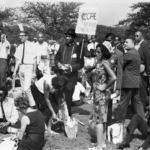 A curfew is finally lifted in Hartford, Connecticut following days of public unrest over police misconduct and widespread racism throughout the city. Hartford, Connecticut in the late 1960’s was a city immersed in racial unrest, class disputes, and activism. The city was a dichotomy between the ghetto, predominantly Black or Puerto Rican and impoverished, in the North End and the South End, white and middle or working class. The Black population had grown dramatically in 1965 from 25 percent to 75 percent. Job opportunities for Puerto Rican and Black people were few and never well-paying, with the added hindrance that white people owned 80 percent of the businesses in the North End. Racial discrimination permeated every aspect of the city, and police brutality in particular was heavy on Black Hartford citizens. On August 10, Puerto Ricans rioted following the assault of an elderly Puerto Rican woman by Comancheros, a faction of the white male motorcycle gang Hells Angels. The Hartford police had done nothing in response to the assault or other anti-Puerto Rican incidents. Consequently, African Americans and Puerto Ricans allied against the police on September 1 after teenager Dennis Jones was shot and killed by a West Hartford police officer. On September 2, another curfew was set and by the end of the following day, 266 people had been arrested and the North End was burning. By September 5, five hundred people had been arrested. The curfew was lifted and the violence in Hartford ended, but the fight for civil rights by both Blacks and Puerto Ricans continued. Learn more. A curfew is finally lifted in Hartford, Connecticut following days of public unrest over police misconduct and widespread racism throughout the city. Hartford, Connecticut in the late 1960’s was a city immersed in racial unrest, class disputes, and activism. The city was a dichotomy between the ghetto, predominantly Black or Puerto Rican and impoverished, in the North End and the South End, white and middle or working class. The Black population had grown dramatically in 1965 from 25 percent to 75 percent. Job opportunities for Puerto Rican and Black people were few and never well-paying, with the added hindrance that white people owned 80 percent of the businesses in the North End. Racial discrimination permeated every aspect of the city, and police brutality in particular was heavy on Black Hartford citizens. On August 10, Puerto Ricans rioted following the assault of an elderly Puerto Rican woman by Comancheros, a faction of the white male motorcycle gang Hells Angels. The Hartford police had done nothing in response to the assault or other anti-Puerto Rican incidents. Consequently, African Americans and Puerto Ricans allied against the police on September 1 after teenager Dennis Jones was shot and killed by a West Hartford police officer. On September 2, another curfew was set and by the end of the following day, 266 people had been arrested and the North End was burning. By September 5, five hundred people had been arrested. The curfew was lifted and the violence in Hartford ended, but the fight for civil rights by both Blacks and Puerto Ricans continued. Learn more. | |
| September 8, 1975 |  US Air Force Tech Sergeant Leonard Matlovich, a decorated veteran of the Vietnam War, appears in his Air Force uniform on the cover of Time magazine with the headline "I Am A Homosexual", the first named openly gay person to appear on the cover of a U.S. newsmagazine, making him a symbol for thousands of gay and lesbian service members and gay people generally. In addition to being a recipient of the Purple Heart and Bronze Star for his service in the Vietnam War, Tech Sergeant Matlovich was a race relations instructor. He was the first gay service member to purposely out himself to the military to fight their ban on gays. His fight to stay in the United States Air Force after coming out of the closet became a cause célèbre around which the gay community rallied. In addition to the Time cover, Matlovich's case resulted in articles in newspapers and magazines throughout the country, numerous television interviews, and a television movie on NBC. In response to his coming out, Matlovich was involuntarily given a general discharge, later upgraded to honorable. Matlovich sued for reinstatement; convinced that the military would find some other reason to discharge him if he reentered the service, or that the conservative Supreme Court would rule against him should the Air Force appeal, Matlovich eventually accepted a financial settlement offered by the Air Force. In June 1988, Matlovich died in Los Angeles of complications from HIV/AIDS. His tombstone, meant to be a memorial to all gay veterans, does not bear his name. It reads, "When I was in the military, they gave me a medal for killing two men and a discharge for loving one." In October 2006, Matlovich was honored by LGBT History Month as a leader in the history of the LGBT community. Learn more. US Air Force Tech Sergeant Leonard Matlovich, a decorated veteran of the Vietnam War, appears in his Air Force uniform on the cover of Time magazine with the headline "I Am A Homosexual", the first named openly gay person to appear on the cover of a U.S. newsmagazine, making him a symbol for thousands of gay and lesbian service members and gay people generally. In addition to being a recipient of the Purple Heart and Bronze Star for his service in the Vietnam War, Tech Sergeant Matlovich was a race relations instructor. He was the first gay service member to purposely out himself to the military to fight their ban on gays. His fight to stay in the United States Air Force after coming out of the closet became a cause célèbre around which the gay community rallied. In addition to the Time cover, Matlovich's case resulted in articles in newspapers and magazines throughout the country, numerous television interviews, and a television movie on NBC. In response to his coming out, Matlovich was involuntarily given a general discharge, later upgraded to honorable. Matlovich sued for reinstatement; convinced that the military would find some other reason to discharge him if he reentered the service, or that the conservative Supreme Court would rule against him should the Air Force appeal, Matlovich eventually accepted a financial settlement offered by the Air Force. In June 1988, Matlovich died in Los Angeles of complications from HIV/AIDS. His tombstone, meant to be a memorial to all gay veterans, does not bear his name. It reads, "When I was in the military, they gave me a medal for killing two men and a discharge for loving one." In October 2006, Matlovich was honored by LGBT History Month as a leader in the history of the LGBT community. Learn more. | |
| September 9, 1739 | 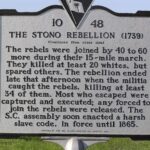 The Stono Rebellion (also known as Cato's Conspiracy or Cato's Rebellion), a slave revolt in the colony of South Carolina, begins. It was the largest slave rebellion in the Southern Colonies, with 25 colonists and 35 to 50 Africans killed. The uprising was led by native Africans who were likely from the Central African Kingdom of Kongo, as the rebels were Catholic and some spoke Portuguese. The leader of the rebellion, Jemmy, was a literate slave. In some reports, however, he is referred to as "Cato", and likely was held by the Cato, or Cater, family who lived near the Ashley River and north of the Stono River. He led 20 other enslaved Kongolese, who may have been former soldiers, in an armed march south from the Stono River. They were bound for Spanish Florida, where successive proclamations had promised freedom for fugitive slaves from British North America. Jemmy and his group recruited nearly 60 other slaves and killed more than 20 whites before being intercepted and defeated by the South Carolina militia near the Edisto River. Survivors traveled another 30 miles (50 km) before the militia finally defeated them a week later. Most of the captured slaves were executed; the surviving few were sold to markets in the West Indies. Learn more. The Stono Rebellion (also known as Cato's Conspiracy or Cato's Rebellion), a slave revolt in the colony of South Carolina, begins. It was the largest slave rebellion in the Southern Colonies, with 25 colonists and 35 to 50 Africans killed. The uprising was led by native Africans who were likely from the Central African Kingdom of Kongo, as the rebels were Catholic and some spoke Portuguese. The leader of the rebellion, Jemmy, was a literate slave. In some reports, however, he is referred to as "Cato", and likely was held by the Cato, or Cater, family who lived near the Ashley River and north of the Stono River. He led 20 other enslaved Kongolese, who may have been former soldiers, in an armed march south from the Stono River. They were bound for Spanish Florida, where successive proclamations had promised freedom for fugitive slaves from British North America. Jemmy and his group recruited nearly 60 other slaves and killed more than 20 whites before being intercepted and defeated by the South Carolina militia near the Edisto River. Survivors traveled another 30 miles (50 km) before the militia finally defeated them a week later. Most of the captured slaves were executed; the surviving few were sold to markets in the West Indies. Learn more. | |
| September 9, 1901 | 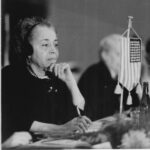 Louise Alone Thompson Patterson, a social activist and college professor, is born in Chicago, Illinois. Thompson was acquainted with many of the leading literary figures during the Harlem Renaissance of the 1920s and 1930s, spending most of her life involved in civil rights. Thompson Patterson is also known as one of the first black women to be enrolled into the University of California at Berkeley, from which she graduated in 1923. She became a professor at the renowned Hampton Institute, a historically Black college (HBCU) in Virginia by age twenty-two and she worked there for five years. Patterson moved to New York to join the burgeoning artistic community in Harlem. When she first went to New York, she pursued social work, but eventually she became a central figure in the literary movement. Learn more.
Louise Alone Thompson Patterson, a social activist and college professor, is born in Chicago, Illinois. Thompson was acquainted with many of the leading literary figures during the Harlem Renaissance of the 1920s and 1930s, spending most of her life involved in civil rights. Thompson Patterson is also known as one of the first black women to be enrolled into the University of California at Berkeley, from which she graduated in 1923. She became a professor at the renowned Hampton Institute, a historically Black college (HBCU) in Virginia by age twenty-two and she worked there for five years. Patterson moved to New York to join the burgeoning artistic community in Harlem. When she first went to New York, she pursued social work, but eventually she became a central figure in the literary movement. Learn more. | |
| September 9, 1924 | 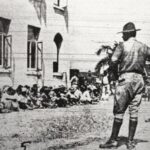 The Hanapēpē Massacre (also called the Battle of Hanapēpē) occurred on September 9, 1924 when an interethnic dispute amongst Filipino strike organizers in Hanapēpē, Kaua'i resulted in a violent exchange between local police officers and Filipinos. The conflict began when two Ilocano (the third largest Filipino ethnolinguistic group) youth, allegedly breaking the Filipino-led labor strike, were detained and harassed by a group of Visayans (the largest Filipino ethnolinguistic group) at the Hanapepe strike camp. When the local police were called to settle the dispute, they arrived with a group of heavily armed special deputies. Upon arrival, the officers issued warrants of arrest for the two detained Illocanos, causing the collection of Filipinos strikers to rally in opposition. Despite previously ridiculing the two Ilocanos, the remaining Filipinos armed themselves and demanded the boys be released. A violent exchange ensued wherein sixteen Filipino laborers and four police officers were left dead. Learn more. The Hanapēpē Massacre (also called the Battle of Hanapēpē) occurred on September 9, 1924 when an interethnic dispute amongst Filipino strike organizers in Hanapēpē, Kaua'i resulted in a violent exchange between local police officers and Filipinos. The conflict began when two Ilocano (the third largest Filipino ethnolinguistic group) youth, allegedly breaking the Filipino-led labor strike, were detained and harassed by a group of Visayans (the largest Filipino ethnolinguistic group) at the Hanapepe strike camp. When the local police were called to settle the dispute, they arrived with a group of heavily armed special deputies. Upon arrival, the officers issued warrants of arrest for the two detained Illocanos, causing the collection of Filipinos strikers to rally in opposition. Despite previously ridiculing the two Ilocanos, the remaining Filipinos armed themselves and demanded the boys be released. A violent exchange ensued wherein sixteen Filipino laborers and four police officers were left dead. Learn more. | |
| September 9, 1957 | 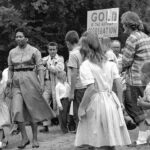 As 19 Black six-year-olds integrated all-white elementary schools in Nashville, Tennessee, white church members, including one local minister, organized a persistent and violent campaign to oppose the integration of Nashville public schools. Outside Fehr Elementary School, one person held a sign that read “God is the author of segregation” and pursued two Black children walking to the school. Outside three different elementary schools that same morning, Fred Stroud—a white minister—sought to dissuade white parents from permitting their children to be educated with Black children, by preaching damnation for those who did not uphold segregation. That evening, 300 white people gathered downtown and continued to threaten Black families who sent their children to school. They strung an effigy in blackface from a stoplight with a note pinned to its chest that read “this could be you.” As the mob grew to at least 400 around Fehr Elementary, white people burned two outbuildings located on the property of a Black family who had sent their daughter to Fehr Elementary and continued to burn crosses on the lawns of Black families who had dared to enroll their students that morning. The next day, 100 sticks of dynamite were thrown into Hattie Cotton Elementary School and exploded. Patricia Watson, the one Black elementary student who had been in class the previous morning, did not return. No Black children returned to Hattie Cotton Elementary School the following year, and no one faced criminal charges for the bombing. Learn more. As 19 Black six-year-olds integrated all-white elementary schools in Nashville, Tennessee, white church members, including one local minister, organized a persistent and violent campaign to oppose the integration of Nashville public schools. Outside Fehr Elementary School, one person held a sign that read “God is the author of segregation” and pursued two Black children walking to the school. Outside three different elementary schools that same morning, Fred Stroud—a white minister—sought to dissuade white parents from permitting their children to be educated with Black children, by preaching damnation for those who did not uphold segregation. That evening, 300 white people gathered downtown and continued to threaten Black families who sent their children to school. They strung an effigy in blackface from a stoplight with a note pinned to its chest that read “this could be you.” As the mob grew to at least 400 around Fehr Elementary, white people burned two outbuildings located on the property of a Black family who had sent their daughter to Fehr Elementary and continued to burn crosses on the lawns of Black families who had dared to enroll their students that morning. The next day, 100 sticks of dynamite were thrown into Hattie Cotton Elementary School and exploded. Patricia Watson, the one Black elementary student who had been in class the previous morning, did not return. No Black children returned to Hattie Cotton Elementary School the following year, and no one faced criminal charges for the bombing. Learn more. | |
| September 9, 1962 | 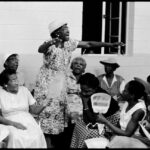 A Black church is burned to the ground near Sasser, Georgia. A pre-dawn Sunday phone call awakened Student Non-violent Coordinating Committee (SNCC) organizers and informed them that the Mt. Olive Baptist Church, the primary site for Terrell County’s mass meetings, was on fire.Prathia Hall and other SNCC activists dressed quickly and rushed to the church where no firefighters were on sight. With fear and shock, they watched the church burn to the ground. Members of the congregation and the community sobbed uncontrollably as they tried to console each other. Shady Grove Baptist Church–the former meeting place–had been burned to the ground the previous month, as would the home of Trim Porter in December 1962, which was the site for SNCC meetings after both Shady Grove and Mt. Olive were burned to the ground. Black leaders asked President Kennedy to take actions to stop the "Nazi-like reign of terror in southwest Georgia." Learn more. A Black church is burned to the ground near Sasser, Georgia. A pre-dawn Sunday phone call awakened Student Non-violent Coordinating Committee (SNCC) organizers and informed them that the Mt. Olive Baptist Church, the primary site for Terrell County’s mass meetings, was on fire.Prathia Hall and other SNCC activists dressed quickly and rushed to the church where no firefighters were on sight. With fear and shock, they watched the church burn to the ground. Members of the congregation and the community sobbed uncontrollably as they tried to console each other. Shady Grove Baptist Church–the former meeting place–had been burned to the ground the previous month, as would the home of Trim Porter in December 1962, which was the site for SNCC meetings after both Shady Grove and Mt. Olive were burned to the ground. Black leaders asked President Kennedy to take actions to stop the "Nazi-like reign of terror in southwest Georgia." Learn more. | |
| September 10, 1847 | 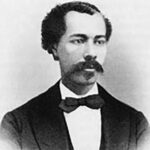 John Roy Lynch, congressman, soldier, and author is born in Concordia Parish, Louisiana to Patrick Lynch, an Irish immigrant and Catherine White, an enslaved Black woman. Lynch’s father died soon after his birth. Lynch and his mother were then traded to a plantation in Natchez, Mississippi. During the Civil War, Lynch became free when he fled the plantation to serve as a cook for the 49th Illinois Volunteer Regiment. During Reconstruction, Lynch joined the Republican Party in Mississippi. After working as assistant secretary for the Republican State Convention, Lynch became the Justice of the Peace in Natchez County, Mississippi. In November 1869 at the age of 22, Lynch was elected to the Mississippi House of Representatives. Three years later, in 1872 he was named Speaker of the House. Later in 1872, Lynch ran for a seat in the United States House of Representatives. He was elected, winning more than fifty percent of the popular vote. In Congress Lynch was known primarily for his support of a civil rights measure that eventually became the Civil Rights Act of 1875. During his congressional campaign in 1874, Lynch voiced concern for racist white Democrats attacks on black Republicans in Mississippi, a prelude to the bloody Mississippi gubernatorial campaign of 1875 where hundreds of black and white Republicans were killed. Despite those violent tactics which reduced the Republican vote in the state, Lynch managed to be re-elected to Congress in 1874 and 1876. During his third term, however, he was increasingly isolated from the state’s other political leaders, virtually all of whom were white Democrats. Despite intense opposition from Democrats, Lynch was reelected in 1880. Because the Democrats disputed the election, he fought for over a year (half his term) before Congress finally seated him. During his remaining year in Congress, he continued to support civil rights legislation. Lynch was defeated for re-election in 1882 by Natchez judge Henry S. Van Eaton, a Democrat. He ran unsuccessfully for Congress again in 1884 and 1886. In 1884, Lynch was nominated to the honorific position of Temporary Chair of the Republican National Convention held that year in Chicago. Although Lynch periodically practiced law in Chicago, he was increasingly concerned about the negative and inaccurate portrayal of blacks in Reconstruction being generated by white scholars. He became an author and historian to set the record straight. Lynch wrote The Facts of Reconstruction in 1913. He followed his book with articles in the Journal of Negro History in 1917 and 1918. Learn more. John Roy Lynch, congressman, soldier, and author is born in Concordia Parish, Louisiana to Patrick Lynch, an Irish immigrant and Catherine White, an enslaved Black woman. Lynch’s father died soon after his birth. Lynch and his mother were then traded to a plantation in Natchez, Mississippi. During the Civil War, Lynch became free when he fled the plantation to serve as a cook for the 49th Illinois Volunteer Regiment. During Reconstruction, Lynch joined the Republican Party in Mississippi. After working as assistant secretary for the Republican State Convention, Lynch became the Justice of the Peace in Natchez County, Mississippi. In November 1869 at the age of 22, Lynch was elected to the Mississippi House of Representatives. Three years later, in 1872 he was named Speaker of the House. Later in 1872, Lynch ran for a seat in the United States House of Representatives. He was elected, winning more than fifty percent of the popular vote. In Congress Lynch was known primarily for his support of a civil rights measure that eventually became the Civil Rights Act of 1875. During his congressional campaign in 1874, Lynch voiced concern for racist white Democrats attacks on black Republicans in Mississippi, a prelude to the bloody Mississippi gubernatorial campaign of 1875 where hundreds of black and white Republicans were killed. Despite those violent tactics which reduced the Republican vote in the state, Lynch managed to be re-elected to Congress in 1874 and 1876. During his third term, however, he was increasingly isolated from the state’s other political leaders, virtually all of whom were white Democrats. Despite intense opposition from Democrats, Lynch was reelected in 1880. Because the Democrats disputed the election, he fought for over a year (half his term) before Congress finally seated him. During his remaining year in Congress, he continued to support civil rights legislation. Lynch was defeated for re-election in 1882 by Natchez judge Henry S. Van Eaton, a Democrat. He ran unsuccessfully for Congress again in 1884 and 1886. In 1884, Lynch was nominated to the honorific position of Temporary Chair of the Republican National Convention held that year in Chicago. Although Lynch periodically practiced law in Chicago, he was increasingly concerned about the negative and inaccurate portrayal of blacks in Reconstruction being generated by white scholars. He became an author and historian to set the record straight. Lynch wrote The Facts of Reconstruction in 1913. He followed his book with articles in the Journal of Negro History in 1917 and 1918. Learn more. | |
| September 10, 1897 | 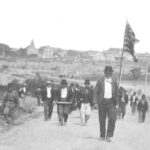 A Luzerne County, Pennsylvania sheriff's posse kills at least 19 unarmed striking immigrant anthracite miners at the Lattimer mine near Hazleton, Pennsylvania, in an incident that has come to be known as the Lattimer Massacre. The miners were mostly of Polish, Slovak, Lithuanian and German ethnicity. In addition to the 19+ that were shot and killed, scores more workers were wounded. The massacre was a turning point in the history of the United Mine Workers(UMW). Learn more. A Luzerne County, Pennsylvania sheriff's posse kills at least 19 unarmed striking immigrant anthracite miners at the Lattimer mine near Hazleton, Pennsylvania, in an incident that has come to be known as the Lattimer Massacre. The miners were mostly of Polish, Slovak, Lithuanian and German ethnicity. In addition to the 19+ that were shot and killed, scores more workers were wounded. The massacre was a turning point in the history of the United Mine Workers(UMW). Learn more. | |
| September 10, 1963 | 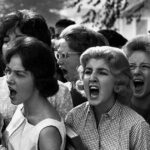 White students begnn to withdraw from the newly-integrated Tuskegee High School in Alabama to avoid attending school with Black students. Within one week, all 275 white students had stopped attending the school. Most of Tuskegee High School's former white students enrolled at Macon Academy, a newly formed, all-white private school. In support of the community's efforts to sidestep federal law and maintain school segregation, Governor Wallace and the school board approved the use of state funds to provide scholarships for white students abandoning the public school system to use at Macon Academy. Meanwhile, the Macon County School Board ordered Tuskegee High School closed due to low enrollment and split its remaining African American students among all-white high schools in the towns of Notasulga and Shorter. White students in those high schools boycotted for several days in protest, and many eventually transferred to Macon Academy. Learn more. White students begnn to withdraw from the newly-integrated Tuskegee High School in Alabama to avoid attending school with Black students. Within one week, all 275 white students had stopped attending the school. Most of Tuskegee High School's former white students enrolled at Macon Academy, a newly formed, all-white private school. In support of the community's efforts to sidestep federal law and maintain school segregation, Governor Wallace and the school board approved the use of state funds to provide scholarships for white students abandoning the public school system to use at Macon Academy. Meanwhile, the Macon County School Board ordered Tuskegee High School closed due to low enrollment and split its remaining African American students among all-white high schools in the towns of Notasulga and Shorter. White students in those high schools boycotted for several days in protest, and many eventually transferred to Macon Academy. Learn more. | |
| September 11, 1851 | 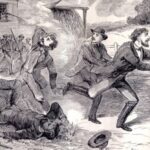 The Christiana Resistance takes place when Southern "slave catchers" and U.S. Marshals, empowered by the 1850 Fugitive Slave Act, attempt to capture and re-enslave Blacks in Christiana, Pennsylvania, and are confronted and driven away by armed locals, including neighbors, former slaves as well as free black and white abolitionists. Later the Marshals returned with three detachments of US Marines and arrested thirty-eight men, including four white Quakers. They were all charged with treason. The first man brought to trial, the Quaker Castner Hanway—erroneously thought to be the leader of the anti-slavery men—was acquitted. Since authorities thought this was the strongest case, they released the other 37 men. The acquittal of all of the defendants was hailed by Northern abolitionists as a major victory against slavery and especially against the Fugitive Slave Act. Learn more. The Christiana Resistance takes place when Southern "slave catchers" and U.S. Marshals, empowered by the 1850 Fugitive Slave Act, attempt to capture and re-enslave Blacks in Christiana, Pennsylvania, and are confronted and driven away by armed locals, including neighbors, former slaves as well as free black and white abolitionists. Later the Marshals returned with three detachments of US Marines and arrested thirty-eight men, including four white Quakers. They were all charged with treason. The first man brought to trial, the Quaker Castner Hanway—erroneously thought to be the leader of the anti-slavery men—was acquitted. Since authorities thought this was the strongest case, they released the other 37 men. The acquittal of all of the defendants was hailed by Northern abolitionists as a major victory against slavery and especially against the Fugitive Slave Act. Learn more. | |
| September 11, 1895 | 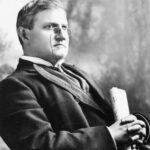 South Carolina officials rewrite the state constitution with the express purpose of disenfranchising the state’s African American voters and restoring white supremacy in all matters political. The convention’s most prominent figure was Benjamin Tillman, a senator and former governor affectionately nicknamed “Pitchfork Ben." A renowned orator, Tillman spoke at great length during the convention. "[A]ll that is necessary to bring about chaos," he warned the convention delegates, "is for a sufficient number of white men, actuated by hate, or ambition, or from any unpatriotic motive, to climb up and cut it loose, mobilize and register the negroes, lead them and give them a free vote and fair count under manhood suffrage." The delegates followed Ben Tillman's guidance and enacted a constitution that effectively disenfranchised Black residents, with little federal interference, for nearly 70 years. Today, a statue of Tillman stands in front of the South Carolina State House and his name adorns a number of buildings throughout the state—including the main building on the campus of Clemson University. Learn more. South Carolina officials rewrite the state constitution with the express purpose of disenfranchising the state’s African American voters and restoring white supremacy in all matters political. The convention’s most prominent figure was Benjamin Tillman, a senator and former governor affectionately nicknamed “Pitchfork Ben." A renowned orator, Tillman spoke at great length during the convention. "[A]ll that is necessary to bring about chaos," he warned the convention delegates, "is for a sufficient number of white men, actuated by hate, or ambition, or from any unpatriotic motive, to climb up and cut it loose, mobilize and register the negroes, lead them and give them a free vote and fair count under manhood suffrage." The delegates followed Ben Tillman's guidance and enacted a constitution that effectively disenfranchised Black residents, with little federal interference, for nearly 70 years. Today, a statue of Tillman stands in front of the South Carolina State House and his name adorns a number of buildings throughout the state—including the main building on the campus of Clemson University. Learn more. | |
| September 11, 2001 |  Godwin Ajala, the only Nigerian listed among the nearly 3,000 people who died because of the 9/11 attack, becomes a U.S. national hero as he fights and ultimately dies saving the lives of countless people as they escaped from the World Trade Center Towers. Ajala had became a lawyer in his native Nigeria. In 1995, Ajala emigrated to the United States to make a better life for himself and his family. When he first arrived in the U.S Ajala bounced between poorly paid jobs but eventually obtained a steady position as a security guard or Access Control Officer at the New York World Trade Center towers at the Concourse (ground floor) level. In this position, Ajala rode elevators and walked floors of the 110-story tower at Two World Trade Center, helping secure the building and attending to small emergencies. On the day of the attack, Ajala demonstrated his self-sacrificing character when, instead of running to save his own life, he helped to evacuate thousands of people from a street-level security post inside the lobby of Two World Trade Center when the second plane hit the building. He held the door open for people running out, and repeatedly went back inside to guide more people out of the blazing structure. Exhausted after helping to guide many out of the attacked building, Ajala reportedly first went into a coma and died the following Sunday. Learn more. Godwin Ajala, the only Nigerian listed among the nearly 3,000 people who died because of the 9/11 attack, becomes a U.S. national hero as he fights and ultimately dies saving the lives of countless people as they escaped from the World Trade Center Towers. Ajala had became a lawyer in his native Nigeria. In 1995, Ajala emigrated to the United States to make a better life for himself and his family. When he first arrived in the U.S Ajala bounced between poorly paid jobs but eventually obtained a steady position as a security guard or Access Control Officer at the New York World Trade Center towers at the Concourse (ground floor) level. In this position, Ajala rode elevators and walked floors of the 110-story tower at Two World Trade Center, helping secure the building and attending to small emergencies. On the day of the attack, Ajala demonstrated his self-sacrificing character when, instead of running to save his own life, he helped to evacuate thousands of people from a street-level security post inside the lobby of Two World Trade Center when the second plane hit the building. He held the door open for people running out, and repeatedly went back inside to guide more people out of the blazing structure. Exhausted after helping to guide many out of the attacked building, Ajala reportedly first went into a coma and died the following Sunday. Learn more. | |
| September 11, 2001 |  LeRoy Homer Jr. is among the nearly 3,000 killed by terrorists in the 9/11 attacks. Homer joined the Air Force and after graduating from the Air Force Academy in Colorado Springs, Colorado, and served as a pilot in both the Desert Shield and Desert Storm military operations in the Middle East and later flew aircraft in humanitarian operations in Somalia. Homer served seven years on active duty in the Air Force, eventually becoming a Captain before switching into the reserves, where he rose to the rank of Major. Homer’s life was tragically cut short at the age of 36 when his hijacked plane crashed. Homer was co-piloting United Airlines Flight #93 from Newark, New Jersey to San Francisco, California when four terrorists hidden among the 37 passengers hijacked the plane. It is believed that this particular plane was headed for the United States Capitol, but the plane’s difficult auto-pilot system prevented that. Homer and Captain Jason Dahl were overpowered when the terrorists rushed the plane’s cockpit but it is believed they were not immediately killed as the flight recorder indicated that the terrorists gave orders to groaning men who were on the floor. It is unknown if they died before or during the crash of Flight 93. What is known is that members of the crew and passengers attempted to rush the cockpit to regain control of the plane. Their actions prevented the jet liner from reaching its intended target in Washington, D.C. Flight 93 crashed into a field near Shanksville, Pennsylvania killing all the remaining people on board. LeRoy Homer’s widow, Melodie, created the LeRoy Homer Foundation in 2002, which provides financial support for young people seeking a profession in aviation. Learn more. LeRoy Homer Jr. is among the nearly 3,000 killed by terrorists in the 9/11 attacks. Homer joined the Air Force and after graduating from the Air Force Academy in Colorado Springs, Colorado, and served as a pilot in both the Desert Shield and Desert Storm military operations in the Middle East and later flew aircraft in humanitarian operations in Somalia. Homer served seven years on active duty in the Air Force, eventually becoming a Captain before switching into the reserves, where he rose to the rank of Major. Homer’s life was tragically cut short at the age of 36 when his hijacked plane crashed. Homer was co-piloting United Airlines Flight #93 from Newark, New Jersey to San Francisco, California when four terrorists hidden among the 37 passengers hijacked the plane. It is believed that this particular plane was headed for the United States Capitol, but the plane’s difficult auto-pilot system prevented that. Homer and Captain Jason Dahl were overpowered when the terrorists rushed the plane’s cockpit but it is believed they were not immediately killed as the flight recorder indicated that the terrorists gave orders to groaning men who were on the floor. It is unknown if they died before or during the crash of Flight 93. What is known is that members of the crew and passengers attempted to rush the cockpit to regain control of the plane. Their actions prevented the jet liner from reaching its intended target in Washington, D.C. Flight 93 crashed into a field near Shanksville, Pennsylvania killing all the remaining people on board. LeRoy Homer’s widow, Melodie, created the LeRoy Homer Foundation in 2002, which provides financial support for young people seeking a profession in aviation. Learn more. | |
| September 12, 1873 | 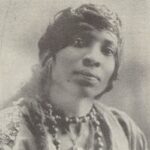 Madame Sul-Te-Wan is born as Nellie Conley in Louisville, Kentucky where her widowed mother worked as a laundress. Madame Sul-Te-Wan was a pioneering stage and film actress who became one of the most prominent black performers in Hollywood during the silent film era. Her career spanned more than seventy years and she is best known as the first African American actress contracted to appear in D.W. Griffith’s groundbreaking and racist cinematic epic, Birth of a Nation (1915). Prior to her film career, Madame Sul-Te-Wan worked in dance troupes and theater companies throughout the East and Midwest billed as “Creole Nell.” She later formed her own musical performing company, The Black Four Hundred. She reconstituted the group as the Rair Back Minstrels and toured the East Coast to great acclaim. When Birth of a Nation was completed, Madam Sul-Te-Wan was discharged from Griffiths’ film company for “allegedly stealing a book from a white actress and inciting blacks to protest the film’s showing in the Los Angeles area.” Hiring prominent African American attorney E. Burton Ceruti, she successfully defended herself against the charges and was reinstated in the company. She continued to work in film until her death at the Motion Picture Country Home in Woodland Hills on February 1, 1959. Learn more. Madame Sul-Te-Wan is born as Nellie Conley in Louisville, Kentucky where her widowed mother worked as a laundress. Madame Sul-Te-Wan was a pioneering stage and film actress who became one of the most prominent black performers in Hollywood during the silent film era. Her career spanned more than seventy years and she is best known as the first African American actress contracted to appear in D.W. Griffith’s groundbreaking and racist cinematic epic, Birth of a Nation (1915). Prior to her film career, Madame Sul-Te-Wan worked in dance troupes and theater companies throughout the East and Midwest billed as “Creole Nell.” She later formed her own musical performing company, The Black Four Hundred. She reconstituted the group as the Rair Back Minstrels and toured the East Coast to great acclaim. When Birth of a Nation was completed, Madam Sul-Te-Wan was discharged from Griffiths’ film company for “allegedly stealing a book from a white actress and inciting blacks to protest the film’s showing in the Los Angeles area.” Hiring prominent African American attorney E. Burton Ceruti, she successfully defended herself against the charges and was reinstated in the company. She continued to work in film until her death at the Motion Picture Country Home in Woodland Hills on February 1, 1959. Learn more. | |
| September 12, 1935 |  Richard Howard Hunt, one of the foremost African-American abstract sculptors, artists of public sculpture, and first African American sculptor to have a major retrospective at Museum of Modern Art, is born on Chicago's South Side. Descended from enslaved African Americans, Hunt was interested in the arts from an early age, as his mother, an artist and librarian, would bring him to performances by local opera companies that sang classical repertoires of Mozart, Rossini, Verdi, and Handel. As a young boy, Hunt began to show enthusiasm and talent in artistic disciplines such as drawing and painting, and also sculpture, an interest that grew more and more as he got older. Hunt was inspired to pursue his career in the arts because his family appreciated art and he clearly said "My mom was supportive and dad was tolerant." In the seventh grade, Hunt attended the Junior School of Art Institute of Chicago. Hunt also acquired business sense and awareness of social issues from working in his father's barbershop. In 1953 Hunt entered the School of the Art Institute of Chicago. Hunt worked with materials of copper, iron and then steel and aluminum which led to him to produce a series of "hybrid figures" which where references to human, animal and plant forms. Hunt began exhibiting his sculptures nationwide while still a student at the School of the Art Institute of Chicago. As a Junior, his piece “Arachne,” was purchased by the Museum of Modern Art in New York. He received a B.A.E. from the Art Institute of Chicago in 1957. He became the youngest exhibiting artist at the 1962 Seattle World's Fair. Hunt has created over 150 public sculpture commissions in prominent locations in 22 states across the United States, more than any other sculptor. With a career that spans seven decades, Hunt has held over 100 solo exhibitions and is represented in more than 100 public museums. Hunt has served on the Smithsonian Institution's National Board of Directors. Hunt's abstract, modern and contemporary sculpture work is notable for its presence in exhibitions and public displays as early as the 1950s, despite social pressures for the obstruction of African-American art at the time. Learn more. Richard Howard Hunt, one of the foremost African-American abstract sculptors, artists of public sculpture, and first African American sculptor to have a major retrospective at Museum of Modern Art, is born on Chicago's South Side. Descended from enslaved African Americans, Hunt was interested in the arts from an early age, as his mother, an artist and librarian, would bring him to performances by local opera companies that sang classical repertoires of Mozart, Rossini, Verdi, and Handel. As a young boy, Hunt began to show enthusiasm and talent in artistic disciplines such as drawing and painting, and also sculpture, an interest that grew more and more as he got older. Hunt was inspired to pursue his career in the arts because his family appreciated art and he clearly said "My mom was supportive and dad was tolerant." In the seventh grade, Hunt attended the Junior School of Art Institute of Chicago. Hunt also acquired business sense and awareness of social issues from working in his father's barbershop. In 1953 Hunt entered the School of the Art Institute of Chicago. Hunt worked with materials of copper, iron and then steel and aluminum which led to him to produce a series of "hybrid figures" which where references to human, animal and plant forms. Hunt began exhibiting his sculptures nationwide while still a student at the School of the Art Institute of Chicago. As a Junior, his piece “Arachne,” was purchased by the Museum of Modern Art in New York. He received a B.A.E. from the Art Institute of Chicago in 1957. He became the youngest exhibiting artist at the 1962 Seattle World's Fair. Hunt has created over 150 public sculpture commissions in prominent locations in 22 states across the United States, more than any other sculptor. With a career that spans seven decades, Hunt has held over 100 solo exhibitions and is represented in more than 100 public museums. Hunt has served on the Smithsonian Institution's National Board of Directors. Hunt's abstract, modern and contemporary sculpture work is notable for its presence in exhibitions and public displays as early as the 1950s, despite social pressures for the obstruction of African-American art at the time. Learn more. | |
| September 12, 1966 | 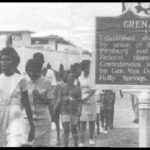 Two hundred fifty African American students attempt to integrate Grenada, Mississippi, schools on the first day of class. Though it was 12 years after the Supreme Court's landmark Brown v. Board of Education ruling held racially-segregated public schooling unconstitutional, the city of Grenada, Mississippi, had not stopped operating a segregated school system. In August 1966, a federal judge ordered Grenada officials to enroll African American students in the formerly white-only schools, and approximately 450 Black students had enrolled by the start of the 1966 school year, but 200 Black families were intimidated by threats of eviction or firing into withdrawing their children. When the remaining 250 Black students arrived for classes on September 12, a large white mob surrounded the school and turned them away. As the students retreated, members of the mob pursued them through the streets, beating them with chains, pipes, and clubs. At lunchtime, the mob returned to the school to attack the few African American students who had made it inside that morning. As the students left for lunch, members of the mob attacked them, leaving some hospitalized with broken bones. Some reporters covering the story were also beaten. The mob violence continued for several days with no intervention from law enforcement. On September 16, a federal judge ordered protection for the students, and on September 17, 13 members of the mob were arrested by the FBI. Learn more. Two hundred fifty African American students attempt to integrate Grenada, Mississippi, schools on the first day of class. Though it was 12 years after the Supreme Court's landmark Brown v. Board of Education ruling held racially-segregated public schooling unconstitutional, the city of Grenada, Mississippi, had not stopped operating a segregated school system. In August 1966, a federal judge ordered Grenada officials to enroll African American students in the formerly white-only schools, and approximately 450 Black students had enrolled by the start of the 1966 school year, but 200 Black families were intimidated by threats of eviction or firing into withdrawing their children. When the remaining 250 Black students arrived for classes on September 12, a large white mob surrounded the school and turned them away. As the students retreated, members of the mob pursued them through the streets, beating them with chains, pipes, and clubs. At lunchtime, the mob returned to the school to attack the few African American students who had made it inside that morning. As the students left for lunch, members of the mob attacked them, leaving some hospitalized with broken bones. Some reporters covering the story were also beaten. The mob violence continued for several days with no intervention from law enforcement. On September 16, a federal judge ordered protection for the students, and on September 17, 13 members of the mob were arrested by the FBI. Learn more. | |
| September 12, 1973 |  Tarana Burke, the activist who sparked the Me Too movement that raises awareness about sexual harassment, assault, and abuse, is born in The Bronx, New York. Burke had many troubling experiences growing up in a low-income, working-class family. She was raped and sexually assaulted as a teenager. These incidents inspired Burke to dedicate her life to improving the lives of girls going through similar hardships. Burke’s career started in Selma, Alabama where she worked with the 21st Century Youth Leadership Movement, the Black Belt Arts and Cultural Center, and the National Voting Rights Museum & Institute. In 2003, Burke co-founded an African-centered rites of passage program for girls called Jendayi Aza. The program eventually evolved and in 2006 it became a non-profit called Just Be Incorporated that focused on the well-being of young women of color. It was when she was working at this organization that Burke first spoke the words “me too” when trying to empathize with a young woman who was at the time being abused by her mother’s boyfriend. On October 15, 2017, actress Alyssa Milano, inspired by Burke’s words, posted a tweet that said “If you’ve been sexually harassed or assaulted write ‘me too’ as a reply to tweet.” The hashtag #MeToo went viral and encouraged women and men to speak out about their past experiences of sexual abuse. In 2017, Burke along with her fellow activists were named the “silence breakers” and were awarded Time magazine’s Person of the Year. Learn more. Tarana Burke, the activist who sparked the Me Too movement that raises awareness about sexual harassment, assault, and abuse, is born in The Bronx, New York. Burke had many troubling experiences growing up in a low-income, working-class family. She was raped and sexually assaulted as a teenager. These incidents inspired Burke to dedicate her life to improving the lives of girls going through similar hardships. Burke’s career started in Selma, Alabama where she worked with the 21st Century Youth Leadership Movement, the Black Belt Arts and Cultural Center, and the National Voting Rights Museum & Institute. In 2003, Burke co-founded an African-centered rites of passage program for girls called Jendayi Aza. The program eventually evolved and in 2006 it became a non-profit called Just Be Incorporated that focused on the well-being of young women of color. It was when she was working at this organization that Burke first spoke the words “me too” when trying to empathize with a young woman who was at the time being abused by her mother’s boyfriend. On October 15, 2017, actress Alyssa Milano, inspired by Burke’s words, posted a tweet that said “If you’ve been sexually harassed or assaulted write ‘me too’ as a reply to tweet.” The hashtag #MeToo went viral and encouraged women and men to speak out about their past experiences of sexual abuse. In 2017, Burke along with her fellow activists were named the “silence breakers” and were awarded Time magazine’s Person of the Year. Learn more. | |
| September 13, 1858 | 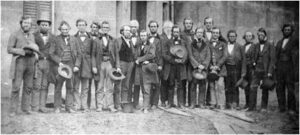 Oberlin, Ohio abolitionist neighbors of African American John Price, who had escaped enslavement in Kentucky two years before, successfully stage the Oberlin-Wellington Rescue to free Price from the custody of slave-catchers at Wadsworth House hotel in Wellington, Ohio, where they had stopped on their way back to Kentucky. Future Oberlin College President James Fairchild harbored Price in his home until Price’s escape to Canada was secured. Thirty-seven of the individuals involved in the rescue were arrested for violating the Fugitive Slave Law. Simon Bushnell and Charles Langston were the first to be put on trial, with abolitionists Rufus Spalding and Albert Riddle serving as their attorneys. Bushnell and Langston were convicted and sentenced to prison. In an act of solidarity, the remaining defendants chose to remain in jail as they awaited trail. Popular opinion was on their side, with dozens of rousing pro-abolition speeches in and around the courthouse, antislavery tracts and a newspaper called The Rescuer published from inside the prison. Eventually the slave-catchers were arrested and charged with kidnapping. In a plea bargain to drop kidnapping charges against them, the slave-catchers allowed for the release of the abolitionists still in prison. By July 7, most of the rescuers had returned to Oberlin “amid great celebration.” Bushnell, the last of the imprisoned rescuers, returned to a jubilant crowd on July 11, 1859. Learn more. Oberlin, Ohio abolitionist neighbors of African American John Price, who had escaped enslavement in Kentucky two years before, successfully stage the Oberlin-Wellington Rescue to free Price from the custody of slave-catchers at Wadsworth House hotel in Wellington, Ohio, where they had stopped on their way back to Kentucky. Future Oberlin College President James Fairchild harbored Price in his home until Price’s escape to Canada was secured. Thirty-seven of the individuals involved in the rescue were arrested for violating the Fugitive Slave Law. Simon Bushnell and Charles Langston were the first to be put on trial, with abolitionists Rufus Spalding and Albert Riddle serving as their attorneys. Bushnell and Langston were convicted and sentenced to prison. In an act of solidarity, the remaining defendants chose to remain in jail as they awaited trail. Popular opinion was on their side, with dozens of rousing pro-abolition speeches in and around the courthouse, antislavery tracts and a newspaper called The Rescuer published from inside the prison. Eventually the slave-catchers were arrested and charged with kidnapping. In a plea bargain to drop kidnapping charges against them, the slave-catchers allowed for the release of the abolitionists still in prison. By July 7, most of the rescuers had returned to Oberlin “amid great celebration.” Bushnell, the last of the imprisoned rescuers, returned to a jubilant crowd on July 11, 1859. Learn more. | |
| September 13, 1885 | 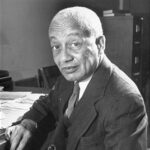 Writer, philosopher, educator, and patron of the arts Alain Locke (born Arthur Leroy Locke) is born in Philadelphia, Pennsylvania, on September 13, 1885, the only child of Pliny Ishmael Locke (1850–1892) and Mary (née Hawkins) Locke (1853–1922), both of whom were descended from prominent families of free blacks. Locke's father Ishmael was the first black employee of the U.S. Postal Service, and his paternal grandfather taught at Philadelphia's Institute for Colored Youth. Locke's mother Mary was a teacher and inspired Locke's passion for education and literature. Mary's grandfather, Charles Shorter, fought as a soldier and was a hero in the War of 1812. In 1907, Locke graduated from Harvard University with degrees in English and philosophy; he was honored as a member of the Phi Beta Kappa Society and recipient of the Bowdoin prize. Locke was distinguished in 1907 as the first African-American Rhodes Scholar. On arriving at Oxford, Locke was denied admission to several colleges and several American Rhodes Scholars from the South refused to live in the same college or attend events with Locke. He was finally admitted to Hertford College, where he studied literature, philosophy, Greek, and Latin, from 1907–1910. Alongside his friend and fellow student Pixley ka Isaka Seme, he was part of the Oxford Cosmopolitan Club, contributing to its first publication. In 1910, he attended the University of Berlin, where he studied philosophy. Locke later became known as the philosophical architect —the acknowledged "Dean"— of the Harlem Renaissance. A homosexual, Locke encouraged and supported other gay African Americans who were part of the Harlem Renaissance; given the discriminatory laws against homosexuality, Locke not fully open about his orientation, and referred to his sexuality as a point of "vulnerable/invulnerability", representing an area of both risk and strength. Locke is frequently included in listings of influential African Americans. On March 19, 1968, the Rev. Dr. Martin Luther King Jr. proclaimed: "We're going to let our children know that the only philosophers that lived were not Plato and Aristotle, but W. E. B. Du Bois and Alain Locke came through the universe." Learn more. Writer, philosopher, educator, and patron of the arts Alain Locke (born Arthur Leroy Locke) is born in Philadelphia, Pennsylvania, on September 13, 1885, the only child of Pliny Ishmael Locke (1850–1892) and Mary (née Hawkins) Locke (1853–1922), both of whom were descended from prominent families of free blacks. Locke's father Ishmael was the first black employee of the U.S. Postal Service, and his paternal grandfather taught at Philadelphia's Institute for Colored Youth. Locke's mother Mary was a teacher and inspired Locke's passion for education and literature. Mary's grandfather, Charles Shorter, fought as a soldier and was a hero in the War of 1812. In 1907, Locke graduated from Harvard University with degrees in English and philosophy; he was honored as a member of the Phi Beta Kappa Society and recipient of the Bowdoin prize. Locke was distinguished in 1907 as the first African-American Rhodes Scholar. On arriving at Oxford, Locke was denied admission to several colleges and several American Rhodes Scholars from the South refused to live in the same college or attend events with Locke. He was finally admitted to Hertford College, where he studied literature, philosophy, Greek, and Latin, from 1907–1910. Alongside his friend and fellow student Pixley ka Isaka Seme, he was part of the Oxford Cosmopolitan Club, contributing to its first publication. In 1910, he attended the University of Berlin, where he studied philosophy. Locke later became known as the philosophical architect —the acknowledged "Dean"— of the Harlem Renaissance. A homosexual, Locke encouraged and supported other gay African Americans who were part of the Harlem Renaissance; given the discriminatory laws against homosexuality, Locke not fully open about his orientation, and referred to his sexuality as a point of "vulnerable/invulnerability", representing an area of both risk and strength. Locke is frequently included in listings of influential African Americans. On March 19, 1968, the Rev. Dr. Martin Luther King Jr. proclaimed: "We're going to let our children know that the only philosophers that lived were not Plato and Aristotle, but W. E. B. Du Bois and Alain Locke came through the universe." Learn more. | |
| September 13, 1907 | 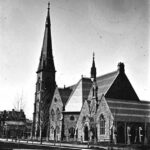 The Michigan Annual Conference of the Methodist Episcopal Church votes against ordaining Black bishops. The vote denied Black clergy leadership positions even within predominantly Black congregations. Delegates expressed concern that Black bishops may eventually lead white congregations and claimed that the "moral inferiority" of Black people required Black preachers to submit to white spiritual leadership. Early Methodists actually supported the abolition of slavery and preached a theology of egalitarianism that resonated with free and enslaved Black people. But white Methodist support for abolition did not last long, especially as Methodism spread across the South. The Methodist church subsequently adopted policies against the ordination of Black clergy, and later embraced an interpretation of the Bible that defended white supremacy and justified enslavement as God-ordained. Learn more. The Michigan Annual Conference of the Methodist Episcopal Church votes against ordaining Black bishops. The vote denied Black clergy leadership positions even within predominantly Black congregations. Delegates expressed concern that Black bishops may eventually lead white congregations and claimed that the "moral inferiority" of Black people required Black preachers to submit to white spiritual leadership. Early Methodists actually supported the abolition of slavery and preached a theology of egalitarianism that resonated with free and enslaved Black people. But white Methodist support for abolition did not last long, especially as Methodism spread across the South. The Methodist church subsequently adopted policies against the ordination of Black clergy, and later embraced an interpretation of the Bible that defended white supremacy and justified enslavement as God-ordained. Learn more. | |
| September 13, 1931 |  Obie Award-winning playwright Adrienne Kennedy is born. She is best known for Funnyhouse of a Negro, which premiered in 1964 and won an Obie Award. She won a lifetime Obie as well. In 2018 she was inducted into the Theater Hall of Fame. Kennedy has been contributing to American theater since the early 1960s, influencing generations of playwrights with her haunting, fragmentary lyrical dramas. Exploring the violence racism brings to people's lives, Kennedy's plays express poetic alienation, transcending the particulars of character and plot through ritualistic repetition and radical structural experimentation. Much of her work explores issues of race, kinship, and violence in American society, and many of her plays are "autobiographically inspired." Kennedy is noted for the use of surrealism in her plays, which are often plotless and symbolic, drawing on mythical, historical, and imaginary figures to depict and explore the African-American experience. In 1969, The New York Times critic Clive Barnes wrote: "While almost every Black playwright in the country is fundamentally concerned with realism—LeRoi Jones and Ed Bullins at times have something different going but even their symbolism is straightforward stuff—Miss Kennedy is weaving some kind of dramatic fabric of poetry." In 1995, critic Michael Feingold of the Village Voice wrote, "with Samuel Beckett gone, Adrienne Kennedy is probably the boldest artist now writing for the theater." She has also written in other genres, including poetry and essays. Learn more. Obie Award-winning playwright Adrienne Kennedy is born. She is best known for Funnyhouse of a Negro, which premiered in 1964 and won an Obie Award. She won a lifetime Obie as well. In 2018 she was inducted into the Theater Hall of Fame. Kennedy has been contributing to American theater since the early 1960s, influencing generations of playwrights with her haunting, fragmentary lyrical dramas. Exploring the violence racism brings to people's lives, Kennedy's plays express poetic alienation, transcending the particulars of character and plot through ritualistic repetition and radical structural experimentation. Much of her work explores issues of race, kinship, and violence in American society, and many of her plays are "autobiographically inspired." Kennedy is noted for the use of surrealism in her plays, which are often plotless and symbolic, drawing on mythical, historical, and imaginary figures to depict and explore the African-American experience. In 1969, The New York Times critic Clive Barnes wrote: "While almost every Black playwright in the country is fundamentally concerned with realism—LeRoi Jones and Ed Bullins at times have something different going but even their symbolism is straightforward stuff—Miss Kennedy is weaving some kind of dramatic fabric of poetry." In 1995, critic Michael Feingold of the Village Voice wrote, "with Samuel Beckett gone, Adrienne Kennedy is probably the boldest artist now writing for the theater." She has also written in other genres, including poetry and essays. Learn more. | |
| September 14, 1874 | 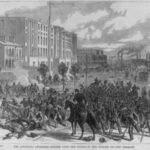 Fifteen-hundred members of the White League—a white supremacist militia composed of Confederate veterans—attack New Orleans and overthrow the elected Louisiana government of pro-Reconstruction Governor William Pitt Kellogg and African American Lieutenant Governor Caesar Carpenter Antoine. White supremacists had begun planning an insurrection shortly after Kellogg and Antoine took office two years before. After cutting the city's telegraph lines and killing at least 13 members of the integrated New Orleans police force, the White League overran the state house and attempted to establish a new government. After three days, President Ulysses S. Grant ordered the U.S. Army to put down the rebellion and the elected government was restored. Though unsuccessful, the attempted coup was emblematic of the political violence that occurred during Reconstruction—and white Southerners' attempts to overthrow elected, integrated governments and restore white supremacy under law foreshadowed a nearing future. Learn more. Fifteen-hundred members of the White League—a white supremacist militia composed of Confederate veterans—attack New Orleans and overthrow the elected Louisiana government of pro-Reconstruction Governor William Pitt Kellogg and African American Lieutenant Governor Caesar Carpenter Antoine. White supremacists had begun planning an insurrection shortly after Kellogg and Antoine took office two years before. After cutting the city's telegraph lines and killing at least 13 members of the integrated New Orleans police force, the White League overran the state house and attempted to establish a new government. After three days, President Ulysses S. Grant ordered the U.S. Army to put down the rebellion and the elected government was restored. Though unsuccessful, the attempted coup was emblematic of the political violence that occurred during Reconstruction—and white Southerners' attempts to overthrow elected, integrated governments and restore white supremacy under law foreshadowed a nearing future. Learn more. | |
| September 14, 1891 | 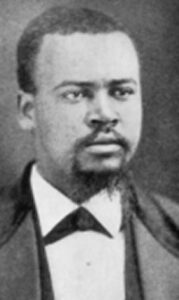 Freedman landowner, farmer, merchant, and former Congressman John Adams Hyman dies at age 51. Hyman was born into slavery in 1840 in Warren County, North Carolina. Hyman’s thirst for knowledge resulted in him being sold away from his family for attempting to read a spelling book that was given to him by a sympathetic white jeweler. He continued to seek knowledge at his new residence in Alabama and was sold again for fear that he would influence other slaves. Hyman was sold eight more times for his attempts to educate himself. At age 25 Hyman was freed by the Thirteenth Amendment and returned to his family in North Carolina. He quickly enrolled in school where he received an elementary education. Hyman also became a landowner and merchant. Hyman, a Mason, soon emerged as a leader of the post-Civil War North Carolina black community. By 1868 John Hyman was an active member of the Republican Party. Despite intimidation attempts by the Ku Klux Klan, Hyman and 132 other Republicans were elected to a constitutional convention which crafted a new constitution for the state of North Carolina. The Constitution called for public education available to all students and voting rights for African American men. Following the 1868 Constitutional Convention Hyman was elected to the North Carolina State Senate from Warren County. He served in the State Senate until 1874. In 1872, Hyman was unsuccessful in a bid to become North Carolina’s first black congressman when he campaigned in the state’s heavily African American Second Congressional District. Learn more. Freedman landowner, farmer, merchant, and former Congressman John Adams Hyman dies at age 51. Hyman was born into slavery in 1840 in Warren County, North Carolina. Hyman’s thirst for knowledge resulted in him being sold away from his family for attempting to read a spelling book that was given to him by a sympathetic white jeweler. He continued to seek knowledge at his new residence in Alabama and was sold again for fear that he would influence other slaves. Hyman was sold eight more times for his attempts to educate himself. At age 25 Hyman was freed by the Thirteenth Amendment and returned to his family in North Carolina. He quickly enrolled in school where he received an elementary education. Hyman also became a landowner and merchant. Hyman, a Mason, soon emerged as a leader of the post-Civil War North Carolina black community. By 1868 John Hyman was an active member of the Republican Party. Despite intimidation attempts by the Ku Klux Klan, Hyman and 132 other Republicans were elected to a constitutional convention which crafted a new constitution for the state of North Carolina. The Constitution called for public education available to all students and voting rights for African American men. Following the 1868 Constitutional Convention Hyman was elected to the North Carolina State Senate from Warren County. He served in the State Senate until 1874. In 1872, Hyman was unsuccessful in a bid to become North Carolina’s first black congressman when he campaigned in the state’s heavily African American Second Congressional District. Learn more. | |
| September 14, 1921 | 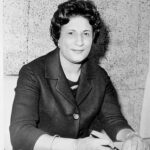 Constance Baker Motley, a key strategist of the civil rights movement, lawyer, judge, state senator, and Borough President of Manhattan, New York City, is born in New Haven, Connecticut. She obtained a role with the NAACP Legal Defense and Educational Fund before entering law school and continued her work as a staff attorney with the organization for more than twenty years. She was the first African American woman to argue before the United States Supreme Court; in total, she argued 12 landmark civil rights cases in front of the Supreme Court, winning nine. She was a law clerk to Thurgood Marshall, aiding him in the case Brown v. Board of Education. Baker Motley was also the first African-American woman appointed to the federal judiciary, serving as a United States District Judge of the United States District Court for the Southern District of New York. Learn more. Constance Baker Motley, a key strategist of the civil rights movement, lawyer, judge, state senator, and Borough President of Manhattan, New York City, is born in New Haven, Connecticut. She obtained a role with the NAACP Legal Defense and Educational Fund before entering law school and continued her work as a staff attorney with the organization for more than twenty years. She was the first African American woman to argue before the United States Supreme Court; in total, she argued 12 landmark civil rights cases in front of the Supreme Court, winning nine. She was a law clerk to Thurgood Marshall, aiding him in the case Brown v. Board of Education. Baker Motley was also the first African-American woman appointed to the federal judiciary, serving as a United States District Judge of the United States District Court for the Southern District of New York. Learn more. | |
| September 15, 1890 | 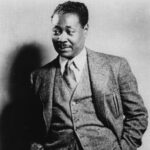 Jamaican-American writer and poet, and a central figure in the Harlem Renaissance, Festus Claudius "Claude" McKay is born in Nairne Castle near James Hill in upper Clarendon Parish, Jamaica. McKay first traveled to the United States to attend college, and encountered W.E.B. Du Bois’s The Souls of Black Folk which stimulated McKay’s interest in political involvement. He moved to New York City in 1914 and in 1919 wrote "If We Must Die", one of his best known works, a widely reprinted sonnet responding to the wave of white-on-black race riots and lynchings following the conclusion of the First World War. A poet from the first, he also wrote five novels and a novella: Home to Harlem (1928), a best-seller that won the Harmon Gold Award for Literature; Banjo (1929); Banana Bottom (1933); Romance in Marseille (written in 1933, published in 2020), a novella, Harlem Glory (written in 1938-1940, published in 1990), and in 1941 a novel, Amiable With Big Teeth: A Novel of the Love Affair Between the Communists and the Poor Black Sheep of Harlem, which remained unpublished until 2017. Besides these novels and four published collections of poetry, McKay also authored a collection of short stories, Gingertown (1932); two autobiographical books, A Long Way from Home (1937) and My Green Hills of Jamaica (published posthumously in 1979); and Harlem: Negro Metropolis, (1940) consisting of eleven essays on the contemporary social and political history of Harlem and Manhattan, concerned especially with political, social and labor organizing. His 1922 poetry collection, Harlem Shadows, was among the first books published during the Harlem Renaissance and his novel Home To Harlem was a watershed contribution to its fiction. His Selected Poems was published posthumously, in 1953. His Complete Poems (2004) includes almost ninety pages of poetry written between 1923 and the late 1940s, most of it previously unpublished, a crucial addition to his poetic oeuvre. Learn more. Jamaican-American writer and poet, and a central figure in the Harlem Renaissance, Festus Claudius "Claude" McKay is born in Nairne Castle near James Hill in upper Clarendon Parish, Jamaica. McKay first traveled to the United States to attend college, and encountered W.E.B. Du Bois’s The Souls of Black Folk which stimulated McKay’s interest in political involvement. He moved to New York City in 1914 and in 1919 wrote "If We Must Die", one of his best known works, a widely reprinted sonnet responding to the wave of white-on-black race riots and lynchings following the conclusion of the First World War. A poet from the first, he also wrote five novels and a novella: Home to Harlem (1928), a best-seller that won the Harmon Gold Award for Literature; Banjo (1929); Banana Bottom (1933); Romance in Marseille (written in 1933, published in 2020), a novella, Harlem Glory (written in 1938-1940, published in 1990), and in 1941 a novel, Amiable With Big Teeth: A Novel of the Love Affair Between the Communists and the Poor Black Sheep of Harlem, which remained unpublished until 2017. Besides these novels and four published collections of poetry, McKay also authored a collection of short stories, Gingertown (1932); two autobiographical books, A Long Way from Home (1937) and My Green Hills of Jamaica (published posthumously in 1979); and Harlem: Negro Metropolis, (1940) consisting of eleven essays on the contemporary social and political history of Harlem and Manhattan, concerned especially with political, social and labor organizing. His 1922 poetry collection, Harlem Shadows, was among the first books published during the Harlem Renaissance and his novel Home To Harlem was a watershed contribution to its fiction. His Selected Poems was published posthumously, in 1953. His Complete Poems (2004) includes almost ninety pages of poetry written between 1923 and the late 1940s, most of it previously unpublished, a crucial addition to his poetic oeuvre. Learn more. | |
| September 15, 1935 | 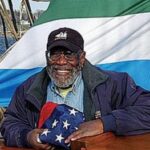 William “Bill” Pinkney, the first African American, and only the fourth person in the world to circumnavigate the globe alone by boat, is born in Chicago, Illinois to Marion Henderson Pinkney and William Pinkney, Sr. He attended Tilden Tech High School in Chicago, and after graduating received training as an x-ray technician. Learn more. William “Bill” Pinkney, the first African American, and only the fourth person in the world to circumnavigate the globe alone by boat, is born in Chicago, Illinois to Marion Henderson Pinkney and William Pinkney, Sr. He attended Tilden Tech High School in Chicago, and after graduating received training as an x-ray technician. Learn more. | |
| September 15, 1945 |  American opera singer and recitalist Jessye Norman is born . She was able to perform dramatic soprano roles, but refused to be limited to that voice type. She was a commanding presence on operatic, concert and recital stages, associated with roles including Beethoven's Leonore, Wagner's Sieglinde and Kundry, Cassandre and Didon by Berlioz and Bartók's Judith. The New York Times music critic Edward Rothstein described her voice as a "grand mansion of sound", and wrote that "it has enormous dimensions, reaching backward and upward. It opens onto unexpected vistas. It contains sunlit rooms, narrow passageways, cavernous halls." Norman trained at Howard University, the Peabody Institute, and the University of Michigan. Her career began in Europe, where she won the ARD International Music Competition in Munich in 1968, which led to a contract with the Deutsche Oper Berlin. Her operatic début came as Elisabeth in Wagner's Tannhäuser, after which she sang as Verdi's Aida at La Scala in Milan. She made her first operatic appearance in the U.S. in 1982 with the Opera Company of Philadelphia, when cast as Jocasta in Stravinsky's Oedipus rex, and as Dido in Purcell's Dido and Aeneas. She went on to sing leading roles with many other companies, including the Metropolitan Opera, the Lyric Opera of Chicago, the Paris Opera, and the Royal Opera, London. She sang at the second inauguration of Ronald Reagan, at Queen Elizabeth II's 60th birthday celebration in 1986, and performed the La Marseillaise to celebrate the 200th anniversary of the French Revolution on July 14, 1989. She sang at the 1996 Summer Olympics opening ceremony in Atlanta and for the second inauguration of Bill Clinton in 1997. Norman sang and recorded recitals of music by Franz Schubert, Johannes Brahms, Richard Strauss, Gustav Mahler, Ernest Chausson and Francis Poulenc, among others. In 1984, she won the Grammy Award for Best Classical Vocal Solo, the first of five Grammy Awards that she would collect during her career. Apart from several honorary doctorates and other awards, she received the Grammy Lifetime Achievement Award, the National Medal of Arts, the Légion d'honneur, and was named a member of the British Royal Academy of Music. In 1990, UN Secretary-General Javier Pérez de Cuéllar named her Honorary Ambassador to the United Nations. Learn more. American opera singer and recitalist Jessye Norman is born . She was able to perform dramatic soprano roles, but refused to be limited to that voice type. She was a commanding presence on operatic, concert and recital stages, associated with roles including Beethoven's Leonore, Wagner's Sieglinde and Kundry, Cassandre and Didon by Berlioz and Bartók's Judith. The New York Times music critic Edward Rothstein described her voice as a "grand mansion of sound", and wrote that "it has enormous dimensions, reaching backward and upward. It opens onto unexpected vistas. It contains sunlit rooms, narrow passageways, cavernous halls." Norman trained at Howard University, the Peabody Institute, and the University of Michigan. Her career began in Europe, where she won the ARD International Music Competition in Munich in 1968, which led to a contract with the Deutsche Oper Berlin. Her operatic début came as Elisabeth in Wagner's Tannhäuser, after which she sang as Verdi's Aida at La Scala in Milan. She made her first operatic appearance in the U.S. in 1982 with the Opera Company of Philadelphia, when cast as Jocasta in Stravinsky's Oedipus rex, and as Dido in Purcell's Dido and Aeneas. She went on to sing leading roles with many other companies, including the Metropolitan Opera, the Lyric Opera of Chicago, the Paris Opera, and the Royal Opera, London. She sang at the second inauguration of Ronald Reagan, at Queen Elizabeth II's 60th birthday celebration in 1986, and performed the La Marseillaise to celebrate the 200th anniversary of the French Revolution on July 14, 1989. She sang at the 1996 Summer Olympics opening ceremony in Atlanta and for the second inauguration of Bill Clinton in 1997. Norman sang and recorded recitals of music by Franz Schubert, Johannes Brahms, Richard Strauss, Gustav Mahler, Ernest Chausson and Francis Poulenc, among others. In 1984, she won the Grammy Award for Best Classical Vocal Solo, the first of five Grammy Awards that she would collect during her career. Apart from several honorary doctorates and other awards, she received the Grammy Lifetime Achievement Award, the National Medal of Arts, the Légion d'honneur, and was named a member of the British Royal Academy of Music. In 1990, UN Secretary-General Javier Pérez de Cuéllar named her Honorary Ambassador to the United Nations. Learn more. | |
| September 15, 1963 | 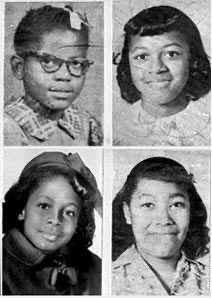 Four young Black girls are killed in the bombing of the Sixteenth Street Baptist Church, the largest Black church in Birmingham, Alabama, and a meeting place for civil rights activities. A white man was seen placing a box under the steps of the church during Sunday services. Shortly afterward, the explosives inside detonated, devastating the church building and the 400 congregants inside. Parents rushed to the Sunday school classroom to check on their children and soon discovered that four young girls had been killed in the blast: Denise McNair (11), Addie Mae Collins (14), Carole Robertson (14), and Cynthia Wesley (14). More than 20 others were injured. Immediately after the bombing, violence surged throughout the city as police clashed with enraged members of the Black community. Before the day ended, at least two other African American children had been slain: 16-year-old Johnny Robinson was shot by police as he fled down an alley, and 13-year-old Virgil Ware was shot and killed by white youths while riding his bicycle. Learn more. Four young Black girls are killed in the bombing of the Sixteenth Street Baptist Church, the largest Black church in Birmingham, Alabama, and a meeting place for civil rights activities. A white man was seen placing a box under the steps of the church during Sunday services. Shortly afterward, the explosives inside detonated, devastating the church building and the 400 congregants inside. Parents rushed to the Sunday school classroom to check on their children and soon discovered that four young girls had been killed in the blast: Denise McNair (11), Addie Mae Collins (14), Carole Robertson (14), and Cynthia Wesley (14). More than 20 others were injured. Immediately after the bombing, violence surged throughout the city as police clashed with enraged members of the Black community. Before the day ended, at least two other African American children had been slain: 16-year-old Johnny Robinson was shot by police as he fled down an alley, and 13-year-old Virgil Ware was shot and killed by white youths while riding his bicycle. Learn more. | |
| September 15, 1983 | 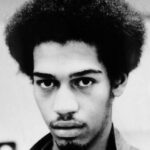 New York City graffiti artist Michael Stewart is brutalized by the city’s transit police during an incident at 2:00 a.m., lapsing into a coma in which he will remain until he dies 13 days later. Stewart was accused of writing on the subway station wall with a felt-tipped marker. One hour later, Stewart arrived at the police station with three arresting officers hogtied, covered in cuts and bruises, and unconscious. Stewart was taken to the hospital in a coma. He died 13 days later, having never regained consciousness. When several students from the Parson’s School of Design reported that they witnessed Stewart’s beating from their dormitories, officers John Kostick, Henry Boerner, and Anthony Piscola were charged with criminally negligent homicide, assault, and perjury. The prosecution brought forward forty-eight witnesses, twenty-three of which were Parson’s students. The defense brought no witnesses forward during the case. Unfortunately, due in part to the conflicting reports of the medical examiners and the inability of the Parson’s students to identify a specific officer, the jury acquitted the officers on both the use of excessive force and official misconduct charges. Stewart’s attorney noted that every person in the courtroom was white. The only person of color was Michael Stewart, and he could no longer speak for himself. One writer famously called Michael Stewart “the man nobody killed.” Learn more. New York City graffiti artist Michael Stewart is brutalized by the city’s transit police during an incident at 2:00 a.m., lapsing into a coma in which he will remain until he dies 13 days later. Stewart was accused of writing on the subway station wall with a felt-tipped marker. One hour later, Stewart arrived at the police station with three arresting officers hogtied, covered in cuts and bruises, and unconscious. Stewart was taken to the hospital in a coma. He died 13 days later, having never regained consciousness. When several students from the Parson’s School of Design reported that they witnessed Stewart’s beating from their dormitories, officers John Kostick, Henry Boerner, and Anthony Piscola were charged with criminally negligent homicide, assault, and perjury. The prosecution brought forward forty-eight witnesses, twenty-three of which were Parson’s students. The defense brought no witnesses forward during the case. Unfortunately, due in part to the conflicting reports of the medical examiners and the inability of the Parson’s students to identify a specific officer, the jury acquitted the officers on both the use of excessive force and official misconduct charges. Stewart’s attorney noted that every person in the courtroom was white. The only person of color was Michael Stewart, and he could no longer speak for himself. One writer famously called Michael Stewart “the man nobody killed.” Learn more. | |
| September 16, 1860 | 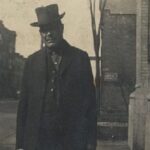 Pioneering showman and filmmaker William D. “Bill” Foster is born. Foster was among the first to prove the commercial viability of making Black-cast films and marketing them to Black audiences. He was the first African American to establish a movie production organization, the Foster Photoplay Company, which he started in Chicago in 1910. Although his company only lasted a few years, Foster managed to rack up a number of firsts that paved the way for the 20th century “race film” industry. Race films were to provide Black audiences with realistic alternatives to demeaning Hollywood stereotypes in the period 1913-1950. Foster's first film was The Railroad Porter (also released as The Pullman Porter), a two-reeler slapstick comedy typical of the time. While the “All-Colored” characters and storyline of The Railroad Porter might not seem vastly different from those of white-produced comedies of the era, Foster’s films focused on gainfully employed respectable characters who were capable of mature romantic relationships, far removed from white-produced films that featured Black characters as watermelon gulpers and chicken thieves. Learn more. Pioneering showman and filmmaker William D. “Bill” Foster is born. Foster was among the first to prove the commercial viability of making Black-cast films and marketing them to Black audiences. He was the first African American to establish a movie production organization, the Foster Photoplay Company, which he started in Chicago in 1910. Although his company only lasted a few years, Foster managed to rack up a number of firsts that paved the way for the 20th century “race film” industry. Race films were to provide Black audiences with realistic alternatives to demeaning Hollywood stereotypes in the period 1913-1950. Foster's first film was The Railroad Porter (also released as The Pullman Porter), a two-reeler slapstick comedy typical of the time. While the “All-Colored” characters and storyline of The Railroad Porter might not seem vastly different from those of white-produced comedies of the era, Foster’s films focused on gainfully employed respectable characters who were capable of mature romantic relationships, far removed from white-produced films that featured Black characters as watermelon gulpers and chicken thieves. Learn more. | |
| September 16, 1861 | 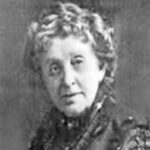 Miriam Elizabeth Benjamin, the second African American woman to receive a patent from the United States government, is born in Charleston, South Carolina. In the early 1870s, her mother, Eliza Hopkins Benjamin, moved the family to Boston, Massachusetts. Benjamin attended high school in Boston before moving to Washington, D.C. in the 1880s. During her time in the city, Benjamin worked as a teacher and in the federal civil service as a government clerk. Benjamin received her first patent for her invention of a gong and signal chair (U.S. Patent number 386,289) in 1888. Benjamin’s invention received attention in the press and was featured in newspapers across the country. She lobbied to have it used as a means to signal pages in the U.S. House of Representatives, for example, and the eventual system installed closely resembled her proposal. The method used to signal flight attendants on airplanes can also be traced to Benjamin’s insight. In 1917, she patented a system to deliver medication via inserts in the sole of a shoe (U.S. Patent Number 1249,000). Benjamin likely also had success as a composer. Music historians believe she (under the pseudonym E.B. Miriam) composed at least two prominent marches. The United States Marine Band under John Philip Sousa performed one piece, “The Boston Elite Two Step,” in the early 1890s. Another composition, “The American Bugle Call,” gained even more attention as the campaign song for the 1904 Presidential Campaign of Theodore Roosevelt. Learn more. Miriam Elizabeth Benjamin, the second African American woman to receive a patent from the United States government, is born in Charleston, South Carolina. In the early 1870s, her mother, Eliza Hopkins Benjamin, moved the family to Boston, Massachusetts. Benjamin attended high school in Boston before moving to Washington, D.C. in the 1880s. During her time in the city, Benjamin worked as a teacher and in the federal civil service as a government clerk. Benjamin received her first patent for her invention of a gong and signal chair (U.S. Patent number 386,289) in 1888. Benjamin’s invention received attention in the press and was featured in newspapers across the country. She lobbied to have it used as a means to signal pages in the U.S. House of Representatives, for example, and the eventual system installed closely resembled her proposal. The method used to signal flight attendants on airplanes can also be traced to Benjamin’s insight. In 1917, she patented a system to deliver medication via inserts in the sole of a shoe (U.S. Patent Number 1249,000). Benjamin likely also had success as a composer. Music historians believe she (under the pseudonym E.B. Miriam) composed at least two prominent marches. The United States Marine Band under John Philip Sousa performed one piece, “The Boston Elite Two Step,” in the early 1890s. Another composition, “The American Bugle Call,” gained even more attention as the campaign song for the 1904 Presidential Campaign of Theodore Roosevelt. Learn more. | |
| September 16, 1920 | 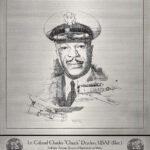 Charles Walter Dryden ("A-Train" Dryden) is born in New York City. Dryden was a U.S. Army Air Force officer and one of the original combat fighter pilot with the 332nd Fighter Group's 99th Fighter Squadron, best known as the Tuskegee Airmen, "Red Tails," or “Schwartze Vogelmenschen” ("Black Birdmen") among enemy German pilots. Among the United States' first eight (8) African American combat fighter pilots, Dryden is notable as a member of the Tuskegee Advance Flying School (TAFS)'s Class Number SE-42-C, the program's 2nd-ever aviation cadet program. Dryden was the first African American U.S. military pilot to engage in aerial combat against an enemy combatant, sharing this honor with 99th Fighter Squadron pilots Sidney P. Brooks, Willie Ashley, Lee Rayford, Leon C. Roberts and Spann Watson. In 1955, Dryden earned his Bachelors of Arts degree in political science from Hofstra University. He also earned a master's of arts degree in public law and government from Columbia University. Dryden served as a director of the Georgia Aviation Hall of Fame which inducted him in 1998. In 1997, Dryden authored his best-selling autobiographical book, "A-Train: Memoirs of a Tuskegee Airman." Learn more. Charles Walter Dryden ("A-Train" Dryden) is born in New York City. Dryden was a U.S. Army Air Force officer and one of the original combat fighter pilot with the 332nd Fighter Group's 99th Fighter Squadron, best known as the Tuskegee Airmen, "Red Tails," or “Schwartze Vogelmenschen” ("Black Birdmen") among enemy German pilots. Among the United States' first eight (8) African American combat fighter pilots, Dryden is notable as a member of the Tuskegee Advance Flying School (TAFS)'s Class Number SE-42-C, the program's 2nd-ever aviation cadet program. Dryden was the first African American U.S. military pilot to engage in aerial combat against an enemy combatant, sharing this honor with 99th Fighter Squadron pilots Sidney P. Brooks, Willie Ashley, Lee Rayford, Leon C. Roberts and Spann Watson. In 1955, Dryden earned his Bachelors of Arts degree in political science from Hofstra University. He also earned a master's of arts degree in public law and government from Columbia University. Dryden served as a director of the Georgia Aviation Hall of Fame which inducted him in 1998. In 1997, Dryden authored his best-selling autobiographical book, "A-Train: Memoirs of a Tuskegee Airman." Learn more. | |
| September 16, 1928 | 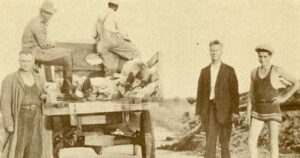 After thousands are killed by a category 4 hurricane, Black victims are denied proper burials in West Palm Beach, Florida. The hurricane destroyed a levee that protected a number of small, low-lying farming communities from the waters of Lake Okeechobee, killing thousands of residents, most of whom were Black migrant farm workers. After the hurricane, Black survivors were forced to recover the bodies of those killed. The officials in charge of the recovery effort ordered that food would be provided only to those who worked, and some who refused to work were shot. Bodies of white storm victims were buried in coffins in local cemeteries, but local authorities had the corpses of Black victims stacked in piles by the side of the roads, doused in fuel oil, and burned. Bodies of 674 Black victims were bulldozed into an unmarked mass grave; the site was later sold for private industrial use—first as a garbage dump, then a slaughterhouse, and then a sewage treatment plant. Learn more. After thousands are killed by a category 4 hurricane, Black victims are denied proper burials in West Palm Beach, Florida. The hurricane destroyed a levee that protected a number of small, low-lying farming communities from the waters of Lake Okeechobee, killing thousands of residents, most of whom were Black migrant farm workers. After the hurricane, Black survivors were forced to recover the bodies of those killed. The officials in charge of the recovery effort ordered that food would be provided only to those who worked, and some who refused to work were shot. Bodies of white storm victims were buried in coffins in local cemeteries, but local authorities had the corpses of Black victims stacked in piles by the side of the roads, doused in fuel oil, and burned. Bodies of 674 Black victims were bulldozed into an unmarked mass grave; the site was later sold for private industrial use—first as a garbage dump, then a slaughterhouse, and then a sewage treatment plant. Learn more. | |
| September 17, 1630 | 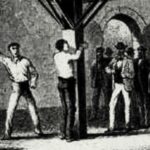 The Virginia Assembly sentences Hugh Davis, a white man, to be whipped for having a relationship with a Black person. According to records, the Assembly asserted that Mr. Davis “abus[ed] himself to the dishonor of God and shame of Christians, by defiling his body in lying with a negro.” Mr. Davis was sentenced to public whipping in front of an audience of Black people, which some historians argue was intended to serve as an example to the Black population. Some evidence suggests that Mr. Davis's partner may have been a Black man, which could have provided additional motivation for the harsh punishment imposed. Learn more. The Virginia Assembly sentences Hugh Davis, a white man, to be whipped for having a relationship with a Black person. According to records, the Assembly asserted that Mr. Davis “abus[ed] himself to the dishonor of God and shame of Christians, by defiling his body in lying with a negro.” Mr. Davis was sentenced to public whipping in front of an audience of Black people, which some historians argue was intended to serve as an example to the Black population. Some evidence suggests that Mr. Davis's partner may have been a Black man, which could have provided additional motivation for the harsh punishment imposed. Learn more. | |
| September 17, 1849 | 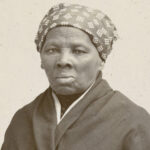 Harriet Tubman, along with two of her brothers, escapes from slavery for the first time. Two weeks later, their enslavers posted a runaway notice in the Cambridge Democrat, offering a reward of up to $100 for each returned escapee. Tubman's brothers feared being captured so decided to return, forcing Tubman to return with them. Soon afterward, Tubman escaped again, this time without her brothers. While her exact route is unknown, Tubman made use of the network known as the Underground Railroad. This informal but well-organized system was composed of free and enslaved Blacks, white abolitionists, and other activists. Most prominent among the latter in Maryland at the time were members of the Religious Society of Friends, often called Quakers. After reaching Philadelphia, Tubman thought of her family. "I was a stranger in a strange land," she said later. "[M]y father, my mother, my brothers, and sisters, and friends were [in Maryland]. But I was free, and they should be free." She worked odd jobs and saved money. Over 11 years, Tubman returned repeatedly to the Eastern Shore of Maryland, rescuing some 70 enslaved people in about 13 expeditions, including her brothers, Henry, Ben, and Robert, their wives and some of their children. She also provided specific instructions to 50 to 60 additional fugitives who escaped to the north. Because of her efforts, she was nicknamed "Moses", alluding to the prophet in the Book of Exodus who led the Hebrews to freedom from Egypt. One of her last missions into Maryland was to retrieve her aging parents. Her father, Ben, had purchased Rit, her mother, in 1855 from Eliza Brodess for $20. But even when they were both free, the area became hostile to their presence. Two years later, Tubman received word that her father was at risk of arrest for harboring a group of eight escaped slaves. She traveled to the Eastern Shore and led them north to St. Catharines, Ontario, where a community of former slaves (including Tubman's brothers, other relatives, and many friends) had gathered. Learn more.
Harriet Tubman, along with two of her brothers, escapes from slavery for the first time. Two weeks later, their enslavers posted a runaway notice in the Cambridge Democrat, offering a reward of up to $100 for each returned escapee. Tubman's brothers feared being captured so decided to return, forcing Tubman to return with them. Soon afterward, Tubman escaped again, this time without her brothers. While her exact route is unknown, Tubman made use of the network known as the Underground Railroad. This informal but well-organized system was composed of free and enslaved Blacks, white abolitionists, and other activists. Most prominent among the latter in Maryland at the time were members of the Religious Society of Friends, often called Quakers. After reaching Philadelphia, Tubman thought of her family. "I was a stranger in a strange land," she said later. "[M]y father, my mother, my brothers, and sisters, and friends were [in Maryland]. But I was free, and they should be free." She worked odd jobs and saved money. Over 11 years, Tubman returned repeatedly to the Eastern Shore of Maryland, rescuing some 70 enslaved people in about 13 expeditions, including her brothers, Henry, Ben, and Robert, their wives and some of their children. She also provided specific instructions to 50 to 60 additional fugitives who escaped to the north. Because of her efforts, she was nicknamed "Moses", alluding to the prophet in the Book of Exodus who led the Hebrews to freedom from Egypt. One of her last missions into Maryland was to retrieve her aging parents. Her father, Ben, had purchased Rit, her mother, in 1855 from Eliza Brodess for $20. But even when they were both free, the area became hostile to their presence. Two years later, Tubman received word that her father was at risk of arrest for harboring a group of eight escaped slaves. She traveled to the Eastern Shore and led them north to St. Catharines, Ontario, where a community of former slaves (including Tubman's brothers, other relatives, and many friends) had gathered. Learn more. | |
| September 17, 1908 | 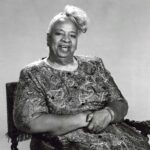 Frances Elizabeth Williams, actress, activist, organizer, and community worker, is born in East Orange, New Jersey. She served on the board of Screen Actors Guild and Actors Equity, and because of her efforts helped open doors for many people of color in the film industry. Learn more. Frances Elizabeth Williams, actress, activist, organizer, and community worker, is born in East Orange, New Jersey. She served on the board of Screen Actors Guild and Actors Equity, and because of her efforts helped open doors for many people of color in the film industry. Learn more. | |
| September 18, 1850 | 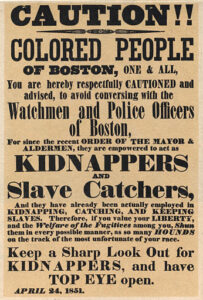 The Fugitive Slave Act or Fugitive Slave Law is passed by the United States Congress as part of the Compromise of 1850 between Southern interests in slavery and Northern Free-Soilers. The Act was one of the most controversial elements of the 1850 compromise and heightened Northern fears of a slave power conspiracy. It required that all escaped slaves, upon capture, be returned to the slaver and that officials and citizens of free states had to cooperate. Abolitionists nicknamed it the "Bloodhound Bill", after the dogs that were used to track down fugitives from slavery. The Act contributed to the growing polarization of the country over the issue of slavery, and is considered one of the causes of the Civil War. It is arguably the most hated and openly violated piece of federal legislation in the nation's history. Learn more. The Fugitive Slave Act or Fugitive Slave Law is passed by the United States Congress as part of the Compromise of 1850 between Southern interests in slavery and Northern Free-Soilers. The Act was one of the most controversial elements of the 1850 compromise and heightened Northern fears of a slave power conspiracy. It required that all escaped slaves, upon capture, be returned to the slaver and that officials and citizens of free states had to cooperate. Abolitionists nicknamed it the "Bloodhound Bill", after the dogs that were used to track down fugitives from slavery. The Act contributed to the growing polarization of the country over the issue of slavery, and is considered one of the causes of the Civil War. It is arguably the most hated and openly violated piece of federal legislation in the nation's history. Learn more. | |
| September 18, 1923 | 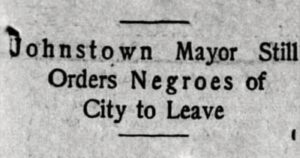 The NAACP and the governor of Pennsylvania publicly denounced remarks by Johnstown, Pennsylvania, Mayor Joseph Cauffiel, who had threatened Black and Mexican migrants, telling them to leave town or risk violence. The denunciations occur after over 2,000 Black or Mexican families had fled Johnstown in fear. No attempt was made to facilitate their return or compensate them for their losses. Such backlash against African Americans and other non-white communities in the North became more prominent in the years following the great migration, during which demographic shifts brought latent tensions to the forefront. Learn more. The NAACP and the governor of Pennsylvania publicly denounced remarks by Johnstown, Pennsylvania, Mayor Joseph Cauffiel, who had threatened Black and Mexican migrants, telling them to leave town or risk violence. The denunciations occur after over 2,000 Black or Mexican families had fled Johnstown in fear. No attempt was made to facilitate their return or compensate them for their losses. Such backlash against African Americans and other non-white communities in the North became more prominent in the years following the great migration, during which demographic shifts brought latent tensions to the forefront. Learn more. | |
| September 18, 1967 | 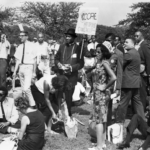 One of the early outbreaks of racial violence in a multi-year series of such incidents erupts in Hartford, Connecticut, when the Black Caucus of North End Hartford led a march to protest housing conditions and neighborhood segregation, in response to the murder of a Black youth by a police officer. They were met by 250 armored policemen before they could reach the South End. Chaos ensued with window breaking, fire setting, looting, and assaults on property, buildings, and cars including police cruisers. Periodic incidents of racial violence would persist for the next two years, while the struggle for racial justice in Hartford and across Connecticut continues to this day. Learn more. One of the early outbreaks of racial violence in a multi-year series of such incidents erupts in Hartford, Connecticut, when the Black Caucus of North End Hartford led a march to protest housing conditions and neighborhood segregation, in response to the murder of a Black youth by a police officer. They were met by 250 armored policemen before they could reach the South End. Chaos ensued with window breaking, fire setting, looting, and assaults on property, buildings, and cars including police cruisers. Periodic incidents of racial violence would persist for the next two years, while the struggle for racial justice in Hartford and across Connecticut continues to this day. Learn more. | |
| September 19, 1865 | 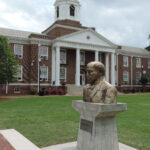 Exactly three months after the end of the Civil War, Atlanta University—now Clark Atlanta University—is founded as the first HBCU (historically Black college or university) in the Southern United States. Atlanta University was the nation's first graduate institution to award degrees to African Americans in the Nation and the first to award bachelor's degrees to African Americans in the South. In 1988, Atlanta University consolidated with Clark College, which had been founded in 1869 as the nation's first four-year liberal arts college to serve African-American students, forming Clark Atlanta University. Learn more. Exactly three months after the end of the Civil War, Atlanta University—now Clark Atlanta University—is founded as the first HBCU (historically Black college or university) in the Southern United States. Atlanta University was the nation's first graduate institution to award degrees to African Americans in the Nation and the first to award bachelor's degrees to African Americans in the South. In 1988, Atlanta University consolidated with Clark College, which had been founded in 1869 as the nation's first four-year liberal arts college to serve African-American students, forming Clark Atlanta University. Learn more. | |
| September 19, 1868 | 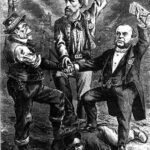 White Georgia Democrats commit the Camilla Massacre, one of the more violent episodes in Reconstruction-era Georgia. In early September, just two months after being readmitted to the Union, the state legislature expelled all thirty-three newly elected Black or mixed-race members because they were at least one-eighth Black. In protest of the expulsions, several hundred Blacks and a few whites marched twenty-five miles from Albany to Camilla, to attend a Republican political rally. As marchers entered the courthouse square in Camilla, whites stationed in various storefronts opened fire, killing at least fifteen and wounding another forty. Hostile whites assaulted the marchers as they retreated for miles beyond the city. The violence at Camilla intimidated some African Americans, who stayed home on election day. White Democrats, then the racial minority in southwest Georgia, carried the election. Learn more. White Georgia Democrats commit the Camilla Massacre, one of the more violent episodes in Reconstruction-era Georgia. In early September, just two months after being readmitted to the Union, the state legislature expelled all thirty-three newly elected Black or mixed-race members because they were at least one-eighth Black. In protest of the expulsions, several hundred Blacks and a few whites marched twenty-five miles from Albany to Camilla, to attend a Republican political rally. As marchers entered the courthouse square in Camilla, whites stationed in various storefronts opened fire, killing at least fifteen and wounding another forty. Hostile whites assaulted the marchers as they retreated for miles beyond the city. The violence at Camilla intimidated some African Americans, who stayed home on election day. White Democrats, then the racial minority in southwest Georgia, carried the election. Learn more. | |
| September 19, 1989 |  Gordon Parks' 1969 film, The Learning Tree, is among the first 25 films selected by the Library of Congress for preservation in the United States National Film Registry for being "culturally, historically, or aesthetically significant," along with films such as, Casablanca, The Wizard of Oz, and Gone With The Wind. The Learning Tree is a coming-of-age drama film written and directed by Parks based on his 1963 semi-autobiographical novel of the same name. It depicts the life of Newt Winger, a teenager growing up in Cherokee Flats, Kansas, in the 1920s, and chronicles his journey into manhood marked with tragic events. It was the first film directed by an African-American person for a major American film studio. Learn more. Gordon Parks' 1969 film, The Learning Tree, is among the first 25 films selected by the Library of Congress for preservation in the United States National Film Registry for being "culturally, historically, or aesthetically significant," along with films such as, Casablanca, The Wizard of Oz, and Gone With The Wind. The Learning Tree is a coming-of-age drama film written and directed by Parks based on his 1963 semi-autobiographical novel of the same name. It depicts the life of Newt Winger, a teenager growing up in Cherokee Flats, Kansas, in the 1920s, and chronicles his journey into manhood marked with tragic events. It was the first film directed by an African-American person for a major American film studio. Learn more. | |
| September 20, 1664 | 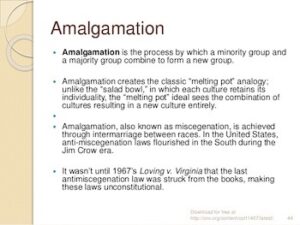 Maryland passes the first Anti-Amalgamation law, which is intended to prevent marriages between Black men and English women. It was an early white-American effort to avoid the intersectionality of gender, color, class, religious identity, nationality and more. Interracial marriage was a fairly common practice during the colonial era among white indentured servants and Black slaves as well as in more aristocratic circles. Subsequently, similar laws were passed in Virginia in 1691, Massachusetts in 1705, North Carolina in 1715, South Carolina in 1717, Delaware in 1721, and Pennsylvania in 1725. Intermarriage bans were lifted during Reconstruction in the early 1870s, but by the end of the decade, mixed marriages were declared void. It wasn't until 1967 with the U.S. Supreme Court's decision in Loving v. Virginia, that all such laws were finally declared null and void nationwide. Learn more. Maryland passes the first Anti-Amalgamation law, which is intended to prevent marriages between Black men and English women. It was an early white-American effort to avoid the intersectionality of gender, color, class, religious identity, nationality and more. Interracial marriage was a fairly common practice during the colonial era among white indentured servants and Black slaves as well as in more aristocratic circles. Subsequently, similar laws were passed in Virginia in 1691, Massachusetts in 1705, North Carolina in 1715, South Carolina in 1717, Delaware in 1721, and Pennsylvania in 1725. Intermarriage bans were lifted during Reconstruction in the early 1870s, but by the end of the decade, mixed marriages were declared void. It wasn't until 1967 with the U.S. Supreme Court's decision in Loving v. Virginia, that all such laws were finally declared null and void nationwide. Learn more. | |
| September 20, 1957 | 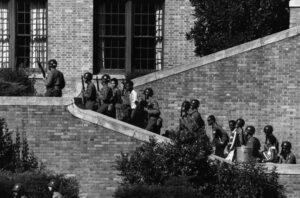 After Arkansas Governor Orval Faubus had ordered the Arkansas National Guard to keep nine African American students from entering Little Rock's Central High School 16 days before, Federal Judge Ronald Davies orders Governor Faubus to remove the National Guard from the Central High School’s entrance and to allow integration to proceed in Little Rock. Gov. Faubus withdrew the National Guard, but an angry crowd of more than 1,000 protesters surrounded the school on September 23, the next time the nine students attempted to begin classes. Although they had gained access through a side entrance, the police feared for their safety, and evacuated the students. President Dwight Eisenhower dispatched nearly 1,000 paratroopers and federalized 10,000 Arkansas National Guard troops to ensure that the school would be open to the nine students. On September 25, 1957, the “Little Rock Nine” returned to Central High School and were enrolled. Units of the United States Army remained at the school for the rest of the academic year to guarantee their safety. Learn more. After Arkansas Governor Orval Faubus had ordered the Arkansas National Guard to keep nine African American students from entering Little Rock's Central High School 16 days before, Federal Judge Ronald Davies orders Governor Faubus to remove the National Guard from the Central High School’s entrance and to allow integration to proceed in Little Rock. Gov. Faubus withdrew the National Guard, but an angry crowd of more than 1,000 protesters surrounded the school on September 23, the next time the nine students attempted to begin classes. Although they had gained access through a side entrance, the police feared for their safety, and evacuated the students. President Dwight Eisenhower dispatched nearly 1,000 paratroopers and federalized 10,000 Arkansas National Guard troops to ensure that the school would be open to the nine students. On September 25, 1957, the “Little Rock Nine” returned to Central High School and were enrolled. Units of the United States Army remained at the school for the rest of the academic year to guarantee their safety. Learn more. | |
| September 20, 1958 | 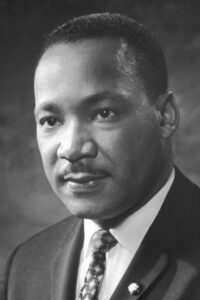 Rev. Martin Luther King, Jr. is stabbed by a mentally unstable white woman at a book signing in a Harlem bookstore. Rev. King was taken to a Harlem Hospital after the attack and recovered after a successful operation. The stabbing took place five years before the March on Washington; had the attack been successful, the subsequent decades would likely have been irrevocably changed. Learn more. Rev. Martin Luther King, Jr. is stabbed by a mentally unstable white woman at a book signing in a Harlem bookstore. Rev. King was taken to a Harlem Hospital after the attack and recovered after a successful operation. The stabbing took place five years before the March on Washington; had the attack been successful, the subsequent decades would likely have been irrevocably changed. Learn more. | |
| September 20, 2007 | 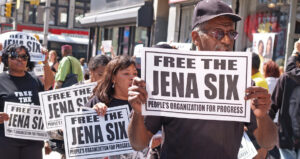 At least 15,000 protesters, including celebrities and civil rights activists, come together in Jena, Louisiana, to show solidarity with six local Black high school students facing serious criminal charges after a conflict with white classmates. The 2006 school year saw months of mounting tensions among the 90% white and 10% Black students at Jena High School, after white students hung nooses on from trees on campus during the first week of school. The tensions were exacerbated after the school board over-ruled the high school administration's decision to expel the white students responsible, instead imposing brief suspensions. At school on December 4, white student Justin Barker bragged about a weekend fight in which a Black student was beaten by a white man. Several Black students overheard Mr. Barker's comments and confronted him. The altercation turned physical and Mr. Barker suffered a concussion, swelling to his eye, and minor injuries to his face, neck, and hands. Six Black students were arrested and charged with aggravated assault. When the district attorney upgraded the charges to attempted murder despite Mr. Barker’s relatively minor injuries, the case drew national attention. Many throughout the country decried the unfairly harsh treatment of the “Jena 6” and criticized the school district’s insufficient response to the earlier noose incident. Learn more. At least 15,000 protesters, including celebrities and civil rights activists, come together in Jena, Louisiana, to show solidarity with six local Black high school students facing serious criminal charges after a conflict with white classmates. The 2006 school year saw months of mounting tensions among the 90% white and 10% Black students at Jena High School, after white students hung nooses on from trees on campus during the first week of school. The tensions were exacerbated after the school board over-ruled the high school administration's decision to expel the white students responsible, instead imposing brief suspensions. At school on December 4, white student Justin Barker bragged about a weekend fight in which a Black student was beaten by a white man. Several Black students overheard Mr. Barker's comments and confronted him. The altercation turned physical and Mr. Barker suffered a concussion, swelling to his eye, and minor injuries to his face, neck, and hands. Six Black students were arrested and charged with aggravated assault. When the district attorney upgraded the charges to attempted murder despite Mr. Barker’s relatively minor injuries, the case drew national attention. Many throughout the country decried the unfairly harsh treatment of the “Jena 6” and criticized the school district’s insufficient response to the earlier noose incident. Learn more. | |
| September 21, 1925 |  WWII Navy gunner and hero Alonzo Alexander Swann Jr. is born. Swann's heroic, selfless actions in the 1944 Battle of Leyte Gulf in the Philippines saved his ship and crew-mates. However, owing to an "error of intentional racial injustice", Swann was denied the Navy's highest honor, the Navy Cross, for nearly fifty years. Following court intervention, Swann was finally awarded the Navy Cross on board the USS Intrepid in 1993. After his service in the war Swann earned a degree in political science at Pennsylvania State University and worked as General Director of the Gary (Indiana) Sanitary District and also co-owned a nightclub. Learn more. WWII Navy gunner and hero Alonzo Alexander Swann Jr. is born. Swann's heroic, selfless actions in the 1944 Battle of Leyte Gulf in the Philippines saved his ship and crew-mates. However, owing to an "error of intentional racial injustice", Swann was denied the Navy's highest honor, the Navy Cross, for nearly fifty years. Following court intervention, Swann was finally awarded the Navy Cross on board the USS Intrepid in 1993. After his service in the war Swann earned a degree in political science at Pennsylvania State University and worked as General Director of the Gary (Indiana) Sanitary District and also co-owned a nightclub. Learn more. | |
| September 21, 1989 | 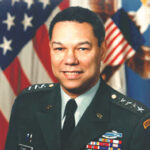 Four Star General Colin Powell is confirmed unanimously by the Senate Armed Forces Committee as the Chairman of the Joint Chiefs of Staff. A month earlier on August 10, 1989, he was nominated as Chairman of the Joint Chiefs of Staff by President H.W. Bush. He was the first African American and the youngest person at age 52 to hold the highest military position in the Department of Defense. He later served as the first African American Secretary of State under President George W. Bush from January 20, 2001 until January 26, 2005. Powell was born on April 5, 1937 in Harlem, New York City. Learn more. Four Star General Colin Powell is confirmed unanimously by the Senate Armed Forces Committee as the Chairman of the Joint Chiefs of Staff. A month earlier on August 10, 1989, he was nominated as Chairman of the Joint Chiefs of Staff by President H.W. Bush. He was the first African American and the youngest person at age 52 to hold the highest military position in the Department of Defense. He later served as the first African American Secretary of State under President George W. Bush from January 20, 2001 until January 26, 2005. Powell was born on April 5, 1937 in Harlem, New York City. Learn more. | |
| September 22, 1906 | 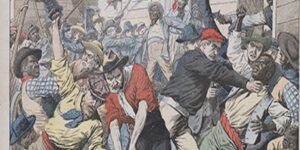 After local newspapers reported sensational allegations that several white women had been assaulted by Black men, mobs of angry white men gathered in the streets of Atlanta, Georgia, attacking and killing Black men on sight, and ransacking Black businesses. The violent terror continued throughout Atlanta and its surroundings for four days, resulting in 25 to 40 Black people killed and countless more injured. Learn more. After local newspapers reported sensational allegations that several white women had been assaulted by Black men, mobs of angry white men gathered in the streets of Atlanta, Georgia, attacking and killing Black men on sight, and ransacking Black businesses. The violent terror continued throughout Atlanta and its surroundings for four days, resulting in 25 to 40 Black people killed and countless more injured. Learn more. | |
| September 22, 1913 |  Leighla Frances Whipper, author, songwriter, and restaurateur, is born in Athens, Georgia into a prestigious family that encompassed the wide ranging areas of literature, theater, medicine, and social activism. Leighla was the daughter of the noted Hollywood actor Leigh Whipper and Virginia Eva Wheeler, a talented dancer in the chorus lines of Harlem in the 1920s and 1930s. She was the niece of Dr. Ionia Rollin Whipper, founder of the Ionia Rollin Whipper Home in Washington, DC. Learn more. Leighla Frances Whipper, author, songwriter, and restaurateur, is born in Athens, Georgia into a prestigious family that encompassed the wide ranging areas of literature, theater, medicine, and social activism. Leighla was the daughter of the noted Hollywood actor Leigh Whipper and Virginia Eva Wheeler, a talented dancer in the chorus lines of Harlem in the 1920s and 1930s. She was the niece of Dr. Ionia Rollin Whipper, founder of the Ionia Rollin Whipper Home in Washington, DC. Learn more. | |
| September 22, 1928 | 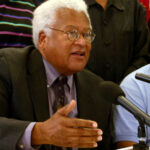 Supporter of the Gandhian philosophy of nonviolent protest and one one of the 1950s-1960s Civil Rights Movement’s leading theoreticians and tacticians in the African American struggle for freedom and equality, the Reverend James M. Lawson, Jr. is born in Uniontown, Pennsylvania. Lawson grew up in Massillon, Ohio, which is where he received his primary and secondary educations. During college, Lawson became a member of the Fellowship of Reconciliation (FOR) local chapter and the Congress of Racial Equality (CORE), both of which were devoted advocates of direct nonviolent resistance to racism. Consistent with his beliefs towards nonviolence, Lawson became a “conscientious objector” during the Korean War; found guilty of violating the draft laws in 1951, Lawson was sentenced to three years in a federal prison. Upon his release from prison, Lawson earned his bachelor’s degree, then traveled to India working with the Methodist Board of Missionaries. While in India, he studied the Gandhian principles of satyagraha, or the strategy of passive political resistance. Lawson would later use these principles to combat and end racial segregation in the US. Returning to the US in 1956, Lawson entered Oberlin College’s Graduate School of Theology and was introduced him to the Reverend Dr. Martin Luther King, Jr. King urged Lawson to move south and aid in the Civil Rights Movement. Heeding King’s advice, Lawson moved to Nashville, Tennessee and enrolled at the Divinity School of Vanderbilt University, where he served as the southern director for FOR and began hosting nonviolence training workshops for the Southern Christian Leadership Conference. There Lawson trained many of the future leaders of the Civil Rights Movement, including James Bevel, Diane Nash, John Lewis, Bernard Lafayette, and Marion Barry. He became pastor of Memphis's Centenary Methodist Church in 1962, from which he led many community movements for justice. In 1974, Reverend Lawson became pastor of Holman United Methodist Church in Los Angeles, California, where he expanded his social activism to Palestinian and immigrant rights; gay and lesbian issues; the Iraq wars; and poverty. Learn more. Supporter of the Gandhian philosophy of nonviolent protest and one one of the 1950s-1960s Civil Rights Movement’s leading theoreticians and tacticians in the African American struggle for freedom and equality, the Reverend James M. Lawson, Jr. is born in Uniontown, Pennsylvania. Lawson grew up in Massillon, Ohio, which is where he received his primary and secondary educations. During college, Lawson became a member of the Fellowship of Reconciliation (FOR) local chapter and the Congress of Racial Equality (CORE), both of which were devoted advocates of direct nonviolent resistance to racism. Consistent with his beliefs towards nonviolence, Lawson became a “conscientious objector” during the Korean War; found guilty of violating the draft laws in 1951, Lawson was sentenced to three years in a federal prison. Upon his release from prison, Lawson earned his bachelor’s degree, then traveled to India working with the Methodist Board of Missionaries. While in India, he studied the Gandhian principles of satyagraha, or the strategy of passive political resistance. Lawson would later use these principles to combat and end racial segregation in the US. Returning to the US in 1956, Lawson entered Oberlin College’s Graduate School of Theology and was introduced him to the Reverend Dr. Martin Luther King, Jr. King urged Lawson to move south and aid in the Civil Rights Movement. Heeding King’s advice, Lawson moved to Nashville, Tennessee and enrolled at the Divinity School of Vanderbilt University, where he served as the southern director for FOR and began hosting nonviolence training workshops for the Southern Christian Leadership Conference. There Lawson trained many of the future leaders of the Civil Rights Movement, including James Bevel, Diane Nash, John Lewis, Bernard Lafayette, and Marion Barry. He became pastor of Memphis's Centenary Methodist Church in 1962, from which he led many community movements for justice. In 1974, Reverend Lawson became pastor of Holman United Methodist Church in Los Angeles, California, where he expanded his social activism to Palestinian and immigrant rights; gay and lesbian issues; the Iraq wars; and poverty. Learn more. | |
| September 23, 1884 | 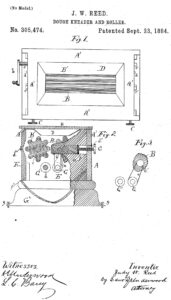 Judy Woodruff Reed secures U.S. patent number 305,474 for her invention of a Dough Kneader and Roller", an improved design of existing rollers with dough mixing more evenly while being kept covered and protected. This is the earliest known patent by an African American woman. Learn more. Judy Woodruff Reed secures U.S. patent number 305,474 for her invention of a Dough Kneader and Roller", an improved design of existing rollers with dough mixing more evenly while being kept covered and protected. This is the earliest known patent by an African American woman. Learn more. | |
| September 23, 1931 | 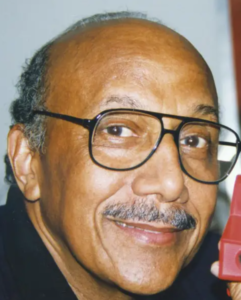 Charles Harrison, one of the most prolific industrial designers of the twentieth century, is born in Shreveport, Louisiana. One of only a handful of early African American industrial designers, he specialized in creating a variety of practical household goods emphasizing form and function. Harrison’s output of innovative consumer products was so prodigious that today it would be difficult to find a household in America without items exemplifying his utilitarian designs. In 1961 Harrison became the first black executive that Sears, Roebuck & Company ever hired at its headquarters in Chicago, Illinois. After Harrison retired from Sears in 1993, he taught industrial design at the University of Illinois and at Columbia College Chicago. His biography, A Life’s Design, was published in 2005. Learn more. Charles Harrison, one of the most prolific industrial designers of the twentieth century, is born in Shreveport, Louisiana. One of only a handful of early African American industrial designers, he specialized in creating a variety of practical household goods emphasizing form and function. Harrison’s output of innovative consumer products was so prodigious that today it would be difficult to find a household in America without items exemplifying his utilitarian designs. In 1961 Harrison became the first black executive that Sears, Roebuck & Company ever hired at its headquarters in Chicago, Illinois. After Harrison retired from Sears in 1993, he taught industrial design at the University of Illinois and at Columbia College Chicago. His biography, A Life’s Design, was published in 2005. Learn more. | |
| September 23, 1954 | 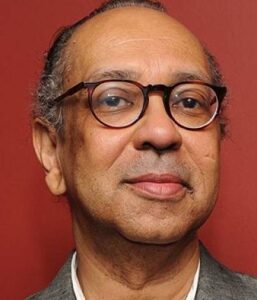 Celebrated playwright and theater and film director George Costello Wolfe is born in Frankfort, Kentucky to Anna Lindsey-Wolfe, a librarian and principal at the all-black Rosenwald Laboratory School in Frankfort, Kentucky, and Castello Wolfe, a clerk for the Kentucky Department of Corrections. In 1992 Wolfe produced and directed Jelly’s Last Jam and in 1993 his Angels in America won a Tony award. Wolfe presented the musical Bring in ‘da Noise, Bring in ‘da Funk in 1996, which used tap dancing to explore Black history. Later that year he directed Suzan Lori Parks’ Pulitzer Prize-winning play Topdog/Underdog. Wolfe made his film directing debut in 2004, with HBO’s Lackawanna Blues which earned numerous awards including the 2006 Directors Guild Award for Best Directorial Achievement. Wolfe also directed the film Nights in Rodanthe which premiered in September 2008. Wolfe’s more recent Broadway productions include A Free Man of Color (2010), The Normal Heart (2011), Lucky Guy (2013) and in 2016, Shuffle Along, a remake of the first Black musical on Broadway in 1921. In 2017, Wolfe, a member of the President’s Committee on the Arts and Humanities, resigned to protest the comments of President Donald Trump following a Neo-Nazi rally in Charlottesville, Virginia where one person died. In 2018 Wolfe directed The Iceman Cometh starring Denzel Washington and in 2020 he directed Overcoming, a play he described as “unapologetically Black and Gay.” Learn more. Celebrated playwright and theater and film director George Costello Wolfe is born in Frankfort, Kentucky to Anna Lindsey-Wolfe, a librarian and principal at the all-black Rosenwald Laboratory School in Frankfort, Kentucky, and Castello Wolfe, a clerk for the Kentucky Department of Corrections. In 1992 Wolfe produced and directed Jelly’s Last Jam and in 1993 his Angels in America won a Tony award. Wolfe presented the musical Bring in ‘da Noise, Bring in ‘da Funk in 1996, which used tap dancing to explore Black history. Later that year he directed Suzan Lori Parks’ Pulitzer Prize-winning play Topdog/Underdog. Wolfe made his film directing debut in 2004, with HBO’s Lackawanna Blues which earned numerous awards including the 2006 Directors Guild Award for Best Directorial Achievement. Wolfe also directed the film Nights in Rodanthe which premiered in September 2008. Wolfe’s more recent Broadway productions include A Free Man of Color (2010), The Normal Heart (2011), Lucky Guy (2013) and in 2016, Shuffle Along, a remake of the first Black musical on Broadway in 1921. In 2017, Wolfe, a member of the President’s Committee on the Arts and Humanities, resigned to protest the comments of President Donald Trump following a Neo-Nazi rally in Charlottesville, Virginia where one person died. In 2018 Wolfe directed The Iceman Cometh starring Denzel Washington and in 2020 he directed Overcoming, a play he described as “unapologetically Black and Gay.” Learn more. | |
| September 23, 1955 | 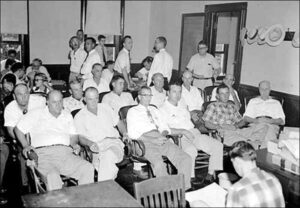 An all-white jury in Tallahatchie County, Mississippi, acquitted Roy Bryant and John Milam, the two white men who murdered Emmett Till, a 14-year-old Black boy. The murder victim, was accused of acting "familiar" with Carolyn Bryant, Roy Bryant's wife. At that time Black citizens comprised over 63% of Tallahatchie County’s population, but were indelible to serve on juries because not one Black person in the county had been permitted to register (or vote). The jury only deliberated 67 minutes before returning a verdict of not guilty. One juror later said: "We wouldn't have taken so long if we hadn't stopped to drink pop." A few months later, Look Magazine reportedly paid $4,000 to Mr. Milam and Mr. Bryant for their confessions. In a story published by the magazine on January 24, 1956, Mr. Milam and Mr. Bryant graphically described their abduction of Emmett Till from his uncle's home, admitting that they pistol-whipped him, forced him to disrobe, tied a heavy cotton-gin fan around his neck with barbed wire, shot him, and dumped his body in the Tallahatchie River. Decades later, Mrs. Bryant would also admit that she lied on the stand. Learn more. An all-white jury in Tallahatchie County, Mississippi, acquitted Roy Bryant and John Milam, the two white men who murdered Emmett Till, a 14-year-old Black boy. The murder victim, was accused of acting "familiar" with Carolyn Bryant, Roy Bryant's wife. At that time Black citizens comprised over 63% of Tallahatchie County’s population, but were indelible to serve on juries because not one Black person in the county had been permitted to register (or vote). The jury only deliberated 67 minutes before returning a verdict of not guilty. One juror later said: "We wouldn't have taken so long if we hadn't stopped to drink pop." A few months later, Look Magazine reportedly paid $4,000 to Mr. Milam and Mr. Bryant for their confessions. In a story published by the magazine on January 24, 1956, Mr. Milam and Mr. Bryant graphically described their abduction of Emmett Till from his uncle's home, admitting that they pistol-whipped him, forced him to disrobe, tied a heavy cotton-gin fan around his neck with barbed wire, shot him, and dumped his body in the Tallahatchie River. Decades later, Mrs. Bryant would also admit that she lied on the stand. Learn more. |
We invite readers to submit suggestions for entries by clicking the Contact Us link.

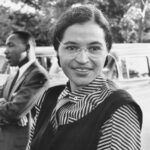
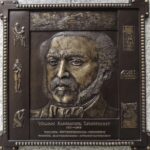 William Alexander Leidesdorff, Jr., one of the earliest biracial-Black U.S. citizens in California and one of the founders of the city that became San Francisco, launches the first steamboat to operate on San Francisco Bay and the Sacramento River. A highly successful, enterprising businessman, he was a West Indian immigrant of African Cuban, possibly Carib, Danish/Swedish and Jewish ancestry. Leidesdorff became a United States citizen in New Orleans in 1834. He migrated to Alta California in 1841, then under Mexican rule, settling in Yerba Buena (now San Francisco), a village of about 30 Mexican and European families. He became a Mexican citizen in 1844 and received a land grant from the Mexican government, 8 Spanish leagues, or 35,500 acres (144 km2) south of the American River, known as Rancho Rio de los Americanos. He served as US Vice Consul to Mexico at the Port of San Francisco beginning in 1845. Leidesdorff was President of the San Francisco school board and also elected as City Treasurer.
William Alexander Leidesdorff, Jr., one of the earliest biracial-Black U.S. citizens in California and one of the founders of the city that became San Francisco, launches the first steamboat to operate on San Francisco Bay and the Sacramento River. A highly successful, enterprising businessman, he was a West Indian immigrant of African Cuban, possibly Carib, Danish/Swedish and Jewish ancestry. Leidesdorff became a United States citizen in New Orleans in 1834. He migrated to Alta California in 1841, then under Mexican rule, settling in Yerba Buena (now San Francisco), a village of about 30 Mexican and European families. He became a Mexican citizen in 1844 and received a land grant from the Mexican government, 8 Spanish leagues, or 35,500 acres (144 km2) south of the American River, known as Rancho Rio de los Americanos. He served as US Vice Consul to Mexico at the Port of San Francisco beginning in 1845. Leidesdorff was President of the San Francisco school board and also elected as City Treasurer. 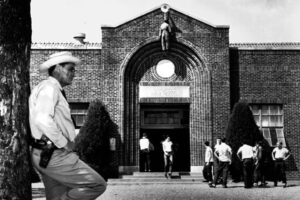 On the first day of school, mobs of white pro-segregationists guarded Mansfield High School and patrolled the streets threatening to use guns and other weapons to prevent Black children from registering. Outside the school, the mob hung an African American effigy at the top of the school’s flag pole and set it on fire. Attached to one pant leg of the effigy was a sign that read, “This Negro tried to enter a white school. This would be a terrible way to die.” On the other leg, a sign read, “Stay Away, Niggers.” A second effigy was hung on the front of the school building. In response to the first-day-of-school unrest, Texas Governor Allan Shivers sent six Texas Rangers to Mansfield with instructions to “maintain law and order” and transfer any students “white or colored, whose attendance or attempts to attend Mansfield High School would be reasonably calculated to incite violence.” Soon afterward, the Mansfield School Board voted to “exhaust all legal remedies to delay integration.” Mansfield, Texas, public schools did not officially desegregate until 1965.
On the first day of school, mobs of white pro-segregationists guarded Mansfield High School and patrolled the streets threatening to use guns and other weapons to prevent Black children from registering. Outside the school, the mob hung an African American effigy at the top of the school’s flag pole and set it on fire. Attached to one pant leg of the effigy was a sign that read, “This Negro tried to enter a white school. This would be a terrible way to die.” On the other leg, a sign read, “Stay Away, Niggers.” A second effigy was hung on the front of the school building. In response to the first-day-of-school unrest, Texas Governor Allan Shivers sent six Texas Rangers to Mansfield with instructions to “maintain law and order” and transfer any students “white or colored, whose attendance or attempts to attend Mansfield High School would be reasonably calculated to incite violence.” Soon afterward, the Mansfield School Board voted to “exhaust all legal remedies to delay integration.” Mansfield, Texas, public schools did not officially desegregate until 1965. 